FEATURING 321 Industry-First Reviews of Fiction, Nonfiction, Children’s, and YA Books
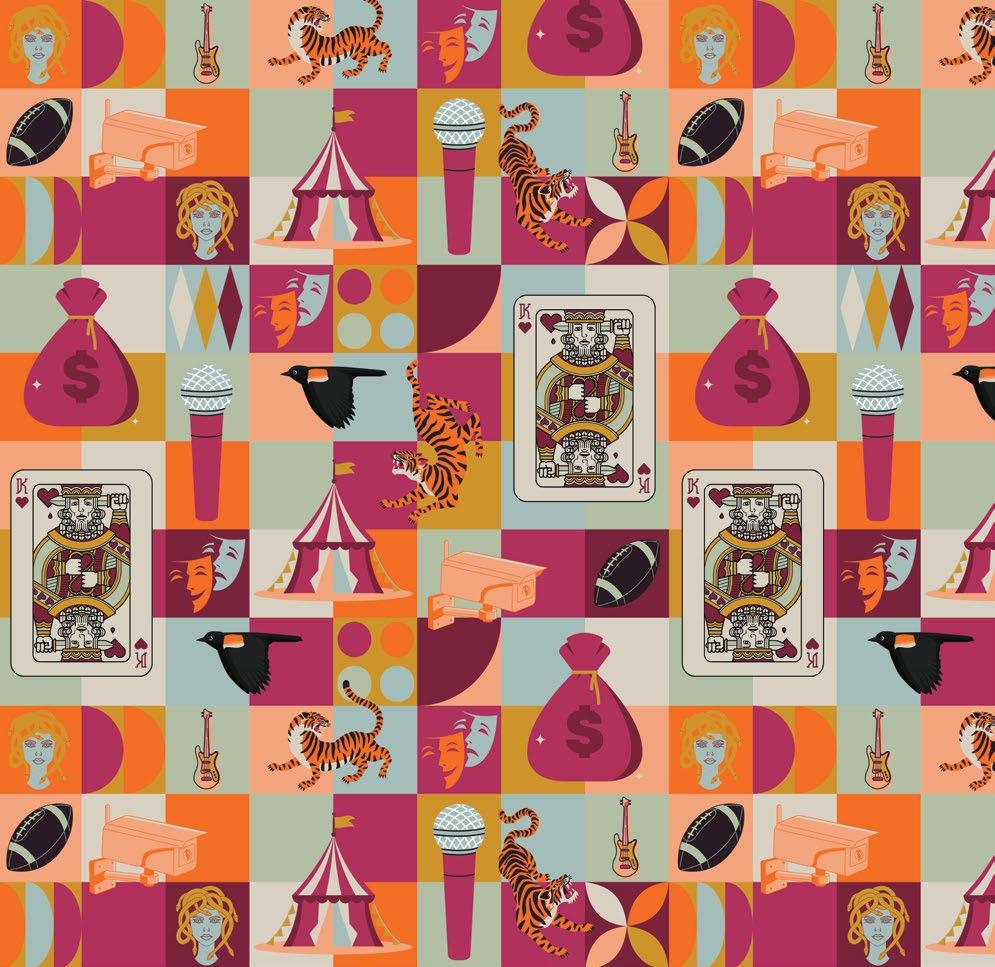

FEATURING 321 Industry-First Reviews of Fiction, Nonfiction, Children’s, and YA Books

A first look at the most anticipated titles coming our way this autumn




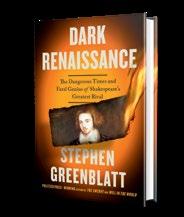
FROM THE EDITOR’S DESK
AS I WRITE THIS, New York City is just emerging from a blazing summer heat wave, yet Kirkus’ Fall Preview serves to remind us that a change of season is just around the corner. Books got me through the long hot days (among them Angela Flournoy’s absolutely stunning second novel, The Wilderness , out from Mariner on September 16), and I’m already making lists of books to occupy me as the days grow shorter and chillier. If you, too, are a list maker, then this issue’s for you: a handy cheat sheet to the most promising fiction, nonfiction, children’s books, and young adult titles of the fall, 150 recommendations in all. Where to start? At the top of my personal list is Ian McEwan’s latest, What
We Can Know (Doubleday, September 23). A new novel by the Booker Prize–winning author of Atonement , Saturday, and Lessons is always an occasion, and our starred review confirms that this one—a “gravely postapocalyptic tale that blends mystery with the academic novel”—does not disappoint, calling it a “philosophically charged tour de force by one of the best living novelists in English.”
Similarly, I wait for each new book from Joan Silber with delicious anticipation. The National Book Critics Circle Award winner returns this fall with Mercy (Counterpoint, September 2), another of her novels fashioned from a series of linked stories following a handful of interconnected
Frequently Asked Questions: www.kirkusreviews.com/about/faq
Fully Booked Podcast: www.kirkusreviews.com/podcast/
Advertising Opportunities: www.kirkusreviews.com/book-marketing
Submission Guidelines: www.kirkusreviews.com/about/publisher-submission-guidelines
Subscriptions: www.kirkusreviews.com/magazine/subscription
Newsletters: www.kirkusreviews.com
For customer service or subscription questions, please call 1-800-316-9361
characters (Ideas of Heaven , Improvement). This one— tracing, in part, the aftereffects of a heroin overdose in 1970s New York—earned a starred review: “Once again, Silber has served up her unique flavor of reading joy.”
On the nonfiction side, I’m eager for the release of the latest book from the author of Will in the World and The Swerve. Harvard professor Stephen Greenblatt revisits 16th-century England in Dark Renaissance: The Dangerous Times and Fatal Genius of Shakespeare’s Greatest Rival (Norton, September 9); our starred review calls it a “scintillating biography of Christopher Marlowe by one of America’s leading humanities scholars.” Was this contemporary of the Bard, who was killed in a bar fight at the age of 29, possibly the greater playwright? Greenblatt is sure to mount a persuasive argument.
This season, we at Kirkus are undergoing a transition as well. Our publisher and CEO, Meg LaBorde Kuehn, has
moved on to pursue other projects. When a publisher is doing the job well, they’re invisible to readers, but their influence is felt everywhere. That’s certainly the case with Meg, who, in her 14 years at the company, oversaw the creation of the Kirkus Prize, the relaunch of the website, and the redesign of the print magazine. “After years of visionary leadership and unwavering dedication, our beloved CEO is stepping down, leaving behind a legacy that will inspire us for years to come,” said co-chairman Herb Simon in a release announcing her departure. Co-chairman Marc Winkelman underlined the sentiment: “Kirkus wouldn’t be the company it is today without Meg.” We’ll all miss her and look forward to working with interim CEO Judy Hottensen, who steps aboard with this issue. It’s a new chapter.

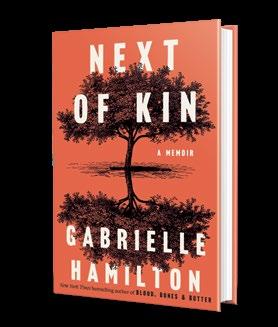
Celebrating the Mystery of Tarot & Lotería
Eugene Yelchin


Co-Chairman HERBERT SIMON
Interim Publisher & CEO
JUDY HOTTENSEN jhottensen@kirkus.com
Chief Marketing Officer
SARAH KALINA skalina@kirkus.com
Publisher Advertising & Promotions
RACHEL WEASE rwease@kirkus.com
Indie Advertising & Promotions
AMY BAIRD abaird@kirkus.com
Author Consultant
KEELIN FERDINANDSEN kferdinandsen@kirkus.com
Lead Designer KY NOVAK knovak@kirkus.com
Magazine Compositor
NIKKI RICHARDSON nrichardson@kirkus.com
Director of Kirkus Editorial ROBIN O’DELL rodell@kirkus.com
Kirkus Editorial Senior Production Editor
MARINNA CASTILLEJA mcastilleja@kirkus.com
Kirkus Editorial Production Editor
ASHLEY LITTLE alittle@kirkus.com
Copy Editors
ELIZABETH J. ASBORNO
NANCY MANDEL
BILL SIEVER
KENNETH WALSH
Mysteries Editor
THOMAS LEITCH
Co-Chairman
MARC WINKELMAN
Editor-in-Chief
TOM BEER tbeer@kirkus.com
President of Kirkus Indie
CHAYA SCHECHNER cschechner@kirkus.com
Fiction Editor
LAURIE MUCHNICK lmuchnick@kirkus.com
Nonfiction Editor
JOHN McMURTRIE jmcmurtrie@kirkus.com
Young Readers’ Editor LAURA SIMEON lsimeon@kirkus.com
Young Readers’ Editor MAHNAZ DAR mdar@kirkus.com
Editor at Large
MEGAN LABRISE mlabrise@kirkus.com
Senior Indie Editor DAVID RAPP drapp@kirkus.com
Indie Editor
ARTHUR SMITH asmith@kirkus.com
Senior Editorial Assistant
NINA PALATTELLA npalattella@kirkus.com
Senior Indie Editorial Assistant
DAN NOLAN dnolan@kirkus.com
Indie Editorial Assistant
KATARINA YERGER kyerger@kirkus.com
Contributing Writers
GREGORY McNAMEE
MICHAEL SCHAUB

Contributors
Nada Abdelrahim, Colleen Abel, Erin Addis, Paul Allen, Kent Armstrong, Mark Athitakis, Kit Ballenger, Colette Bancroft, Carole Bell, Nell Beram, Elizabeth Bird, Christopher A. Biss-Brown, Sarah Blackman, Jessica Hoptay Brown, Ana Cackley, Kevin Canfield, Hailey Carrell, Charles Cassady, Sonia Charales, Ann Childs, Alec B. Chunn, Carin Clevidence, Emma Corngold, Jeannie Coutant, Maya Davis, Cathy DeCampli, Dave DeChristopher, Kathleen Deedy, Elise DeGuiseppi, Suji DeHart, Amanda Diehl, Elaine Elinson, Lisa Elliott, Lily Emerick, Makana Eyre, Joshua Farrington, Brooke Faulkner, Katie Flanagan, Catherine Foster, Mia Franz, Ayn Reyes Frazee, Jenna Friebel, Robbin Friedman, Jackie Garcia, Sydney Geyer, Fiona Giles, Amy Goldschlager, Emily A. Gordon, Melinda Greenblatt, Vicky Gudelot, Tobi Haberstroh, Dakota Hall, Sean Hammer, Alec Harvey, Lynne Heffley, Ralph Heibutzki, Mara Henderson, Loren Hinton, Ashley Holloway, Katrina Niidas Holm, Natalia Holtzman, Kathleen T. Isaacs, Darlene Ivy, Kristen Jacobson, Wesley Jacques, Jessica Jernigan, Danielle Jones, Jayashree Kamblé, Deborah Kaplan, Marcelle Karp, Ivan Kenneally, Colleen King, Katherine King, Lyneea Kmail, Carly Lane, Christopher Lassen, Tom Lavoie, Seth Lerer, Maureen Liebenson, Coeur de Lion, Barbara London, Patricia Lothrop, Sawyer Lovett, Wendy Lukehart, Isabella Luongo, Michael Magras, Collin Marchiando, Michelle H Martin, Gabriela Martins, Kirby McCurtis, Jeanne McDermott, Kathleen McLaughlin, Don McLeese, Cari Meister, Kathie Meizner, Carol Memmott, Chintan Modi, Rebecca Moore, Andrea Moran, Rhett Morgan, Padmini Narumanchi, Christopher Navratil, Rachael Nevins, Katrina Nye, Tori Ann Ogawa, Connie Ogle, Mike Oppenheim, Emilia Packard, Nina Palattella, Megan K. Palmer, Bethanne Patrick, Deb Paulson, Rebecca Perry, John Edward Peters, Jim Piechota, Vicki Pietrus, William E. Pike, Shira Pilarski, Cathy Poland, Carolyn Quimby, Judy Quinn, Kristy Raffensberger, Kristen Bonardi Rapp, Matt Rauscher, Stephanie Reents, Peter Richardson, Amy Robinson, Lizzie Rogers, Gia Ruiz, Lloyd Sachs, Bob Sanchez, Julia Sangha, Meredith Schorr, Will Schube, Gretchen Schulz, Jennifer Senick, Gene Seymour, Jerome Shea, Kerry Sheridan, Sadaf Siddique, Linda Simon, Clay Smith, Margot E. Spangenberg, Andria Spencer, Allison Staley, Allie Stevens, Mathangi Subramanian, Jennifer Sweeney, Renee Ting, Lenora Todaro, Jenna Varden, Barbara Ward, Katie Weeks, Audrey Weinbrecht, Angela Wiley, Vanessa Willoughby, Paul Wilner, Kerry Winfrey, Marion Winik, S.D. Winston, Jean-Louise Zancanella, Natalie Zutter

ISBN: XXX-X-XX-XXXXXX-X


Want to read about parents, children, orphans, lovers, gangsters, Antarctic tourists, Covid nurses, an 8-foot-tall Amish boy, or a dinner party that will rock the literary world well into the 22nd century? The fiction shelves will feature all that and more this fall, with new work from Rabih Alameddine, Oyinkan Braithwaite, Gish Jen, Adib Khorram, Lily King, Patricia Lockwood, Ian McEwan, Joan Silber, Susan Straight, Brandon Taylor, Bryan Washington, and many other favorites, along with new voices such as Jaquira Díaz and Sam Sussman.
Alameddine, Rabih | Grove (336 pp.) | $28 September 2, 2025 | 9780802166470

A gay Beiruti man comes to terms with his mother issues.
Alameddine is gifted at finding the humor in what for most writers would be singularly traumatic themes, including AIDS (Koolaids: The Art of War, 1998), the Lebanese Civil War (An Unnecessary Woman, 2014), and the plight of Middle Eastern migrants (The Wrong End of the Telescope, 2021). Here, he applies his sardonic wit again to the Civil War as well as the calamities of Covid-19, Lebanon’s banking collapse, and the 2020 Beirut port explosion. But before all that, the title characters are bickering. Raja, a respected philosophy teacher with one acclaimed book to his credit, has been living with his elderly mother in a small apartment made even smaller by the presence of more extended relatives. Exasperated with being reduced to his mother’s “homosexual nonbreeding son,” as well as her dangerous involvement in antigovernment protests, he seeks a respite, and one finds him: an all-expenses-paid residency at an institution in the United States. This may be too good to be true (note the title). But before exploring that, Raja relates the story of his two-month captivity at the hands of an acquaintance during the 1975 Civil War. That period includes all the degradations of a kidnapping, but Raja also depicts it as a case of Stockholm Syndrome, with his captor becoming a sexual and emotional confessor. Did the experience inspire his interest in cross-dressing and philosophy? It’s an open question, but it seems to have given him the kind of sass and self-deprecating humor that complicates his character and enlivens the story. Raja’s fatalism is well honed by his period of torment, but also by the everyday annoyances of his family. On both levels, it’s a peculiar but lively and humane book. A sharp exploration of resilience in dark times.
Baal, Iphgenia | Hagfish (264 pp.) | $18 paper | October 21, 2025 | 9781965028001

Scuzzy, raucous stories that take aim at sexism, racism, and gentrification. In her first book to be published in the U.S, Baal, whose style is described in her bio as a “marrying of politics and ass,” writes about young rebels roaming London, engaging in adolescent tomfoolery, getting drunk, gossiping, and ultimately discovering their friends aren’t really their friends. Gritty and profane, these stories are marbled with deliciously slangy dialogue and irreverent lists and rants. In “Pain in the Neck,” a woman does a favor for an old friend with whom she once had “sad, gray-area sex” which she’s “probably blanked for sanity’s sake” and winds up stuck on his roof with his rich Spanish girlfriend. The formally brilliant and hilarious “Change :)” is a group text gone awry: Ed texts everyone in his address book to drum up political engagement, only to be accused of predatory sexual behavior by several women in front of dozens of people, many of whom claim not to know him. A story titled “Victim Blaming” marks a change in the collection, as an older narrator—a woman who also happens to be a writer—takes over. More essayistic than dramatic, these pieces reveal the narrators’ blind spots: In one, a woman falls for a sexist pig after avowing that she’s done having sex with men; another realizes that by spending so many years rebelling against her parents, she’s actually kept them in the center of her life. The standout is “Married to the Streets,” which ends with a knock-your-socks-off surprising description of Grenfell, the West London residential tower that burned down in 2017, killing more than 70 people. Here, the narrator comes to terms with how much she loves her city, though she also loathes how it’s changing. While some of Baal’s stories suffer from a little of the aimlessness that besets her characters, they’re all good, unruly fun. Stories that take you on a tour of grungy London with a guide who slips in dagger-sharp social commentary.
Kirkus Star
Barry, Quan | Grove (320 pp.) | $28 October 14, 2025 | 9780802165350

A luxury trip to Antarctica goes horribly wrong in Barry’s triumph of literary horror. Striker isn’t surprised to be the only Black passenger on the cruise to Antarctica. She’s used to being the only Black person in a given space, having grown up with white adoptive parents. While her fellow tourists are wealthy sightseers, Striker is on the ship for business; she’s a location scout for the film industry, hired for a production company making a film about the disastrous Shackleton expedition. As the group is taken on kayak trips and history lectures, Striker observes her extremely privileged fellow passengers with the same wry detachment as the local wildlife. But when a freak accident leaves the group stranded on one of Antarctica’s many remote islands, and they regroup in a shelter left by some long-forgotten expedition, the natural environment quickly turns against them. For Striker, who came to Antarctica burdened with heavy secrets and is now surrounded by the remains of stranded explorers, the past and present start to melt together as she has terrifying visions of shipwreck survivors resorting to unspeakable acts of violence. Barry’s desolate setting perfectly reflects Striker’s memories of growing up Black surrounded by whiteness, and the ways in which her identity was always reflected back at her through the warped lens of systemic racism. The line between what can be attributed to the supernatural, with the past literally coming back to haunt the survivors, and what is simply Striker losing her grip on reality is wisely kept blurry as the reader begins to question their own senses.
A terrifying must-read set at the ends of the Earth.
Braithwaite, Oyinkan | Doubleday (352 pp.)
$28 | November 4, 2025 | 9780385551472

A family of Nigerian women finds their romantic lives plagued by a long-ago curse in the new novel by the author of My Sister, the Serial Killer (2018)
As Braithwaite’s story opens, a 25-yearold woman named Monife is about to drown herself in the ocean due to a disappointment in love: “The tragedy had already happened and this was simply the inevitable consequence.” On the day of her funeral, her cousin Ebun gives birth to a daughter who looks exactly like her late aunty. Little Eniiyi will grow to resemble Monife more and more closely, and eventually her life will become deeply entangled with and reflective of Monife’s. No woman in the family has ever had a successful relationship with a man, and family lore traces this back to a forebear who stole another woman’s husband and was cursed by her as follows: “No man will call your house, home. And if they try, they will not have peace. Your daughters are cursed—they will pursue men, but the men will be like water in their palms. Your granddaughters will love in vain. Your great granddaughters will labour for acknowledgement, but they will fall short of other women. Your daughters, your daughters daughters and all the women to come will suffer for man’s sake.” This whole novel revolves around the questions of whether Eniiyi is in fact the reincarnation of Monife, and whether there really is such a thing as a curse. The problem is that you will come away unsure. Eniiyi herself thinks it’s hooey and plans to go into genetic counseling to deal with the matter of inheritance in a more rational way, but when push comes to shove, she too consults the juju lady. The chapters jump back and forth through time, ranging from 1994 to 2025, and among the perspectives of Monife, Ebun, and Eniiyi, and thankfully by the end the women seem to be getting a little more control of their destinies (even the dead one!).
Is this a tragedy or a comedy?
Is this a tragedy or a comedy? Though it ends up uneasily in the middle, it’s well-written and juicy.
Chaon, Dan | Henry Holt (288 pp.) | $28.99 September 23, 2025 | 9781250175236
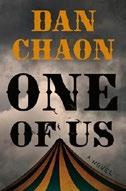
Twin siblings run off to join the circus, which proves to be a dark carnival indeed. Bolt and Eleanor, the teenage twins at the center of Chaon’s brilliant fifth novel, are orphans who’ve fallen under the watch of “Uncle Charlie,” a con man and serial killer. They escape Charlie’s clutches with the assistance of a mysterious Mr. Jengling, who operates a circus and recruits them for his sideshow—which includes a strongwoman, dog-faced boy, and, most creepily, Rosalie, a woman with a second head growing out of the side of her neck and who can predict how and when you will die. For all that darkness, the brother and sister find a welcoming ersatz family; interstitial chapters explore the background of each performer and the unique talents Jengling detected in them. (Bolt and Eleanor’s own talents—telepathy and telekinesis—are only just emerging.) Chaon is focused on how we find our identities outside the ones the world wants to apply to us; as the title suggests, Chaon takes inspiration from Tod Browning’s 1932 film, Freaks, in which the sideshow performers chant “one of us” as a sign of acceptance. Meanwhile, Chaon has also delivered a sharp thriller, as Uncle Charlie attempts to chase down the twins, leaving a bloody path along the way. Set mainly in 1915, the novel captures a vanished vaudeville world that
Chaon resurrects in thoughtful detail, down to the era’s slang (ziggety, conflustered, woofits). But in its latter chapters, the novel is also powerfully otherworldly, deliberately warping assumptions about life, death, and the nature of souls. Bolt and Eleanor take divergent paths once they’ve joined the circus, but Chaon suggests that any path rooted in consideration of others is a valid one. A magic trick: a novel that’s both deeply unsettling and tenderhearted.
Chidgey, Catherine | Cardinal (304 pp.) $30 | September 16, 2025 | 9781538774076
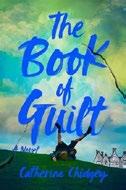
In this gripping novel with elements of a fairy tale, Chidgey examines the lives of parentless children in an alternative Britain that feels frighteningly plausible.
Imagine World War II ended in a treaty without winners or losers after Hitler’s assassination by German conspirators in 1943; since then, British scientists have had access to studies “of immense scientific value” made in “the camps,” as they are called with pointed vagueness. In 1979, this history is taught to 13-year-old triplet brothers—mercurial William, softhearted Lawrence, and thoughtful, watchful Vincent, who narrates most of the book. They live in a group home for boys, part of the Sycamore Homes program established by the government in 1944 to raise parentless children. Doted on by a threesome of Morning, Afternoon, and Night mothers, taught from the encyclopedic Book of Knowledge (an actual publication) and in weekly ethics discussions, the Sycamore boys have had happy if isolated
childhoods marred only by incessant sickliness. Those who recuperate from “the Bug” get to move to “the Big House in Margate,” which, according to the brochure, is a wonderful place next to an amusement park. Only the triplets still remain when a new Conservative government decides to discontinue the Sycamore program to cut costs. Soon the Prime Minister puts the well-meaning but clueless Minister of Loneliness in charge of rehoming the triplets. But where? That these children have been part of a creepy scientific experiment is obvious early on, but one shocking, horrifying surprise follows another in what is, at its most basic, a cat-and-mouse thriller. Meanwhile, Chidgey forces readers to delve into moral questions concerning science (and by extension, technology), pragmatism, personal responsibility, and institutional evil. Then there’s the novel’s unavoidable, disquieting contemplation of just who is given equal right in any given society (including ours). Chidgey, a New Zealander, borrows elements from Philip Roth’s The Plot Against America and Kazuo Ishiguro’s Never Let Me Go, but the character Vincent most resembles is Pinocchio. Broad themes and issues become deeply personal as his coming-ofage becomes a monumental struggle toward self-discovery.
Eloquent prose, rich characterizations, and knotty concepts—an emotional and intellectual tour de force.
Kirkus Star
The Loneliness of Sonia and
Desai, Kiran | Hogarth (704 pp.) | $32 September 23, 2025 | 9780307700155
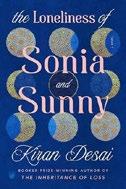
Two young Indian writers discover their conjoined destinies by leaving home, coming back, connecting, disconnecting, and swimming in the ocean at Goa. Sonia’s grandfather, the lawyer, and his friend, the Colonel, are connected
by a weekly chess game and a local tradition of families sharing food, “paraded through the neighborhood in tiffin carriers, in thermos flasks, upon plates covered in napkins tied in rabbit ears.” Shortly after Desai’s magnificent third novel opens, the two families are also connected by a marriage proposal. Upon hearing that Sonia is feeling lonely at college in Vermont—loneliness? Is there anything more un-Indian?—and unaware that she is romantically involved with a much older, very famous painter, her elders deliver a hilariously lukewarm letter proposing that she be introduced to Sonny, the Colonel’s grandson. Sonny is living in New York working as a copy editor at The Associated Press, and he, too, has a partner no one knows about. Sonny’s family feels they are being asked to give up their son to balance out some long-ago bad investment advice from the Colonel; on the other hand, they would very much like to get the other family’s kebab recipe. The fate of this half-hearted arranged marriage unfurls over many years and almost 700 delicious pages that the author has apparently been working on since the publication of The Inheritance of Loss (2006), which won the Booker Prize and National Book Critics Circle Award. You can almost feel the decades passing as the novel becomes increasingly concerned with the process of novel-writing; toward the end, Sonia can’t stop thinking about whether, if she writes all the stories she knows, “these stories [would] intersect and make a book? How would they hold together?” Desai’s trust in her own process pays off, as vignettes of just a page or two (Sonia’s head-spinning tour of a museum with the great artist; Sonny’s lightning-strike theory that only people who have cleaned their own toilet can appreciate reading novels) intersect with the novel’s central obsessions—love, family, writing, the role of the U.S. in the Indian imagination, the dangers faced by a woman on her own—and come to a perfectly satisfying close. A masterpiece.
Díaz, Jaquira | Algonquin (336 pp.) | $28 October 21, 2025 | 9781616209148
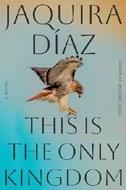
Tragedy shapes and reshapes the lives of a mother and daughter living in Puerto Rico.
Spanning decades, Díaz’s moving debut novel follows Maricarmen, a young working-class woman, as she grows up, falls in love, becomes a mother, and faces tragedy after tragedy in el Caserío, a close-knit barrio in Puerto Rico. Living with her controlling mother and beloved sister in one of the barrio’s only white families, Maricarmen is the model daughter until she turns 17 and falls in love with Rey el Cantante, a Black boy from the neighborhood. When her prejudiced mother discovers their relationship, she kicks her out. As Maricarmen deals with a surprise pregnancy and becomes the matriarch of her new family, Rey wears many hats: talented musician, loyal friend, drug addict, vigilante, father, husband, fugitive. He’s beloved for always finding ways to take care of his neighborhood even though his methods are morally gray. Meanwhile, Maricarmen takes care of their infant daughter, Nena, and Rey’s 3-year-old brother, Tito, while also waiting for Rey to resurface only for him to disappear again. Fifteen years later, when another shocking act of violence upends their lives, Maricarmen and Nena struggle not to let their grief swallow them whole. As Nena comes to terms with her sexual identity and her place in the barrio, Maricarmen makes a decision that changes their relationship forever. Set against the background of the AIDS epidemic, the novel explores queerness, cultural homophobia, and interpersonal and political violence with heartbreaking accuracy. There’s a particularly poignant moment when Nena, surrounded by her queer found family, hears one of her father’s favorite songs: “Nena imagined that it had reminded him that he was beautiful, that to look out at the world and see Black people looking back at him was to understand what real beauty was.” Díaz
THE WILDERNESS
writes beautifully about grief, identity, addiction, family, and the blurry line between myth, truth, and history. A sweeping and touching debut about love, generational trauma, and complex mother-daughter relationships.
The Wilderness Flournoy, Angela | Mariner Books (304 pp.) $30 | September 16, 2025 | 9780063318779

A web of friendship among millennial Black women stretches across several decades. Desiree, Nakia, January, and Monique grew up together. They haven’t all known each other since childhood, but they came into adulthood together, navigating the tumult of their 20s, 30s, and 40s. At the opening of Flournoy’s novel—the first since her acclaimed debut, The Turner House (2015)—Desiree is 22. The year is 2008 and she’s traveling to Zurich via Paris with her grandfather, who plans to die the next day through assisted suicide. Her grandfather is all the family she has; her mother is long dead, her father long absent, and her relationship with her older sister, Danielle, deeply strained. She feels herself adrift and without prospects, but as it turns out, Desiree’s destiny is, in large part, as the anchor of her friend group. Flournoy toggles back and forth in time and perspective across the women, a structure that makes the book feel more like linked stories than a novel with a typical narrative throughline. This enables each woman to be deeply, prismatically rendered: Monique is a librarian-turned-influencer; January is a melancholic mother of two sons; Nakia is a lesbian restaurateur. (Desiree’s sister,
Danielle, receives a narrative interlude, as well.) They endure hookups and breakups, Covid-19, financial woes, careers, caregiving—“the wilderness of adult life.” It’s easy to marvel at Flournoy’s precision with character, the heart of the novel, but it’s the book’s hard look at social and political realities that give it its teeth. By setting select scenes—including the novel’s shattering climax—in the near future, Flournoy seems to warn that the violence and oppression characteristic of 21st-century American life can be mitigated only by community, care, and the families we choose.
Elegant and unsettling, this novel evades the expected at every turn.
Herron, Mick | Soho Crime (352 pp.) | $29.95 September 9, 2025 | 9781641297264

A series of mounting complications leads to yet another fight to the death between the discarded intelligence agents of Slough House and the morally bankrupt head of MI5.
As Jackson Lamb’s motley crew on Aldersgate Street struggles to cope with the deaths of River Cartwright’s grandfather and mentor, intelligence veteran David Cartwright, and their dim, beloved colleague Min Harper, new troubles are brewing. Diana Taverner, who runs the British Intelligence Service from Regent’s Park, is being blackmailed by former MP Peter Judd to do his bidding. Nothing untoward about that, of course, but this time, Judd’s demands, backed by a compromising tape recording, are more pressing than usual. So
Diana reconvenes the Brains Trust—Al Hawke, Avril Potts, Daisy Wessex, and their ex-boss Charles Cornell Stamoran— whose last assignment was to serve as the contact for psychopathic IRA informant Dougie Malone while turning a blind eye to his multiple rapes and murders, which were really none of the Crown’s business. Taverner’s new assignment for the Brains Trust is the assassination of Judd. Since all these developments are filtered through the riotously cynical lens of Herron’s imagination, nothing goes as planned, and when the smoke clears, the fatalities don’t include Judd. Now that Judd knows he has as much reason to fear Taverner as she does to fear him, Lamb offers to broker a peace meeting between them which Slough House computer geek Roddy Ho will keep secret by knocking out 37 security cameras around Taverner’s dwelling. What could possibly go wrong? The best news of all: The climax leaves the door open to further reports from the hilariously misnamed British Intelligence.
Hudes, Quiara Alegría | One World/ Random House (176 pp.) | $26 November 11, 2025 | 9780593732335
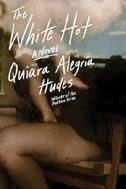
In playwright Hudes’ stunning fiction debut, a mother’s letter to the daughter she left tells a profound story of love, loss, and the cost of liberation. When her daughter Noelle’s principal reports that April Soto’s brilliant 10-year old “bludgeoned” a schoolmate, comparing her to a “runaway freight train” and mandating anger management for both mother and child, fiery rage breaks through April’s years of effortful containment. That night, she runs. Though it ignited her ire to admit it, April’s violence and her need to flee were generations in the making. She “loathed having a cause and effect, being a single-source tragedy,” but the
“white hot” rage of the title—her “escape hatch” and her “battery pack”—was triggered at age 5. After that, April’s memories had been rife with “skin I yanked, bone I smashed, hair I ripped in stripy bouquets.” That incandescent veil shredded her peers’ gendered expectations: “Young buls thinking they had a monopoly on rage till they saw me buy Boardwalk and put up a hotel.” Forming the bulk of the novel, April relates these events in a book-length letter from mother to daughter to be read on Noelle’s 18th birthday. By then April had been gone for eight years. When she left, April had been a 26-year-old former teen mother, a golden child turned dropout raising a gifted young girl in a house she shared with her mother and abuela. Chronicling where April went next and why, the letter is an emotionally raw explanation, not an excuse. April is ruthlessly honest, divulging family secrets and breaking a cycle of shame and sweeping things under the carpet. In blunt yet vibrantly lyrical prose, Hudes reveals the good, the bad, and the profane from April’s brutally candid perspective—including how April left Noelle without notice or plan with her abuela and great-grandmother first for 10 disastrous days and then returned briefly only to leave her for good in the care of a father and stepmother she had never known to save them both. It’s a profound journey of the soul. This staggering gut punch of a novel shows that sometimes love looks like leaving.
Kirkus Star
Bad Bad Girl
Jen, Gish | Knopf (352 pp.) | $30 October 21, 2025 | 9780593803738
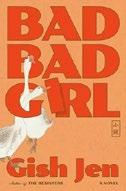
A great novelist distills the truth of her mother’s life, and her own. Jen’s 10th book, she writes in an author’s note, began as a memoir of her mother, who died in her mid-90s during Covid-19. But because Agnes Jen resisted
sharing her stories and left few artifacts, some invention was necessary. All the same, Jen has “stayed as true as [she] could to the facts” of her mother’s life as well as their troubled relationship: Both were bad girls. A confirmation from beyond the grave: “I knew what this book was going to say even before you wrote it, my mother says now. I knew it was going to say I was a terrible mother, blah blah blah blah. The first part explains how I became so terrible. The second part says how terrible I was.” Well, we won’t argue. Her terribleness consisted in both physical abuse and in brutally intense favoritism, making the second-born author a distant fifth to her four siblings. The withholding, abusive Chinese mother who believes she is simply doing things the Chinese way is not an unfamiliar character in either memoir or fiction, but Jen has created a fully three-dimensional portrait of her. Known for humor, Jen worries her readers will be upset this book isn’t funny, but her eye and her style of description (a couple at her first publishing job “smoked as if it was in their marital vows to keep the tobacco industry alive”; her mother’s puffy eyes are “part goldfish, part James Baldwin,” though she is “too sad to quip”) as well as the back and forth between the postmortem conversations and the main storyline keeps the mood lively. “No, I cannot forget you. You are right. You’ve won,” she concedes to her mother at one point. But actually, and for the same reason, she wins too.
Who cares what genre this is; as portraits of tough mother-daughter relationships go, it’s as moving as they come.
Johnson, Adam | MCD/Farrar, Straus and Giroux (768 pp.) | $30 October 14, 2025 | 9780374619572

The Polynesian islands in the South Pacific are transformed by this historical epic into a region at once otherworldly and recognizable.
The Pulitzer Prize–winning Johnson (The Orphan Master’s Son,
2012) has established a reputation for spinning complex, colorful, and plausibly rococo yarns from civilizations remote from and mysterious to outsiders. Here, his audacious, unruly imagination roams with confidence through the island kingdom of Tonga as it undergoes societal uncertainty and the potential of war with other islands. At or near the center of this whirlwind is Kōrero, bold and insatiably curious daughter of a fisherman and a tattoo artist, whose discovery of a fishhook-shaped pendant in an ancestral graveyard signals the beginning of a grand, perilous, and transfiguring adventure that puts her, her family, and her friends on a sea voyage whose outcome could mean either salvation or oblivion for their people. The perilous odyssey is led by a figure known only as the Wayfinder, whose near-intuitive grasp of navi gation by both the shifting waters and the celestial patterns of the night sky arouses in Kōrero her own aspirations of being a “way finder.” Telling stories, however, is her own means of navigating through the twists and turns of her life’s journey, and Johnson’s multilayered narrative has the baggy, wildly divergent feel of oral storytelling, in which the intrigues of royal power politics, often facilitated through violence, are woven with tales of familial conflict, verse by royal poets, and even the occasional monologue from Kōkī, the most articulate and, it seems, resilient of the islands’ many parrots. Such enchanted touches are deftly threaded into the rangy storyline by Johnson’s richly lyrical prose, which is also capable of handling the social dynamics of the Tongans along with the background stories of royalty and their rivals. At times, the saga can get so discursive that it risks leaving the reader on some reef or capsized by an unexpected surge from another time. Yet somehow, you yield to the novelist’s evocation of a world that, like the pendant recovered at the novel’s start, feels “both ancient and startlingly new.”
A book stuffed with revelations while keeping many secrets.
Kirkus Star
Khorram, Adib | Forever (384 pp.) | $17.99 paper | September 2, 2025 | 9781538739556
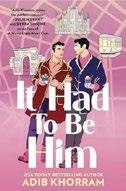
A heartbroken man is reunited with his high school crush in Italy. When 38year-old Ramin Yazdani’s marriage proposal is turned down because he’s “boring,” he impulse books an extended vacation in Italy. He aims to become Interesting New Ramin by sleeping with numerous Italian men, but all his plans change when he runs into Noah Bartlett, whom he hasn’t seen in 20 years. Noah’s ex-wife is moving to Italy and they’re visiting with their 9-year-old son to let him decide if he wants to move with her or stay in Kansas City with Noah. Ramin remembers Noah as the surprisingly kind, popular wrestler who didn’t bully Ramin like other classmates for being chubby and Iranian. Bisexual Noah was fond of Ramin back then and is immediately attracted to him now. As they get reacquainted, their feelings for each other grow, but they both have insecurities to overcome. Just like Khorram’s I’ll Have What He’s Having (2024), this bighearted tale features scorching hot yet deeply realistic sexual moments and relatable, lovable characters. Lushly described wine, food, and Italian landmarks will have readers happily living vicariously through the story. Flashbacks to high school add context to this pair’s relationship and highlight the ways they have grown, yet also show how overcoming self-doubt is a continual work in progress as Ramin struggles with body dysmorphia and Noah is still learning about and exploring his queer identity while also trying to be a better parent than his own. Tension and
conflict in the couple’s building relationship feels authentic and never overdramatic as they come to realize they deserve uncomplicated, steady, devoted love. A pleasure-filled, wholeheartedly sincere second-chance romance.
King, Lily | Grove (256 pp.) | $28 October 7, 2025 | 9780802165176

A love triangle among young literati has a long and complicated aftermath. King’s narrator doesn’t reveal her name until the very last page, but Sam and Yash, the brainy stars of her 17th-century literature class, call her Jordan. Actually, at first they refer to her as Daisy, for Daisy Buchanan of The Great Gatsby, but when they learn she came to their unnamed college on a golf scholarship, they change it to Jordan for Gatsby’s golfer friend. The boys are housesitting for a professor who’s spending a year at Oxford, living in a cozy, book-filled Victorian Jordan visits for the first time after watching The Deer Hunter at the student union on her first date with Sam. As their relationship proceeds, Jordan is practically living at the house herself, trying hard not to notice that she’s actually in love with Yash. A Baptist, Sam has an everything-but policy about sex that only increases the tension. The title of the book refers to a nickname for the king of hearts from an obscure card game the three of them play called Sir Hincomb Funnibuster, and both the game and variations on the moniker recur as the novel spins through and past Jordan’s senior year, then decades into the future.
A love triangle has a long and complicated aftermath.
King is a genius at writing love stories— including Euphoria (2014), which won the Kirkus Prize—and her mostly sunny version of the campus novel is an enjoyable alternative to the current vogue for dark academia. Tragedies are on the way, though, as we know they must be, since nothing gold can stay and these darn fictional characters seem to make the same kinds of stupid mistakes that real people do. Tenderhearted readers will soak the pages of the last chapter with tears. That college love affair you never got over? Come wallow in this gorgeous version of it.
Kraus, Chris | Scribner (320 pp.) | $29 October 7, 2025 | 9781668098684
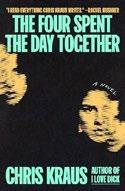
The latest work of autofiction by an iconic Los Angeles writer. Kraus’ first novel in more than a decade meditates on her childhood in 1960s Connecticut and her middle age in LA and northern Minnesota, pinning down, in their contrasts and humming throughlines, “trace elements of a lost Americana.” Kraus records her days at these distinct points in her life, occasionally assuming the points-of-view of those close to her and, in the final portion, strangers. In the first section, “Milford,” Jasper and Emma Greene and their daughters, Catt and Carla, move from the Bronx to Milford, Connecticut, where Emma struggles to connect with her new community and parent Carla, who has a developmental disability, and Jasper works long hours and cultivates Catt’s literary sensibilities. The lens eventually shifts to Catt, the protagonist, as she tumbles into an adolescence of truancy, hitchhiking, and huffing office supplies. “Balsam” picks up four decades later, in Minnesota’s Iron Range. Catt is a well-regarded writer, living in Los Angeles. After a few summers spent in Minnesota, writing and escaping the claustrophobia of the art world, Catt and her partner, Paul Garcia, buy a cottage on a
lake in Balsam to live in part-time. The Trump years bring personal as well as political turmoil, as Catt and Paul face issues in their marriage and Catt confronts a wave of media attention from a new generation when her cult-classic first novel is adapted for TV. Then, in 2019, a shocking, meth-fueled murder near the cottage reels Catt into obsession with the four young people involved. “Harding” alternates between Catt’s life as she reaches for answers to this senseless crime and a fictionalized account of the events leading up to the real-life murder, based on Kraus’ research and interviews with those close to the case. Kraus’ deftness in planting events and swirls of thought in their respective places and times, revealing the rhythms of life with a subtle hand, transforms a series of anecdotes and a true-crime fixation into a stirring narrative of class, addiction, and the question of forgiveness in a cultural landscape increasingly hostile toward empathy and nuance. Kraus’ relentless curiosity is a gravitational force.
Kirkus Star Will There Ever Be Another You
Lockwood, Patricia | Riverhead (256 pp.) $29 | September 23, 2025 | 9780593718551
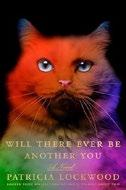
In the wake of a disorienting illness, a woman attempts to write “a masterpiece about being confused.”
What on earth is happening to the unnamed protagonist of this novel? She suffers from “bizarre nonsense dreams,” feels there is “a secret number between two and three,” and sees “a zigzag” in the corner of her eye that she refers to as “the angel.” Has an unnamed illness “stolen her old mind and given her a new one?” We’re told she “first got sick” in March 2020, and because the details of the protagonist’s life and work track so closely with the author’s, we assume it is Covid-19, which left Lockwood in a post-Covid fog, described in an essay for the London Review
of Books. This is no straightforward illness diary, but a “mad notebook” capturing the sensory experience and psychic state of a character in extremis. It opens with a family trip to Scotland, seemingly before the pandemic—but never mind, linearity and narrative are beside the point. In Scotland, the protagonist suddenly believes in fairies; throughout the book she is obsessed with changelings, doppelgängers, knockoff Cabbage Patch Kids, cloned sheep, Mrs. Doubtfire, a potential TV adaptation of her memoir, Priestdaddy, and all manner of facsimiles that point toward the existential question of the title. Somewhat incidentally, she reads and feverishly analyzes Anna Karenina, tries her hand at metalworking, and, after her husband undergoes emergency surgery that leaves him with 36 staples in the abdomen, finds herself “in charge of the Wound.” Wherever this phantasmagoric book takes us, it is shot through with a poet’s love for the slippery absurdities of language and abundant laugh-out-loud gags. Can we hope for a one-woman show?
There is only one Patricia Lockwood, and this surreal, silly, and sneakily profound book could only be hers.
Mabanckou, Alain | Trans. by Helen Stevenson
The New Press (208 pp.) | $24.99 September 16, 2025 | 9781620979556
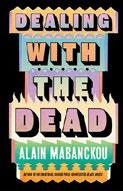
A journey back from the dead is illuminated by thrilling, one-of-akind encounters. The border between life and death is porous— nearly nonexistent—in this exhilarating tale examining the intersection of our world and the next. Mabanckou writes with equal doses of whimsy and descriptiveness, creating a hero’s journey told backward in the second person by a narrator who speaks directly to the protagonist, Liwa Ekimakingaï. Having lived in the Congolese town of Pointe-Noire, Liwa first grapples with his
recent death and then begins to encounter the various worlds he has departed, entered into, and straddles. Mabanckou gives the story a crackling energy, which moves from the present to the recent past to Liwa’s childhood with ease. His passionate language gives the book’s opening a charge, instantly thrusting the reader into something akin to the shock of being dead—if shock can be felt in the afterlife. The novel begins: “You tell yourself over and over till you come to believe it: your new life started an hour ago, when a shock ripped through the earth around you, and you felt yourself being sucked up by a cyclone, then flung down where you’re lying right now, on a heap of earth topped with a brand-new wooden cross.” From there, the pace only quickens. Liwa is met by heaps of fascinating friends, and gaps are filled from equally titillating characters he encountered while alive, the most important being his grandmother Mâ Lembé. It’s their relationship that gives Mabanckou’s novel its power, and any desire to figure out how or why Liwa died dissipates as their final meeting is described. The last time he sees her is described like this: “Complete happiness, at which you blink for a moment, and fill your ribcage with breath.” A feeling that hopefully reverberates into infinity. The power of this novel revolves around its small yet larger-than-life moments.
McEwan, Ian | Knopf (320 pp.) | $27 September 23, 2025 | 9780593804728

A gravely post-apocalyptic tale that blends mystery with the academic novel. McEwan’s first narrator, Thomas Metcalfe, is one of a vanishing breed, a humanities professor, who on a spring day in 2119 takes a ferry to a mountain hold, the Bodleian Snowdonia Library. The world has been remade by climate change, the subject of a course he teaches, “The Politics
and Literature of the Inundation.” Nuclear war has irradiated the planet, while “markets and communities became cellular and self-reliant, as in early medieval times.” Nonetheless, the archipelago that is now Britain has managed to scrape up a little funding for the professor, who is on the trail of a poem, “A Corona for Vivien,” by the eminent poet Francis Blundy. Thanks to the resurrected internet, courtesy of Nigerian scientists, the professor has access to every bit of recorded human knowledge; already overwhelmed by data, scholars “have robbed the past of its privacy.” But McEwan’s great theme is revealed in his book’s title: How do we know what we think we know? Well, says the professor of his quarry, “I know all that they knew— and more, for I know some of their secrets and their futures, and the dates of their deaths.” And yet, and yet: “Corona” has been missing ever since it was read aloud at a small party in 2014, and for reasons that the professor can only guess at, for, as he counsels, “if you want your secrets kept, whisper them into the ear of your dearest, most trusted friend.” And so it is that in Part 2, where Vivien takes over the story as it unfolds a century earlier, a great and utterly unexpected secret is revealed about how the poem came to be and to disappear, lost to history and memory and the coppers.
A philosophically charged tour de force by one of the best living novelists in English.
Wreck
Newman, Catherine | Harper/ HarperCollins (224 pp.) | $26.99 October 28, 2025 | 9780063453913
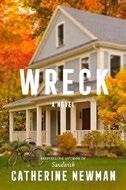
A woman faces a health crisis and obsesses over a local accident in this wonderful follow-up to Sandwich (2024).
Newman begins her latest with a quote from Nora Ephron: “Death is a sniper. It strikes people you love, people you like, people
A heartbreaking, laugh-provoking look at the beauty of everyday life.
WRECK
you know—it’s everywhere. You could be next. But then you turn out not to be. But then again, you could be.” It sets an appropriate tone for a story that is just as full of death and dread as it is laughter. Two years after the events of Sandwich, Rocky is back home in Western Massachusetts and happily surrounded by family—her daughter, Willa, lives with her and her husband, Nick, while applying to Ph.D. programs; her widowed father, Mort, has moved into the in-law apartment behind their house. When a young man who graduated from high school with Rocky’s son, Jamie, is hit by a train, Rocky finds herself spiraling as she thinks about how close the tragedy came to her own family. She’s also freaking out about a mysterious rash her dermatologist can’t explain. Both instances are tailor-made for internet research and stalking. As Rocky obsessively googles her symptoms and finds only bad news (“Here’s what’s true about the Internet: very infrequently do people log on with their good news. Gosh, they don’t write, I had this weird rash on my forearm? And it turned out to be completely nothing! ”), she also compulsively checks the Facebook page of the accident victim’s mother. Newman excels at showing how sorrow and joy coexist in everyday life. She masterfully balances a modern exploration of grief with truly laugh-out-loud lines (one passage about the absurdity of collecting a stool sample and delivering it to the doctor stands out). As Rocky deals with the byzantine frustrations of the medical system, she also has to learn, once more, how to see her children, husband, father, and herself as fully flawed and lovable humans. A heartbreaking, laugh-provoking, and absolutely Ephron-esque look at the beauty and fragility of everyday life.
Kirkus Star
Osman, Richard | Pamela Dorman/ Viking (368 pp.) | $25 September 30, 2025 | 9780593653258
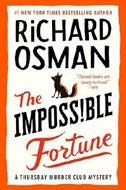
The Thursday Murder Club is back and better than ever.
Former spy Elizabeth hasn’t been herself since her husband Stephen’s death, which explains the two-year gap since the group’s last outing. (Well, that and the fact that Osman was busy writing the first book in a new series, We Solve Murders.) Osman handled Stephen’s Alzheimer’s disease with great sensitivity in The Last Devil To Die (2023), and, here, it’s a pleasure to watch Elizabeth gradually re-engage with the world as her best friend, Joyce, prepares for her daughter’s wedding. About time, too, Joyce would probably say—Joanna has a successful career, but did she have to wait till her 40s to give Joyce that most coveted of relations, a son-in-law? And then what happens but that son-in-law’s best man, Nick, approaches Elizabeth at the reception and tells her someone tried to kill him that morning. The next day, Nick’s office is tossed, and he disappears. He’s in the security business, the owner of a remote storage facility where people can keep anything they choose in absolute privacy and safety. He and his partner, Holly, were once paid by a client in bitcoin that’s now worth 150 million pounds, and they each know half the code that would unlock it. They had just decided to sell it and had asked a few people for advice. All of these folks are now suspects in Nick’s attempted murder.
Or is it actual murder? This being the Thursday Murder Club, there’s a lot more going on, of course. There are parts to play for Ibrahim, the psychologist who might be the most trusted man in England, and Ron, the former trade unionist who would do anything for his family—and his friends are his family, too. There are possibly reformed drug dealers, absolutely not reformed gangsters, a peer of the realm, the usual assortment of police officers, and a walk-on part for Prince Edward. There are satisfying red herrings and a well-constructed answer to the puzzle of what happened to Nick and why. And you’ll be happy just to have spent some time in Osman’s delightful world. If you’re coming to the series from the Netflix movie, start at the top. If you’ve read the others, this is a high point.
Rindo, Ron | St. Martin’s (336 pp.) | $29 September 9, 2025 | 9781250375339
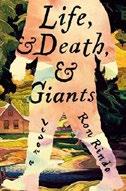
A giant boy with colossal gifts is born in a Wisconsin Amish community. Rindo’s second novel, following several story collections, reveals a writer at the height of his powers. Its title comes from an Emily Dickinson poem; at the center of the tale is a well-worn book of Dickinson’s work. Passed to an Amish woman, Hannah Fisher, in a cedar chest of her mother’s things she receives when the older woman dies, it represents a secret rebellion against the strictures of their faith via Dickinson’s humanist spirituality. As the book opens, Hannah’s daughter, Rachel, is in the throes of labor, and her 17-year-old son, Jasper, brings her to the local veterinarian, Thomas Kennedy, for help, but she dies shortly after delivering an 18-pound infant, Gabriel. Rachel has never named the father of either boy, and she’s long been excommunicated for keeping her silence.
GOOD AND EVIL AND OTHER STORIES
Thomas Kennedy and Hannah Fisher are among a group of four residents of rural Lakota, Wisconsin, who pass the narrative torch in this gorgeously constructed and written novel. The other two are Billy Walton, the proprietor of the local bar and sponsor of the T-ball team where Gabriel will begin his protean sports career, and Trey Beathard, a disgraced college football coach who takes over the local high school program and becomes one of Gabriel’s mentors. Each of them has a unique voice; Hannah’s is particularly beautiful and captivating: “Each morning since my baptism at age seventeen I have awakened from the soft death of sleep, and my first thought, always, has been: Lord, Thy will be done. I do not say it for my own credit. It has not been easy.” And it’s only going to get harder as her grandson Gabriel’s life unfolds. Gabriel himself is a mythic creation: Suckled on goat milk, he has a profound bond with animals, and his legend grows as quickly as he does, reaching a size of almost 9 feet and 600 pounds. Rindo’s writing about animals and nature, about Amish faith, about art and sports—including pro wrestling!— is extraordinary. At the heart of his concerns is the battle between good and evil as expressed in human kindness and human weakness, embodied in unforgettable characters. With its profound portraits of both Amish and secular characters and their luminously real community, this is a must-read.

Kirkus Star
Schweblin, Samanta | Trans. by Megan McDowell | Knopf (192 pp.) | $27 September 16, 2025 | 9780593803103

Startling, otherworldly encounters reveal universal emotions in six fierce short stories. Schweblin, who writes both novels and short stories, proves once again here how urgent and efficient fiction can be. The six tart slices that make up this bitter dark-chocolate orange are a provocative answer to the Beatles’ question: “All the lonely people / Where do they all belong?” The book’s lonely people include a woman who tries to drown herself; estranged friends on the phone reliving an accident; a 2-year-old boy who has lost the ability to speak; a writer at a residency in Shanghai; the grown daughter of a dementia patient; and two young sisters determined to rehabilitate a shattered poet. These are forces of nature with powerful intellects, internationally situated (Schweblin is from Buenos Aires and lives in Berlin), conversant in upheaval and despair, who make startling leaps of time and circumstances. In these stories, each person hungry to connect has a counterpart who can’t or won’t respond. Attempts at closing the gap create guilt, foreboding, or a sharper awareness: We love others but are ultimately alone. And yet each story sings with meaning the reader gleans from witnessing. As one of the young sisters notes of a mysterious house: “You had to stand there for a
moment, very still, and get used to that even darker darkness, before you could finally see anything.” These stories, too, require an adjustment of the eyes, so that just after we are shocked by an eerie threat (a ghostly cat, a telepathic neighbor, a violent guest), we realize we have been party to a central human truth. Some revelations come in the form of body horror, and the gore can be hilariously goofy—a welcome lightness to the more somber scenes of tender caretaking (or unapologetic cruelty).
Schweblin and veteran translator McDowell trace the slim barrier between perception and reality with masterful narration, piercing dialogue, stealthy wit, and psychological precision.
Outrageously original and deeply felt stories with an indelible effect.
Mercy
Silber, Joan | Counterpoint (256 pp.) | $27 September 2, 2025 | 9781640097070

Silber—the great chronicler of the webs of love and coincidence that connect people— turns her attention to drugs and sex and mercy.
Again here, in her 10th work of fiction, Silber uses her signature form— interconnected stories with a rotating point-of-view—to bound through time and around the globe. The central characters are two pairs of friends, connected by a tiny moment in the emergency room of St. Vincent’s, a long-gone hospital in Greenwich Village. Ivan and Eddie were inseparable in their 1970s glory days, but part of their connection was that they were drug buddies, and this leads to Ivan making a mistake for which he can never forgive himself. Also involved was Eddie’s girlfriend Ginger, whose later glamorous trajectory projects her image into their lives for decades. The second pair is Cara and Nini, whose chapters glitter with Silberian wisdom about relationships.
When Cara looks back on her wild early romantic history, she notes that “lust was a big deal in the world around [her]; people believed in sex in a way that they don’t quite anymore.” Similarly, anthropology grad student and serial monogamist Nini can’t help but wonder, “How did anyone get anything done with love in the world?” This actually becomes her field of specialization, love and courtship in a group called the Mien based in Thailand and China. The question of whether Ivan and Eddie will reconnect hangs over the book, even as the meaning and limits of mercy are explored. It can be anything from finding you have accidentally stumbled on your guesthouse in Amsterdam after wandering the city’s streets in a stupor, to the grace offered by morphine and opium to the gravely injured, to an insight gleaned during a 12-step meeting: “I’d listened to people overwhelmed by the relief of confessing, blessed by the mercy of untold secrets told.” So…does that mean they reconnect or not? What a sophisticated trick, to create this particular form of suspense and intellectual pleasure. Once again, Silber has served up her unique flavor of reading joy.
Straight, Susan | Counterpoint (352 pp.) $28 | October 28, 2025 | 9781640097131
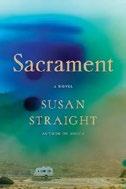
A Covid-19 novel but also so much more. Opening during the spring of 2020, this book refracts the early days of the pandemic with the acuity of a laser, not unlike
Straight’s previous novel, Mecca (2022). But if this is the situation of the narrative, its story is the complexity of love and longing, the edgy insistence of the human heart. Straight begins by focusing on three Covid nurses—Cherrise, Larette, and Marisol—who for the safety of their families have been moved to a small trailer park erected near the hospital
where they work in the ICU. “They say we’re gonna get it under control. I’ll be back to get you in August,” Cherrise tells her 15-year-old daughter, Raquel, after leaving her with relatives. And yet, it is impossible to read this exchange without recalling the fear and trembling of that moment, in which time felt as if it had lost its shape. Straight makes this idea explicit by reintroducing Highway Patrol officer Johnny Frias, a major character in Mecca, who comes to play a significant role in this new work after Raquel disappears. Don’t be misled, though: This is no mere sequel, but what we might imagine as a parallel text, an adjacent set of stories taking place in a world where linearity, chronology, have become words from a different lexicon. This simultaneity makes the relationship between the novels nuanced and compelling, a broadening rather than a lengthening. It’s an astonishing move, one that feels true both to the moment of the action and the moment in which we are reading, the aftermath of a crisis, or a series of crises, that has not fully gone away. Straight reminds us of where we have been and where we are going without once looking away.
Kirkus Star
Sussman, Sam | Penguin Press (336 pp.) $29 | September 16, 2025 | 9780593835050

Losing Mom: heartfelt autofiction from a man who just may be Bob Dylan’s son.
“‘Uncanny, the way you look like him. Bob Dylan. You know his music?’” As soon as you encounter the premise of Sussman’s debut novel, you will surely Google him, and see that his resemblance to the man who wrote “Girl From the North Country” is somewhere beyond uncanny. Sussman has also published an article in Harper’s Magazine that explains the real-life basis of the novel—his mother’s year-long
MINOR BLACK FIGURES
relationship with Dylan and a later meeting nine months before he was born. He magicks this material into a gorgeous, emotionally thrilling first-person novel chronicling the death of the narrator Evan’s mother from cancer, a period during which she finally shares more of the truth about her connection with Dylan, as well as other stories of her life, some terrible and some amazing. All of this has been completely hidden from Evan till now, despite the fact that he and June were very close in his childhood. Their emotional intimacy was built on play-acting and storytelling, on King Arthur and Harry Potter (the Potter saga is a surprising and important touchstone throughout), and also fraught due to her stormy relationships with his stepfather and other men. Despite these romantic disappointments, and things far worse than disappointment, June persists in believing, and wanting her son to believe, that there is nothing holier than love. As the novel opens, she has called him in London—Evan has lived abroad since college—to tell him she has cancer, though she withholds the seriousness of her condition for most of the book, continuing to pursue both holistic and Western treatment. The night he arrives, she serves him an alfresco dinner of homegrown vegetables: “The eggplant lay gleaming on its browned back. Beets glowed blood red. Crisped collard and kale lay entangled in the baking tray. In the pan the bloomed popcorn was spiced and golden.” They recite poetry to each other to bless the meal. The love that swells beneath this scene, and every scene, will just about knock you over. Come for the riveting father-son mystery, stay for the most beautiful and moving mother-son story in recent memory.
Taylor, Brandon | Riverhead (320 pp.)
$29 | October 14, 2025 | 9780593332368

A painter struggles to reconcile identity, money, art, love, and sex.
Taylor’s contemplative and sensuous third novel concerns Wyeth, a young gay Black painter in New York who’s hit an artist’s block. During the pandemic he enjoyed a brief bit of Instagram-driven fame with a stark painting of a dead Black man, which observers assumed was a post–George Floyd commentary on race. But he was mainly tinkering with a composition he admired in an Ingmar Bergman film, and he bristles at identity politics. Still, Wyeth’s principled distancing has mostly just made him anxious and impoverished, working at a gallery and for an art restorer to afford a fifth-floor walkup. A random meeting with Keating, a white man who’s recently abandoned the Catholic priesthood, suggests an opportunity for positive change—if Wyeth isn’t too ambivalent and self-abnegating to pursue it. In broad strokes, the novel has the shape of a romance—boy meets boy, boy ghosts boy, etc.—but it’s also a fine social novel, thick with urbane particulars. Taylor writes about the meticulous details of lithograph restoration with the same kind of erotic, graceful attention he lavishes on Wyeth’s assignations, and the novel has a seductive intellectual energy, as Wyeth struggles to find a way to be a Black artist without feeling burdened by racial interpretations—and wonders why that should feel like a burden. (“You are of the
world, are you not?” a confidante asks, challenging him.) Some of Keating and Wyeth’s exchanges can feel like potted, podcast-y discussions, but more often Taylor is onto something rich and appealing—a story unafraid to foreground love and lust, and that treats emotional ambiguity as a starting point, not as the fuzzy ending common in literary fiction. A piercing, precise, and affecting tale of young love and high art.
Varela, Alejandro | Viking (336 pp.) | $30 September 9, 2025 | 9780593835173
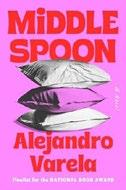
A married man in an open relationship grieves his first breakup. National Book Award finalist Varela’s new novel is told primarily through letters from an unnamed narrator to his former boyfriend. At the behest of one of his therapists, he begins drafting the emails in an effort to navigate their sudden breakup. The narrator, who has never felt heartbreak before, is left entirely unmoored and devastated. The novel’s seemingly straightforward conceit begins to shift as the rest of the narrator’s life comes into focus: He is happily married to his husband, has two children (one of whom is nonbinary), lives in Brooklyn, has an active social life, and works as a public health researcher and professor. Until recently, he was also in a polyamorous relationship with Ben, who likewise lives in Brooklyn and is nearly a decade younger. A whirlwind romance that deepened quickly into love, their relationship was great until the moment Ben dumped the narrator unceremoniously. Nearly swallowed by grief, he fills his overwhelmingly vulnerable letters with sorrow, pining, obsessive thoughts, anxiety, tangents, gay history, therapy speak, pop-culture diatribes, and everything in between. In one of the earliest emails, the narrator posits: “Maybe there’s something worthwhile in unorthodox relationships and atypical
family structures. Maybe the world should adapt to us and not us to it.”
Brushing up against social norms, the narrator dreams of a world that is not quite ready for them. In one letter, he remembers the half-serious joke his husband made about him wearing a T-shirt that says “My husband knows I’m cheating on him.” In another, he writes to his son about the bittersweet reality of being pioneers: “Those of us perched on the tips of branches have unique viewpoints of the forest.” The novel explores the beautiful complexity of unorthodox, progressive family dynamics with tenderness and humor in equal measure.
A touching yet provocative queer love story about defying societal expectations.
Washington, Bryan | Farrar, Straus and Giroux (336 pp.) | $28 | November 4, 2025 9780374609078

A deeply estranged mother and son slowly, slowly learn to reconcile.
Referred to as “the mother” and “the son,” these two people—like characters in Family Meal (2023) and Memorial (2020)—are equipped with the psychological tools needed to repair a wounded relationship but are almost entirely uncertain how to employ them. Truculent and alcoholic, he’s an English tutor in Tokyo but lately he’s been “forgetting his words.” He’d moved to Japan a decade earlier partly, it seems, to escape his family in Texas, while his brother, Chris, who’d joined the Army, is now in prison. The son agonizes over his fractured relationship with his brother, another element in his perception that something is missing or incomplete in him. The son is sleeping with a man, Taku, who’s married to a woman; he’s seeking “clarity” from Taku about their relationship status. The mother and son hadn’t spoken in a number of years until he calls her one night but is unable to say
much; the words he seems to want to say just do not emerge from his mouth, a physical manifestation of his emotionally stunted status. Suddenly, the mother takes two weeks off from her dental-office job in Houston, arrives in Tokyo, and promptly gets lost. It’s remarkable how delicately and finely Washington metes out the emotional journeys for both mother and son. The novel begins with the son’s embittered fury at his mother’s passivity and emotional distance, which becomes a begrudging détente, and then an eventual kindness toward her. She proves to be an adept and patient woman who finds her own way in a dizzying city, making acquaintances until her son lets her into his life. She seeks forgiveness for her past harshness, which her son initially refuses to grant. Washington imbues both mother and son with humane backstories, including the mother’s less-than-easy upbringing in Jamaica. He’s skillful at conveying the ways in which small, even tiny acts of kindness can heal: Returning home to his apartment late one night, the son notices the TV still on and his mother’s soft snoring, and he “slowly wedge[s] a pillow under the back of her neck.” In a less minutely observed novel, that would be an unremarkable moment, but it’s deeply affecting given the fine emotional calibration Washington employs. A patient, powerful analysis of the dual devotion required to heal a fractured relationship.
Kirkus Star
Winslow, Don | Morrow/HarperCollins (304 pp.) $30 | September 16, 2025 | 9780063450424

A collection of six short stories about crimes both planned and accidental, the collision of dreams and reality, and the things people do for love.
John Highland, for example, faces a lifetime in prison. But if he can do one “Final Score”
before turning himself in, at least he can set up his beloved wife for the rest of her days. His plan is impossible to pull off, which is even more reason to do it—a brilliant finale to his criminal career. Another tale takes the reader to Rhode Island, where liquor sales are banned on Sundays. One liquor store maintains a secret “Sunday List” of thirsty patrons and their liquid requirements to get them through the Lord’s Day. Some stories are more serious—a drunk kid kills a young woman in a DUI and is headed to prison. But the kid’s cousin, a cop, worries he may not survive long in the general population. If only the kid could get assigned to the “North Wing,” where a mob boss prisoner protects its inmates. “True Story” is sharp, funny, and one hundred percent dialogue. Guys swap wacky crime stories in a diner. A sample: “Listen—Angela, for all her fine qualities, was no Rose Scholar, either.” But then in “The Lunch Break,” Dave is hired to watch over the spoiled actress Brittany McVeigh and make sure she shows up on set sober and on time. She is only 5-foot-3, but “bad things come in small packages” and she’s a “drunken, drug-addled, promiscuous little diva” who claims she’s being stalked. In the final tale, “Collision,” life is darn near perfect for an upwardly mobile white family of three. Brad McAlister is a highly talented hotel manager. Upper management invites him and his wife to a fancy restaurant and offers him his dream promotion. But in a squeal of tires in the parking lot, their lives change forever. Will the McAlisters’ deep love for each other survive? Each of these stories has clever plotting and sharp dialogue, a hallmark of all the author’s work. Winslow had previously announced his retirement, but maybe that collided with his love of writing. Gritty little gems.

THIS FALL WILL offer every kind of bookish treat, but is there anything more exciting than a new novel from a favorite author who hasn’t published one in ages? Kiran Desai fans have been waiting since 2006 for a follow-up to The Inheritance of Loss, which won the Booker Prize and National Book Critics Circle Award; they’ll be thrilled to hear that our starred review calls The Loneliness of Sonia and Sunny (Hogarth, September 23) “a masterpiece.” Sonia is an aspiring novelist and Sonny works for The Associated Press when their grandparents, embarrassingly, try to set them up—and they wind up together anyway, for a lifetime spreading out across “almost 700 delicious pages.”
It’s been 10 years since Angela Flournoy’s debut, The Turner House, which centered on a single family and their Detroit home; her new novel, The Wilderness (Mariner Books, September 16), follows a group of four friends across their 20s, 30s, and 40s, beginning in 2008 and reaching into the near future, moving back and forth across time and perspective. “Elegant and unsettling, this novel evades the expected at every turn,” according to our starred review. (See the feature on p. 39.)
The Wayfinder (MCD/ Farrar, Straus and Giroux, October 14) is Adam Johnson’s first novel since the Pulitzer Prize–winning The Orphan Master’s Son


(2012). The setting of this historical epic is the Polynesian island of Tonga, where a girl named Kōrero sets off on what our starred review calls “a grand, perilous, and transfiguring adventure that puts her, her family, and her friends on a sea voyage that could mean either salvation or oblivion for their people.”
Thomas Pynchon will also have a new novel out this season, Shadow Ticket (Penguin Press, October 7). It’s his first in 12 years, and it concerns a Milwaukee private eye who finds himself heading for Hungary in 1932; unfortunately, the book isn’t yet available for reviewers.
If you’re a mystery or thriller reader, even two or three years can seem like a long time to wait for the next installment of your favorite series. So you’ll be glad to hear that Richard Osman has returned to the
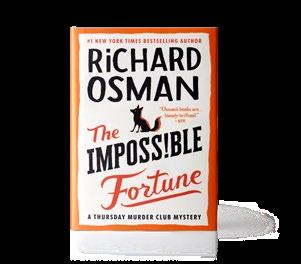

Thursday Murder Club in The Impossible Fortune (Pamela Dorman/Viking) and Mick Herron is back at Slough House in Clown Town (Soho Crime, September 9; see the feature on p. 29).
It’s always a pleasure to discover a new-to-you writer who’s been around for a while; that was my experience with Catherine Chidgey, whose novel The Book of Guilt (Cardinal, September 16) imagines a world where World War II ended by treaty with no winners or losers. The story concerns a set of triplet brothers growing up in a group home in Britain in 1979; they’ve clearly been part of a creepy scientific experiment. Our starred review calls the book “an emotional and intellectual tour de force.”
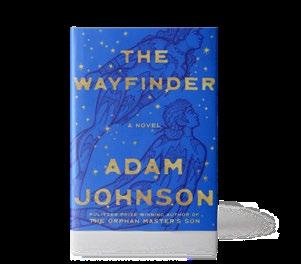

And, of course, there’s nothing like an incredible debut. Get ready to hear a lot about The White Hot by Quiara Alegría Hudes (One World/Random House, November 11; see feature on p. 47), the story of a woman whose incandescent rage causes her to run away from her daughter in order to save them both. Our starred review calls it “a profound journey of the soul.”
Laurie Muchnick is the fiction editor.
In near-future Kolkata, the fates of two families become disastrously intertwined. With gorgeous writing and the pacing of a thriller, Majumdar’s second novel—after A Burning (2020)—transports the reader to a world ravaged by drought, burning heat, and severe food scarcity. As the story begins, it’s Day 1 of the week before Ma will take her 2-year-old daughter, Mishti, and her father, Dadu, to join her scientist husband in Ann Arbor, Michigan, on laboriously procured climate visas, which she regards as “treasure beyond her greatest hope.” Ma just left her job managing a shelter, an organization supported by the single remaining local billionaire,
whose food donations she has been lightly skimming to keep her family fed. A teenage resident of the shelter, Boomba, devises a desperate plan to follow Ma home and recapture some of the booty for resale on the street, as he’s frantic to raise money to rescue his own parents and beloved younger sibling, languishing in dire straits outside the city. Among the items he grabs are Ma’s purse, containing the three passports, setting in motion a series of escalating catastrophes, crimes, and ironies, each darker than the last, all of it concealed by both Ma and Boomba in their hopeful phone conversations with husband and parents, respectively. Fully
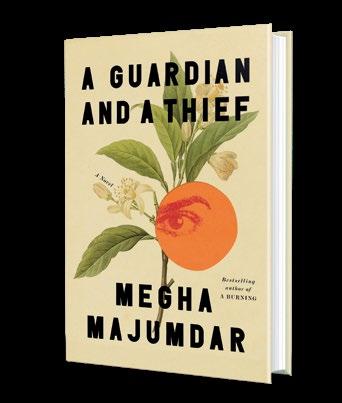
inhabiting both characters over the ensuing seven days, Majumdar reveals her unsettling message: A guardian and a thief lives in each of us. Her evocation of the lost world that lives in the characters’ memories makes the situation not just terrifying but almost criminally
poignant, and the way she manages to connect all the storylines with a resolution that unfolds both globally and in one small living room is genius. This electrifying depiction of dignity and morality under siege reveals the horror hidden by the bland term “climate change.”
Twice
Albom, Mitch | Harper/HarperCollins (320 pp.) $26.99 | October 7, 2025 | 9780062406682

A love story about a life of second chances. In Nassau, Bahamas, casino detective Vincent LaPorta grills Alfie Logan, who’d come up a winner three times in a row at the roulette table and walked away with $2 million. “How did you do it?” asks the detective. Alfie calmly denies cheating. You wired all the money to a Gianna Rule, LaPorta says. Why? To explain, Alfie produces a composition book with the words “For the Boss, to Be Read Upon My Death” written on the cover. Read this for answers, Alfie suggests, calling it a love story. His mother had passed along to him a strange trait: He can say “Twice!” and go back to a specific time and place to have a do-over. But it only works once for any particular moment, and then he must live with the new consequences. He can only do this for himself and can’t prevent anyone from dying. Alfie regularly uses his power— failing to impress a girl the first time, he finds out more about her, goes back in time, and presto! She likes him. The premise is of course not credible— LaPorta doesn’t buy it either—but it’s intriguing. Most people would probably love to go back and unsay something. The story’s focus is on Alfie’s love for Gianna and whether it’s requited, unrequited, or both. In any case, he’s obsessed with her. He’s a good man, though, an intelligent person with ordinary human failings and a solid moral compass. Albom writes in a warm, easy style that transports the reader to a world of second chances and what-ifs, where spirituality lies close to the surface but never intrudes on the story. Though a cynic will call it sappy, anyone who is sick to their core from the daily news will enjoy this escape from reality.
Have tissues ready as you read this. A small package will do.
Ameri, Anan | Interlink (286 pp.) | $18 paper October 14, 2025 | 9781623715847
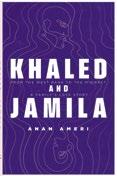
A Palestinian father and daughter share common experiences across decades.
The debut novel by Ameri, the founding director of the Arab American National Museum, opens in 1956 as Khaled, a bright and headstrong teenager, begins attending political rallies in his Palestinian hometown of Al-Bireh. This infuriates his father, who wants him to focus on his studies; to force the issue, Khaled is prompted to go to college overseas, at the University of Michigan. There, his defiance continues. He drinks alcohol, violating Muslim proscriptions; more seriously, he begins dating a white woman, Elizabeth, betraying the woman he promised to eventually marry back home. Fast forward to the ’80s, and Khaled and Elizabeth’s daughter, Jamila, is in a similar predicament: As she heads to college at Michigan State, her affections deepen for Ali, a Black childhood friend. Seemingly oblivious to their own history, Khaled and Elizabeth scheme to separate the young lovers in the hopes Jamila will marry a Palestinian man. Ameri is alert to the hypocrisies of racism and the anguish that many post-Nakba Palestinians experience at home and abroad; the novel’s strongest sections are set in Al-Bireh itself. But the overall narrative is disappointingly flat, hobbled by overly attenuated scenes—Khaled is browbeaten over one night of binge drinking to an absurd degree—and wooden dialogue. (“People here come in different colors and have different backgrounds. Not all Americans have blond hair and blue eyes, and they don’t all think alike, either.”) Ameri avoids dwelling too deeply on the particulars of Middle Eastern politics, but what’s left is a sentimental story about the heart wanting what it wants. An overly earnest study of history and emotional inheritance.
Anderson, Karin | Torrey House Press (350 pp.) | $18.95 paper | August 5, 2025 9798890920263

A moving coming-of-age story makes the most of its harshly beautiful setting.
Tourists by the millions visit Utah for its breathtaking landscapes, but this novel focuses on families that have lived in the eastern part of the state for generations amid both the beauty and the hardships. Its protagonist is Ryder Mikkelson, 7 years old when we meet him. He’s the only child (a rarity in these parts) of Alma and Evaleen, who dote on him. He’s also nestled into a group of close friends, his cousins, serene Ferron and wild boy Kenty, and a sharp-witted Navajo girl named Sami Begay. Then, during a high-country hunting trip, Ryder takes a terrifying fall that leaves him so badly broken he’ll spend months in the hospital. The injuries will shape his whole life, and so will a secret that slips out during the ordeal: He’s adopted. His parents tell him they know nothing about his biological family and that they’re grateful to have him, but as Ryder shoots up to be much taller than any of his relatives and develops artistic talent none of them share, he’s haunted by his origins. The book’s evolving portrait of family relationships, even with some of its difficult members, is convincing, warm without veering into sentimentality. Ryder’s point of view, from his childhood to his role as a husband and father, evolves believably, and the dialogue and details capture the culture of the rural community. Some of the novel’s most memorable passages are those depicting the Utah landscape, not only the splendor of the mountains, mesas, and canyons but the sometimes deadly challenges they can present to humans. Thrilling Western adventure frames heartfelt family drama as a boy searches for himself.
SEA, POISON
Aoyama, Michiko | Trans. by Takami Nieda Hanover Square Press (304 pp.) | $21.99 September 23, 2025 | 9781335016331

A collection of vignettes centered around the families living in a five-story condominium near Tokyo. Five stories intertwine in this novel that moves up from the first to fifth floor homes in the Advance Hill condominium building shortly after it’s built. Each story offers a new, carefully wrought point of view from one of the residents in that condo. Schoolchildren like Kanato and Yuya who have just moved to the area; a mother, Sawa, who’s trying to figure out her place in the world now that her daughter has started kindergarten; Chiharu, a 20-something wedding planner who is lonely and hoping for love; and Kazuhiko, a late-middle-aged magazine editor who has decided to move closer to his mother in the hopes of being able to help her. What ties them all together is a small, stationary children’s ride at the park: a hippo named Kabahiko. Legend in the neighborhood is that if you touch Kabahiko on the part of his body where you yourself are injured, you will be healed. And each narrator discovers the truth of this—but it isn’t magic. Instead, healing comes in the way in which each person’s interactions with Kabahiko creates introspection that leads to enlightenment and a better understanding of the wider community. As Kazuhiko notes, “The thought of strangers living under the same roof, each with their own hopes and burdens,
warmed my heart a little.” Together, this is a sweet—perhaps overly sweet—set of stories that offers up the sentiment that sometimes what ails you can be traced back to a problematic point of view. But each story alone is enough to spark thoughtfulness and a small glow of happiness. Read them one at a time.
Beilin, Caren | New Directions (144 pp.) | $15.95 paper October 7, 2025 | 9780811239516
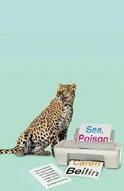
A struggling writer in Philadelphia tries to regain her creative footing after a botched surgery. Sent to an eye clinic while dealing with her autoimmune disease, writer Cumin Baleen is told to get immediate surgery or risk going suddenly blind. But the procedure she undergoes “singe[s]” her brain, and she loses the ability to write anything but short, plain sentences. At the high-end grocery store where she works, called Sea & Poison, Cumin reads Shusaku Endo’s novel of the same name and meditates on human vivisection, “this need to experiment on the human, to puncture the human lung and see what happens.” After her “Unitarian Waldorfian” boyfriend announces he’s in love with their landlady, a professor of Oulipian literature, Cumin rents a closet in the bedroom of a polyamorous “theatre professional.” Dark, digressive, manic, and self-referential, the novel eschews traditional narrative structures: “I am organizing a novel now best I can,
amidst the rivers and the piles of everyone, and walking only a broken, only an overgrown and burnt road in my mind.” When Cumin gets trapped at a reading, the first-person narrative switches to the story being read out loud. While some readers may lose patience, those who persevere will find seemingly unconnected strands converging around a conspiracy that involves human experimentation, writing constraints, capitalism, and our beleaguered protagonist. Beilin can be very funny, as when Cumin mistakes a Glade PlugIn (shell design) for a madeleine-shaped butt plug. But the real subject here is human suffering—and in particular the medical mistreatment of women—and the question at the heart of the book is: How do we bear witness to abuse?
A madcap, raunchy, unconventional text about medical abuses and literary art, infused with both humor and rage.
Carvalho, Maria Judite de | Trans. by Margaret Jull Costa | Two Lines Press (120 pp.) | $16 paper | September 16, 2025 9781949641820

A man returns to his childhood home to bring the life he left behind there to its conclusion, in this translation of a 1973 novel from a celebrated Portuguese novelist. When Mateus Silva was last in the seaside town where he grew up it was 25 years earlier and he was still a boy called Matinho. Though his father and mother both died 10 years earlier, leaving him the sole proprietor of his crumbling childhood home, Mateus has never tried to sell or rent the property out of a sense that “this detail saved everything else from being a total disaster… [having] a little patch of land that was all his in this big, wide world.” Now, however, he has a pressing reason to sell. Mateus’ longtime girlfriend, Alberta, is dying, and Mateus will use
the proceeds from the sale of the house to send her to the Acropolis, a place she has dreamed of visiting since childhood. With this pressing deadline looming, Mateus is content to sell to the first bidder—his former neighbor, Senhor Osório—though doing so brings back the tumultuous childhood memories that sent Mateus and his mother running to Lisbon in the first place. Osório’s wife, Graça, occupies an outsize place in Mateus’ memory. Neither “skinny and anxious like his mother, nor internally serene and protective like Alberta,” Graça’s “vital” beauty proved irresistible both to the boyish Matinho that Mateus once was, and to his father, whose public affair with Graça is what originally fractured the family. By selling the house, Mateus has the opportunity to leave the past behind, but the re-emergence of the much denuded Graça in his life, along with his introduction to her chaotic, sensualist daughter, Natália, and Alberta’s steady, phlegmatic decline forces Mateus to confront the fact that the past may be the only time in his life that still feels worth living. Through prose that is both melancholy and brutally keen, this midcentury master’s eye for the scintillating detail at the heart of even the most mundane observation loses nothing in its translation from its original language, culture, or time. A fierce examination of the unexamined life.
Chang, Jade | Ecco/HarperCollins (304 pp.)
$28.99 | September 30, 2025 | 9780063416390

After a daredevil’s death shocks his circle, his best friend goes on an audacious quest for meaning. Joan Didion called the aftermath of her husband’s death “the year of magical thinking.” For Lola Treasure Gold, the year after her best friend, Alex, dies is a season of
Nails the contradictions, absurdities, and surprises of modern life.
WHAT A TIME TO BE ALIVE
sublimated grief turned metamorphosis. Though Alex is gone, his death is a sensation—he fell seven stories trying to sail a skateboard from one roof to another, witnessed by the friend who was filming. Their tight friend group is stunned, and to add to the loss, Lola knows their friendship could have been more. These are social media–savvy free spirits in LA; Alex died doing a stunt for clout—or maybe transcendence. Experimenting with her purpose and identity, and needing income, Lola starts to branch out. She gets shoved into the limelight: Someone films, remixes, and posts her semi-serious soliloquy on what Alex’s life might mean. The video takes off, and Lola attracts a growing fan base. She gets the hang of living larger online and, through a hero’s journey of adulation and cancellation, travels the path from ironic pseudo-guru in a sea of charlatans (“I’d just flown back from a secretive weeklong retreat intended to help scions of billionaire families understand how to live with themselves”) to someone who really does infuse people’s lives with sincerity and wonder. Chang draws characters with quick mastery, and writes Lola as a mille-feuille of sophistication, delighted lust, and self-doubt. The dialogue snaps and sparks, and Chang dispenses observations about race, class, feminism, sex, and influencer and tech-founder culture with panache. As the novel follows Lola’s search for a reason to live without Alex and a vision of who she could be on her own, it braids satire of rich people searching for their souls and a practicum on how to find closure, with both our living and our dead. Lola’s ache to know more about her Chinese family of origin, which turned her into a first-generation orphan half-raised by a landlord, is a poignant throughline as well. Despite sometimes fluffy revelations, Lola is a
magnetic character who, despite her public life, has her most profound thoughts in private.
Nails the emotional contradictions, absurdities, and cathartic surprises of modern life.
Citchens, Addie E. | Farrar, Straus and Giroux (240 pp.) | $27 | August 19, 2025 9780374609337

A family unravels amid shocking violence in a Mississippi town. There’s no more envied family in Dominion, Mississippi, than the Winfreys. Their patriarch, Sabre Winfrey Jr., is a huge success: He’s the respected pastor of a huge Black Baptist church and the owner of a barbershop, a radio station, and real estate. He and his wife, Priscilla, have five sons, the youngest of whom, Emanuel, nicknamed Wonderboy, is a talented musician and star of the high school football team. It all sounds great, but there’s a darkness beneath the surface. Sabre is a womanizer and Priscilla has a bad alcohol and pill habit; even worse is Wonderboy’s predilection for sexually assaulting women. It’s possible he gets his sense of sexual entitlement from his father, who tells Priscilla that because “Eve ate the apple,” she herself would have to “eat the snake.” Their lives begin to unravel when Priscilla walks in on Wonderboy in a sexual encounter with Diamond, a young woman who loves him: “I
couldn’t shake the energy that radiated off of him, and it didn’t feel playful and curious at all. It felt nuclear, dangerous, like someone I didn’t and couldn’t even know.” As Diamond falls deeper in love with Wonderboy, Priscilla gets more suspicious of both him and his father, and Wonderboy commits another shocking act of violence that he realizes he likely can’t get away with. Citchens’ prose is soaring, and she inhabits the voices of Priscilla and Diamond perfectly. Nothing in the book is sensationalized: Citchens treats the subject matter with the seriousness it requires, and she sensitively handles the trauma that some of her characters endure. This is an important novel that deftly tackles misogyny and hypocrisy. A stunning debut.
Daviau, Mo | West Virginia Univ. Press (272 pp.) | $19.99 paper | September 1, 2025 9781959000624
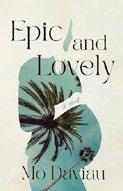
In a letter to the chosen mother of her newborn child, a woman with a rare disorder looks back at her lifetime search for love after the early loss of her father and her wild last year.
In Daviau’s second novel, Nina Simone Blaine addresses Dr. Tabitha Chen, who diagnosed Nina with A12 Fibrillin Deficiency Syndrome when Nina was 11 years old, and whom Nina has chosen to be the adoptive mother of the newborn she calls Sigrid Alma. Forty years and six weeks old, Nina expects to die within hours of giving birth to the child she never expected to have. Like “Marfan on steroids,” A12 endows its carriers—most of them the children of men older than 60—with missing fingers, bulging eyes, loose skin, crooked bodies, troubled hearts, and early deaths. For Nina, A12 meant rejection by her mother, Tracy, a former beauty queen who took her second husband’s side rather than her daughter’s in a sexual
assault court case; when she was a girl, only Nina’s father, Eddie Blaine, who died when she was 7, called her beautiful. Once known as Sandy Blattner, Eddie gave up crooning on the Catskills circuit to attempt stardom in Hollywood and left behind a few mostly forgotten albums and Nina’s memory of his love. Seeking affection as devoted as her father’s sends Nina from her home in Connecticut back to Los Angeles and into the arms of Cole Courchaine, one of the “Good Thumbs,” a small circle of people with A12 supporting each other through their last days. Cole is grandiose, manipulative, and violent; given his grotesquely abusive behavior, Nina’s entanglement with him can be hard to take. The novel’s conclusion is both celebratory and satisfying in its ambiguities, as most of its large cast of characters are revealed to be complicated, capable of a flawed kind of love, and, with few exceptions, also somewhat mean. A dark and complex exploration of the vagaries of parental and romantic love.
DeMille, Nelson & Alex DeMille Simon & Schuster (384 pp.) | $29 October 28, 2025 | 9781501101878
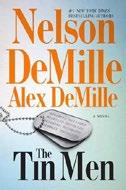
Robots may be the future of warfare in this final fatherson DeMille collaboration.
In Camp Hayden, Army Maj. Roger Ames is found dead, his skull crushed. Chief Warrant Officers Scott Brodie and Maggie Taylor, special agents of the United States Army Criminal Investigation Division, are sent to the Mojave Desert, “a.k.a. in the middle of nowhere,” to investigate. In this fictional military installation, Army Rangers conduct field training exercises with lethal autonomous weapons. These “dangerous new toys,” nicknamed “tin men,” may become the future of warfare if they can be programmed to distinguish between friend and foe. Anyway, the Rangers’ job is to train the tin men, not
the other way around. They are AI-driven robotic prototypes called D-17s, but even prototypes can kill. Did a bot kill the major? And was there criminal liability or intent, or was it a tragic accident? Brodie and Taylor discover that not everyone loves these beasts, and they must find out if humans are programming them for mischief or even trying to set up the program for failure. Meanwhile, the bots have nicknames. Bot number 20 is Bucky, seen on a video as a “seven-foottall titanium machine with hands covered in blood and brain matter” that has “a face but no eyes, with hands but no skin, with a body but no soul.” As scary as these beasties are, Brodie and Taylor must also look at the humans at Camp Hayden, because they learn that the “machines don’t have motives….They have inputs and outputs,” which naturally come from human programmers. They have neither brains nor courage nor honor; they do have brute force, speed, and agility. Obviously, plenty goes haywire in this enjoyable yarn. It feels a bit too believable for comfort, and that’s to the DeMilles’ credit as storytellers. Nelson DeMille had begun this project with his son Alex, who had to finish it alone after his father’s death.
Fast-moving and disturbingly plausible.
Downing, Antonio Michael Simon & Schuster (272 pp.) | $27.99 August 19, 2025 | 9781668066102

A mixed-race girl comes of age in South Carolina communities leery of accepting her.
“You’re halfBlack, halfCherokee, and all mixed up,” says Blue, the grandmother of Ophelia, the protagonist of Downing’s debut novel. Opening in 1993, when Ophelia is 7, and following her to 2005 and her early adulthood, the novel tracks her in three milieus. The first is Etsi, a town where Blue teaches Ophelia Cherokee lore on what was a former reservation. Later, she
moves in with her aunt in Stone River, a predominantly Black community, where she’s treated by her Black cousins and classmates as a misfit—bookish, quiet, and overly proud of her suspect Native heritage. An escape hatch seems to appear in the form of La Belle École, a school designed for gifted Black children, but that puts Ophelia into the orbit of a predominantly white high-school culture that largely shuns her as well. More precisely, it introduces her to the Beauregard clan, a white farming family that’s ruled much of the region’s economy—and poisoned the river in Etsi. As studies of racial divisions, Downing’s conflicts can feel tidily straightforward at times, which makes Ophelia’s sense of being out of place feel repetitive; the final conflict involves a familiar trope, and a magical-realist gesture isn’t persuasive. But if Ophelia’s path is bluntly allegorical, the novel is enlivened by its secondary characters, particularly Blue and Belle, the founder of La Belle École, both hard-charging and no-nonsense types. Downing’s story opens up questions about how much separate racial communities can intermingle while still preserving their identities, and shows how those overlaps can prompt power struggles, sometimes vicious ones. But it lacks a strong, surprising character at its center. An earnest if not entirely successful tale of generations-old social and racial divisions.
Dunham, Lacey N. | Atria (304 pp.) | $28 September 9, 2025 | 9781668084861
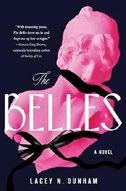
Freshmen at an exclusive Southern women’s college bond, and their swings between obedience and recklessness lead to long-term trauma. Alumnae of Bellerton College should be able “to hold our own during conversations on both politics and literature, and we would also know how
to arrange excellent charcuterie. We might be smarter than our husbands, but at Bellerton we would have learned the necessary tact to never point this out.” It’s 1951, and in the Old Dominion State, young women are expected to graduate with both B.A. and M.R.S. degrees, flaunting engagement rings even before mortarboards are donned. Deena Evangeline Williams knows this before she arrives at her room in South Hall. Despite her background—she was raised by her housecleaner grandmother— Deena hopes to learn her peers’ ways while she keeps a secret that might ruin her chances for a Bellerton-approved future. If this territory has been mined by other writers, it doesn’t matter much as debut novelist Dunham juggles gothic elements including a nasty poetry professor, a drunken misery of a housemother, and glimpses of ghosts in the campus trees. Queen Bee Ada May Delacourt; closeted Winifred (Fred) Scott and her bestie, Sheba Wyatt; Nell Lawton-Peters; and Prissy Nicholson from Texas at first hew so closely to the expectations of Mrs. Tibbert, the wife of the college’s president, that she declares them the Belles of their class. But small things start to go missing from the girls’ rooms and as they snipe at each other, they also discover how good it feels to be bad, brandishing their signature hair ribbons like battle standards and roaming the woods at night, damn the consequences. Deena begins to encounter the apparition of a 19th-century student, Mary Burden, and wonders why only she can see her; even if readers guess, they’ll already be under the spell of this isolated school. As the Belles prepare for their 50th reunion in 2002, their 21st-century lives offer bitter commentary on the real lessons they learned. Both a time capsule, and a ticking bomb, of womanhood repressed in service of societal conformity.

Flagg, Fannie | Random House (288 pp.) $29 | August 19, 2025 | 9780593734414

Thirty stories showcase the down-home author’s take on various modern dilemmas.
Flagg’s first collection of stories after many popular novels features the sweet, quirky characters and whimsical predicaments she’s known for. Some of the stories are linked; for example, the collection is bracketed by stories about Special Agent William Frawley, who’s sent from distant Planet 8676 to report on human beings and find out why they are all so unhappy and staring at their hands. (Can you guess?) Typical Flaggian elements include the fact that the spaceman’s human avatar is based on the actor who played Fred on I Love Lucy, and that once he arrives in Fort Wayne, Indiana, Agent Frawley falls in love with the whole bedraggled human race, but particularly a woman named Debbie, who scoops ice cream at Baskin-Robbins. Another set of stories revolve around “Velma Ruth Vanderhoff, a sweet-looking apple dumpling of a lady, with snow-white hair as soft as cotton candy,” who’s never left her hometown of Cottonwood, Kansas. Her granddaughter Cathy, a yoga teacher in California, desperately wishes her grandmother would get online so they could text and FaceTime, but as it is, she’s confined to expressing her worries about climate change, the patriarchy, and her daughter Tracie Ann’s gender identity on a landline. She could visit…but will there be a charging station for her rented Tesla? Flagg offers a gently humorous grandma’s-eye view of these and other matters, from fat-shaming, racism, and disability rights (“Hunter College,” “The High School Reunion”) to adultery and murder (“Darla Womble”) to the problem of staying in one’s lane for white male authors (“The Fiction Writer”). All in all, the collection is not quite as engaging or successful as Flagg’s novels,
but it could serve as either a gateway drug for newbies or a snack pack for die-hard fans.
What with the current enthusiasm for grandma-core, Flagg’s comforting, nostalgic storytelling may be just the ticket.
Photograph
Freeman, Brian | Blackstone (320 pp.)
$28.99 | October 7, 2025 | 9781665109765

A tense psychological thriller introducing a strong female protagonist. Kate Selby visits the coastal Florida office of Shannon Wells Investigations and demands to know why her mother, Faith, had hired a private eye a year earlier. It turns out that Faith had wanted Shannon to find out her true identity, which Shannon had been unable to do. Now Kate says her mother has been murdered. What follows is a dark, moody mystery revolving around a 25-year-old photograph taken by Faith that appeared in a coffee table book named Millennium Memories, depicting images of ordinary people doing ordinary things. In the photo, a young girl is standing in front of a motel vending machine and holding a red can of Coke, her back to the camera. But there had been a murder in the motel parking lot that night in Michigan so long ago. Now the killer wants to eliminate witnesses and seems to have tracked down Faith. Who was the girl in the photograph, and what happened to her? And is Faith’s death connected to the recent triple murder of a prosecutor and his family? Shannon has horrible nightmares about a man coming to kill her, and she has a scar on her face from an event in her own past. A strange woman named Maro in Cocoa Beach tells Shannon that a man killed her in past lives and is about to do it again unless she can kill him first, and she’s unsure whether to believe the woman’s
Haynes’ first collection is a treasure trove of warmth, smarts, and wisdom.
MARTHA’S DAUGHTER
story. Is Maro addled by the lightning strike she survived as a child, or did it give her special powers? There are moody scenes involving darkness, wind-driven rain, and lonely roads that bring to mind the opening chapters of a Stephen King novel. And those roads twist a lot as Freeman unloads one surprise after another. He has written several excellent adventures including Robert Ludlum’s The Bourne Evolution (2020).
An enjoyable read. May there be more Shannon Wells tales to come.
Kirkus Star
Martha’s Daughter
Haynes, David | McSweeney’s (324 pp.) $26 | September 9, 2025 | 9781963270273

A master class in storytelling from the inside out.
The “Martha” in the title novella that kicks off this spirited, witty, and illuminating array of short fiction is the recently deceased mother of Cynthia Garrison, a St. Louis-born-and-bred Black professional who is en route to the funeral home where Martha’s remains are being prepared for burial. Cynthia, caustic, judgmental, and perpetually dissatisfied, is staging in her mind a kind of extended wake for her caustic, judgmental, and perpetually dissatisfied mother. Not even the congenial, supportive presence of Janine Chalifour, a white co-worker who accompanies Cynthia on a trip to the mortuary, can distract Martha’s daughter from taking acrid inventory of her entitled mother’s unending torrent of insults, complaints, “harrumph[s],” and
nagging correctives. The kind of mom who will routinely say things to her daughter like, “And this is what you’re wearing today?,” then cross her arms and “look from [Cynthia] to the doorknob and back. Like a bossy and overindulged German shepherd ready for its morning walk.” At the same time, Cynthia, who has had little time to acclimate herself to Martha’s death, knows there are aspects of this mostly exasperating legacy that have given her just as much to be grateful for, and it is through this private understanding that the story offers readers with similarly challenging families a route toward tentative yet uneasy reconciliation. This blend of edgy humor, discerning compassion, and acute observation pervades all these tales of intelligent, resourceful Black women who may not be as resilient as they think they are, but find surprising reserves of strength and self-sufficiency, even at their worst or, at least, most unsettling times. Haynes’ first collection of stories is a treasure trove of warmth, smarts, and wisdom.
Kirkus Star
Hill, Joe | Morrow/HarperCollins (896 pp.)
$38 | October 21, 2025 | 9780062200600

Hill, son of the master, turns in a near-perfect homage to Stephen King. Arthur Oakes has problems. One is that his mom, a social justice warrior, has landed in the slammer for unintentional manslaughter. And
he’s one of just three Black kids at an expensive college (in Maine, of course), an easy target. A local townie drug dealer extorts him into stealing rare books from the school’s library, including one bound in human skin. The unwilling donor of said skin turns up, and so do various sinister people, one reminiscent of Tolkien’s Gollum, another a hick who lives—well, sort of—to kill. Then there’s Colin Wren, whose grandfather collects things occult. As will happen, an excursion into that arcana conjures up the title character, a very evil dragon, who strikes an agreement with fine print requiring Arthur and his circle to provide him with a sacrifice every Easter. “It’s a bad idea to make a deal with them,” says Arthur, belatedly. “Language is one of their weapons…as much as the fire they breathe or the tail that can knock down a house.” King Sorrow roasts his first victims, and the years roll by, with Arthur becoming a medieval scholar (fittingly enough, with a critical scene set at King Arthur’s fortress at Tintagel), Colin a tech billionaire with Muskian undertones (“King Sorrow was a dragon, but Colin was some sort of dark sorcerer”), and others of their circle suffering from either messing with dragons or living in an America of despair. There’s never a dull moment, and though Hill’s yarn is very long, it’s full of twists and turns and, beg pardon, Easter eggs pointing to Kingly takes on politics, literature, and internet trolls (a meta MAGA remark comes from an online review of Arthur’s book on dragons: “i was up for a good book about finding magical sords and stabbing dragons and rescuing hot babes in chainmail
panties but instead i got a lot of WOKE nonsense.…and UGH it just goes on and on, couldve been hundreds of pages shorter”).
At turns spooky and funny, with bits of inside baseball and a swimming pool’s worth of blood.
Hobson, Brandon | Ecco/HarperCollins
(352 pp.) | $29 | October 28, 2025
9780063259652
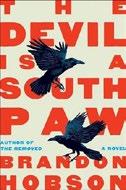
Two boys navigate juvenile detention in Hobson’s oftsurreal metanovel.
The bulk of this book is an imagined novel titled The Devil Is a Southpaw (named after an imaginary film starring John Wayne) by Milton Muleborn, who has sublimated his experience in an Oklahoma juvenile facility in 1988 into a peculiar yet compelling narrative. His version of the story is filled with teenage crushes, abusive jailers, a storm where frogs rain down like water, cameos by Salvador Dalí and Frida Kahlo doppelgängers, and an attempt to escape the facility. The narrator was consumed with jealousy of a fellow inmate, Matthew Echota, who was a gifted painter (examples of his work are scattered through the narrative); Milton became a writer, he suggests, in a bid to catch up with Matthew’s talents. (Muleborn the author seems aware of the potency of his envy, giving his character’s literal devil horns on his forehead.) Latter sections of the novel clarify the facts
A rough, deliberately messy tale, revealing the depths of broken childhoods.
somewhat and move the story closer to the present day. We learn the reasons behind the boys’ incarceration, which involve weed and firearms in the pre-Columbine era. There’s a certain poignancy in Milton’s desperation to be heard and understood, underscored by a series of family traumas, including a suicide. In earlier novels, Hobson has proven himself gifted at exploring characters from multiple perspectives, usually with an emphasis on Native American traditions. Here the storytelling is more slippery and at times less successful—Milton’s novel is immature by design, filled with intentionally overheated prose. That doesn’t make Hobson’s novel a failure, but it challenges the reader to set aside conventional measures of success— here, it’s about how agonizing it can be to lay bare our adolescence. A rough, deliberately messy tale, revealing the depths of broken childhoods.
Javed, Kanza | Norton (224 pp.) | $27.99 September 23, 2025 | 9781324111092

Buried grievances, long-held secrets, and cutting grief simmer in the lives of Pakistani women. Javed’s second work of fiction shares eight moving stories, each ending with its own kind of clarity, of “atonement.” In “Rani,” the opener, recently divorced Annie takes care of her grandmother, whose dementia has worsened after the death of her husband. Through their fractured conversations, Annie comes to remember Nargis, a maid who lived at her grandparents’ house when she was a child, and the unforgivable way she was treated. “Stray Things Do Not Carry a Soul” follows a young boy named Haider Ali, the book’s only male narrator, who, in idolizing his father, is forced to reckon with the
realities of violence, addiction, and misogyny. While most of the stories stick to immersive realism, there are a couple of well-executed speculative moments: In one story, a woman’s dead twin visits her in a moment of suffering; in another, the ghost of an old, sickly woman’s lover appears to her in a glass bottle. The longest, closing story, “Ruby,” details the lives of 13-year-old Kaki and her mother, Rubina, after Kaki’s father dies. Rubina transforms into Ruby, becoming the vibrant, bold woman she had suppressed while trapped in a constrictive marriage. Newly free, Ruby and Kaki hide their Christian faith and move to a Muslim neighborhood, where Ruby falls in love with a man named Samuel and begins working for a wealthy widow named Tanya. Kaki begins to feel at home among these people, along with a new friend, Fatima. However, Kaki must grapple with the fact that this new iteration of her mother is a woman who primarily looks out for herself, and that financial security and friendships can shatter at any time. There are several chilling moments in the book—Javed does not shy away from tragedy and the darker sides of human nature—but the ending of this story is by far the most haunting. This collection is one to be admired, particularly for how it powerfully depicts Pakistani women (both in Pakistan and the U.S.) yearning for lives they have had ripped from them by patriarchy or prejudice. “We are catacombs of trauma,” Javed writes, “reservoirs of hurt.” Even so, these stories uplift the idea that we will all come upon an opportunity to be purified, whether in life or death. Skillfully drawn, often heartbreaking reckonings.

Jeyamohan | Trans. by Priyamvada Ramkumar | Farrar, Straus and Giroux (400 pp.) | $19 paper | August 12, 2025 9780374619459

The first English translation from one of the most prolific and occasionally provocative writers in India—a literary critic and leftist political gadfly, as well as a writer of epic fiction that can mix fantasy, metaphysics, and social commentary. In an author’s note to this volume, which was originally published in Tamil in 2011, Jeyamohan highlights “aram”— “the Tamil equivalent of the Sanskrit word ‘dharma’”—and writes, “Arising from the most fundamental questions of aram, every one of these stories celebrates the triumph of humanity. That is the vision these stories have revealed to me. That is the flag I hold up through them.” Such triumph manifests itself through these stories of extraordinary individuals who have challenged and transcended the strictures of caste, religion, nationalism, and other constructs that divide the world rather than bring it together. As a concluding “Note on the Real-Life Characters” suggests, many of his characters have left a historical imprint in real life. In “He Who Will Not Bow,” a boy from the caste of “the wage slave” escapes from his destiny and becomes a self-educated government official by British appointment. He tells those who might challenge him: “I am a man who has risen from a manure pit. I have seen things far worse than death. There is nothing left for me to fear in this life.”
In “Elephant Doctor,” the man known by that title had become celebrated as “a living legend,” healing humans and elephants alike, yet resists attempts to glorify him and keeps his focus on the service he provides. The political activist who might be a fool or saint in “Nutcase” and the self-proclaimed citizen of the world in “One World” show how much impact one person can have. These are fictionalized versions of
stories the title calls “true”—spiritually, politically, communally.
A collection of vividly detailed stories with themes that are often idealistic and inspirational.
Laurain, Antoine | Trans. by Emily Boyce & Jane Aitken | Pushkin Press (144 pp.) | $16.95 paper | September 2, 2025 | 9781805333531

Laurain’s first novel, a mordant fairy tale originally published in France in 2007 and in the U.K. in 2016, finally makes it across the Atlantic. Burgundy patent attorney Pierre-François Chaumont is addicted to auctions and collecting. His wife, Charlotte, doesn’t share his passion, and she’s recently demanded that he banish all his objets d’art to his study. Soon after he begins to sneak them back into the rest of their house, he stumbles on a painting that will determine the remainder of his life: a portrait of Louis-Auguste, Comte de Mandragore, a friend of King Louis XVI who went into hiding during the Terror and assumed the identity of Auguste Chaumont, a country locksmith. From the moment he sees the painting, the collector knows he must possess it because it looks exactly like him. When he buys it for nearly 12,000 euros, Charlotte, who doesn’t see the resemblance at all, withdraws from him in a cold fury, and the gulf between them has widened considerably by the time Chaumont walks into a café in Rivaille and is immediately mistaken for Aimé-Charles de Rivaille, the current Comte de Mandragore, who vanished during a trip to Paris four years ago. Originally determined to burst this illusion, Chaumont is carried along by the villagers’ obvious excitement at seeing their friend return and goes along with the masquerade, encouraged by the fact that Mélaine de Rivaille, the count’s wife,
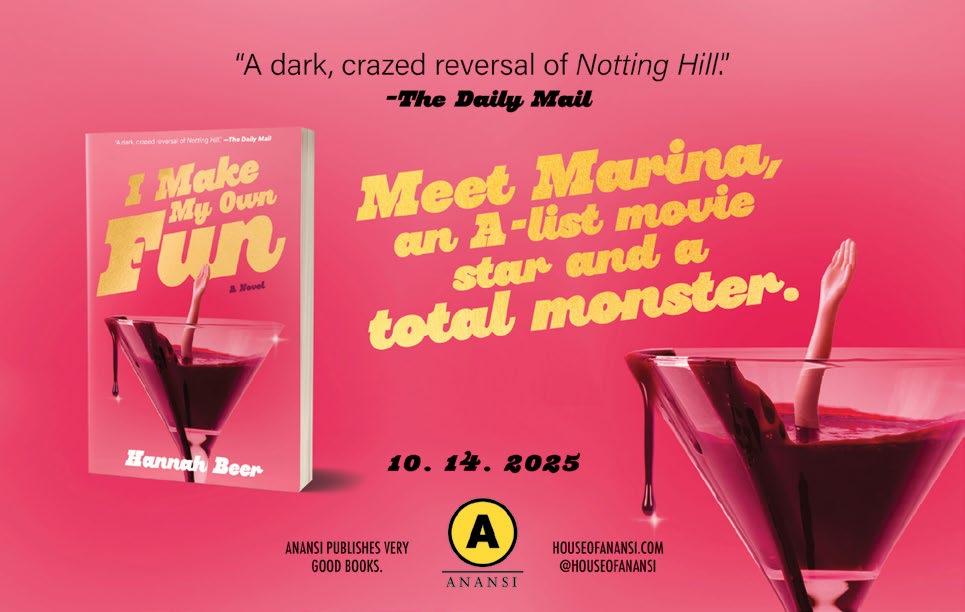



Author of Clown Town
MICK HERRON had been writing about Jackson Lamb and the misfit M15 agents of Slough House for more than a decade before the Apple TV+ series Slow Horses brought them a larger, even more adoring audience. The latest installment, Clown Town , features the head of British intelligence being blackmailed by a former member of Parliament, among other complications. As our starred review asks, “Since all these developments are filtered through the riotously cynical lens of Herron’s imagination…what could possibly go wrong?” Herron answered our questions by email.
Tell readers, briefly, what Clown Town is about.
The new book is about a group of former agents who were involved in a controversial operation in Northern Ireland at the height of the Troubles and are seeking reparation for what they see as the damage done to themselves and their careers as a result. At the same time, River Cartwright—not yet passed fit-to-return-to-work after the toxic harm done to him in Slough House —is looking into the disappearance of a book from his late grandfather’s library. As these two plot strands come together, the remaining slow horses are caught up in the resulting net.
Has anything changed about writing the books since the TV series began?
I don’t think so. I was well established in writing the series before filming began, let alone streaming. Though it’s true that Bad Actors , the first of the novels to be written since shooting started, is full of imagery borrowed from TV, cinema, and theater. I might not have gone down that route without the experience of being on set.


What inspired you during the writing of the book? What were you reading, listening to, watching?
I read pretty much constantly. I keep a list of what I’ve been reading these days, and during the 18 months or so that I was writing Clown Town I read something like 170 novels. I won’t list them all here. I listen to jazz or contemporary classical: Omar Sosa was a favorite during this period; the Tarkovsky Quartet was another. As far as TV goes, I watch pretty much exclusively drama (I get my news from radio and print). The police show Blue Lights— set in Northern Ireland, as it happens—was one of the best things I saw during that time, one of those shows which focuses on character development as much as plot. Though I’d add that I wouldn’t call any of these things “inspirational.” They’re just part of daily life.
Where and when did you write the book? Describe the scene, the time of day, the necessary accoutrements or talismans.
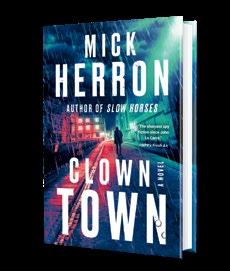
Herron, Mick Soho Crime | 352 pp. | $29.95 September 9, 2025 | 9781641297264
I try to maintain a 9-to-5 working day. I need to be in my own writing space (I don’t work anywhere else) and I need my laptop, but that’s all. I don’t have talismans—one of those words that looks very odd in the plural. (“Talismen”?)
What fall release(s) are you most eager to get your hands on?
Philip Pullman’s The Book of Dust: The Rose Field. It’s been a long time coming.
Interview by Laurie Muchnick.
joyfully accepts him as her husband and takes him to bed. This wildly improbable idyll can’t last, of course, and it’s particularly appropriate that it’s ended by the imposter’s plan to recover all the treasures he left behind. Slight but magical.
Lavender, Meredith & Kendall Shores
Bantam (320 pp.) | $30 | June 24, 2025 9780593974377

When her husband goes missing, Nora challenges the balance of power in her wealthy community to find out what happened. It’s not easy being a younger second wife. As she surveys the glamorous party she’s throwing for her husband Will’s 46th birthday, 28-year-old Nora Somerset knows that to the ultrawealthy society of Winter Park, Florida, she’s an interloper. But after a whirlwind courtship with “Hot Mean Lawyer” Will, Nora seems to have hooked the white whale—and she’s head-over-heels in love with him. Never mind that his first wife cuts her dead every time they meet; never mind that his law partner has pressured her to sign an agreement in case the marriage doesn’t work out; and never mind that Will, a workaholic, rarely comes home for dinner and shuts her out of his business life. She finds good friends in free-spirited millionaire neighbor Este, her husband, Beau, and their friend Marcus. Despite some marital struggles between Nora and Will, the party celebrates not only
Will’s birthday but also their recent recommitment to each other. So when Will gets a phone call just before they go upstairs at the end of the evening, Nora isn’t worried. And when she wakes up alone the next day, she figures he’s at work. But when two days go by without any sign from Will, it becomes clear that something has happened: Her husband is missing and—after his shirt is discovered in the lake behind their house—is presumed dead. The novel begins on the night of the party and then tells the story both forward from the couple’s first meet-cute and forward from Will’s disappearance. Nora is a feisty, self-aware, and appealing character, but as thrillers go, this is pretty tame. The focus on the wealthy community of Winter Park necessarily limits the possible suspects, so there isn’t much suspense baked in. The fascination lies in the way Lavender and Shores pull back the curtain on this enclave of affluence, and how Nora is both repelled and seduced by this world. A story rooted more deeply in setting than in suspense.
Levine, Elise | Biblioasis (240 pp.) | $16.95 paper | October 7, 2025 | 9781771966924

Nine short stories of (mostly) women fed up with whatever life is serving. Though the stories aren’t connected, the collection has a shared universe of ideas, characters, and certainly a repetition of aggrieved narrative voice.
Fiction that makes artful demands, and in return, offers substantial rewards.
“Once Then Suddenly Later,” about the 19th-century photographer Félix Nadar, is a short story “written” by Ivy Segal, a character mentioned in “Return to Forever” and then featured in “Take Ten”; Paisley is the narrator of “Penetrating Wind Over Open Lake,” about two music students competing for the same small slice of genius; then her envious boyfriend is narrating his own later life in “Sounds Like.” The strongest stories, “Arnhem” and “Dig!,” cover 40 years of Marianne as she navigates divorce, professional upheaval, and, through it all, an obsession with her childhood friend, “a star, a dark inferno, in my life.” As teenagers they hitchhike through Europe, perpetually on the edge of disaster, and visit her friend’s brother, Shane, on an archeological dig in England. Marianne, sexually entangled with her friend, nevertheless has a crush on Shane, who is in an incestuous relationship with his sister. Marianne becomes a writer and bumps into Shane at a conference in Venice—he growls; she continues to stalk him decades later. Another standout, “Witch Well,” is about the disintegration of a women whose teenage son dies; her witchy rebellion is an utter disregard for her house, appearance, and neighbors in their manicured gated community. Also “Return to Forever,” about four artist friends girl-tripping in Joshua Tree, where they seem to forget everything. Throughout, the writing is like a Modernist poem: “Finally we are old. In the desert, we peruse the orange boxcar”—filled with startling images, but also half-thoughts and half- sentences, leaving the reader, like the characters, on the tenterhooks of understanding. Fiction that makes artful demands, and in return, offers substantial rewards.

Lutz, Tom | Red Hen Press (288 pp.) | $19.95 paper | October 7, 2025 | 9781636284279

Four stories merge into one in this tale of politics and greed set in the Indian Ocean. No one can trust anyone in this incendiary tale of murder, espionage, and soulless profiteering. In his second novel, Lutz, a founder of the Los Angeles Review of Books, presents four lonely characters who want more from life but don’t know how to get it. Mónica, from Spain, was convicted of killing her sexually abusive stepfather when she was a teen. When she grabs the attention of a mysterious stranger, she’s freed from prison with the understanding that she’ll be trained as an assassin. Much like the conniving Villanelle in Killing Eve —whom her anonymous boss often references—she becomes a ruthless, untraceable killer. Alain screwed up his life in Madagascar by betraying his wife and getting his girlfriend pregnant. He joins the French Foreign Legion but finds his assignment tedious and thinks about going AWOL. Skye, who’s good at manipulating people, may or may not be a spy, and she could be working for anyone including the Americans, the Chinese, or the Russians. Frank, an American, is the ultimate loner, sailing his boat around the world avoiding human companionship. He accidentally made a lot of money but at the cost of multiple lives. The four will be drawn together to confront a shared enemy as the story sails toward a bloody, firefight-drenched conclusion on the Chagos Archipelago. This novel will appeal to readers who like a slow burn, a deep dive into characters’ hearts and minds, and whose curiosity is piqued by stories involving racism and privilege. It’s also a profoundly disturbing tale about the callous disregard for the biodiversity of land masses like Chagos that are often exploited in get-rich-quick schemes.
An eco-thriller that builds toward an explosive conclusion.
Mallon, C. | Scribner (208 pp.) | $26.99 August 12, 2025 | 9781668084427

Five teenage boys come of age together, mostly experiencing the worst life has to offer.
In a small city called Carbon, Hal, Carter, Cody John, Zachary, and Dylan are on the high school wrestling team. Most of the time they spend together outside of wrestling involves driving around in Dylan’s decrepit car and consuming drugs and alcohol. Hal, the narrator, is prone to dark thoughts and fixations on the litany of tragedies that have occurred in their town. He understands that he’s different from others, including his friends: “I had gone wrong somewhere. There was no fixing that.” Hal’s loathing is largely reserved for himself but not always; he got into wrestling after an incident in eighth grade when he beat another student so badly that the kid “looked majorly deformed.” Amid their roughhousing and drinking and this bleakness, the boys show affection in their own ways, and Cody John and Hal are especially tender to one another. In a moment of watching his friend, Hal thinks, “If I had only had eyes for one thing then it would have been Cody John, stood on the borderline, cradled in stars with his body whole.” On one particularly charged night, the boys drive out to a place “tucked under the summit of the mountain,” where something occurs that will destroy their lives. Mallon employs an unquestionably unique writing style in this debut novel; Hal narrates in plenty of short, blunt sentences (“Everything he did he hit it too hard. I understood that. I knew all about that”), but some of the language, while interesting, is embellished slightly past its peak (“Styrofoam beads torn away by the warm wind to pack out the cracks in the concrete”). This is an intense, bleak tale that gets even darker after its turning point. Readers (especially sensitive ones) should approach this powerful novel with care, exploring as it does the troubled
bonds we hold dear and the traumatic events that people, even and especially younger people, can endure.
A novel of almost depthless darkness and a show of significant talent.
McKinney-Whetstone, Diane Amistad/HarperCollins (256 pp.) | $26.99 August 12, 2025 | 9780063395428

A Black novelist in present-day Philadelphia, struggling with illness and betrayal, weaves a story around multiple generations of a Philly family that must contend with their ancestral gift of foresight.
Nona, a Philly-based writer whose voice opens McKinney-Whetstone’s novel, has pancreatic cancer, and when she sits down to start a novel, her first draft revolves around a mesmerizing, dying woman, which is unsettling to her. She tries again, and before long she’s written a scene in which a girl named Ayana and her mother, Lorna, survive a car crashing into the store where they’ve been shopping. When 6-year-old Ayana confesses that she was able to avoid the wreckage because she’d had a vision of it minutes earlier, Lorna realizes that her daughter has inherited “the gift” from her paternal family. The Maces trace this trait back to Luda, whose parents were freed in Pennsylvania’s 1780 Gradual Abolition of Slavery Act. In the late 18th century, Luda saw a rainbow invisible to everyone else, and since then, the Mace women—many of whom retain their name even after marriage—have honored what they call Knowing. They hold regular meetings during which they counsel community members who have problems, and then share “afterfeasts” complete with dances, chanting, and elaborate hand-sewn gowns that incorporate talismans like a pearl owned by Luda. Nona’s
story then swerves from Lorna and Ayana to Ayana’s Aunt Lil, granddaughter of powerful Mace matriarch GG. As a young woman in the 1970s, Lil was banished from family meetings because she revealed the gift of Knowing to an outsider in her bid to build a career in media (she starts with an appearance on the era’s real-life Philadelphia hit, The Mike Douglas Show). Lil’s section sparkles with authenticity, as does a section about Ayana when she’s 22, torn between easy delights with two very different men and buckling down in her undergraduate studies. As Ayana wavers, Aunt Lil returns to Philadelphia. She has a personal reason for this visit, and a Knowing of her own that leads to her reconciliation with the family. As Nona builds the story of the Mace women, she also makes some choices—but it’s difficult to understand what links her actions with those of her characters. Is the titular spirit affecting her? Is she also related to the Mace family? It isn’t clear, and even a tiny glimmer of her ties to them might have held the book together the way Luda’s cherished pearl secures Lil’s long-abandoned ceremonial gown. A vibrant, if structurally flawed, look into the power and spirituality of a multigenerational Black family.
Kirkus Star
McMillan, Terry | Ballantine (256 pp.) $28 | September 9, 2025 | 9780593357149

The best part of reading this entertaining collection of published and unpublished fiction, sketches, and nonfiction is the sheer delight of immersing yourself in the works of a writer who has plenty
Cursed sex workers find love and seek vengeance in 1769.
SLASHED BEAUTIES
to say and has never been afraid to say it.
Author of 1990s megahits like Waiting To Exhale and How Stella Got Her Groove Back, McMillan has been chronicling the hopes, dreams, and defiance of Black women for decades, examining relationships between men and women, friends, neighbors, and family with hard-won wisdom and a rebellious authenticity. In these stories, economic woes figure prominently in the lives of her characters. Most of the protagonists are women, but in “The End,” published in 1976, a weary worker at the Ford Motor Co. confronts his dull days and the myriad factors that trap and isolate him. In “Reconstruction,” a man loses his job, and a couple’s relationship deteriorates into physical violence and sexual abuse. In “Ma’Dear (for Estelle Ragsdale),” a scrappy elderly widow survives by taking in boarders she’s not supposed to have. There are also characters struggling with love and its fallout—pregnancy scares, anger, regret, loneliness and loss—proving that McMillan has never shied away from frank assessments of sex and its power. In one of the best stories, “Can’t Close My Eyes to It,” a young girl spends time with her beloved grandmother and learns hard lessons about life. Even McMillan’s quick sketches are so immediately absorbing that you wish she’d fleshed them out into full-blown stories. You won’t want to skip the nonfiction pieces, which range from essays to a commencement speech, because the author’s voice is always engaging. But it’s through her fiction that McMillan shines brightest. “She reads the times we’re living through,” author Ishmael Reed writes in the foreword, a truth evident on every page. An entertaining reminder of McMillan’s storytelling abilities and unflinching honesty.
Rushby, A. | Berkley (384 pp.) | $30 September 23, 2025 | 9780593954645
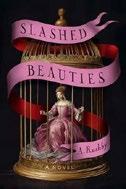
Cursed sex workers find love and seek vengeance. In 1769, 18-year-old Eleanor runs away to London with her boyfriend, Nicholas, assuming they’ll marry. Instead, after two weeks of passion, Nicholas leaves their lodgings and doesn’t return. Eleanor is searching for him at the Vauxhall Pleasure Gardens when the elegantly dressed Elizabeth suggests they have dinner. Over an array of delicacies, Eleanor tells Elizabeth her troubles, and “fallen woman” Elizabeth offers Eleanor employment. After having been “kept” for two years by a wealthy sea captain, Elizabeth is opening her own “genteel” establishment—”a sérail, no less”—offering “entertainment and fine company.” For half of what Eleanor earns “entertaining” rich men, Elizabeth will train, clothe, house, and feed her. Eleanor moves into Elizabeth’s opulently furnished King Street rooms, where she meets and develops an immediate affection for fellow new hire Emily. Needing capital, Elizabeth negotiates payment for the three of them to serve as models for wax anatomical Venuses designed to entice medical students through a local anatomist’s studio door. Meanwhile, in the present day, antiques dealer Alys acquires Elizabeth’s wax form, having already secured Eleanor’s and what remains of Emily’s. Preternaturally captivating on their own, legend has it that when united, the three “slashed beauties” assume human form, hunting
and killing “any man who has dared to look at them lustfully.” Alys’ family has a “long connection” with the Venuses, and she knows it’s her destiny to destroy them; however, certain diabolical forces will do whatever it takes to stop her. The first-person, presenttense narration alternates between Eleanor and Alys, their stories informing each other while unfolding in tandem. Though the mechanics of the Venuses’ dark magic are at times confusingly vague, Rushby’s prose is lush and vivid, her characters are tragically complex, and Emily and Eleanor’s mutual devotion proves the perfect foil for the macabre tale’s more gruesome elements. Ferociously feminist body horror with a sentimental heart.
Russo, Kate | Putnam (304 pp.)
$30 | July 15, 2025 | 9780593850688

A college student is forced to face past cruelties and mistakes when a childhood friend is murdered.
Rachel Nardelli, a senior at Denman College, feels stuck and uncertain about her future. She’s isolated herself from her fellow journalism students, committed instead to her toxic boyfriend, Cam, who flirts with freshman girls during the epic parties he throws in his dorm room while Rachel drinks to the point of blacking out. One night she thinks she sees Alison Petrucci, a friend from her childhood, leaving one of Cam’s parties; when her former friend’s body is discovered the next morning, Rachel is forced to reveal some of her darkest, most shameful adolescent memories as the journalism team investigates. The novel unfolds through these two timelines: the present day, as the journalism students look into Alison’s murder with the help of Michaela Stannard, a sympathetic faculty member; and the past, where we learn about how Rachel and Alison became best friends—and then how the friendship was picked apart and
destroyed. There is a mystery here, but the book is more truly an exploration of adolescent friendship, bullying, and social pressures, plus the guilt that follows these broken relationships. Secondarily, it’s a condemnation of male misbehavior and entitlement. And thirdly, it’s a story of how a young writer finds her path with the right guidance and support. Rachel doesn’t always come across as the most relatable or sympathetic protagonist, but she is shatteringly human, and in that authenticity lies her appeal. “Be bold, write about the things you care about, not just the things you think you should,” Stannard challenges Rachel in the end. And so, Rachel—and Russo—do. Celebrates and empowers the women who bear witness to injustice and tell about it.
Ryan, Tom | Grove (352 pp.) | $27 October 14, 2025 | 9780802165886
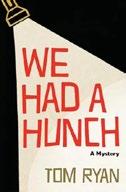
Three former teen sleuths unexpectedly reunite and revisit their shared pasts along with the horrific crime that changed their lives forever.
Twin sisters Alice and Samantha Van Dyne became the sensation of Edgar Mills, Massachusetts, when, as high schoolers, they helped their father, Police Chief Bill Van Dyne, crack a case involving drug smugglers. Their friend Joey O’Day joined them in notoriety when he used his computer skills to solve an internet scam. Then the twins tackled a case involving a serial killer dubbed “the Janitor” and became involved in a series of mishaps that led to the death of their father, leaving them permanently traumatized. In a narrative that moves between third-person accounts focused on each member of the trio, Ryan crafts a character-driven, deeply psychological narrative about loss, heartbreak, and redemption. Chapter One begins with Alice, who stayed on in Edgar Mills and married the brother of the high school sweetheart who was also
one of the Janitor’s victims. Her sister, Samantha, became a reality-TV star in LA while Joey made his fortune in the Boston tech industry. When a Janitor-inspired murder in Edgar Mills makes national headlines 25 years later, Alice, Samantha, and Joey cross paths once again, not only with each other, but with the now-jailed Janitor, who claims he didn’t commit all the murders that were attributed to him back then. Inexorably drawn into a new investigation, the trio finds themselves forced to confront not only their roles in the first set of Janitor murders but also disturbing truths about themselves, their loved ones, and apparently innocent bystanders with agendas more shocking than any of them could imagine. Clever, tightly plotted, and complex, Ryan’s novel is as immersive as it is satisfying.
A fabulously twisting maze of murder, intrigue, and suspense.
Shea, Samantha Browning | Putnam (336 pp.) $29 | September 9, 2025 | 9780593851951

A woman goes to extremes to gain access to her heart’s desires: community and control. Oona believes she is cursed. And while to most people the idea of a curse may seem farfetched, for Oona, who was raised by a group of self-proclaimed witches, it’s a distinct possibility. She grew up on Marrow Island, off the coast of Maine, at the Bare Root Fertility Center, owned and operated by her mother, Ursula. This fertility center is staffed by midwives who call themselves witches, and who treat their clients— both those who are giving birth at the center, and those who are desperate to get pregnant—with a mixture of holistic and (supposedly) otherworldly medicines. Unfortunately, Ursula doesn’t believe that Oona has the gift of magic, and so Oona spent her childhood on the outskirts, desperate to find a way in, until eventually she was kicked out
under mysterious circumstances. As an adult Oona realizes that her way back into the coven is the same as any other woman’s: She needs to be pregnant. But Oona is plagued by a series of miscarriages. She believes these miscarriages aren’t an accident of biology but instead are a curse by her late childhood friend, Daphne, who Oona thinks is punishing her for an attempted spell gone wrong. When Oona is once again pregnant, she successfully sneaks her way back into Bare Root under disguise, attempting to atone for her past and gain entry into her coveted coven. The first half of the novel is a frustrating combination of convoluted and slow. Once Oona begins to uncover some dark secrets at the fertility center, though, Shea finds her footing and the reader will mostly be hooked. Female power mixes with the occult in this bumpy tale.
Silva, Daniel | Harper/HarperCollins (416 pp.) $32 | July 15, 2025 | 9780063384217

The 25th novel featuring Silva’s legendary protagonist. During his intersecting careers as art restorer and Israeli spy, Gabriel Allon has tangled with Russian gangsters and al-Qaida terrorists. He has become well-acquainted with operatives in multiple security agencies and befriended a paid assassin. He has busted art thieves and created passable forgeries by Renaissance masters and abstract Modernists. This latest installment centers around his relationship with the pope and a newly discovered painting by Leonardo da Vinci that has gone missing from the Vatican. Silva’s novels tend to
fall into two categories: books that reflect the politics of the day and books that don’t. His latest is one of the latter, which could be a treat for readers looking for escape, but it falls flat for a variety of reasons. Luxury has always been part of Gabriel Allon’s universe. It used to be an aspect of tradecraft, though. Allon would be wearing a very expensive suit and driving a very expensive car because he was posing as a client at a Swiss bank. Here, his wife is hosting a catered lunch for 150 of their daughter’s classmates in their apartment overlooking the Grand Canal in Venice. What once felt like a scintillating peek into the world of the obscenely wealthy now just feels…kind of obscene. Similarly, Allon goes chasing after a missing painting as a civilian—he retired from Mossad in Portrait of an Unknown Woman (2022)—the same way another man his age might buy a speedboat or get hair plugs. As the story progresses, the stakes are raised, but it’s hard to forget that Allon is now a middle-aged man pursuing a dangerous hobby, rather than a spymaster leading his intrepid team to prevent a disaster that will disrupt the global order. A rather flat entry in a generally excellent series.
Smirnoff, Karin | Trans. by Sarah Death Knopf (384 pp.) | $29 | September 2, 2025 9780593536711

Lisbeth Salander is back, and the body count is rising.
“The girl has an eye for things, the sort of intuition that strips those wolves to the bare skin. Fourteen years of
Lisbeth Salander is back, and the body count is rising.
THE GIRL WITH ICE IN HER VEINS
experience have refined this ability to perfection.” Hacker and general mayhem agent Lisbeth Salander’s niece, a Sami teenager named Svala Hirak, has inadvertently gotten herself into a fix in a far-northern Swedish mining town, and Lisbeth is on the scene to help. At Lisbeth’s side, natch, is intrepid journalist Mikael Blomkvist, wrestling not just with evildoers but also with prostate cancer. The chief evildoer is a wheelchair-using (a sure sign of a villain in genre thrillers) tech billionaire (ditto) who’s looking to round out his portfolio with a mining claim, and he’s not at all shy of bumping off anyone who gets in his way. Svala, unfortunately, is tied up with an environmental group; coming over all Greta Thunberg, she tells a sneering interviewer, “We’re not an organization…but a loose grouping of people who want to safeguard the value of the natural world and human life.” Since our bad guy, Marcus Branco, doesn’t get around so easily, he employs a number of bad people to do his dirty work, one of whom, the Cleaner (“He is someone who is morally easy to criticize”), makes for the most effective character in Smirnoff’s rogues’ gallery. As the story unfolds, it turns out that Branco is after something that only Svala can provide; to get it, a fellow hacker must betray Lisbeth— never a good thing to do. The plot grinds along to an admittedly unexpected end, diverted frequently by the appearance of too many minor characters and too little dramatic tension. Still, Smirnoff has left room for a sequel, and one hopes it won’t be a further diminution of Stieg Larsson’s once-excellent series.
An overstuffed slog in the Salander saga.

For more by Karin Smirnoff, visit Kirkus online.
Smith, Michael Farris | Little, Brown (272 pp.) $29 | May 27, 2025 | 9780316573375

In this stark Southern gothic, two Mississippi grifters grapple over the fate of a strange and elusive little girl. The mercenarylike Burdean and vulnerable Keal first encounter her in a church where extreme violence has taken place— dead bodies sprawl on the ground around still-running vehicles. They find the girl, who is speechless, next to a frail old woman Keal just encountered wandering through the woods in the middle of the night muttering nonsense—a woman “lost in head and heart and soul” whom he has seen in clairvoyant nightmares so intense that he does all he can to avoid sleep. The grifters, who have been hired to deliver the girl to unseen culprits for unstated reasons, find someone she will talk to when they take her and the woman back to the woman’s house. The girl tells Cara, a victim of physical abuse who periodically drops by the house to look after the woman, that she [the girl] is “part of the hand of God.” “I believed something was wrong in the night and there is still something wrong in the night and it has gathered itself in the flesh and blood of that girl,” Cara muses. Plenty of blood gets spilled in this bleakly intense, darkly atmospheric novel—by shotgun, by raging wolf, by speeding car, by Cara’s 6-inch wooden crucifix. In full possession of what the man who hires Burdean and Keal calls “grim poetry,” Smith evokes “a dark so absolute that the light seemed to suck away into nothing,” the trickery of consciousness and the precariousness of living in “a world that offered no explanations.” For all that, Smith somehow locates hope in hopelessness, meaning in meaninglessness. To reverse something Keal says, when you care about the
world, there is much to unravel, and doing so is part of being human. An eerie, transfixing page-turner.
Sonkina, Marina with Alexandra Berlin Guernica Editions (250 pp.) | $21.95 paper September 1, 2025 | 9781771839662

A kaleidoscopic assembly of vignettes about Soviet life.
Midway through Sonkina’s latest book, her narrator pauses to wonder whether her aunt Larissa’s “stories about Soviet life [were] true or fictions that she herself believed? Did it,” she wonders further, “matter?” Larissa is, of course, the titular character of this many-layered novel; now elderly, living in Ukraine with visa restrictions, she and her Canadian-émigré niece have met up in Montenegro for a brief respite. They spend each day walking to the market, buying kilos of strawberries, and walking back to their rented apartment while Larissa smokes cigarettes and reminisces about her past. And while Larissa’s niece has tried to plan a loose itinerary of tourist attractions, Larissa resists: She’s intent on her storytelling. That storytelling is where the bulk of the book—and, in any case, its best bits—lies: The reader is simply subsumed into Larissa’s memories (and, less often, her niece’s) of Soviet bureaucracy, antisemitic violence, world war, Siberia, several marriages, and the various accoutrements of a life lived to the utmost. The reader is occasionally returned to the present day by lines like this one, when Larissa and her niece are first reunited (for the first time in decades): “She looked at me intently, then quickly averted her gaze, as if we both agreed to conceal our mutual shock at time, this surreptitious and relentless sculptor that had betrayed us both.” But Sonkina’s tone is as often
playful, witty, and boisterous as it is plaintive or wistful. Occasionally the narrative slackens slightly (usually in passages devoted to the present day), but for the most part, you’ll want to stay close to Larissa and her strawberries and cigarettes.
A multifaceted woman remembers her life and the lives of those around her.
Sparks, Amber | Liveright/Norton (240 pp.)
$27.99 | October 14, 2025 | 9781324094395
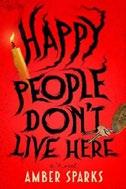
A mother and daughter move into a haunted apartment complex in this debut novel by an acclaimed short story writer. Ten-year-old Fern and her mother, Alice, are on the move again. They never stay in one place for long, for reasons Alice keeps mostly to herself. Homeschooled Fern subsists on girl-detective novels and fairy-house making, while Alice ekes out a living selling miniatures. Their new apartment in Pine Lake, Minnesota—in a precarious building that used to be a sanatorium—is full of eccentric characters: the building manager/ taxidermist, the professor who specializes in the literature of the Middle Ages, the woman who works as a mermaid. And then there’s the one Fern calls “the Cursed Lady,” who never seems to leave her apartment at all. Fern and Alice’s problems are bigger than weird neighbors, though. The past Alice is running from seems to be catching up with her. Fern sees ghosts throughout the property and then, one day, stumbles across a body in a dumpster who looks suspiciously like the Cursed Lady. But the body seemingly vanishes before anyone else can witness it. Like her girl-detective heroes, Fern is determined to get to the bottom of this mystery, which entangles the supernatural with the melancholy living who are perpetually haunted by their histories. Sparks pays homage to children’s
literature—and to children who don’t need the darkness scrubbed out of their fairy tales. (One of Fern and Alice’s pastimes is watching Jean Cocteau films together.) Like, say, Tim Burton or Neil Gaiman, Sparks works within a highly stylized mix of quirky and eerie—but from within her own idiosyncratic vision, she celebrates the power and strangeness of weird women and girls. For anyone who has ever wished they made Nancy Drew novels for grown-ups.
Talley, Max | Three Rooms Press (298 pp.) | $18 paper | October 14, 2025 9781953103666
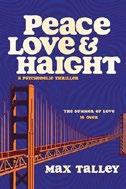
In San Francisco during the waning aftermath of the summer of love, “hippie elder” Frederick Dorn gets caught between the cops and the mob after he’s party to a notorious drug dealer’s death.
The dealer, “Rat-Man” Rathkin, was responsible for the heroin overdose of Freddie’s former girlfriend, a problem case who left Freddie because she “didn’t belong to any one man” and took up with Rat-Man because he had the drugs. When the cops first asked Freddie, who runs a gallery, to help them nail Rat-Man by going undercover, he refused, nervous about being seen as working “for the man.” But with drug deaths piling up in the city in the late-1960s following the Mafia’s move into the Haight, and Rat-Man’s experimental Orange Marmalade acid frying the brains of users including Freddie’s best friend, Freddie agrees to set Rat-Man up for a fall—a literal one, as it turns out, off the Golden Gate Bridge. On the run from the mob, to whom Rat-Man owed money, Freddie accepts a job rescuing a girl from the nefarious Baba Gagi’s commune, where the young female residents are drugged, brainwashed and used for sex—an
outcome he barely avoids himself. Talley has a tendency to state the obvious (“Peace and dope and free love were a stone groove, but they wouldn’t effect any worldwide behavioral or systemic change”). And the young author can seem generationally removed from the scenes he glibly describes. At the same time, this is a fresh take on a nostalgically remembered era. Rock fans will enjoy appearances by celebrities including impresario Bill Graham, “grinning and swarthy”; David Crosby, grower of his own “Croz” weed; and “that actor cat” Harry Dean Stanton. Jerry Garcia, alas, is a no-show. Murder mixed with psychedelia makes for an agreeable high.
Travacio, Mariana | Trans. by Will Morningstar & Samantha Schnee World Editions (164 pp.) | $19.99 paper September 9, 2025 | 9781642861570
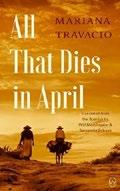
A woman sets off from her mountain home in search of the ocean and the possibility of a better life.
Lina Ramos and her husband, Relicario Cruz, live in Argentina, in the high, arid quebrada—literally the word for a dry ravine in Spanish. Though their family has been there for generations, life in the quebrada is very difficult, particularly since a drought struck the region, and Lina believes they need to leave. Their son, El Tala, left 14 years ago with Lina’s brother Camilo, seeking a better life. Yet, even as the area around him empties of life, Relicario will not abandon their ancestral home. “If we leave,” he tells Lina, “the dead will become nameless and confused, because no one will be left to remind them who they were.” Though Relicario plans to spend the rest of his life attending to this sacred duty, Lina, counseled by the village healer, Octavia, makes up her mind to follow the mountain streams in the direction they flow, hoping to come to the sea. Relicario is stunned by Lina’s absence and soon
decides to follow her. Accompanied by a wise donkey named Jumento and the bones of his mother and father—all of his family he could fit in the cart—Relicario begins a long, arduous journey, guessing Lina’s course at every turn, while his wife forges on before him, entering into worlds and ways of living that Relicario cannot begin to imagine. Meanwhile, a series of coincidences conspires to create a reunion no one in the Ramos-Cruz clan could have anticipated, all as the destructive torrents of April begin their seasonal scouring of the land. Spare and yet echoing with voices, Travacio’s English-language debut captures the haunting cycles of death and displacement but also of life, joy, and the succor of community in a place where “families come together and break apart…as easily as storm clouds in the sky.”
An illuminating fable of family—both blood and found.
Viertel, J.J. | Mysterious Press (384 pp.) | $26.95 | September 9, 2025 9781613166802

Murder and menace plague the fisherfolk of a Maine community, with a struggling woman at the center of the threat.
Off the coast of Maine lies
Caterpillar Island, dotted with saltbox homes. It’s here that Jeanette King lives a hardscrabble life that’s been made even more difficult by her divorce from Simon, a no-account lobsterman. The first third of Viertel’s debut novel focuses mostly on this fishing community, the details of its industry, and its various residents. Jeanette, who cobbles together a living collecting crabs, has recently beaten cancer and lost her son, Liam, under circumstances that at first go unexplained. When a loud engine wakes her up in the middle of a foggy night, she gives futile chase to a boat she recognizes as Simon’s. Shortly after her tense reunion with Liam’s childhood
friend Joey Pizio, who gives her money that’s meant for Simon, the ominous Bennett Tyson arrives with a nervous Joey to demand money the money back. Not long after, Jeanette discovers Joey’s half-submerged corpse. As the plot thickens, the author’s lens widens beyond Jeanette as her search for answers to larger felonious issues stretches all the way to the governor’s office. Who killed Joey? Who’s sabotaging the local delivery trucks? And what’s happened to Simon? Jeanette’s dilemma adds momentum to the novel, but its most interesting aspect is its portrait of Caterpillar and the lives of its denizens. There’s even a chapter from the perspective of the eels. An offbeat, atmospheric thriller with a whodunit at its core.
Volckmer, Katharina | Two Dollar Radio (166 pp.) | $17.95 paper | September 16, 2025 9781953387943
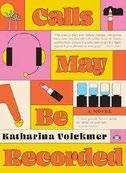
An employee at a travel-agency call center scrapes together moments of hilarity and strange intimacy into a life he can stand, somewhat.
The first three pages of this book describe our protagonist, Jimmie, losing control of his bowels on his doorstep (or, rather, the doorstep of his mother’s house, where she lets him live). This idea, that “bodies get in the way”—of the productivity expected at a dead-eyed corporate job, of true connection with other people—pervades Volckmer’s novel. Jimmie is good at playing the fool: After finishing drama school, he worked as a clown, and then a paid funeral mourner, and now, as he puts it, “a call boy” in London. For minimum wage and no benefits, he half-attends to the complaints of vacationers. The callers he services are usually ridiculous, and their perceived problems even more so. A man in pursuit of a “seamless” tan calls in a huff after being told off for going nude at his Sardinian resort, to which Jimmie responds, “You might want to try
wearing a sock?” When a woman staying in the Marais calls, convinced the staff at her hotel are mocking her for her weight, he assures her “that nobody likes French people.” Jimmie feels the weight of this daily humiliation ritual, and, as he nears 30—socially isolated and, as a fat, gay immigrant, socially marginalized—he sees the possibilities life might have held for him winking out one by one. However, over the course of a single workday, we see Jimmie manage to poke holes in precarity, reaching for moments of freedom through daydreams, illicit intrigues (real and imagined) with coworkers, and leaps over the established boundaries of customer service.
Volckmer’s prose is electric, and as she skillfully unearths moments of tenderness, even ecstasy, amid the sweat and stench of abjection, she ensures this brief book lingers past its pages.
A raucous, gutting workplace novel.
Kirkus Star
Wachman, Sam | Harper/ HarperCollins (352 pp.) | $30 August 12, 2025 | 9780063418226
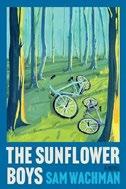
A gorgeously immersive story of childhood cut short by war.
“My brother, Yuri, swimming in the River Desna”: As Wachman’s breathtaking debut opens, Artem Vovchenko draws the first picture in a sketchbook his father has sent him from the United States for his 12th birthday. It will be followed by other images of a sweet childhood in the small town of
Chernihiv, Ukraine—going to school for the first time, riding bikes and taking dares, watching horror movies at a sleepover, visiting their grandfather’s farm in the countryside, where the boys try to earn money for a Nintendo Switch by collecting sunflower seeds. For a while, Artem’s most troubling problem is wondering whether his best friend, Viktor, shares his more-than-friendly feelings—sometimes, it seems he might! But on Feb. 24, 2022, the boys’ world is shattered by the arrival of Russian soldiers, and before long Artem and Yuri are on their own, fighting to survive in the devastated hellscape that used to be their home. About as amazing and impressive as you can imagine, this 25-year-old debut author from Massachusetts has evoked the details of life in Ukraine with utterly convincing clarity, and his depiction of the specific brutality of war will bring you to tears. The key to this achievement is the crystal-clear voice of Artem, a big brother lingering at the far edge of childhood, worshipping his mama and grandpa, bitterly missing his father, learning his country’s history, riding the roller coaster of his crush— then pitched abruptly into a jagged world of violence, grief, shame, responsibility, and hate. He is a narrator to fall in love with, evoking connections to the work of Anthony Marra, Justin Torres, and J.D. Salinger. The structure of the book, unfolding via 100 scenes from Artem’s sketchbook, underlines the essential role of art and storytelling as survival skills for life’s most ordinary and extraordinary challenges. As an epigraph suggests, “War cannot be understood; it must be felt.” Wachman does the essential work of making us feel. With its luminous depiction of all that has been lost and what remains at risk, there is no better book to read right now.
For minimum wage, he half-attends to the complaints of vacationers. CALLS MAY BE RECORDED


Author of The Wilderness
Angela Flournoy took the literary world by storm with her 2015 debut novel, The Turner House, which was a finalist for the National Book Award. Ten years later, she’s back, with The Wilderness, the story of four Black women navigating their lives over the course of 20 years. In a starred review, a critic for Kirkus wrote of the book, “Elegant and unsettling, this novel evades the expected at every turn.” Flournoy answered our questions by email.
Tell readers, briefly, about your book. The Wilderness is about growing up, but not in the way that is usually examined in fiction. The novel follows a group of Black women from 2008 to the near future of 2028 as they go from being in their early 20s to early 40s. They navigate aging, becoming parents, and the shifting dynamics of their friendships in Los Angeles and New York.
What inspired you during the writing of the book? What were you reading, listening to, watching?
I am always inspired by the work of previous generations of Black women writers like June Jordan, Toni Morrison, Gayl Jones, Toni Cade Bambara, and Wanda Coleman. A consistent thing about me is that I am always listening to Mariah Carey. I also listened to a lot of contemporary jazz and R&B, from musicians like Immanuel Wilkins, Joel Ross, Terrace Martin, Cleo Sol, and Baby Rose.
Where and when did you write the book? Describe the scene, the time of day, the necessary accoutrements or talismans.

I used to be a big believer in needing the right place, the right time and the right objects at hand to write my fiction. Then I had a child. None of those things stay under your control the way they used to after a baby—and in the wake, you have your own mind, whatever setup is ergonomically tolerable, and whatever time you can afford to have someone else watch your child.
What was most challenging about writing this book? And most rewarding?
After I finished The Turner House, which follows 13 siblings, I swore I wouldn’t write another big cast of characters, but The Wilderness called for me to write a group again. The most challenging aspect of writing this novel was making each of my point-of-view characters feel as real and urgent as the others, but also to execute my broader structural vision.
Will you be touring or doing events for the book this fall? Any you’re especially looking forward to?
I am fortunate to have so many talented and generous friends in conversation with me on this book tour. In New York, I’ll be at the Center for Fiction with Brit Bennett and Raven Leilani, and I’ll be at the Los Angeles Public Library with the


The Wilderness Flournoy, Angela Mariner Books | 304 pp. | $30 September 16, 2025 | 9780063318779
writer/actors Issa Rae and Ashley Nicole Black.
What fall release(s) are you most eager to get your hands on?
Jade Chang’s What a Time To Be Alive is an intelligent, funny, and tender look at a year in the life of an accidental internet guru. Aja Gabel’s Lightbreakers is a heartfelt meditation on grief, marriage, parenting, love, and literal time travel. Both are second novels, which in many ways feel harder than the first to write.
Interview
by Michael Schaub.
Addison, Esme | Severn House (368 pp.) | $29.99 | September 2, 2025 9781448312634

The lovely seaside town of Bellamy Bay, North Carolina, is beset with problems both magical and diabolical.
Aleksandra Daniels belongs to the Sobieski family, whose members trace their lineage to a famous mermaid, carry the Mer gene, and have special abilities relating to water. After Alex’s mother drowned, though, her father, a police detective, kept her far away from the clan. Now that he’s died, she’s been reunited with her Aunt Lidia and cousins Minka and Kamila. Kamila is a police officer with little interest in Botanika, the family’s herbal healing business, while Minka was Lidia’s helper until they had a falling out over the younger woman’s work for Leviathan Industries, which is owned by the powerful Montgomery Blue, who has dragon blood. Alex’s friend Pepper works for Jonah Fox, editor of the Bellamy Bay Bugler, who’s writing a story about the serial killer dubbed the Fisherman and is also known for his winning home-brew beer recipe, which tavern owner Spencer Francis is desperate to obtain before Oktoberfest. Although Alex’s boyfriend, Jack Frazier, is a police detective who’s against anything with even a hint of woo-woo, he asks her to meet his mother, whose fascination with mermaids and mental vagueness troubles him; she tells Alex that Jack’s in the military, which doesn’t seem right. When a woman is attacked on the beach and left with amnesia right next to the body of Jonah Fox, all hell breaks loose. Nasty, dangerous secrets that have been hidden for years bubble up, placing Alex and her family in great danger. Since Jack thinks Mer people aren’t even human, Alex, who’s solved several murders using her special abilities, must fight for her family and
all magical people against dark forces that include the government. A long, complex mystery that spotlights humans’ inhumanity to living creatures and offers a spark of hope.
Alexander, Tasha | Minotaur (336 pp.) | $29 September 23, 2025 | 9781250374981

When the star of the London season dies at a ball, the king asks Lady Emily and her husband, Colin Hargreaves, to find her killer. Victoria Goldsborough is about to vastly improve her family’s fortunes by marrying Peregrine, Marquess of Harrington. The Goldsborough girls are admired and envied because of their grandmother’s plans to marry them off to great advantage, and Victoria’s death is a terrible blow to the family. Emily and Colin have solved many crimes, and given all the suspects from the cream of society, it’s far better for everyone concerned if they investigate than if it’s Scotland Yard poking around. They question the family for hints of a motive. Victoria died from yew poison that must have been administered within a limited window of time. Peregrine’s mother had a diamond tiara she’d planned to give Victoria. Its disappearance on the night of Victoria’s death leads Emily and Colin to suspect Sebastian Capet, a charming, erudite jewel thief in love with Emily and currently involved in opening what may be Boudica’s grave. Victoria’s closest friend, Frances Price, is the daughter of a suffragette, although neither Victoria nor Frances is involved in the battle for women’s rights, a cause despised by Peregrine and many in his set. Emily finds out that both girls were secretly involved in Boudica’s Sisters, a group of society women planning on marrying well and convincing their husbands to support the suffragette cause. When another debutante is poisoned, the sleuths must step up their game and dig out the real reason for murder.
Plenty of motives and a surprise ending are buoyed by a bit of British Roman history woven into the mystery.
Allan, Barbara | Severn House (208 pp.) $29.99 | October 7, 2025 | 9781448314928
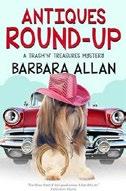
Mother and daughter antique dealers take a trip to Texas, where all hell breaks loose.
Vivian Borne is a bipolar woman of many talents. Her daughter, Brandy Borne, is a divorced mother who takes antidepressants and dotes on her diabetic shih tzu, Sushi. Their shop sales need a boost, and since they’ve recently done well with Western antiques, Vivian’s motivated by an ad for a citywide yard sale to head to Tranquility, Texas, where she thinks they can score some bargains. Brandy’s fiancé, Tony Cassato— the police chief in their hometown of Serenity, Iowa—has a history with the daring duo that gives him little hope they’ll stay out of trouble. From the start, the trip doesn’t go well. They get a flat tire, they get lost, they get stuck in a ditch, they get stuck sleeping in a very odd motel. Awakened by the police, they’re arrested for damaging a replica of Cherokee life in the 1800s. Tony gets them out of jail, but their arrival in Texas is marked by even worse trouble. Vivian, looking to get ahead of the competition, rents a horse and visits several sellers she’d talked with about purchasing certain items before the sale starts. Her first two meetings go well, but her third meeting with a Mr. Tool is cut short when she turns up his body, shot in the head. Since she’s already paid for a necklace, she searches for it and finds it just as the police arrive. With a long string of solving mysteries to their credit, the pair must solve this one to stay out of jail.
A rollicking story of crime fighting includes plenty of antique-buying tips and some Texas-style recipes.
POISON AND POOCHES
Balzo, Sandra | Severn House (224 pp.)
$29.99 | October 7, 2025 | 9781448314386

Sarah Kingston’s niece, Arial, introduced in Brew Unto Others (2024), strikes out on her own, settling into the property she inherited from her famous great-grandmother.
Tucked between the California cities of Monterey and Carmel-by-the-Sea, Pacific Grove has a reputation for being a little more laid-back that its tony sister cities. But Pacific Grovers still respect pedigree, and there’s none that gets you more respect than being a descendent of Gretchen Mayes. So when Arial moves into the cottage left to her by the illustrious artist, the villagers welcome her eagerly into the community. Termites, on the other hand, have no respect for lineage, so Arial has to have the infested guest house on the property fumigated, forcing her tenant, Christopher Buck, to share quarters with her in the cottage. Veterinarian Chris and dog-walker Arial share more than a love of animals. Arial’s paternal half sister, Melinda, is also Chris’ maternal half sister. And when they try to move Chris’ furnishings after the fumigation, they end up sharing a puzzle: an unidentified corpse has been concealed beneath the termiteweakened floor. Arial is a charmer, eager to explore her new community and to investigate the puzzle that has turned up quite literally at her feet. She makes mistakes but acknowledges when she’s gone perhaps a bit too far. Her relationship with Chris is intriguing, but not fraught. And the
puzzle Balzo gives her to solve is knotty and full of surprises.
A worthy extension to Balzo’s coffeehouse franchise set in an appealing new locale.
Blaedel, Sara & Mads Peder Nordbo Crooked Lane (336 pp.) | $29.99 August 12, 2025 | 9798892421676

The Reactive Criminal Investigations Department in Odense, Denmark, takes on a set of disturbingly mirrored mysteries. First comes the murder of Jørgen Andersen, a retiree who had a restraining order keeping him from approaching taxidermist Monika le Fevre that was rendered moot by whomever asphyxiated him. Good riddance—except for the scratchy, stitched-up wounds dotting his body, which eerily echo similar wounds in the unsolved murder of financial manager Jan Hansen. Next comes the vanishing of animal-rights activist Zenia Dybbøl, the 17-year-old daughter of Chief Constable Margrethe Dybbøl—a disappearance hard on the heels of the case of Amalie Vedel, another teenager gone AWOL from her parents’ home. Since Margrethe is so upset that she can barely bring herself to acknowledge Zenia’s absence, she’s not the best person to head the investigation. So under the supervision of DCI Liam Stark, Inspector Dea Torp reaches out to Inspector Lene Erikson, the rival who’s already heading the inquiry concerning Amalie, in hopes of figuring out what the two young women might have in
common. The deeper they dig, the more likely it seems that “everything had started with [Monika’s] exhibition” of domestic pets treated like laboratory animals, which aroused more than one kind of outrage, triggering disagreements about animal rights and abuses that overflowed the debate stage and generated a series of violent and vengeful crimes. Unlike in the authors’ last collaboration (Dissolved, 2023), the perpetrator is so well-hidden that fans will probably forgive some laborious exposition and a truly epic wind-down after the mask comes loose. Strong stuff for animal lovers prepared to be shocked by abusive behavior whose targets extend to humans.
Chouinard, Michelle | Minotaur (336 pp.) | $18 paper | September 23, 2025 | 9781250910011
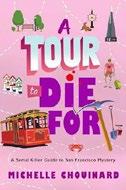
Capri Sanzio’s San Francisco Killer Crime Tours continue to explore crime scenes in the city’s historic past— and, for better or worse, in its present as well.
Kostricka, a participant in Capri Sanzio’s Barbary Coast Gold Rush Tour, is convinced that she saw a woman being attacked in a residential building along the route. But no one else spotted anything amiss, and Officer Robles, responding to a call, finds no one in the apartment in question. Even so, Capri can’t believe it’s a coincidence when artist Leeya Styles, the tenant of that apartment, is reported officially missing and later turns up strangled outside the building. The leading suspects are all people close to her: her sister, Jenna; her best friend, Quinn Shovani; her abusive boyfriend, Zach Haines, who strained their relationship even further when he came on to Quinn; her mother, Trisha Schlesinger; and Trisha’s fiancé, Roger Prentiss, an ex-con businessman who swears he’s gone straight. The real center of interest, though, is the Min-Pan, a
trinket that’s supposed to contain coded information identifying the location of a cache of vintage gold from 1850. Chouinard ladles on the historical backstory, some of it parceled out in tour-guide broadsides, without ever overwhelming the present-day mystery, including a highly predictable second murder, or Capri’s obligatory romance with Inspector Dan Petito of SFPD Homicide.
So conscientiously plotted that its heroine, who researches every suspect online before interviewing them, would approve.
Cleeves, Ann | Minotaur (384 pp.) | $29 September 30, 2025 | 9781250357281

When a detective’s best friend is murdered, the investigation turns up some painful secrets.
Jimmy Perez and his life partner, Willow Reeves, met in Shetland but currently live in Orkney—both Scottish archipelagoes—with their son, James, as they await the arrival of a baby soon to be born. Both are passionate about their police work, so Willow’s not surprised to come home to a note saying that Jimmy’s best friend, Archie Stout, is missing and Jimmy’s gone to Westray to help in the search. Next morning, he calls to tell her that Archie’s dead, found in the remnants of an archeological dig, hit in the head with one of a pair of ancient stones usually kept in a museum. Archie was a fearless risk taker, a hot-tempered Viking with a passion for the isles of his birth. Jimmy goes to Archie’s family farm to question his widow, Vaila, in hope of finding a clue from a long list of enemies he’s made in the past and his actions the day he died. Despite the two sons he shared with Vaila, Archie was always a flirt, and Jimmy learns that he had several extramarital affairs, most recently with Englishwoman
Rosalie Greeman, an artist who denies any sexual relationship. The detective duo turns up another suspect in a supercilious college professor whose famous published paper was apparently based on the unacknowledged research of Archie’s father. More motives turn up as the islanders prepare for Christmas celebrations, and the wild weather leaves Jimmy and Willow shorthanded as they pursue leads. Did love or money lead to Archie’s death?
A first-rate mystery full of historical detail and descriptions of a beautiful place.
Johnson, Maureen & Jay Cooper Ten Speed Press (128 pp.) | $19.99 September 16, 2025 | 9780593836019
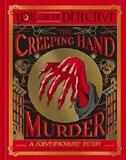
In a salute to Dennis Wheatley’s crime dossiers of the 1930s, Johnson and Cooper present a collage of evidential materials designed to elucidate, after first seriously obscuring, the perpetrator of an impossible crime. Hours after six people are summoned on 27 November 1933 by threatening anonymous letters to 19 Tootley Row, the Mayfair house of “artist and sometimes poet” Ambrose Belvoir, another letter urges a neighboring tailor to summon the police immediately to a murder scene. That’s quite a surprise to Belvoir and his guests, who suddenly realize that one of their number, American novelist Roy Peterson, hasn’t just dropped off to sleep; he’s been stabbed to death by an icepick. But every one of the remaining guests—actress Vita Simpson, naturalist Lord Alfred Chomley, race car driver Felix Darlington, telephone operator Mabel Hickney, and cook Cloris Adder—swears that they didn’t approach the famously antisocial Peterson and that they didn’t see anyone else approach him, either. If no one laid a hand on him, how did he meet his end, and why? The novelty here is that instead
of unfolding their whodunit in straightforward prose, the authors present a scrapbook of floor plans, black-and-red drawings of the crime scene and the suspects, newspaper clippings, transcripts of interviews with DCI Harold Jensen, and a climactic confession that makes the impossible murder look so easy that readers who haven’t figured it out already are likely to feel cheated. The forgettable characters are little more than cartoon types, but that’s entirely appropriate to their mode of presentation. A more serious criticism is that all those pictures contain remarkably few clues. The result isn’t much of a mystery, but a stroll down Memory Lane with homicide obbligato.
Jónasson, Ragnar | Trans. by Victoria Cribb Minotaur (320 pp.) | $29 | September 9, 2025 9781250408266
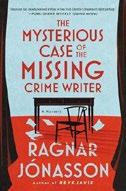
After ending her bestselling list of mystery novels, an Icelandic writer adds a disquieting postscript to her career by disappearing herself. Elín S. Jónsdóttir has always been very intentional in measuring out her life. Years ago, she decided that Deadline would be the 10th and last in her series of whodunits. So when Rut Thoroddsen, her publisher, can’t reach her at home, the break in Elín’s routine is already alarming. Helgi Reykdal, a mystery fan who’s taking advantage of his vacation from the Reykjavík Criminal Investigative Division to nest in his family’s bookstore, is the obvious person to investigate, and he’s certainly willing to join the search for one of his favorite authors before it’s leaked to the press and everyone on social media joins the hunt. The problem is that there seems to be no trail to follow. Rut; her accountant husband, Thor; and Elín’s best friend, retired judge Lovísa, add details about Elín’s highly successful career, but nothing that would indicate either a
reason for anyone to kill her or a reason for her to vanish. Eventually, however, Jónasson, who—apart from his many leaps among different time frames— seems more indebted here to the rhythm of Helgi’s earlier police procedurals than to the golden age mysteries that link his detective and his quarry, reveals evidence that makes Helgi look more closely at Marteinn Einarsson, the pseudonymous author of Killer ; at a 1965 bank robbery that left one employee dead and one robber in prison; and Helgi’s vengeful ex-girlfriend Bergthóra, whose erratic behavior threatens to hijack the whole case.
A lightning-fast read for fans willing to keep turning the pages till the crucial clues drop.
Meier, Leslie | Kensington (256 pp.) | $27 September 30, 2025 | 9781496753021
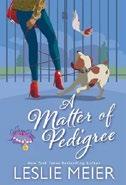
Meier leaves the tight-knit community of Tinker’s Cove (Bridal Shower Murder, 2025, etc.) for the big city of Providence, R.I.
Growing up in the Italian neighborhood of Federal Hill, Frank and Carole Capobianco could only dream of living in an exclusive condo like Prospect Place on the tony East Side. But Frank’s patent for the low flow Bye-Bye Toilet earns the couple enough to offer $2 million above asking price for the remaining unit in Hosea Browne’s renovated historic mansion. Unfortunately, Hosea also owns a unit in what was once his family home, and he blackballs the Capobiancos, claiming that they’d be uncomfortable among “people like ourselves.” Disappointed, Frank expresses his desire to kill the “old fossil of a Yankee.” His words come back to bite him when he and Carole, now living at the gracious, spacious Esplanade (which Carole actually likes much better than Prospect Place) learn of Hosea’s murder. Frank is arrested, and Carole, their son and daughter, Frank’s parents,
and even Carole’s mother, currently living in Paris, team up to find the real killer. The problem is that, even though Hosea really was a condescending old fossil, Frank and Carole are so crass and entitled that you can kind of see his point. Are the residents of the Esplanade any happier than the folks at Prospect Place would have been hearing Carole’s Brittany spaniel, Poopsie, bark and whine all day? Do they just shrug when she parks her ginormous Porsche Cayenne wherever? And would Carole really have been happy living someplace without an attentive staff willing to carry her latest pair of Jimmy Choos upstairs for her? Meier’s new series lacks anyone readers can connect with as closely as they do with her Tinker’s Cove crew.
Meyer, Nicholas | Mysterious Press (264 pp.) $26.95 | August 26, 2025 | 9781613166567
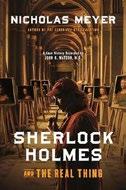
First, the bad news: In his closing acknowledgments, Meyer, dropping his pose as Dr. John H. Watson’s editor, announces: “I’m thinking this will be my last Holmes novel.”
Now, the other news, which is mostly excellent except for Rupert Milestone, the portrait painter who hasn’t paid the rent for his Notting Hill studio for three months. His landlady, recently widowed Lady Vera Glendenning, engages Holmes to find him, but the trail has gone cold—though not as cold as the body the Metropolitan Police eventually discover in a location as gruesome as it is unoriginal. In life, Milestone seems to have been an immensely gifted mimic who could copy the styles of masters old and new while displaying precious little originality of his own. The news that he was also a restorer who worked for fearsomely dominant art dealer Sir Jonathan Van Dam, Lord Southbank, poses questions about the relations
between the paintings he restored and those he created. Calling on Juliet Packwood, the niece of Milestone’s dealer (and the daughter of Watson’s late comrade-in-arms Col. John Packwood), and Signor Garibaldi, Van Dam’s authenticator, leads Watson to a theory of the case and an amatory attachment that may compromise his deductions. At length, Holmes, more disinterested, more analytical, and able to see more complications beneath the obvious solution, leads Watson and the Met to a denouement as surprising and fulfilling as any in the sacred scriptures themselves. The whole exercise is adorned with the usual footnotes and an increasingly pointed and self-reflexive series of discussions about copies, forgeries, and the “real thing.”
Though Meyer ends by identifying himself as a forger, a generation of readers will be ever grateful for his efforts.
Nightingale, Max | Pegasus Crime (208 pp.)
$27.95 | September 2, 2025 | 9781639369577

A Choose-YourOwn-Adventure whodunit set in the even more retro locale of 1958 Hollywood. As she sits in the Royale Premiere Hotel awaiting the opening of the Golden Star Awards, Blanche Aikerman congratulates herself on having fought her way to the top. At the tender age of 27, she’s been offered, along with Peter von Hiltz, the director who’s guided her to fame and fortune, an exclusive lifetime joint contract for more money than they can count by Victor Ramsay of Thundersaga Pictures. Before she can say yea or nay, someone visits Blanche’s Royale Premiere suite and cuts her throat. The lead LAPD investigator is “you,” and you’re constantly asked to choose which lead to follow, whether or not to press a given suspect further, whether to follow or flout the law of the land, or even whether to respond to a crisis “quickly”
or “immediately.” The consequences for a bad choice can be dire: More than a few dead ends lead to your boss, Capt. Barclay, taking you off the case, and even more of them end with your death at the hands of otherwise forgettable suspects who weren’t as trustworthy as they seemed. On the plus side, most of the fatal avenues are low-stakes because they’re mercifully short and because they make it easy to circle back to your last decision and try again. Jonathan Whitelaw, writing under the Nightingale byline, uses disconcertingly British tags like “lorry” to describe the traffic in 1958 Los Angeles, but it all turns out fine, except (oops!) when it doesn’t. A player-friendly approach to the interactive crime novel best-suited to readers new to the game.
Pegau, Cathy | Minotaur (304 pp.) | $28 September 16, 2025 | 9781250356482

A new detective duo is born when a business owner needs help saving her legacy.
Margot Baxter Harriman inherited B&H Foods from her father, but as a woman in 1912 New York City, she’s had to fight for respect from the men who thought her incapable of running it. When she comes upon the dead body of her father’s former assistant, Giana Gilroy, in the office, her world starts to fall apart. Although her father’s best friend, Hiram Potter, treats her as fragile, she’s more than willing to answer questions from the police about the death, but she does have something to hide: an unfinished note to her from Giana. The death is ascribed to natural causes, but the note says that her father and Giana were involved in “a situation at B&H” that caused sickness and death. Many companies are ignoring the 1906 Pure Food and Drug Act and selling food adulterated with dangerous fillers, and Margot, realizing that she needs discreet help to discover the truth, approaches Loretta Mancini, who works
with her own father, a retired police officer suffering from dementia. After Margot explains the problem, they agree that having Rett go undercover in the factory is the best way to discover if Margot’s father was actually tampering with his company’s food. Along the way, Rett, who shares an apartment and much more with a woman, is assisted by several friends, including Shiloh, a magician’s assistant with housebreaking skills who takes up with Margot. After breaking into Mrs. Gilroy’s home, they find a safe deposit key that will lead to the truth. Murder, blackmail, and lesbian love in an era when what you ate could kill you in the name of the almighty dollar.
Penny, Louise | Minotaur (384 pp.) | $30 October 28, 2025 | 9781250328175
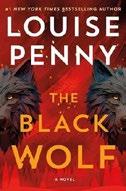
A sequel to The Grey Wolf (2024) that begins with the earlier novel’s last line: “We have a problem.” And what a problem it is. Now that Chief Inspector Armand Gamache and his allies in and out of the Sûreté du Québec have saved Canada’s water supply from poisoning on a grand scale, you might think they were entitled to some rest and relaxation in Three Pines. No such luck. Don Joseph Moretti, the Sixth Family head who ordered the hit-andrun on biologist Charles Langlois that nearly killed Gamache as well, is plotting still more criminal enterprises, and Gamache can’t be sure that Chief Inspector Evelyn Tardiff, who’s been cozying up to Moretti in order to get the goods on him, hasn’t gone over to the dark side herself. In fact, Gamache’s uncertainty about Evelyn sets the pattern for much of what follows, for another review of one of Langlois’ notebooks reveals a plot so monstrous that it’s impossible to be sure who’s not in on it. Is it really true, as paranoid online rumors have it, that “Canada is about to attack the U.S.”?
Or is it really the other way around, as the discovery of War Plan Red would have it? As the threats loom larger and larger, they raise questions as to whether the Black Wolf, the evil power behind them, is Moretti, disgraced former Deputy Prime Minister Marcus Lauzon, whom Gamache has arranged to have released from prison, or someone even more highly placed. A brief introductory note dating Penny’s delivery of the uncannily prophetic manuscript to September 2024 will do little to assuage the anxieties of concerned readers.
Don’t feel that your current news feed is disturbing enough? Penny has just what you need.
Ripley, Mike | Severn House (272 pp.) $29.99 | September 2, 2025 | 9781448315611

After a dozen authorized pastiches featuring Albert Campion in his autumn years, Ripley attacks the conventions of golden age whodunits in a much more metafictional way.
Kicking off his tale with the announcement that “this is not a conventional crime novel, rather a novel about writing crime novels,” Ripley invites readers into the world of mediocre mystery writer Duncan Torrens through the eyes of Roland Wilkes, who edited his final 10 novels after Edward Jesser, the founding publisher of Boothby & Briggs, indicated that he couldn’t stand Torrens’ increasingly undistinguished fiction but couldn’t bear to cut the reclusive, uncomplaining author loose. Roly recalls his surprisingly productive relationship with Alan Hibbert, who wrote for many years under the Torrens byline without ever tipping off most of his neighbors in the Hertfordshire village of Dunkley. Their relationship
lasted until B&B was acquired by a Scandinavian conglomerate that fired Roly and refused to publish the latest Torrens title. But the bottom doesn’t really fall out of Roly’s world until mystery podcaster Jacon-with-a-“C” Archer, who’s been hired by rival publisher Spencer Crow to investigate the possibility of reprinting the Torrens oeuvre on the cheap, tries to pump Roly, now a public librarian, for information about the virtually forgotten author. The kaleidoscopic revelations that follow, delivered with deadpan wit, are likely to confirm readers’ most paranoid fears about the worlds of publishing, authorship, business, and domestic relations. Ripley punctuates his story with two dozen clearly marked references to mystery writers famous and obscure that his appendix elucidates. Aficionados are likely to recognize even more that he never explains.
Ripley’s best book: a wickedly funny sendup of the clichés behind all those classic mysteries and their successors.
Tietjen, Katie | Crooked Lane (288 pp.) | $29.99 September 23, 2025 | 9798892421812
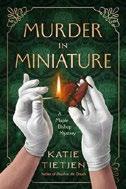
A forensic consultant helps crack the case in the death of a young firefighter in post–World War II Vermont. Her work as a consultant to the local police, along with what she earns selling custom-made dollhouses, has helped widowed Maple Bishop stabilize her financial situation. But it’s clear that the miniature crime scene recreations that she makes for Elderberry Sheriff Sam Scott are a source not only of income but of professional pride and satisfaction. So when Sheriff Scott calls her to the scene of a tragic fire in which Daniel Perkins was burned to death, Maple is grief-stricken but also excited; at last, she has something more interesting than televised
Plenty of period details enrich a story of love, hate, and ambition.
MURDER
political speeches to engage her nimble brain. She’s also puzzled. How could Daniel, a firefighter himself, been careless enough to let his cabin go up in flames? To solve the puzzle, she constructs a series of miniature crime scenes, which she calls “nutshells,” to help the police pinpoint the causes of the fire. She also goes to Boston, the last place Daniel lived before Elderberry, to interview the people who knew him best. Her return to her hometown gives her the opportunity to reconnect with family and friends, reflecting on her journey from the big city that rejected her bid to become a practicing lawyer to the small town that doesn’t always accept her as a friend but shows her respect as a professional. The second in Tietjen’s series documents Maple’s growth beyond the shadow of her late husband. Her nutshells may not be essential to solving the puzzle of Daniel’s death, but they go far in understanding the complex individual Maple has become. A worthy successor to a promising debut.
Winters, Mary | Severn House (240 pp.) $29.99 | October 7, 2025 | 9781448315499

Which is harder for an agony aunt: planning a wedding or solving a murder? Though she’s helping to raise her late husband’s niece, Lady Winifred, and placating his difficult aunt, Lady
Tabitha, Lady Amelia Amesbury still has time to solve crimes and write a newspaper column under the nom de plume Lady Agony. When Amelia’s troublesome sister, Madge, announces her engagement to Capt. Fitz, it falls to Amelia to plan a wedding that will take place in less than a month. Her first visit to the Rev. Mr. Cross, a champion of the poor, quickly involves her and Lord Simon Bainbridge, her romantic interest and partner in crime-solving, in a complicated series of mishaps. On top of all this, she receives threatening letters from a reader demanding that she reveal the identity of the so-called Mayfair Marauder, who stole and then returned jewels for a reason Amelia’s determined to keep hidden. When Cross is murdered, the police write it off as the work of a thief after the collection box, but before his death, Cross had left Amelia a mysterious clipping about a girl who fell to her death in a biscuit factory. Cross’ church is in a wealthy area, but he also tried to do good in the East End, where his efforts weren’t always appreciated. The wedding plans continue apace as the family arrives, but they’re seriously upended by Madge’s sudden indecision about whether she wants to marry after all. Investigating the deaths of Cross and the girl who died in the biscuit factory draws the sleuths into dangerous territory.
Plenty of period details enrich a story of love, hate, and ambition.





Author of The White Hot
Quiara Alegría Hudes is a writer whose works include the book of Lin-Manuel Miranda’s Tony Award–winning musical In the Heights and the Pulitzer Prize–winning play Water by the Spoonful . Her fiction debut, The White Hot, is equally impressive—a “staggering gut punch of a novel,” according to a starred review from Kirkus. Hudes answered our questions via email.
Tell readers, briefly, about your book. It’s the story of April Soto, a young woman in Philly, and how her white-hot rage ping-pongs against her playful spiritual curiosity. The book stems from my jealousy of the Buddha. He abandoned his family obligations to find the meaning of life. My jealousy of Don Draper from Mad Men. How breezily he left the domicile. I wanted to give a woman—a mother—such f*ck-all freedom. Her journey comes at a steep cost, and the book asks: Was it worth it?
I’m not trying to be salacious, though. The book is steeped in love.
What inspired you during the writing of The White Hot ?
The Autobiography of My Mother by Jamaica Kincaid. The Door by Magda Szabó. Sula by Toni Morrison. Frankenstein by Mary Shelley. Bad Girls by Camila Sosa Villada. Forbidden Notebook by Alba de Céspedes. Happening by Annie Ernaux. The Days of Abandonment by Elena Ferrante. I came out of that short stack as if tempered by fire, still me at the core but strengthened. Perhaps less
likeable, definitely less permissionseeking. I suspect more honest.
Where and when did you write the book? Describe the scene, the time of day, the necessary accoutrements or talismans.
My writing studio has an old purple rug worn down to holes—salvaged from my childhood bedroom. My chair was a curbside trash find, an old wooden schoolhouse swiveler. The desk is luscious and small, handcarved by my father.
There are plants propagated from my family’s farm in Puerto Rico. A cutting from my friend Amy Herzog. My friend Vanessa gifted me the central tool of my writing life, a huge blue pinboard where I arrange scraps and ideas into some semblance of order.
What was most challenging about writing this book? And most rewarding?
I wrote it at a time of family crisis when I was essentially not functional. Things like washing a coffee cup or brushing my teeth became dissociative and alien tasks. But I discovered a heightened ability to read. A maintained ability to write. So this book, and the ones I read while writing it, saved my life. I still had a self.
What fall releases are you most eager to get your hands on?
Allen Iverson’s memoir, Misunderstood, comes out in October. I’ve read an



The White Hot Hudes, Quiara Alegría One World/Random House | 176 pp. | $26 November 11, 2025 | 9780593732335
advanced copy and it’s a jaw-dropper, an American story that pulls no punches. AI was a one-in-a-billion talent, dripping style head to toe, but he took so much heat for wearing braids, for having tattoos, for bringing his home friends along for the ride. Stuff that is commonplace now. He was wrongly imprisoned his senior year of high school. My husband, Ray Beauchamp, co-wrote the memoir with Iverson, and I got to read chapters in real time, as they were written. It was the first serialized read of my life, and I could hardly wait for the next installment.
Also out in October is Jaquira Díaz’s This Is the Only Kingdom, a very important addition to the Boricua diaspora library.
Interview by Nina Palattella.
Binge, Nicholas | Tordotcom (176 pp.) | $21.99 September 16, 2025 | 9781250373847
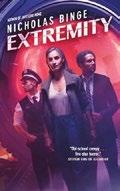
A disgraced detective comes out of retirement to help her former partner, and an eager rookie investigate the double homicide of a billionaire… and his clone.
In London, three Metropolitan Police officers conduct postmortem interviews about the impossible case they’ve just solved. Alternating perspectives lay out the facts: DCI John Grossman drags his ex-partner Julia Torgrimsen out of forced retirement to analyze the murder of Bruno Donaldson, a nasty billionaire with whom she’d crossed paths while working deep undercover in her past life. As a handler for the late Dmitri Yegorov and his cabal of unsavory associates, Julia procured human trafficking victims, including one young woman whose tragic fate still haunts her. An assassin has shot Donaldson—but across the city, an identical double is also found dead. The case triggers Torgrimsen’s past regrets, even as she stubbornly brings green DC Mark Cochrane into the fold to chase the shooter across town. When they discover the billionaires are hoarding time machines that are responsible for the bizarre doppelgängers, all three are tempted by the roads not taken. An SF novella about the ultrawealthy and their clones could reasonably be assumed to be in conversation with Kazuo Ishiguro’s Never Let Me Go, but Extremity as a title is a bit of a red herring. It’s not about the clones being extensions of their prime selves, but rather about humanity reaching too far in its greed and Earth ultimately paying the price. The narrative framework is engaging but underused as the three stories basically line up, failing to generate sufficient tension about the evening’s outcome. While Binge’s longer works like Ascension are stunning in their
The superb
intricate plotline make this a must-read.
scope, this tonally uneven adventure stumbles before it really gets started. A too-slick police procedural about fixing past mistakes could use more time.
Marske, Freya | Tordotcom (144 pp.) $24.99 | October 7, 2025 | 9781250341716
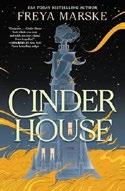
In this ghostly fairy-tale retelling, a spectral Cinderella struggles to stay corporeal enough to make it to the ball.
Sixteen-year-old Ella is a ghost haunting her magical house as a grudge against her murderous stepmother and abusive stepsisters. Being more house than girl compels Ella to slavishly follow her family’s orders in a manner that calls back to Gail Carson Levine’s Ella Enchanted, with the added obstacle that she can’t pass beyond the house’s foundation. Despite her limited life experience, Ella is no naïf, inventively expanding her world through mail-order books and distant correspondence while surviving her stepsisters’ unique tortures. As the years pass and people move on, she even discovers a loophole for exploring the city and meeting new faces—like canny fairy Quaint, with whom she barters for an enchanted solution to attend the prince’s ball. The familiar story elements—dress, glass slippers, midnight curfew—are given new life and interpretations, but there is no simple spell to resurrect Ella. Instead, she must carve out new ways of existing in the world and making people
see her on her terms. The flesh-and-blood characters are equally compelling: thoughtful revelations subvert the “doting father” and “wicked stepmother” archetypes, while the prince contends with a well-meaning fairy curse that reduces him to a dangerous object of desire. A setting in which both bisexuality and polyamory are woven into the social fabric means more alluring opportunities for Ella’s postmortem romance, which Marske accomplishes with her usual aplomb. Marske unflinchingly explores the ways limited mobility and accessibility can erode one’s sense of self, inspired by her own experiences of being housebound due to long Covid, and how to triumphantly cross those thresholds. Cinderella finds her happily-everafterlife life in this sharp addition to the fairy-tale canon.
SenLinYu | Del Rey (1040 pp.) | $35 September 23, 2025 | 9780593972700

Using mystery and romance elements in a nonlinear narrative, SenLinYu’s debut is a doorstopper of a fantasy that follows a woman with missing memories as she navigates through a war-torn realm in search of herself. Helena Marino is a talented young healer living in Paladia—the “Shining City”—who has been thrust into a brutal war against an all-powerful necromancer and his army of Undying, loyal henchmen with immortal bodies, and necrothralls, reanimated automatons. When Helena is awakened from
stasis, a prisoner of the necromancer’s forces, she has no idea how long she has been incarcerated—or the status of the war. She soon finds herself a personal prisoner of Kaine Ferron, the High Necromancer’s “monster” psychopath who has sadistically killed hundreds for his master. Ordered to recover Helena’s buried memories by any means necessary, the two polar opposites—Helena and Kaine, healer and killer—end up discovering much more as they begin to understand each other through shared trauma. While necromancy is an oft-trod subject in fantasy novels, the author gives it a fresh feel—in large part because of their superb worldbuilding coupled with unforgettable imagery throughout: “[The necromancer] lay reclined upon a throne of bodies. Necrothralls, contorted and twisted together, their limbs transmuted and fused into a chair, moving in synchrony, rising and falling as they breathed in tandem, squeezing and releasing around him…[He] extended his decrepit right hand, overlarge with fingers jointed like spider legs.” Another noteworthy element is the complex dynamic between Helena and Kaine. To say that these two characters shared the gamut of intense emotions would be a vast understatement. Readers will come for the fantasy and stay for the romance. Although the melodrama sometimes is a bit much, the superb worldbuilding and intricate plotline make this a must-read.
The Isle in the Silver Sea
Suri, Tasha | Orbit (512 pp.) | $30 October 21, 2025 | 9780316595087
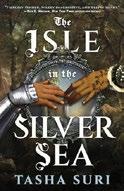
What if the characters in a fairy tale wanted out ?
The titular Isle is a magical version of England, a patchwork of times and places ruled by the Eternal Queen and stitched together by a network of
tales. If these tales are not strictly reenacted by incarnates—people born to play their roles in a specific tale—the land associated with it and all the creatures living on that land disappear, so the people of the Isle have a vested interest in ensuring that incarnates perform as expected. Sir Lavinia and Simran are the latest versions of the Knight and the Witch, the two main characters in a sad tale of evil enchantment and star-crossed love that concludes with a murder-suicide. But these two incarnates are not quite like their predecessors: Vina’s mother and Simran both come from Elsewhere, a fantasy equivalent of India. That culture has essentially been written over by the power of their tale, but their continued treatment as outsiders, their overwhelming love for each other, and Simran’s mysterious affinity with limni ink (used both to write tales and perform powerful, reality-altering spells), give them the strength to seek out a destiny beyond their foretold unhappy ending. The key to their quest may lie with a dangerous immortal who is killing incarnates and has kidnapped Simran’s dearest friend. Previous Suri works (e.g.,Empire of Sand, 2018) have featured unique, fascinating magical systems, and this book continues in that vein. It’s one of the more innovative and thoughtful uses of fantasy to explore colonialism and the potential poison of assimilation, popular genre themes in recent years. The novel takes two fundamental British myths—King Arthur and the concept of the British Empire as a realm on which the sun never sets—and uses them to show the thin line between preservation and stagnation. A desperate need to adhere too perfectly to an ideal and/or the status quo makes it more likely that it will come crashing down. Beautifully inevitable and surprising at the same time; dark, sharp, clever, lovely.

Wilde, Fran | Erewhon (336 pp.) | $28 September 30, 2025 | 9781645661948

Living since the Mess, or the Turbulence— depending who you ask—is a struggle.
In a prescient climate-changed future, where sea levels have risen and social stratification is clearer than the air, the ultrawealthy in New Washington are living in a new gilded age, while the poor majority lives in a surveillance state. There’s plenty to see on the New Washington City Feed when content isn’t redacted. Either way it comes at a price. Dropped right into the midst of a heist, this story follows the Canarvier family—thieves who can be hired to rob lavish parties as entertainment for the wealthy guests. This dystopian pastime goes as follows: Hire performers, the best thieves in the business, then catch them in the act before time is up and the partygoers win. But let them get away with the heist and they’ll sell the host’s belongings back for a profit. When the Canarvier patriarch, King, goes missing, his family must take on a grand heist—a well-paying gig with much higher risk—and buy his freedom before he’s shipped off to the water mines of Alaska. Besides the challenge of planning to steal without their mastermind, the Canarviers don’t really know their target, Mason, a young and wealthy entrepreneur. And they certainly don’t know what lengths he will go to catch them and recover his fortune. Ultimately about family and what we can risk for one other, this story pushes its characters to reckon with legacy, built and given, and how to choose between the comfort of what they know or striving to be better. The novel’s simple prose gives way to such complex and richly imagined worldbuilding that you’ll forget you’re reading about fabricated nutrition and clothing that listens.
Buckle up for a cyberpunk Great Gatsby, anchored by a thrilling heist.
Burke, Andie | St. Martin’s Griffin (368 pp.) | $18 paper | September 16, 2025 | 9781250372529
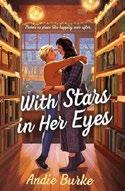
Two women artists on individual journeys of self-discovery find each other in a Kansas bookstore. Thea Quinn is working at a tattoo store while developing her art photography and getting some distance from her family. When she meets Courtney Starling, the cute bookseller next door, she falls hard. Though Courtney is powerfully drawn to the dimple-sporting Southern charmer, the singer-songwriter-cellist is hiding away from a stalled music career after a severe migraine foiled her first concert as a headliner. The cause of her migraines is unresolved, as is her trauma from being exploited by her family as a child performer on the Christian music circuit, as well as her divorce from a blackmailing manipulator from the same community. The two women start bonding over romance novels and art, with their chemistry strengthening over months of intimacy. But Courtney is hiding her past, which eventually spills out as expected. The novel is conscious of its own genre, and as the two women talk books, they make references to plot elements like the slow burn and the third act breakup, which Burke then dramatizes, not always well. We also get the requisite assortment of best friends and small-town quirky characters as well as the villainous ex and some charming episodes, such as a date in a field at night. The adherence to rom-com tropes and types could make for easy reading, but a narrative that alternates between
Thea and Courtney’s first-person points of view, plus Courtney’s many names and personas, can be difficult to follow. A sapphic romance in a small community for those who like secret identities and low-key melodrama.
Parrish, Roan | Sourcebooks Casablanca (384 pp.) | $17.99 paper | September 9, 2025 9781464238741
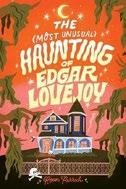
Can a professional haunter and someone who’s been haunted all his life escape the ghosts of their pasts?
Edgar Lovejoy sees ghosts. He’s been tormented by the grotesque faces of dead people lingering on Earth since he was a little boy. He works part time for a cocktail business and a cat café, and then he goes home. It’s safer and less scary that way. When he meets Jamie Wendon-Dale, a genderqueer burlesque performer and haunted-house designer, they challenge him to step outside his comfort zone. Jamie loves their life and the pockets of comfort they have found in queer and spooky communities. Predictably, their choices cause their traditional family— their mother is a politician—to bristle. Their sister, Emma, asks Jamie to be her maid of honor (despite the very gendered term), and to step up and help out with wedding plans that coincide with Halloween—Jamie’s busiest time of year, professionally. After Edgar opens up to Jamie about seeing ghosts, he’s able to let
Jamie coax him out of his comfort zone and back into the world. And when he has a panic attack at Emma’s rehearsal dinner, it emboldens Jamie to stand up for themself for the first time with their family. Edgar’s own family is only marginally less complicated. His parents aren’t really in the picture anymore, and no one really talks to the crazy aunt who sees ghosts, but his sister’s impending pregnancy might just be enough to bring their absentee brother back into Edgar and his sister’s lives. There’s as much hurt and comfort passing between Parrish’s two very likable love interests as there is scorching chemistry and hot sex. The supporting characters are well-written and nuanced enough to have their own spinoffs, and the book is every bit as cozy as it is steamy.
Somehow both adorably wholesome and unbelievably hot.
Stetz-Waters, Karelia & Fay Stetz-Waters Forever (368 pp.) | $17.99 paper July 15, 2025 | 9781538771204
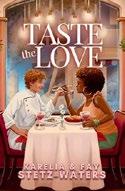
Two former culinary rivals enter into a marriage of convenience to save a communal green space in Portland, Oregon, from the clutches of a fast-food corporation.
Six years ago, Kia Jackson beat out her culinary-school rival Alice Sullivan for the Prix du Patrimoine Culinaire award, given to the student with the highest rank in the class. But that evening, they set aside their differences and ended their rivalry with a kiss, knowing that their competition through four years of schooling made them better chefs. Sullivan now runs a restaurant in her neighborhood of Oakwood Heights and Kia has become a food truck influencer, winning several honors around the country. When a green space, known as the Bois, goes up for sale in Oakwood Heights, both women have their own ideas of how to use it. Sullivan wants to protect the space, a promise she made to
her late grandfather. Kia wants to turn it into a hub for food trucks and community gatherings. As a legacy landowner in the community—her great-great-grandfather signed the original neighborhood charter—Sullivan gets first dibs on the space, but she doesn’t have the money to buy it, though the neighborhood association is giving her plenty of time to prepare for the sale. Aside from Kia, a fast-food chain called Mega Eats wants to buy the land for its next location. To add salt to Sullivan’s wound, Mega Eats only knew about the sale through Kia’s social media posts. Since Mega Eats is the worst-case scenario, Kia proposes marriage. Since she has the money to buy the land and Sullivan gets priority in the sale, together they’ll be able to secure the Bois. The legal aspects of marriage and land sales bog down a stale romance that emphasizes a rivalry that feels barely there. When it comes to tension and momentum, this foodie romance barely reaches a simmer.
Wilder, Ava | Dell (416 pp.) | $19 paper October 28, 2025 | 9780593871690

A former musician finds healing and a complicated love story with a contractor in a picture-perfect mountain town. After a breakdown and her latest breakup, Merritt Valentine left Los Angeles and moved in with her twin sister, Olivia, in the quiet town of Crested Peak, Colorado, two years ago. She hasn’t made music in a decade, and now she’s focused on fixing up the house she impulsively purchased. Enter Nikolaos Petrakis, the contractor/ jack-of-all-trades who knows everyone in Crested Peak. Niko is attractive, kind, and single—a dangerous combination for Merritt, who’s still reeling after her career and relationship fell apart. Niko, also on the heels of a nasty breakup,
knows he should avoid Merritt if he doesn’t want to get his heart broken again. After they’re both warned to stay away from each other, they resolve to keep their relationship strictly professional. But the best laid plans are no match for the chemistry between Merritt and Niko as they fix up her house, taking antiquing trips and sketching out plans. They make a classic romance novel mistake—they decide to hook up for a designated amount of time and promise not to let things get too deep. Merritt worries that her baggage is way too much for a nice guy like Niko to handle, while Niko isn’t sure he can count on anyone to need him around for more than house repairs. Soon, they’re falling hard for each other—but with a firm end date for their relationship, can they make it last? Wilder creates a steamy slow-burn romance featuring two characters who desperately crave love but are unsure if they deserve it. Both Merritt and Niko have things to work through—Merritt with her mental health and the guilt she feels over leaning so hard on her family and friends, and Niko with his fear of abandonment and questions about his sexuality. Their road to love isn’t a smooth one, and Wilder puts them through the wringer on their way to a happily ever after. But when they get there, it feels well-earned and immensely satisfying.
An angsty and totally immersive romance with a charming setting.
Kirkus Star
Woods, Lenora | Dell (368 pp.) | $18 paper | July 15, 2025 | 9780593975411

Two newbie gamers fall for each other both inside and outside their Dungeons & Dragons session. Sadie Brooks has never felt more adrift. After losing her marketing job in New York, she’s retreated to small-town Texas to spend
the summer with her best friend, Liam, while trying to figure out her next move. In the meantime, she finally lets Liam talk her into joining a D&D campaign. After creating her character, Jaylie, a confident cleric who serves the Goddess of Luck—and who just so happens to be everything Sadie wishes she were in real life—the next step is meeting the other people Liam has roped into the game. Everyone in their party is likable, but Sadie instantly takes notice of bartender Noah Walker, and it’s not just because of the impressive muscles beneath his flannel. He’s confident, friendly, and outgoing, and seems to have life all figured out solely by virtue of not trying to plan things at all. That carefree perspective matches that of Loren, the traveling bard that Noah’s created for himself to play, but it conflicts with Sadie’s desire for more certainty about what’s next. As their D&D campaign begins, Sadie and Noah find themselves falling for each other both in and out of the game, but their relationship may have a real-world expiration date. Noah doesn’t make a habit of staying anywhere for long, and Sadie finds herself courted by an exciting potential employer back in New York. Woods’ debut is an extended love letter to D&D and the perfect entry point for readers with only a cursory knowledge of the iconic fantasy game, allowing them to understand the beats of playing through a campaign. Yet it’s the inclusion of parallel narratives that really makes the novel sing. Jaylie and Loren’s romance plays out in an immersive fantasy timeline alongside Sadie and Noah’s more grounded contemporary story, and it’s clear to see how the former influences the latter as these two fall for each other over time. This cozy D&D-infused romance doubles as a swoony summer rom-com.

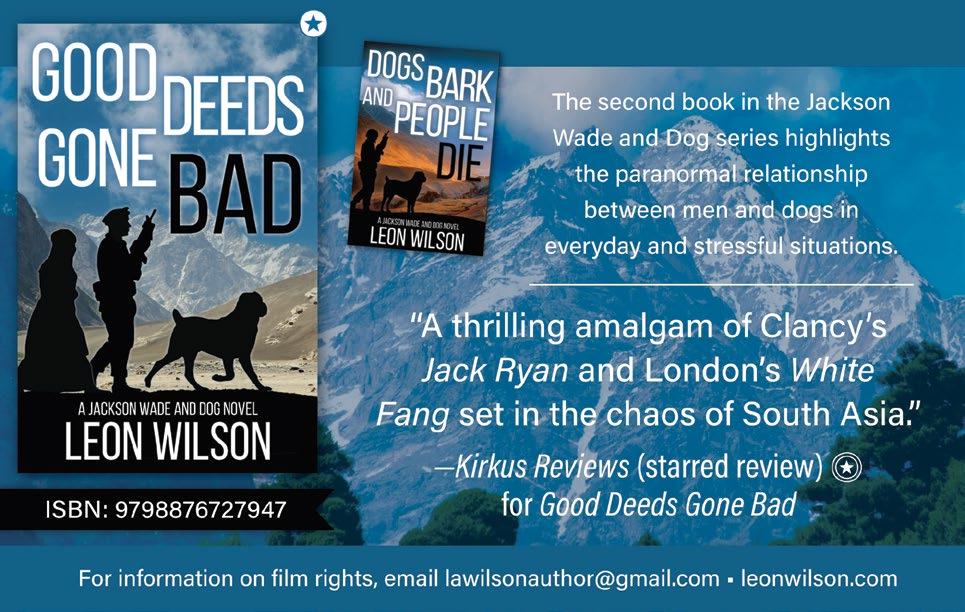


Albert Camus had a lovely line about fall: “Autumn is a second spring, when every leaf is a flower.” Fall is certainly a time of new growth in the publishing industry—a busy season when many prominent books see the light of day. This section highlights some of the best of these titles, in genres including memoir (by Susan Orlean), biography (Stephen Greenblatt), science and technology (Mary Roach), and humor (Rob Reiner, with Christopher Guest, Michael McKean, and Harry Shearer). In all, a bounty that’ll keep you busy until spring.
Apatow, Judd | Random House (576 pp.) $35 | October 28, 2025 | 9780593595930
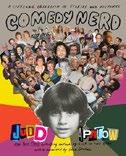
T he cringe-comedy auteur opens up his copious scrapbooks.
Apatow has arguably done as much as any one individual to shape 21st-century Hollywood comedy, conjuring memorable manchild characters as a writer (Walk Hard: The Dewey Cox Story), director (The 40-Year-Old Virgin), and producer (Anchorman: The Legend of Ron Burgundy). It’s made him famous, and he’s grateful for the attention: This hefty, image-heavy book is thick with magazine spreads and shots of awards ceremonies. Even so, he strives to foreground his humility, dedicating most of his prose to honoring mentors, writing and filmmaking partners, and inspirations. Growing up in New York, he was an obsessive fan of ’70s and ’80s comedians, inviting legends like Martin Short, Jerry Seinfeld, Paul Reiser, and others for interviews on his high school radio program. (He neglected to tell them about the “high school” part.) As he rose through the ranks of TV and film comedy, working with the likes of Garry Shandling, he brought his generational cohort with him—Ben Stiller, Adam Sandler, Ray Romano, and more—and helped launch newcomers (like Lena Dunham, who contributes a foreword).
That means he’s amassed a large assortment of autographs, cocktailnapkin quips, and before-they-werefamous snapshots. But shouldn’t a book like this be funnier? Some of his anecdotes are comic gold—such as his successful “tweenage” effort to acquire Steve Martin’s autograph or his less-successful middle-age first pitch at a Mets game. But the bulk of the book is a speed run through his many projects, praising this star or that director. He preaches the gospel of constant rewriting and “punching up” jokes, but except for a few images of scribbled-on scripted pages, there’s little about how he hones his craft.
That would make for an excellent book—one distinct from this splashy, self-celebratory one.
A personable, if only moderately insightful, glimpse into a top comic’s mind.
Bacon, John U. | Liveright/Norton (432 pp.)
$35 | October 7, 2025 | 9781324094647

Remembering the Mighty Fitz , half a century later. Bacon, author of The Great Halifax Explosion, offers a superb education in geography, seamanship, and history to tell the story of the gigantic Great Lakes ore carrier that sank in a 1975 storm, killing all 29 crew members. He opens with an overview of the Great Lakes, whose waves and currents turn out to be as nasty as those in salt water. Between 1875 and 1975, they claimed at least 6,000 ships and 30,000 sailors—averaging one shipwreck a week. As Bacon writes in arresting prose, “These freighters battled waves twenty feet or more, faced eighty-mile-per-hour winds, and crashed into lighthouses, ports, piers, bridges, shoals, jagged shores, and each other. They faced fires and explosions onboard, hundreds of tons of ice weighing their ships down, water flooding into their pilothouses and cargo holds, and fog, the one element that could make even the most seasoned mariner stop in his tracks, praying for luck.” Narrowing his focus, Bacon describes the mines of Minnesota and Wisconsin that required massive carriers to transport their ore south to refineries in Chicago and Buffalo and points in between. The carriers were designed primarily for profit (carrying the maximum load) and to pass through narrow locks leading from Lake Superior to Lake Huron. Designers paid less attention to their ability to handle the Great Lakes on bad days. Since no
crewman survived, details of the disaster are spotty, but Bacon makes the most of them, delivering biographies of crewmen, their duties, descriptions of the storm, increasingly fraught messages from the Fitzgerald before they ceased, interviews with victims’ families, and a discussion of the lessons learned. The author makes the Fitzgerald the centerpiece of a broad account of Great Lakes shipping, the careers and daily lives of the crews—and the industries, cities, and bars that feed them—and tales of other sinkings. A gripping account of a maritime disaster.
Belson, Ken | Grand Central Publishing (336 pp.) $30 | October 14, 2025 | 9781538772553
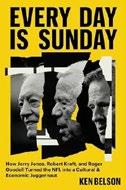
The league that’s too big to fail. Football diehards and casual fans alike will find plenty of interest in this dexterous blend of analysis, character study, and behind-the-scenes color. The New York Times’ Belson opens with a stunning fact: “Seven players from the 2001 New England Patriots”—Tom Brady’s first Super Bowl season—“died before they passed fifty years old.” The long-term impact of the game’s violence causes public relations nightmares for the NFL, but as Belson shows, Patriots’ owner Kraft, Dallas Cowboys’ owner Jones, and league commissioner Goodell have become adept at weathering scandal while generating ever-greater revenue. “Social chameleon” Kraft and Jones, who employed his “haphazard speaking style” when likening negotiations with the players’ union to an owl and a chicken having sex, shared a goal. “The league’s two most powerful owners” were “desperate” to settle big debts incurred when buying their teams, Belson writes. Jones built a showcase stadium and aggressively sold marketing rights, urging other owners to
follow. Kraft, “the closer” in a pivotal labor deal with players, also cleaned up messes. After the league botched its reaction to player protests about police violence against Black people, Kraft burnished the NFL’s image by forging a high-profile partnership with Jay-Z. “Once again,” Belson writes, the league fixed “a crisis by throwing its money and marketing muscle around.”
The NFL’s cash grabs can be brazen. One stadium has been renamed eight times by a parade of companies that bought the rights. By 2027, the league could meet Goodell’s annual revenue goal of $25 billion. Run by self-styled free marketeers, the NFL resembles “a socialist collective,” with TV deals guaranteeing each owner $400 million a year. Alongside userfriendly financial reporting, Belson shares funny anecdotes about owner pettiness, vanity, and arrogance.
A knowledgeable, entertaining account of a sport’s seemingly unstoppable growth.
Kirkus Star
Bowers Cordalis, Amy | Little, Brown (288 pp.) $30 | October 28, 2025 | 9780316568951

T he story of the largest dam removal in U.S. history.
When Bowers Cordalis accepted a summer internship in her Yurok family village, in Northern California, she didn’t expect to witness the largest fish kill in American history. It was 2002, but well before her arrival the conditions had been primed for salmon loss on a massive scale. For nearly a century, a system of dams and canals had been used to convert the once-fertile salmon grounds and traditional Yurok territory into agricultural land. During that time, the U.S. government systematically reduced Yurok access to their native lands and fishing grounds, while increasing the amount of water diverted to
A book about finding a calling—and
farmers. By the time Bowers Cordalis steered a boat through miles of dead chinook piled three or four layers deep, the sickness resulting from the government’s water diversion had led to losses of between 34,000 and 78,000 adult chinook, losses that the colonial exploitation of the river had been building toward for a long time. Bowers Cordalis describes her Yurok tribe as people intrinsically connected to the salmon, people who consider the right to fish “as important to us as breathing.” Their way of life was at stake, as were the livelihood of the salmon and the health of the Klamath River. In trying to exercise their right to fish, her family had survived violence, intimidation, harassment, and an armed occupation on their reservation. The author’s path as an attorney and eventual leader in the successful removal of the Klamath dams grew out of that suffering. Her tribe’s resistance is rendered here in potent prose. Bowers Cordalis moves fluidly between her own story, personal accounts of her family and tribe, and the mighty river itself.
A moving and empowering account of an Indigenous tribe’s tenacity in the face of injustice.
Buchdahl, Angela | Pamela Dorman/ Viking (352 pp.) | $32 | October 21, 2025 9780593490174

Seeing each other as part of the “same family.”
Buchdahl is the senior rabbi of Central Synagogue in Manhattan. A leading figure in Reform Judaism, she has led prayer services for two American presidents. She is
also the daughter of a Jewish man and a Korean woman, each of whom brought family tradition and the power of faith to her upbringing. Buchdahl’s eloquent memoir braids a narrative of growth and discovery with sermonic reflections on biblical texts. This is a book about finding a calling, but it is also a book about inclusion. Throughout her journey—from training as a cantor known for a magnificent voice, to ordaining as a rabbi famous for her close readings of holy words—she asks: Am I really Jewish? What is Judaism, now, in a 21st century of mixed-race families, of resurgent orthodoxy, and of challenging Israeli political, social, and military action? One answer comes from her father. “My father’s Judaism wasn’t about a deity or dogma. It was a series of actions played out every day.” Another answer comes from her mother, the real hero of this book. Raised in wartime Japan, returning to wartime Korea, marrying an American Jewish man, moving to Tacoma, Washington, Angela’s mother is more than a survivor. She is the creative spirit of her family and of this rich narrative. In one telling moment, we read that her mother put kimchi on the Passover plate to represent the bitter herbs of exile. Such a move teaches us that every culture has its passages and pains, that families and faith should be built out of welcome rather than on walls, and that out of bitter tastes come sweet memories. Amid the noise of current conflict, Buchdahl’s voice invites us all to sing along.
An inspiring life story of believing and belonging, told by one of the most influential figures in modern American Judaism.

Kirkus Star
Burt, Stephanie | Basic Books (352 pp.) $30 | October 14, 2025 | 9781541606234

An exploration of what made Taylor Swift the phenomenon she is.
Poet and literary critic Burt taught a class about the songs of pop star Swift at Harvard University in 2024, with 200 students signing up to learn about the music and lyrics of the singer-songwriter. Burt’s book poses and explores a seemingly simple question: “Taylor Swift is a world phenomenon. How did she get that way?” She proposes some answers: She mostly wrote her own songs; she is “both aspirational and relatable”; and she has an indefatigable work ethic. Burt dedicates a chapter to each of Swift’s 11 studio albums, starting with her self-titled 2006 debut, which Burt says is part of the pastoral tradition in literature and treated country music as “a set of tropes.” Burt goes on to analyze Speak Now, which she considers a Künstlerroman; Lover, “a mess” with “aspirational moments”; and Swift’s most recent record, The Tortured Poets Department, her longest and “saddest” album. The book closes with a chapter on Swift’s record-shattering Eras tour, which Burt got to see in Edinburgh, Scotland. Burt’s book mixes close readings of Swift’s lyrics (she urges readers not to treat them as poems) with looks at Swift’s biography and accounts of Burt’s own travels in search of the country that made Swift. A self-proclaimed “Swiftie,” the author does an especially good job writing about the artist’s relatability: “If she’s a genius, that’s not because she stands apart from everyone else or pushes us away.” Burt isn’t afraid to criticize Swift (something of a rarity among her fans), and her refusal to treat the singer with kid gloves is welcome: She’s a fan,
TAYLOR’S VERSION
but a clear-eyed one. This is an outstanding look at one of the world’s most beloved entertainers. More than a fan’s notes: a smart, incisive look at the singer-songwriter who has captured the world’s imagination.
Chang, Jeff | Mariner Books (560 pp.) | $35 September 23, 2025 | 9780358726470

Martial arts mastery, bigscreen immortality. This expansive biography of an iconic actor doubles as a nuanced history of Asian American empowerment. Chang, the author of books about hip-hop and race, adeptly shows how Lee’s magnetism and physical talents, showcased in Enter the Dragon and other beloved action movies, helped spur “an awakening among racialized minorities.” Lee, whose father was a stage performer, was born in San Francisco and raised in Hong Kong, then a British colony, where he learned gung fu —“kung fu” is an Americanization, Chang explains—and appeared in numerous films as a child. He moved back to the U.S. as a young man, hoping to become an esteemed martial arts teacher. His students included Steve McQueen and Roman Polanski. After his “spinning kicks” and “one-inch punch” impressed Hollywood stars attending a 1964 California martial arts tournament, TV came calling. In a period when white actors frequently portrayed Asian characters, Lee’s appearance as a superhero’s butt-kicking chum on ABC’s The Green Hornet was a breakthrough, though he was discouraged that Hollywood remained mostly closed to
Asian American actors. Lee’s eventual fame in Hong Kong–produced movies made him a hero to many, among them Asian Americans shedding “the reflex to obliterate themselves in the presence of whites.” Since the actor died from brain swelling in 1973—and notwithstanding his family’s objections—his renown has been leveraged in so-called Bruceploitation movies with titles like Bruce Has Risen Chang relates these details against a shifting set of crisply depicted backdrops, from 1960s Asian American student activism to the stylistic debates that shaped martial arts during Lee’s time. Chang perhaps overdoes it when contending that Lee “has come now to represent the necessity of solidarity and the fight for freedom everywhere,” but such minor exaggerations don’t diminish this insightful book’s appeal.
A rousing portrait of a charismatic actor who redefined global stardom.
Fatsis, Stefan | Grove (416 pp.) | $30 October 7, 2025 | 9780802165824

A romp in the land of lexicography. Journalist Fatsis, author of the kindred book Word Freak, talked his way into the headquarters of Merriam-Webster in Springfield, Massachusetts, after learning that “the company was overhauling its foundational book, Webster’s Third New International Dictionary of the English Language, Unabridged.” The last major revision had occurred decades earlier, in 1961, totaling some 465,000 words—and, given that speakers of the English language
were coining words (“Doomscrolling one year, cheugy another, rizz the next”) far faster than the dictionary could keep up with, there was plenty to do. Yet, as Fatsis chronicles, Merriam-Webster was the last dictionary standing: Its competitors had folded their tents, and though alone in the field, even Merriam-Webster was forced to lay off employees as Google and Wikipedia became go-to sources for information, albeit at far lower quality. Fatsis writes engagingly of lexicographic heroes such as Madeline Kripke, who amassed perhaps the finest language library in the world but died of Covid-19 before that new word could be added. He gamely wades into linguistic controversies, one being the inclusion of the “n-word,” which occasioned a boycott in the late 1990s and a sage but unpersuasive reply from the publisher that “to remove the word from the dictionary would simply mislead people by creating the false impression that racial slurs are no longer part of our culture, and that, tragically, is not the case.” And Fatsis, who crafted 90 definitions for M-W (alt-right, burkini, microaggression), and who begins his book by wondering whether human editors are on the way out in favor of artificial intelligence, reckons that AI is “good at some things, bad at others, and, as of the publication of this book’s first edition in late 2025, not a threat to completely upend the last gladiators of commercial lexicography.”
An entertaining, instructive look into how words make their way into the dictionary.
Gilbert, Elizabeth | Riverhead (400 pp.)
$35 | September 9, 2025 | 9780593540985
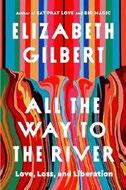
very best effort to tell the truth about what happened between me and Rayya Elias—our friendship, our romance, our beauty, rage, and pain. It tells the story of Rayya’s addiction, her relapse, and her death. It also tells the story of my own addiction and my eventual surrender into recovery.” Gilbert (Eat Pray Love, City of Girls, etc.) brings her beloved Rayya vibrantly to life on the page, showing how and why the woman she met in 2002 as a hairdresser in the East Village was “a legend to all who knew her.” When Rayya was diagnosed with terminal cancer in 2016, Gilbert ended her marriage (which by then had become a distant second fiddle to the relationship with Rayya), and the two became lovers. There was a good part, and then a very bad part in the months leading up to Rayya’s death in 2018. The book also follows the story of Gilbert’s subsequent recovery from sex and love addiction through devoted adherence to a 12-step program. Since she does not “have the heart to write out the excruciating details of the binge that I went on” after Rayya died, citing concern for the privacy of others, she focuses instead on the spiritual and emotional progress she has finally been able to achieve, documented in earnest poems and winsome doodles as well as well-written anecdotes. “Readers of my earlier work may remember that I reached nearly this same level of peace and tranquility back when I was in India, in the middle of my Eat Pray Love travels, after months of disciplined prayer, meditation, and retreat.” The difference this time, she says, is that she has the support she needs not to “drive my life off a cliff all over again.”
Kirkus Star
Dark Renaissance: The Dangerous Times and Fatal Genius of Shakespeare’s Greatest Rival
Greenblatt, Stephen | Norton (336 pp.)
$31.99 | September 9, 2025 | 9780393882278

Marlowe’s Renaissance. From the pen of the award-winning scholar Greenblatt (The Swerve, 2011) comes this vivid biography of the Renaissance poet and playwright Christopher Marlowe. The son of a Canterbury cobbler, Marlowe won a place at his local school by dint of brains and energy, moved to Cambridge, where he distinguished himself in Latin learning, found himself recruited into a network of intelligence officers for Queen Elizabeth, and then, at age 29, was mysteriously murdered in a bar fight. At the heart of Greenblatt’s book, though, is not just a familiar story but a new argument: that it was really Marlowe, rather than Shakespeare, who lit the flame under the literary Renaissance of Elizabethan England and, furthermore, that it was Marlowe’s brilliant schooling (rather than any lived experience) that fed his verbal imagination. Acting and action were everywhere in Marlowe’s world, and Greenblatt implies that it was his work as a spy that gave him an added sense of what it meant to perform.
The author of the world’s most famous memoir returns to the form to tell the story of a great love.
“This book—its stories, prayers, poems, journal entries, photos, and drawings—is my
A worthy addition to the literature of addiction and recovery, charming and harrowing by turns.

Marlowe “entered a world in which virtually everyone was in disguise, and it was fantastically difficult to know whom to trust. These professional role-players, operatives supremely gifted at inspiring confidence, whispered what one most hoped to hear and made one want to relax, open up, and reveal the truth.” Greenblatt is describing the world of Elizabethan espionage, but he could well be talking about the power of the theater to make us open up, relax, and reveal the truth. In the end, Marlowe “made it possible to write in a new way about violence, ambition, greed, and desire. He offered poetic liberation.” In his hands,
“the expressive power of the English language took a great leap forward.” In Greenblatt’s hands, literary scholarship, too, has taken a great leap forward. A scintillating biography of Christopher Marlowe by one of America’s leading humanities scholars.
Jones, Saeed & Maggie Smith
Washington Square Press/Atria (128 pp.) $22 | September 9, 2025 | 9781668207024

Facing hard times.
After the election of 2024, poets Jones and Smith looked to their “mentors, siblings on the page, and friends” for hope and solace, strategies and commiseration. Their collection of 27 essays, poems, and artwork honors that diverse community of writers and artists who share their reflections on how to cope with oppression and how to move forward. “I started typing up my own Project 2025,” Smith texted to Jones. “First item: no self-abandonment.” By self-abandonment, she meant pretending “you don’t know what you know, don’t hear what you hear, don’t see what you see.” And not abandoning others, as well. Several contributors consider forms of resistance. “I think the act of resistance I take the most pleasure in is raising my sons to be good men,” writes illustrator Aubrey Hirsch. For Chase Strangio, simply being a transgender person signifies resistance: “Part of what makes trans people so central in this small and toxic moment is the power we wield by being insistently ourselves.” Disability justice activist Alice Wong considers the challenge of countering fascism: “The fear, chaos, and danger many of us live in changes our relationship with time. To fight, to provide mutual aid, to listen, care for, and love our people, to nourish and sustain yourself—all of these things take time and energy. We must give
Sometimes, the collapse of a state is a good thing.
GOLIATH’S CURSE
ourselves space, grace, and time if we are to fight fascism.” Some pieces exude anger; others, sadness; all face the future with more questions than answers. As scholar Imani Perry puts it, “Today I ask: How do we raise the young in the face of deportations, expulsions, captivity, abandonment and targeted cruelty? How do we feed those writhing with hunger pangs for freedom?” All underscore the crucial power of community. A stirring anthology.
Kirkus Star
Kemp, Luke | Knopf (304 pp.) | $30 September 23, 2025 | 9780593321355

Giants are usually hard to fell—but when they fall, they fall hard.
“The average lifespan of a state is 326 years,” writes international relations scholar Kemp. “The largest states…are more fragile, lasting on average just 155 years.” What Kemp calls “Goliath states,” including Russia, China, and the U.S., “can be surprisingly fragile,” even though underlying all of them is the threat of violence via police, army, and other government agencies. In some instances, Kemp observes, the collapse of a state is a good thing: Somalia was better off without its dictatorship, even as warlords contended for power. Often, collapse is incremental, so that a peasant in the Italian countryside might not have been aware that the Roman Empire was falling apart. But just as often, collapse is cataclysmic, as Kemp fears it might be given multiple converging threats,
including climate change, inequality, the rise of AI, and nuclear war. Societal collapse may then ensue, but, as Kemp notes, that is largely “about the fall of great power structures,” with elites standing the most to lose. Much of Kemp’s book is about the evolution of the state, revisiting anthropological views of Paleolithic societies as happier and more egalitarian than modern ones; archaeological evidence, he notes, suggests that moderns are about twice as likely to die violently than people 10,000 years ago. As humans acquired “lootable resources” unknown to their forebears, motivations for impersonal violence increased. Kemp’s book is wide ranging and full of useful and provocative theses, such as this one: “The more strongly states subjugate women, the more likely they are to be both autocratic and prone to failure.” Just so is his set of prescriptions for nations and people to survive the possibility of a catastrophic downfall: for states, for instance, the mandate to “make the world equal again”; for individuals, “Don’t be a dick.” An invigorating look at big picture history across continents and millennia, and a survival manual to boot.
Kirkus Star
Lepore, Jill | Liveright/Norton (768 pp.) | $39.99 September 16, 2025 | 9781631496080
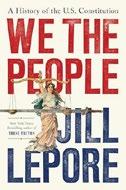
T he noted historian advances the cause of an aggressively, and progressively, malleable set of rules for government.
“The U.S. Constitution was intended to be amended,” writes Lepore
at the outset. Whereas the functions of government were established in such a way that there would be continuity from generation to generation, and whereas the Constitution sets fairly high hurdles for change, nonetheless, by Lepore’s lights, the Founders intended for the document to be changed in order to meet the needs of the day, trusting in the Enlightenment premise that “the human mind is driven by reason.” Article V, Lepore continues, is “a sleeping giant”: In it the Founders specified that change could come in one of two ways, the first being a congressional proposal, the second a convention of the states, with a “double supermajority” of votes for approval, two-thirds of Congress and three-quarters of the states. Although there have been flurries of amendments—including the first 10, yielding the Bill of Rights—it has been nearly 40 years since the last constitutional convention was held, even as, Lepore calculates, members of Congress proposed 2,100 amendments between 1980 and 2000. Part of the problem is congressional gridlock, a feature of government since the days of President Reagan; another is what Lepore considers the false doctrine of originalism—which, she writes provocatively, “arose from the failure of conservatives to change the Constitution by democratic means.” Lepore presses her argument with numerous case studies, including the difficult passage of an amendment to allow direct election of senators (formerly appointed by governors), the argument over an income tax (and one that progressively taxed the rich more than the poor), the failed adoption of the Equal Rights Amendment, and a longtime favorite that has yet to come about: the abolition of the aristocratically inspired Electoral College.
With the Constitution under daily threat, Lepore’s outstanding book makes for urgent reading.

Macy, Beth | Penguin Press (368 pp.) $32 | October 7, 2025 | 9780593656730
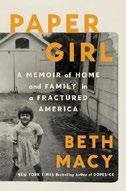
A small-town success story returns to her Ohio home to take account of profound changes.
“It’s not as if Urbana had ever been utopia for me. I was among the poorest kids in my class, and I felt it.” Macy, the author of Dopesick and other bestsellers, made her way out of poverty in the 1980s through a college degree funded by grants that largely no longer exist. Her latest nonfiction narrative chronicles her return home to try to see what would happen to a kid like her today, coming face to face with “the unprecedented forces that were actively turning the community I loved into a poorer, sicker, angrier, and less educated place.” Her reporting goes deep and wide, including her family members, old friends and teachers, and many new acquaintances. Central among them is recent high school graduate Silas James, one of the teens she identifies as “a modern-day me,” though Silas is trans and has more abuse and trauma in his background than the author. Also memorable are an ex-boyfriend, once the most liberal person she knew, now a strident voice on an array of far-right talking points; on the other end of the spectrum is Brooke Perry, a deeply committed attendance officer whom she accompanies on harrowing rounds to try to get kids into school in a climate where education has lost its place as a tentpole of the American dream. The author does not shy away from tough personal stories, writing about a niece who was abused as a child by her stepfather. Macy goes into the toughest interviews with “trauma-informed advice,” reminding herself that connecting about shared interests and noncontroversial topics will keep these conversations going much
longer—though sadly, it often doesn’t change the end result. Black-and-white photos of the interview subjects add an important dimension to the story. By practicing the basic journalistic acts of listening and observing, Macy continues her noble work as a truth teller.
Mamet, Zosia | Viking (256 pp.) | $28 September 9, 2025 | 9780593490563
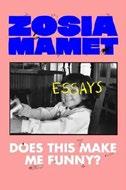
Personal essays on the miseries, catastrophes, obstacles—and some joys—of being Zosia. In the acknowledgments of her debut essay collection (she previously edited an anthology called My First Popsicle), Mamet reveals that her Pulitzer-winning playwright father counseled her never to read reviews of her own work because you remember only the bad ones. So she may never know that this review has some nice things to say about her book. About two-thirds of the essays are about being completely miserable as an adolescent and young adult, constantly struggling with “fears that I would never make it as an actress, that I would never be skinny enough to love, that I’d never escape the prison of high school, or anorexia, or my own mind.” These problems will be completely relatable to many readers, and her treatment of them is funny and moving. The more jaded will have read much on these topics in the past, but will join the fangirls in cheering when she delivers the satisfaction of also writing about finding a great love and a true best friend and, most distinctively, the hair-raising process of finding her place in the acting world. The best essay in the book is the one nobody but her could write—about playing Shoshanna on Girls. It’s very close to the end, and contains some of the best descriptions of acting since Al Pacino’s Sonny Boy. “Zosia went offline to make space for Shosh to take over for that
period of time. She came out of me as if she had been a part of me forever, lying dormant just waiting for her time to arrive when she could come alive.” She concludes by saying she will never stop missing her, imagines her character’s life continuing somewhere, “a speed-talking energizer bunny who loves pink and is more than likely running a Fortune 500 company and on her second marriage to a highly successful fund manager.” Generally lovable, with several standout moments.
McCullough, David | Simon & Schuster (208 pp.) $27 | September 16, 2025 | 9781668098998
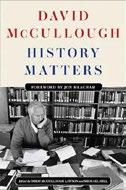
Avuncular observations on matters historical from the late popularizer of the past. McCullough made a fine career of storytelling his way through past events and the great men (and occasional woman) of long-ago American history. In that regard, to say nothing of his eschewing modern technology in favor of the typewriter (“I love the way the bell rings every time I swing the carriage lever”), he might be thought of as belonging to a past age himself. In this set of occasional pieces, including various speeches and genial essays on what to read and how to write, he strikes a strong tone as an old-fashioned moralist: “Indifference to history isn’t just ignorant, it’s rude,” he thunders. “It’s a form of ingratitude.” There are some charming reminiscences in here. One concerns cajoling his way into a meeting with Arthur Schlesinger in order to pitch a speech to presidential candidate John F. Kennedy: Where Richard Nixon “has no character and no convictions,” he opined, Kennedy “is appealing to our best instincts.” McCullough allows that it wasn’t the strongest of ideas, but Schlesinger told him to write up a speech anyway, and when it got to Kennedy, “he gave a speech in which there was one paragraph that had once sentence written by me.” Some of McCullough’s
appreciations here are of writers who are not much read these days, such as Herman Wouk and Paul Horgan; a long piece concerns a president who’s been largely lost in the shuffle too, Harry Truman, whose decision to drop the atomic bomb on Japan McCullough defends. At his best here, McCullough uses history as a way to orient thinking about the present, and with luck to good ends: “I am a short-range pessimist and a long-range optimist. I sincerely believe that we may be on the way to a very different and far better time.”
A pleasure for fans of old-school historical narratives.
Nicolson, Adam | Farrar, Straus and Giroux (448 pp.) | $32 | September 16, 2025 9780374617370

A poetic study of birds and their place in the Anthropocene. Nicolson grew up ignoring birds. For the British naturalist and author, they used to be “a blank, a flicker of nothing much, like motes in sunlight.” To fill this gap in his knowledge, Nicolson decided to attend his own “Bird School”—a personal commitment to learning about birds, their behaviors, and their relationship to human beings. To do so, he constructs an “absorbatory,” an observatory in his Sussex Weald farmland where he sought to “dissolve… the boundary between self and world.” Most chapters use a common species to explore a wider topic: robins and how they mark their territory, tits and breeding, ravens and how they think and communicate. While birds are a hyperlocal interest, much of the knowledge he shares is broad enough that readers will learn about bird behavior in general. In a chapter on songbirds, for example, readers learn that birds alter their singing schedule to work around an airport’s loudest hours. In addition to a wealth of facts about bird
behavior, Nicolson has access to an endless fount of lyrical descriptions to make birds come alive on the page: A blackbird sings as “if a cherry could sing…rounded and full and fleshy, that dark sugar-juice”; holding a dead raven is like “exploring a derelict house.” The final two chapters address the elephant in the absorbatory: As mankind has flourished, most bird populations have dwindled. Nicolson’s solutions may be more applicable to those who own large swaths of land or work in environmental policy, but the book’s wider point can inspire any of its readers: If we learn to pay attention to the world around us, we’ll become a part of it again.
An evocative ode to English birds that invites readers to look more closely at the world around them.
NoiseCat, Julian Brave | Knopf (432 pp.) $29 | October 14, 2025 | 9780593320785
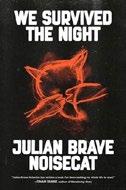
A member of a Canadian Native nation writes skillfully of daily life and the transcendent power of traditional stories.
Filmmaker and writer NoiseCat opens on a horrifying note: His newborn father was almost murdered at one of Canada’s infamous residential schools, “cast into the incinerator to be burned with the garbage.” Fortunately, a night watchman rescued “Baby X,” who returned to his band in British Columbia and its small reservation. “Our rez looks the way you might imagine a rez looks,” writes NoiseCat, “cars up on blocks, free-ranging dogs, horses here and there, the occasional cousin getting around on a bicycle pieced together out of spare parts.” His father would become a famed artist, but at the cost of leaving his family behind and, for many years, battling alcoholism. Drawing on “tspetékwll,” or etiological stories, NoiseCat portrays his father as Coyote, “a great creator, terrible demolisher, and
downright hilarious hellraiser.” In other words, as the author elaborates, Coyote is neither all good nor all evil, just as life is something both to endure and to celebrate. And, he adds, Coyote was well aware, too, that “he was a failure and a laughingstock.”
NoiseCat is both eloquent and plainspoken: When signing a condolence book at the death of Canada’s monarch, he writes simply, “You take care, Queen Elizabeth,” but his language more often sings: “If you know where to look and who to listen to, you might just run into some of the raucous Indian stories, new and old, to which this land and its humans truly belong.” Along with those traditional and raucous stories, NoiseCat recounts some key moments in modern Native Canadian history, including the successful campaign on the part of the Inuit to create a self-governing territory that takes in a third of Canada’s landmass.
Thoughtful, informative, often entertaining, and just as often saddening, NoiseCat’s is a book to remember.
Kirkus Star
Orlean, Susan | Avid Reader Press (336 pp.) $32 | October 14, 2025 | 9781982135164

A celebration of a supremely accomplished writing life, with a few lumps along the way.
The occasion for this look back at a sterling writing career, in part, was Orlean’s realization that the 25th anniversary of The Orchid Thief was fast upon her, a signal moment indeed. Yet, she demurs, she had always steered clear of writing a memoir: “I’m used to looking outward, not inward; I yearn to bring attention to hidden worlds, not to my own.” The hidden worlds of others have proved rich mines in the past, but so, too, Orlean’s own life turns out to be, from a nerdy, bookish childhood in Shaker Heights, Ohio (easy to lampoon for its suburbanness, but, she adds, also an unexpected locus for the Civil Rights
Movement), to her first efforts at journalism and on to the glories and disappointments of the writer’s daily work. Orlean is often funny, especially when telling stories on herself, as when she had to have her nose cauterized after a snort too many, “which embarrassed me to no end”; she can also be steely, as when she recounts how she became a target for QAnon after tweeting “I’m so tired of old white men” in response to the Brett Kavanaugh confirmation hearing. For all the pleasures and pains herein, though, the great value of this book is the MFA in nonfiction writing that Orlean packs into it, full of some of the most useful advice on craft that any budding (or long-practicing, for that matter) writer could ask for, such as when she writes, “Every significant move forward for me has occurred because I developed ideas for myself. Story ideas are everything.” And on that note, how she got the idea for The Orchid Thief is a tale that alone is worth the price of admission.
A spry, entertaining memoir/ writing workshop by a nonfiction artist at the top of her game.
Passmore, Ben | Pantheon (224 pp.) | $22 paper | October 7, 2025 | 9780593316122
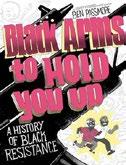
Birth of a violent nation. In this trenchant graphic novel, the author is at home, lounging on a sofa in sweatpants, when his father walks in the door, having passed burning cars and a helicopter overhead. “You’re not on the street like everyone else?” the old man asks, wondering why his son isn’t protesting the police killing of a Black man. “Must think I have a death wish!” Passmore replies. “Get this cocoa butter condescension out of my house!”
Beret-wearing Dad has his own powerful rejoinder: He slaps his son’s head with a book on Black liberation. The wallop
sends Passmore back in time, taking him on an involuntary odyssey in which he witnesses injustices meted out to Black people throughout history—brutality that is met with resistance. It’s a shocking awakening for the young man, even if it takes time to sink in. “I’ve seen dudes get beat by cops already,” Passmore says when transported to a scene of police confronting Black men in New Orleans in 1900. “Why’d you bring me to caveman times for this?” Passmore soon finds out: One of the men is Robert Charles, who, after being clubbed, shot an officer—and was shot himself. Passmore dodges gunfire in the ensuing conflict. “Yo dad, beam me up!” he screams. “I’m not getting killed by Gone With the Wind bullets.” On his journey, Passmore sits in on a trial, attends Emmett Till’s funeral, and beholds violent clashes. In a meta turn, he addresses a TV audience’s concerns that he left out this or that historical episode. The tone of the book—drawn in lively black and white and pink images—is alternately haunting and hilarious, as when Passmore, author of the comic book series Daygloayhole, imagines what Martin Luther King Jr.’s “I Have a Dream” speech sounded like to terrified whites, the impassioned minister envisioning the South “transformed into a paradise of interracial whoopie!”
A mordant and highly original graphic novel that has readers reconsider Black resistance.
Pinker, Steven | Scribner (384 pp.) | $30 September 23, 2025 | 9781668011577

Pinker continues his explorations of the hidden social functions of language and thought with this look at common knowledge. Common knowledge, as cognitive science Pinker lays it out here, lends itself to the game theory beloved
of economists and strategists: Do I know something that you don’t? Can we agree, in order to produce best outcomes, that X means X and Y means Y ? Pinker explains at the outset that “with private knowledge, person A knows something, and person B knows it. With common knowledge, A knows something, and B knows it, but in addition, A knows that B knows it, and B knows that A knows it”—a shared set of data, facts, and assumptions that enable not only cooperation but also coordination. That coordination, Pinker holds, is essential to the functioning of society: Our shared visions allow us to build economies, polities, communities, for which reason he adds that a better term for “common knowledge” would be “mutual knowledge,” which more easily accommodates agreeing on “nonphysical realities.” Pinker offers a vivid example when he notes that people don’t rise up against dictators easily because of the unspoken assumption that everyone else supports the regime, but things can get rolling when a public demonstration yields “the common knowledge needed to coordinate resistance.” Timely, that. Common knowledge has its negative aspects, he adds, as when people come to consensus about some point or another by way of shared media and then move together to punish transgressors. The swiftest way to be misunderstood, he notes, is to use irony or indirect speech, much as they help disguise our intentions. Pinker writes fluently, though there’s plenty of arcana from neuroscience, linguistics, and other fields floating around here. While it’s not necessary to have read Noam Chomsky, Antonio Damasio, Daniel Kahneman, and other cognitive scientists to follow Pinker’s arguments, it helps.
A revelatory, if sometimes challenging, look at the traps and rewards that lie within our words.

Reiner, Rob with Christopher Guest, Michael McKean & Harry Shearer
Gallery Books/Simon & Schuster (288 pp.)
$35 | September 9, 2025 | 9781668079140

’Twas the creation of a classic film.
Spinal Tap— “England’s loudest band”—has been quiet of late. With good reason. It turns out that the not-so-clever musicians “documented” in the cult spoof This Is Spinal Tap (1984) have had it out for Marty DiBergi (the film-within-a-film’s director, played by Reiner). “You seemed to only focus on the negative stuff, the mishaps,” says lead singer David St. Hubbins (McKean) in the in-character oral history portion of this hilarious book, whose publication coincides with the release of a movie sequel, Spinal Tap II: The End Continues. Referring to the group getting lost backstage before a concert—“Hello, Cleveland!”—bass player Derek Smalls (Shearer) adds: “There were dozens of gigs where we found the stage straightaway. We didn’t see that reflected.” There’s another reason for the band’s low profile: Smalls was in rehab for addiction—internet addiction. Guitarist Nigel Tufnel (Guest) says, “I remember when I heard about this. I wrote him an email. But he didn’t answer.” Smalls replies: “I wasn’t allowed. It’s terrible. It gets ahold of you, and before you know it, you’re looking at cats waterskiing.” Any fan of the film will savor these exchanges. Tufnel once rented a castle in Lichtenstein that was surrounded by emus (“A lot of people think, ‘Oh, they’re going to kill me.’ But emus, they’re quite nice.”), his dad and granddad sewed “top-line” windsocks for airports, and St. Hubbins got his “waxing done” during Tufnel’s hourslong solos. In the book’s first section, Reiner recounts the making of his initially misunderstood movie. Gems abound: Backstage at an AC/DC concert, the actors noticed that a
“huge wall” of amps was for show (none were plugged in). Guest included a musical quote from Luigi Boccherini in Tap’s song “Heavy Duty.” And you’ll just have to read the book to learn of the origins of that cucumber—actually, a zucchini—found in a pair of trousers. This book doth rock.
Roach, Mary | Norton (288 pp.) | $28.99 September 16, 2025 | 9781324050629

A lively treatise on the human body as an endlessly interchangeable set of parts. It’s an old saw (and, these days, canard) that British teeth are bad. All the same, Roach, an indefatigable researcher, turns up a gem at the start of her latest book: Paul McCartney’s father once suggested that Paul “have all my teeth taken out and false teeth put in,” since he’d likely lose his original set soon enough. Her catalog of cut-and-paste body parts goes on, corporeal trivia mixed with solid, elegantly written scientific journalism. One such part is the nose, none too easy to craft a replacement for, as witness the eminent Danish astronomer Tycho Brahe, who lost his original proboscis in a duel. “Occasionally,” Roach quotes one biographer as saying of its substitute, “it would drop off.” Other appendages await, not least the male member. Given that cataract surgery is now almost assembly-line common, Roach wonders, what about elective surgeries to replace underperforming parts? No, not that part; rather, Roach tells the story of a former Marine who had suffered an injury that led to his toes dragging and thus arranged (by shooting himself in the afflicted foot) for an amputation and refitting with a prosthetic that allowed him to walk more easily. Roach wanders through the hallways of eldritch laboratories where pigs are grown to provide organs that
Volatile, willful, angry, and abusive—and her mother.
MOTHER MARY COMES TO ME
are transplantable to humans, and she visits cadaver labs to look at another source of carefully inventoried parts (“As much time is spent on documentation and shipping of a donor’s tissues as on their removal. You’re expecting The Jeffrey Dahmer Story but it’s closer to UPS”). She interviews researchers on cures for type 1 diabetes and advances in “in vitro gametogenesis” and generally has a grand time looking into areas where few writers—especially squeamish ones—have ventured. An amiably entertaining, endlessly intriguing stroll through the stuff of which we’re made.
Roy, Arundhati | Scribner (352 pp.) | $30 September 2, 2025 | 9781668094716

A daughter’s memories.
Booker Prize–winning Indian novelist Roy recounts a life of poverty and upheaval, defiance and triumph in an emotionally raw memoir, centered on her complicated relationship with her mother. Mary Roy, who raised her two children alone after divorcing her ne’er-do-well husband, was a volatile, willful woman, angry and abusive. In a patriarchal society that oppressed women socially, economically, and legally, she fought to make a life for herself and her family, working tirelessly to become “the owner, headmistress, and wild spirit” of an astoundingly successful school. The schoolchildren respectfully called her Mrs. Roy, and so did Arundhati and her brother. To escape her mother’s demands and tantrums, Arundhati, at age 18, decided to move permanently to Delhi, where she was
studying architecture. After a brief marriage to a fellow student, she embarked on a long relationship with a filmmaker, which ignited her career as a writer: screenplays, essays, and at last the novel she titled The God of Small Things. The book became a sensation, earning her money and fame, as well as notoriety: She faced charges of “obscenity and corrupting public morality.”
Arundhati sets her life in the context of India’s roiling politics, of which she became an outspoken critic. For many years, she writes, “I wandered through forests and river valleys, villages and border towns, to try to better understand my country. As I traveled, I wrote. That was the beginning of my restless, unruly life as a seditious, traitor-warrior.” Throughout, Mrs. Roy loomed large in her daughter’s life, and her death, in 2022, left the author overcome with grief. “I had grown into the peculiar shape that I am to accommodate her.” Without her, “I didn’t make sense to myself anymore.” Her candid memoir revives both an extraordinary woman and the tangled complexities of filial love.
An intimate, stirring chronicle.
Silverman, Jacob | Bloomsbury Continuum (288 pp.) | $30 October 7, 2025 | 9781399419987

Financial reporter Silverman digs deep into why the richest part of wealthy California has swung to the extreme right. There was a time when Elon Musk threw his money behind progressive candidates, when, supporting LGBTQ+ equality, he said, “People should be free to live their lives
where their heart takes them.” That was before Democrats and progressives began talking about taxing the rich, anathema to the rich, of course, and after 2022 Musk threw himself far to the right, “his public persona utterly transformed,” now opposed to transgender people (including one of his children), undocumented immigrants, and wokeness in general. Just so, the less visible David Sacks put money into Gavin Newsom’s gubernatorial race, but then suddenly jolted to the right, funding a recall election. Some of the fascination with the right has to do with Silicon Valley’s commitment to disrupting things, whether moribund industries or government; but then, Silverman writes, Silicon Valley has always had its share of people on the far right, such as Oracle CEO Larry Ellison, who’s been all in for Trump to the extent that he bought into the movement to overturn the 2020 election results. The rightist movement, Silverman notes in a cogent argument, has been freshly awash in new money from the likes of Peter Thiel and a bunch of Saudi princes; it has used those funds to boost the MAGA movement and Trumpism in various ways, but it has also bought its way into government through defense-industry contracts, DOGE, and outright bribes, all with an eye to deregulating, undoing the Securities and Exchange Commission and the Department of Justice, and liberating supporters from the burden of having to pay their fair share. It makes for an ugly picture altogether, with a decided undercurrent of despair about our “rut of societal stagnation, decline, corruption, and mistrust.”
A book that should trouble your dreams.
Gertrude Stein: An Afterlife Wade, Francesca | Scribner (480 pp.) $31 | October 7, 2025 | 9781982186012

A life after death. British biographer Wade was a fan of Gertrude Stein, “intrigued— and confounded—by her contradictions… her indefatigable self-mythologising, her wry probing of
genre and gender. Above all,” she admits, “I was drawn to her work—even if, at first, I didn’t know what to make of it.” Her inspiration for writing about Stein came when she found, at Yale’s Beinecke Library, a trove of notes made by a literary scholar, Leon Katz, newly opened to researchers after Katz’s death in 2017. Drawing on Stein’s unpublished texts, private jottings, and months of interviews with Alice Toklas, Katz documented significant facts about Stein that suggested a more complex image of the self-proclaimed genius and her diffident companion than what was widely known. Wade decided to structure her book in two parts: the first, an overview of “the narrative she crafted carefully”; the second, her afterlife: “the years in which her posthumous legacy was constructed, celebrated and contested, by all with a stake in the evolving legend—chief among them, Alice B. Toklas.” Drawing judiciously on archival material, Stein’s autobiographies, recent scholarship, and biographies of Stein by Brenda Wineapple, Linda Wagner-Martin, and Janet Malcolm, to name a few, Wade creates a lively account. She astutely handles controversial issues, such as Stein’s politics, and she dives bravely into the tangled web of Stein’s afterlife: family discord, frustrated efforts to see all of Stein’s works published, Toklas’ financial troubles, and, of course, her disclosures to Katz, which complicated “the public image of mutual devotion” that Toklas insisted on throughout her widowhood. Nevertheless, while Wade’s revelations contribute to a nuanced portrait of Stein, Toklas, and their relationship, they fall short of elucidating the hermetic, insular writing that continues to confound Stein’s readers. A probing examination of an enigmatic writer.
Winner, Reality | Spiegel & Grau (336 pp.)
$30 | September 16, 2025 | 9781954118843

W histleblower/ leaker (depending on your POV)
Winner writes of a fateful decision that earned her years in jail and prison.
“The world’s biggest terrorist has a Pikachu bedspread.” So a reporter learned from former National Security Agency analyst Winner’s mother. In this matter-offact narrative, Winner, who “helped the United States government kill people,” opens on May 9, 2017, when she downloaded and printed a five-page document of Russian cyberattacks on U.S. election officials and a company that makes software for voter registration. Why she did so, she allows, was a subject she pondered often as she served out a five-year prison term, part of a sentence that was the longest incarceration for any single-incident leaker. (By contrast, Edward Snowden leaked 1.5 million pages.) Winner’s crime was to send those printed pages to an online site that specialized in national security matters. As she writes, astonishingly, a staffer described the pages to a source who in turn notified the FBI; meanwhile, the staffer also called the NSA and sent photographs of the printed pages, violating “standard Reporting 101 protocols for journalists who need to confirm the authenticity of leaked documents.” Traced to her by virtue of a printer code, the document occasioned her arrest and conviction under the terms of the Espionage Act of 1917, meant as a legal tool against German secret agents during World War I. After 15 months in jail, a
plea bargain earned her a spot in federal prison, “a vacation, filled with activities and amenities,” compared to where she’d been. Winner writes candidly about the hellish nature of incarceration in America, from constant violence to boredom and the challenge of contending with conflicting and arbitrary rules, with her fellow prisoners more often than not less dangerous than the staff: “These weirdos, outcasts, and criminals loved me, and I loved them back.”
A sobering but evenhanded account of punishment meted out for leaking classified information.
Witt, John Fabian | Simon & Schuster (656 pp.) $35 | October 14, 2025 | 9781476765877
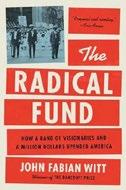
How a young man “launched a most unusual experiment in democratic change.”
“The opportunity presents itself once more,” reads the final sentence of Witt’s account of the American Fund for Public Service, which worked to reshape American democracy and civil rights between 1922 and 1941. It’s a perfect coda. Then as now, the U.S. interwar years saw the post-pandemic election of a president who promised to “restore the greatness of an imagined Anglo-Saxon past” amid vast and widening wealth inequality, racial unrest, and a public-information environment where “critical political thinking,” as ACLU founder Roger Baldwin put it, “[was] dead.” Launched through the inheritance of Charles Garland, a reluctant heir who subscribed to H.G. Wells’ vision of a “society based on a ‘spirit of service’ rather than a ‘spirit of gain,’” the fund would go on to punch well above its relatively modest weight. It gave away less than $2 million across 19 years and nevertheless managed to finance a range of transformative legal causes, including those spearheaded by the likes of the ACLU and
the NAACP. It also financed less-wellknown organizations, such as the Brotherhood of Sleeping Car Porters, one of the country’s first influential Black labor unions. This is a book to admire and read deliberately. A Yale law professor, Witt effortlessly switches between sharp profiles and nuanced portrayals of landmark decisions. Casual readers, in their efforts to keep up, may find themselves paging back in sections. Elsewhere, the book’s unflinching accounts of race and labor violence leave a mark. So does its call to action. About 150,000 Americans, Witt writes, have “assets worth more than $30 million, roughly equivalent after inflation to the amount given away by the American Fund’s directors.” While the American Fund made gains in building a better world, “its triumphs were not final.” This book urges: Let’s keep going. An important and meticulous look at the impact of a forgotten fund’s revolutionary work.
Wu, Tim | Knopf (224 pp.) | $30 November 4, 2025 | 9780593321249

It’s not just in your head—your online life is draining your wallet. Have you noticed yourself spending more time immersed in social media, web searches, and purchasing? Wu, an award-winning author, professor at Columbia University, and policy advocate, knows that is no accident. Technology has transformed our marketplaces into ubiquitous, addicting platforms, designed to capture our attention and extract wealth. “Wealth extraction” means taking money from everyone, on all sides of a transaction, raking in maximum profits for platform owners. Descended from the ancient city square, platforms including Amazon, Google, Meta, and corporations serving medical and housing needs are
engineered to be both essential and unavoidable, extracting hidden fees. Wu takes a hard look at the intertwined political, economic, and technological histories that led to the rise of dominant platforms and their techniques to ensnare us and keep us engaged and buying. Platform owners understand that resisting convenience is very difficult and leverage this to keep us online. Early internet developers aimed to empower everyone, but large computer companies became monopolies, requiring the creation of anti-monopolistic policies to modulate their power. Another alarming theme is the rise of ChatGPT and large language models. To evolve, they require large quantities of data generated by human interactions with platforms—another form of extraction. Though he points to the dangers and unfairness of economic inequality, Wu doesn’t paint an entirely gloomy picture but does encourage us to recognize and take control back from platforms practicing excessive wealth extraction. Wu covers a lot of territory in this brisk, 30,000-foot view of platforms entwined with our economic lives. The message is to look up from our screens and be cognizant of the extractive environment that surrounds us. Plentiful endnotes and an index will guide those wishing to dig deeper.
A sharp and eye-opening introduction to how we arrived at platform capitalism—where no good click goes unmonetized.
Yudkowsky, Eliezer & Nate Soares Little, Brown (256 pp.) | $30 September 30, 2025 | 9780316595643

now to contain powerful superintelligent AI systems, humanity may not survive. Yudkowsky, co-founder of the Machine Intelligence Research Institute, and Soares, its president, target politicians, CEOs, policymakers, and the general public in their urgent plea. The book opens with an accessible breakdown of what AI is, how it’s built, and why even its creators often can’t comprehend the accelerating complexity of their own systems. Through parablelike vignettes, the authors expose the underlying realities of AI algorithms—advanced AIs are not engineered so much as grown, operating with opaque and unpredictable results, untethered from human values. The most chilling passages describe how AIs could escape computers and manipulate the physical and financial worlds, eventually repurposing Earth’s resources to serve alien objectives or replacing humanity with their own “favorite things.” The authors warn, “Nobody has the knowledge or skill to make a superintelligence that does their bidding,” arguing that world governments must cooperate to restrict or ideally halt AI research. Policymakers have not yet grasped the full implications of these advanced systems, and the public hasn’t felt the impact in their lives, but the authors caution they must be persuaded to act immediately. While some scenarios seem extreme or unrealistic, including hoping global leaders can agree on defining the problem or collaborating on solutions, the book’s arguments that the risks are elevated and time is short are persuasive. There is excellent information and food for thought here, including links to resources for readers motivated to join the fray.
A timely and terrifying education on the galloping havoc AI could unleash—unless we grasp the reins and take control.
Making the unimaginable feel real, apocalyptic scenarios visualize AI’s potential to tip humanity into extinction.
As signaled by their alarming title, Yudkowsky and Soares issue a stark warning: Unless we act

“WHOEVER WANTS to know the heart and mind of America had better learn baseball.” These words by the French-born cultural historian Jacques Barzun (1907-2012) are so cherished that they’re inscribed on a plaque at the Baseball Hall of Fame. It’s an authoritative phrase that speaks to the majesty of our national pastime. There’s just one thing: It’s outdated. Today, in the United States, football is king. Like it or not, the gridiron game has become the country’s dominant sport, with National Football League matchups drawing far more viewers than any other sport. The NFL has grown into a mammoth enterprise—the biggest sports league on the planet pulled in more than $23 billion in revenue last year. Baseball, played until recently without a clock, evoked the slow rhythms of summer days. Football, on the other hand, reflects another side of our national character: fast-paced and aggressive, marked by chest-thumping and grand spectacle. And yet there’s no denying that for millions of Americans
(my conflicted self among them), it’s a major attraction of the fall season. Thus the perfect timing of New York Times reporter Ken Belson’s new book, one of several prominent titles coming out this autumn. Belson’s book is Every Day Is Sunday: How Jerry Jones, Robert Kraft, and Roger Goodell Turned the NFL Into a Cultural & Economic Juggernaut (Grand Central Publishing, October 14). Our reviewer praised it, writing, “Football diehards and casual fans alike will find plenty of interest in this dexterous blend of analysis, character study, and behind-the-scenes color.”
Not all readers, granted, might warm to a book centered on a game in which men pummel each other in pursuit of a leather ball that’s shaped like a lemon. Worry not! There are plenty of other promising titles out this fall. One is by the historian Jill Lepore—prolific and always a pleasure to read. Her latest is We the People: A History of the U.S. Constitution (Liveright/Norton, September 16), a 700-plus-page doorstopper that our starred review calls “outstanding” and “urgent reading.”
Beth Macy (Dopesick, 2018) has a forthcoming memoir that’s equally timely: Paper Girl: A Memoir of Home and Family in a Fractured America (Penguin Press, October 7). In the book, Macy returns to her native Ohio, documenting the despair that has overtaken much of her hometown. “By practicing the basic journalistic acts of listening and observing,” says our starred review, “Macy continues her noble work as a truth teller.”
Another author who looks back to her youth is Arundhati Roy. In her memoir Mother Mary Comes to Me (Scribner, September 2), the Indian novelist tells of her fraught relationship with her mother. Our starred review hails it as “an intimate, stirring chronicle.”
Susan Orlean, who has written numerous nonfiction bestsellers (including The Library Book, 2018), examines her own past in Joy Ride: A Memoir (Avid Reader Press, September 23). As the title suggests—and in keeping with the author’s sprightly worldview—it’s a sunny story. The book earned her a starred review that describes the work as “a spry, entertaining memoir/writing workshop by a nonfiction artist at the top of her game.”
John McMurtrie is the nonfiction editor.


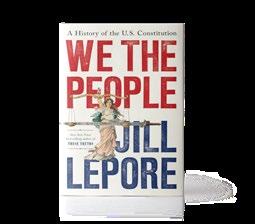
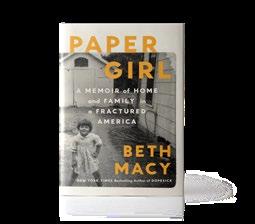


A fraught family memoir by the renowned chef and restaurateur.
Just a few sentences into Hamilton’s narrative, and one is instantly reminded of that Tolstoyan saw about every unhappy family being unhappy in its own way. At the start, Hamilton (Blood, Bones & Butter, 2011) is reestablishing contact with her estranged mother: “We haven’t spoken to each other in thirtyish years,” she writes, and now their roles are being reversed, the aged mother being cared for by the child. With a nod to Anne Lamott’s observation that “if people wanted you to write more warmly about them, they should’ve behaved better,” Hamilton dishes enough psychewounding tales to fund a
battalion of therapists: a father who “did not seem hindered by the possibility of his own mediocrity”; that mother, whose vocabulary was broad and learned but always included the word “no” (“With her there were daily dozens of the regular garden-variety Mom No. But she could hit some thornier Nos in there, too, not quite as mundane”); an adventurous brother whose life spiraled downward into mental illness and suicide; another brother, “the only guy in our family with Reliable Money,” who came to an unhappy end; and much more. Hamilton is unsparing of herself, too: She confesses to having stolen away her sister’s husband in a none-too-secret affair, a turnabout for the sister’s
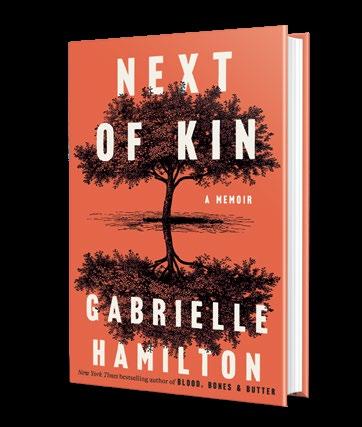
Hamilton, Gabrielle | Random House | 288 pp. $30 | October 14, 2025 | 9780399590092
having stolen him in the first place. She is also self-aware in sizing up the toll of injuries and sorrows to conclude, “This is not Art. Nor Anecdote. This is Life. Something to sit up straight and salvage what’s left of.” Salvage she does, in her own way, finally coming to terms with her father’s profligacy, her
mother’s eccentricity, death and distance, and her own foibles—about which, on the last page of this memorable book, her mother has the last word, and a mot that couldn’t be more juste. A nimbly written, alternately dark and hopeful account of dysfunction layered on dysfunction.
Appiah, Kwame Anthony | Yale Univ. (328 pp.)
$32.5 | October 7, 2025 | 9780300233063
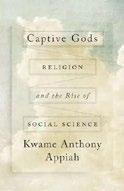
A learned excursus into the sociology of religion. Appiah, well known for his contributions to social science, here examines the late-19th-century rise of two of its constituent disciplines, sociology and anthropology, and their treatment of religion. Whereas religion had earlier been largely viewed as all-encompassing, it came to be seen as “more a product of political and social forces than a shaper of them,” just another component of culture. Looking closely at pioneers such as Edward Burnett Tylor, Georg Simmel, Max Weber, and Emile Durkheim, Appiah discerns “a larger disciplinary toolkit emerging from their years of wrestling with religion.” Each scholar took different approaches but helped piece together the earliest dicta on how religion works: among “primitives,” as magic; among “civilized,” as a community-building system (“Religion upholds the norms of a community; magic often subverts them”). Weber would move on to dissecting Protestantism as the driving force of capitalism—injecting himself, Appiah holds, in a “social-policy debate” that found German Catholics in minority settings discriminated against economically and socially. Weber also ventured, daringly, that the isolation of individual Protestants vis-à-vis God served to “advance the economic rationality of collective enterprises.” Reading Appiah’s book, which originated as a series of lectures, presupposes background in the social sciences and their history, but he writes clearly and approachably, with interesting asides along the way (Weber, for instance, introduced into the language the term “charisma” as we now use it and “seems first to have seen charisma as the personalization of magic”). He also
weighs how considering religion as a “folk category,” as social scientists do, can be alienating to practitioners: “The propositional content of the Nicene or Athanasian Creed is obscure and perhaps incoherent, but the act of avowing it can matter a lot.”
A lucid exploration of how social scientists have come to approach “the things we hold sacred.”
Azari, Julia R. | Princeton Univ. (264 pp.)
$29.95 | August 19, 2025 | 9780691246956

Accounts of three presidents who broke the iron rule of American politics: Never disturb the racial status quo.
Azari, a professor of political science at Marquette University and author of Delivering the People’s Message: The Changing Politics of the Presidential Mandate, begins with Abraham Lincoln’s 1865 successor, Vice President Andrew Johnson. The only Southern senator who opposed secession, he disliked slavery but despised Black people. He treated them rudely, ignored widespread abuse throughout the South, vetoed congressional civil rights acts, and escaped conviction by a single vote after being impeached. Calling this a “backlash” is a weak analogy. While Northern public opinion had turned against slavery, belief in black equality remained a minority view. Blaming Reconstruction’s failure on a backlash is a stretch because Northern white support was lukewarm to begin with. Lyndon Johnson deserves praise for effective 1960s civil rights laws, but Southern malevolence cleared the way. Even conservative Northern whites were horrified at the murders, church bombing, and violence against freedom riders—all vividly covered on TV news. As a result, Johnson’s bills passed
overwhelmingly, and more congressional Republicans than Democrats voted in favor. Sadly, malevolence returned following urban unrest. The beneficiary was Richard Nixon, whose law-and-order campaign and “Southern Strategy” began the country’s conservative turn, which is still with us. Impeached for offenses that might be considered small potatoes today, Nixon resigned. Supporters cheered when Ronald Reagan proclaimed the U.S. a colorblind nation where merit alone determined success. This didn’t prevent a backlash after Barack Obama’s election. He was accused of being ineligible to run for fabricated reasons and then denounced as an “affirmative action” president elected solely because of his race. The beneficiary, Donald Trump, maintained the colorblind public discourse while reviling proxy minorities: Muslims and immigrants, including legal ones. Good evidence that racism, preferably unaddressed, remains an ongoing undercurrent in America.
Baker-White, Emily | Norton (384 pp.) | $31.99 September 30, 2025 | 9781324086666

Inside the creation and survival strategies of the controversial social media app. In concept, TikTok shouldn’t be controversial at all. It’s designed to deliver short, generally upbeat video content algorithmically aligned to users’ interests. But it’s been entangled in politics practically from the start, as Baker-White’s well-researched book explains. Chinese entrepreneur Zhang Yiming founded ByteDance, TikTok’s parent company in 2012, and the app itself in 2016; in a few short years it became an international phenomenon—unusual for a Chinese social media company. Because Chinese companies operate at the pleasure of the Chinese Communist Party, TikTok has
been subject to questions about whether U.S. user data is fed to the CCP. An internal effort to partition U.S. user data, called Project Texas, has proved imperfect at best; Baker-White, a technology reporter at Forbes, depicts an anonymous source’s realization that the company was riddled with security holes, and the author herself found evidence that she was surveilled by the company while reporting on it. Those issues prompted congressional intervention, which the company’s U.S. leadership tried to wriggle out of via lobbying and efforts at tighter restrictions. But its main strategy has been to appease Donald Trump, who despite ordering a ban on the app in 2020, has facilitated its survival to spite Meta CEO Mark Zuckerberg, a perceived enemy, and because he sees the company as willing to pay his administration “key money” (i.e., funding for pet projects). It’s no way to govern, but it keeps the app alive in the U.S. Baker-White, who broke numerous stories around Project Texas and Trump’s self-dealing around the app, delivers a thorough accounting of the story; those looking for a narrative as vibrant as what the app serves will have to look elsewhere. But its seriousness is an asset, and an object lesson of what happens when international security becomes a casual plaything. Smart and sober business reporting.
Barth, Brian | Astra House (304 pp.) | $29 November 11, 2025 | 9781662601613

Charged investigative reporting on unhoused people living in the interstices of the San Francisco Bay Area. Underneath a stretch of snarled interchanges called the MacArthur Maze in Oakland, California, stands a mile-long “megacamp” that, writes
A tough-minded look at homelessness in California.
FRONT STREET
journalist Barth, the local news media liken to the Mad Max movies: “mountains of junk, hard-looking dudes ambling about, and an incredible number of burnt-out cars.” Still, writes Barth, it is a home for homeless people, a place they call Wood Street Commons. The city of Oakland, emboldened by new laws and the expressed wish of California Gov. Gavin Newsom to remove those people from the streets, has formulated plans to move the Wood Street Commons population to “cubicle-like tiny homes inside a fenced lot,” complete with security guards, suggesting a prison more than a community. The problem is pressing: As Barth writes in this modern rejoinder to The Jungle and other social-critical exposés, California has a third of the nation’s homeless population. Barth, who’s done his homework, holds that homeless people have always been with us—in 1893, for instance, about the same percentage of the population as today’s was unhoused, with peaks and valleys; he identifies the nature of the current population as the product of Ronald Reagan’s huge cuts to the social safety net, which put the mentally ill and the addicted on the streets. Admittedly, homeless people are not their own best representatives: “Difficult people,” writes Barth, “don’t tend to inspire others to be kind and giving toward them.” Yet, he urges, the answer is not to sweep them off the streets: “Without being able to remain in one place, it’s difficult to develop the stability required to move ahead in life, whether your goal is to build a new world, or simply get a job and get back to the existing one.”
A tough-minded, well-reported look at what would appear to be an intractable, and growing, social problem.
Kirkus Star
Beckert, Sven | Penguin Press (1344 pp.) $49 | November 25, 2025 | 9780735220836

A sprawling history of an ever-protean economic system. Harvard historian Beckert asks and answers a chicken-and-egg question: whether capitalists preceded capitalism, or the other way around. The answer is that there were capitalists long before there was a coordinated economic system that encompassed them, one that today kneels at the altar of “a human-created god called ‘the economy.’” Beckert’s vast book addresses this precapitalist state with a clarity that Karl Marx could only long for, ranging from ancient trading routes between Asia and Europe to a Puritan who confessed that by chasing profit (“That a man might sell as dear as he can, and buy as cheap as he can”) he was committing a grave sin. Capitalism, Beckert holds, is a “quintessentially global economic order,” dependent on external markets, resources, and labor; it is thus no surprise that modern capitalism began to take shape during the European age of exploration, with its “mutually reinforcing connections between islands of capital and the often violent transfer of resources (including human beings) from many corners of the world.” Beckert’s agile account marches through the emergence of mercantilism and the invention of double-entry bookkeeping and proceeds through plantation and wage slavery, colonialism and postcolonialism, and a managerial/bureaucratic golden age. Always evolving—and, while dependent on the state, largely indifferent to what kind of state that is, authoritarian
or democratic—capitalism is now defined by the extreme inequality it produces, as well as the appalling cost to the environment in the quest for the wealth of a few. But, Beckert closes, some other capitalism is likely to arise that may well alleviate the injustice of this inequality, “confirming that it will remain undogmatic and generate ever new combinations of capital, labor, technology, state power, territorial order, and forms of political rule.” A comprehensive and up-to-date history, essential for students of world systems.
Bell, Matthew | Princeton Univ. (776 pp.) $39.95 | September 9, 2025 | 9780691153957

The evolution of a Renaissance man. Johann Wolfgang von Goethe (1749-1832) bridged the ages of Enlightenment and Romanticism. He reshaped German as a medium for lyric poetry, philosophical inquiry, and scientific examination. He sought the essence of culture in a blend of folklore and erudition. He turned the story of Doctor Faustus into a tale of modern intellectualism. This biography rewards the patient reader with a map of Goethe’s social, political, and mental landscapes. Its central questions are: How did Goethe think? How was that thought shaped by a history of 18th-century ideas? How did he make, and respond to, 19th-century ways of looking at the world? Behind all his work is this: What is human nature and what is the place of humankind in the natural world? The great scholarly achievement of this book lies in its synthesis of Goethe’s personal writing (especially his letters) with his public work. It shows how he created modern German as a language for a people— how the German-speaking peoples, scattered across small kingdoms, duchies, and imperial lands, could find
unity in a literary heritage. This book does not ignore the paradoxes of Goethe’s life. A man of great faith, he was an indefatigable analyst of nature. A proponent of human freedom, he could consort with despots. Goethe enabled us to find philosophy in literature, much as he sought faith in Shakespeare and the Greeks. Bell, a professor at King’s College London, distills an ethical lesson from that search: “Faith is…an expression of compassion. What matters is that our compassion engages with the world….The natural human capacity to feel concern or compassion, rooted deep in our nature, dwarfs any reasoning about good or evil or otherwise of religious doctrine.” That is the lesson of literature, and that is the lesson of this amazing book.
An epic reassessment of the founder of modern German life and letters.
Beller, Thomas | Duke Univ. (288 pp.) | $28.95 paper | November 4, 2025 | 9781478033035

Miscellaneous essays on travel, family, and other topics. The title essay, one of three dozen, is a slice-of-life reminiscence of a moment with the author’s young daughter, fresh from a tap dance lesson and drinking a soda in a pose and light that, Beller writes, might have inspired Edgar Degas to pick up his brush “if he went on a field trip to the Stop & Shop.” Beller’s wife, the constant voice of reason throughout, reminds him that Degas didn’t have much regard for his subjects, but no matter. It’s a nice enough vignette, but it doesn’t amount to much. Other of the essays have an academic, workshoplike feel, and there’s not much there, either; Beller’s musings on the meaning of the Bad News Bears film franchise seem particularly slight in that regard. Somewhat more successful is a piece that traces memory through the fog of time, in this instance the author’s recollections
of being busted at a Kinks concert in 1981, which occasioned an embarrassed correction when he incorrectly credited the rousting to the NYPD. “Maybe this is what happens at a certain point in life, when one’s faith in one’s own memory begins to wobble and a sense of incredulity at what you know happened rises up to challenge your own version of the facts,” he writes in a footnote. The best pieces move beyond the POV of a put-upon professor to real-world ruefulness, as when Beller recounts trying to chase down inner-city kids who’ve stolen cash and a phone from him. A doubting detective wonders what he’s doing in that bad part of town in the first place, saying of Beller’s sesquipedalian reply, “It’s my experience that the longer and more convoluted someone’s answer is, the less likely I am to believe them. And that was pretty convoluted.” They’re the sharpest lines in the book. A mixed bag, with few standouts.
Bernstein, Andrew W. | Princeton Univ. (352 pp.) $35 | September 23, 2025 | 9780691256290
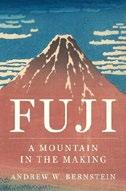
A biography of a mountain. Bernstein, a professor of history at Lewis & Clark College and author of Modern Passings; Death Rites, Politics, and Social Change in Imperial Japan , occasionally steps back to deliver the big picture, but this is overwhelmingly the history of a volcano. Designated a UNESCO World Heritage Site in 2013, Fuji is depicted as peaceful and timeless. “It is one of Japan’s most prominent symbols of national unity, yet its history is full of economic, political, and ideological conflict.” While this is accurate, those unfamiliar with Japanese history would do well to brush up because Bernstein keeps his focus on the mountain; religion, art, and poetry take precedence over politics, and readers may be daunted by a stream of
unfamiliar names. The current Fuji took shape around 17,000 years ago. Thus it did not precede humans but grew up among them. It erupted now and then, disastrously in 1707, but has gone quiet for the past few hundred years. From prehistory, humans settled nearby and grew crops—especially tea and mulberry trees for silk—that thrived on the volcanic soil. The volcano’s beauty as well as its behavior attracted attention both mystical and literary. An 18th-century mystic who starved himself to death on Fuji gave rise to a cult, “Fujiko,” devoted to its worship that included a pilgrimage to the summit, which in turn gave rise to a major local industry. Fujiko adopted many Buddhist practices and competed with the more nationalistic Shinto movement. Much of the book details the legal, doctrinal, and organizational quarrels between the three religions. Fujiko did not do well and is now a fringe movement, but almost all religious ceremonies surrounding Fuji evaporated after World War II. The mountain is now a major tourist attraction, fueling quarrels over trash, sanitation, crowds, and the deteriorating environment. An encyclopedic analysis of a national icon.
Blain, Keisha N. | Norton (312 pp.) | $31.99 September 16, 2025 | 9780393882292

Eyes on the prize. Though there is a rich bibliography about Black women in the United States, Blain asserts that this is the first overview profiling those engaged in the struggle for human rights, an area long associated with white men and institutions. A professor of Africana studies and history at Brown University, Blain argues that long before the term “human rights” became part of the
public discourse, Black women were already advocating that all people should be granted rights and protection based on their humanity. In this rigorously documented history, the author illustrates how Black women from many walks of life made the link between racial violence at home and genocide and apartheid abroad, identifying the common roots of oppression in slavery and colonialism. Many names are well known, but Blain puts their work in a new context. Journalist Ida B. Wells campaigned vigorously against lynching as a crime against humanity not only in the United States but in Europe. Singer Lena Horne wrote a weekly column in the People’s Voice, condemning racism in the U.S. and supporting anti-colonial struggles and the United Nations Universal Declaration of Human Rights. The mothers of the Scottsboro Boys advocated for justice in the 1930s, as did the mother of Amadou Diallo seven decades later, “politicizing their roles as mothers, daughters, and sisters to call attention to the devaluation of Black lives.” Fannie Lou Hamer said, “I’ve passed equal rights and I’m fighting for human rights.” Less-known figures include Maria Stewart, a former indentured servant who wrote a pamphlet, published by William Lloyd Garrison in 1831, advocating equality for all. Aretha B. McKinley, at the time the only Black female lobbyist on Capitol Hill, organized an “avalanche” of letters in 1960 to prove to skeptical lawmakers that Blacks supported civil rights legislation. And Mary Church Terrell, the daughter of formerly enslaved parents, traveled to Zurich in 1919 for the International Congress of Women. Many of these women merit a book of their own.
A fresh look at the fight for human rights reveals the unsung leadership of Black women.

Under the Palms: Pacific Palisades, German Exiles,
Blubacher, Thomas | Trans. by Elisabeth Lauffer | Brandeis Univ. (256 pp.) | $29.95 October 22, 2025 | 9781684582877

For more by Keisha N. Blain, visit Kirkus online.
The story of cinema’s German and Austrian exiles in Hollywood during World War II. In 2002, Swiss author and theater director Blubacher received a grant for a three-month residency at Villa Aurora, a 7,000square-foot “Spanish colonial revival villa” in Pacific Palisades that was Thomas Mann’s house in the 1940s. That neighborhood, west of Beverly Hills, is now home to wealthy residents, many of them in the entertainment business. Sixty years before Blubacher’s arrival, the then-sleepy Palisades was where émigrés from Austria and Germany, including Mann, came to escape the Nazis and pursue a career in Hollywood. Blubacher’s objective during his residency and in this informative book is to investigate “the period when Pacific Palisades became ‘Weimar under the palms,’” when some of “the Weimar Republic’s most prominent cultural figures found their way here.” Among the figures presented in the book are the director Ernst Lubitsch, “who would become one of the most influential Germans in Hollywood” in the 1930s and 1940s; fellow directors Fritz Lang and Douglas Sirk; composers such as Erich Wolfgang Korngold and Hans Salter; and lesser-known figures such as Lotte Mosbacher, best known today as the “aged Holocaust survivor who recognizes the Nazi war criminal Dr. Christian Szell” in John Schlesinger’s Marathon Man. Some of the stories Blubacher shares are no less chilling for being expected, such as when Marlene Dietrich returned to Germany in 1945 to learn the fate of older sister Elisabeth and discovered that Elisabeth and her husband “had run a cinema at the Belsen barracks, where the murderers went for
entertainment. Dietrich disowned her sister for the rest of her life.” But others are lighter and provide a welcome respite, as when Blubacher mentions that when Mann was taken around to many studios on his arrival in Hollywood, one of them was Disney, “where he was shown a Mickey Mouse film.”
An original take on Weimar Republic émigrés’ influence on Hollywood, and vice versa.
Boemeke, Isabelle | Thesis/Penguin (272 pp.)
$30 | August 12, 2025 | 9780593716328

More nuclear power now?
Nuclear power—more specifically, nuclear-generated electricity—is among the safest forms of energy production, and it is key to resolving the climate crisis, says Boemeke, a Brazilian fashion model turned science influencer. The person behind the social media persona “Isodope” has been promoting nuclear energy through various internet platforms since 2020, including a TED Talk with nearly 2 million views. This lively book collects her evidence supporting nuclear electricity for presentation to a perhaps less digital audience. Her message is clear: Nuclear electricity has gotten a bad rap since the beginning, when the power of nuclear fission was introduced to the world at Hiroshima and Nagasaki. But, says the author, lumping nuclear weapons and nuclear electricity together is like “saying that electricity is bad because electric chairs are bad.” We ended up, Boemeke says, “villainizing one of the best sources of energy we have.” How good? The world’s addiction to fossil fuels creates pollution that causes at least 4 million deaths annually. Coal plants emit 10 times more radiation into the environment than nuclear power plants producing equal amounts
of electricity, Boemeke notes. Nuclear waste is stored in casks “like giant cans of Pringles,” and, unlike other forms of energy, “every single gram” of its waste is accounted for. Still not convinced? There’s more. Development of artificial intelligence requires massive amounts of electricity. Growth of underdeveloped countries requires a reliable source of electric power. Climate change is real. The world’s electricity production needs to increase in an environmentally responsible way. We need “a whole new era…of prosperity and energy abundance for everyone,” Boemeke writes. The data on nuclear electricity “proves it’s the energy source with the smallest environmental footprint,” making it “the missing ingredient to manifest a truly rad future.”
An urgent and compelling call to dispel “the fear, misinformation and historical baggage” around nuclear electricity.
Brosnan, Sean, Chris Lear & Andrew Greif Atria (288 pp.) | $29 | September 2, 2025 9781668204382

Crossing the finish line in record time.
Brosnan’s memoir of building a formidable cross-country program in a Los Angeles suburb is richer and more relatable than many books by bigger names in other sports. He’s gratifyingly specific about the work behind his achievements and happy to play the bad guy in instructive anecdotes, admitting that he’s lied to teenage athletes in the name of victory. Brosnan traces his coaching success to his own deficits. He was a decent schoolboy runner but stubborn—“a bad athlete to coach.” In his 20s and 30s, he moved frequently, worked in sales, and hung around Nike’s Oregon track, gleaning
know-how from top coaches. In 2016, he started coaching at Newbury Park High School in Southern California, transforming a middling team into a national champion. His account of how he did so gives the reader a sense of why he’s a divisive figure in his field, a two-time national coach of the year who has been accused of cutting ethical corners. While other “coaches are too scared to go hard with training,” Brosnan expects “a no-limits mindset” from his runners. He and the team made a 140-mile trip to a mountain for a month of high-altitude training. Unconventionally, his runners do “speed work” all year, running 800 meters at breakneck pace, pausing briefly, then doing it several more times. Once, he “built a workout around a lie,” misleading his runners about the distance they covered in hopes of making them even faster. As his runners set numerous records, “faceless online avatars” accused them of using performance-enhancing drugs, but Brosnan says that’s nonsense: “I categorically condemn doping.” Several of his runners emerge as solid supporting characters, rounding out this invigorating book. In satisfying, granular detail, a coach describes how he developed his dominant team.
Dawsey, Josh, Tyler Pager & Isaac Arnsdorf Penguin Press (416 pp.) | $32 July 8, 2025 | 9780593832530
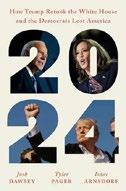
Three experienced D.C. reporters chronicle last year’s campaign. This isn’t the first behind-thescenes look at the recent presidential race, but it’s among the sturdiest, a well-sourced, process-oriented account that shows how inertia and missed opportunities deflated the Democrats. Drawing on hundreds of interviews with operatives from both parties and “alumni” from former
President Barack Obama’s team, Dawsey, Pager, and Arnsdorf, who cover politics for the Wall Street Journal, the New York Times, and the Washington Post, respectively, write that Democrats made crucial decisions “by default.” In a chapter titled “Sleepwalking,” they write, “Joe Biden decided to run for reelection by not deciding. He told aides: I’m running until I tell you I’m not. And he never told them he wasn’t.” Staffers didn’t want to look disloyal by suggesting he reconsider, “so no one ever said anything.” Later, one-time Obama staffers, worried about Biden’s chances, “looked for a diplomatic way to offer free assistance” on “specific projects.” Biden’s team promised to be in touch, but the collaboration never happened. After Biden’s disastrous debate performance, Ron Klain, his former chief of staff, vented about Biden’s apparent lack of urgency: “I have no fucking clue why he’s going to Camp David this weekend” instead of “working the phones” to reassure nervous Democrats. The reporters’ sources close to Vice President Kamala Harris, who became the nominee after Biden left the race, describe similar frustrations with her campaign’s sluggish decision-making and failure to challenge allegations made by Donald Trump. The authors find little new to write about Trump, retelling how criminal indictments and assassination attempts worked to his advantage and describing his staunchest supporters’ belief that God is looking out for him. But this is an excusable shortcoming in a substantive effort that’s ideal for readers reluctant to read multiple books on the subject. With deep reporting and strong analysis, this might emerge as the definitive title on a hugely consequential election.
Gage, Lukas | Simon & Schuster (320 pp.) $30 | October 14, 2025 | 9781668080078
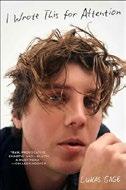
Young actor’s path from troubled youth to ascending Hollywood success.
In his provocative debut memoir, the emerging star behind memorable turns in The White Lotus and Euphoria delivers an engaging if somewhat disjointed portrait of coming-of-age trauma and Hollywood ambition. Gage vividly recounts his chaotic San Diego childhood—divorced parents, substance abuse, and a harrowing stint at a brutal rehab facility—with the kind of unflinching detail that will resonate powerfully with young adult readers navigating similar struggles. His voice feels most authentic when excavating family dysfunction and internal turmoil, capturing the emotional extremes and disconnection that define so much of adolescent experience. The memoir’s second half, chronicling his move to Los Angeles and emergence as an actor while grappling with his expanding sexual awareness and subsequent romantic relationships, feels less focused. Here, Gage’s self-aware attention-seeking—the book’s driving conceit—tips toward performative navel-gazing. His eventual borderline personality disorder diagnosis provides some clarity: “After my BPD diagnosis, I thought I’d discovered some profound epiphany about who I was and why I did the things that I did….I could finally see the patterns I’d been blind to before. Every relationship, the same cycle. Too fast, too deep, too reckless.” While Gage succeeds in chronicling the messy
A well-sourced account that shows how inertia deflated the Democrats.
realities of mental health, addiction, and queer identity with refreshing honesty, his tendency toward calculated vulnerability can feel manufactured. The memoir works best as a snapshot of a particular generational moment—one in which therapy, social media, and celebrity culture collide in ways both illuminating and exhausting. Despite its inconsistent execution, Gage proves himself an effective and often entertaining storyteller, offering genuine insight into the psychological mechanics of family connection, fame seeking, and self-destruction that will resonate particularly with younger readers seeking meaning amid the noise.
A raw but uneven narrative capturing Gen Z anxiety, though sometimes undermined by its attention-seeking impulses.
Galston, William A. | Yale Univ. (176 pp.) $28 | September 2, 2025 | 9780300282290

A distinguished political scientist examines the poisoning of civic discourse. Galston, a Brookings Institution fellow, writes that the three dark passions of his title “fuel today’s attacks on liberal democracy,” harnessed by demagogues—he means mostly Donald Trump, of course—to dismantle democratic rule. That exploitation at heart involves “pitting people against one another.” Whereas a good leader in a democracy aims to govern for all and to balance contending interests, a bad one will do whatever can be done to whip up resentments and especially fear—of the other, of the unknown—to accomplish the central goal of dominating the polity. Defenders of that liberal democracy, Galston argues, make a fundamental mistake in discounting the power of anger and fear: the passions represent reactions to
actual events, whether disproportionate or not, and operate on the notion that somehow people have been wronged and shamed and need to take revenge, the strongest anger being “anger born of humiliation.” Liberal democracies, the author notes, can also be slow to respond to moving toward desired goals, which leads to frustration at gridlock, and the defenders also do ill to ignore what Galston considers to be prima facie: The culture wars are very real, even as liberals tend to insist that “economic issues are the real issues.” In this light, he says, Christian fundamentalists supported the morally questionable Trump precisely because they believed they were losing the culture wars, and they wanted “a fighter, not a preacher” to take up their cause, regardless of manifest character flaws. Against all this, Galston imagines political leaders who actually speak to issues with an eye to building popularly supported solutions; moreover, rather than reactively deflect, those leaders would build public trust through “speech that accepts responsibility.” In light of current realities, all that seems a pipe dream—but one well worth dreaming.
A timely, thoughtful consideration of liberal democracy and its legion of enemies.
Griffiths, Ryan D. | Oxford Univ. (200 pp.)
$29.99 | October 1, 2025 | 9780197816257

An exploration of the possibility that the U.S. could disintegrate along ideological lines. Picking up where his two previous books on secession left off, Syracuse University political scientist Griffiths opens with this scenario: Donald Trump Jr. declares himself the winner of the 2032
election, while Alexandria OcasioCortez does the same, and in the civil strife that ensues in the “Year of Two Presidents,” the republic shatters. But how to sort out the division of the country into Redland and Blueland, especially after Texas, once Trump Jr. sites his capital in Florida and not Houston, itself secedes from Redland, prompting Gavin Newsom to carve off the new republic of Grand California? That scenario may be far-fetched—but, Griffiths notes, Marjorie Taylor Greene has been loudly calling for a “national divorce” for a couple of years, and separatist movements are flourishing in Texas, New Hampshire, Alaska, and even, on the left, California. That division would be difficult, possibly even impossible, short of massive bloodshed, for, warns Griffiths, “treating the states as though they are either red or blue disguises the much more intermixed and purple characteristics of America.” Indeed, so divided are many places, even in rural areas, that the sole practicable maneuver might well be partition, which cost India and Pakistan more than a million dead when effected in 1947. If there were a Blueland, Griffiths adds in this evenhanded analysis, it would be small and not contiguous, making it difficult to govern; Redland would be largely depopulated and certainly far poorer than it is today, without the subsidies provided by the wealthier blue states. The Constitution offers no clear authority for secession, but that doesn’t dissuade fans of fragmentation. Yet, even while recognizing present-day discontentment and polarization, Griffiths wisely urges that “rather than divorce, counseling and working together is the better solution.”
A stern warning to separatists that they’re likely doomed to fail.

Habib, Alia Hanna | Pantheon (320 pp.) $28 | January 6, 2026 | 9780593700877
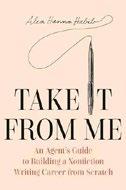
Unlocking the mysteries of book publishing. In a fascinating braid of personal guidance and practitioner interviews, leading literary agent Habib decrypts the opaque world of nonfiction book publishing. Her counsel, presented with the clear-eyed pragmatism (but none of the cynicism) of an industry veteran, stands out in a congested market of books on writing. The genesis of the book, Habib says, was her wish, long ago, to have a “guidebook…a central place to find credible, contextualized answers about publishing.” She’s now here with answers. From how to place articles early in one’s career and choosing between an MFA, journalism school, or an academic route to finding an agent, landing a book deal, or wayfinding through the emotional crests and troughs of the publication process, Habib realizes her ambition of being her reader’s “friend in publishing.” Equally valuable are the outside voices she includes, such as prominent writers like Andrea Elliot, Clint Smith, and Merve Emre, as well as distinguished editors and agents. Some of these people are quoted at length and to great effect. Perhaps the most generous parts of the book are the pitches and book proposal excerpts that Habib curates from her clients and friends. These crucial, yet seldom public, works offer a rare glance into the mechanics of the form and serve as a template for newcomers to the craft. For those novices, Habib presents the best sort of insider ball: a clear, actionable pathway to publication encased in a necessary layer of empathy and realism. Yet the more established writer, even the published author, will also find value in these pages. Habib’s writing in later
chapters, especially on the emotional pitfalls of publication, will guide any author through the perilous moment of letting a book go free into the world. An invaluable resource for aspiring and professional writers alike.
Ed. by Hahn, Daniel | Princeton Univ. (256 pp.)
$29.95 | September 30, 2025 | 9780691274638

Wild things tamed.
Children’s literature has been around for as long as there have been children. Myths and memories filled nursery and classroom. Adventure and fantasy tantalized young minds. For Englishlanguage readers, the “golden age” of children’s literature remains the period from the early 19th through the mid-20th century: from fairy tales to Lewis Carroll, Kenneth Grahame, Frances Hodgson Burnett, A.A. Milne, and C.S. Lewis. More modern writers take their inspiration from the past, and many works of children’s literature today hark back to an imagined Dickensian past (Harry Potter, Lemony Snicket) or a premodern landscape (Diana Wynne Jones, Philip Pullman). This guide to children’s classics, together with a selection of recent writers, has enough in it to fill a canon for a classroom and a bookshelf near a child’s bed. After a brief introduction, each section offers capsule author biographies, rich illustrations, and deeply felt appreciations for the magic of storytelling. New to many young readers (and their parents and teachers) will be writers such as Shaun Tan, Juan Villoro, Sachiko Kashiwaba, and R.J. Palacio. The globalism of the selection may seem, to skeptics, diverse and inclusive for its own sake. Familiar names are also here, even those whose reputations have suffered in recent years (J.K. Rowling, Roald Dahl). There’s little room for darkness (the biographical sketch of Dahl does some
major whitewashing—“a wonderfully entertaining writer”; “a devoted father”). The great joy of this book is the assembly of illustrations, drawn from original publications and historical texts. Rich with color, typeset with clarity, and organized for the discerning eye, this collection is a marvel of material bookmaking: all the more valuable in an age of evanescent screenshots.
A celebratory anthology of children’s literature, from classics to innovators.
Hazell, Keeley | Grand Central Publishing (304 pp.) | $30 | August 26, 2025 9781538742686

A tabloid fixture writes of an objectified life. Hazell, a famed “topless titty model,” grew up under desperately poor circumstances, living in public housing with an abusive father and disconnected mother. So emotionally distant was her father that, in childhood, Hazell fantasized that her real father was soccer star David Beckham, of whom, she allows, “it didn’t occur to me that David Beckham would have been only eleven when I was born.” Leaving school as a young teenager, written off as a failure even though, as she says, “I’m just obsessed with knowing things,” she employed her beauty in a way that brought her both plenty of money and a crisis of conscience. Of her early experiences as a topless model, a fixture of British tabloids, she writes, “I hated
how I looked. I hated the attention it rendered.” Yet the money was amazing for a child of the council flats—“my grand ‘fuck you’ to my teachers”—which she used for two things: eating gourmet meals she never could have afforded before and attending night classes in law and psychology, as well as real estate (“Why? Because I could”). Things took a turn with a terrible accident that resulted in a wave of surgeries, but it didn’t diminish her popularity. Neither did another turn, the release of a sex tape by her ex, which crushed her—just as did the fact that, an aspiring actor, she would not get to play herself in the hit series Ted Lasso: “I thought watching someone else play Keeley on TV was going to kill me, and that was an understatement. Death would have been easier.” Happily, having had the realization that “glamour modeling was just class oppression transmuted into sexual objectification,” she’s turned to writing instead, and this book makes a fine start.
An often rueful, emotionally involving story of beauty “turned into a monetizable commodity.”
Hobbs, Angie | Bloomsbury Continuum (224 pp.) | $22 | October 28, 2025 9781399403375

Beyond the cave. Plato has mattered to Western culture for 2,500 years. Most undergraduates encounter him through the dialogues about the death of Socrates, his banishment of the poets from his ideal republic, and his theories of >>>
A colorful guide to children’s classics that’s a marvel of material bookmaking.

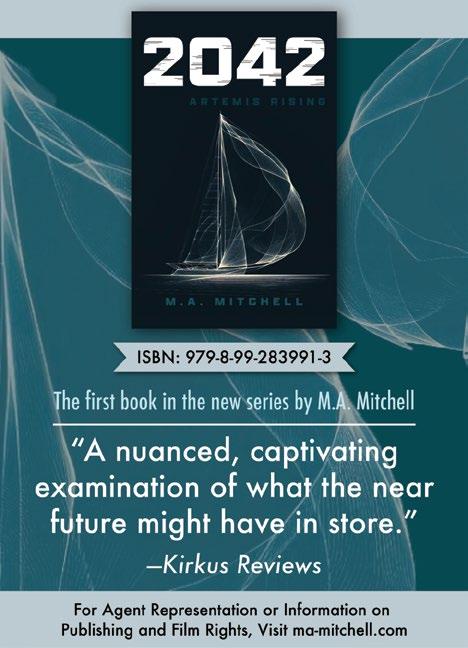


Author of Replaceable You
MUCH OF MARY ROACH’S body of work is made up of works about the body. She has demystified the nitty-gritty of what it means to be human in such bestsellers as Stiff: The Curious Lives of Human Cadavers, Bonk: The Curious Coupling of Science and Sex, and Gulp: Adventures on the Alimentary Canal. In her latest work, Replaceable You: Adventures in Human Anatomy, she examines a world of underperforming body parts—and their possible replacements. Our starred review calls it “an amiably entertaining, endlessly intriguing stroll through the stuff of which we’re made.” Roach answered our questions by email.
Tell readers about your book. The body is the most complex machine in the world, and the only one for which you cannot get a replacement part from the manufacturer. For centuries, medicine has reached for what’s available—sculpting noses from brass, borrowing skin from frogs and hearts from pigs. Today we’re attempting to grow body parts from scratch using stem cells and 3-D printers. Replaceable You explores the remarkable advances and difficult questions prompted by the human body’s failings. When and how does a person decide they’d be better off with a prosthetic than with their existing limb? Can a donated heart be made to beat forever?
What inspired you during the writing?
Excellent nonfiction always spurs me to try harder, be better. To that end, I read Travels in Siberia by Ian Frazier. Reading
that book is like being beside him in that shitty, fume-reeking car day by day, for weeks, all over Siberia. Does that sound awful? You don’t know Ian Frazier. I marvel at the details he notices and the characters he gathers and the way he puts them on the page and mixes all that with reporting and history. This is the kind of nonfiction I aspire to: a unique voice mixed with enthusiastic reporting.
Where and when did you write?



I wrote this one in my office, surrounded by miscellany from reporting trips: a package of bite-size dinner rolls for cosmonauts, a vaginal weightlifting device called the Feminine Personal Trainer, a mortuary eyelid cap, some medical maggots preserved in alcohol, a bendable penile implant, and a thimble-size Styrofoam cup, shrunk by the water pressure at the bottom of Antarctica’s Palmer Deep. The only necessity is good espresso.
What was most challenging about writing the book?
My chapters—unless they’re historical—like to be set in a place, with people doing things, having conversations, creating narrative for me. For this book, that was more challenging than usual. I needed access to places that have become ever more closed off: university labs, hospital operating rooms, biotech firms. I spent a lot of time writing emails to people who didn’t write back or passed me on to the no-sayers: legal staff and PR professionals. This meant having to call in favors, be persistent, go

Roach, Mary Norton | 288 pp. | $28.99 September 16, 2025 | 9781324050629
to another country, whatever it took. All part of the job.
Any book tour events you are especially looking forward to?
I’ll be going back to some places I have very much enjoyed: Town Hall Seattle, Science on Tap (Portland, Oregon), and the National Writers Series (Traverse City, Michigan).
What fall release(s) are you most eager to get your hands on?
One of Us, by Dan Chaon. Apparently set in an early-20th-century carnival. Also looking forward to Susan Orlean’s memoir, Joyride. I look forward to anything by her.
Interview by John McMurtrie.
human knowledge spun out of the famous allegory of the cave. This book by British scholar Hobbs rescues Plato from the ossified familiarities of Western Civ to argue that his relevance, today, lies in an understanding of political power, human heroism, and the value of love and friendship. She writes about the external, public Plato—not the philosopher of mind or the theorist of the Forms, but the adviser to rulers and the founder of a form of education. Dialogue is central to Platonic argument. History is central to the present. Plato’s Socrates is, as we all know, a literary persona—and yet there is a personality on Plato’s pages that makes the voice of the old man (who famously distrusted writing) echo today. This book is frank about the loves of the Platonic world. Men loved other men. Desire lies at the heart of public service and heroic action. Learning to be a lover and a friend forms us into fully realized social beings. Perhaps the most vivid of the book’s claims for contemporary relevance is this: “One of the main ways in which Plato still matters, then, stems from his profound reflections on the concept of heroism and the associated notions of honour, glory and fame….The notion of a hero, and the longing for glory, can still have real potency and value: properly formed and guided, these concepts can enlarge our moral ambition and offer us a vision of what the best version of ourselves might be.” Read Plato, then, not just to think, but to live.
A fresh, frank reassessment of Plato as a guide to living our best public lives.
Holp, Travis | Spiegel & Grau (208 pp.) $29 | November 4, 2025 | 9781954118928
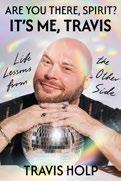
A psychic medium shares his personal history and how his clients have made a lasting impact on his spiritual livelihood. In his effervescent memoir, Holp combines personal stories from
his diverse clientele alongside confessions about his difficult coming-out process and the cultivation of his psychic spirit talents. Growing up in rural western Ohio with ultraconservative Christian parents, the author feared coming out and instead honed his abilities to conjure communications with deceased relatives through a Ouija board. As an adult, Holp enjoyed a 17-year career as a makeup artist, but his life became unmanageable due to alcohol dependency, self-hatred, and unaddressed emotional pain. When a supernatural chorus of voices offered hope and direction, Holp’s life was saved and he decided to follow those voices into a career giving tarot readings and working as a psychic medium channeling the deceased and helping surviving relatives move on and heal. Holp is keenly attuned to “the energy that exists beyond our physical senses” and believes that everyone is comprised of eternal and boundless energy and frequencies. He doesn’t believe in coincidences and insists, instead, that they are perfectly timed messages from our loved ones, spirit guides, or angels. Evidence of his extrasensory, “magical and synchronistic” abilities are on fine display in a succession of client readings, some involving deceased relatives delivering postmortem messages of hope and love to grieving loved ones. As his popularity grew as a medium, he struggled to find love and make a true personal connection to romance. His visions and intuitive perception are a unique gift, he acknowledges, and ones he is grateful for and never takes for granted. Leavened with light humor and suffused with earnestness and a bevy of proactive if well-worn platitudes, Holp believes everyone has the ability to channel wisdom and create an enriching experience with it. Whether dismissed as hokum or praised as an otherworldly miracle, Holp universally radiates the kind of positivity everyone could use more of right now: “We are loved beyond measure,” he implores, “and there is always hope.”
An inspiring, personality-driven tour of a spirited medium’s life and experiences with the great beyond.
Kirkus Star
Howard, Gerald | Penguin Press (544 pp.) $35 | November 4, 2025 | 9780525522058
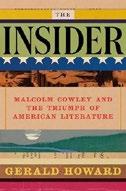
Agile life of a nearly forgotten writer and editor.
It’s meta to say here, but as Howard, a writer and editor, notes, there was a time in this country when literary criticism and book reviewing were taken seriously and exercised enormous influence over the culture. “Critics enjoyed prestige and sway over not just educated, but even mass opinion,” acting as guides and gatekeepers to the flood of cultural production following World War II. Enter Malcolm Cowley, a farm-born Pennsylvanian and later resident of New York and Paris, one of the post–World War I expatriate Americans. Cowley, according to Howard’s fluent, fast-moving narrative, wrote mountains of reviews and many books, and he knew everyone and championed the writers whom he admired, not least of them Ernest Hemingway, who was also living in Paris and was all but unknown, and William Faulkner, who had been all but forgotten; Cowley’s advocacy, Howard suggests, was directly instrumental in Faulkner being awarded the Nobel Prize. Cowley was adept at the politics of culture and publishing: “His career is a master class in how the literary Game of Thrones was played in the twentieth century, and, to a certain extent, to this day.” But he was also deeply generous and of unfailing good taste, discovering and publishing Jack Kerouac’s On the Road and Ken Kesey’s One Flew Over the Cuckoo’s Nest, among many other books and writers. Howard does a fine job of placing Cowley in the cultural context of his long career—he lived to be 90 and wrote almost to the end—which includes nearly being blacklisted during the McCarthy era, having been a leftist in his early years and a liberal after. John
THE CARS
Updike’s encomium on Cowley’s death says much: “He was an energetic and gregarious man who lived the life of the mind with gusto and good nature.”
A superb contribution to the history of American literature and the Lost Generation.
Jackson, Clare | Liveright/Norton (432 pp.) $35 | November 11, 2025 | 9781324094999

A monarch for the ages.
James VI of Scotland, later also James I of England, was a “cradle king,” first crowned at the tender age of 13 months. His second coronation came in 1603, after the death of Elizabeth I. This new history presents the story of his 57 years and 246 days on the throne. The book’s title comes from a portrait of James wearing a “prominent hat jewel” known as “the Mirror of Great Britain,” containing three large diamonds and a ruby, representing “opulent symbolic endorsement” of James’ vision of a united kingdom. Making that concept work involved one monarch presiding over two countries, with different parliamentary forms of government and separate national churches, currencies, and legal systems. The jewel, to James, also represented transparency; “‘The more the people know of the reasons of my doings,’ the more royal power would be respected.” His royal legacy includes prowess as both a poet and an avid hunter; pioneering an anti-smoking campaign, raising tobacco taxes by 4,000% and banning domestic farming
of tobacco; and making the Christian Bible accessible to millions by funding “one uniform translation” into English “undertaken by the best-learned” at Oxford and Cambridge and reviewed by “the Church of England’s bishops, Privy Councillors and James himself” before publication (and possibly some help from Shakespeare—for the iambic pentameter). He engineered a predominantly Protestant, Anglo-Scottish plantation in the northern Irish counties of Ulster to integrate Ireland into the United Kingdom, helped uncover and prevent the Gunpowder Plot to kill the king by blowing up Parliament in 1605, dissolved Parliament in 1621 in a dispute over royal authority, and created the first English settlement in North America by establishing the colony of Virginia. Jackson, a noted Cambridge historian and BBC presenter, shows her respect and affection for James in this highly readable history.
A robust history of the first—and “by far, its most interesting”—king of Great Britain.
Cars: Let the Stories Be Told
Janovitz, Bill | Da Capo (512 pp.) | $32.50 September 30, 2025 | 9780306835063

A comprehensive look at the New Wave band from Boston that charmed the world. The 1980s had more than its share of one-hit wonders and bands now lost to obscurity, but the Cars have
endured—“You Might Think,” “Drive,” and more are still radio and playlist staples. As Janovitz points out in his biography of the band, “It’s hard to imagine American popular music without them.” The group was a product of the friendship between Ric Ocasek and Ben Orr, who met in Columbus, Ohio, in 1968; the two moved to Boston and played in bands together before forming the Cars with Elliot Easton, Greg Hawkes, and David Robinson in 1976. The band’s rapid ascent began when Boston DJ Maxanne Sartori played “Just What I Needed” on her radio station, WBCN, which led to the band getting a record deal. A decade of highs and lows would follow, including four Top 10 hit singles and countless fights between Ocasek and his colleagues; Janovitz does a remarkably thorough job chronicling them on the basis of his interviews with the band’s three surviving members (Orr died in 2000, Ocasek in 2019) and those who knew the band. Much of the book necessarily centers on Ocasek, a complex and maddening figure: He could be sweet and charming, but he routinely belittled and ignored his bandmates, abandoned friends, and left his second wife for Paulina Porizkova, a model 21 years his junior. Janovitz dives deeply into the other members, however, and is careful not to paint Ocasek as a monster. His writing about the band’s music is wonderful— he is himself a Boston-area musician, the singer-songwriter for Buffalo Tom, and brings ample context to the Cars’ oeuvre. This is a superb rock biography, a must for anyone with even a passing interest in pop music. You might think this is a perfect match between author and subject—and you’d be right.

Creativity, “an instinct as powerful as the instinct to eat.”
Johnston, Carolyn Ross & Terri McKinney Baker | Univ. of Georgia (240 pp.) | $27.85 paper | June 15, 2025 | 9780820373775
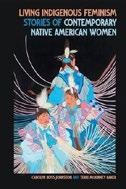
Women’s strength.
Literary scholar Baker and historian Johnston examine the lives and challenges of Native American women, focused on their feminism, activism, and power. Their book asks “what southern and western history would look like if viewed through the eyes of a diverse sample of Indigenous women.” Women’s traditional power in many tribal nations was undermined by contact with Europeans, in part because of forced removal from their traditional lands, in part from attending boarding schools that were focused on “educating the Indian out of the Indian,” and in part because of the allotment system that parceled tribal lands to individual Native American men. Geraldine Hull McKinney (1916-2005) recalls spending seven years at a Christian mission boarding school, sent by her mother, who was struggling financially, but instead of distancing Geraldine from her roots, her education inspired a strong connection to the tribe. Geraldine’s daughter, Terri McKinney Baker (1948-2022), learned from her mother “that passing on responsibility, skills, worldview, identity awareness, network building, and coalition development is fundamental to Native American women’s power.” She became an ethnohistorian, designed courses in Native American studies, and worked to create an American Indian community for her students. Other voices
include Terri’s friend, Wilma Mankiller, the first female chief of the Cherokee Nation, an “unapologetic feminist”; Indigenous feminist LaDonna Harris and her daughters, Kathryn Harris Tijerina and Laura Harris; artists, including writers, potters, basket weavers, painters, and singers; and Indigenous activists who work to promote tribal sovereignty and cultural survival through their leadership in politics, education, and health care. “Medicine,” the authors write, “is that essence of a person which is a unique spiritual gift or talent. Good medicine is sacred, healing power,” which these women have in abundance.
A revealing look at Native American lives.
Kidd, Sue Monk | Knopf (240 pp.) | $29 October 21, 2025 | 9780593804643

A writer’s healing journey.
Kidd is one of America’s most evocative memoirists of the spirit. Her new book looks back over a life of writing to explore the nature of human creativity and the urge we have not just to do something but to make something. Kidd writes: “Humans are wired to express their creativity by bringing forth something new or new combinations of the old….Creativity is an instinct as powerful as the instinct to eat, and it seeks conscious expression in the world.” Kidd tells her story as a harnessing of that instinct—through writing and reading. She builds a canon of books that can help us find our voices.
Toni Morrison, Alice Walker, Elie
Wiesel, Thomas Merton, Henrik Ibsen, and Carl Jung fill Kidd’s bookshelves. It is really Merton and Jung who build the scaffold of her spirit. Kidd digs deep into the archetypes of consciousness. The bees, the trees, the mountains, the plains—all take on new meaning in Kidd’s field of vision. She is a memoirist of things, an allegorist of the ordinary. A tuft of bison fur blown across a prairie becomes a keepsake, “a resonant reminder of the strength, bravery, and empowerment I was seeking.” She keeps the little tuft of fur in a box. Other bits of memories fill up the box: string, a shell, a pebble. Memory becomes that box of precious finds. Writing opens up the box and finds the story behind every substance. Kidd can write some of the lushest clauses in American prose. She can also write a simple declarative sentence. At such points of contact, writing thrills. But it can also heal the fractures in our lives and bridge the gap between the aesthetic and the everyday. A gorgeous memoir of the creative life, designed to bring out the writer’s voice in all of us.
King, Gilbert | Flatiron Books (384 pp.) $32.99 | October 7, 2025 | 9781250368546

A crime and justice writer tackles the story of an innocent Florida man serving time for his wife’s murder. King’s lead comes from a Florida circuit judge: Leo Schofield has been in prison for more than 30 years despite being innocent. Judge Scott Cupp’s tip-off went against a duty to defend Florida’s justice system—proof of the lengths the state had gone and the distortions it would cling to in order to uphold Leo’s conviction. Though the case is unlike the historical, racially fueled abuses that King has built a career studying, the author is drawn quickly into the intricate
web between Leo, a string of Florida state attorneys, and Jeremy Scott, who has confessed to the murder of Michelle Schofield, Leo’s 18-year-old wife. In a story crafted over six years—which also was the topic of his successful podcast with Kelsey Decker—King illuminates stark failures of justice that were “baked into the process from the start,” in particular under the targeted direction of Assistant State Attorney John Aguero. Wearing a tie clip in the shape of the electric chair, Aguero makes an easy villain, with aggressive and performative prosecutorial tactics that underscore, in the author’s telling, the gross mismanagement of the Florida detectives, law enforcement, and judiciary. But King finds his anchor much deeper inside the case, in the crescendos and decimations of Leo’s hope and resignation, as well as in the complicated past of Jeremy, with his own trauma, desperation, and agitation. With depth, humility, and an open, timid understanding of its inadequacy within the legal system, this orientation of King’s reporting grants human gravitas to the mind-blowing frustrations of procedural technicalities.
Both infuriating and hopeful, a story about the ultimate integrity of truth.
King, Rax | Vintage (272 pp.) | $18 paper July 29, 2025 | 9780593688458
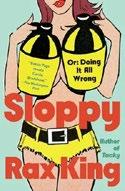
A veritable mess slowly resolves into something approaching normality in this spry confessional.
Imagine a red-inked, angry declaration “sloppy” on a piece of grade-school homework, and then stretch that into an early life of blundering around: “It’s described me too many times, and in too many contexts, for me to remember who-all said it and why,” writes King, whether charged with being a sloppy drunk or having been raised to sloppy standards with no expectations of success or happiness. “My family is
drunks the way other families are Teamsters or actors,” she writes, but she took that propensity well beyond alcohol to whatever drugs happened to cross her path. A stint in college ended in King’s working in a strip club (whence her nom de plume), although, she allows, “in reality, I was less a stripper than a daringly dressed cocktail salesman.”
King’s memoir recounts a succession of hard knocks, from an abusive first husband to a brush with suicide (“an unfortunate but plausible method of avoiding enemy capture”). King, who has a few surprises to reveal along the way (a love of playing banjo, for one), is nothing if not self-aware; she allows that drugs and drink were an ultimately successful way of evading the patches of boredom that she now accepts, and she has smart things to say about her evolving feminist consciousness, with a confessed resentment for the fact that “so much of my teenage life was done to me by men.” It’s not as if she’s wholly adjusted to ordinary social expectations (“I remain an implacable shoplifter, and I still throw temper tantrums that would better befit a six-year-old”), but it seems as if she’s on the path.
An entertaining memoir of a train wreck of a life, and of picking one’s way out of the rubble.
Lackman, Jonathan | Illus. by Zachary J. Pinson | Fantagraphics Books (232 pp.)
$29.99 | July 22, 2025 | 9798875001116
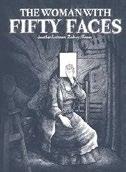
A fraud among the famous. Maria Lani (1895-1954) was an enigmatic bit player on the stage of modern art. She appeared out of nowhere in the 1920s, claiming to be a great silent film star. She befriended such artists as Jean Cocteau and Henri Matisse. Everybody painted her portrait. With her husband,
Max Abramowicz, they scammed the art world, keeping the valuable portraits and breezing through Paris until they disappeared in the 1930s. They were, of course, not who they said they were. Maria was born Maria Geleniewicz in the Jewish quarter of Czestochowa, Poland. She never was the film star that she claimed to be. She and her husband remained in Europe until 1940, when they managed to make it to Lisbon and sail for America. There was supposed to be a film based on her life, but it never materialized. She made it back to Paris, where she died. Writer Lackman and artist Pinson have transformed Lani’s life into a graphic biography. Vivid black-andwhite images illustrate the hardships of the Polish Jewry of her birth. They boldly limn the world of 1920s Paris. They give us nightmarish and unforgettable faces. The whole book has the feel of the musical Cabaret, as if illustrated by R. Crumb, or as if Art Spiegelman’s Maus were told by Mr. Natural. There is a trippy terror to the book: Mouths distort, noses grow, eyes bulge out. Its bizarre genius is to take a woman known for her face on Modernist canvases and transform her into a visage fit for 21st-century comics. Lani was an artist of impersonations, a true charlatan worthy of this book’s outré imagination. The life of an exhibitionistic, modernist fraud, told through graphic art that will keep the reader up at night.
Lee, Trymaine | St. Martin's (272 pp.) | $29 September 9, 2025 | 9781250098016

A journalist analyzes how gun laws and ownership perpetuate racialized violence. According to Lee, “Black people are thirteen times more likely to be shot and killed by police and seven times more likely to be shot dead by another civilian with a gun.” Lee traces this pattern to America’s beginnings, when “an uncleavable relationship between the trade of humans
and the trade of guns” contributed to the nation’s bloody foundation. After this historical background, Lee moves around the country, describing how Southern gun traffickers illicitly arm Chicagoans despite the state’s stringent gun control laws, fueling the city’s uncontrollable violence. In New Orleans, he notes how, while reporting during Hurricane Katrina, at least one of his white colleagues makes excuses for police shootings aimed at some of the city’s poorest Black residents. In Massachusetts, he interviews a worker at the Smith & Wesson factory who loses his job after publicly questioning the company’s ethics. Throughout these stories, he weaves in his own personal history, recounting how his grandfather’s and stepbrother’s murders left lasting, traumatic impressions on his extended family. Lee’s experience reinforces one of the book’s key messages—that gun violence is both a byproduct and cause of “the systemic, institutional, and structural racism that feeds it.” At best, Lee’s work is empathetic, analytical, and insightful, drawing subtle connections in clean and conversational prose. Some chapters hold together better than others: “(G)un-Civil Rights,” for example, is cohesive, while “Gigglebox” tends to meander. All in all, the book is a provocative and informative read that expertly blends memoir with hard-hitting reporting.
A poignant chronicle of the systems that fuel gun violence in the United States.
Leland, Levi Lionel | Adams Media (240 pp.)
$17 | September 23, 2025 | 9781507224137
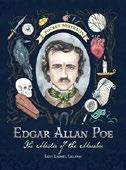
Tintinnabulations. Poe is everywhere. The Raven’s “nevermore” echoes as a memory and a meme. His arch detectives invite us to see the weird behind the everyday. Police procedurals and
horror tales would not exist today without his work. Poe’s name has become shorthand for a personal universe. This book by Leland, who leads a Poe walking tour of Providence, Rhode Island, offers a basic introduction to the beloved author’s life and work. Complete with bullet points and sidebars, it writes a biography for the PowerPoint generation. It would be best for middle schoolers who have heard of Poe but need to know more. We get the basic outlines of his life, the list of works, and guides to further reading. Interrupting the flow of narrative are sections titled “The More You Know.” These are little paragraphs, in different type and different color, that offer tidbits of history. Did Poe believe in God? A paragraph raises the question, offers a few tantalizing details (a phrase, a personal letter, an aside), and then concludes: “Like many facets of Poe’s life, it may never be known exactly where he stood on spiritual or religious matters. His love of hoaxes, satire, controversy, and sensationalism often concealed his true beliefs.” Interspersed among these comments are the texts of Poe’s poems, printed in a font that looks like that of an old manual typewriter. The literary criticism goes only so deep: “Poe’s ‘Annabel Lee’ is a masterpiece of gothic romanticism. The poem delves into Poe’s usual themes of love, loss, and grief, describing a childhood love that transcends time and even death.” The best parts of the book retell the last months of Poe’s life—his nuttiness, his drinking, and his strange love affair with death itself.
A slim introduction to the life and work of Poe, best for young readers coming to the writer for the first time.
Malin, Sean | Chronicle Books (240 pp.)
$24.95 | September 16, 2025 | 9781797232249

A punchy guidebook for the podcast-curious.
“At this point, everybody either makes podcasts, listens to them, or gets FOMO from hearing everyone else talk about them,” journalist Malin writes in his book. While that exaggeration doesn’t account for some stubborn holdouts, his point is well taken: In the more than 20 years since the word “podcast” was coined, these programs have become inescapable. Malin seeks to provide a canon of “the most groundbreaking, beautiful, compelling, experimental, touching, human, artful, and funny works the medium has yet offered.” The book is not intended for superfans of the genre, but more for people whose exposure was limited to hearing everyone around them talk about Serial or Dirty John. Those podcasts are profiled here, along with dozens more, covering genres including comedy, food, history, and storytelling. For each podcast, Malin offers a brief history, insight from those involved, and his argument for why each show should be considered essential. They include the heavy hitters, such as Conan O’Brien Needs a Friend, Planet Money, and My Favorite Murder, but Malin seems most excited when he writes about ones that aren’t quite as ubiquitous, including The Accessible Stall, “a vector for greater empathy with disabled folks”; Drifting Off With Joe Pera, “a delicate, otherworldly sleep podcast”; and Gender Reveal, which draws from “a vast
Profiling some of the best downloadable audio—with wit and good humor. THE PODCAST PANTHEON
oral archive that engages gender and its infinite permutations head-on.” The book does not include podcasts that “do more harm than good to the world”: Malin acknowledges the adage that “those who ignore history are doomed to repeat it,” but adds, “but I am a podcast critic, not a historian, and The Podcast Pantheon is not a history book. So fuck ’em.” It’s a good example of the wit and good humor he brings to this useful guide.
A fun and informative tour of “the labyrinth that is downloadable audio.”
Kirkus Star
Marx, W. David | Viking (384 pp.) | $32 November 18, 2025 | 9780593833995

We’re a quarter of the way through the 21st century. What do we have to show for it?
How is it possible that our modern society produces so much content and yet so little true cultural innovation? In the 21st century, “the most radical forms of cultural invention have become scarce,” says culture writer Marx. Neoliberalism tamps down creative innovation by “elevating extreme profit-seeking as the highest human goal.” The theory of “poptimism” posits that popular culture should be “appreciated as a complex manufactured product” rather than derided as kitsch; once poptimism took hold, artists who openly pursued mass-market success were lauded rather than accused of “selling out.” The film industry began to rely more heavily on existing IP and nostalgia for low-risk, financially rewarding projects; as Marx says, “Retromania depends on older works feeling more valuable than contemporary ones.” Web 2.0, with its user-generated content and revenue-sharing models that allowed direct monetization, has created a class of well-compensated and highly visible influencers, but this development has not amounted to a “true revolution
[involving] a reversal of status” because these individuals “had little influence on mainstream cultural standards.” Pioneering niche movements have been unseated by “the omnivore monoculture,” in which the blending of all tastes and styles is welcomed, even encouraged, as long as the result is maximally commercially successful. (Country music was once seen as a stubborn holdout of monoculture, but then came Lil Nas X.) Now that inclusive liberal politics have largely become normalized, extreme radical conservatives (“a group with no meaningful concern for artistic innovation”) have emerged as the transgressives of the new century; while mainstream culture did not embrace them, the internet has allowed their ideas to flourish unabated, with profound consequences. Marx has written a worthy follow-up to his 2022 book, Status and Culture. He draws on a commendable wealth of examples from disparate realms of culture—from the dominance of Japanese streetwear to Nazified internet memes and the “child influencer” the Rizzler—to ably explain what many citizens of the modern world, especially Americans, have long colloquially felt: that our current culture has grown stagnant. A wide-ranging, persuasive, readable treatise on a crucial component of modern life.
Mayor, Adrienne | Illus. by Michele M. Angel | Princeton Univ. (216 pp.) | $17.95 October 7, 2025 | 9780691247861

Exploring the borderlands between myth, history, and science.
Folklorist and historian Mayor, author of the National Book Award finalist The Poison King, draws on the new field of geomythology to explain the historical background and science behind 53 legends and myths of the earth and “how humans have made sense of their observations of
nature over time.” The oral legend of the Budj Bim volcano in Australia may go back more than 36,000 years and can help scientists understand seismic, volcanic, and other geological events. The many tales of fountains of flames and perpetually burning fires can help scientists trace the earth’s hydrocarbon degassing into the atmosphere. The ancient tales of West Africa’s terrible, gigantic Jobar creature, which perished in an ancient flash flood, were confirmed in 1997 by the discovery of a new species of sauropod dinosaurs. The giant lake catfish of Japanese legend, the Namazu, were known for predicting earthquakes and tsunamis; its image now graces Japanese escape route signs. Legends about numerous Paleoburrows in Brazil, formed long ago, were created by giant sloths and massive armadillos, say paleontologists. Contemporary urban myths have sprung up around the Rat Hole of Chicago, an impression of a rat in a concrete sidewalk. It probably escaped from wet concrete. Then there are the legends of Bahrain’s 32-foot Shajarat-alHayat, or Tree of Life, being part of the Garden of Eden. Scientists now believe it was planted around 1582. Mayor concludes her catalog of worldly wonders with the study of zooseismology—yes, it seems animals do have the ability to sense seismic activity before humans. Other entries cover dry quicksand, raining frogs and fish, killing stones, and windblown strands of spun glass. A fascinating catalog of ancient cultures and unique geological events.
McFaul, Michael | Mariner Books (288 pp.) $35 | October 28, 2025 | 9780358677871

Democracy now, more than ever. McFaul, professor of international studies at Stanford, was ambassador to Russia under President Obama, so he speaks from experience
and marshals more facts, statistics, and personalities than many in his field. China and Russia were autocratic when our republic was born, the author points out, but monarchs ruled almost everywhere, so our early leaders rarely criticized them. Relations waxed and waned until after 1945, when, seemingly locked in implacable communist hostility, they became America’s enemies. Overestimating Soviet power as well as the appeal of communism across the world, the U.S. regularly supported corrupt dictators who proclaimed their anticommunism and threw its weight around in wars purportedly to spread democracy. Economically tiny compared to China, Russia has become pugnacious, obsessed with restoring its great power status, and bitterly hostile—this will come as no surprise to most readers. China’s miraculous growth killed the myth that prospering nations become democratic, but, intriguingly, McFaul warns us not to overrate China as we did the USSR. He notes that China’s economy is faltering and that nine out of 10 of the world’s richest nations are democracies. The U.S. has dozens of allies; China and Russia make do with North Korea and Iran. McFaul finds it discouraging that President Trump does not extol democracy or denounce Chinese and Russian human rights violations. Instead, the president praises their leaders, belittles U.S. allies, and has withdrawn from treaties and other efforts at international cooperation. McFaul writes, “Our adversaries clearly understand the benefits of our domestic disunity and, at times, have meddled in American politics to exacerbate these divisions.” However, he concludes on a hopeful note: “We overcame divisions in the 1960s and 1970s and renewed American democracy….It took a long time, but we eventually healed after our tragic Civil War. Renewal in America is not only possible, but history suggests it is probable.”
An insightful and vigorous argument for democracy in a world of new threats—not all foreign.
McGoogan, Keriann | Douglas & McIntyre (320 pp.) | $29.95 | September 23, 2025 9781771624459

In search of primates. Primatologist
McGoogan interweaves memoir and biography, focusing on the life and work of seven groundbreaking scientists, among them Jane Goodall, Dian Fossey, Birutė Galdikas, and Alison Jolly. These researchers, along with Linda Fedigan, Jeanne Altmann, and Sarah Hrdy, have changed the way we understand primates, our closest biological relatives, of which there are about 500 species worldwide. McGoogan sets her lively portraits in the context of an overriding question: Why, of all the STEM (science, technology, engineering, math) subjects, is primatology the only one in which women predominate? That question occupied her mentor, Fedigan, too, who suggested that female scientists may be drawn to a field that focuses on an understanding of what it means to be human. Certainly primatology gives investigators a close look at behaviors such as mothering, sexual relations, competition, feeding, and group dynamics. But the work is challenging, involving rigorous fieldwork in tropical climates, where researchers risk disease (McGoogan contracted malaria, as did others), injury, violence, and, in Fossey’s case, murder. As a primatologist who studied howler monkeys in Belize and lemurs in Madagascar, the author admits that although it’s satisfying, “fieldwork often combines the magical with the maddening.” Drawing on memoirs, biographies, and interviews, McGoogan recounts the highlights of her subjects’ careers, which, in several cases, included significant help from famed paleoanthropologist Louis Leakey, who championed women’s projects. Many of the scientists were inspired by other female researchers, whom they saw as role models—as does
the author. Although McGoogan discovered no single answer to why women have been drawn to primatology in the first place, it’s more important, she asserts, to acknowledge the ways that their discoveries and insights have decisively shaped the discipline as we know it today.
Engaging portraits of intrepid women.
McKibben,
Bill | Norton (224 pp.) | $29.99
August 19, 2025 | 9781324106234

The noted environmentalist and writer serves up a paean to the emerging dominance of renewable energy. McKibben, a pioneer in writing about climate change (his first book, The End of Nature, appeared in 1989), holds that it’s too late to stop global warming: “Our best hope now is simply to stop the heating of the earth short of the point where it cuts civilization off at the knees.” If we’re going to reach that best hope, we’ll have to force the issue and stop working at our current pace, which, he gloomily adds, seems unlikely. After all this, though, McKibben becomes a bit more optimistic, as he profiles technologies that can provide necessary relief. In 2024, he writes, more than nine-tenths of the world’s new electricity came from renewables; China now has the industrial capacity to produce all the photovoltaic equipment the world needs to replace fossil fuels; batteries are becoming ever more efficient and can increasingly be thoroughly recycled, such that we need not mine the earth for more minerals. What’s wanted, writes McKibben in a polemic that stays refreshingly shy of hyperbole, is political will, and this can be done. As he notes, California “managed to produce from renewable energy more than 100 percent of the electricity it was using for long stretches
of the day,” and that figure is only growing. Still, he recognizes, the fossil fuel industry is fighting tooth and nail to keep Big Oil predominant, and the present presidential administration is antagonistic to anything that smacks of environmental responsibility, such that “the US might decide to become an island of internal combustion, and then the essential nation might turn out to be China,” which would suit China just fine. A compelling argument for altering our energy regime before we’re toast, if that’s not already the case.
Myers, Paul | House of Anansi Press (376 pp.)
$29.99 | October 7, 2025 | 9781487009526

An affectionate portrait of the late, great comic actor and writer. John Candy was universally loved. Writes Dan Aykroyd in his foreword to pop culture maven Myers’ life, “In a world where publicists routinely shield their star clients’ dark sides from their adoring public, it is virtually impossible to find anyone with a bad word to say about him.” He’d hoped to be a gridiron hero until an injury made it impossible for him to play—and good thing for that busted knee, for, Myers reveals, Candy, a Canadian, tried to join the U.S. Marines at the height of the Vietnam War but was rejected because of the offending joint. Myers attributes Candy’s odd attempt to a dangerously negative body image, with Candy hoping that the Marines would whip him into shape. Candy’s struggles with weight are a leitmotif here, and while Myers takes pains not to bodyshame, there are many painful episodes on that score, as when Carl Reiner, directing Candy in the film Summer Rental, “began to notice empty pizza boxes in Candy’s trailer, along with discarded candy wrappers and other signs of snacking.” Candy died of heart failure at 43, attributable to what actor Joe Flaherty called “his weight problems, the
drinking, and cigarettes,” augmented by anxiety. Apart from his poor self-care, though, Candy brought a fresh comic sensibility to both television and film, giving dimensionality to characters such as Del Griffith in John Hughes’ Planes, Trains and Automobiles and a host of roles in the cult classic SCTV. As Myers notes, Candy was also moving toward more serious pieces at the time of his death, including taking the dramatic lead in A Confederacy of Dunces. What emerges again and again, along with Candy’s impeccable work ethic, was his generosity, as when, on one film set, he bought a Thanksgiving turkey for each of more than 200 cast and crew members. For all its sad ending, fans of John Candy will delight in Myers’ comprehensive biography.
What
Indispensable Guide to Good Food, How To Find It, and
Nestle, Marion | Farrar, Straus and Giroux (720 pp.) | $35 | November 11, 2025 9780374608699
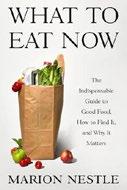
The noted nutritionist offers a deeply researched look into the food that we eat—and why we need to do better.
At the outset, updating her 2005 book What To Eat, Nestle acknowledges that her work centers on the politics of food, which means, here, constant agitation against a food system driven by business imperatives “to produce and market highly profitable ‘junk.’” Added to this critique of food systems are imperatives of their own, these dealing with global problems: “hunger and food insecurity, obesity and its disease consequences, and climate change.” Nestle begins at the epicenter, inside modern supermarkets, where food corporations buy space on shelves at eye level to lure consumers into consuming…mostly junk, and
junk that we wind up paying for three times: once at the cash register, once to cover tax deductions the companies take for these expenses, and once for treating the ensuing illnesses. Go to a wealthy neighborhood, and you’ll find expensive but abundant produce; go to a poor one, and you’ll find mostly highly processed food that is both cheap and deleterious to health, laden with sugars, sodium, and the like. Ironically, Nestle writes, that food system produces, annually, twice as many calories as a healthy adult needs—which Nestle counters with a long, complex discussion of how calories are measured, as well as an admonition: “Don’t eat more calories than you need.” She couples that discussion with a sobering note that if you walk at a leisurely pace for an hour, you’ll burn off the caloric equivalent of only 14 tortilla chips, meaning that any effort to lose weight must involve eating less, which, she notes late in her discussion, “is bad for business.” So have a carrot instead of a candy bar, she notes, and eat lower on the food chain, and buy organic—but, she also counsels wisely, “find the joy in food.”
Essential reading for anyone who cares about how we fuel ourselves.
Onyebuchi, Tochi | Roxane Gay Books/ Grove (256 pp.) | $27 | October 21, 2025 9780802166258

A science-fiction writer meditates on the internet’s human aspects. In this wideranging essay collection, Onyebuchi traces his personal development through video games, literature, and the internet. In “Select Difficulty,” he uses the experience of playing the video game
The Last of Us as an opportunity to examine his relationship with his Nigerian father, who died when the author was only 10 years old. In “I Have
No Mouth and I Must Scream,” the author contemplates the role of the Black writer in the context of cultural artifacts ranging from Ralph Ellison’s Invisible Man to videos of “police-initiated executions” of Black citizens. In “I Have a Rendezvous With Death,” he articulates the emotional damage he suffered while working a job that required him to comb the internet to uncover “what’s going on in the world before most other people do.” Onyebuchi positions these chapters as a window into his multiple selves, all of which, he says, contribute to the way we shape our cultural world, on- and offline. He writes, “All this time, I thought the key to my multiplicity, to exhibiting that multiplicity online, lay in retrieving a previous self. In reality, this manifold self is a thing I am building, a thing we are all building one tweet, one Angelfire webpage, one sentence at a time.” Onyebuchi’s cultural vocabulary is impressive, weaving together references to, among others, Graham Greene, Nas, and Walter Mosley. Although some chapters are more cohesive than others, this is a lively and astute read.
A trenchant essay collection about race and identity online.
Patterson, James & Vicky Ward Little, Brown (448 pp.) | $22.75 July 14, 2025 | 9780316572859

Account of the notorious murder of four University of Idaho students in 2022.
Patterson, that industrial-strength writer, adopts a sort of semi-noir tone in this true-life procedural, opening when news of the murders of Kaylee Goncalves, Madison Mogen, Xana Kernodle, and Ethan Chapin reaches the chief of police of Moscow, Idaho: “And again he presses harder on the gas. One good thing about being the police chief is that no one is likely to arrest him for speeding.” The murders, committed with a military-grade
fixed-blade knife, were grisly enough, but the clues were relatively few. There was a reason for that: Bryan Kohberger, who admitted to the killings in July 2025, had been a graduate student in criminology at nearby Washington State University; as an undergraduate, he had learned the art of criminal profiling, how murders are investigated, and what weapons are usually employed (“Typically…white men choose knives”). Kohberger, by all accounts, was a psychological mess with an inflated sense of self-worth and the certainty that women “must spot his looks, his intelligence, and they must want him.” Writes Patterson, “They don’t.” This occasions a discussion of “incels”—involuntary celibates—and their purported place “at the heart of rising gender-based violence.” Kohberger was one such incel, well known in school for insulting female students and making them feel threatened, so much so that he was removed from his teaching assistantship, likely a step toward expulsion. The best part of this meandering book is Patterson’s description of the courtroom maneuvering of Kohberger’s defense attorney, a skilled litigator whose client, as part of a plea deal, will be spared the death penalty. An assembly-line book that doesn’t add much to what can easily be found online.
Piazza, Tom | Norton (208 pp.) | $27.99 September 9, 2025 | 9781324050858

A personal profile of a beloved singer-songwriter. After attending a John Prine concert in New Orleans in 2016—“He might have been an aging Mafia don, or an organizer for the longshoreman’s union, playing a Gibson jumbo guitar that looked almost as big as he was”—veteran author Piazza (City of Refuge, Devil Sent the Rain, etc.) profiled the singer-songwriter for Oxford American magazine. The article—also titled “Living
in the Present With John Prine,” led to a friendship as well as a plan to produce Prine’s memoir, which was cut short when Prine died in 2020 from complications caused by Covid-19. He was 73. Piazza repurposed the materials he had gathered to produce this moving work. Equal parts profile, oral history, and on-the-road adventure, the book recounts the artist’s working-class background in suburban Chicago, his family connection to rural Kentucky, his early success with Atlantic Records, and the decision to co-found the label Oh Boy Records. Often writing in the first person and present tense, Piazza recounts his time with Prine, including a spontaneous road trip from Nashville to Sarasota, Florida, in a cherry-red 1977 Coupe de Ville. Piazza also reviews Prine’s body of work, its broad influence, and his unassuming humanity. Comparing Prine to Bob Dylan, Piazza notes, “You don’t want to be him, you just want to hang out with him.” Along the way, the author gathers insights from Prine’s peers, friends, and family. One band member, for example, notes that Prine’s keen emotional intelligence easily overcame his limitations as a musician and singer. A two-time cancer survivor, Prine was already in poor health when Piazza befriended him, but the artist’s good humor and low-key grace shine through on every page.
A heartfelt blend of first-person journalism, oral history, travelogue, and elegy.
Plenel, Edwy | Trans. by Luke Leafgren Other Press (208 pp.) | $16.99 paper September 9, 2025 | 9781635425598

A French journalist bemoans the increasing drift toward authoritarianism and anomie.
Plenel, a onetime editor of the French daily Le Monde and longtime leftist activist, seizes on one of those binary
to
LIN-MANUEL MIRANDA
tropes so beloved of French poststructuralists, contrasting the garden of civilization with the jungle of savagery. The thing is, these are found side by side in the West, as Plenel chronicles while interrogating “those imperial claims to superiority, domination, and power which have not ceased causing barbarism to appear in the heart of civilization.” Two frequently evoked cases in point are Russia’s invasion of Ukraine and Israel’s war on Gaza, abetted by numerous authoritarian regimes, not least of them Donald Trump’s, which break “with the ideal of a shared world, where human beings, just like the nature of which they are part, are in relationship, ineluctably interconnected, intermixed, and interdependent.” The modern West, Plenel makes plain, is founded on “criminal ideologies and destructive forces”; another case in point is the system of French colonialism, which, alone of the European powers, continues today in far-flung “neocolonial” places such as New Caledonia— one of many apartheid states, a category in which he also places Trump’s America—and Chad. Plenel is unsparing of his homeland, locating in it the “great replacement” theory beloved of the MAGA right in the U.S. Ironically, Plenel notes, the true law of the jungle is the anarchist theoretician Peter Kropotkin’s theory of mutual aid, where the survival of the fittest gives way to the survival of all who apply. The translation renders many names in their French forms (Kropotkine, Carl Schmitt, Atila), which is a touch distracting, but Plenel’s defense of the Enlightenment ideals of liberté, égalité, and fraternité comes through quite clearly.
A provocative essay on the need to defend the West against itself.
Pollack-Pelzner, Daniel | Simon & Schuster (400 pp.) | $30 | September 9, 2025 9781668014707

A look at the life and career of the stage musical phenomenon. Even if you think “Rodgers and Hammerstein” is the name of a law firm, you likely have heard of Lin-Manuel Miranda. The composer, singer, and rapper became something of a household name a decade ago, when his hip-hop musical Hamilton, about Founding Father Alexander Hamilton, opened on Broadway, becoming a worldwide phenomenon. In his first book, Pollack-Pelzner explains how a kid from Inwood, at the northern tip of Manhattan, wrote and sang his way into the hearts of millions. Miranda’s “origin story,” Pollack-Pelzner writes, began at a piano recital, when he first discovered he would get applause for his performances, leading him to play as many songs as he could. An anxious child by nature, Miranda bloomed in high school, where he made movies with a camcorder and took advantage of the school’s drama program, staging ambitious plays. In his sophomore year at Wesleyan University, Miranda wrote a musical set in Washington Heights; it would become the first draft of In the Heights, his first Broadway musical. Most of Pollack-Pelzner’s book is dedicated to the creative process behind In the Heights, which won four Tony Awards, and Hamilton, the idea for which came when Miranda took a copy of Ron
Chernow’s biography on vacation. Miranda talked to Pollack-Pelzner for the book, and his remarkable candor is part of why it succeeds. The author’s chronicle of the musicals’ development is equally thrilling. Pollack-Pelzner, who writes about theater and culture for the New Yorker, the Atlantic, and the New York Times, understands the technical and creative aspects of the stage, and he proves himself to also be an astute observer of the more human side of creating art. An enthralling portrait of an artist whose genius has captivated the world.
Pond, Mimi | Drawn & Quarterly (444 pp.) $29.95 | September 16, 2025 | 9781770468047

Six insouciant sisters captivate the author. Cartoonist Pond (Over Easy, The Customer Is Always Wrong) weaves glimpses of her own life into an entertaining group biography of the notorious, eccentric Mitford sisters—Nancy, Pamela, Diana, Unity, Jessica, and Deborah. Growing up in suburban Southern California in the 1960s, Pond envied girls who had sisters rather than her boorish brothers; she envied, too, the Mitford girls’ rebelliousness, glamour, and sophistication. Born between 1904 and 1920, the sisters spent their childhood isolated on their family’s vast estate, each inhabiting “an island unto themselves.” Politically, they emerged with diametrically different views: Diana and Unity became unabashed fascists. At the age of 22, Diana divorced her husband to carry on an affair with Oswald Moseley, head of the British Union of Fascists, whom she eventually married. Unity, an ardent admirer of Hitler, went to Germany to meet him and soon, to her family’s horror, published a scandalous letter denouncing Jews. Jessica, on the other hand, touted communism and socialism. With Esmond Romilly (a nephew of Winston Churchill), she left home to aid in the Spanish Civil War. Defying

Jennifer Aniston will star in the adaptation of Jennette McCurdy’s memoir.
Jennette McCurdy’s I’m Glad My Mom Died is headed to the small screen, with Jennifer Aniston attached to star, Deadline reports.
The iCarly and Sam & Cat actor’s memoir, published in 2022 by Simon & Schuster, tells the story of her relationship with her mother, who she says emotionally abused her during her childhood. In a starred review, a critic for Kirkus praised the book as “the heartbreaking story of an emotionally battered child delivered with captivating candor and grace.”
The book was a No. 1 New York Times bestseller, and

For a review of McCurdy's book, visit Kirkus

McCurdy signed a seven-figure deal for two more books, including a novel, with publisher Ballantine.
Aniston will star in the 10-episode series, which is being developed by Apple Studios and written and showrun by McCurdy and Ari Katcher (The Carmichael Show, On the Count of Three). Executive producers on the series include Aniston, McCurdy, Katcher, and actors Sharon Horgan and Jerrod Carmichael.
McCurdy shared news of the series on Instagram, writing, “so excited + honored that i get to create, write, and showrun this show and work with this incredible group of people.”
Aniston reacted to McCurdy’s post with a heart emoji, and Horgan replied “Queen x.”
—MICHAEL SCHAUB



Author of Taylor’s Version
HARVARD PROFESSOR Stephanie Burt introduced the study of Taylor Swift to students in her 2024 course Taylor Swift and Her World, but she didn’t stop there. Burt, an award-winning poet and literary critic, dove even deeper into Swift’s sphere and wrote Taylor’s Version: The Poetic and Musical Genius of Taylor Swift. In this book, Burt offers her understanding of Swift’s remarkable success, exploring different aspects of the singer-songwriter’s career. Burt answered our questions by email.
Tell readers, briefly, about your book. I’ve been a Swiftie of some small stripe since Red, and when my students found out in 2023, a few of them asked me to teach a course around Taylor. Which turned into a 200-person class in a lecture hall. Which turned into this book, all about what makes Taylor’s songs so powerful and memorable and popular, about how they work as words and music together, about why they speak to so many of us, and how.
What inspired you during the writing of the book? Were you encouraged by any songs or albums of Swift’s in particular? I found her songs encouraging and inspiring! The ones that meant the most to me turned out to be the songs where she tells us she works hard, the songs where she thinks about how much she wants us to like her, how much she wants to feel
seen. “Nothing New,” “The Archer,” “I Can Do It With a Broken Heart.” I also loved the chance to reread the novels and poems that appeared in the book, or the course, or both, as parallels or sources for her songs, such as Willa Cather’s The Song of the Lark and Alexander Pope’s “Epistle to Dr. Arbuthnot.”
What was most challenging about writing this book? And most rewarding?
Challenging (in a good way): the chapter about her album Reputation, where I address Taylor’s whiteness and the racial politics of pop music genres. White people need to think about whiteness and about white privilege more, especially white people who write about culture—but we, most of us, have grown up taking whiteness for granted, or pretending race only matters if you’re not white (that’s white privilege almost by definition). Reputation’s a great album, and I admire a lot of it, not least the way it required me to think about how white pop stars, singers, and songwriters treat historically Black kinds of music.
Will you be touring or doing events for the book this fall? Any you are especially looking forward to?
Thanks to the publicity crew at Basic Books you can expect events at bookstores, festivals, or universities, in Boston and Boston’s suburbs, Chicago, Minneapolis, Nashville, San Francisco, Washington, D.C., and




Version: The Poetic and Musical Genius of Taylor Swift Burt, Stephanie Basic Books | 352 pp. | $30 October 14, 2025 | 9781541606234
New York City. And that’s just a start. I used to live in St. Paul and feel a great deal of loyalty to Minnesota, so I’m excited about going there (Twin Cities Book Festival, early November). Nashville has meant a lot to Taylor herself, and it figures in the book, especially Chapters 1 and 2.
What fall release(s) are you most eager to get your hands on?
In no particular order: Allan Peterson’s next book of poetry, Seanan McGuire’s next Wayward Children novella, Cameron Awkward-Rich’s An Optimism.
Interview by Katarina Yerger.
her furious parents, they married and moved to the U.S.; she became a widow when Esmond was killed during World War II, and she later married a lawyer who shared in her labor and civil rights activism. Jessica made her name writing exposés, the first being The American Way of Death, skewering the funeral home industry. Nancy was the first to make her mark as an author, writing satirical novels that offended several members of her family. Pond recounts the sisters’ marriages, divorces, affairs, pregnancies, miscarriages, occupations, and preoccupations, all set in the context of the turbulent times in which they lived: “Across the scope of the entire 20th century,” Pond writes, “was the Mitford Circus.”
Whimsical cartoons reveal passionate lives.
World’s Greatest Store
Pressman, Gene | Viking (400 pp.) | $16.99 September 2, 2025 | 9780593654798
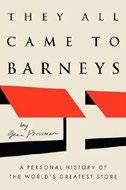
A life in retail, a cultural history of New York, and a settling of scores. The grandson of Barney Pressman, founder of Barneys, gives a detailed account of the family business, and of his participation in it. Thanks to the successes of his grandparents and his parents, Fred and Phyllis Pressman, Gene and his siblings were born with the proverbial silver spoon in their mouths and were also indoctrinated early into the family work ethic, also known as the “the Pressman way”: “We dreamed it, we made it, and then we exceeded it.” Early chapters document the high life of the young, reckless, and mod in the 1960s and ’70s; Pressman was quite the ladies’ man, and the reader will need to weather many observations along the lines of “I’d worked my way through the Sports Illustrated girls of northern
Europe” (on the other hand, no matter what you’ve heard about Plato’s Retreat, it was “disgusting”). Pressman and his collaborator, Matthew Schneier, do excellent work in capturing the economic and cultural trends of the last four decades of the 20th century and in delivering detailed portraits of important players and movements in fashion during this period, from Giorgio Armani to Azzedine Alaïa, from Rei Kawakubo of Comme des Garçons to Ralph Lauren, the latter depicted as both a brilliant businessman and “a finicky pain in the ass.” Most of the detail that makes this book a bit long is worth hearing, though occasionally one wonders about the wisdom of, say, listing every designer collection that appeared on the fourth floor in 1986. The illustrations and photographs are well chosen. As for the series of mistakes that led to bankruptcy and the decline of the brand, the pace of growth gets so frantic, the level of excess and ornament so extreme, and the finances so leveraged that one almost hears echoes of the Roman Empire and the Court of the Sun King resonating up and down “the iconic art deco spiral staircase at Barneys’ Seventeenth Street women’s store.”
This glittering, dishy time capsule of a paradise lost is as charming and blustery as its author.
Beyond the Borders of Ancient Civilization
Rees, Owen | Norton (368 pp.) | $31.99 September 30, 2025 | 9781324036524

Exploring vibrant cultures beyond the borders of classical Rome, Greece, Egypt, and the Middle East.
Historian Rees, a fellow at the University of Nottingham, writes that ancient Egyptians, Athenians, and Romans
took for granted that the more distant you were, the further you were from civilization, but this was not entirely accurate. For example, ancient Egyptian armies spent thousands of years conquering or retreating from substantial Kush and Nubian kingdoms to the south. Contempt did not prevent traders and settlers from establishing thriving communities in barbarian lands. Massalia (Marseilles today) was settled by Greeks before 700 B.C.E., enjoyed good relations with the Gauls, and was even responsible for introducing wine to France. Readers aware of the havoc wreaked when Scythian horsemen descended from the steppes will learn of Olbia on the north Black Seacoast near Crimea, a thriving Greek city-state that not only absorbed Scythian culture but contributed to it. Not uncivilized at all, Aksum (today’s Ethiopia) was a substantial kingdom with its own brand of Christianity and a thriving trading center, Adulis, along the Red Sea. Wandering from his theme, Rees devotes many chapters to civilizations within other civilizations. Egypt depended heavily on Greek merchants. One consequence was Naucratis, the only port where Greeks were allowed to trade, a center of the “Egyptomania” that spread across the Hellenic world and is the subject of a long chapter. Another describes Taxila (in modern Pakistan), a kingdom at the farthest reach of Alexander the Great’s conquest. It managed to fend off Greek influence and become a center for expansion of the new Buddhist religion. Vietnam is arguably the furthest land of which the Romans had a vague knowledge. Rees calls it “the location for one of history’s biggest ‘what might have beens,’ where Rome and the powerful empire of Han China almost made direct contact with each other.”
Good ancient history off the beaten path.

Reynolds, Gabriel Said | Yale Univ. (288 pp.) $30 | September 2, 2025 | 9780300281750

Christian influences on the birth of Islam. Historian Reynolds provides a sedate look into the Christian milieu of Arabia at the time of Muhammad. Though his work is densely researched and replete with academic sources, it still manages to be brief and straightforward. Reynolds explores the question of just how much influence Christianity had on Muhammad and on the formation of the Qur’an. He argues that the Christian connection is deeper and more influential than many have previously understood. Earlier scholars believed that Muhammad was exposed only to a heretical form of Christianity, but Reynolds argues this was not the case. Instead, he believes that orthodox Christianity had a strong presence in Arabia and heavily influenced the Qur’an, which is “in substance, both in its form and its content, related to the Bible and biblical traditions.” An obvious and key connection to Christianity is, of course, the presence of Jesus as a prophet within the Qur’an. In Reynolds’ view, Jesus “acts as a spokesman for the Qur’an’s theology.” Yet while Jesus is voicing a new theological viewpoint, the Qur’an also appropriates a variety of New Testament sayings and phrases, while changing their context. All of this displays the depth of influence that Christian teaching and scripture had on the Qur’an. Similarly, pre-Islamic Arabic inscriptions have shown a strong monotheistic influence prior to Muhammad. The Qur’anic text itself bears further witness to the presence of Christians in the midst of the earliest Muslims. “Christianity is nowhere and everywhere in the Qur’an,” according to Reynolds. In other words, he concludes, the Qur’an can be seen as a response to Christianity in a theological sense.
Houdini argued that spiritualism was the province of bunko artists; others disagreed.
LINCOLN’S GHOST
Readers would do well to compare this work with The Islamic Jesus by Mustafa Akyol (2017).
Reynolds assumes a certain level of knowledge in his readers, but he presents an interesting study.
Ricca, Brad | St. Martin's (320 pp.) | $30 October 28, 2025 | 9781250338907
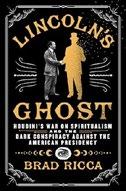
A lively history of those who would call up the dead. Like later magician James Randi, the renowned escape artist known as “the Amazing Randi,” Harry Houdini devoted much of his later life to combatting “spiritualism,” much in vogue then as now. “This thing they call ‘Spiritualism,’” Houdini testified before a congressional committee, “wherein a medium inter-communicates with the dead, is a fraud from start to finish.” That the matter should have wound up before a panel of legislators wasn’t so strange: Houdini argued that spiritualism was the province of bunko artists, and, pressing for a law to forbid its practice, he claimed to have had numerous mediums arrested for committing fraud. Against him, however, were arrayed some formidable opponents, including one medium who argued that any suppression of spiritualism represented an assault on the free practice of religion. Interestingly, as Ricca (Mrs. Sherlock Holmes) writes, there was another political dimension to spiritualism: Claims were widespread that
Abraham Lincoln himself was a believer, and even as Houdini was testifying, both President Calvin Coolidge and a number of sitting members of Congress were alleged to have consulted mediums and attended séances. So, too, did Houdini himself—research yielded a curse from a supposed dead man that the magician would soon die, as indeed happened. Still another odd dimension that Ricca explores are the spiritualist connections of presidential assassins John Wilkes Booth, Charles Guiteau, and Leon Czolgosz; an early conspiracy theory surrounded the first, claiming that he escaped capture and execution and lived out a long life in the West. Some of Ricca’s sidelights are a touch odd, particularly his musings on hermaphroditism (though they’re not entirely out of place). Still, his broad-ranging research is impressive, and his narrative flows smoothly and often entertainingly. A highly readable work of social history that, courtesy of Harry Houdini, takes us into odd realms indeed.
Riley, Alex | Norton (368 pp.) | $29.99 September 23, 2025 | 9781324079187
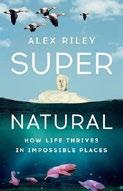
An entertaining overview of organisms that live their lives in brutal environments. That oddball life forms survive being boiled, radiated, dehydrated, or frozen is no news to many readers, but even they may sit up to learn how, given time, natural
Bob Dylan’s “art lives in the noisy encounter between words and music.”
WHAT DID YOU HEAR?
selection can do the same for familiar creatures, writes science writer Riley, author of A Cure for Darkness: The Story of Depression and How We Treat It . A camel can lose 30 percent of its body water and function normally; humans die after losing 12 percent. Desert kangaroo rats never drink and exist mostly on dry seeds, but they obtain enough water by recycling their waste products. Turtles in Canada pass months on the bottom of frozen ponds without breathing. Wood frogs in Alaska freeze solid throughout the winter. Beetles and ground squirrels in Alaska survive these months but never freeze. Using antifreeze proteins and cryoprotectants, they “supercool”—their body fluids remain liquid despite temperatures far below zero. Under Antarctic ice, fish and other sea life thrive under subzero conditions. Few natural history writers fail to warn that global warming threatens a mass extinction in these waters, and Riley too sounds the alarm. Saving “extremophiles” for later pages, he delivers vivid descriptions of spectacularly normal or amazingly grotesque creatures that live in boiling hot springs, poisonous mine wastes, the stratosphere, deep inside the earth’s crust, or miles down at the bottom of the ocean. It turns out that life itself may have originally been an extremophile that appeared almost four billion years ago on a planet without oxygen and survived on heat and toxic chemicals generated deep in the ocean as the earth’s tectonic plates pulled apart, freeing superheated magma below to mix with seawater above.
Expert evidence that life is not merely resilient, but spectacularly so.
Rings, Steven | Univ. of Chicago (360 pp.)
$29.95 | October 6, 2025 | 9780226842653

A dive into the chords, not just the words, of the Dylan canon. This an exploration of why the “crackin’ breakin’ shakin’ sounds,” as the Minnesota bard once termed them, are as important to his persona as the lyrics that most critics—and fans—focus on. Making well-argued points that sometimes get lost in academic prose, Rings, an associate music professor at the University of Chicago, breaks down the various components—vocals, guitar, harmonica—that enhance the picture. He quotes Richard Manuel of the Band dismissing Dylan’s guitar work—“he’s a strummer ”—and notes blues purists copping an attitude about his singular harmonica styles. The author occasionally references French postmodern structuralists, though his New Criticism forebears seem equally applicable to his approach, which often includes note-by-note analyses of the changes in different performances and recordings. (He also references Quora posts and other Dylan fanboy message boards in the course of these obsessive travels.) Luckily, he includes links to the snatches of songs he writes about, which should make it easier for the lay reader to follow along at home. To demonstrate the inseparability of sound and sense, Rings quotes the original notation, “Words-Music,” that Dylan used as he typed out “A Hard Rain’s a-Gonna Fall” in a borrowed
Greenwich Village apartment, refuting the urban legend that the original draft was intended to be a poem. Liner notes are not Nobel-worthy. “Dylan’s idiosyncratic sounds are not incidental to his art, a troublesome husk we can discard once we have extracted his celebrated words,” the author writes. “Rather, his art lives in the noisy encounter between words and music.” Worthy fare for Dylan obsessives and (patient) casual fans alike.
Rogers, Ruthie | Gallery Books/ Simon & Schuster (384 pp.) | $36 October 28, 2025 | 9781668055892

A high-toned tasting menu in words, celebrating one of London’s poshest restaurants. A native New Yorker who, as a teenager, learned to make Julia Child’s version of beef bourguignon (“It cracked open not just my palate, but also my mind”), Rogers co-founded the River Cafe in 1987. It started as a lunch-only place, catering to workers on the Thames wharves, but ratcheted its way up into the fine dining realm: pasta served until 11 at night, and no more stevedores, at least not ones who haven’t robbed a bank. Building on her podcast, Ruthie’s Table 4, Rogers here offers interviews with the hoiest of the hoi polloi: Paul McCartney, for one, and leading the pack, recalls how he came to be a vegetarian after looking up from his leg of lamb to watch lambs gamboling outside. Want to get to Sir Paul’s heart? Serve him his favorite comfort food, a quesadilla: “It’s like a pizza turned inside out.” Daughter Stella, who extols her late mother’s cooking, would go for tagliatelle with truffles. And as for Elton John? A bacon sandwich, “proper English bacon, not Danish, not streaky.” Some of Rogers’ customers express choices that are most definitely off the menu, such as Bob Pittman, the rural-born founder of MTV, who says, “Squirrel is my reference
meat.” Other customers—Victoria Beckham, say, who digs the cafe’s roasted sea bass, and U.S. Sen. Adam Schiff, who pines for a truly good vegan pizza—are attentive to food as health; some are less so, such as Michael Bloomberg, who confesses to a fondness for Cheez-Its. Most interesting of all are the witty Stephen Fry (“My theory about food is that certain ingredients know when you’re scared”) and food maven Nigella Lawson, who extols all food: “It reminds you that you’re alive and you’re talking pleasure, and to be grateful.”
A pleasant exercise in eavesdropping at the tables of the rich and famous.
Rosen, Jeffrey | Simon & Schuster (432 pp.) $30 | October 21, 2025 | 9781668053744
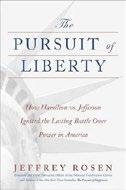
A wide-ranging study of the tense competition between Jeffersonian and Hamiltonian ideas of American government.
“If American history is a struggle between power and principle, the competing principles of Hamilton and Jefferson both constrain and embolden partisans on both sides, just as they constrained and emboldened Hamilton and Jefferson themselves,” writes political historian Rosen. His narrative begins with Jefferson and Hamilton themselves, with Hamilton declaring himself to be in favor of monarchy—meaning “a strong executive, not an endorsement of hereditary rule”—and Jefferson a commitment to a limited central government that ceded most power to the states. Jefferson so feared a president who would refuse to leave office that he proposed a constitutional limit of a single term; interestingly, Hamilton, by Rosen’s account, also feared “Caesarism,” worrying that a president “might take advantage of a
foreign policy crisis” to stay in power. Jefferson and Hamilton were also in agreement on the three principal tenets of the Declaration of Independence, namely “liberty, equality, and government by consent,” but they disagreed vigorously on how to express them constitutionally; indeed, Jefferson’s first draft of a constitution curtailed the presidency to a one-year term by an “administrator” appointed by the House of Representatives. Hamilton held a much more expansive view of executive power, urging that “we need to be rescued from the democracy.” If these concerns sound very modern, it is because they have been with us ever since, and with the same rather schizophrenic proportions. As Rosen notes, although the Supreme Court under John Roberts has Jeffersonian dimensions, Roberts himself invoked the “Hamiltonian doctrine of judicial deference to Congress” in upholding the Affordable Care Act, while the Trump administration seems to want both states’ rights and Hamilton’s “monarchy based on corruption.”
A lucid work of political history that affords an intriguing view of the nation both in its founding years and today.
Richard Avedon Immortal: Portraits of Aging, 1951-2004
Ed. by Roth, Paul | Phaidon (208 pp.)
$79.95 | October 8, 2025 | 9781837290352
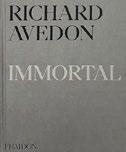
The eloquence of old age.
To accompany an exhibition at the Image Centre in Toronto and the Montreal Museum of Fine Arts, this volume of nearly 100 images represents a
particular focus of the work of eminent photographer Richard Avedon (19232004): aging. Famous for his fashion photos and celebrity portraits, Avedon takes an unsparing view of famous people in old (or older) age. Dorothy Parker, for example, was 65 when he photographed her. With deep bags under her eyes, she looks, curator Vince Aletti notes, “like she hasn’t slept or been entirely sober for years.” Aletti is among several writers providing context and commentary on the images: Others are Roth, director of the Image Centre; New Yorker writer Adam Gopnik, who was a close friend of Avedon; and Gaëlle Morel, exhibitions curator of the Image Centre. Along with an introduction, Roth contributes an informative biographical essay on Avedon’s father, Jacob Israel Avedon, the subject of Avedon’s first exhibition at the Museum of Modern Art, in 1974. The images, which document Jacob Israel’s dying from advanced liver cancer, proved controversial: Some critics saw them as exploitative, a form of patricide, while others praised the intimate photographs as “profound and moving.” Readers are likely to find some images familiar: Ronald Reagan, casting a suspicious glance; the deeply lined faces of Samuel Beckett and Stephen Sondheim. Although a few sitters looked pleased— Arthur Schlesinger, for one, looks rather self-satisfied—fewer look happy. Two exceptions are Marguerite Duras, who exudes impish joy, even as her health is declining, and a nun, Soeur Emmanuelle, who looks positively ecstatic. Rose Fitzgerald Kennedy appears resigned— perhaps to having her portrait taken, or, more likely, to old age. Capturing fragility and pain, Avedon, at the same time, honors his subjects’ dignity. A beautifully produced volume of striking images.
Capturing his subjects’ dignity in photos that tell of fragility and pain.
RICHARD AVEDON IMMORTAL
Sanderson, Caroline | Unbound (288 pp.) | $18.95 paper October 7, 2025 | 9781789652055
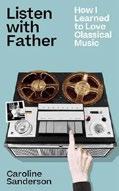
A heartfelt memoir for a father who loved music. British book journalist Sanderson begins with some reflections on her youth, her late father’s passion for classical music, and having listened to it with him. With wit, insight, and aplomb, she walks us through eight pieces, the composers’ lives, and her memories. Mozart’s Piano Concerto No. 22 in E-flat major, which he was devoted to, had her traveling overseas to visit all the famous landmarks associated with the composer. She then slides into a detailed discussion of this “grand and gentle” piece, as former Boston Globe music critic Michael Steinberg called it. The Firebird Suite was the first Stravinsky piece her father played when she was very young. She was “immediately captivated by its fiery, infernal tunes” and was a little scared and mesmerized by his Rite of Spring. Sanderson fondly recalls her father weeping to popular contralto Kathleen Ferrier’s emotional “Blow the Wind Southerly” before moving on to Brahms—one of Dad’s favorites—whose “turgid” music “failed to make an impression on me as a child.” However, she finally falls for his Symphony No. 4. Schumann’s Kinderszenen provides her the opportunity to rediscover the brooding “Träumerei” by playing it often on her own piano, but it’s three “rich and expansive” symphonies by Sibelius and a gifted trip to Finland to experience it that puts her in seventh heaven. Chopin’s “jewel-like” études, some of the last pieces her father listened to, are “ravishingly” consoling. Sanderson concludes with another of her father’s favorites,
Strauss’ tone poem, Ein Heldenleben Despite the composer’s connections to Hitler, Sanderson finds “consolation through music that has such power to provide a conduit for our troubled emotions, at times of crisis in any era.” The author’s quest has her “listen with newly opened ears to classical music”—and ready to move on. “I have cut loose from Dad’s CD collection and embarked on my own voyage of discovery.”
A musical journey will have readers scurrying off to listen for themselves.
Schreiber, Michael | Citadel/ Kensington (304 pp.) | $29.03 October 28, 2025 | 9780806543796

Life, love, and movies.
Portrait artist Don Bachardy (b. 1934) was the companion of British writer Christopher Isherwood (1904-86) for more than 50 years. “America’s most famous gay couple” in the 1970s, they inhabited a star-studded world, counting among their friends actor Simon Callow and director James Ivory, each of whom contributes an affectionate foreword to Bachardy’s candid oral history. In conversations with Schreiber, Bachardy recounts growing up in Los Angeles, enraptured by movies. He and his older brother snuck into previews, taking photographs of themselves with stars and collecting autographs from warmhearted actors like Marilyn Monroe and Debbie Reynolds. Over the years, many stars—Leslie Caron, who became a dear friend; Jane Powell (a “wounded creature”); and Natalie Wood (“stunningly beautiful”) sat for portraits. Bachardy met Isherwood in 1953, when he was 18 and Isherwood 30 years older. A student at UCLA at the time, Bachardy found in his older lover a
father figure and mentor who introduced him to literature, encouraged him to go to art school, and taught him “how to be grown up and responsible and to be somebody with a vocation who could do something in the arts, not just devour them.” Besides studying art in the U.S., he enrolled at the Slade School in London, living with Isherwood in Richard and Sybil Burton’s Hampstead house. It was at Slade, he says, that he began to hone his craft intensively. In their early years together, Bachardy reveals, they were the only openly queer couple at Hollywood parties, shocking some guests. Bachardy’s memoir is replete with vivid, sometimes dishy, reminiscences about the elite of 20th-century culture: E.M. Forster, Ingrid Bergman, John Gielgud, Lauren Bacall, Julie Harris, W.H. Auden— and scores more.
A zesty and entertaining self-portrait.
Seidule, Ty & Connor Williams
St. Martin's (368 pp.) | $29 November 11, 2025 | 9781250330284

Well-crafted portraits of the heroes whose names recently replaced those of Confederates on numerous military installations.
Seidule, a retired general and emeritus West Point history professor, could not present stronger credentials to serve on a congressional commission to replace the names of Confederates on Southern military bases—Hood, Bragg, Benning, Lee, the list goes on—with those of true heroes. “Confederates, Congress emphatically declared, deserved no place among our military commemorations,” he writes. “The votes came from all parts of the country and all
areas of the political spectrum.” Of the bases he highlights, three were named for Confederates who never served in the U.S. military, and three for incompetent officers who wouldn’t deserve the honor even if they were loyalists; another three, competent in warcraft, “used it to kill more US soldiers than any other enemy commanders ever have.” The Naming Commission found far more appropriate military personnel to honor: Fort Pickett, Virginia, formerly commemorating the feckless Gettysburg veteran, was renamed Fort Barfoot, honoring a Virginian who won the Medal of Honor in World War II; Fort Rucker, Alabama, named for a comrade of KKK founder Nathan Bedford Forrest, was renamed Fort Novosel for “an iconic army aviator” who flew 2,000 missions in Vietnam; Fort Benning, Georgia, named for an “ardent secessionist,” took the names of Hal and Julie Moore, the Vietnam hero and his wife, who “forced the hidebound army to take responsibility for casualty notification.” The renaming project met some initial resistance, Seidule allows, but most within the military and in local communities embraced the changes. One of Donald Trump’s earliest moves as president in 2025 was to order a reversion to the bases’ former names, though ostensibly to honor soldiers who just happened to share the names of those Confederates. “He chose surnames over service, stripping honors from ten true American heroes in the process,” writes Seidule. “Trump’s 2025 name switch does disservice to all those who serve.”
A sharp-edged argument for de-commemorating traitors.
Stern, Ken | PublicAffairs (304 pp.) | $30 October 7, 2025 | 9781541705012
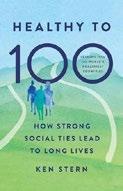
Envisioning brighter futures for us all.
During the Great Depression, researchers at Harvard University undertook an ambitious investigation to determine the sources of health and happiness in American life. The Harvard Study of Adult Development has become the longest-running longitudinal health study in American history, and it continues to unearth data that challenges conventional wisdom about what makes us thrive. As Stern, an author and host of the Century Lives podcast, writes in his eye-opening book, “the researchers have concluded that there is a formula for a healthy life. It’s not weight, exercise levels, the quality of diet, or even income that most impacts healthy longevity. It is the quality of relationships, the social fitness, you might say, of the people involved.” With this in mind, Stern embarks on a journey around the world to explore living longer and well in countries where the elderly thrive, notably Singapore, Japan, South Korea, Italy, and Spain. What he shares are deep, instructive lessons that reveal how community, purpose, learning, and connection contribute to long lives well lived. For instance, there are nearly 20,000 centenarians in Spain; that figure is expected to
Stripping honors from American heroes “does disservice to all those who serve.”
skyrocket to 373,000 within the next four decades. The country is a “gold mine” for research, Stern writes.
“The only difference researchers were able to identify between the superagers and their normally aging counterparts was that the super-agers had higher rates of social connection and lower rates of loneliness.” In Japan, the author found, “work, purpose, and health are inextricably linked”—many seniors still work in part-time jobs. “It’s rather different in the West….work is more commonly associated with stress and ill health.” South Korea and Singapore, meanwhile, have launched programs that foster lifelong learning. “All of these approaches are linked by the belief that older people are not just marking time toward an inevitable end. They are part of a generation that has important things to offer society.” Confronting social isolation, this work offers a way forward for long and meaningful lives.
Suri, Gaurav & Jay McClelland Basic Books (368 pp.) | $30 October 21, 2025 | 9781541605268
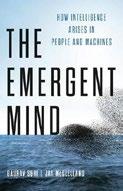
Trying to understand the human mind in the age of AI. In their compelling book, San Francisco Bay Area scholars Suri and McClelland propose a view of the brain as a neural network, where thought emerges from physical interactions among neurons. They liken the mind to a flowing river—not located in any one part, but arising from a continuous stream of activity. While no single neuron “thinks,” the network’s dynamics give rise to mental life. The authors draw parallels to modern AI systems, where emergent properties stem from interactions in network elements.
A rich explanation of how physical processes in the brain create the mind.
Blending psychology, computer science, and mathematics, Suri and McClelland present a rich but accessible explanation of how physical processes in the brain create the mind. Their activation-based view of behavior rejects explanations based on pleasure, pain, or preference. Instead, “our thoughts are patterns of activation over an ensemble of neurons in our brains.” They favor a “connectionist” model over the symbolic processing view still popular in some areas of AI. Through diagrams, analogies, and imagined Socratic dialogues between historical and fictional figures, the book examines complex questions with clarity and creativity. While they believe intelligence can emerge in both biological and artificial systems, there’s no immediate cause to worry about our futures—the authors argue that human brains still remain more flexible, adaptable, and efficient. Though AI systems are growing increasingly complex and sophisticated, they remind us that a mystery remains in how human minds truly work. Rich in insight and imagination, this is a fascinating read and a guide for deeper exploration of how researchers approach understanding human brains and designing AI systems.
A fresh and philosophical look at thinking itself, and an invitation to rethink what the mind is.

Sweeney, Victor M. | Gallery Books/ Simon & Schuster (288 pp.) | $29 October 14, 2025 | 9781668062111
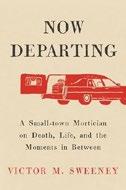
T he sentimental education of a rural undertaker in all things mortuary. “I wear many hats—ad hoc grave digger, obituary draftsman, liturgy organizer, headstone designer, community death mentor,” writes Sweeney. Young, pious, sober-minded, he opens on a rather unsettling note: the acts of embalming, sewing, applying makeup, and rendering a corpse to look as if in peaceful repose when, in fact, the death may have been quite grisly. “Half of my chosen profession is unseen,” Sweeney notes. All happens behind closed doors, in this case in a little farm town in northwestern Minnesota, where everyone knows everyone else and where a death goes noticed. Some of Sweeney’s narrative takes the form of a leisurely memoir, its pace befitting the rural setting; some of it reads like notes for a newcomer to the field: Use an “eye cap,” a contact lens–like thing with little burrs, to keep a customer’s eyelids from popping open—disconcerting indeed during a viewing—and keep the corpse’s mouth closed, against the old custom of leaving it open for a “natural, rested look”; if need be, suture the jaws or tie teeth together. Sweeney is candid about what brought him into
the funeral business: He had good people skills (to communicate with the living, that is), he wanted meaningful work, and “he wanted a job that scratched the clerical itch, but also provided an income.” Bingo. Sometimes tending toward the preachy but seldom going far over the line, Sweeney writes of his work as a way of helping the web of life during “one final last moment of beauty before the thing held in its center fades from view,” which seems a noble thing indeed. Sweeney’s prose is pedestrian, but his account will satisfy the curiosity of anyone who wonders just what goes on beyond those closed doors.
Morbid, occasionally unpleasant, and a touch too earnest, but an evenhanded look at the end of life.
Tobia, Jacob | Harmony (320 pp.) | $30 August 26, 2025 | 9780593797945

Advocating for a sea change in how we view men and masculinity.
Tobia, a self-described “hairy nonbinary lady,” writes that “men and boys are now the ones suffering the most under the gender binary.” This is because men and boys, the author argues, have the fewest tools and opportunities to understand the ways in which masculinity has damaged them. Tobia presents a series of potential ways to help men heal. Positing that “being a man isn’t a privilege,” they contend that we should all help men heal their gender-based wounds by, among other suggestions, swapping the term “toxic masculinity” with “icky gender,” cultivating communal safety practices, and eliminating the term “male privilege” from our vocabulary. “When we reductively
say that men are privileged and women are not,” Tobia writes, “I’m concerned we’re implying that men’s lives are easy and women’s lives are not.” These statements, like so many in the book, reveal a fundamental misunderstanding of the difference between the structure of power and individual experiences. While some of the author’s arguments are sound—a chapter in which they make sense of their traumatic reaction to their father’s tragic death to make a trenchant argument about the value of collective care and protection—overall, they undermine their own important thesis by failing to effectively connect hierarchies of oppression with people’s experiences. Tobia’s exuberant narration and witty asides are not enough to overcome the book’s circular, confusing reasoning and weak theoretical foundations. A manifesto about masculinity that fails to live up to its promise.
Trocmé, André | Trans. by Patrick Henry & Mary Anne O’Neil | Plough (480 pp.) | $29.95 paper September 23, 2025 | 9781636081595
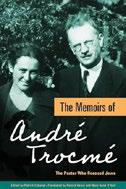
Everyday heroism.
Trocmé (190171) was a French Protestant pastor who aided in the saving of Jewish families during the German occupation of France in the 1940s. His memoir, written in French in the 1950s and ’60s, records
not only the heroic actions of his community but also the complications of Protestant life in a largely Catholic country. Trocmé’s activities grew out of a larger commitment to Christian pacifism and cons cientious objection, a tradition central to a strain of French religious leadership in the 20th century. These memoirs tell a story of spiritual growth, framed in the landscapes of world war and social upheaval. Trocmé makes much of how the First World War drew him out of his “childhood apathy.” He illustrates how the ironbound traditions of French education fostered a culture of obedience that often led to military and political conformity. He writes vividly of everyday life that few American readers know. His wars and worries play themselves out in village streets and church aisles. Families and classmates build communities of belonging. He always tried to “stick to my beliefs.” And yet, “I feared my own weakness.” With the advent of the Second World War, Trocmé reflects on the nature of moral choice. “We do not decide to be nonviolent or truthful in advance as if we had an outline, a moral blueprint to follow automatically. Events appear almost always as a series of little, unexpectedproblems we must solve one at a time. We choose between two alternatives, one of which, in the final analysis, appears closer than the other to the laws of Jesus Christ. In that moment, one is sure of nothing.” Trocmé’s story, available in English here for the first time, teaches us how to act when we are sure of nothing.
A unique addition to the literature of ethical action during the Holocaust.
“I don’t like writers who fancy themselves dandies”—namely Tom Wolfe.
Updike, John | Ed. by James Schiff Knopf (912 pp.) | $50 | October 21, 2025 9780593801543
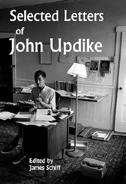
Missives from the mountain. Updike was the great American pastoralist of the 20th century. In scores of stories, novels, essays, and poems, he limned the contours of middle-class suburban calm, literary taste, and the recognition that underneath the glossy surfaces of American success lay the insecurities of ambition and desire. Updike was also a prolific letter writer. He wrote to everyone, from famous writers and politicians to librarians and family members. “I can’t believe that you’re cutting ‘Spider-Man,’” he wrote in a letter to the editor of the Boston Globe in 1994; after the letter, the Globe reinstated the comic strip. Books are never far from Updike’s purview. A letter to the novelist John Irving from 2000 commends him on his negative review of Tom Wolfe’s novel, A Man in Full : “I don’t like writers who fancy themselves dandies.” Modern readers may find Updike too unapologetically masculine these days. He shared with Irving and Norman Mailer a persona of the American writer as big man on campus: “You’re wise to hold to your mountain.” Of the writer Phyllis McGinley, he wrote in 1958: “She seems to have a firm grip on the minds of thousands of housewives.” In 1960, he wrote to the publisher Alfred A. Knopf that his novels sought “to present an image of an averagely physical young American.” He resisted censorship, feeling that to cave to it would be “to funk my job.” At times, though, he can be dead-on in his judgments: “I feel in general that literary history is too much modelled on biology when it is really more like geology.
There is not much evolution; there is a great deal of accidental thrusts and upheavals and whatnot and when it’s all over a map is drawn.” Updike may no longer be the mountain he once was. But his letters draw a map of where we once were. A sprightly and revealing collection by the writer who captured postwar American life, love, and loss.
Weitzman, Yaron | Doubleday (320 pp.) $30 | October 21, 2025 | 9780385550222

Backstage with a marquee basketball franchise and its ageless icon.
Experienced NBA reporter Weitzman pens a solid work of narrative journalism about the evolution of basketball’s biggest star and the battle for front-office control of the team he guided to a championship in 2020. Forty-yearold LeBron James is, by acclamation, the game’s most intelligent player, and Weitzman skillfully shows how the player’s hardwood acumen is complemented by a systematic approach to wielding his influence. The broad outlines of this story, concerning James’ professional partnership with agent Rich Paul, aren’t new. Weitzman, though, adds fresh details on relatively overlooked aspects of James’ career. James had once hoped, in his words, “to keep athletics and politics separate,” but in 2020, when police killings of unarmed Black people were followed by nationwide protests, he became an outspoken voice for social justice. Seeking “results, not just rhetoric,” Weitzman writes, James founded a voting rights nonprofit that recruited thousands of volunteer poll workers. Meanwhile, he and other players successfully pressured team owners to use NBA arenas as polling sites.
Could the wind be diminishing? Is the world in the grips of a “Great Stilling?”
THE BREATH OF THE GODS
As a teammate, however, James isn’t always so fair-minded. Weitzman notes instances in which James played halfhearted defense, scapegoated young teammates, and effusively praised another team’s coach when his own coach’s job was in jeopardy. Some of this will be familiar to close followers of James’ social media posts, but Weitzman does a fine job of documenting how James’ “passive-aggressive swipes” are themselves expressions of power. Weitzman opens the book with a solid account of the widely covered succession battle after the 2013 death of longtime Lakers owner Jerry Buss. More memorable are his anecdotes about lackadaisical players, team gambling sessions, and shouting matches between coaches and fading stars—fun tidbits that show how teams work, and don’t. Perceptive reporting on a transcendent athlete’s methodical power moves.
Kirkus Star
Breath of
Winchester, Simon | Harper/ HarperCollins (432 pp.) | $35 November 18, 2025 | 9780063374454

A history of the world, with wind as the main character. Known in Sumerian language as “lil,” in Chinese “feng,” Japanese “kaze,” and Hebrew “ruarch,” wind has been defined simply as air in
motion, but it finds its way into all aspects of life on Earth. “It warms and chills, it builds and creates, it ruins and destroys,” acclaimed author and journalist Winchester writes. “But only wind’s consequences are visible.” He starts off this epic tome with a question: Could the wind be diminishing? Is the world in the grips of what some describe as a “Great Stilling,” as world wind speeds decline? Throughout the book, Winchester deploys artful descriptions of wind and its inclusion in literature, global commerce, and climate change. His recounting of a lull known as the doldrums, from the Dutch word for “dull,” vividly depicts the unsettling experience of unbearable calm on the open seas. Winchester visits places on Earth where sands sing as grains jostle against one another, takes readers into the inner workings of a Dutch windmill, explores the use of wind as fuel, and describes cyclones so aptly that you feel you are right in the midst. He considers how different things might have been, had the wind blown in a different direction, such as during the Chernobyl nuclear disaster. The prevailing southeasterly winds made its effects immediately detectable in Scandinavia. Spring westerlies instead would have spread the radiation plume over Soviet territory, where Moscow might have concealed it from the world. Winchester brings depth to the history of the wind, occasionally weighing in with opinions. He describes the early-20th-century eugenicist professor Ellsworth Huntington as “a thoroughly discreditable fellow,” but he sides with his argument for climactic determinism, which is that the
cleverest and most civilized people lived in places where weather was varied and posed constant challenges. Winchester concludes that the prospect of the wind dying down on a global scale as the climate warms is less prominent now than when he started the book. “A world without wind is just too dreadful to contemplate,” he writes.
A splendidly written account of an unseeable force.
Woodham, Doug | Thames & Hudson (296 pp.)
$34.95 | October 14, 2025 | 9780500030691

How an artist became a superstar. Woodham, an advisor to art collectors and institutions, draws on more than 100 interviews for a perceptive examination of the life, art, and legacy of Jean-Michel Basquiat (1960-1988). Of Puerto Rican and Haitian heritage, Basquiat had a troubled childhood, marked by a near-fatal accident when he was 7, requiring a long hospitalization; the breakdown of his parents’ marriage; and his mother’s mental fragility, which led to his being raised by his strict father. A wild, defiant teenager, he dropped out of high school and left home at 18, spending his days “idle and stoned” and his nights at New York City clubs. In 1981, when a friend included some of his drawings in an exhibition at the future MoMA PS1, he attracted the
attention of gallerists. Soon, his “raw, frenetic” paintings found buyers. In the roaring art market of the 1980s, Basquiat became famous. Black, pansexual, flamboyant, he fit the image of a tormented, brilliant artist. “Celebrity happens,” Woodham observes, “when who you are and what the world wants converge.”
Woodham portrays Basquiat as a man with a “ravenous appetite for new experiences”; intensely competitive, he “wanted to be known as one of the great artists of his generation.” Drugs undid him, though: He died of a heroin overdose at 27, leaving 1,000 paintings and 2,000 drawings. Woodham offers an insider’s look at the business of art, revealing the aesthetics and motivations of Basquiat’s early and posthumous collectors; the gallery owners who represented him; and the economic, cultural, and social forces that shape taste and monetary value. Basquiat’s legacy, including sales, exhibitions, and licensing, has been tightly controlled by his father, who refused permission to reproduce Basquiat’s work for this book. An insider’s look at an artist’s world.
Zambreno, Kate | Transit Books (120 pp.) | $17.95 paper September 16, 2025 | 9798893380200
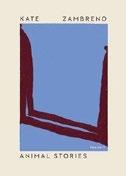
Cages of the imagination. What makes us human? Should we look inside ourselves, study social groups, and meditate on the past? Zambreno has a different
An artist who died at 27, leaving 1,000 paintings and 2,000 drawings.
JEAN-MICHEL BASQUIAT
answer. In this eloquent collection of essays, the novelist and essayist argues that we find ourselves in the mirror of animals. Stories about visiting zoos intertwine with reflections on primatology and photographs of creatures. A Victorian snapshot of children riding an elephant prompts this rumination: “Perhaps [it situates] the Eurocentric nineteenth-century zoo attitude, a narrative of colonialism and alienation from labor (absent while present), a story of tragedy and absurdity, the only possible tonal registers for the history of capitalism.” Zambreno offers up what they call a bestiary—evoking those older medieval collections of moral tales of animal behavior. Each essay becomes a kind of social allegory. In a section on the work of Franz Kafka, the author sees his famous Metamorphosis as a story of humanity lost in the face of modern, bureaucratic life. Gregor Samsa wakes up to find himself transformed into a monstrous insect. That moment is the lens through which we are invited to see Kafka in the large—a man living always with the animal inside him. A photograph of Kafka and a girlfriend and a dog becomes an emblem of a search for contact, for companionship that humans cannot offer the creative writer. Zambreno writes in the wake of W.G. Sebald, whose autofictions about photographs and found things live in the penumbra of postmodern alienation, and of Hugh Raffles, whose Book of Unconformities gives us an encyclopedia of uncanny objects. Zambreno’s is less a book about animals or other humans than it is a tour of the zoo cages of the writer’s own mind, opened for all of us to gaze on and gasp.
Lyrical meditations on the creative imagination and the animal in all of us.







“An engrossing account of the people and antics that de ned the Tassajara monastery in 1967.”
KIRKUS REVIEWS

“All my students study [David Chadwick’s] books.”
NATALIE GOLDBERG, author of Writing Down the Bones
“For those who care about the genesis of Tassajara and Zen in America, this is a fun read. David serves up a rich well of details and memories and a window into a very creative time.” JACK KORNFIELD, author of A Path With Heart





Author of We Survived the Night
IT’S BEEN A groundbreaking year for Julian Brave NoiseCat. Earlier in 2025, Sugarcane, the film he co-directed with Emily Kassie, was up for an Academy Award. The documentary feature didn’t end up winning an Oscar, but NoiseCat, a 32-year-old member of the Canim Lake Band Tsq’escen, is the first Native filmmaker ever to be nominated. Now Knopf is set to publish his first book, We Survived the Night, a memoir that Kirkus, in a starred review, calls “thoughtful, informative, often entertaining, and just as often saddening…a book to remember.” NoiseCat answered our questions by email.
Tell readers, briefly, what We Survived the Night is about. At its core, the book is a family story about my father, his father, and myself. Told in the style of a Coyote story—a traditional narrative about the epic misadventures of my peoples’ rabble-rousing trickster forefather, a great creator and destroyer who makes and unmakes the world—the book interweaves memoir and mythology with hard-hitting on-the-ground reporting from Indigenous communities across North America into a dynamic portrait of contemporary Indigenous life.
Would you say something about the significance of the title?
“We survived the night” is the English translation of tsecwínucw-kuc, the traditional way to give the morning greeting in Secwepemctsín, an
Indigenous language with just two remaining fluent speakers—my kyé7e (grandmother) and her sister—on the Canim Lake Indian reserve, the rez my family calls home in British Columbia, Canada. My kyé7e, who taught me our language, used to drink from a mug with “tsecwínucw-k” printed on the side. I often wonder what it meant for our ancestors to greet one another and the day with the simple yet profound acknowledgment. And then I chuckle at the Indian sense of humor that emblazoned that solemn word on Kyé7e’s cup.
What inspired you during the writing of the book?
Lots and lots of Coyote stories collected in dusty old ethnographic texts by the anthropologist James Teit, as well as more recent ones recorded and transcribed by Randy Bouchard and Dorothy Kennedy in Lillooet Stories and The Lil’wat World of Charlie Mack. St’at’imc storytellers’ oral histories are also held in the Royal BC Museum and Archives in Victoria, where I traveled to listen. Ron and Marianne Ignace’s Secwépemc People, Land, and Laws was also an invaluable source, as were the many rez legends and tall tales spun around Indian living rooms by my aunties, uncles, dad, and others. Our people are world-class bullshitters and first-rate truth tellers.
Where and when did you write We Survived the Night ?
I moved in with my dad, a Secwépemc and St’at’imc artist with whom I’ve had a complicated




We
NoiseCat, Julian Brave Knopf | 432 pp. | $29 October 14, 2025 | 9780593320785
relationship ever since he left our family to chase alcohol and art-world fame when I was a little boy. For two years we were roommates in the little Washington state Navy town where I still live, sleeping across the hall, cooking each other breakfast, making art, trading stories, and repairing our formerly fraught relationship. After nights hanging out and playing games like cribbage and dad’s favorite, bong-hit Scrabble, I would sit down at my laptop and write what I learned: about dad, our relationship, our people, our tricksterly ways, our trickster’s world, and myself.
Interview by Tom Beer.

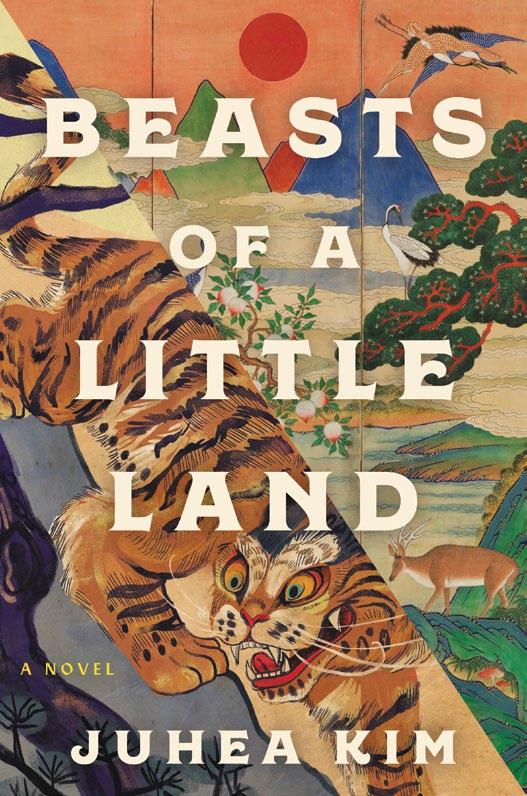



COVER HERE:

Align right edge of book w/ ISBN banner edge (point)



Narrative Nonfiction

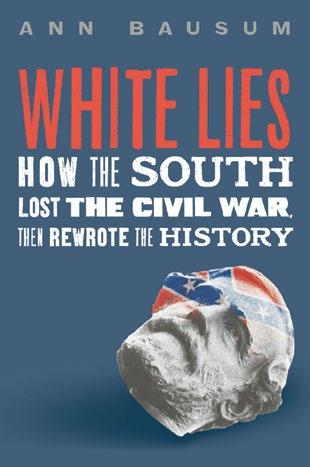

ISBN: XXX-X-XX-XXXXXX-X CALL TO ACTION HERE: *Can Use *CHICAGO STYLE* Title Case or ALL caps for CTA*

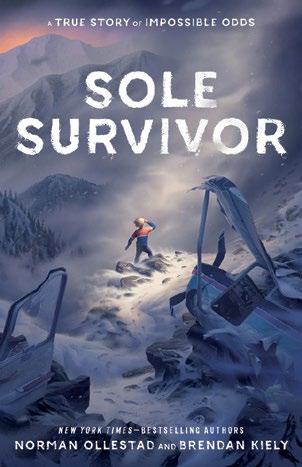

A rambunctious kitten takes a walk on the artsy side, a Filipino preteen sees dead people, and rockers Pat Benatar and Neil Giraldo wax rhapsodic about their most rewarding role yet—devoted grandparents. The books publishing this fall are a vibrant, eclectic bunch. Here, young readers will find enchanting stories from established talents—among them Newbery Medalists Erin Entrada Kelly and Donna Barba Higuera, two-time Kirkus Prize winner Derrick Barnes, and the late Maurice Sendak—as well as future classics. Read on for a true literary bounty.
A moody, poetic study of a brilliant yet oft-misunderstood creature.
Kirkus Star
Barnard Booth, Leslie | Illus. by Alexandra Finkeldey | Chronicle Books (44 pp.) | $18.99 September 9, 2025 | 9781797226156

What’s it like to be a crow?
Many regard corvids as harbingers of doom—a stereotype that belies their rich sense of community. As this fascinating and edifying work notes, crows look out for each other by traveling in groups and are intensely aware of their surroundings; indeed, they have more going on than your average bird. Narrated in the collective first person by a murder of crows (“I am not I at all”), Barnard Booth’s verse flows beautifully, slinking across the page with a determination that mirrors the intentionality of her feathered subjects:
“I spill across the sky like ink— / fill the night with jagged cries. / I have one thousand eyes. / I see all. / Know all. / Am all.” Finkeldey’s inky art depicts landscapes both urban and rural, set against backdrops of deep grays, blues, blacks, and orangey pinks, providing close-ups of individual animals, along with breathtaking aerial shots of the crows resting on a sturdy tree. On a particularly inspired and entirely unexpected spread, several crows dissolve into a cape worn by a cackling figure in a pointed hat: “Caw-caaaaw! / We must sound like witches to you.”
Both text and art set an intriguingly ominous tone even as the book establishes crows’ commitment to cooperation and communal living;
readers will eagerly dive into the generous backmatter.
A moody, poetic study of a brilliant yet oft-misunderstood creature. (further information on crows, author’s note, sources) (Informational picture book. 4-7)
Benatar, Pat & Neil Giraldo | Illus. by Tiffany Everett | Sourcebooks Jabberwocky (40 pp.) $18.99 | September 9, 2025 | 9781728298023
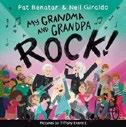
Rock legends, husband-and-wife team, and proud grandparents Benatar and Giraldo present an upbeat ode to families.
A youngster with long blond hair confides conspiratorially, “This might come as a bit of a shock, // but my grandma and grandpa…ROCK!” The silver-haired duo—who resemble the co-authors—jam out in a practice space; Grandpa strums an electric guitar, while Grandma belts out a tune, microphone in hand. (All three are pale-skinned.) Jagged star strokes burst from the amps, reverberating across the page. As the young narrator sings the praises of these hip, artistically minded grandparents, the illustrations depict many varied, diverse families making music. One grandparent strums a ukulele, another prefers the drums, and an especially eclectic granny croons everything from lullabies to Led Zeppelin while cooking. There’s no wrong way to share joy with grandparents. Benatar and Giraldo acknowledge that you don’t have to be a musician to rock (“Anyone can rock! / It’s a state of mind, / like feeling happy or being kind”) as they speak to other passions and occupations (“They can be
a plumber, a chef, a pilot, a teacher”). One spread showcases other names for grandparents, both colloquial and cultural, presented without disrupting the text’s rhythm. As expected, this pair lays down a steady beat with a smooth flow. Everett’s energetic art, with musical swooshes and swirls, buoys the text. A fresh, melodic take on family harmony. (Picture book. 3-6)
Blake, Quentin | Candlewick Studio (64 pp.) $19.99 | October 7, 2025 | 9781536245080
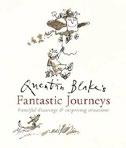
A n intimate peek into the sketchbook of a legendary author/illustrator.
An introductory note makes clear that while Blake is drawn to pet themes and personally salient motifs, readers should expect to find neither thesis nor throughline connecting the vignettes ahead. Instead, the eight sections that follow are entirely unrelated to one another, each filled with images that invite onlookers to both occupy the world as it’s been reimagined and construct its context. In “Trip Hazards,” clumsy bumblers topple mid-fall across four full-page spreads, while “Ten Things You Really Cannot Manage Without” features slice-of-life essentials like a “beach hut” and a “useful box.” “Deliveries From Elsewhere” features suitably off-the-wall scenarios (characters ride grotesque monsters or pilot flying machines), whereas those in “Feet in the Water” prove perfectly ordinary. An art exhibition of sorts, this work is an introspective companion to the myriad others Blake has built his storied career on; the contents of this volume range widely, sometimes silly, often weird. Done in scribbly pen and ink over muted watercolor, his signature illustrations suit the sinister undercurrent that thrums drolly beneath his unique brand of oddball whimsy. As ever, this artist promises creative and madcap catastrophe, but readers can rest assured—the turn of each page offers unexpected (if
occasionally macabre) delights, and the disagreeable stuff occurs squarely offstage. An aptly named exercise in imagination. (Picture book. 6-12)
Charles, Tami | Illus. by Bryan
Collier Orchard/Scholastic
(40 pp.) | $18.99 September 16, 2025 | 9781338752052
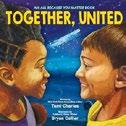
In celebrated creators Charles and Collier’s latest collaboration, affirmations abound and differences transform into points of connection. The newest title in this series—which includes All Because You Matter (2020) and We Are Here (2023)—opens with a diverse group of schoolchildren on a field trip to the planetarium. As they marvel at the celestial bodies above them, Charles weaves spellbinding verse about the Big Bang: “A mighty, mighty force…bringing us / feet bound to the ground…together… // You and me— / born of stars, / stories, / and dreams / big enough / to shake up / and WAKE UP / the whole universe!” Shifting between second-person, first-person singular, and first-person plural points of view, her propulsive words assure readers of the power of their voices, their capacity for stirring up “good trouble,” and their myriad talents—and emphasize that while we individually possess great abilities, we are all better together. Mesmerizing as always, Collier’s signature collage illustrations underscore that much-needed message, depicting the exuberant kids romping amid sumptuous planetary backdrops and gazing down at a map of the Earth. As in the other titles in this empowering series, overlapping leaves featuring colorful patterns or slivers of people’s faces appear throughout, creating an eye-catching visual motif.
A lushly illustrated, uplifting work that beckons us to unite around our common humanity. (author’s and illustrator’s notes, glossary) (Picture book. 4-8)
Colón, Justin | Illus. by James Rey Sanchez Disney-Hyperion (40 pp.) | $17.99
November 18, 2025 | 9781368099844

A mischievous marsupial runs for elected office. Carl, introduced in Impossible Possums (2024), returns with a fresh scheme: He’s going to become mayor, and from there, “I’ll use my new power to take over the world. MUAHAHAHAHA!” His sidekick, Philbert the penguin, is delighted to get down to business swaying human voters. Initial tactics include sloppily drawn signs and a “meat and greet.” But soon Carl decides that “desperate times call for desperate measures.” He’ll give his constituency what they want, gauging their contentment on his “happy-o-meter.” Things quickly go wrong; Philbert, who has an Amelia Bedelia–esque grasp on what his boss wants, delivers the humans “guppies” instead of puppies and “mice cream” rather than “ice cream.” And turns out, the “happy-o-meter” is a “panic-o-meter.”
When Carl accidentally presses the red button, he blows his cover, and the community is horrified to discover that the candidate is in fact a possum. Readers might be confused, since Carl was actively meeting voters earlier in the story. Still, they’ll enjoy the ride. With his perpetually arched eyebrows and clad in a three-piece suit (with a fish for a tie), Carl oozes sleaze as he glad-hands and kisses babies. Rey Sanchez’s speech bubbles and digital illustrations feel like screenshots for an animated film; rife with zany energy, they’ll appeal to those making their first forays into comics.
Fans of chaotic humor will be pleased as punch. (Picture book. 4-7)

Kirkus Star
Cooke, Sam | Illus. by Nikkolas Smith Little Bee Books (32 pp.) | $19.99 September 2, 2025 | 9781499816150

Acclaimed artist Smith honors Cooke’s legendary song with 1960sinspired art.
A Black child spies a camera floating on a plank in the river near the shack where he lives, and when he grows up and migrates to a city, he brings the camera with him. Paired with lyrics from Cooke’s song—long considered a Civil Rights Movement anthem—scenes of urban life follow: signs proclaiming segregation, the funeral of Medgar Evers (an activist murdered in 1963 Mississippi), Lyndon Johnson signing the Civil Rights Act of 1964 into law as Martin Luther King Jr. looks on, people gathering for the March on Washington, a re-creation of a photo depicting Malcolm X and Muhammad Ali sitting at a lunch counter, and other milestones in the fight for racial justice. The man with the camera is present at many of these moments; a touching final spread portrays a Black child looking through photographs of those very scenes. Smith’s signature painting style lends energy to the pages with formidable linework, superb use of darkness and light, and strong compositions, inviting readers to linger, parse the images, and discuss what’s going on. Less a read-aloud and more a window into history, this work offers a rich opportunity to introduce the topic to young people through art, music, personalities, events, and emotions, over multiple exposures. Detailed backmatter supports comprehension.
Potent and deeply moving. (note from the estate of Sam Cooke, illustrator’s note, featured historical events and figures, QR code linking to a recording of “A Change Is Gonna Come”) (Picture book. 4-8)
paean to both the space program and a noteworthy artist.
LIFTOFF!
Kirkus Star
Liftoff!: How the Apollo Moon Missions Made
Alma Thomas’s Art Soar
Crews, Nina | Millbrook/Lerner (32 pp.)
$19.99 | November 4, 2025 | 9798765643471

The 1969 Apollo 10 mission—considered the “dress rehearsal” for Apollo 11 and the moon landing— inspires Alma Thomas, a Black abstract painter, to create an iconic painting, Snoopy Sees a Sunrise. Though space travel is serious business, the astronauts give their spacecraft playful nicknames. Apollo 10 ’s command module is dubbed Charlie Brown and the lunar module, Snoopy. Accordingly, Alma selects a fitting name for her work. Jacket art and endpapers artfully introduce the dual narrative; against the black of deep space float bright, confettilike shapes representing Alma’s signature “stripes.” Skillfully employing mixed-media and handmade scans, Crews uses different styles for each story. As the astronauts prepare for launch, the art looks fairly straightforward; as Alma prepares to paint, the palette turns colorful, with softer, rounded lines. The spare but informative text moves effortlessly between the parallel stories of the moon mission and Alma’s painting. Even the description of abstract expressionism (“Thomas…takes in impressions that she observes and then expresses those things in a picture”) is clear and age-appropriate. Crews’ visually arresting design takes advantage of the dramatic vistas seen by the astronauts: The lunar module hurdles around a tilted gray moonscape, and when astronaut Thomas Stafford
exclaims, “You ought to see it up here,” multiple vintage TVs display images of the fragile and beautiful Earth. By contrast, Alma Thomas’ interpretation is one of glowing colors surrounded with a pink wash of early morning. A powerful paean to both the space program and a noteworthy artist. (biography of Thomas, history of the Apollo program and its tradition of selecting mascots, photographs, source notes, bibliography, further reading) (Informational picture book. 5-10)
Kirkus Star
Diffee, Matthew | Neal Porter/ Holiday House (48 pp.) | $18.99 September 30, 2025 | 9780823458714
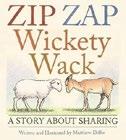
In New Yorker cartoonist Diffee’s children’s book debut, animals unite after a barnyard spat draws an unusual mediator.
“The cow says ‘Moo.’ The horse says ‘Neigh.’” But what begins like a primer takes a quick turn when “the sheep says, ‘Baa’” and the goat also claims the sound as its own. No matter that the sheep said it first—“I’ve said baa since I was a kid,” retorts the indignant goat. The dog offers a diplomatic solution that just generates more drama as the barnyard animals become understandably possessive about their signature sounds. The sheep decides to “think of something that no one has ever said” and, after much pondering (and a little pooping), proudly lands on an extended version of the
wacky titular catchphrase. “No one says that, right?” Wrong. A pint-size pink alien whizzes in to claim the phrase and suggests a civil compromise—though, as it turns out, the extraterrestrial can’t quite practice what he preaches. Wax and pleasingly shaded colored pencil art on tawny pages features deftly expressive animals in otherwise spare, earnestly pastoral scenes that contrast with the wryly funny plot. The characters’ nonchalant rapport is well conveyed, with text rendered in a clean serif font of varying scale for added visual oomph. Clever humor and a fresh take on a seemingly familiar scene make this a widely appealing, expertly paced, and wonderfully silly read-aloud. Unexpected and delightfully absurd. (Picture book. 4-8)
Fang, X. | Tundra Books (48 pp.) | $18.99 October 14, 2025 | 9781774882009

After accidentally breaking a relative’s treasured possession, a child worries about facing the consequences. While playing with Mimi the
cat, Mei Mei, a youngster of Chinese descent, bumps a table and smashes a cup belonging to Ama (Grandmother). Mei Mei runs off, terrified. But Ama isn’t mad; she blames the incident on Mimi and sets about serving tea. Will Mei Mei get away with it? No, Mei Mei’s guilty conscience makes enjoying Ama’s cake impossible, especially with Mimi’s accusing stares. Mei Mei runs off to hide in the closet. When the youngster finally comes clean, Ama reveals that she has a talent for fixing things. She points out that “every patch and every repair tells a story.” Her favorite cup now has a rich story to tell. Fang’s digitally colored pencil artwork uses an innovative mix of compositions to advance the narrative’s emotional arc. Mei Mei’s vivid
imaginings (“What if Ama yells at me? What if Ama kicks me out?”) are depicted in panels, while well-placed close-ups and dramatic perspectives capture the child’s inner turmoil with cinematic flair; an especially effective scene intercuts Mimi’s silently judgmental face with images of the cake. Laudably, Fang makes room for both laugh-out-loud humor and moments of genuine empathy; rife with homey details, her softly rounded illustrations exude warmth. A common childhood experience, conveyed with an uncommon mix of sensitivity, mirth, and heart. (Picture book. 4-8)
Kirkus Star
Guojing | Random House Studio (40 pp.)
$18.99 | September 16, 2025 | 9780593709054
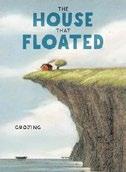
A family faces change with true ingenuity. Residing on an isolated cliff in a tiny red house, a couple spend their days fishing, dreaming, and watching the seasons pass. Soon they’re joined by a new companion, a baby whom they nurture year by year, sharing their love for moonlit nights and dolphin watching. As enchanting as their life is, the water that surrounds them is slowly, steadily rising, threatening to swallow their home, once far above sea level. With bravery and trust, the trio build a raft and transport their dwelling to higher ground, where waiting inhabitants hoist it into a peaceful green meadow. This enticing story is told wordlessly, with painterly landscapes providing the perfect setting for tender, intuitive interactions among a small cast of characters. As with much of Guojing’s work, a clear line connects this intimate tale to real-life societal challenges—in this case, the troubling consequences of climate change. And, like Guojing’s other books, the
narrative is woven through with an unassailable belief in human goodness, the importance of family and community bonds, and the ineffable beauty of the fleeting world. All of this is adeptly communicated within the space and simplicity of a picture book without feeling overwhelming or overwrought. The couple and their child are dark-haired and pale-skinned. A hopeful vision of love and persistence in the face of peril. (Picture book. 4-8)
Himmelman, John | Abrams Appleseed (40 pp.) $16.99 | October 7, 2025 | 9781419776809
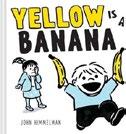
In Himmelman’s clever exploration of how young minds categorize the world, two siblings engage in a hilarious battle of semantics as they name colors and objects.
The premise is elegantly simple. Pointing to a fruit, one child insists, “That YELLOW is a banana,” while the other corrects with, “This BANANA is yellow,” launching a color-naming comedy that spirals delightfully out of control. (“This RED is an apple.” “No, that apple is RED.”) Spare, clean lines and a deliberately limited palette allow each featured hue to pop against white backgrounds. The visual storytelling shines in the characterizations of the two siblings. The younger child’s unconventional color naming drives the older one to distraction; the elder kid’s mounting frustration is brilliantly conveyed through body language and hair, which transforms from a neat ponytail into an increasingly frazzled explosion of tangles. The bare-bones artistic approach mirrors the straightforward text, creating space for preschool humor to flourish. A funny concept book is rare; even rarer is a funny concept book that generates chortles from both adults reading it aloud and the children in the audience.
Young readers will recognize the authentic sibling dynamic and giggle at the linguistic confusion, while adults will appreciate the subtle lesson about perspective and language development. The repetitive structure builds comedic momentum, culminating in a satisfying resolution when both children finally come to an agreement. The kids have skin the white of the page.
A winningly simple concept executed with precision—perfect for preschool lovers of silly wordplay. (Picture book. 3-6)
Hrab, Naseem | Illus. by Kelly Collier Owlkids Books (40 pp.) | $18.95
October 14, 2025 | 9781771476720
Series: Snail & Stump, 3
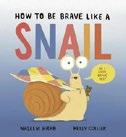
Courage doesn’t always show itself in obvious ways, as Snail and best friend Stump demonstrate.
“I’m the kind of brave that’s kind of brave,” proclaims Snail, facing up boldly to anything that’s, well, not too noisy. But his courage fails when it comes to constructing properly made paper airplanes for a contest, because he’s afraid of asking for help and making mistakes. That’s why it’s good to have a friend like Stump, who “holds Snail’s feelings as carefully as he folds paper airplanes” while coaching him to a win. But wait… Stump, too, has entered the contest, and losing has left him with “prickly thoughts.” Time for Snail to rise to the occasion in return and, holding Stump’s feelings with equal care, show him how to write them down on a paper airplane and send them sailing away. Exaggerated expressions on the friends’ googly-eyed faces in Collier’s simply drawn illustrations make the emotional ups and downs apparent even for very young viewers in this third outing featuring a quiet-loving snail and his rooted, rambunctious neighbor. Hrab makes one lesson explicit at the end: “Sometimes, being brave just means telling your friend how you really feel.” Another, perhaps profounder
message is embedded in seeing how these two true superheroes are sensitive to each other’s emotions and willing to support each other as needed.
Folds deep themes into simple words and pictures. (Picture book. 5-8)
Huh, Jungyoon | Illus. by Myungae Lee Trans. by Aerin Park | Eerdmans (40 pp.)
$18.99 | September 23, 2025 | 9780802856494
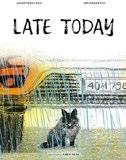
An everyday hero comes to the rescue of a frightened feline. It’s rush hour in Seoul, and bumperto-bumper traffic has turned passing lanes into parking lots and drivers into drones. A kitten— tiny, frazzled, and soaked through by lashing rain—wends her way through the gridlock, desperately dodging disaster as passersby look on. The onlookers tacitly make their attitude clear: This situation is cause for concern but not worthy of anyone’s bother—a problem certainly, but someone else’s to solve. Yet when the frantic feline disappears from sight, one commuter resolves to act, shaken from the apathy of diffused responsibility and undeterred by the symphony of honks that resound from neighboring vehicles. A nameless driver screeches to a halt, dashing from a sedan’s dry warmth and nabbing the imperiled animal just in time for the clouds to break and traffic to dissipate. This small act of heroism—and the inconvenience it entailed—was well worth the delay. Understated and straightforward, Huh’s narrative, translated from Korean by Park, brims with profound truths about the outsize impact of everyday braveries in the face of normalized inaction, while Lee’s illustrations, in doodlelike pastels and colored pencil, complement the message beautifully. Dynamic compositions— close-ups, overhead shots, use of panels—convey drama and tension.
A quiet yet masterfully rendered reminder that decency is always worth the hassle. (Picture book. 4-8)
King, Stephen | Illus. by Maurice Sendak Harper/HarperCollins (48 pp.) | $26.99
September 2, 2025 | 9780062644695

Existing artwork from an artistic giant inspires a fairy-tale reimagination by a master of the horror genre.
In King’s interpretation of a classic Brothers Grimm story, which accompanies set and costume designs that the late Sendak created for a 1997 production of Engelbert Humperdinck’s opera, siblings Hansel and Gretel survive abandonment in the woods and an evil witch’s plot to gobble them up before finding their “happily ever after” alongside their father. Prose with the reassuring cadence of an old-timey tale, paired with Sendak’s instantly recognizable artwork, will lull readers before capitalizing on these creators’ knack for injecting darkness into seemingly safe spaces. Gaping faces loom in crevices of rocks and trees, and a gloomy palette of muted greens and ocher amplify the story’s foreboding tone, while King never sugarcoats the peach-skinned children’s peril. Branches with “clutching fingers” hide “the awful enchanted house” of a “child-stealing witch,” all portrayed in an eclectic mix of spot and full-bleed images. Featuring insults that might strike some as harsh (“idiot,” “fool”), the lengthy, dense text may try young readers’ patience, and the often overwhelmingly ominous mood feels more pitched to adults—particularly those familiar with King and Sendak—but an introduction acknowledges grandparents as a likely
audience, and nostalgia may prompt leniency over an occasional disconnect between words and art.
Menacing and most likely to appeal to established fans of its co-creators.
(Picture book. 4-8)
Larsen, Andrew & Bells Larsen | Illus. by Tallulah Fontaine | Kids Can (32 pp.)
$21.99 | October 7, 2025 | 9781525311352

A queer child comes out amid a family tradition. Every winter, Gray and Dad build an ice rink together. But this year, something feels different. As the duo work side by side, the young protagonist shares feelings of hurt and confusion stemming from an incident at school, when best friend Zena didn’t invite Gray to her “girls only” sleepover. Gray delicately guides the conversation, asking if Dad ever feels “mixed up about who you are” or “different than the way you look.” When neither question gets the answer Gray hoped for, the child takes the direct approach: “I look like a boy but sometimes I feel more like a girl.” Gray continues to open up as Dad listens. Though the two adhere to beloved traditions—like enjoying soothing hot chocolate after their first skate of the year—the child feels empowered to make a big change: asking to go by a new name. Fontaine’s gouache artwork sweetly homes in on key moments in this gentle, slice-of-life tale; close-ups on Gray’s face capture the child’s thoughts and emotions. The slow, methodical activity of building the ice rink provides an ideal framework for this difficult conversation. A welcome counterpoint to less-accepting masculine figures, Dad may not always know the
Warmly and quietly affirming; young queer readers will feel seen.
CALL ME GRAY
right thing to say, but he’s clearly a supportive presence who’s trying his best. Both characters are pale-skinned and dark-haired. Warmly and quietly affirming; young queer readers will feel seen. (Picture book. 4-8)
Lies, Brian | Greenwillow Books (48 pp.)
$19.99 | September 30, 2025 | 9780062671288

A felicitous feline with mice on the brain leaps into adventure— and art.
In the late afternoon, a kitten’s attention is seized by a wayward mouse. When the rodent jumps into a framed poster for the Metropolitan Museum of Art, Kitten is close behind. What ensues is a chase across the museum—and into a variety of pieces spanning time and geography, all of which hail from the Met and are labeled and further explained in the backmatter. On each spread, both Kitten and his prey are visually transformed, matching the style of the work in question—and wreaking a bit of chaos along the way. At last, it’s the lure of home and dinner that brings Kitten’s wanderings to an end. As Caldecott Honor winner Lies notes at the book’s conclusion, he painstakingly brought to life each sculpture, painting, and illuminated manuscript, as seen in his jaw-dropping array of styles. He glued layers of wood to fashion a Mblo mask, fitted stained glass for a sequence where Kitten and his quarry dart through Friedrich Brunner’s Gathering Manna, and, using dental tools and a chisel, carved plaster to re-create an Egyptian relief. Amid this meticulously rendered art, the kid-friendly storytelling, anchored by a spirited refrain (“Does Kitten follow? Of course he does”), remains at the heart of the narrative. Utterly beautiful, playfully fun, and, above all, breathtaking. (Picture book. 3-6)
Kirkus Star
Maillard, Kevin
| Illus. by Rafael López
Roaring Brook Press (40 pp.) | $18.99 October 14, 2025 | 9781250821980

A child grapples with the strange largeness of grief. Where do our loved ones go when they walk on, and what does that mean for those who miss them? This poignant meditation on loss centers on the household that a grandmother leaves behind as life goes on. As the family packs up her home, each chore offers an opportunity to ponder what she’s doing elsewhere, earthly tasks made magnificent by the wonders of an unknowable beyond— perhaps she waters a garden, growing titanic sequoias or herbaceous jungles; perhaps she’s fishing, nabbing a dinnertime catch with the help of a friendly whale. All the while, her grandchild moves through their previously shared space, navigating death’s contradictions and confronting tensions between the permanence of loss and the material proof of life interrupted. The narrative’s conclusion leaves readers with a vital reminder: Mortality unifies humanity, but remembrance and the momentum that it inspires suggest an afterlife without end. The text’s treatment of grief is masterful and accessible, exploring the experience of loss with affirmative nuance, while captivating visuals emphasize the permeability between life and what lies ahead; the windy tendrils done in rainbow colors are especially affecting. Maillard (Seminole Nation) and Mexican illustrator López hail from cultures with distinct death traditions, each of which is touched on individually in informational backmatter. The protagonists are brown-skinned, and references to both creators’ heritages are woven into the artwork. Supporting characters are racially diverse. Stunning and essential. (author’s and illustrator’s notes, recipe) (Picture book. 5-9)
Milusich, Janice | Illus. by Chris Raschka
Anne Schwartz/Random (48 pp.) | $18.99 October 7, 2025 | 9780593308172

Readers follow blind narrator Neveah through the four seasons and experience the year’s cyclical beauty through the youngster’s sensory world.
Milusich, who works with visually impaired preschoolers, and two-time Caldecott Medalist Raschka have crafted a tale that unfolds with gentle lyricism, each season introduced through specific sensory markers: winter’s “scruunnch” of boots in snow and the “soft tap of flurries” on cheeks, spring’s sweet hyacinth scent and buzzing bees, summer’s sandy grains between toes, and autumn’s “scritchscratch” of raked leaves. The onomatopoeia throughout is particularly effective—from the bee’s “buzzz” to the squirrel’s “chut-chut-chutter” and the satisfying “plop!” when Neveah dives into the leaf pile—creating an immersive auditory landscape. Milusich brings authentic understanding to Neveah’s perspective. The first-person narration feels natural and joyful. Raschka’s watercolor and oil pastel illustrations complement rather than dominate the text—swirling, impressionistic spreads that suggest movement, temperature, and texture through color and gesture. The art wisely avoids literal representation, instead creating emotional landscapes that mirror the sensory experience described in words. Young readers will discover that closing their eyes while listening to this story enhances rather than diminishes their understanding, making this an ideal choice for developing sensory awareness and empathy. Neveah and Mommy have skin the color of the page. (This review has been updated for factual accuracy.) A thoughtfully crafted celebration of the rich sensory world that surrounds us all. (Picture book. 4-8)
Not merely a modern classic but one for the ages.
Kirkus Star
Perrella, Eugenia | Illus. by Angela Salerno
Trans. by Sally Polson | Floris (32 pp.)
$18.99 | October 7, 2025 | 9781782509257

A child’s understanding of home evolves during a Latine migrant family’s journey to safety. In this translated import from Chile, written by Argentinian author and journalist Perrella, Papá, Mamá, big brother Pedro, Coco the dog, and narrator Clara follow the many others who have already left their unspecified home country. Joining a stream of travelers, the family traverses a rural tropical landscape by foot and rowboat, hiding from guards and sleeping in a tent. Papá reassuringly reminds them that, while they’ve left their house behind, “our home is special: it is made from the people we love and the things that we love doing,” prompting Clara to engage with other children. Drawing pictures of what’s special to them—Sofía’s fireflies, Tomás’ dominoes—heightens Clara’s awareness of “the invisible things they carry in their hearts.” This gentle story, which highlights natural beauty and children’s engagement with their immediate world, is an age-appropriate introduction to complex, traumatic events. Salerno’s delicate graphite pencil illustrations feature a rosy palette that reflects the narrative’s warmth, complementing Polson’s smooth, readable translation. Thoughtful touches add richness and depth, such as outlines of imagined items and notebook sketches that appear superimposed on real objects as well as two-page spreads at the beginning and end that mirror one another, with small differences indicating the passage of time.
Both poignant and buoyant: a touching tribute to love and the endurance of the human spirit. (creators’ note) (Picture book. 5-8)
Star
Ruiz Johnson, Mariana | Trans. by Avi Silberstein | Greystone Kids (52 pp.) | $19.95 September 16, 2025 | 9781778402425

An anthropomorphized, multigenerational rodent family experiences highs and lows over the course of a year.
“When this story ends, it will begin again. That’s how it works.”
Readers initially drawn to the book’s cute and quirky comic aesthetic might be surprised by the unexpected poignancy of this tale, translated from Spanish. Directly and affably addressing the audience, the story’s narrator invites young people to reflect on cyclicality, special events that punctuate each season, and the way small changes can add up to big transformations. Starting with winter, each season transitions into the next, accompanied by wryly humorous descriptions of the shifting weather. Sure, spring means that “butterflies and bees will start partying all day long,” but it also brings “sneezes of all kinds.” Mice with delightfully oversize ears participate in seasonal activities such as building a “yeti out of snow,” attending a rustic, energetically illustrated fall festival, and indulging in a “voracious and inexplicable need for…ice cream!” Brief, relatable moments sprinkled throughout—such as an exasperated mother fitting a “too itchy” sweater on a reluctant child or a terrifying but triumphant leap into the
pool—will inspire nods of solidarity. Big changes, including Mom’s progressing pregnancy, reiterate the book’s theme: By year’s end, “some things will be different….That’s just how it works.” The offbeat animals, outlined in dark ink and digitally colored in muted tones, brim with personality and charm. Publishes simultaneously in Spanish. Nuanced and touching. (Picture book. 4-10)
Sardà, Júlia | Candlewick Studio (64 pp.) | $19.99 | September 2, 2025
9781536243017 | Series: The Three Sisters
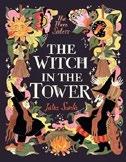
Feeling excluded by her friends, a melancholy youngster sets out on a walk in search of solitude—and finds herself along the way. Happening upon a lone tower, Carmela becomes bewitched by its denizen, a heavily mascaraed hag with a propensity for mind-reading and a welcome tinged with menace. As the pair busy themselves brewing an elixir meant to heal Carmela’s heartbreak, the girl hesitates. This recipe feels familiar. A grand tour of the tower’s turret, too, inspires a sense of possibility. By the time the duo open their doors to a coven of similarly kooky misfits, it’s wildly apparent that this space—be it physical, spiritual, or something else entirely—is where she belongs…and where she can create space for others, too. With the second installment in her Three Sisters trilogy, Sardà has struck gold. Both narrative and aesthetic ooze style, coolly occupying the intersection between cautionary folktale and coming-of-age fantasy epic. And while the story underscores just how powerful individuality can be when it’s made inclusive, Sardà reserves swaths of space for interpretation: What is imagined? What is reality? And does the difference matter? Readers will benefit from keeping a dictionary handy, since lofty vocabulary words appear throughout. The
breathtaking beauty of Sardà’s illustrations, too, defy description—at once psychedelic, eerie, and Miyazaki-esque in their enchanting detail, they demand poring over. The result is singular, not merely a modern classic but one for the ages. Carmela and the witch are light-skinned. Utterly spellbinding. (Picture book. 6-12)
Shia, Howie | Annick Press (72 pp.) | $19.99 September 30, 2025 | 9781773219905

Left-behind youth form a marching band to rescue their adults.
Ever since the Grown-Ups left to chase away the Growlies, the kids have tried to stay busy in the city. But as more time passes, some start to worry. One day, the Twins make an announcement with a simple rhythm on their drums: “Ratamacue!” The beat—which Shia explains in an appended note is one of 40 standard marching drum patterns—calls on all the children to band together and stop waiting for salvation. More instruments and kids join the fold until a large parade of youth diverse in skin tone and abilities have assembled. The Ratamacue clears the tall grass in the fields and shoos away the shadows. Despite their fear, the kids discover “new beats” as they head toward the final confrontation. Neither the Grown-Ups nor the Growlies expect the cacophony, but are the youngsters loud enough to stop the Growlies once and for all? Shia’s background in film and television shines in this creative picture book that expertly draws on comics conventions to visually depict musicality. The setting and characters’ restricted palette help the more vibrant and colorful musical notes—depicted in an array of shapes and sizes—pop as the kids save the day. The dynamic panels have a rhythm of their own, all culminating in a truly stunning ending. Backmatter provides helpful musical context.
Innovation that deserves a standing ovation. (Picture book. 6-9)
Sotomayor, Sonia | Illus. by Jacqueline Alcántara | Philomel (40 pp.) | $18.99
September 9, 2025 | 9780593206294

A Supreme Court justice offers guidance on how to brighten the world—and an ode to her late mother.
Beginning with an excerpt from the Homeric Hymns, Sotomayor presents a graceful tribute to her mother, Celina, whose compassion and generosity still linger with her. The lessons Celina imparted form the crux of this story, shared in brief, stylized snapshots that underscore how “she lit up everyone around her.” In the sugar cane fields of Puerto Rico, young Celina summoned the bravery to steer her confused, sick mother back home amid the night’s darkness. Growing up alongside her strict older sister, Celina beautified their home through her daily hard work. Other examples—Celina befriending a lonely elderly woman, nourishing a nephew’s artistic dreams, leveraging her nursing skills to heal others—come together for a portrait of a woman who “showed her love and brought brightness to her family, her community, and the world.”
Sotomayor punctuates each glimpse of a good deed with an explicit affirmation, and though Celina occasionally comes across as an almost overly idealized, uncomplicated subject, on the whole, this is a timely reminder that a remarkable sense of community can emerge through ordinary means. Alcántara’s dreamy, ornate marker-and-gouache artwork emphasizes the beauty of kindness. A thoughtful primer on the transformative power of goodness. (Picture book. 4-8)
Thomas, Tess | Illus. by Kamwei Fong Levine Querido (48 pp.) | $19.99
September 2, 2025 | 9781646145737

After attempts to downplay his feelings make him miserable, a cat learns that freely expressing them is key to his well-being.
Bristling when he’s angry, shielding him when he’s afraid, and offering “hug after hug” when he’s happy, Shibu’s tail is a reliable indicator of his mood. After noticing that his big feelings attract undue attention from the other cats, he decides to stifle them. Shibu represses his joy over the milk delivery, his rage over a broken toy, and his fear during a lightning storm. These pent-up emotions take their toll: “Shibu started to feel like he was going to explode! And then, suddenly…He did.” Fong renders Shibu and his voluminous tail via a multitude of tiny black ink hatches, which increase in volume and intricacy. The illustrator depicts the veritable explosion of Shibu’s tail as a stormy cluster of cresting waves that leave the feline dripping wet. Understanding that sharing “what’s on his mind and in his heart” allows him to feel his best, Shibu begins to help his cat friends communicate their own sentiments. As Shibu’s tail offers a thumbs-up, Fong playfully surrounds him with equally demonstrative felines—and tails. Thomas’ cogent text and her focus on emotional intelligence will resonate with caregivers, while Fong’s quietly comic pictures will tickle everyone.
A winning blend of crisp design, child-appealing illustrations, and positive messaging about selfexpression. (Picture book. 3-7)
Innovation that deserves a standing ovation.
RA! TA! MA! CUE!
Vida: The Mice, the Cat, and the Alebrije
Tonatiuh, Duncan | Abrams (48 pp.) | $18.99
November 11, 2025 | 9781419764592

Artistically minded rodents fight back against their feline terrorizer in Tonatiuh’s prescient fable. On a dreadful, star-filled night, a looming shadow (“¡Un gato!”) falls over the bustling, effervescent town of Mousetepec, and everything changes. As the cat uses its terrible claws to frighten the residents, Mousetepec loses its colorful spirit: The mousefolk stay home, the mercado closes, the fiestas stop, the plaza remains quiet, and the raspado cart stands abandoned. To bring cheer back into their lives, Vida and her brother, Máximo, start painting household objects—containers, jugs, bottles—in kaleidoscopic colors while transforming old buckets and cereal boxes into vibrant masks. When Máximo wanders outside in an ill-timed attempt to bring color back to the town, Vida rushes to his aid, donning one of their frightfully colorful masks to scare the lunging cat away. The confrontation spurs Vida to dream of a large neon creature called an alebrije, which inspires a plan to scare away the creature that’s been menacing Mousetepec. Tonatiuh expertly maintains a brisk pace that engages and tickles. His familiar pre-Columbian-flavored artwork beautifully complements this simply told yet moving fable of collective resistance, boasting bursts of color and provocative shadows across splendid double-page spreads. Insightful backmatter on alebrijes—folk art sculptures—and the tale’s origins draws incisive parallels between the art form’s history in
Mexico and the increasing violence that has afflicted the country over the past few decades.
Utterly mesmerizing. (glossary and pronunciation guide, bibliography) (Picture book. 4-8)
Polar Bear and the Ballerina
Velasquez, Eric | Holiday House (40 pp.) $18.99 | October 14, 2025 | 9780823449187

A fantastical testament to the joy of seeing yourself in the art you seek out. This epic urban sojourn begins at New York City’s Central Park Zoo.
Three Black dancers, all tutu-wearing members of the Harlem Children’s Ballet, smile broadly before an aquarium enclosure and pose for promotional photographs as a bemused polar bear looks on with interest. Night falls, and the bear heaves itself from its tank and happens upon the signature accessory of our prima ballerina, a cherry red scarf blown from her neck or, just as likely, left behind as a clue. Eager to return the lost treasure, the Arctic creature heads uptown—drawing the ire of cabbies for jaywalking—until it reaches Lincoln Center. Much to the animal’s chagrin, a sign forbidding polar bear patronage has been plastered to the box office plexiglass, but when the bear’s bereft yowl reverberates into the rehearsal space, its resonance draws Red Scarf Girl from her warm-up and into the crowd. Once she’s led the creature to a velvet-swathed seat facing center stage, he sees another familiar face prominently featured in a backdrop alongside the performers—his own. This title is almost entirely wordless, but the
captivating balance that Velasquez strikes between realism and ultra-expressive emotion makes a magical meal of the story. The endpapers offer zoological information about the titular creature and a biography of the fictional ballerina at the center of this tale. (This review has been updated for factual accuracy.)
Dreamy. (Picture book. 5-8)
Wallace, Sandra Neil | Illus. by Nancy Carpenter | Paula Wiseman/Simon & Schuster (48 pp.) | $19.99
October 14, 2025 | 9781534493339

A giant among geologists breaks new ground. Ursula Marvin (1921-2018) was an intrepid adventurer from the start. A Vermonter by birth, she skied over icy potato fields and marveled at the moonlit mountains beyond, positive her future held something far more exciting than the humdrum tedium of scientific inquiry. But by the time she entered college, the field of planetary geology had captivated Marvin, and she was entranced by the information that rare earth minerals and moon rocks could communicate. Her curiosity about these other worlds brought Marvin to the ends of ours. Sharp, capable, and undeterred by the sexist stumbling blocks meant to thwart her, Marvin became the first female scientist to hunt the harsh landscape of Antarctica for meteorites, chasing the adventure she’d hungered for since childhood. But achievement at such scale is rarely won without adversity, and this feat was no different. Hampered by environmental challenges and plagued by selfdoubt, Marvin nevertheless stayed the course, eventually becoming the preeminent expert on the first meteorite discovered on Earth and, ultimately, the much-deserving namesake of geological wonders earthside and beyond. Wallace’s text uses technical terms in context and
renders the less glamorous labor that makes thrilling scientific discovery possible. Charming details peppered throughout add a personal texture to Marvin’s impressive figure. Carpenter delivers stunning visuals to match, her two-page spread capturing the glow of the midnight sun especially enchanting.
A luminous tribute befitting a brilliant trailblazer. (author’s note, excerpts from Marvin’s journals, facts about Antarctica, timeline, quote sources, bibliography, photos) (Picture-book biography. 8-12)
André: André Leon
Weatherford, Carole Boston & Rob Sanders | Illus. by Lamont O’Neal Henry Holt (56 pp.) | $19.99 November 11, 2025 | 9781250887283
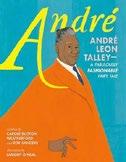
“My story is a fairy tale.” So opens this empowering biography of trailblazing style maker André Leon Talley (1948-2022), the first Black man to serve as Vogue’s editor-at-large, creative director, and fashion news director. But this fantasy wasn’t born from lucky happenstance or serendipitous privilege; Talley’s talent and tenacity conjured the magic that colors his story. Growing up in Jim Crow–era North Carolina, Talley endured racism, homophobia, and sexual abuse, all the while shrouded in his grandmother’s unconditional love. Fashion offered escape, and Talley took it, doggedly pursuing the work that would eventually land him an (unpaid) gig under Diana Vreeland, former editor for Vogue. Talley rose to prominence, setting trends, challenging convention, and standing tall against hatred; as he put it, he “scorched the earth” with his singular vision, forever transforming the fashion industry with gifts cultivated under his grandmother’s care. Weatherford and Sanders’ text, interspersed with Talley’s own words, renders a detailed portrait of the legendary figure, offering extensive proof of his
initiative and resilience. The beauty of Blackness is named explicitly throughout, but Talley’s sexual identity is broached only obliquely; while the subtlety may elude younger readers, this ambiguity will allow others to recognize their own experiences. O’Neal cleverly evokes sewing patterns of yore, a visual boon. And while both authors and illustrator pay homage to similarly magical myths— among them Cinderella and Little Red Riding Hood—the narrative roughs out a real-life road map for readers who see themselves in the hero.
Affirming and important. (authors’ note, information on people referenced, glossary, note about HIV/ AIDS, sources for quotes, bibliography) (Picture-book biography. 9-12)
Yaccarino, Dan | Christy Ottaviano Books (40 pp.) | $18.99 | September 30, 2025 9780316574563

Get ready to embark on an enchanting trip through Bella Città (Beautiful City). The splendors of Italy are on full display as dapper shrew Piccolo decides to enjoy a day dedicated to visiting his favorite places. An initial trip to Miss Dolce’s Gelateria is interrupted, however, when he hears cries for help from his vulpine pal, Mr. Rosso. The fox needs to move his painting to the museum, and since the institution is on Piccolo’s list of places to visit, he’s more than happy to assist. What follows is a series of sequences in which Piccolo aids friends and neighbors, visiting a fountain, the ancient ruins, a theater, and a garden along the way. A more fervent picture-book tribute to Italy may not exist. Yaccarino’s bold artwork makes excellent use of texture and shading; small joys abound, too, as in the clever references to famous artworks found in the book’s art museum (note The Vitruvian Man depicted as an octopus). Italian words appear throughout; translations are included at the book’s end, though some might take issue with gelato being equated with ice cream,
as the two are made differently. Even so, this paean to Italian lands, culture, and food is a perfect read for anyone planning a trip there or for those who simply wish to read their children a tale soaked in the sights and sounds of the country.
A love letter to Italy at its best and a snazzy charmer of a book through and through. (Picture book. 3-7)
Youngwolf, SD | Illus. by Shonto Begay Lee & Low Books (32 pp.) | $19.95 September 2, 2025 | 9781643790848
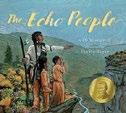
Two Indigenous cousins learn valuable lessons while visiting their grandfather. After preparing a blessing, Grandfather, the village chief, tells Aiyanna and Little Wolf that today they’ll meet the Echo People, who live in the river gorge and who have much to teach the children. He takes each of them to separate areas of the gorge and instructs them to introduce themselves to the Echo People, who can’t be seen. Impatient Little Wolf cries out, and his frustrated words (“You are just repeating everything that I say!” “I feel like a fool!”) are echoed back. “Those Echo People are terrible people,” he complains to Grandfather. But when the two check on gentle Aiyanna, she’s had an entirely different experience; her words of love and tenderness reverberate back to her, and she tells Grandfather how kind the Echo People are. True to traditional Indigenous teachings, Grandfather shares his wisdom about life (“Your actions, your words, even your thoughts all come back to you”) but lets his grandchildren make meaning from their experiences. Begay’s (Navajo Nation) magnificent, earth-toned illustrations establish a dreamy setting, supporting each word of Youngwolf’s (Tsalagiyi Nvdagi) inviting story. Small brush strokes enhance the action, suggesting clouds moving across the sky or smoke rising from the fire as Grandfather gives his blessing. A visually appealing and carefully told tale that will linger. (author’s note) (Picture book. 5-8)
Kirkus Star
Babbitt, Natalie | Adapt. by K. WoodmanMaynard | Illus. by K. Woodman-Maynard
Farrar, Straus and Giroux (256 pp.) | $22.99
$14.99 paper | September 2, 2025
9780374391850 | 9780374391867 paper

This 50thanniversary celebration of a literally timeless classic brings Babbitt’s novel to life in a graphic novel format. Sticking closely to the storyline as she visually fleshes out its themes and characters, WoodmanMaynard serves up a sensitive reworking that invites readers to think about what they would do if they were given the choice between a normal, finite life and an endless one. It’s a choice that lonely, 10-year-old Winnie Foster is left to make after she meets the Tucks (who stopped aging after drinking from a hidden spring near her house 87 years before) and hears their perspectives on what it’s like to watch everyone and everything they know change and die. The woodsy, small-town setting and the white-presenting cast—from exuberant, ever-17-year-old Jesse Tuck and his resigned mother, Mae, to the distinctively angular villain known only as “the man in the yellow suit,” and even a certain significant golden toad—are beautifully realized in the finely drawn watercolors. Along with incorporating atmospheric expository lines from the book into her scenes, the artist tucks in pinwheels and other circular imagery to evoke what melancholy father Angus Tuck describes as the ever-moving wheel of life and death: “You can’t have living without dying. So you can’t call it living, what we got.” The book closes with a conversation between Babbitt’s daughter, Lucy, and the adapter, as well as illuminating photos and process notes.
An homage navigated with confidence and care, as wise and wonderful as the original. (Graphic fantasy. 10-14)
Bagley, Jessixa | Illus. by Aaron Bagley
Simon & Schuster (288 pp.) | $24.99
September 9, 2025 | 9781534496583

Middle school pulls best friends in different directions in this latest collaboration from husband-wife duo the Bagleys. Jackie and Milo have always been inseparable, spying on neighbors (and their dogs) and hiding from the world in their HQ. But as they enter sixth grade, middle school hits fast. The two begin to drift apart, with Milo joining the soccer team and making friends with the “dude brahs,” while Jackie is thrown together with Adelle, her mom’s friend’s daughter, who’s into fashion and makeup. As her classmates obsess over who likes whom, Jackie, who prefers video games and comics and appreciates a comfy hoodie, starts to feel like she’s doing girlhood all wrong. Her parents—loving but stuck in old-school ideas of femininity—aren’t much help. Jackie turns to Jabari, her college-age gender-nonconforming sibling, for advice on how they came to accept themself. Jackie also tries to alleviate the pressure from peers by typing herself a fake love letter on Jabari’s old typewriter—but her scheme causes more problems than it solves. With lively, expressive art and the creative use of typewritten narration boxes to reflect Jackie’s unspoken thoughts, this graphic novel captures the cringey, confusing mess of early adolescence. A diverse cast of side characters brings depth to a story that champions selfacceptance and individuality. Jackie
and her family appear Black, and Milo presents East Asian.
A funny, heartfelt look at growing up and pushing back against narrow expectations. (author’s note, illustrator’s note) (Graphic fiction. 8-12)
Baptiste, Tracey | Freedom Fire/ Disney (384 pp.) | $17.99
September 2, 2025 | 9781368075374

A trio of AfroCaribbean cousins in New York City come to terms with their powers in this sequel to Moko Magic: Carnival Chaos (2024). When Uncle Andrew gets the opportunity of a lifetime—being featured in an upcoming exhibition at the Brooklyn Museum—he explains to Aidan, his son, and Misty and Brooke, his nieces, that he’s hoping to incorporate one of the famed Benin Bronzes into his art. The cousins inherited moko magic, each gaining one-third of their Trini family’s fantastical legacy, which was passed down from a West African ancestor. While Aidan’s healing powers and Brooke’s ability to manifest purple bubbles of protection are helpful in their new adventure, the action kicks off with Misty’s visions and a mysterious familial connection to the bronzes, which were looted in the 19th century from present-day Nigeria. Baptiste cleverly and effectively deploys seemingly minor set pieces to build suspense and tension, presenting readers with an enchanting take on Pan-Africanism. Brooke’s budding interest in art activism and history offers a provocative primer on provenance and on
colonizers’ pillaging and theft. A dangerous magical incident involving Uncle Andrew offers a smart metaphor for how anger can become all-consuming. Misty is an admirable and compassionate hero who, with help from her loved ones, ensures that cultural and personal memories are not only preserved but cherished. A charming and action-packed romp with a powerful historical perspective. (author’s note, glossary) (Fantasy. 8-12)
Barnes, Derrick | Viking (272 pp.) | $17.99 September 23, 2025 | 9781984836755
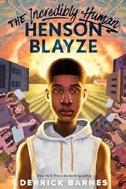
A crisis forces a talented young football player to consider what he values most. Henson Blayze, an African American 13-year-old, is looking forward to football season—he’ll be joining the high school team despite still being in eighth grade. The entire town of Great Mountain, Mississippi, which is mostly white, is excited about Henson’s bringing them a championship win. Henson’s fifth grader friend, Menkah Jupiter, who’s like a little brother, is eager to see his idol in action. Townspeople make T-shirts and signs supporting their “Great Mountain Messiah.” At school, teachers and students fawn over Henson, offering him special favors, while his friend Flowell Bridges, a “hive of magnetic personality,” regales all who will listen with stories of Henson’s heroics. But Henson’s vineyard owner father is less enthusiastic—sports have “never been of grave importance” to him—and Henson’s longtime crush, Freida St. Louis, is more interested in social causes. The local news covers their first game—and Henson is outstanding from the beginning. But at halftime he learns that state troopers have badly beaten up Menkah, who’s been hospitalized, and he chooses to leave the game. Adulation quickly turns to fury when it
becomes clear that Henson places justice above entertaining the town. Barnes has masterfully crafted a story that’s grounded in history and has fantastical elements woven into it. Henson is an irresistible lead surrounded by a strong supporting cast, and his story sheds light on the reality of racial dynamics. Bold, extraordinary storytelling: not to be missed. (author’s note) (Fiction. 10-14)
Barrows, Annie | Illus. by Sophie Blackall Chronicle Books (116 pp.) | $15.99
September 9, 2025 | 9781797219714
Series: Stella & Marigold, 2

The sisters introduced in the remarkable Stella & Marigold (2024) tackle friendships and unnerving sirens. When the siblings’ wellmeaning cousin gives them each a journal, Stella discovers that the notebooks contain 25 lines where they can write in the names of their best friends. Both Stella, 7, and Marigold, 4, feel sharp pains of inadequacy at not having nearly enough pals. What follows are their attempts to make more friends, from their babysitter to their upstairs neighbor and their classmates. In one particularly fraught sequence, Marigold steals a disturbingly toothy (but very funny) mermaid candle holder from her upstairs neighbor; she plans to pretend to find it so he’ll be grateful to her. Of course, the heart of the series lies with the relationship between its titular sisters, and the two are as close as ever; a scene where they briefly contemplate running away from home cements their mutual dedication. While the text isn’t quite as hilarious as in the first volume, the art may actually be funnier (thanks to the mermaid), with its loving depiction of the realistically nuanced sororal relationship that made the first book a hit. Readers need not
be familiar with the earlier installment to enjoy this latest. Both sisters present white; their community is diverse. Some things may come and go, but sisterly friendship like this will stand the test of time. (Early chapter book. 6-9)
Cabin
Campbell, Scott | Tundra Books (88 pp.)
$13.99 | September 30, 2025 | 9781774885055
Series: Cabin Head and Tree Head, 1
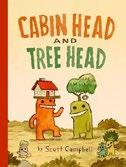
The sweet and strange intersect in these comics about two pals with a lot on their minds. The premise is simple: In this world, everyone sports something on their head. Our protagonists are best friends Cabin Head and Tree Head (vaguely humanoid creatures with little people inhabiting the worlds atop their noggins). Six main stories (with three bonus tales) take this concept and run higgledy-piggledy with it. Readers are treated to tales of terrible “leafcuts” (Garden Head attempts to give Tree Head a new ’do, with hilarious results), treasure hunts with self-made maps, and even a wildly out-of-this-world adventure that reveals that the Earth itself is on someone’s head. Kids will revel in locating and naming all the different “heads” in Campbell’s beautiful watercolor-rendered scenes, even as they chuckle over his delightfully absurd dialogue (“I feel a case of the HELLOS coming on.” “Uh-oh. The HELLOS are nothing to be trifled with”). The primary lures are the humor, the nutty concept, and the detailed depictions of a cheerfully surreal world where everything from clouds to mountain is gently anthropomorphized, but the heartfelt friendship between the two heroes is what will have children and parents coming back again and again.
A wildly original tale with the buddybased charm of Frog and Toad but imbued with a wacky energy all its own. (Graphic fiction. 6-10)
DiCamillo, Kate | Illus. by Sophie Blackall | Candlewick (160 pp.)
$17.99 | September 30, 2025
9781536225525 | Series: Norendy Tales

L ike a Thumbelina with agency, a tiny girl winds her way through a great, strange world.
DiCamillo’s latest Norendy Tale opens on a poor cobbler who’s always dreamed of going to sea. One day, he discovers a minuscule baby in the toe of a boot and raises the girl, whom he names Evangeline, as his own. The two dream of setting sail someday, but before that can happen, the child is stolen away and sold to a rich old widow, setting off a series of adventures. Through it all, searching father and lost daughter meet a host of strange characters—an immensely self-possessed marmalade cat, a nasty sideshow proprietor—as they attempt to find one another. Will they? In true DiCamillo fashion, the ending is suffused with the gentlest melancholy, allowing readers to either believe in their reunion or dismiss it entirely. Illustrator Blackall once more joins forces with DiCamillo to bring the more fairy tale–like elements of the book to gentle life, softening some of their harsher aspects. There are no easy answers in a Norendy tale, but there is great courage, even when it comes in the smallest of packages. The characters are pale-skinned.
A tender tale featuring a young protagonist who possesses equal parts yearning and spunk, to great effect. (Fantasy. 7-10)

Macabre, madcap, and surprisingly wholesome in its positivity.
DEAD ENDS!
Kirkus Star
Eagle, Judith | Illus. by Jo Rioux Walker US/Candlewick (288 pp.) | $18.99 December 2, 2025 | 9781536242683
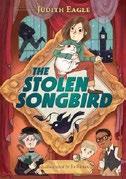
A young girl, a pet rabbit, a best friend, a postwar London setting, and a puzzling mystery animate and entertain in Eagle’s latest. Caro Monday, 12, lives in London with her mother, Jacinta, who’s famous for her whistling, and her second mum, Jacinta’s partner, Veronica “Ronnie” Rudd, who owns the pub where they live. Caro is happy. She has her white-and-ginger rabbit, His Nibs; her best friend, Horace Braithwaite, who aspires to be the next Yves Saint Laurent; and the Rubbles, an abandoned area that’s “half bomb site, half junkyard, full of stuff to build with, and no grown-ups to bother you.” The two are outsiders—white-presenting Caro for having two mums and Horace for being Black and Bajan. But when Jacinta fails to return from an overseas whistling tour (not the first time she’s gone missing) and Ronnie’s sister up north needs help, Caro ends up staying with the detested Gam, or Great-Aunt Mary, who raised Jacinta until she ran away at 16. Arriving at Gam’s house with her few possessions, Caro finds the imperious Gam as awful as she’d imagined. While unpacking, Caro discovers a small painting of a bird hidden in Mum’s old suitcase—a painting that turns out to be by an old master, and stolen to boot. 1950s London comes to life in the evocative descriptions and Rioux’s utterly charming, full-page illustrations. The twisty plot and taut,
assured writing deliver a story that immediately engages.
Assured and atmospheric: a winner. (Mystery. 8-12)
Fitzharris, Lindsey & Adrian Teal | Illus. by Adrian Teal | Bloomsbury (160 pp.) | $19.99 October 14, 2025 | 9781547615025
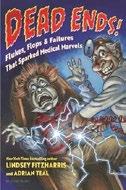
In the vein of their PlagueBusters! (2023), Fitzharris and Teal round up wild examples of medical trial and error. Arguing that “success and failure are often two sides of the same coin,” the co-authors demonstrate that mistakes have often resulted in groundbreaking medical breakthroughs. A 19th-century surgeon unable to patch up a hole in a patient’s side was afforded the rare opportunity to observe digestion up close; deaths from the first blood transfusions led to the discovery of blood types. Fitzharris and Teal present fascinating content, writing in an easy-to-digest, conversational tone while occasionally slipping in some gallows humor. The promise of grotesque medical tales will lure readers, but the authors also make some profound, even moving conclusions: Failure is a key part of learning, and medicine has come a long way over the years. The material is organized by body parts, with delightfully punny chapter titles: “Racking Your Brains,” “No
Guts, No Glory.” “A Taste of Their Own Medicine” sections between chapters are ripe with tales of dark irony and people getting hoisted by their own petards. Teal’s black-and-white images use pops of bright red to spice up the visual gags and caricaturelike portraits of scientists and doctors. The subversive, gory humor is transgressive and fun for young readers without being so graphic as to disturb any but the most sensitive. Extensive backmatter will reward those with the guts to delve deeper. Macabre, madcap, and surprisingly wholesome in its positivity. (selected sources, further reading, index) (Nonfiction. 9-14)
Kirkus Star
The Nine Moons of Han Yu and
Glaser, Karina Yan | Allida/ HarperCollins (432 pp.) | $19.99 September 16, 2025 | 9780063284432

A boy in China in 731 C.E. and a girl in New York in 1931 face separate hardships and adventures but are connected by common threads.
Eleven-year-old Han Yu lives a simple life in Chang’An. He’s seen as unusual because of the various animals that are drawn to him—even a tiger, which has earned him the nickname “Tiger Boy.” But Han Yu enjoys ordinary activities, like making steamed buns to sell with his father at the busy market. Eleven-year-old Luli Lee has a modest and happy Depression-era existence in New York City’s Chinatown. She’s been helping her immigrant parents run their restaurant in the building they’re saving up to buy. But disaster strikes both children’s lives: Members of Han Yu’s family contract a mysterious, deadly respiratory illness, and Luli’s family business and home are at risk of foreclosure. Both young people summon their courage, creativity, and determination as
they go on adventures to help their families. As two exciting parallel stories of family, friendship, and community unfold, they bravely confront a variety of challenges, supported by loyal animal companions. While their storylines are distinct, they’re connected through cultural elements that reverberate through their historical eras. The alternating third-person chapters following Han Yu’s and Luli’s story arcs are strongly paced and highly suspenseful. Detailed descriptions make this a vibrant love letter to Chinese culture, food, history, poetry, and art. Final art not seen. Thrilling, heartwarming adventures highlight commonalities that span centuries. (maps, author’s note, bibliography) (Historical fiction. 8-12)
Hale, Nathan | Abrams Fanfare (128 pp.) $15.99 | September 9, 2025 | 9781419773204 Series: Nathan Hale’s Hazardous Tales

Author Hale’s namesake—spy and Revolutionary hero Nathan Hale—huddles with compatriots beneath a gallows as they regale one another with ghoulish tales drawn from history, literature, and legend.
Hale’s latest set of Hazardous Tales begins, as it really needs to, with a cautionary note: “Are you a second grader reading way above your age level? If so, set this book down. It’s not for you.” Indeed, the book doesn’t skimp on the disturbing bits. With evocative titles like “The Demon Cat” and “The Head in the Jar” to provide at least a little warning, the author gathers a variety of terrifying tales; three involve the Jersey Devil, while one centers on a butler going bloodily berserk in a house built by Frank Lloyd Wright. Others feature the discovery of a haunted well filled with the corpses of soldiers killed in a Civil War battle, gruesome revenge, and monsters like
the Boo Hag, a skin changer who sucks blood through sleepers’ noses. All these tales, eerie as they are on their own, are cranked up into screamer territory by Hale’s two-tone illustrations, which, with indecent relish and fanatical attention to realistic detail, depict fresh and not-so-fresh corpses, a radiation victim’s rotted face, a man’s buttocks being hacked off with a sword, leering skeletons, chopped-off limbs, and creepy night creatures with big, sharp teeth. The cast of storytellers, horrified onlookers, and all-too-often mutilated victims is racially diverse. Not all true, but truly nightmarish. (bibliography) (Graphic nonfiction/ horror. 10-14)
Xolo
Donna Barba | Illus. by Mariana Ruiz Johnson | Levine Querido (192 pp.) | $19.99 November 4, 2025 | 9781646147021

T he Aztec god of lightning, death, and misfortune gets a much-needed reevaluation in this wonderfully rousing retelling of humanity’s origins. After all life
perishes on Earth, the gods move to revitalize the planet. Each deity claims mastery over an element. The mighty serpent god Quetzalcoatl chooses the wind; his dog-headed twin brother, Xolotl, takes lightning, hoping for a sliver of brotherly affection. “Shouldn’t my own twin notice me for once? But Quetzalcoatl never did.” Adopting an affectionate tone, Newbery Medalist Higuera frames the narration around Xolo’s self-effacing voice, a prolonged plea for compassion that will reverberate with readers. When the outcast god of the Underworld threatens to prevent humanity’s return, the other deities make a temporary sacrifice by hurling themselves into a volcano. Too fearful to go through with it, Xolo finds himself ostracized, but he summons the courage to resurrect humanity, with help from his brother,
who gets all the glory for their joint act. Wistful in tone, this reshaped myth skillfully deconstructs its unsung hero. With great success, Higuera explores very human issues such as self-doubt, social isolation, and the nuances of community through these larger-than-life figures; her work rings out with a powerful sense of emotive resonance. Inspired by the Codex Borgia—a pre-Columbian Aztec manuscript—Ruiz Johnson’s artwork blooms with vibrant colors, imposing characters, and evocative landscapes. A magnificent spin on a well-known Aztec legend. (author’s and illustrator’s notes) (Mythology. 7-10)
Holm, Jennifer L. | Scholastic (240 pp.) $17.99 | October 7, 2025 | 9781546138143

A spirited 12-year-old contends with her cloistered life after an apocalypse. Over 10 years ago, the Great Poisoning killed most humans. Razzi lives in an old mansion named the Refuge with her parents, 7-year-old brother, Bing, and a handful of other adults and children. The kids are rarely allowed Outside, especially not since 12-yearold Ollie, a curious risk-taker, had a terrible accident and died while trying to explore. Razzi injures her knee during a game of Chase, which leads to a checkup and a serious diagnosis— she learns that she must have a heart transplant. Luckily, Refuge resident Saul is a Surgeon, and he successfully implants a greyhound’s heart into Razzi. After the surgery, Razzi feels different: Her senses of hearing and smell are keener, and foods she used to love, like chocolate, now sicken her. When Razzi makes the momentous decision to run away, she learns that the world outside the Refuge is bigger than she could ever have imagined. Holm’s adventure is riveting and appealing, featuring a relatable cast of characters and unfolding against a
post-apocalyptic backdrop with zombie story vibes. Holm’s mastery of pacing and her explorations of intergenerational trauma and forgiveness resonate, ensuring that they’ll stay with readers long after the final pages. Razzi presents white, and names cue ethnic diversity in the supporting cast. An ambitious and thrilling examination of survival, trauma, and connection. (author’s note) (Speculative thriller. 9-12)
Idil, Raidah Shah | Salaam Reads/ Simon & Schuster (256 pp.) | $8.99 paper November 4, 2025 | 9781665982627

In this debut, a young Malay Muslim girl confronts difficult choices as she grapples with her matrilineal legacy—an inherited bond to jungle spirits called jinn. Twelve-year-old Insyirah Abdullah is not happy. Her mother’s decision to uproot her from Sydney, Australia, and return to Malaysia is causing her anxiety to peak beyond its normally high level. Nenek, her widowed maternal grandmother, needs more help, which is understandable—but things are already tense between Nenek and Mama, and Kuala Lumpur is insufferably hot and humid. Plus, there’s Nenek’s and Mama’s unnerving talk about “the unseen realm” and spirits that have the power to harm as well as protect. At least school begins well. Syirah makes two new friends who are also outsiders: Nadia (who’s Indian Muslim) and Kai Xin (who’s Chinese Malaysian). But things quickly deteriorate as she discovers that her school is haunted, her mother got entangled with a spirit as a young woman, and Nenek is hiding something serious. With help from Ari, a youthful spirit, and her aikido teacher, Sensei Bilqis, who’s a part-jinn master of exorcism, Syirah steps up to fight for freedom, equality, and peace. In the process, she redefines an ancient bond her family has with a
special guardian spirit. This delightful coming-of-age tale weaves humor, deep family bonds, steadfast faith, and mythology into a wholly believable narrative. Cultural elements, including mouthwatering descriptions of Malaysian food, enrich the story.
An intriguing exploration of mysticism and religion, centering on a strong and deeply relatable girl. (Fantasy. 9-13)
Kadarusman, Michelle | Pajama Press (224 pp.) $18.95 | September 16, 2025 | 9781772783490

A daughter of Javanese nobility fights colonial oppression and the subjugation of girls in this work inspired by the life of Raden Adjeng Kartini (1879-1904).
At 12, Kartini begins living in pingit, the traditional home seclusion imposed on Javanese girls of high birth until they marry and a fate that feels deeply unfair. Unlike the freely soaring seabirds she sees overhead, Kartini feels like a “caged bird.” Her father, Regent of Jepara, educated his daughters at the Dutch school, where Kartini spent joyous days with her best friend, Lesty Claasen, daughter of the Dutch Colonial Resident. But Lesty has returned to Amsterdam, and Kartini’s confinement precludes going to school. Over the years, she and Lesty communicate via letters that bring a deeper understanding of each other’s cultures and of the harm caused by both colonialism and patriarchal traditions. A visiting Dutch writer, a woman named Marie OvinkSoer, encourages Kartini to hone her writing talent, which gives her wings to soar. When she’s invited to read aloud an essay that she published in a Dutch women’s magazine under a pseudonym, Kartini bravely uses the opportunity to call for freedom and equitable educational access for Javanese girls. Kadarusman beautifully brings Kartini to life with clarity and empathy in a story that’s educational without being
preachy and is a superb pick for readers interested in history and activism. A well-realized story that shines a spotlight on an early feminist struggle. (biographical and historical notes, author’s note, glossary) (Historical fiction. 9-13)
Star
Kelly, Erin Entrada | Illus. by Naomi Franquiz | Scholastic (240 pp.) | $17.99 September 2, 2025 | 9781546132431
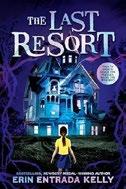
After her estranged grandfather dies, an 11-year-old girl learns that she can not only see ghosts, but also communicate with them.
Lila Clement is always being accused of being too much—too dramatic, too intense, or just taking up too much space. When Grandpa Clem passes away, the family sets off on the long drive from Phoenix to Castle Hill, Ohio. They’ll be staying in the inn he owned for a few weeks, sorting out his affairs. Lila meets Grandpa Clem’s young neighbor, Teddy Hamad, who quickly becomes her confidant after she shares with him that she saw the ghost of her grandfather— who said he was murdered and needs her help. In turn, Teddy reveals that Castle Hill Inn contains a portal for spirits of the departed to pass through to the other world. Teddy, Lila, and her younger brother, Caleb, must solve the murder, help the good ghosts resolve their unfinished business so they can cross over, and stop the malevolent spirits who stand in their way. In this clever series opener, Newbery Medal–winning author Kelly examines fear and grief through memorable characters and fast-paced chapters. The book contains puzzles and augmented reality elements (accessed via QR codes and integrated with Franquiz’s eerie, full-page illustrations) that allow readers to interact with the ghosts and conduct their own
investigations. Lila and Caleb are Filipino and white, and Teddy has brown skin. Hauntingly good and sure to possess any horror aficionado.
(Paranormal. 8-12)
Layton, T.Z. | Sourcebooks Young Readers (306 pp.) | $10.99 paper | September 2, 2025 9781464267109 | Series: The Academy, 1

Challenges on and off the field await a 12-year-old Ohio boy who’s unexpectedly invited to attend an exclusive soccer camp in England. Leo K. Doyle may be a star forward on his YMCA league team, but after accepting a surprising invitation from a roving scout to attend a month of highly competitive tryouts for a Premier League youth development program, he finds himself far from home and, at best, in the middle of the pack. At the London Dragons camp, Leo, who’s cued as biracial, with a white dad and brown-skinned mom, makes friends with fellow players from around the world. He also wins an anti-American bully’s grudging respect and even helps his 19-year-old coach with a sweet gesture of apology for his girlfriend. But from the outset, the focus is on “the Beautiful Game.”
Without letting up on the breathless pace for a moment, Layton packs Leo’s narrative with clear descriptions of skills and techniques both basic and advanced, sapient coaching, game strategies, and intangibles (such as team chemistry) that ultimately come together to set Leo apart from his bigger, faster, stronger rivals. Following a series of hard-fought elimination matches culminating in a high-stakes final in the big stadium under the eyes of the godlike professional team, Leo flies home in time for a dizzying final twist that sets up the sequel to this first entry in Layton’s popular British series. A page-turner for soccer-mad readers, whether fans or players. (Fiction. 8-13)
Millie Magnus for Mayor Mazique, Brittany | Illus. by Ebony Glenn Putnam (144 pp.) | $17.99 | September 2, 2025 9780593618806 | Series: Millie Magnus Chapter Books, 2
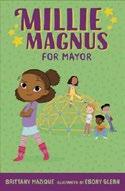
A youngster learns what it means to be a good leader. Millie Magnus Miller, a spirited third grader whose widowed mom is the mayor of Washington, D.C., burst assertively onto the scene last year; in her debut outing, she confronted a bully, learned impulse control, and dealt with authority issues. This installment finds her addressing new challenges. Overhearing part of a conversation between her mother and an architect with big plans for the city, Millie Magnus jumps to the conclusion that her beloved playground, which holds precious memories of her late father, will be demolished. Leaping into action, she spearheads an effort to save the playground, but her leadership skills need some fine-tuning. Her highhanded style alienates the other kids—including the Real Chill Pickles, a group of hip fourth graders. Sensibly, she consults her mom, a font of useful tips, but true to form, she also misunderstands them. Though her three besties and her mother’s assistant, Josephine, offer advice, Millie Magnus is moving too quickly to listen, but eventually, she slows down and unpacks deep-seated emotions about the playground and what it represents. Mazique offers another well-paced narrative, once more nailing Millie Magnus’ voice, difficulties, and feelings. Glenn’s perky, sure-handed line and grayscale cartoons bring to life an appealingly self-confident character and an encouraging supporting cast. Millie Magnus, her mother, and Josephine present Black; other characters are diverse.
A satisfying sequel whose lively protagonist continues to learn and grow. (Chapter book. 6-8)
Kirkus Star
McCarty, Peter | First Second (288 pp.)
$24.99 | October 14, 2025 | 9781250170620
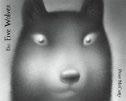
Five wolves create and discuss art during their adventures in this stream-of-consciousness narrative.
The format defies easy categorization. Its episodic structure, roguish characters, and philosophical commentary suggest a picaresque tale; the page turns and abundant illustrations evoke a picture book. The verbal storytelling, spun from dialogue and an offstage narrator, unfolds in hand-lettered sentences that form swirling, mostly blue wavy lines filling compact spaces on the white pages. Larger, darker text demands to be read first. Highly textured ink renderings, many in gray (among other colors, used monochromatically), punctuate the pages of text. An early scene portrays the wolves on a Viking-like ship, painting on canvases. A shark leaps to steal the portrait the wolf has drawn of it, activating the plot, which involves five competitive, artistic cats, who fire their vessel’s cannon, as well as a shipwreck, flying creatures, a fiery encounter with a dragon regarding an impromptu mural, a princess in a hanbok, and a climactic battle. Many of the remarks and asides deal with the nature of art: what can be seen, what role identity plays, if serious art is superior or some subjects are unworthy, the role of permission in creating art, and whether some artists can be considered failures. McCarty pulls some lines from children’s books and popular culture, including The Runaway Bunny and Star Wars. This utterly original book respects its readers, asking them to display patience, have comfort with
ambiguity and rereading, and exercise the ability to construct meaning. Striking and provocative. (Illustrated fiction. 10-adult)
Miyares, Daniel | Anne Schwartz/ Random (240 pp.) | $21.99
September 30, 2025 | 9780593568293
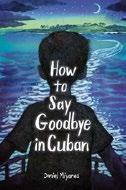
In the late 1950s, a boy’s life is turned upside down by the Cuban Revolution. In this touching graphic memoir, Miyares depicts his father Carlos’ childhood before and during dictator Fidel Castro’s ascent to power. Affectionate interactions between Carlos and his mamá and abuelo and vibrant shades of green and blue portray the joy Carlos felt growing up in rural Ceiba Mocha. So, when his hardworking papi won the lottery and relocated the family to the city to launch his dream of owning a woodshop and selling furniture, the move was a huge adjustment for nature-loving Carlos. At school, kids teased him for being a “country kid,” but nothing compared to the fear Carlos experienced when the government was overthrown. Miyares intersperses brief, digestible political updates in black-and-white throughout, forming a stark contrast to the vivid color palette of Carlos’ daily life. Suddenly, men with guns seized Papi’s business. Food was rationed. Neighbors spied on each other to see who didn’t support the revolution—and they had their eye on Papi. Rumors abounded that those who opposed communism or
A page-turner that’s richly threaded with social conflict.
THE GOLDEN NECKLACE
Castro were being shot. Worst of all, one day Papi disappeared. But even when things were at their bleakest, Carlos and his family found hope in the possibility of making one more move—to America and freedom. The expressive art in this powerful work has a nostalgic feeling while also conveying emotional immediacy.
A heartfelt, suspenseful story about family and resilience. (author’s note) (Graphic memoir. 8-12)
Nayeri, Daniel | Levine Querido (192 pp.) $18.99 | August 26, 2025 | 9781646145669

Master storyteller Nayeri crafts a gripping World War II tale set in Iran. When 13-yearold Babak and 8-year-old Sana are orphaned after their father is killed during the Anglo-Soviet invasion of their country, family members take them in, but the kids are sent to different households. So Babak decides to flee, taking on his father’s role as teacher to nomadic tribes. Strapping a blackboard to his back, he leads Sana into the treacherous Zagros Mountains to find the Bakhtiari people during their annual migration—and the dangers only deepen when they come across a Jewish boy attempting to dodge a Nazi spy. Nayeri tells a remarkably intimate story of a neutral nation caught between warring powers, seamlessly integrating philosophical questions about God, family, and cross-cultural understanding and suggesting that truly listening to those different from us can be a sacred and transformative act. The novel’s richly drawn characters and evocative setting provide enough context about World War II and Iranian history without overwhelming young readers, while Babak’s growth
from insecure orphan to a confident mediator who bridges cultural divides sends a potent message about how “everybody has good work to do”— even children displaced by war. A compelling testament to the power of education and empathy to light the way in even the most perilous circumstances. (map, author’s note, further reading) (Historical fiction. 8-12)
Oh, Ellen | Harper/HarperCollins (192 pp.)
$18.99 | September 30, 2025 | 9780062875822
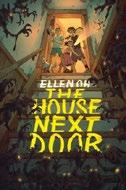
Two 12-yearold boys join forces with unexpected allies to defeat malevolent creatures. Japanese American Rory Parker watches uneasily as movers unpack his new neighbors’ belongings next door. The house has a tragic history—and it’s haunted. Rory’s former BFF Joey used to live there, and Rory saw a ghost and other small shadowy beings skulking around with his own eyes. Though reluctant to enter the house, Rory becomes fast friends with its new inhabitants, Korean American Jack and his younger sister, Mira. When Rory discovers that the same evil that afflicted Joey years earlier is targeting Mira, he resolves to keep her and her family safe. Rory and Jack will need the help of Jack’s plucky corgi, Rory’s ragdoll cat, and the benevolent spirits residing in the house to vanquish the monsters living beneath it. Oh, founder of the nonprofit We Need Diverse Books, treads familiar territory, offering an inspired take on the haunted house trope and delivering a message that friends working together can defeat the greatest of challenges. Her novel is rife with creepiness and peril, leavened by moments of levity, making this an ideal tale for newcomers to the genre. Elements of Japanese and Korean culture are integrated, especially through detailed descriptions of foodways.
Spooky fun for novice horror fans. (Horror. 8-13)
O’Hara, Eureka & Dan Poblocki | Illus. by Ricardo Bessa | Amulet/Abrams (272 pp.) $18.99 | October 21, 2025 | 9781419773655

A tween boy embraces the philosophy of dressing for joy. When Jackson Bright, a largebuilt, whitepresenting boy, wears a borrowed pink-and-white polka-dot dress to the last day of sixth grade, he inadvertently ends up butting heads with a teacher. Miss Felton weaponizes her fear of bullying against students who don’t conform to her beliefs and disingenuously claims that she’s sending Jackson home to protect him. This sets Jackson and his best friend, nonbinary Filipino American Eva Caringal, on a path that leads to his entering the regional Our Little Miss pageant in his newly created drag persona, Sissy St. James. With help from Uncle Aaron, a burly man who looks “like a lumberjack, but, like, if lumberjacks loved Vogue magazine,” Sissy is accepted into the pageant. But how can a brand-new drag queen (even one as fabulous as Jackson/Sissy) hope to navigate a pageant, let alone life?
Co-authors O’Hara (who appeared on RuPaul’s Drag Race) and Poblocki excel at creating nuanced character development, which both solo readers and book clubs will appreciate. The close third-person narration follows Jackson, capturing the exuberance and insecurity of the tween years and presenting an authentic protagonist whom readers will cheer on. The supporting cast and their various subplots are equally welldeveloped, including Jackson’s father’s depression, Eva’s turbulent home life, and Jackson’s budding friendship with fellow pageant contestant Ciara Williams, who reads Black. Bessa’s occasional illustrations provide added interest.
A fierce and fabulous read! (Fiction. 10-13)
Perkins, Mitali | Illus. by Maithili Joshi
Charlesbridge (128 pp.) | $15.99
October 7, 2025 | 9781623543730
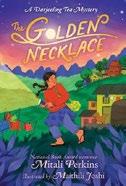
The daughter of a Nepali tea plantation worker in Darjeeling solves a mystery at the behest of a family friend. Twelve-year-old Sona has plenty on her mind. As one of only three Nepali students with a shot at a scholarship to the prestigious Darjeeling International School, she must pass an English exam. Meanwhile, her older brother, Samiran, is struggling to find work after he’s falsely accused of stealing a neighbor’s motorcycle. On top of that, her 18-year-old Bengalese friend Tara is engaged to be married to a cruel man 10 years her senior; the match was arranged by Tara’s uncle, and she’s convinced that her fiancé is only after the gold jewelry her parents left her before they died. Sona stands guard as Tara sneaks into the kitchen to catch one last glimpse of her family gold. But that very day, the gold is stolen, and Sona worries that suspicion will fall onto Samiran. Can she solve the mystery? Featuring an endearing, resolute protagonist, this expertly plotted story will enthrall readers. Perkins deftly captures the details of life in Darjeeling, including the power dynamics responsible for the social and financial issues Sona and her family face. In showing the friendship between Sona and Tara, Perkins teases out the ways in which socioeconomics and gender affect the trajectory of both girls’ lives, from unequal access to water (those who can’t afford it must ration their supply) to the challenges of pursuing education.
A page-turner that’s richly threaded with social conflict. (Mystery. 8-11)

Pucella Winans, Justine | Bloomsbury (272 pp.)
$17.99 | September 30, 2025 | 9781547616343

An aspiring 13-year-old ghost hunter takes on her first real case.
A month ago, The Incident upended Luna Catalano’s life. She exposed her home improvement influencer moms—who claim to flip haunted houses—for faking the hauntings. That’s how the family ended up in Ohio, living at 5753 Shadyside Avenue: “the least haunted house Luna had ever seen.” But she finds that looks can be deceiving. As well as dealing with her irritable bowel syndrome, which is aggravated by stress, she keeps experiencing odd, disruptive occurrences. First, a strange voice keeps saying, “Welcome home.” Then, Luna sees “GET OUT” written in blood on the ceiling. The mysterious happenings continue, and eventually, the house’s very real ghosts turn violent. With help from sibling neighbors Dani and Mateo Moreno, can Luna save her family—and herself— before it’s too late? Pucella Winans’ latest is a love letter to ghost stories and those who believe in them—especially queer kids. The five embedded short stories are pitch-perfect in tone, slowly building the novel’s eerie lore alongside the unfolding plot, which contains occasional humor. Through her art, Luna realizes that she might like girls—growth that beautifully mirrors Dani’s coming out as nonbinary. Dani’s strict adherence to the scientific method also teaches Luna valuable lessons about jumping to conclusions when it comes to friendships. The Morenos are Latine. Luna is cued white, like one of her
moms; her other mom has Italian and Brazilian heritage.
Sweet meets spooky—and it’s absolutely spectacular. (Horror. 9-12)
Kirkus Star
Reynolds, Aaron | Illus. by Peter Brown
Simon & Schuster (88 pp.) | $13.99
September 2, 2025 | 9781665961080
Series: Jasper Rabbit’s Creepy Tales!
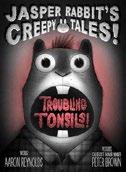
What terrors lurk within your mouth? Jasper Rabbit knows. “You have stumbled your way into the unknown.” The young bunny introduced in Reynolds and Brown’s Caldecott Honor–winning picture book, Creepy Carrots (2012), takes up Rod Serling’s mantle, and the fit is perfect. Mimicking an episode of The Twilight Zone, the book follows Charlie Marmot, an average kid with a penchant for the strange and unusual. He’s pleased when his tonsils become infected; maybe once they’re out he can take them to school for show and tell! That’s when bizarre things start to happen: Noises in the night. Slimy trails on his bedroom floor. And when Charlie goes in for his surgery, he’s told that the tonsils have disappeared from his throat; clearly something sinister is afoot. Those not yet ready for Goosebumps levels of horror will find this a welcome starter pack. Reynolds has perfected the tension he employed in his Creepy Tales! series, and partner in crime Brown imbues each illustration with both humor and a delicate undercurrent of dark foreshadowing. While the fleshy pink tonsils—the sole spot of color in this black-and-white world—aren’t outrageously gross, there’s
something distinctly disgusting about them. And though the book stars cute, furry woodland creatures, the spooky surprise ending is 100% otherworldly— a marvelous moment of twisted logic. Extraordinary introductory terror, beautiful to the eye and sure to delight younger horror enthusiasts. (Early chapter book. 6-9)
Rodari, Gianni | Illus. by Dasha Tolstikova Trans. by Antony Shugaar | Enchanted Lion
Books (256 pp.) | $29.95 | October 28, 2025 9781592704163
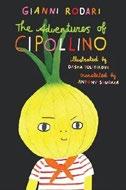
Common types of garden produce repeatedly thwart their upper-class fruit and veggie overlords in this droll translated classic, originally published in Italy in 1951 and selected by Hayao Miyazaki as one of his 50 favorite children’s books.
Hans Christian Andersen Award–winner Rodari’s Pinocchio-style picaresque features an intrepid young onion who’s bent on obeying his father’s instructions to go out into the world and study the ways of scoundrels. Repeatedly imprisoned (“But what else can you expect,” remarks the puckish narrator; “When you’re born an onion, you’re bound to come to tears”), Cipollino nonetheless makes fools of choleric nemesis Cavalier Tomato, insatiable gourmand Baron Sweet-Orange, and other aristocrats with help from sympathetic housemaid Strawberryette and other humble allies. Tolstikova’s watercolorstyle illustrations, which are new for this first English edition, brighten nearly every spread with scenes of anthropomorphic figures topped by fruit or vegetable heads and joined by the occasional animatedly talking spider, mole, or other animal. Soldierly Ponderosa lemons march back and forth, and in one chapter the despicable Prince Lemon cruelly mistreats some cucumber horses, but in general the episodic tale has more satire than violence. In the end, a Republic is proclaimed, the prince winds up with his head in a dung
pile, and a castle is turned into a playhouse. Just deserts all round. Sly, silly fun with political and class-war overtones. (cast of characters) (Illustrated fiction. 9-14)
Rundell, Katherine | Illus. by Ashley Mackenzie | Knopf (304 pp.) | $15.99
September 11, 2025 | 9780593809907
Series: Impossible Creatures, 2
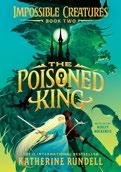
Following the events of Impossible Creatures (2024), a devoted Guardian teams up with a brave princess to fight her powerhungry uncle and save the Archipelago’s dragons from a strange new threat. Jacques the dragon summons Christopher Forrester back to the Archipelago from the human world: Dragons are dying, and no one knows why. Meanwhile, on the island of Dousha, Princess Anya’s grandfather, King Halam, has been murdered, and her father accused— though she knows he’s innocent. When Christopher and Anya take refuge on the islet of Glimt, the Berserker Nighthand helps them see how their twin missions to save the dragons and free Anya’s father are connected. They work together to create an antidote for the poison that’s killing the dragons and to keep Anya and her father safe from her murderous uncle. Meanwhile, Nighthand and Irian, the partnereid ocean scholar, pursue their own important secret mission. Divided into three parts—“Castle,” “Dragons,” and “Revenge”—and containing elements of fairy tales, fantasy, and Shakespeare, this story continues the storyline established in the series opener, yet because it introduces new characters and obstacles, it could also stand alone. Dark-blond Anya (“five feet tall and all of it claws”) is a match for white-presenting Christopher, who, though he still misses Mal, finds that “it made a difference to have someone to move through the world with again. A friend changed the feel of the universe.”
Mackenzie’s delicate, otherworldly art adorns the text.
A spectacular return to a magical world. (map, bestiary) (Fantasy. 10-15)
Sloan, Holly Goldberg | Rocky Pond Books/Penguin (208 pp.) | $17.99 October 7, 2025 | 9780593530252
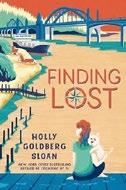
A young girl discovers that sometimes the things we need most find us first. Middle schooler Cordy, short for Cordelia, feels as though she’s carrying an invisible backpack filled with sand—the weight of grief, two years and four months after losing her fisherman father to “The Accident.” Cordy desperately seeks signs of good luck while trying to hold her fractured family together. Then a hungry, foul-breathed stray follows her home to her family’s rental, an old, leaky boathouse on the Oregon coast. She names the pooch Lost; the dog’s dental issues introduce the family to Pakistani American Taj, a veterinarian whose kindness extends far beyond animal care. Sloan populates her story with well-realized adult characters who genuinely show up for children, among them a heavy metal–loving librarian who gifts Cordy a backpack and elderly Mrs. Crowley with her vintage Polaroid camera. The Oregon setting isn’t mere backdrop; Cordy’s fascination with marine life, from molting crabs to a rare pink dolphin, is woven seamlessly into her emotional journey. While there’s “always a chance of rain” both literally and figuratively, Sloan’s gentle wisdom shines through: “So much stuff is how you choose to see it.” Young people will recognize Cordy’s fierce protectiveness and her struggle with change, even if they’ve never experienced a life-altering loss themselves. Red-haired Cordy presents white.
Heartwarming and hopeful—readers will treasure this story of family and resilience. (author’s note) (Fiction. 9-12)
Kirkus Star
Stevenson, ND | Quill Tree Books/ HarperCollins (432 pp.) | $19.99
September 23, 2025 | 9780063210349
Series: Scarlet Morning, 1

Two lonely children find adventure on the high seas. On the desolate salt-strewn land of Caveat in Dickerson’s Sea, Viola and Wilmur lived with their ill-tempered caretaker, Hestur. She told the children all about how the salt came to ravage the land following a cataclysmic event called the Great Blow, which transpired after a bloodthirsty pirate known as Scarlet Morning murdered the beloved queen, Hail Meridian, and stole her crown. After waking up one day to find Hestur gone, the children grew up in isolation. When a pirate ship, the Calamary Rose, captained by the delightfully snarky Cadence Chase, arrives on Caveat’s shores, Viola and Wilmur decide to join them. They soon find themselves on an epic, swashbuckling journey replete with revelry, drama, secrets, cursed (and very creepy) sea gulls, and (perhaps their most difficult challenge) separation from each other. Acclaimed graphic novelist Stevenson shines in his prose debut; his worldbuilding is clever and highly immersive, conveying an atmosphere that’s completely novel while also nostalgic. With its pirates, magic, adventure, friendship, and found family, this middle-grade gem comes very close to achieving the impossible—having something for everyone. The edge-of-your-seat cliffhanger ending will leave readers panting for the next series entry. Fluid, atmospheric spot art and full-page illustrations punctuate the text, adding to the dramatic tension. The artwork shows Wilmur with light skin and a shock of spiky hair and Viola with dark skin and Afro-textured hair.
Engaging, exciting, and enthralling in equal measure. (Fantasy. 8-12)

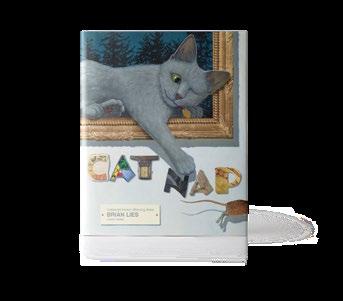
What’s new in the world of kid lit this autumn? Cats, for one—I count no less than five feline-related stories among this year’s Fall Preview titles. I’m especially partial to Brian Lies’ picture book Cat Nap (Greenwillow Books, September 30), in which a mischievous kitten, chasing a mouse, leaps into a framed poster for the Metropolitan Museum of Art. Both creatures find themselves interacting with real-life works housed there, among them a Georgia O’Keeffe landscape, a 14th-century French prayer book, and an ancient Egyptian ceramic hippo— all of which Lies re-created by hand. The result is a true masterpiece. Don’t sleep on the backmatter, either; in an age when artificial intelligence has made generating images effortless, Lies’ parting message—the artistic journey matters just as much as the finished product—is one we all need to hear.
While the selections on our Fall Preview list are wildly different, from goofy read-alouds to tales of terror, like Lies’ work, they’re all clearly labors of love. Take Eric Velasquez’s picture book The Polar Bear and the Ballerina (Holiday House, October 14). When an



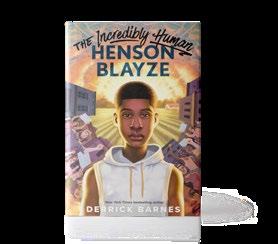
artistically minded polar bear leaves Central Park and lumbers across town to Lincoln Center to enjoy a ballet performance, the theater workers recoil—until the young Black girl starring in the show intervenes. With its elegantly dreamy visuals, this nearly wordless tale speaks volumes: Ballet is indeed for everyone.
The rise of a new talent is always a thrill. Howie Shia, a celebrated children’s animator, makes his literary debut with Ra! Ta! Ma! Cue! (Annick Press, September 30), a fanciful picture book about children wielding the power of music to stand up to the monsters menacing their community. Shia balances dynamic visual compositions with compelling text; the titular
refrain—a well-known marching drum pattern— is a rallying cry that youngsters will eagerly echo during read-alouds.
Just as rewarding is a new work from a beloved creator, and what’s better than a book from Derrick Barnes? The Incredibly Human Henson Blayze (Viking, September 23) follows a Black eighth grade football talent who’s idolized by his town—until he leaves the big game midway through it after learning that his best friend was the victim of racist violence. Barnes threads this beautifully crafted novel with trenchant observations about the precarious role Black athletes and entertainers hold in American society: worshipped until they step out of line, then cast aside and shunned.
Finally, as a committed nonfiction reader, I’m especially excited for Lindsey Fitzharris and Adrian Teal’s middle-grade work Dead Ends!: Flukes, Flops & Failures That Sparked Medical Marvels (Bloomsbury, October 14). I’ve found that kids are never more absorbed than when they’re a bit grossed out— and there’s no shortage of that here. Blood? Check. Guts? Yup. But Fitzharris and Teal also offer important food for thought, arguing that grave mistakes indirectly led to breakthroughs such as pacemakers, blood transfusions, and organ transplants. It’s a sound lesson for would-be doctors— or anyone trying to get over a case of perfectionism.
Mahnaz Dar is a young readers’ editor.
Two young Indigenous cousins share a magical, moonlit adventure in this wintry bedtime story that celebrates Tlingit culture and light found on the darkest of nights.
After the children scout for deer by “a rosy dawn,” fish for salmon “by a radiant sunset,” and clam “beneath a twinkling sky,” the day ends as generations “gather by the hearth in the warm glow of home.” At bedtime, one of the children, nervous about the dark, asks for a story, and the other—the book’s narrator—launches into a cozy and vivid tale, set in a snow-blanketed forest.
Concise, descriptive language tracks the cousins’ imaginary jaunt through dark woods as Moon sings to them: “Slip under spruce, slink past cedar, delve deep into a velvety hush.” Watercolor and mixed-media illustrations in luxuriant jewel tones depict gently sweeping, dreamy scenes dotted with wildlife and illuminated by moonlight sparkling between thick trees, with the northern lights dancing overhead. Refrains of “Come! Haagú!” draw them onward, and “Daa sáyú? What could it be?” invites readers to pause and wonder alongside the curious

Goade, Michaela | Little, Brown | 40 pp. October 7, 2025 | $18.99 | 9780316461634
nighttime explorers before the story of Moon’s song brings them peacefully home. Caldecott Medalist Goade reverentially shares elements of her Tlingit heritage through joyful
language and symbolismrich imagery.
A soothing and appreciative ode to family, the moon, and winter’s welcoming embrace. (author’s note) (Picture book. 4-8)
CHLOE VEGA AND THE AGENTS OF MAGIC
Abari, Tonya | Illus. by Lance Evans Harper/HarperCollins (40 pp.) | $19.99 October 7, 2025 | 9780063265769
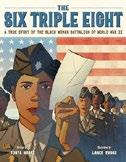
An inspiring chronicle of the all-women, African American 6888th Central Postal Directory Battalion, which saved the U.S. mail system during World War II. By 1945, mail delivery in Europe had stalled. Weary soldiers were becoming homesick. But “powerful people came up with a powerful plan” to put someone new on the job—the 6888th (referred to here as the Six Triple Eight). With the rallying cry “no mail, low morale,” these women cleared the enormous mail backlog, first in England and then in France. Overcoming challenges including racism and cold conditions, they redirected more than 17 million pieces of mail. While few remembered the women who were “the glue for service members,” with this admirable introduction to their significant contributions, Abari ensures that they will never be forgotten. She establishes a comprehensible timeline that covers huge swaths of information, including “Rosie the Riveter,” segregation, collaboration between civil rights activists and politicians, and more. The narrative occasionally feels a little bulky, and the book’s framing is somewhat bewildering. It opens by naming six members of the Six Triple Eight, but it doesn’t explicitly state why these particular women were
chosen or the roles of all six. Thankfully the backmatter fills in those gaps with verve and clarity. Evans’ handsome, desaturated digital art evokes the period aesthetic of old-time war posters. Creamy backgrounds and angular, overlapping portraits create an appropriate tone of solemnity.
A worthy read that bears witness to the brave women of the Six Triple Eight. (timeline, glossary, more to explore, sources) (Informational picture book. 6-9)
Adame, Leslie | Harper/HarperCollins (400 pp.) $19.99 | September 16, 2025 | 9780063341999 Series: Chloe Vega and the Agents of Magic, 1
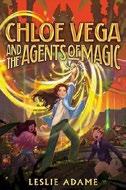
Twelve-year-old Chloe Vega lives in a constant state of worry.
Her parents are undocumented, and she fears they could be deported at any moment. Things become even more complicated when she crosses paths with her mysterious upstairs neighbor, Ms. O, known around the apartment complex as la bruja, or “the witch.” She gives Chloe a strange glowing glass rod that seems to hold magical powers. Soon, ominous figures begin following Chloe’s family. She assumes they’re immigration officers, but when her parents are taken, she learns the truth: These men are actually the henchmen of the powerful sorcerer Osthall. Chloe is rescued by Nicholas Morris and Danielle Acevedo, a boy and girl who reveal that her parents’ reasons for
leaving Mexico were more complex than she ever knew—and that they’ve long been in conflict with Osthall. With her family in danger, Chloe must tap into her own emerging magic. She enrolls at the Academy for Earth’s Agents of Magic, where she begins training and forms alliances with other magically gifted students. Along the way, she discovers a hidden magical world and her own place within it. Adame’s debut is a compelling addition to the genre, blending high-stakes adventure with thoughtfully developed themes of borders, identity, and family separation. The worldbuilding is rich and imaginative, and the cast of characters—many of whom, like Chloe, are Latine—is refreshingly diverse.
A socially conscious fantasy full of danger, discovery, and heart. (author’s note) (Fantasy. 8-12)
Adelman, Hallee | Illus. by Patrick Corrigan | Whitman (32 pp.) | $18.99 September 4, 2025 | 9780807530955
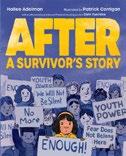
An empowering portrait of a life transformed—but not determined— by trauma. This affirming narrative begins in the wake of a Horrible Day. As well-meaning grown-ups suggest just how fortunate the protagonist is to have survived the ordeal, our elementary-aged narrator balks, cloaked in an anxiety that clings like a sticky second skin. The child feels safest with pal Alex, another Horrible Day survivor. Together, they occupy a space free from talk of luck or silver linings, processing the experience without pressure and remembering those lost to the catastrophic violence. When the protagonist hears tell of another Horrible Day, the family attends a protest where they join countless, similarly affected Others, united in the fight for action. In their
company, the youngster makes a liberating discovery—that a community wrought from Horrible Days is a community nonetheless and that solidarity can make the days that follow tragedy a little more tenable. Adelman’s text celebrates resilience without diminishing its power with pity nor demanding that young people rush the recovery process, while Corrigan’s cerulean-hued art softens the sharpness of the subject. And though gun violence is heavily implied throughout, the Horrible Day’s precipitating event is never explicitly named, an elision that offers readers breathing room to understand their own formative traumas. An afterword from Sam Fuentes, who survived the 2018 Parkland shooting, offers additional information; the protagonist is brown-skinned, while supporting characters vary in skin tone. An exceptional tool for navigating the unimaginable. (Picture book. 6-9)
Baden, Morgan | Pixel+Ink (240 pp.) | $16.99 September 9, 2025 | 9781645952695

Seeking fame through social media, four friends end up truthfully examining themselves in this amusing and thoughtful series opener.
While the four Rowan Roadies— neighbors, two sets of siblings, and the children of parents who are best friends—were once inseparable, they drifted apart as they grew up and had other demands on their time. But they reconnect in middle school. Sophie Magee and Luke Gage-Flashman are in seventh grade, and Gus Magee and Harper Gage-Flashman are in sixth grade. Harper’s a theater kid, Gus is a star soccer player (who secretly loves writing), neurodivergent Luke is a tech whiz, and Sophie constantly changes extracurriculars. One night when Luke
and Harper’s moms are out with Sophie and Gus’ mom and dad, the friends film a live-action video inspired by a popular video game. The kids were left with a strict list of house rules, but things get “a teeny bit out of control. Just, like, a smidge.” Harper posts the video to the social media platform Cre8, where it quickly goes viral. Their costumes hide their faces, but as they create more videos, they discover the cost of online fame. The novel loses some steam as the kids repeatedly attempt to go viral, but the book raises vital questions about social media and technology. The four leads share the humorous narration, which includes group chats and fan comments and will hold readers’ attention. Luke and Harper read white, and Gus and Sophie are cued Black. Absorbing and thought-provoking. (Fiction. 9-12)
Banbury, Steven | Illus. by Matt Rockefeller Little, Brown (240 pp.) | $8.99 paper September 2, 2025 | 9780316573023 Series: The Pumpkin Princess, 2

The Pumpkin Princess faces a new foe and learns a lot about herself. It’s been several months since the Forever Night, when the undead community of Hallowell came together to save Eve, the only living being in the valley. Her adoptive father, the Pumpkin King, hasn’t yet had great success with teaching her his magic, but when Eve starts seeing a strange green-eyed shadow creature and her body experiences unexpected changes that mirror those of various types of the undead, it’s time to call in reinforcements. Thankfully she has her two best friends—witch Lyla and vampire Vlad—for support (the trio present white). There’s a big evil lurking in secret, hidden places, though, which
will put Eve’s new skills and loyalties to the test. Banbury’s bighearted tale features Rockefeller’s appealing spot art at the start of each chapter. The story opens by covering the worldbuilding and events from the first book, making it accessible to new readers but slowing the start, although the charming cast is as lovable as ever. Once the drama amps up, thrilling action scenes and surprising reveals keep the excitement level up. Joy and love are throughlines, even when the characters face scary or challenging situations. The plot has a strong emotional component as Eve continues to deepen her loving relationship with her dad and grows into a leadership role within the valley.
Another cozy, spooky adventure in an enchanting world. (Fantasy. 8-12)
Barry, Robert | Doubleday (40 pp.) | $18.99 October 21, 2025 | 9780593708194
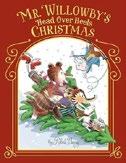
A beloved Yuletide story gets an unexpected sequel, replete with hijinks. Recently discovered in an overstuffed file cabinet by Barry’s son, this follow-up to Mr. Willowby’s Christmas Tree (1963) has finally found its way to publication, decades after its creation. Plagued once more by Christmas tree woes, Mr. Willowby, a mustachioed, white-presenting elder, is pacing his stately manor. Whereas in the previous book, his tree was too tall, now it looks like he won’t have one at all! The delivery van is stuck in the snow, leaving the kindly old man bereft. Along comes Barnaby Bear, who, upon seeing his friend’s plight, finds an ideal tree on a hill high above and makes the unfortunate decision to ride the conifer down to the house. Turns out, steering a tree is an impossibility, and the next thing you know, Frisky Fox, Dusty Duck, Benjamin Rabbit, and Mistletoe
Mouse are along for the ride. A crashlanding through Mr. Willowby’s front door and a special cameo appearance from Santa all make this the happiest holiday on record. Readers young and old needn’t have any familiarity with Mr. Willowby’s earlier Christmastide adventure to appreciate the wild antics. Barry’s tale hasn’t aged a day; its rhymes remain intact and scan with alacrity, while the fun and frolicsome art taps into the cartoonish nature of the shenanigans. Ho ho ho and a merry publication to an old classic newly found. (Picture book. 4-7)
Battilana, Jessica with Yekaterina Boytsova Illus. by Jordan Sondler | Photos by Rick Holbrook | Simon & Schuster (280 pp.)
$21.99 | September 30, 2025 | 9781665930666

Fun and practical recipes for both beginning and experienced young bakers. This comprehensive baking guide offers clear, step-by-step instructions grounded in baking science, many of them accompanied by photographs, to help young people create magic with their stovetops and ovens. Divided into two major sections—“Sweet Recipes” and “Salty Recipes”—the book covers a broad range of types of treats, including cakes, cookies, scones, muffins, pies, and sweet toppings as well as savory breads, crackers, and biscuits. The recipes include some foods from global culinary traditions, like Latin American pupusas, Korean jeon, and Indian naan. The book opens with essential tips, an annotated list of tools and types of pans (with photos), and 10 tips for success, one of which is choosing a recipe of the right difficulty level. The recipes are helpfully labeled “easy” (meringues), “medium” (monkey bread), or “project” (profiteroles). Racially diverse young bakers
appear beside the bright photographs of appetizing bakes. Readers will benefit from the informative two-page spreads explaining techniques that are interspersed throughout, such as “Cake Gymnastics,” which shows, in a sequence of five photos, how to remove a cake from a pan. The authors seamlessly integrate scientific tidbits into sidebars, such as one that explains the role of acidic ingredients like vinegar in cakemaking or the importance of cold ingredients for flaky pie crusts. The colorful, eye- catching design enhances the reading experience. Accessible, mouth-watering bakes both encourage and instruct emerging bakers. (index) (Nonfiction. 9-14)
Beckerman, Nell Cross | Illus. by Kalen Chock Orchard/Scholastic (40 pp.) | $19.99 November 4, 2025 | 9781546130970
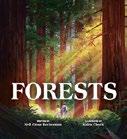
A poetic salute to the world’s forests and many of the wonders they contain. The beauty and visual depth that inform Chock’s stately forest scenes, rich in color and photographically exact in detail, find suitable echoes in Beckerman’s alliterative, sensual free verse. “Munching mouthfuls of bursting blueberries, / you inhale fertile earth while hunting for / morels and fairy circles.” The tour begins in a misty temperate forest, then branches out to encompass other forest types and locales, from lush Amazonian rain forest to oyamel firs hung about with migrant monarch butterflies in a “tangerine dream,” a stand of Japanese bamboo dappled with swirls of sunlight, an urban forest, and even an underwater kelp forest with a drowsy otter nosing through. In prose commentary running beneath, the author clearly describes each type and, for specific sites, what makes each distinctive. Along the way, she fills
readers in on the ways wildlife, trees, and fungi interact, as well as on the effects and increasing dangers of wildfires; in the backmatter she offers useful guidelines for planting trees and conserving shrinking woodlands. “So much to see,” she writes, “to smell, / to hear, / to taste, / to feel.” Small human figures appear occasionally, but typically in silhouette or facing away from viewers.
A spellbinding tour, deeply rooted in both fact and feeling. (author’s and illustrator’s notes, further reading and viewing, more fascinating forests) (Informational picture book. 6-8)
Bellows, Melina Gerosa & Katie Hafner Illus. by Karyn Lee | Bright Matter Books (208 pp.) | $17.99 | August 19, 2025 9780593896716

Based on the podcast of the same name, co-founded by co-author Hafner, profiles of significant yet overlooked female scientists.
Writing in trustworthy, matter-of-fact prose, Bellows and Hafner introduce readers to 10 STEM dynamos, among them Eunice Newton Foote, “the Mother of Climate Science,” who identified the greenhouse effect; cryptanalyst Elizabeth Smith Friedman, whose codebreaking efforts helped the U.S. government bring down Mafia bootleggers and infiltrate Nazi spy networks; and Cecilia PayneGaposchkin, who deduced the primary makeup of stars. Others were influential in the fields of mycology, modern computer programming, ethnobotany, and mechanical engineering. Also profiled is Leona Zacharias, Hafner’s grandmother, a nearly forgotten member of the team that solved the mystery of why premature infants were going blind in the 1940s. Each chapter
opens with a sketched portrait and a quick roundup of high notes before launching into the biographies. Recurring themes of the scientists being denied opportunities, jobs, and credentials due to their gender and (in some cases) their race demonstrate their strength of character, determination, and intellect. The scientific sidebars are particularly strong, explaining concepts to young readers without talking down to them, as well as encouraging curiosity and occasionally providing activities to try out. Black-and-white photographs supplement the text, adding visual interest. As inspirational as it is informative and—importantly—genuinely enjoyable. (bibliography, image credits, about the Lost Women of Science Initiative) (Nonfiction. 8-14)
Belote, Ashley | Random House (40 pp.) $18.99 | November 18, 2025 | 9780593902431

A child’s love soothes even the most savage heart in this revisionist version of the classic fairy tale. On the way to Great-Grandpa’s house, Little Red (short for Redmond Jasper Jones)— attired in red overalls, shoes, and cap—frequently runs into Fred, a large gray wolf who’s positively salivating over the possibility of a juicy meal. Little Red’s delighted to see Fred (the child dubs him the “coolest, biggest, fluffiest…KITTY in the whole wild world”); Fred’s just as happy to see Little Red, but for entirely different reasons. Fred’s constantly setting traps for Little Red, which the unaware child somehow manages to sidestep at the last minute. When temperatures plummet, Fred is injured while attempting to snare Little Red, so the child takes him to Great-Grandpa’s house. There, the youngster learns Fred is not a cat; bespectacled GreatGrandpa points out that Fred is in fact…a dog. Close enough? With plentiful meals and treats and a toasty
bed, Fred is unsure whether his benefactor is a friend or food, but he decides to go along with it. Belote’s snappy text mines great humor from the gulf between Little Red’s trusting attitude and Fred’s clearly nefarious intentions; youngsters will derive great satisfaction from seeing what Little Red so obviously misses. The exaggerated art is filled with hijinks; the near misses will remind many adults of the Roadrunner and Coyote cartoons. Little Red is brown-skinned; GreatGrandpa is pale-skinned.
A meaty tale of unlikely friendship. (Picture book. 4-7)
Zilbo’s
Benton, Summer | HarperAlley (32 pp.)
$17.99 | October 7, 2025 | 9780063460454
Series: I Can Read! Comics

A group of forest friends experience a series of miscommunications.
Zilbo the dog feels grouchy; his mood is clear from the look on his face and the squiggly little line of frustration above his head. His friend Bogo, a pink bear, is discomfited by Zilbo’s refusal to respond to Bogo’s greeting; Bogo in turn stalks about with a sour expression. When Bogo blows off Hula the horse, she’s left feeling upset, and the chain continues until Mara, a sweater-clad mouse, asks another friend if she’s OK, and they follow the thread of negative exchanges back to the original grouchy-pants. As it turns out, Zilbo was preoccupied with a lost shoe, but luckily the whole crew helps him
find it! Readers of all ages will relate to how quickly a seemingly mean-spirited interaction can beget a negative response—and the animal community’s willingness to repair the rift collaboratively conveys the radically positive point that getting curious and staying kind will help everyone. This graphic novel is drawn in a minimalist, brightly colored hipster style, placing the emphasis on the story over the surroundings and illuminating the characters’ broad, relatable emotions. With a lively cast, colorful cartooning, and a lucidly laid out storyline, this deceptively simple book simultaneously encourages new readers with clear text, provides amusement, and has a deep emotional resonance: a rare feat. Sweet, eye-catching, and witty: a gift to young readers. (Graphic early reader. 4-8)
Birdsong, Bea | Illus. by Jasu Hu Neal Porter/Holiday House (48 pp.)
$18.99 | October 7, 2025 | 9780823453962

A school assignment to create a family tree and present it to the class causes anxiety in Emmylou— until the child comes to a new understanding of family Emmylou’s classmates’ trees seem to have branches on branches, but the youngster has just two: “Mama and me.” Tentatively, Emmylou broaches the subject with Mama, starting by asking, “What was my grandmother’s name?” Mama answers; then her “lips press together / tight / tight / tight” before offering one more tidbit: The
A sensitive answer to a potentially insensitive school exercise.
recipe for the cake Mama is baking came from Emmylou’s grandmother. Listeners don’t learn why “Mama never says” the names of Emmylou’s father or grandfather, but it’s clear Emmylou is nevertheless part of a supportive community. Subsequent pages interleave other students’ presentations with Emmylou’s interactions with loving, caring neighbors, and little ones will likely be ahead of Emmylou in arriving at the answer to the dilemma. Sure enough, on the day of the presentation, Mr. Li, Mrs. Patel, and Rosa and Gabriel and their twins join Grandma Louella, Mama, and Emmylou on the found-family tree. References to Emmylou’s “good ear” indicate that the youngster is hard of hearing. Hu threads ginkgo branches through her muted, watercolor-indigital illustrations with the same nuance Birdsong brings to her text. Appearing both symbolically and literally, the branches gracefully reinforce the story’s themes. Both Emmylou and Mama have straight, brown hair and pale skin; their neighborhood is robustly diverse. A sensitive answer to a potentially insensitive and sadly common school exercise. (Picture book. 4-8)
Blitt, Natalie | Scholastic (256 pp.) | $8.99 paper September 2, 2025 | 9798225003999

In this work originally published in 2019 as Cocoa Crush, 12-year-old Harper Evans once dominated the hockey rink, but an accident has left her scared to set foot on the ice.
Now working at a hot cocoa stand at her local skating rink in New Hampshire, Harper focuses on perfecting her hot chocolate recipes and hiding from her former teammates. But a meet-cute with well-known young figure skater Jason D’Andre (who’s also 12) and the opportunity to mentor aspiring hockey
A sports story with a sweet romance and a positive message about grit.
BREAKING
player Bronte might just be what Harper needs to get back in the rink. With the support of former best friend and team captain Bea, as well as Jason and Bronte, Harper begins to overcome her fears and to discover her inner strength. Blitt explores powerful themes of resilience and self-forgiveness while touching on the struggles of being a girl in sports, and the well-developed side characters have their own challenges and motivations. Many young athletes will relate to the setbacks Jason and Harper face in their respective sports and will be inspired by their determination. The blossoming romance between the two adds to their compelling dynamic and is sure to delight young romance fans. Harper, Bea, and Bronte read white, and Jason has light brown skin. A sports story with a sweet romance and a positive message about grit. (Fiction. 9-13)
Bragg, Sam | HarperAlley (384 pp.)
$15.99 paper | September 23, 2025 9780063448247 | Series: Hooves of Death, 1

Battle-hardened unicorns may be humanity’s last hope as the zombie apocalypse rages on in this popular WEBTOON comic that’s now available in print.
In remote Yellowstone National Park, a band of refugees shelter from hordes of zombies and are supported by a magical herd of unicorns who happen to be immune to their plague. When food runs scarce, unicorn sergeant Glitter is sent on
a scouting mission and stumbles upon Kate, a fierce blond, blue-eyed girl who’s living on her own. The pair team up with two other strong unicorns, but it seems the undead aren’t their only enemy— Kate is being hunted by a Grim, a black wolflike henchman of Death himself. During their quest to unravel the cause of humanity’s downfall, they encounter mischievous sirens and their beefy boyfriends (who are being held hostage), zombie gnomes, a band of Bigfoots, and even a vampire. Though the creatures aren’t the biggest fans of humans, it becomes clear through the nefarious involvement of the horsemen of the apocalypse that Kate just may be the key to ending all the suffering. The violence and general despair balance the cuteness. Bragg’s unicorns are deceptively adorable, even with grenades hanging around their necks and rainbow blood dripping from the zombie bites on their bodies. A sinister cliffhanger will leave readers neighing for the next installment of these heroes’ quest.
Who knew unicorns could kick so much tail? Saddle up for a grim, glittering, and gory ride. (Graphic fantasy. 10-13)
Brown, Don | Abrams Fanfare (128 pp.)
$15.99 | October 21, 2025 | 9781419779961
Series: Big Ideas That Changed the World, 7

A graphic history of sanitation, from indoor toilets in Scotland 8,000 years ago to the advent of chlorinated water in 1908.
Concluding with a massive bibliography but
written and illustrated in the spirit of a middle school term paper, this latest in the Big Ideas series offers heaping piles of yuks and yucks. Narrator George E. Waring Jr.—a 19th-century engineer whose pioneering efforts resulted in cleaner streets in Memphis and New York City—discourses anecdotally on the world-changing development of public and private toilets, sewers, bathing, soap, and purified drinking water. Taking evident delight in depicting nauseated people, polluted waterways, and pipes pouring raw sewage into the latter in his big, loosely drawn panels, the author/illustrator describes sanitation practices of everyone from space travelers (“Is that a comet?” “Nope, flaming poop”) to the ancient Greeks, Romans, and Chinese. Though he does dispense nods to “fatbergs,” rubber duckies, and other random nuggets along the way, in general the informational load is light at best. For instance, he doesn’t mention many significant public health scientists (a reference to Dr. John Snow is relegated to the timeline), antiseptics, or even what the “certain rocks” or “special powder” used for water purification might be called. In a sudden change of tone at the end, Brown tacks on a concerned but perfunctory call to recognize that even today, two billion people lack access to clean water.
A superficial treatment of an undeniably big idea. (more information on George E. Waring Jr., notes, author’s note, index) (Graphic nonfiction. 8-11)
Coco, María | Rise x Penguin Workshop (64 pp.) $19.99 | October 21, 2025 | 9780593890608
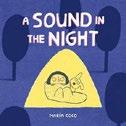
Fear transforms into friendship in this strikingly illustrated work. Though Coco limits herself to a palette of blue, yellow, orange, and pink, her nearwordless storytelling fills the pages in other ways. Accompanied by a pet dog, our protagonist (who looks childlike
but is capable of driving a car) packs up for a wilderness adventure. After pitching a tent, swimming, and playing a little fetch, the two build a campfire and go to bed. At first it’s quiet, but all too soon, the duo are wide-eyed and terrified as they hear a series of “cracks.” The dog recovers first, and after some hesitation, they both venture forth to see what’s making that sound. In the flick of a flashlight, their scary nighttime companion turns out to simply be a stray kitty. The cat accompanies them on their outdoor adventures and, when it’s time to go home, makes their duo a trio. For all the book’s seeming simplicity, it’s rife with clever details; toward the end, the cat initially seems to have been left behind, but a tell-tale tail in the car hints otherwise. Reminiscent of Picasso’s work at times, the art, rendered in colored and grease pencil, depicts the protagonist with round eyes, a triangular pink nose, and skin the white of the page. A demonstration that words are unnecessary when there’s fun storytelling to be had. (Picture book. 3-6)
Dauber, J.A. | Aladdin (320 pp.) | $17.99 September 9, 2025 | 9781665974776

A boy learns that Earth is being invaded by aliens, and it’s up to him to save humanity. Matt Pearson just wants to be like other kids and have a phone—but his parents refuse to get him one, saying he has to wait until he’s older. So, when he finds a phone lying on the sidewalk, Matt pockets it, planning to tell his friend Geno that it was on back order and just arrived. But this phone is strange—it has apps that don’t work, it won’t connect to the internet, and the battery doesn’t lose its charge. One thing Matt can do is take pictures with it. When he gets to school the next day, he has a big shock: The photo he takes of the crossing guard, Mr.
Mackintosh, shows a purple, beaked creature with sharp teeth and “googly, goggly eyes on stalks—six of them, or maybe seven.” Ten-year-old Matt freaks out and then contacts his friend and secret crush, Marcela Robertson, for help. It turns out that lunch server Mrs. MacGillicuddy is an alien, too—she and Mr. Mackintosh arrived in a warship from a society so advanced that they “could reduce the entire planet to a cinder.” Can the kids stop them in time? This humorous, fastpaced story has a light tone and plenty of action to keep readers hooked. Main characters present white. Twists and turns and lots of silliness make this an appealing choice.
(Science fiction. 8-12)
Davidson, Brad | Illus. by Rachel Más Davidson | Kids Can (32 pp.) | $19.99 September 2, 2025 | 9781525312977

T hese pals know and love everything about each other.
“I like your face. It’s super special. Like an ultra-rare trading card or that giant pink octopus at the aquarium.” So begins a tribute to friendship between two adorable tots. Though the tale is narrated in first person, it’s never clear which is speaking, but the loving sentiments are clearly felt by both. These youngsters know each other—and their faces—so well that they could spot one another “in a crowd of a million gazillion people.” The kids list all the faces they enjoy making—silly ones, “hangry” ones, even the “holding-in-a-fart” face. Davidson’s text is rife with goofy, kid-friendly humor, but it also offers comforting revelations: “We even know each other’s ‘Pretending-to-Be-Brave Faces…although when we’re together, I never feel like I have to pretend.” For these two, friendship means listening, showing up, being a team, and feeling safe enough to reveal one’s vulnerable side; friends are the people who will empathize with and understand you no matter what. Más Davidson’s cartoon
illustrations place the round-headed youngsters in a variety of entertaining situations: watching fireworks, attending school, and (in a scene where they envision the future) still friends as elders winning a Halloween costume at their retirement community. Uncluttered backgrounds keep the emphasis on their shining, expressive faces. One of the kids presents Black; the other is pale-skinned and dark-haired. A sweet celebration of childhood friendship. (Picture book. 4-7)
Retold by Sandra Dieckmann | Illus. by Sandra Dieckmann | Candlewick (176 pp.)
$19.99 | October 21, 2025 | 9781536236491
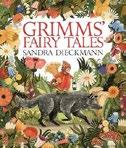
Twenty stories from the Brothers Grimm receive boldly inclusive updates. The collection balances familiar favorites like “Sleeping Beauty” and “Puss in Boots” with lesser-known gems such as “Jorinda and Joringel” and “Mother Holle.” Dieckmann makes changes to incorporate contemporary values around gender and sexuality; she often refers to babies as them , while samesex couples appear dancing front and center at Cinderella’s ball. The work sometimes departs from the original plotlines in surprising ways—“Rapunzel,” for instance, introduces protective animals that don’t appear in the Grimm version. Unlike many modern children’s adaptations, the tales don’t shy away from the hardships, dangers, and consequences that give these stories their emotional impact, retaining elements such as beheadings and infidelity. The illustrations are the volume’s greatest strength. Dieckmann’s use of rich, saturated colors creates an enchanting atmosphere—deep forest greens, cool night blues, and warm golden yellows bring the scenes to life. Her decorative borders are particularly thoughtful, reflecting and enhancing each story’s setting, such as the intricate flowers, mushrooms, and small woodland
creatures that frame “Cinderella” and the moody blue and white nighttime foliage surrounding Hansel and Gretel’s forest journey. Characters are diverse in terms of skin tone, hair color, and body type.
A beautifully illustrated and thoroughly modern fairy-tale anthology. (afterword) (Anthology. 4-9)
Do, Anh | Illus. by Jeremy Ley & Annie Ji Harper/HarperCollins (224 pp.)
$9.99 paper | September 16, 2025
9780063346062 | Series: Wolf Girl, 2
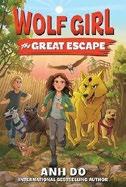
Snatched away from the dog pack she’s been living in the wilderness with since a sudden military takeover, a human girl taken to a labor camp must escape and continue searching for her family.
Following a brief recap of events, the story picks up where the first book left off. Gwen is locked in the back of a truck, pursued by her dog companions, and she leaves scent marks for them by releasing strands of her hair through the bars. Imprisoned in a heavily guarded camp, where children are confined behind high walls topped by barbed wire, she meets fellow captive Rupert, who tells her that he’s seen her parents—and they’re being held with his mum and dad at a nearby adults’ work camp. Gwen becomes more determined than ever to find her dog friends and help the adults escape so they can free the children. Loyalty to their pack leader drives the dogs—a motley assortment of breeds of different sizes—to locate the camp. They cleverly work together to win Gwen’s freedom; Tiny the Chihuahua’s small size proves to be an advantage. Ley’s and Ji’s fluid black-and-white illustrations on nearly every page intensify the nonstop thrills and action. Do explores themes of resilience, courage, and friendship in this spirited tale in which the human and canine characters’ fidelity is tested.
The illustrations depict light-skinned human figures.
A fast-paced story filled with determined and courageous heroes. (Adventure. 8-12)
Downing, Erin Soderberg | Scholastic (240 pp.) $18.99 | September 2, 2025 | 9781546124986

At their family’s summer island home, two cousins unearth a mystery. When Aunt Robbie asks her estranged siblings to return to their estate, the site of childhood vacations, 12-year-old cousins Avery and Jax face intriguing questions. What happened to the aunt whose longago death is a forbidden topic? What will become of the island, which Grandma, who passed away two years earlier, bequeathed to Aunt Robbie? Who wrote the mysterious note describing all the siblings— perhaps a page from a diary?—that Avery found in her mom’s stuff at home? Sleuthing for clues while the adults sort through the accumulated family belongings, Avery and Jax discover more pages of the journal hidden all over the island, with clues to their aunt’s tragic death. A surprise discovery just before leaving the island forces the cousins to decide whether confronting the harsh truth will bring healing or more pain to the family, especially in light of Aunt Robbie’s disclosure that she’s dying from amyotrophic lateral sclerosis (ALS). Told in first-person chapters that alternate between Avery and Jax and interspersed with entries (entitled “Then”) from the journal, this cross between a mystery, family drama, and coming-of-age story is believable, insightful, and well paced, with genuine dialogue. Avery’s and Jax’s growing appreciation of each other’s self-described “faults” is an affirming central
theme, alongside self-acceptance and forgiveness. Characters present white. A compelling summer mystery, with emotional depth and life lessons to boot. (crafts instructions) (Mystery. 9-12)
Drori, Jonathan | Illus. by Jiatong Liu & Raxenne Maniquiz | Magic Cat (64 pp.) | $22.99
September 30, 2025 | 9781917366069

Page through this delightful evergreen garden and come away with a slew of fascinating facts.
“We literally can’t live without them,” Drori says of plants in his introduction to this lovely collection. Many of the 30 specimens he covers will be kitchen familiars: tea, corn, potatoes, pumpkins, rice, and tomatoes. Other items add flavor: vanilla, cacao, pepper, sugar cane, and nutmeg. The plant origins of practical rubber, versatile cotton, and culturally important henna might surprise some readers. The format is the same for all entries: on the right-hand side of each spread, a detailed, labeled, close-up and cross-sectional depiction of the plant and some of its products; on the left, marvelous stories and unexpected pieces of information. Readers will learn how a 12-year-old enslaved boy on the French-colonized island of Réunion invented the technique of fertilizing vanilla flowers, why mandrake was thought to be magical, how NASA uses cork, and what eucalyptus can do besides provide flavor to cough drops. Why does bamboo flowering predict famine in northeastern India? Why do dentists still use gutta-percha latex? Are beech trees really natural lightning conductors? Can a loud high-C whistle delay tomato-ripening? What role do coconuts play on the International Space Station? Young people will find answers to these questions—and more. The artful vignettes from Liu and
GRADY JONES AND THE GREAT DETECTIVE GAME
Maniquiz are realistic, detailed, and colorful; the informative captions are as fresh and accessibly presented as the varieties of vegetation.
A lush botanical bounty. (glossary) (Nonfiction. 8-12)
Dye, Kerry Douglas | Aladdin (336 pp.) | $17.99 September 30, 2025 | 9781665967075

C an a sixth grader who’s determined to be great at something— anything, really— solve a murder?
Redheaded Grady, a middle child whose mom is a nurse and whose father is deceased, approaches every opportunity with enthusiasm, conviction—and zero skills. When a chauffeur-driven woman delivers a note from local millionaire J.T. Bancroft asking Grady to solve his murder, Grady is ecstatic. Everyone else is just confused. But when Bancroft is duly murdered, Grady plunges into the investigation with unbridled verve. Initially oblivious to or dismissive of help offered by friends and family, Grady also discounts everyone’s doubts and breaks promises to his mother. But if he really wants to solve the murder, he must first scrutinize his own attitudes and behavior and learn how to be a true friend. This complex, twisty mystery, a debut by screenwriter Dye, unfolds at a good pace and features wry humor that invites readers to see truths Grady misses. Though Grady’s investigative style is slapdash at best, his ideas do
lead to some valuable clues as he ricochets among plot developments and interactions with other characters. Unfortunately, the self-centeredness and self-aggrandizement that alienate his few friends may likewise irritate readers. Those who stick with him will applaud Grady’s learning to be introspective and coming to terms with what drives his need to achieve. Grady’s family is cued white, and there’s ethnic diversity among the secondary characters. Mystery and humor mix with lessons on friendship and self-awareness. (Mystery. 8-12)
Ferguson, Kerry | Illus. by Aliaa Betawi Rocky Pond Books/Penguin (32 pp.) $18.99 | August 5, 2025 | 9780593700204

A new pet prompts complex emotions. An unnamed pale-skinned child is obsessed with Frank, a green-scaled, rosy-cheeked fish. The youngster documents their relationship in a diary, recording everything from Halloween (“I dressed up as Frank… Frank dressed up as me. Fish friends forever!”) to Valentine’s Day (“We all made cards for Franky. He blushed”).
A poignant entry on February 25 notes that today Frank refused to come out of the shell in his tank; eventually, he dies. The child is devastated; bouts of door-slamming anger ensue (the protagonist dutifully apologies), followed by moments of deep grief, beautifully shown in a mournful double-page spread depicting



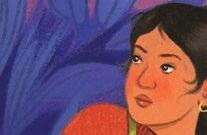

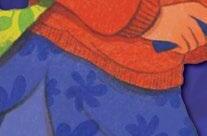













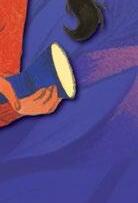


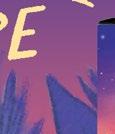


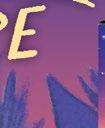





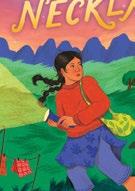
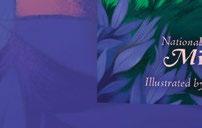









Illustrator of A Change Is Gonna Come
EXUDING BOTH MELANCHOLY and hope, Sam Cooke’s 1964 song “A Change Is Gonna Come” has long been considered the anthem for the Civil Rights Movement. So when Cooke’s estate sought to translate the song to picture-book format, Nikkolas Smith—a talent who’s illustrated works by activist Ruby Bridges and 1619 Project architect Nikole HannahJones—was the obvious choice. With A Change Is Gonna Come, Smith made the inspired decision to tell the story from the perspective of a photographer documenting crucial moments in the movement, from the death of Medgar Evers to the signing of the Civil Rights Act of 1964. Smith answered our questions via email.
photographer documenting the Civil Rights Movement as your framing device?
The vintage art style and sweeping brush strokes of each spread have the intended feel of a mid-20thcentury oil painting and are heavily inspired by the legendary photographer Gordon Parks, who was a dear friend of Cooke’s. I wanted the main character’s experiences to feel as though they were seen directly through the lens of Parks’ Voigtländer Brillant camera, and I felt it would make sense that as a photographer, the character would find himself in the midst of so many pivotal moments in the Civil Rights era.
How many times did you listen to Cooke’s song while you were working on this book?



Can you remember the first time you heard “A Change Is Gonna Come”?
My introduction to this song was hearing it as a kid 30 years ago in the Spike Lee film Malcolm X. The combination of the soulful instrumentation and singing with this emotional scene in the film sent chills down my spine every time I watched it. I knew it was a special moment in history. Because “A Change Is Gonna Come” means so much to the Black community, the song followed me throughout my entire life, so I did not take lightly the humbling task of bringing this soulful masterpiece to life visually.
How did you land on the idea of a
I must have listened to it hundreds of times, with the song often on repeat while I tried to soak in the weight and importance of it all. I especially loved going page by page with the accompanying music during the final stages of the illustrations.
Where and when did you illustrate the book?
As this book was digitally painted on my Wacom tablet, which hooks up to my laptop, I could illustrate practically anywhere I happened to be in Los Angeles, but typically I was working at my office desk at home, surrounded by photos of my family and Gordon Parks’ photography books for reference. I would typically have five
to six hours to get work done most days, before my 4-year-old got back from school.
What was most challenging about illustrating this book? And most rewarding?
A particular challenge was juxtaposing the depths of injustice and racism with the hope of a just and equitable society, or the first steps toward it.
The most rewarding part was the understanding that many young readers will use this book to reference how far we’ve come and how far we still need to go in order to bring about change.
Interview by Mahnaz Dar.
Frank’s funeral. After some time, the child receives a new pet, a pink fish named Fern, much to the little one’s chagrin. After some initial disappointment that Fern doesn’t play exactly like Frank, the child becomes open to the possibility of forging new bonds while respecting Frank’s memory. This tender, earnest look at the beautiful connection between pet and child is deeply authentic, showcasing intense emotions, effectively expressed by Betawi’s quirky artwork, which has an intimate, childlike feel that pairs well with the journal format. Ferguson’s earnest epistolary text, by turns bubbly and raw with sorrow, captures the youngster’s deep emotions with empathy and understanding. A loving look at being thankful for the time we have with others—however fleeting. (Picture book. 4-7)
Florance, Cara | Sourcebooks eXplore (320 pp.) | $16.99 paper | September 2, 2025 9781464225604
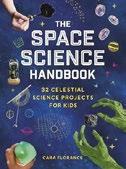
A space explorer from the 32nd century reaches out to contemporary young people, assigning them a broad range of spacethemed projects and demonstrations.
Florance prefaces each “mission” with extracts from a futuristic Captain’s Log that fills in background on exoplanets, the search for alien life, and other thematically related adventures. The missions begin with a descriptive brief, followed by supplies (most are inexpensive or commonly found household objects) and step-by-step procedures. The projects range from a terrarium and a potato battery to a 10-page construction paper art project that shows your “intergalactic address.” Each project’s closing debrief invites readers to cogitate on the results, and QR codes at the end of the book lead to further online
activities and resources. Occasional photos of a blond, light-skinned child with pointed elf ears add cute sciencefictional interest. Although the projects overall are generally feasible for less expert hands, too many of the images offer partial views of finished projects or have a discouragingly professional sheen rather than looking homemade. Still, along with being designed to offer plenty of opportunities for ad hoc experimentation, the projects touch on a great range of fields from astronomy to chemistry, biology, and even Einsteinian physics. STEM fun for young experimenters. (photo credits, glossary, bibliography) (Nonfiction. 8-11)
Frost, Maddie | Viking (40 pp.) | $18.99 October 21, 2025 | 9780593690697

Cats cause chaos at a relative’s house. Beatrix enjoys her weekly visits with her grandmother tremendously. Granny is always happy to have her, and they have tons of fun together. Worried that Granny will be lonely when she leaves, Beatrix decides to give her a pet cat to remind her of their connection during the week—and Granny responds in kind. Since Granny assumes from the gift that Beatrix adores cats, she fills her house up with a dozen fuzzy felines, who begin to crowd out her granddaughter and take over their time together. Beatrix goes to drastic lengths to free Granny from the crisis—but a bit of honest communication clears things up. Neither of them is truly a cat fancier, and Granny is actually allergic to felines; as in
many a loving relationship, they were just trying to make the other happy. But, as it turns out, Beatrix needn’t have worried; Granny’s senior housing is a warm, bustling community. The delightful, madcap nature of this story is captured perfectly in Frost’s loose, cartoonish illustrations. Though the book contains narrative text, brown-skinned Granny and Beatrix converse in speech bubbles as well. The cats’ shenanigans—destroying decor, flopping on Granny’s and Beatrix’s heads, and flying away tied to balloons— are rendered even sillier by their lolling tongues and comically big eyeballs. For lovers of cats, grandmas, and shenanigans alike, this is an equally rewarding read-aloud or read-alone.
A gleefully goofy family story. (Picture book. 4-8)
Funk, Josh | Illus. by Brendan Kearney Union Square Kids (40 pp.) | $18.99 September 9, 2025 | 9781454943655
Series: Lady Pancake & Sir French Toast, 7
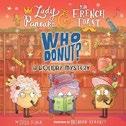
Lady Pancake and Sir French Toast have a mystery on their hands. The beloved duo are invited to a holiday eve
party at a “secret address” where renowned author Agatha Crispy will read from her latest, The Mystery Mistletoast Crook. But as they and several other food-themed guests sit down to hear Agatha speak, the lights go dark, and when they come back on, Agatha is empty-handed. Someone has stolen her book. It’s the only copy, and Agatha refuses to let anyone leave until the culprit’s been held accountable.
A humorous and tasty whodunit for budding detectives—or burgeoning chefs.
WHODONUT
Could it be Baron von Waffle? (He’d “once been a foe.”) Or crafty Biscotti? Everyone’s a suspect—even Pancake and Toast, who are known to be mystery buffs. Can our heroes figure it out and save the day? Funk serves up a heaping helping of puns and wordplay; posters in the background advertise shows such as Beauty and the Beets, while eagle-eyed readers will spot a bust of “Egger Allan Poe” on a shelf in the library. Making use of rich vocabulary, Funk’s rhyming verse lends the tale a singsongy energy perfect for read-alouds. In Kearney’s crisp illustrations, the expressive foods have oversize heads and spindly limbs. Delectable details in the art make for fantastic worldbuilding—Agatha’s face is covered with sprinkles, and she wields a candy cane.
A humorous and tasty whodunit for budding detectives—or burgeoning chefs. (Picture book. 4-8)
Graham, Bob | Candlewick (40 pp.) | $18.99 November 11, 2025 | 9781536245042
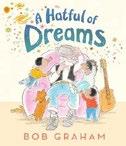
Amid a dilapidated neighborhood, a little magic remains.
The Five Mile Road was once populated with families, but “hard times came along. The people all left. The sun went with them…the moon and stars, too.” Fortunately, one house is left standing, full of life, love, and laughter. At the Andersons’ residence, young Millie, Sonny, and Jonas demand to know what, precisely, is under their grandfather’s hat. Grandad answers with a wide array of increasingly outlandish ideas, from a lost tune to “a small brown sparrow, an apple with a bite taken out, and a teacup from China with magic inside.” And when, at long last, the children convince him to take off the garment, a marvelous galaxy is released. Graham keeps his plotting and dialogue light and playful even as darkness encroaches. By the tale’s end,
something has changed, and the neighborhood becomes revitalized at last. The eclectic mix of realism and magic is what makes this tale work. Graham’s greatest talents lie in the day-to-day natural messiness of life in a family where Dad drops “pieces of tissue from a just-washed shirt like a soft fall of snow.” The author/ illustrator’s signature spare watercolors bring to life the gloom of the abandoned street, the warmth of the home, and the magic that leaks from Grandad’s hat. Mom and Grandad are pale-skinned, while Dad and the kids are brown-skinned. True magic lies at the heart of this marvelous tale. (Picture book. 4-7)
The Picasso Curse
Gutman, Dan | Holiday House (224 pp.)
$18.99 | September 2, 2025 | 9780823453856
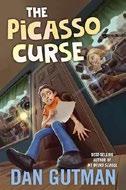
A small drawing hidden in a picture frame upends an Illinois 12-year-old’s life with the prospect of untold wealth. Edwin, who reads white, dislikes making hard decisions. That’s unfortunate, since the scrap of paper that falls out of a framed Kobe Bryant poster he buys at a flea market for $10 turns out to be an unsigned but possibly authentic Picasso drawing worth millions. What will he do with it? Alternatives proliferate, particularly after his story goes national and even trends on TikTok. Edwin and his unemployed parents are besieged by interested parties—and even targeted by a burglar. Edwin’s decision-making is further complicated once he learns of the surprising number of Picasso’s friends and family members who died prematurely due to a supposed “curse,” causing him a sleepless night of worry. An author less inclined to gleefully torture his readers might have tidily settled Edwin’s quandary by the end; instead, Gutman leaves his bewildered protagonist at the very moment of choice to ask them what they would do and offers sympathetic
observations about “decision anxiety.” For extra kicks, as part of a scenario explaining how the (fictive) drawing came to be created and then traveled to America, the author concludes with a historical note about the true story of the young Picasso’s alleged involvement with the 1911 theft of the Mona Lisa from the Louvre. Fun and challenging. (Adventure. 8-12)
Jarrow, Gail | Calkins Creek/ Astra Books for Young Readers (288 pp.) | $24.99 | September 23, 2025 9781662681035 | Series: Medical Fiascoes

The latest from Jarrow, an acclaimed author of nonfiction for young readers, unveils medical issues that have affected sitting presidents through the centuries. This work, a strong choice for young readers and adults alike, raises the question: What’s the best way to balance presidents’ right to medical privacy with their responsibility to govern the nation? Although a number of U.S. presidents have experienced health problems while in office, the nine profiled in this book chose to hide them from the general public and, sometimes, their own staff for varied reasons: James Garfield, Chester Arthur, Grover Cleveland, Woodrow Wilson, Warren Harding, Franklin Roosevelt, John Kennedy, Ronald Reagan, and Joseph Biden. Each subject’s interesting, easy-to-read story appears in a stand-alone chapter of approximately 20 pages. The entries open with a portrait and quick list of biographical details. The book is liberally illustrated with period photos and reproductions of newspaper articles and political cartoons. One section provides a detailed explanation of how the process of choosing the next in line for the presidency has changed over time. Extensive backmatter—a timeline, glossary of medical terms, additional resources,
research notes, source notes, bibliography, and index—add to the value of this account. The epilogue challenges journalists to engage in “accurate and impartial reporting” to help counter disinformation.
Reveals secrets and raises timely, ethical questions worthy of vigorous discussion and debate. (picture credits) (Nonfiction. 10-16)
Kapit, Sarah | Illus. by Genevieve Kote | Henry Holt (128 pp.) | $17.99 $7.99 paper | February 11, 2025 9781250881120 | 9781250881106 paper
Series: Rachel Friedman, 3

In her third outing, the headstrong Rachel looks forward to celebrating Purim. Her heart’s set on being the lead in the synagogue play about Queen Esther, who saves the Jews of Persia from the evil Haman’s heinous plot. So when Rachel’s Hebrew school teacher casts her BFF, Maya, as Esther instead, jealous Rachel fails to support her friend. As in the previous books, Rachel is a sympathetic protagonist who sometimes struggles with listening and doing the right thing. Her ADHD and her Jewish practice are woven into a busy life that includes gymnastics practice and play rehearsals, as well as the drama of navigating school lunches and car pooling as her relationship with Maya becomes tense. While many readers will connect with Rachel, who must balance being a good friend with getting what she wants, some might wish that Kapit had paid a little more attention to Maya’s position. Maya is a Black Jew, and, as she points out, many people dismiss her religious identity due to her race. Their rift resolves easily once Rachel apologizes, and the book never delves further into Maya’s specific challenges, though Rachel learns a valuable lesson: “Purim is about all of us, together.” The text is punctuated by
Kote’s grayscale illustrations; Rachel and her family are cued white. Big, relatable emotions take center stage in this festive friendship tale. (Fiction. 6-9)
Khan, Sabina | Scholastic (304 pp.) | $17.99 September 16, 2025 | 9781338829396
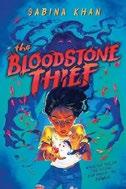
A mysterious pendant draws a girl into the mythical realm of jinn to save her father.
Laila Habib doesn’t feel at home in Houston. A middle schooler whose family moved from Mumbai a year ago, she misses her old life, friends, and the feeling of belonging. The move was supposed to be temporary—but on Laila’s birthday, Ammi announces she’s been promoted, and they’ll be staying longer. That night, a devastated Laila discovers a mysterious necklace with a shimmering black pendant—and unknowingly unleashes Bilquis, a powerful jinn, who kidnaps her father. When no one believes her, Laila sets out to rescue him—only to learn that Abbu is the Sultan of Qaf, a hidden realm of ancient magic. With help from Amira, her newly met sharp-tongued jinn cousin, and Raihan, who’s half-human and half-jinn and comes from a refugee camp in Mumbai, Laila must find the mythical Bloodstone, the only way to break Bilquis’ curse. Khan has created a vibrant world rich in South Asian culture and mythology. Laila’s voice is lively and full of spark, striking a strong balance between humor and vulnerability. While the story’s pace is brisk and
engaging, some events resolve too smoothly, and other elements (like the jinn refugee camp) are lightly developed. Still, the novel thoughtfully explores themes of family, privilege, and accountability, emphasizing that even young people have the power to demand change.
A richly imagined journey in which ancient magic meets modern identity in amusing and meaningful ways. (Fantasy. 9-12)
Khorram, Adib | Illus. by Hanna Cha Dial Books (40 pp.) | $18.99
October 28, 2025 | 9780593618530

A tribute to tea and the many ways it’s enjoyed the world over. “Tea is a journey,” Khorram notes. This one begins in the misty mountains as an East Asian–presenting adult and child harvest leaves, then sell their wares at a bustling tea house. (“Tea is a rainbow.”) A customer purchases some as a gift for a family member (“Tea is love”), and the two enjoy a quiet ritual (“Tea is a ceremony”) while reminiscing (“Tea is a memory”). The “tea is” statements continue as Khorram underscores the special place this ubiquitous beverage holds for people all over the globe. Tea is central to life, whether fueling merriment at a wedding or giving quiet comfort to new parents during a sleepless night. Whether brewed to cheer us on a cozy winter morning, made just for one, or shared with neighbors, tea is truly nourishing. Cha’s soft, gracefully
Big, relatable emotions take center stage in this festive friendship tale.
RACHEL FRIEDMAN IS NOT THE QUEEN
flowing watercolors feature steamy swirls, connecting the various scenes and creating a feeling of warmth. Khorram ends with an author’s note further commenting on tea’s origins and global impact. Readers will eagerly pore over the illustrations, each bustling with movement and telling a story all its own. As richly fortifying as the beverage it spotlights. (Picture book. 4-8)
Knapman, Timothy |
Illus. by Sarah Warburton
Sourcebooks Jabberwocky (32 pp.) | $14.99
November 4, 2025 | 9781728290980
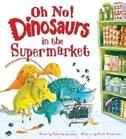
The title says it all.
An unnamed, pale-skinned young boy clad in a scaly-looking sweater accompanies his mother on a trip to the supermarket. As Mom pushes the shopping cart, the boy detects a bunch of dinosaurs all throughout the store. Stegosaurs, apatosaurs, iguanodons, triceratops, and more alternatively consume, knock over, or toss goods all over the place. Every adult remains oblivious as the dinosaurs conceal themselves in the displays right under their noses. But the grown-ups can see the giant messes created by the chaotic reptiles. The boy tries to reveal the secret, pointing at gloopy, three-toed footprints, but the adults dismiss his claim as ridiculous. Fearful that he’ll be blamed for the messes, the boy convinces the dinosaurs to play a clean-up game. Just as the youngster is getting credit for tidying the supermarket, the dinosaurs have one final trick to play. This bit-ofsilliness story is straightforward in concept and execution. Young readers can take pleasure from being in on the joke while deriving an extra layer of amusement from searching for the dinos as they hide throughout the aisles. Warburton’s images, a combination of pencil drawings and mixed-media textures, are incredibly dynamic and expressive, enhanced by
interesting perspective angles and awash in varied, gradiated colors. Informative endpapers provide pronunciation guides for the various dino species.
Good for a laugh. (Picture book. 3-6)
Koo, Camellia | Illus. by Phoebe Xiao Annick Press (32 pp.) | $19.99 September 23, 2025 | 9781834020228

A culinary tradition brings a retirement community together.
“Every
Saturday, me and Mom bring Yaya a small box of dan-tats to share,” the young narrator informs readers. The child’s grandfather, who lives in a nursing home, uses a wheelchair and has memory issues. Though Yaya speaks only Chinese, the two bond over their love of egg tarts. But today, Yaya promptly takes the box and disappears down the hall. Though nervous of the other residents—Chinese elders who “fart and burp and cough” and “smile without their teeth in”—the child follows. The protagonist’s energetic voice introduces a colorful crew of personalities, revealed to be far more welcoming than they first appeared, as Yaya stops to give dan-tats to Mrs. Tam, who is “always knitting,” sports-loving Mr. Lee, and grumpy Mr. Kwan, who drops crumbs while reading the newspaper with Yaya. The comedic interactions warm the child’s heart— but did Yaya forget that dan-tats are their special tradition? No! After sharing the last few egg tarts with the other residents in the community room, they head to Yaya’s room to split the very last one. Xiao’s cartoon artwork is deftly shaded and textured with squiggles, lines, and bold pops of colors that evoke movement and warmth. The tale concludes on an uplifting note, with the protagonist reminded of Yaya’s love—and eager to continue connecting with the other elders next Saturday. A delicious tale of family, sharing, and community. (Picture book. 5-8)
Kuchner, Marc J. | Illus. by Matt Schu
MIT Kids Press/Candlewick (48 pp.)
$17.99 | April 15, 2025 | 9781536227369
Series: Cosmic Collisions, 2
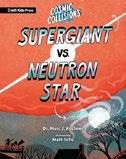
Another feverish contest between astronomical biggies. While an asteroid vs. comet matchup resulted in a major impact in the first title in this series, the contenders in this companion volume are the real heavies. A pair of red supergiants, “hundreds of times the size of our Sun” and both formidable opponents (both described with feminine pronouns), prepare to collide. Astrophysicist Kuchner describes the “battle zone” (trillions of miles and hundreds of light-years away from Earth) and the red giants’ origins, explaining nuclear fusion along the way. A discussion of helium’s role in inflating and heating these stars, turning them into “big red fluffy mammer jammers,” serves as a prematch warm-up as they accumulate massive, superheated iron balls in their centers. Suddenly… “WHOMP!” One of the stellar contenders explodes into a neutron star, or supernova. Now the contest enters its final form, and the narrator is afire: “Great galactic gobstoppers.” Kuchner devotes two pages to describing the incredible temperature of the neutron star, followed by reports of these stars’ speed, gravitational pull, mass, composition, and density. Pausing at the kinetic climax, he asks readers, “What’s your hypothesis?” before the big reveal. Schu’s bold, colorful, appropriately dramatic illustrations are strikingly beautiful, clarifying the rich explanations of astrophysics and stunning in their own right.
A spectacular celestial confrontation explodes with a lot of serious science. (more information on neutron stars and supergiants) (Informational picture book. 7-10)
Kurtz, Devin Elle | Knopf (40 pp.)
$18.99 | October 7, 2025 | 9780593710999

Ember the dragon is tasked with preparing a special dessert under a tight deadline. Ember has been enjoying his job working with light-skinned human Beatrice in her bakery. Ember’s a natural, whipping up sumptuous golden loaves. One day, Beatrice leaves Ember in charge while she makes deliveries. A demand comes in from the tiny vegetable fairy Princess Turnip: to whip up a cake for the fairy queen’s birthday. Ember’s never heard of “‘birthday cake’ bread,” but he does his best. His concoctions displease Princess Turnip, but with some encouragement from the princess—and a recipe from the library—Ember makes a lovely, golden, two-tiered cake with rosettes and candles. After delivering his creation to the delighted fairy queen, Ember returns to the bakery feeling newly inspired, filling the store with cakes and showing Beatrice and the customers a new offering. Like our protagonist’s first outing, The Bakery Dragon (2024), this one features captivating artwork. The bakery is awash in golden tones, evoking the magic of a fairy tale. With big, expressive eyes, red-winged Ember is as adorable as ever. The newly introduced princess appears to be a sentient vegetable—her dress and hair are leafy greens, while her arms and legs are formed from the root. The message to try new things, even if you fail at first, is a meaningful one, clear enough without verging on heavy-handedness. Sumptuous illustrations help this sweet lesson in perseverance go down easy. (Picture book. 4-8)

Lieberman, Matt | Harper/ HarperCollins (240 pp.) | $18.99 September 30, 2025 | 9780063273429
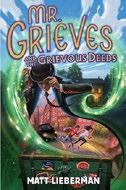
What does it mean to be a good kid?
Twelve-year-old Victoria Gray dresses neatly, achieves academic excellence, and dreams of acing the interview for admission to the Wheaton Preparatory Academy for Exceptional Individuals. Her anthropologist mother, Anna Zarathustra Gray, wrote BE GOOD (or Becoming Excellent; Guidelines for Optimizing Offspring Development), the authoritative guide to raising a wellbehaved child. But after a fateful accident, Anna takes off, leaving Victoria and little brother Ozzy with their father. Struggling under the weight of single fatherhood, Victoria’s dad sets out to hire a nanny, and soon the bowler-hatted Mister Grieves arrives. Grieves thrives on chaos and disarray, immediately throwing Victoria’s orderly existence out of orbit. Accompanied by his capuchin monkey companion, Kevin, he whisks the kids on an amazing race against time (in a memorable flying van named Nadine and accompanied by a gang of biker librarians) to thwart a group known as The Service. They’re out to acquire the Three Totems, magical items that Grieves believes will bring Anna back. Soon Grieves’ unconventional methods give Victoria pause: Is there really only one way to be good? Reading like the love child of Mary Poppins and Beetlejuice, Lieberman’s rollicking romp is a sheer delight, with its short, swiftly paced
chapters, cleverly kooky escapades, and an exploration of good vs. bad that’s sure to make readers stop and think. Main characters read white. Being bad may never again feel so good. (Fantasy. 8-12)
López, Azul | Trans. by Shook | Transit Children’s Editions (21 pp.) | $19.95 November 4, 2025 | 9798893380286
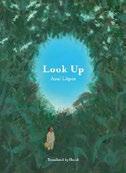
Originally published in Spain, a meditation on the rewards of pausing to notice beauty in one’s surroundings. Clad in white work clothes, a straw hat at his side, a brown-skinned man with “an enormous curiosity about the sky” sits in the grass gazing above at the pale blue expanse, overlaid with cottony clouds. On the right-hand side of this double-page spread, a parade of workers dressed like him march into the distance. Eventually, the crew begin working, ignoring their comrade. Lush, textured, pastoral scenes, rendered in oil, pastel, charcoal, and colored pencil, give way to images of tiny figures creating skeletal structures. Amid his peers’ indifference, the protagonist’s curiosity “wither[s],” and he joins the others. A dramatic composition of bodies silhouetted against a full moon gives way to a parallel scene of a huge, circular hole in the ground, which the main character stumbles upon. Something stirs within, and he emits a primal scream into the black abyss. In a
Sumptuous illustrations help this lesson in perseverance go down easy.
marvel of colorful, pointillistic patterns, thousands of birds emerge, moving in clusters across the pages, their music and “windstorm” enticing the laborers to look up. An endnote explains that this phenomenon happens daily in Mexico’s Cave of Swallows. Children will empathize with the protagonist, torn between following his personal longing and going with the group mentality. Sensitively translated from Spanish, López’s text provides an elegant accompaniment to the author/ illustrator’s arresting art. A story that feeds the spirit. (Picture book. 5-8)
Lot, Alberto | Henry Holt (40 pp.) | $15.99 October 28, 2025 | 9781250365293

A fearful soul is coaxed out from a hiding place.
“Where are you? It’s time!” A paper-white hand reaches out into the darkness as an unseen creature—depicted only as a pair of trembling eyes—insists, “I’m not coming out. I’m comfortable here!” “Here” is the full pitch black of the page. Color-coded speech bubbles—red for the book’s narrator, blue for the reluctant second character—make it clear who’s speaking. The narrator directly addresses readers, asking them to flip and shake the book in order to get the nervous Nellie to come out. Though some will enjoy the interactive element, others may find the premise— forcing a shy soul out into the open—a bit mean-spirited, especially given the narrator’s rather bombastic delivery. But the tone turns more reassuring as the uncertain creature frets: “What if everyone laughs at me?” The narrator invites readers to “cheer on our friend.” Encouraging phrases—“You got this!” “Keep going!”—illuminate the page, and hands of different colors applaud the main character’s ultimate entry into the spotlight as Lot concludes with a cleverly unexpected ending. Bold, high-contrast illustrations fill the
all-black pages, setting a mysterious tone until the grand finale. Metafictive fun with a sly twist. (Picture book. 3-5)
Loveridge, Bethany | Wombat Books (236 pp.) $12.99 paper | September 9, 2025 9781761112928 | Series: Harper Wells, 1

An Australian preteen’s new bed enables her to travel into the past. Twelve-year-old Harper Wells wants to grow up, something her dad has been reluctant to let her do ever since the disappearance of her mum six years ago. But after getting a new bed from a thrift shop, she’s transported back in time every time she falls asleep. With the help of Maximilian Durand, the boy sent to check up on her time wanderings, Harper learns about the World Office of Timeline Officials. The organization sends out Timeline Officers, all of whom are kids, to keep an eye on the past and make sure nothing changes, thus avoiding “catastrophic results further up the timeline.” The officers use Wollemi Beds (the Wollemi are trees)—and Harper’s bed actually belongs to Officer 42, who’s gone missing. WOTO will kill Harper if they find out she’s not really Officer 42. With Maximilian as her guide, she sets out to complete the case assigned to Officer 42, but as more Timeline Officers disappear, Harper must figure out for herself what the right thing to do is. This debut, a trilogy opener, dances around some big themes—class disparity, racism, and Australia’s difficult history—but this volume doesn’t explore them in depth. Still, readers looking for a fun, fast-paced time-travel series will be satisfied, and they’ll anticipate the many mysteries left for Harper to unravel. The leads are cued white. Enjoyable and adventurous. (case file, author’s note) (Science fiction. 10-14)
Lucido, Aimee | Illus. by Phillippa Corcutt & Rachael Corcutt | Versify/ HarperCollins (400 pp.) | $9.99 paper October 7, 2025 | 9780358729914

Olive and Mattie Spitz are sisters and best friends who couldn’t be more different, but they face problems big and small together. Eleven-year-old Olive loves words—she loves them so much that she constantly defines vocabulary, coins neologisms, and solves crossword puzzles. Thirteen-year-old Mattie loves art and drawing and can often be found doodling; reading is a challenge for her, and she was held back in school, so the girls are both in sixth grade despite their age difference. Olive calls them “sororal twins,” a term she invented to express their strong bond. Yet, their closeness is put to the test when they encounter difficulties with bullies, grades, friends, a crush, and their parents. Their linguist father has been spending the week at his new job in North Carolina, a few hours away from their home in Richmond, Virginia. When he begins acting suspiciously, it puts the whole family on edge. Can the girls’ special relationship withstand these tests? The sisters’ narratives unfold in comics (Mattie) and verse (Olive). The poem titles resemble dictionary entries, with parts of speech and pronunciation guides, and several crossword puzzles that readers can solve are interspersed. The graphic art is expressive and evocative, clearly showing Mattie’s feelings; her learning challenges form a thoughtfully handled throughline in the story. The Spitz family appear white, and in the black-and-white illustrations, the boy Olive likes has darker skin.
A feast for lovers of words and comics alike that tackles real-life challenges. (crossword puzzle solutions) (Illustrated fiction. 9-13)
Macfarlane, Robert | Illus. by Luke Adam Hawker | Magic Cat (32 pp.) | $19.99
October 21, 2025 | 9781917366175

Macfarlane, known for his adult works on science and nature, offers a meditation on finding light during life’s darkest moments.
Written in richly textured verse, the narrative begins in December’s bleakest hour, when “all hope is downwardsflowing,” and follows one child’s quest to gather light from various sources— “stream’s bright gleam,” “rowan’s berry,” and “snowdrift’s shine.” The language pulses with musicality and rich sound patterns, creating an incantatory quality that elevates the simple premise into something mythic. The child stumbles and falls (“PLUNGE! And plummet!”) but ultimately discovers a meadow alive with fireflies—“fallen constellations” that transform darkness into dancing light. Hawker’s extraordinary black-andwhite etchings render each scene with meticulous detail, featuring parallel lines and crosshatching with varied line weights that create dramatic effects even without color. The monochromatic palette paradoxically makes the concept of light more powerful, with generous white spaces and careful shading suggesting radiance breaking through shadow. The child, with skin the white of the page, moves through these landscapes, dwarfed by towering trees and vast skies that suggest both vulnerability and the magnitude of natural wonder. The sophisticated vocabulary and complex metaphors will challenge younger readers, but the message about resilience and the power of seeking beauty in darkness will both resonate across ages. Unlike typical picture books, this feels more like illustrated poetry, demanding slower, more contemplative reading that rewards multiple encounters. For patient readers, a glowing and magical poetic celebration of hope. (Picture book. 7-12)
For patient readers, a glowing and magical poetic celebration of hope.
Malik, Shehzil | Nancy Paulsen Books (32 pp.)
$18.99 | September 9, 2025 | 9780593324912

Three South Asian girls find empowerment through cycling. Sophie and Maya, avid cyclists, meet up with Zoey to teach her how to ride. Zoey’s excited but hesitant; her parents permit her brothers to ride but don’t allow her that freedom. As the other two lend Zoey a helping hand, Maya notes that she had to convince her parents, though Sophie’s lived in places where it was more common for girls to ride. After a wobbly start, Zoey becomes a confident rider, and the girls get together on weekends at the park to cycle. One day Sophie suggests they ride in the city. Faced with crowds, zooming traffic, and the startled looks of passersby unused to seeing girls cycling, they’re uncertain—and worse, a group of overexuberant boy riders knock Sophie over. Back at home, Zoey’s father is upset to learn the girls were riding in the streets, but when Sophie’s mother suggests that there’s safety in numbers, the trio are prompted to start a bike club to encourage other girls to join them. Malik sets her tale in an unnamed city likely inspired by her hometown of Lahore, Pakistan. Bright, bold, Technicolor art dominates the pages with pink, orange, and purple skies and flora, lending the tale an upbeat, comic book–like feel. A spirited tale about finding one’s freedom—and making room for others to revel in it, too. (author’s note) (Picture book. 4-8)
Malinenko, Ally | Harper/HarperCollins (272 pp.) | $18.99 | September 30, 2025
9780063355194
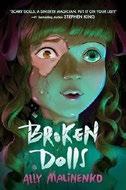
Grieving sisters are hunted by haunted dolls. Kaye, a sensitive girl from Brooklyn who’s in therapy for arithmomania (a compulsion to count) as well as other anxious symptoms such as intrusive thoughts and catastrophizing, is spending the summer in upstate New York with her family at her recently deceased grandfather’s house. Grief has left her struggling and hardly speaking. At the local Cheese Festival, Kaye and younger sister Holly encounter a strange man who calls himself the Poppet Maker. He engages them with games like cards and a cup and ring, and Holly wins an exquisite doll. The man calls it Holly-doll—and it does look just like Holly, who’s delighted by what the Poppet Maker claims is a coincidence. Kaye feels sure something is wrong. Holly-doll soon guides Holly to unearth an ever-increasing number of creepy dolls that Kaye sees moving on their own—unless it’s her imagination? Unable to turn for help to skeptical adults, like her grieving mom and uncle or her therapist, Dr. Shanti, Kaye confides in her new friend and crush, Joey, a local girl. The dolls’ increasing aggression creates wonderful (and non-gory) scares. Some of the solutions to the mysteries feel a bit spoon-fed (for example, answers revealed through a discovered diary and a villain’s flashback), and other intriguing questions are never answered. But the climax gives young readers a blood-free taste of body
horror, and a final stinger keeps the chills alive. The characters largely present white. Solid scares elevated by psychological richness. (Horror. 8-12)
McDaniel, Tiffany | Illus. by Ayesha L. Rubio Simon & Schuster (368 pp.) | $18.99
September 30, 2025 | 9781665955348 Series: The Wand Keepers, 2

In this second series entry, blue-freckled foundling Spella De-broom Cauldroneyes and friends take an exciting shopping trip to Mummy City—arriving just in time to help save the world. Gathering up both her shy best friend, Tolden Tutters (whose dragon, Softfang, serves as his hearing aid), and the many fantastical hats of her green-skinned guardian witch, Mathilda Cauldroneyes, 8-year-old Spella leaves jolly Hungry Snout Forest for the big city. There, the disappearances of a certain very powerful old cauldron and a rising number of the city’s residents signal that trouble’s beginning to bubble. (“Toothless Toz is ten feet tall and smells of old cheese… His arm fell off in 3356 BC and was never found again, so he used a feather duster in its place.”) As it happens, Stonescare, a “frightful, mean wizard,” has recruited some scary allies for a new scheme. Readers fond of stories filled with silly names, ingenious spellcasting both helpful (a sandwich-dispensing cardigan pocket) and otherwise (screaming farts), and engaging magical creatures (booger-eating purple unicorns, tree wart trolls quaintly collecting roozle wart for their morning tea) will echo Spella’s favorite expression of delight—“toadfire!”—at the many comical twists. They’ll also appreciate the summary way the fledgling wandwielder sends a pair of sneering bullies packing. The ending promises more adventures to come. Final art not seen.
A clever, magical romp, overflowing with high drama and low humor. (Fantasy. 8-10)
McKellar, Danica | Illus. by Josée Masse Random House (40 pp.) | $18.59 November 4, 2025 | 9781101933909

A homophonic snafu kicks off a count to hundred. When Mommy responds to her little one’s declaration of love with an “I love you too,” the youngster playfully replies, “I love you three.” From there, the pair’s daily activities are set to rhyming affirmations of love, each experience prompting a tally of objects on the page. A backyard sailboat float inspires a count of 10 muddy fingers, while a walk on the beach encourages readers to sum 30 sandy footprints. Before the hard-won 100 arrives, readers enumerate— among other everyday items—50 states, 70 raindrops, and 90 glimmering stars, an officious bluebird chirping instructions all the while. McKellar’s copy thrums with a jaunty rhythm, Seussian in cadence, and the cheerful beat makes for a pleasant read-aloud. Those new to counting, however, may find the bird’s directions frustrating, since the items they’re instructed to calculate are far too small and haphazardly arranged to easily track with a fingertip. Further, while progress-tracking graphics offer an additional method for visualizing quantity, their inclusion clutters spreads that already teem with items to be summed; the result is visually overwhelming. Backmatter—including a “hundreds chart,” an author’s note, and directions on “how to get the most” out of the text—provides resources for parents eager to nip math anxiety in the bud. Characters are pale-skinned. Well-intentioned if imperfect attempts at cultivating an appreciation for arithmetic. (Picture book. 4-6)
Kirkus Star
Secrets of the Purple Pearl
McKinnon, Kate | Illus. by Alfredo Cáceres Little, Brown (320 pp.) | $17.99
September 30, 2025 | 9780316555296
Series: The Millicent Quibb School of Etiquette for Young Ladies of Mad Science, 2
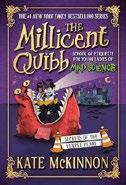
In a race against their enemies, the Porch girls must find a peculiar pearl in order to foil a fiendish plot. After defeating a monstrous Kyrgalops in The Millicent Quibb School of Etiquette for Young Ladies of Mad Science (2024), Gertrude, Eugenia, and Dee-Dee Porch find themselves (after a series of madcap events) at Lake Kagloopy’s Purple Pearl Hotel with their mentor, Millicent Quibb. Quibb informs the trio that they must find the titular pearl before the members of their evil mad-scientist rivals, the KRA, do. If they fail, the KRA (whose members include the malevolent mayor, Majestina DeWeen, and her slimy sycophantic lawyer, Ashley Cookie) plans to use the gem to bestow the Gift of Endless Vibrancy on the villainous Talon Sharktūth. Hilarity ensues as the Porches attend the annual Shrimp Ball, encounter Umbrella Turkeys, search for Cloudite (floating cloud rocks), and don invisible but smelly woolen coats. Jokes aside, the girls’ story is intriguing, offering more clues to their mysterious backgrounds and tantalizing tidbits promising later adventures. McKinnon offers bountiful backstory (alongside a running joke to encourage readers to pick up the preceding volume) and enough guffaw-inducing jokes, zany footnotes, and creative jargon to enthrall readers both new and old with her delightful sophomore effort. Mixing humor, found family, and well-wrought worldbuilding, this sequel is a certain crowd pleaser. Final art not seen; in the previous book, the grayscale illustrations showed the girls with varying skin tones. Unforgettably quirky, fast-paced fun. (appendices) (Adventure. 8-12)

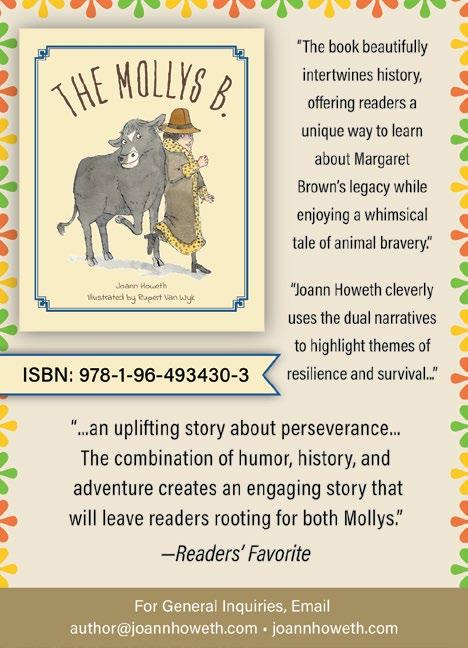








Author/illustrator of The House That Floated
AS NATURAL DISASTERS continue to roil our planet, many adults are wondering: How do we encourage young people to stay positive? Guojing’s The House That Floated offers answers. This harrowing yet hopeful and wordless tale follows a family who live in a little red house on a cliff over the sea; as the waters slowly rise, the people embark on a journey to safety, bringing their beloved cottage with them. The author/illustrator, who lives in Vancouver, answered our questions by email.
The house feels almost like a fourth protagonist.
Visually, I gave the house rich detail. Its weather vane, windows, and shape are lovingly rendered, while the people are shown in soft silhouettes or shadows. This theatrical approach was intentional, to let the house embody presence and emotion without words.


What inspired you while writing this book?
Like many people, I’ve been deeply affected by the news—forest fires, floods, and storms, devastating lives across the world. While I was searching for a meaningful way to tell this story, I came across a sign on the beach in Richmond, British Columbia: “We are preparing for the issue of rising water levels.” That moment struck me. Climate change was here, around us, and very real.
Digging deeper, I discovered the Newfoundland Resettlement Program from 1960s Canada—where over 28,000 people from more than 300 remote coastal communities were relocated, often by floating their houses across the sea, in an effort to bring them closer to essential services. The resilience and emotional weight of that history moved me deeply.
To me, the house symbolizes belonging, memory, and the continuity of life. It’s a witness to love, struggle, and resilience. The story revolves around the effort to protect it—not just by the people, but by the natural world itself. Even a dolphin joins the effort, showing that this isn’t just about saving a structure—it’s about valuing all life and the environment we share.
What’s especially challenging— and rewarding—about creating a wordless book?
Without the guidance of text, the visuals must carry everything—emotion, pacing, atmosphere. It’s a delicate balance, because with that freedom, the reader can sometimes drift or miss the heart of the story. But when it works—when the reader’s imagination flows alongside the images and their journey finds harmony with the story’s path—it becomes a truly immersive experience.
How do we encourage young readers to persevere in the face of climate change?
I think the key is helping young readers understand that nature is not something separate from us—it’s our shared home.

In my story, a dolphin guides them to their new home. That’s the kind of hope I want to nurture: the belief that when we care—for one another, for animals, for the planet—we’re never truly alone in facing life’s challenges. Nature becomes our ally. The world may be changing, but when we stay connected to it, we can find strength, beauty, and purpose. Teaching children to love and protect nature gives them a sense of belonging and responsibility. And that connection— rooted in love—is what will keep their hearts hopeful, no matter how big the storms may be. Maybe that’s why we often call it “Mother Nature” with respect and appreciation.
Interview by Mahnaz Dar.
A solid introduction to an honorable man, known for his fair-minded rulings.
WHAT
LOUIS BRANDEIS KNOWS
McNicoll, Elle | Random House (208 pp.)
$17.99 | October 14, 2025 | 9780593902462
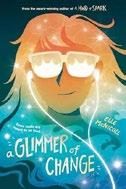
An autistic teen starts an antibullying agency. Thirteen-yearold Keedie, who lives in the small Scottish town of Juniper, attends a school with a zero-tolerance bullying policy. But as she knows from observing her neurotypical twin sister Nina’s popular friends, bullies are rarely punished for their actions. Keedie agrees to intervene with one classmate’s bully for a fee, eventually leveraging her growing reputation into a successful business. Compelling subplots include Keedie’s mentorship of her undiagnosed autistic younger sister, Addie—the protagonist of McNicoll’s A Kind of Spark (2021)— and Nina’s new boyfriend Hugh’s fascination with the nonconformist Keedie. Taking money for bullying bullies is ethically dubious, but McNicoll navigates this arc effectively with the reveal of a selfless reason for Keedie’s fundraising. Some descriptions of Keedie’s experience with autism feel a bit stilted, perhaps intended to educate neurotypical readers rather than provide a mirror for autistic ones. Overall, though, Keedie’s a well-realized character, opinionated and willing to stand up for those in need. With a handful of exceptions, adults are portrayed as nuanced, flawed individuals who try to do their best by the book’s children but often fail them. Keedie alludes to her queerness, though it isn’t fully explored. Characters read as white.
A neurodivergent protagonist whom middle-grade readers will root for. (Fiction. 10-14)
Mejia, Tehlor Kay | Delacorte (256 pp.) | $17.99 September 23, 2025 | 9780593647073

A summer vacation turns sinister as a monster grows hungry. Every summer, Evan Rio and her parents escape to the lakeside town of Sonrisa for a big reunion. But this summer is different. Evan’s parents aren’t coming; they’ve been fighting. Billie and Jackson—Evan’s long-distance best friends—have hit puberty and are changing. Evan’s changing, too: Her mom’s dieting rules are leading her to skip meals and obsess over her appearance. When a strange creature starts wreaking havoc, the trio decide to track the beast and reclaim their perfect summer. Can they stop it before someone gets hurt? Mejia’s latest powerfully links eating disorders with body horror, drawing parallels between the monster and Evan’s own appetites. Frequent references to calories, meal skipping, and buzzing hunger provide a vivid window into Evan’s internal struggles. The story’s tone avoids shame and is hopeful, even affirming, as Evan confronts her own perceived monstrosity. Evan is biracial (her mom is cued white, and her dad has deep brown skin), Billie, who’s queer, has golden-brown skin, and Jackson, who has asthma, is racially indeterminate. While Evan’s mom is awful and abusive (but not without redemption—“We can have empathy for
those who lead us astray, but we cannot allow them to continue leading,” the monster observes), Billie’s mom provides a necessary foil, showing what it might look like to support a child with anorexia. An author’s note provides essential context and encourages readers to seek help. Intriguing and not for the faint of heart. (Horror. 10-14)
Michelson, Richard | Illus. by Stacy Innerst Calkins Creek/Astra Books for Young Readers (48 pp.) | $18.99 October 7, 2025 | 9781662680632
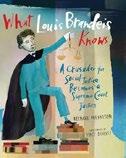
What the first
Jewish U.S. Supreme Court justice knew could fill a book. Throughout this picture-book biography, Michelson reiterates the many things that Louis Brandeis knows. At age 5, “he knows his parents came to America in 1848,” as Jewish refugees from Prague. And thanks to his family—in particular, his opinionated father—he knows that people should be treated equally regardless of their religion, ethnicity, or gender. That attitude informs his work as a lawyer as he successfully argues for better working hours and wages for factory workers, protects customers from railroad tycoons’ exorbitant fees, and holds President William Taft to his promise to safeguard America’s forests. For his efforts, he’s nominated to the Supreme Court by President Woodrow Wilson. His enemies’ accusations that he’s a “radical, a muckraker, and a traitor” jeopardize his chances, but Louis also knows that he’s “fought for ordinary citizens over the years.” Letters of support arrive from far and wide. Appointed to the court at last, “Louis knows for certain that his fight for social justice has just begun.” Michelson’s narrative is robust, though on the dry side until the backmatter, where details truly bring Brandeis’ story to life. Innerst’s droll
illustrations have a mystical, Chagalllike feel in some spreads, while others feel more down to earth.
A solid introduction to an honorable man, known for his fair-minded rulings. (more about Louis Brandeis and the Supreme Court, photographs, timeline, bibliography, picture credits) (Picture-book biography. 7-10)
Mitchell, Kara M. | Magination/American Psychological Association (32 pp.)
$18.99 | October 7, 2025 | 9781433847844

A grocery store visit serves as a lesson in compassion. When another kid steps behind the wheel of the brown-skinned protagonist’s coveted car cart, our hero is understandably grouchy. And the youngster isn’t the only one. A bird’s-eye view of a supermarket aisle depicts diverse shoppers squabbling or looking irritated. “Maybe folks get cranky when they’re in a hurry,” suggests an unseen narrator. “Or when they can’t find what they’re looking for.” Suddenly, the two children meet again in what looks like an Old West showdown. The kid with the car cart offers it up, taking the main character by surprise. “That one little bit of goodness makes you feel like a million bucks,” observes the narrator as the protagonist proceeds to pay it forward, handing a fallen apple to one shopper and offering a potted plant to another. The good deeds are infectious, and the shoppers demonstrate kindness to all those they encounter. As the tale comes to a close, the young protagonist suddenly needs a bit of kindness, too, and a gentle clerk helps the child reunite with a caregiver. Though the story occasionally waxes a bit sugary sweet and lasts a bit too long—some youngsters might be wiggling with impatience by book’s end—Mitchell’s text, infused with a sense of wonder, offers an opportunity to start a dialogue about altruism and how we treat others.
A gentle, no-frills conversation starter about making the world a kinder place. (Picture book. 3-6)
Moore, David Barclay | Illus. by Briana Mukodiri Uchendu | Candlewick (32 pp.)
$18.99 | September 30, 2025 | 9781536223262
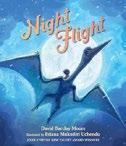
A child embarks on a nocturnal journey of reconnection. In a bedroom filled with images of dinosaurs, stars, and clouds, a smiling, bespectacled older adult tucks a youngster in. On the child’s bedside table sits a family photograph of the little one with two parents, who have apparently gone out for the night. Unable to sleep (“because of something I lost”), the child spots a pterosaur flying in the sky. Waiting “like a light left on for those you love,” the young narrator rushes to the window, then leaps atop the winged creature; they fly above a darkened city aglow with lights and over a snow-blanketed park and a river. Our protagonist spots a boat below; on the bow stand the child’s parents. The winged creature swoops down and picks them up, and they all fly so high that they wake the moon, who says hi. The pterosaur’s dips and loops cause the youngster to fall, landing, eyes wide open, back in bed, surrounded by the little one’s loving family: “I found the light I lost tonight.” Uchendu’s sweeping, blue-tinged aerial views have a hazy softness, pairing effectively with Moore’s gently contemplative narration for a portrait of a youngster creatively processing uncertainty. All main characters present Black; the parents both appear male. Tenderly reassuring. (Picture book. 4-8)
Morris, Jordan | Illus. by Charlie Mylie
Candlewick (40 pp.) | $18.99
September 2, 2025 | 9781536239669
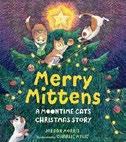
One not-so-silent night, three neighborhood cats have a mellow Christmastime adventure. It’s “moontime,” and besties Carl, Biscuit, and Peewee are “ready to make some merry mischief.” They know it’s a special night because “the neighborhood is brighter than usual” (it’s aglow with holiday lights), although two of the decorative blue lights strung on a fence are “not what they seem” (attentive readers will spy the blue eyes of a strange feline). As the trio embark on a journey, they tussle in the snow, squabble about who will lead, and so on, until they end up at “the hideout of a sneaky thief with a stash of loot”—a mouse in a Santa hat who’s purloined some trinkets from humans. Will the three friends manage to return one of the stolen objects—a star-shaped Christmas tree topper—to its rightful spot? And will the blue-eyed cat who’s been trailing the trio finally get some love? In his latest picture-book collaboration with Morris, Mylie uses colored pencils and watercolors to create luminous black-backgrounded compositions that call to mind “black magic” crayon art—an impression perfectly age-aligned with the book’s plentiful onomatopoeia and early-reader-level text, which rhymes when it feels like it. While the story doesn’t oversell the Christmas spirit, a concluding act of kitty kindness is sweet enough to melt snow. Laid-back feline Yuletide antics. (Picture book. 3-7)
A gentle conversation starter about making the world a kinder place.
CATCHING
KINDNESS
Kirkus Star
Muñoz Toro, Juliana | Illus. by Dipacho Trans. by Lawrence Schimel | Eerdmans (44 pp.) | $18.99 | September 16, 2025
9780802856432 | Series: Spectacular STEAM for Curious Readers
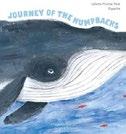
An extraordinary collaboration that follows the epic migration of humpback whales. Originally published in Colombia, this work follows the marine mammals on their 8,300-kilometer (5,150-mile) journey from Antarctica’s Gerlache Strait to the Pacific coast of Colombia. Muñoz Toro and Dipacho worked with several whale researchers to ensure scientific accuracy while maintaining the story’s narrative appeal. The text weaves factual information with storytelling elements, using analogies to make complex science accessible to young readers; whales preparing for migration are described as “packing a suitcase,” while their communication is compared to an “oceanic voice that’s intermittent, like the light from a lighthouse blinking in the dark.” Dipacho’s artwork creates moments of visual poetry, from a close-up of a whale tinged with deep blues to striking black pages depicting a whale’s death. Muñoz Toro acknowledges the limits of human knowledge with refreshing honesty, noting that “very little is known about the mating behavior of humpback whales” because “it happens very quickly,” while males may sing elaborate songs “perhaps just because they can.” Even readers initially indifferent to marine life will find themselves captivated by these creatures, whose epic journeys mirror our own need for home and connection yet whose deepest mysteries remain beautifully unsolved. This is not a book to rush through, but rather one to return to repeatedly, as each reading reveals more layers about migration patterns, whale behavior, and marine ecosystems. An unforgettable encounter that will spark a lifelong fascination with these extraordinary beings. (Informational picture book. 8-14)
Sure to inspire a grin in even the grumpiest animal lover.
I AM NOT HAPPY!
Mylie, Charlie | Abrams (48 pp.) | $18.99 October 14, 2025 | 9781419768156

In this alphabet book, a derailed train’s off-course journey creates delightful chaos. Traveling from A to Z, the vehicle goes spectacularly off the rails, jumbling the order of the ABCs in charming ways. Each letter receives focused attention as Mylie peppers his alliterative text with onomatopoeia—“DING DING! Delivery! Delicious dinner is served!”— that adds playful energy to the reading experience. His ink and watercolor illustrations have a wonderfully bustling, vintage quality that rewards careful examination. They evoke the spirit of the 1980s book series Sweet Pickles, in which a green pickle bus (rather than a train) and similarlooking friendly animal characters helped preschoolers (perhaps Mylie himself?) learn to love reading. The compositions burst with activity and detail, using varied perspectives and dynamic angles to create visual excitement. Warm, saturated colors fill the pages, resulting in an inviting atmosphere, while the strategic use of contrasting hues helps important elements pop from busy backgrounds. Sharp-eyed readers can hunt for both uppercase and lowercase letters cleverly hidden within each scene, plus objects that begin with the featured letter (a dog, a dragon, a dolphin, daffodils, and dice populate the D page). The journey to the Memory Palace provides a cohesive narrative framework that gives purpose to the alphabetical disorder, while the abundant visual details support multiple early-literacy skills, including
phonological awareness, letter recognition, and vocabulary building. A thoughtful alphabet book that succeeds in making letter learning feel like an adventure worth taking. (author’s note) (Picture book. 4-8)
O’Connor, George | First Second (96 pp.) $21.99 | $12.99 paper | October 14, 2025 9781250760807 | 9781250760814 paper
Series: Asgardians, 3

The mischiefmaking trickster gets at least a partial makeover in this set of exploits from the reigning maven of Greek, and now Norse, mythology in graphic format. Sometimes resembling in the art a sullen teenager and other times a dead ringer for DC Comics’ Joker, Loki is cast as an untrustworthy outsider admitted to the company of the Aesir by Odin’s will but never trusted or respected. Still, he generally comes out looking better than the sneering Thor and other unscrupulous, light-skinned Asgardians who repeatedly pressure him to expedite various schemes and then unjustly blame him when they go wrong. He reluctantly helps his fellow gods cheat a hired builder, is tricked into helping to leash the giant wolf Fenrir (who’s actually his own offspring), and provides epic entertainment at a wedding feast with a bawdy tug of war in which he ties one end of the rope to his unnamed and unseen but hilariously unmistakable privates. But soon enough, Loki’s instrumental role in the god Baldr’s tragic death signals a definitive turn to the dark side. Though O’Connor slyly skips mention of that tug of war in his copious endnotes, he does
expound with typical sagacity on motifs and mythological figures elsewhere in the stories, as well as noting sources, textual variants, and continuing themes that will carry over into his fourth and final planned volume in the series.
A semi-sympathetic portrait of a god too clever for his own good. (author’s note, character gallery, glossary, endnotes) (Graphic mythology. 10-13)
Percival, Tom | Bloomsbury (32 pp.)
$18.99 | October 7, 2025 | 9781547618392
Series: Big Bright Feelings
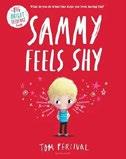
A new entry in the Big Bright Feelings series explores social anxiety. Sammy, a youngster with pale skin and a shock of blond hair, doesn’t like to be the center of attention. Unfortunately, he often feels like everyone’s looking at him—in school, when he needs to answer a question, or when he falls off his scooter. All he can think about is how many people are watching, and a bright pink blush colors his face. Soon, his whole body turns pink! Dad suggests that the two of them go to the fair. Consumed with worry, Sammy hides, but as he crouches behind a tree, he meets another anxious classmate. Together, they confront their fears, and the pinkness gradually dissipates. Toheighten the transformation, the surroundings appear gray as Sammy gets pinker, but once the pinkness fades, color returns. Percival sensitively unpacks Sammy’s emotions while warning against labeling kids as “shy.” Sammy hears the word so much that he internalizes it: “And I’m shy. Everyone ALWAYS says so.” An appended author’s note explores coping tips and further resources.
Sammy’s classmates are a diverse group; other books in the series explore many of their stories.
Deftly investigates the inner thoughts that many children feel. (Picture book. 4-7)
Perry, Caroline L. | Illus. by Sydney Hanson Simon & Schuster (40 pp.) | $19.99 October 7, 2025 | 9781665953351
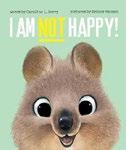
Readers beware— there’s more to this beaming Australian marsupial than meets the eye. Happiest animal on Earth?
The quokka at the center of this tale would like a word. Sure, the creature’s cherubic cheeks are round with apparently unfettered cheer, but don’t judge a joey by its cover. This jolly expression does little to reflect the roiling “ocean of inner torment” that plagues our protagonist. The quokka demonstrates as a series of unfortunate events ensue—a scoop of ice cream tumbles from its cone and into the dust; a buzzing bee flits ominously nearby. Each affront is met with the same sparkling grin. But that’s not the only misunderstanding that bedevils this irascible mammal. Not only are pesky humans constantly gawking at the “huge, smiley rat”— the quokka is a marsupial who rarely snacks on trash, thank you very much— they’re disrupting our hero’s sleep to demand selfies! Will these trials never cease? This ultra-silly jaunt around Wadjemup— a.k.a. Rottnest Island, just off the coast of Perth, Western Australia—manages to deliver a conservationist message without sacrificing an ounce of
A boy born without hands debates getting prostheses.
THE BIONIC BOY
goofiness; backmatter discusses the real-life impact of tourism on these creatures. Sure to inspire a grin in even the grumpiest animal lover, Perry’s amusing text is well suited to Hanson’s impish artwork; both are suffused with a delightfully Pixar-esque comedic sweetness.
Silly, cute, and lightly infused with a lesson on environmental respect. (additional information about quokkas) (Picture book. 4-7)
Plourde, Lynn | Nancy Paulsen Books (208 pp.) $17.99 | October 21, 2025 | 9780593111376

A boy born without hands debates getting prostheses. Adopted from “an orphanage on the other side of the world” eight years ago, 11year-old Benji Fadeyushka Ames-Cyr dreams of saving the day like the cartoon superheroes Dad and Papa introduced him to when they brought him to the United States. There’s just one problem: Benji hates being the center of attention, and his limb difference invites plenty of scrutiny. But after Benji meets Staff Sergeant Dirk Snyder, a self-assured quadruple amputee who uses a bionic prosthetic arm, he realizes that getting hands of his own could make him a superhero: the Bionic Boy. Still, he wonders if he made the right decision, especially after an upsetting incident involving the family cat. Can Benji still be a hero? While his conflicting feelings about using prostheses realistically highlight issues such as identity and self-confidence, family and friendship are the story’s core. The loving support of Benji’s dads, his best friend, Sam, and his 7-year-old sister, Becka, who has Down syndrome, radiates throughout, and even a surly new neighbor, Izzy, has a soft side. Though some readers may find Becka’s cheery, earnest antics adorable, others may feel
they toe the trope of people with Down syndrome being perpetually happy or angelic. Most characters, including Benji and his family, read white; Sam is Indian. A feel-good story of family, friends, and self-confidence. (acknowledgments/ author’s note) (Fiction. 7-9)
Poliquin, Rachel | Illus. by Clayton Hanmer Greystone Kids (80 pp.) | $21.95 October 28, 2025 | 9781778400988

An unforgettable chance to “never think about snot or pee or doughnuts the same way again.”
The creators responsible for The Museum of Odd Body Leftovers (2022) offer insights into glands, those often unacknowledged cells and organs responsible for everything from sleep to hunger and beyond. Poliquin and Hanmer present the human body as a sprawling factory populated by tiny hard-hatted boss and deputy glands, who offer a tour. Their spiel produces a lot of text in small type, but it’s filled with humor, rewarding persistent readers. Poliquin helpfully explains the two types of glands, endocrine (or messengers) and exocrine (or “goop” glands). Along the way, she and Hanmer employ enjoyably gross and downright clever visual metaphors: Our nasal glands are described as the “snot shower,” a gauge measures saliva levels (from “dry” to “saliva tsunami”), and workers on an assembly line, receiving messages from the hypothalamus, are diligently portrayed sorting and sending out the right hormones. Fresh, unpretentious, and often funny language (“strange lumps and squeezy passages”) accurately conveys gland functions. Even the most complicated processes—for instance, how the autonomic nervous system responds to panic-inducing situations—get clear and thorough
explanations. Spotting the rude graffiti left by gleefully disruptive concealed germs adds extra pizzazz, especially when pathogens attempt a takeover of the digestion department. Hints at future volumes raise hopes of more in this excellent educational series. Another creative, informative, and entertaining STEM romp from a winning team. (glossary, further reading, index) (Nonfiction. 8-12)
Poliquin, Rachel | Illus. by Julie Morstad Candlewick (48 pp.) | $18.99
October 7, 2025 | 9781536230529

A most unusual portrait of the color orange. Poliquin’s epic journey opens, naturally, with an orange. Fast facts and anecdotes follow; though presented seemingly randomly, they coalesce into a rich exploration of the color through the lenses of culture, history, and nature. The rooster from The Canterbury Tales , “dreaming of a fox whose ‘colour was betwixe yellow and reed,’” precedes a spread about how oranges originated in India and southern China, accompanied by an illustration of the fruits traveling to Europe. Next, the author tracks the evolution of the word orange from the Tamil word naru , which means “fragrant.” The tidbits in this quirky “field trip” bounce around, referencing Mark Rothko’s painting Orange and Yellow, the “International Orange” of
American astronauts’ space suits, the orange T-shirts Canadian youngsters wear annually to remember Indigenous children sent to government schools, Buddhist monks’ robes, monarch butterflies, and marigolds in an Indian market. The coda to this tale culminates in a page of color theory, with Morstad providing a painterly palette of variations on the hue. Her artwork, relying on watercolor, chalk pastel, and digital rendering, has a vintage, painterly feel that visually binds this series of postcardlike vignettes. Poliquin’s charmingly conversational prose is rife with asides that betray the author’s genuine enthusiasm for her subject (“This mineral is called crocoite. Isn’t it magnificently orange?”); readers will eagerly heed her advice to “find orange in your world.”
Witty, smart, and sophisticated. (Informational picture book. 4-8)
Potter, Giselle | Enchanted Lion Books (52 pp.) $19.99 | August 12, 2025 | 9781592704316
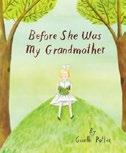
Generational lore takes a front seat in this tale of a grandmother’s life and keepsakes. A grandchild with long blond hair enjoys spending time with Grandmother, referred to as Alice. Best of all is when Alice brings out a box of “special things.” Each one has a story; together, they help piece together the elder’s life “before she was my grandmother.” As a child, Alice was often ill. Due to her stiff joints, she
A lovely and essential tribute to the transformation wrought by parenthood.
SHAPED BY LOVE
used a wheelchair and often played and read alone. Her parents sent her across the sea to Switzerland to a “stone hospital filled with children just like her.” After Alice recovered, she grew up, started a family, and eventually became a grandmother. With a quick look back at the box’s contents, readers can identify the key components of Alice’s young life, from an owl carved from a walnut shell (a gift from her sisters) to the paintings she created while recuperating. Potter’s flattened painterly style complements her narrative’s gently contemplative tone. Adults will easily make connections between Alice’s possessions and the life she lived— and will readily appreciate this tribute to a life well lived—though the story’s a shade subtle for younger readers. The book concludes with the suggestion that perhaps the grandchild might someday make a memory box, too; teachers seeking ideas for original projects will find inspiration here. Most characters present white. An account of a life creatively encapsulated in treasured items, though likely to speak more to adult readers than to kids. (Picture book. 4-7)
Powers, Nikki | Illus. by Amanda Calatzis Walker US/Candlewick (40 pp.) | $18.99 December 9, 2025 | 9781536230062

A halcyon love letter from mothers for the children who transformed their bodies. This epistolary piece begins with the dream of motherhood as a snoozing woman envisions her future with ruminative anticipation. Flash forward slightly, and Calatzis’ illustrations follow a racially and culturally diverse group of pregnant people as they anticipate what’s to come. Depicted (rather refreshingly) as hard work, labor
ushers forth a new era, and these women become parents, mothers for whom love, possibility, and growth— physical and otherwise—abound. Powers’ thesis is a simple one—the child makes the mother, but it’s the latter who carries embodied proof of the life they’ll go on to share. The birthing parents cue largely female, and while a stretch-marked stomach makes a notable appearance, C-section scarring does not. Still, the identities and bodies rendered throughout prove thoughtfully, thoroughly diverse otherwise. The result not only offers context for the physical experience of motherhood— “wrinkles, sags, grays, / new markings to cherish”—but also provides a template for the kind of authentic self-love that only inclusive visibility can cultivate. Picture books about parenthood are plentiful, but few capture the corporeal experience with comparable care. Calatzis’ artwork, a stunning combination of collage and embroidery, underscores the act of making as being intentional and effortful, an aesthetic message deeply compatible with Powers’ thoughtful, empowering text. As captivating as it is important, a lovely and essential tribute to the transformation wrought by parenthood. (Picture book. 4-8)
Priebst, Thekla | Wide Eyed Editions (80 pp.) $24.99 | September 16, 2025 | 9780711293489

A blow-byblow account of Ferdinand Magellan’s three-year, globe-spanning journey.
In a vivid infographic, Priebst first fills two pages with 240 tiny, individually drawn figures representing the crews of the five ships that set out for the far-away “Spice Islands” (known today as Indonesia’s Maluku Islands)
in 1519 under Ferdinand Magellan— and then later erases all but the 18 ragged survivors who returned aboard the one battered vessel that completed the voyage. But in ready acknowledgment that only hints at the expedition’s full human cost, the author systematically identifies and profiles the Indigenous peoples whom the sailors encountered as they made their way down the coast of South America and across the Pacific— many of whom were soon to be enslaved, displaced, or devastated by European diseases. While retracing in exact detail the long course of that unusually well-documented journey, she introduces readers to Magellan, “the man with the plan,” and also several of the sailors who went with him, particularly the enslaved translator “Enrique” (not his original name) of Malacca, who became the first known person to travel completely around the world. A broad sketch of the spice trade’s long history adds further helpful context. All the harrowing hardship, and a good dose of historical perspective to boot. (glossary) (Nonfiction. 8-10)
Ptashnik, Olga | Eerdmans (36 pp.) | $18.99 September 2, 2025 | 9780802856456
Series: Spectacular STEAM for Curious Readers

An uncertain chick receives some flight guidance from someone in the know. Ptashnik uses a question-andanswer structure to tell the story of an anxious baby chickadee who wonders, “What if I never learn how to fly?” An adult chickadee affirms: “You will learn when the time comes!” From there, the conversation turns to how other birds fly, with the baby assessing its own abilities. After discovering that hummingbirds flap their wings fast, the little one suspects that method might be too tiring. “Are there ways to
fly without flapping my wings so much?” it asks. “Wandering albatrosses spend most of their lives soaring above the seas,” answers the adult. Baby worries about being able to catch the wind the way albatrosses do. From there, the two discuss birds who don’t fly at all, like penguins and ostriches; those that fly as a group, like starlings; and loners, like owls. Centered on the gentle rapport between baby and adult, Ptashnik’s sweet narrative is filled with facts, but her true gifts are as an illustrator rather than a storyteller. Her digitally created spreads depicting the variety of feathers used for flying, dreamy views of penguins knifing through the water, pelicans swooping into the water as people fish by the docks, and condors taking flight are knockouts full of watery-windy movement and reflective light and shadow. A fact-filled tale filled with lush images that truly soar. (further information about the birds mentioned) (Informational picture book. 4-9)
Pyle, Nathan W. | Random House (40 pp.)
$18.99 | September 2, 2025 | 9798217029433
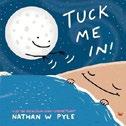
Pyle, creator of the webcomic Strange Planet, explains the tides using an inspired metaphor—the moon as a beleaguered mom attempting to pacify two fussy tots.
When a chilly beach whinges, motherly Moon draws water right up to its chin. But that gentle act pulls the ocean away from the beach on the other side of the globe! Back and forth the water goes until Moon explains that she can’t split the sea to cover both: The fish need water, too! Taking turns is the answer, but both beaches want to go first. So Moon builds a sand castle on the damp exposed shore of the first beach; the youngsters are enchanted, but Moon notes that they
can’t play in the sand if they’re covered by the sea. The little ones are now eager to take turns. Soon all the beaches on Earth claim this ingenious solution. From then on, the T.I.D.E. (“Tuck-Ins Divided Evenly”) will turn. A final spread expands on the science, discussing the roles of the sun and gravity. Pyle’s unlined cartoons are utterly inviting in their simplicity; though his characters are anthropomorphized, with just a few strokes for eyes, mouths, and arms, he readily conveys an exhausted mama’s frustration and the toddlers’ endless capacity for squabbling. Meanwhile, the astronomy comes alive beautifully, providing a clear and uniquely creative portrait of the tidal sloshing of Earth’s watery blanket.
A masterly combination of fantasy and science to tuck in to every bookcase. (Informational picture book. 4-8)
Roebers, Geert-Jan | Illus. by Wendy Panders | Trans. by Michele Hutchison Greystone Kids (152 pp.) | $21.95 October 28, 2025 | 9781778402227

Translated from Dutch, a genial overview of the fungal clan and its many roles from conscientious keeper of the “wood wide web” to deadly poison and delicious food.
Interspersed with occasional close-up photos and fanciful images of diminutive, red-capped human observers peering curiously at specimens, Panders’ galleries of labeled, exactly drawn mushrooms and schematic views of molds and yeasts in action present a diversity of shapes and forms as colorful as the multitude of fungi facts and functions that Roebers lays out in his informal but information-rich commentary. The author argues that “King Fungus” is the boss
underground (“Worms, moles, centipedes, even the roots of trees and other plants are all supporting players”); as ubiquitous organisms that help make rain, contribute to animals’ digestion, and busily chow down on organic wastes of all sorts, they also help “make nature a nice place to live.” (“Okay, they can be a nuisance at times…” No kidding.) Making good on the “and Company” part of the title, the author goes on to introduce the composite organisms slime molds and lichens. He ends his survey with a “Which fungus are you?” feature, along with suggestions for ways to study and— only under the guidance of verified experts—collect and sample these fascinating and essential members of our one, interrelated biosphere. Lively, informative, and pretty convincing. (glossary, index) (Nonfiction. 9-11)
Sala, Felicita | Abrams (48 pp.) | $18.99 October 7, 2025 | 9781419766916

A piglet who constantly loses his belongings regains them with help from an old friend. After Pablo misplaces toys, backpacks, hats, and swim trunks, often multiple times, his folks help locate them—frequently with great difficulty. His parents are shown descending under the street, scaling a tree, and entering a fox’s den to retrieve Pablo’s possessions. Busy and distracted, Pablo sometimes finds even longer-lost things while searching for recently misplaced ones. Finally, his exasperated parents declare that Pablo will just have to find his missing items himself. Pablo’s predicament worsens when he can’t locate any of his most treasured possessions for his classroom’s upcoming show-and-tell session. The narrative takes a wonderfully fantastical turn when Rocco, Pablo’s long-forgotten painted rock, offers advice from the piglet’s closet.
Rocco explains that many of Pablo’s possessions have relocated to a place where they can “get support and hang out with other lost things.” The duo head to a vacant building in town, where a vast array of objects, including Pablo’s things, socialize with music and conversation. Pablo’s items agree to give the piglet another chance, and they return home to Pablo’s frantic, then rejoicing parents. Youngsters will appreciate a final vignette that shows that adults often lose and find things, too: Mom’s missing teacup’s seen at the lost things club, chatting with Pablo’s left-behind water bottle. Sala’s amusing mixed-media illustrations deftly demonstrate the characters’ activities, emotions, and communitybuilding skills.
Sweet stuff—lost and found. (Picture book. 4-8)
Sandberg, Erin | Illus. by Tom Booth Abrams (40 pp.) | $18.99 October 21, 2025 | 9781419774713

A library card is the most powerful card of all, especially in a baby’s hands.
It’s a momentous day; a little tot, drooling in a stroller, is about to get his very first library card. But the appropriately nicknamed “Shouty Man” tries to halt the proceedings. His loud “STOP!” reverberates across the page, and he pontificates on the potential dangers: “Ideas come from books, and too many of those / can lead to big problems, as everyone knows!” He spins various scenarios: What if babies learned how to cook? (Booth’s artwork depicts cheery adults sipping from bottles as infant waiters in bow ties crawl by balancing baby back ribs and baby carrots on their heads.) What if they studied fashion? (Adults would be clamoring for the latest diapers.) The world would be in chaos! Luckily, another youngster bellows her own loud
“STOP!” as she shows Shouty Man the error of his ways. After all, where would we be if young people weren’t allowed to read? Married duo Sandberg and Booth strike a humorous tone as they convey a serious takeaway—no one, not even a Shouty Man, should limit access to knowledge. In Booth’s airy cartoon illustrations, the main characters are pale-skinned; the library’s patrons and staff are diverse. A rousing message to embolden library users everywhere.
(Picture book. 4-7)
Savage, Chloe | Candlewick (32 pp.)
$18.99 | September 30, 2025
9781536247497 | Series: Hidden Wonders
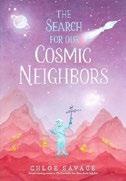
A space mission has a surprising outcome. The title page of this delightful English import portrays a familiar scene: the ground crew clustered around their screens at the launch of a new space expedition. But Savage—creator of two previous tongue-in-cheek ocean searches, beginning with The Search for the Giant Arctic Jellyfish (2023)—offers an artful twist as she sends her explorers into space. Headed by pale-skinned Commander Julia, the bored and homesick crew of Mission Star Drifter have been searching for life in the universe for 10 long years before finally landing on what seems to be yet another deserted planet. As
the crew fan out after their landing to explore, creatures living underground are fully aware of the earthlings’ presence and track their movements, making first contact with the ship’s dog, Khan. There’s such joy in this world that the crew decides to stay. As in previous titles, Savage’s graceful ink-and-watercolor illustrations, with their delicate washes of color, are filled with enchanting details, like the lightly anthropomorphized spaceship, which appears by turn nervous and, by book’s end, content. Savage’s witty text often contrasts with her images as readers realize that this “desolate wasteland” is anything but—a rather sophisticated commentary on the dangers of making assumptions. The Mission Star Drifter is helmed by a woman and staffed by a diverse crew, sending a subtle yet potent message that science and space exploration are for everyone. Clever, funny, and worth discussing. (Picture book. 4-9)
Sénéchal, Jean-François | Illus. by Simone Rea Trans. by Nick Frost & Catherine Ostiguy Milky Way Picture Books (40 pp.) | $18.99 September 16, 2025 | 9781990252372
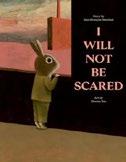
An examination of traumaborne bravery. Two rabbits— mother and child—look out onto an abstract, red-tinged landscape as they engage in weighty bedtime conversation. The pair have been displaced by war, and though they’re now safe from immediate danger, young >>>
A masterly combination of fantasy and science to tuck in to every bookcase.
The Loveboat, Taipei author will release a middle-grade novel and a short-film prequel.
Abigail Hing Wen has a new book coming in
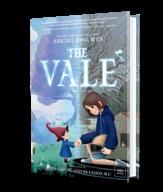
September, and Lea Salonga will star in a short-film prequel to the novel.
Wen, known for her Loveboat series of young adult novels, will make her middle-grade debut with The Vale, scheduled for publication this fall by Third State Books, her publicist announced in a news release. The book will follow Bran Joseph Lee, a 13-year-old boy who creates an AI-generated virtual-reality environment where he spends his days. After he enters it into a
competition, things begin to go wrong. The book will be illustrated by Yuna Cheong and Brando Wu.
Wen will also write and direct a short film, The Vale— Origins, a mixture of live action and animation, which will serve as a prequel to the novel. The film will star Salonga, the singer and actor who won a Tony Award for her performance in Miss Saigon, and is also known for her roles in Broadway productions of Les

For reviews of Abigail Hing Wen’s books, visit Kirkus online.
Wen’s novel Loveboat, Taipei was adapted into the 2023 film Love in Taipei, directed by Arvin Chen and starring Ross Butler, Ashley Liao, and Nico Hiraga.
Wen’s novel is slated for publication on Sept. 16; there’s no release date set for the film.

—M.S.




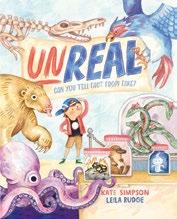







HC: 9781834020136 E: 9781834020150
An ENTHRALLING exploration of all the weird and wonderful creatures that may (or may not!) inhabit our world.







HC: 9781834020228 E: 9781834020242







PB: 9781834020099 HC: 9781834020082 E: 9781834020105





An aspiring young actor must find her place at a cutthroat arts boarding school in this GOTHIC YA debut.

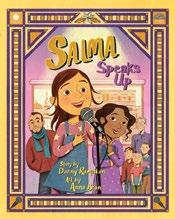
“ This is a tale of INTERGENERATIONAL FRIENDSHIP almost as sweet as the treats the little girl and her new pals share.” Bulletin of the Center for Children’s Books PB: 9781773219967




Salma embraces her voice and SPEAKS UP for herself and her friends.

Author of Scarlet Morning
PIRATES! EPIC THREATS! Two plucky orphans to save the day! ND Stevenson’s forthcoming novel, Scarlet Morning, is “engaging, exciting, and enthralling in equal measure,” Kirkus writes in a starred review. The illustrious author, cartoonist, and animation producer (Nimona, She-Ra and the Princesses of Power) answered questions about his hotly anticipated prose debut via email.
Would you please introduce our readers to Viola and Wilmur?
Viola and Wilmur are two orphans who, at the beginning of our story, don’t know anyone else except each other. Wilmur is very long and constantly surprised by it, while Viola is a tiny menace with a big imagination. They love each other, but the only way they know how to show that love is by scrapping like kittens.
What do you love about a dynamic duo?
Oh, dynamic duos are my very favorite thing. I’m especially fixated on those intense, codependent relationships that are common for kids, where you latch on hard to someone who seems to fill in all your blanks…but also triggers all your insecurities. You’re two sides of the same coin, mirror opposites inescapably tied together, and it’s when those relationships break that you find out who you really are. They’re in everything I’ve ever written, and I think I’ll be writing about them forever.
Where and when did you write Scarlet Morning ?

The very earliest draft was written on a huge, internetless Aqua Bubble computer surrounded by collages cut out of Playbills and fashion magazines, which is the ideal way to write a book, and I’ve been chasing that high ever since. Lately, though, I’ve been writing on a moody clawfoot desk while listening to sea shanties and Florence + the Machine, and that might be the next best thing.
What was most challenging about writing your prose debut? And most rewarding?
When you’re scripting for comics or animation, you have to be very terse with your descriptions, because your main goal is to lay a foundation for the artist to build on. But with prose, the medium you’re working with isn’t visual—it’s someone else’s imagination, and that was very new and scary for me. It’s like carving butter, but the butter is melting faster than you can carve it, and also the butter is invisible. Other times it’s like playing ping-pong with yourself. But I love it. Prose can do things that no other medium can, and I’m obsessed. I want to know everything. So I keep trying.
Will you be touring this fall?
A tour is definitely on the books, although the stops are still being decided. I hope it includes a visit to my hometown library in Columbia, South Carolina, where the seed of Scarlet Morning was first planted.
What fall releases are you excited about?

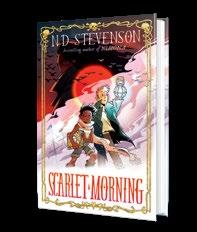
Stevenson, ND
Quill Tree Books/HarperCollins
432 pp. | $19.99 | September 23, 2025 9780063210349
I’m halfway through The Golden Boy’s Guide to Bipolar by Sonora Reyes and can’t wait to start Petra Lord’s Queen of Faces! On the comics side, I’m super excited for Ngozi Ukazu’s Flip and Trung Le Nguyen’s Angelica and the Bear Prince.
Is there anything you can tell us about Book 2?
Book 2 is called Evening Gray, and it involves a missing crown, secret passageways, garden parties, impossible clockwork contraptions, ghosts (real and metaphorical), so many sea monsters, a man named Britches, and even, at last, a rhinoceros. I’m very excited for it, and you should be, too!
Interview by Megan Labrise.
Bunny struggles to make sense of the horrors they’ve both witnessed while grappling with a conflict at school that evokes similar unease. Illustrations render gun-toting soldiers and schoolyard bullies—all members of the animal kingdom—as they enact cruelties; these successive brutalities prompt Bunny to contend with consequential questions. Is one iniquity really so different from another, the child wonders? And how much is the “right amount” of responsive courage? But Mama’s message is clear—fear isn’t proof of weakness, nor is it an experience unique to those who have seen bloodshed. Rather, fear is a tool that can be used bravely and by anyone, a force for restoring goodness when bolstered by courageous action. A sweeping treatise on atrocity and resilience, Sénéchal’s text, translated from French, is dialogic and profound; Rea’s art, with its innovative composition and gorgeous jewel-toned colorwork, is similarly intense. Backgrounds largely done in shades of crimson set a nightmarish tone, and several scenes clearly depict the pain and suffering explicitly referenced in the narrative. The result is undeniably striking and especially timely in its release, but adults should weigh reader sensitivities before selecting this story.
An extraordinary piece to be shared with utmost care. (Picture book. 9-11)
Sharff, Billy | Illus. by Hannah Abbo
Sourcebooks Jabberwocky (40 pp.)
$17.99 | October 7, 2025 | 9781728279992

Automatons working in a factory learn the importance of taking a break to have fun.
Our intrepid hero, a tiny robot with a domed head, spindly arms and legs, and a light on top, finishes work for the day and looks longingly at the stars. The other robots—the Multibots
and the Vacuumbot—are still busy clanging away at their tasks. The next morning, an unknown substance has fallen from the sky. “Robot, Robot, wake and stare. / What is falling through the air? / Beep, beep. Whirr… / Detected: SNOW. // What’s it like? / You do not know.” The tiny robot cautiously steps outside and begins to play, instinctively knowing how to throw snowballs and make a snowbot. In the distance, a family of paleskinned humans are having a good time. Can our hero get the other bots in the factory to join in on the fun? They are programmed to help humans, after all. Some may find the melding of artificial intelligence into family life a bit disconcerting, given recent headlines about the threat of AI, but watching these humans and bots build a joyous snow slide together is truly heartwarming. Images of silver-colored machinery and short staccato text make for an enchanting tale.
A satisfying wintry story about the delights of curiosity, connection, and play. (Picture book. 3-6)
Snider, Brandon T. | HarperPop/ HarperCollins (256 pp.) | $15.99 paper September 30, 2025 | 9780063455504

A 15th-anniversary tribute exploring the origins and creative evolution of the popular My Little Pony: Friendship Is Magic TV series.
A foreword tracing Equestria’s history precedes insights from the show’s production team (including its creator, Lauren Faust, who appears in a 2013 interview). The single-page biographies of the characters feature descriptions of the pony in question (“Eager to amuse her friends and make
everyone happy, Pinkie Pie will find any excuse to throw a party”), a color portrait, concept sketches, and a quote from someone involved with the show (writer Amy Keating Rogers says, “I think Fluttershy has shown a lot of growth”). The book explains the evolution of important features, such as cutie marks and the Elements of Harmony, and includes a detailed introduction to Equestria’s regions. The illustrated episode summaries offer friendship lessons: Twilight Sparkle advises readers to “always expect the best from your friends and never assume the worst.” Production team insights accompany the compilation of song lyrics (“As I was writing the lyrics I was thinking about the amazing relationship that my daughter has with her big brother,” says story editor Meghan McCarthy). The book concludes with reflections on the show’s success, emphasizing its positivity and its nonviolent approach to conflict resolution. For devotees, this guide may become a well-loved companion, bringing the wealth of online information into a tangible, page-turning experience.
A colorful guide for fans of the enduring and upbeat pony franchise. (Fiction. 8-12)
Stewart, Melissa | Illus. by Marta Álvarez Miguéns | Charlesbridge (32 pp.) | $17.99 October 28, 2025 | 9781623544461

The life and history of the carbon atom. Stewart and Álvarez Miguéns present their subjects as affable characters traveling through space and time, exploring the universe, and entering our bodies. In conversational, child-friendly language, the author defines an atom and explains how carbon atoms landed on Earth (the
“BAM” of the title), rearranged themselves by joining with oxygen to form carbon dioxide, erupted from a volcano, and carried on to visit all of Earth. In one example, a carbon molecule travels through a tree leaf and joins up with oxygen and hydrogen molecules to form glucose. Eaten by a dinosaur, the carbon atom is later exhaled out into the atmosphere. Stewart digs up some fun places carbon atoms can be found, like a crab shell, a lump of coal, and even the maple syrup that smothers a stack of pancakes, which a brownskinned child gobbles up, thereby ingesting many carbon atoms. The youngster gets a burst of energy and later emits the “BURP” of the title. Stewart’s extensive backmatter expands upon the nuts and bolts of carbon atoms, responding to questions such as “How much of my body is made of carbon?” or “Could a carbon atom that’s in my body now have spent time in a dinosaur?”
Álvarez Miguéns’ digital illustrations depict the carbon atom with big, charming eyes and theatrically gesturing arms. She deftly spotlights the atoms as they travel and rearrange themselves.
A science tale told with pizzazz. (more about carbon, the carbon cycle, information on fossil fuels and the climate crisis, author’s and illustrator’s notes, selected sources, for further exploration)
(Informational picture book. 4-8)
Stewart-Sharpe, Leisa | Illus. by Lucy Rose Wide Eyed Editions (80 pp.) | $30 September 23, 2025 | 9780711288362
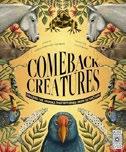
A gallery of animals that have defied the odds. Opening with a quote from Carl Sagan (“Extinction is the rule. Survival is the exception”), Stewart-Sharpe highlights 10 animals once wrongly thought to have vanished.
As icky and unsettling as it gets: a solid ending to a very fun series.
INK OF NIGHTMARES
Slipping in nods to dozens of other rarities along the way, the author surveys what scientists have dubbed the “Lazarus taxa”—from living fossils like the coelacanth fish and the venomous, ratlike Cuban solenodon to elusive flora and fauna that have staged “staggering comebacks.” Stewart-Sharpe indulges in a flair for the dramatic; she sets the scene with descriptions of remote habitats and headers like “A Secret on Sulawesi,” or “The Terror of New Caledonia.” Page turns then reveal the creature in question. The author surrounds Rose’s precisely detailed close-up views of each animal in its natural environs with select but enticing basic facts. Her accounts are rife with drama (stumbling on a population of horned marsupial frogs in Ecuador in 2018 “caused the scientists to leap about with excitement”); indeed, the thrill of such rediscoveries is certainly worth celebrating. And, commendably, the author readily acknowledges that many exciting finds came as no surprise at all to Indigenous residents. Stewart-Sharpe closes with references to Martha (the last passenger pigeon) and other species “endlings” and with the controversial prospect of “de-extinction” using preserved DNA, all of which expands the general topic while leaving young nature detectives with further food for thought. Engrossing encounters with some of nature’s more elusive residents. (glossary) (Nonfiction. 9-11)

For
Szpirglas, Jeff | Illus. by Andrew P. Barr
Orca (192 pp.) | $14.95 paper
September 16, 2025 | 9781459840591
Series: Book of Screams, 3

A horror author’s evil ink must be stopped, once and for all. The final chapter in Szpirglas’ freaky middle-grade series keeps the chills coming as Tanya and her friend Niah face down the nightmare-collecting ink unleashed on the world’s children by villainous writer Joel Southland. Seeing Southland’s uber-popular book everywhere—and putting innocent readers at risk—worries Tanya, who’s certain the author and the ink have something more planned. In an attempt to stop the coming terror, the girls devise a scheme to lure Southland to a local cafe, but they end up discovering the horrifying truth—the ink is out of control. Now Tanya will have to put herself in grave danger if she’s going to save Niah and the rest of the world. Interspersed throughout are stomach-turning and disturbing stories elevated by Barr’s equally dark drawings; this volume delivers such scares as an angry clump of hair rising from the drains, a math book that forces its owner to smile, a spoiled boy with a sinister pet fish, and more. In the illustrations, Tanya appears white and Niah presents Black; other characters are diverse. As icky and unsettling as it gets: a solid ending to a very fun series.
(Horror. 9-12)
Theule, Larissa | Illus. by Julie Benbassat Candlewick (80 pp.) | $17.99
October 14, 2025 | 9781536232813
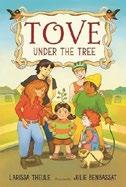
A tree grows in an unlikely location. Arborists come to Tove’s house to remove an ailing ficus, which is felled before the child returns from school. Seeing her disappointment, the head arborist encourages her to weigh in on what kind of tree the city will plant in its place. But Tove only wants this particular tree, and she removes a leafy branch as a memento. She places the twig atop her head and comically pours water over it, and the branch takes root in her hair. She nurtures the new tree by walking in the sun, bathing in moonglow, and letting her sapling commune with a robin singing on a wire. As the tree grows, neighbors notice, and community excitement builds for Tove’s curious quest. But logistical challenges creep in: It’s hard to lie down to sleep, and the tree’s massive presence makes scoring soccer goals tough (her understanding coach makes her goalie). Thankfully, with magical thinking and a lot of community support, a solution is reached that keeps both girl and ficus safe and thriving. Theule’s simple prose is delightfully deliberate, making a rather surreal concept seem nearly normal. Benbassat’s accompanying illustrations are cozy in tone; scenes that might otherwise seem scary or strange— Tove’s face being engulfed by roots, the tree dwarfing her as it increases in size—feel downright homey. Tove is
light-skinned and dark-haired, while her neighbors are diverse.
A delightfully quirky tale about standing up for urban nature.
(Light fantasy. 6-10)
Trasler, Janee | Holiday House (40 pp.)
$14.99 | October 28, 2025 | 9780823459803
Series: I Like To Read Comics

Adventures abound in this first of a beginner book series.
Aimed at the earliest of readers, these endearing comics center on Bitty, a gray rabbit clad in a red-and-white-striped shirt, and Bub, a squirrel with a penchant for purple. Five stories of varying lengths pack in drama, pathos, and humor using minimal words and sentences. The tales involve a race with a surprise ending, a discovery of cookies in the woods, a pet rock (or is it a turtle?), and more. The vocabulary never gets any more complicated than cherry (as when Bub worries that Bitty has taken all the cherry chip cookies, only to find that Bitty has saved one), and Trasler is careful to keep sentences short and to the point. Even the simplest of sequences will maintain young readers’ visual interest with subtle details, like changes to the colored backgrounds during more leisurely paced sequences. The storytelling itself never gets too complex, either, as when Bitty and Bub argue that something in the sky is either a bird or plane (a question answered when Bub is eventually splattered with bird poop). Characters
are drawn as simply as they speak, remaining colorful and emotional from beginning to end. Reading comprehension gets a leg up with this charming new series. (Early reader. 5-7)
Wang, Andrea | Illus. by Youa Vang Levine Querido (64 pp.) | $19.99
September 9, 2025 | 9781646145577

What makes someone worthy?
Newbery Honor–winning author Wang answers that question with her biography of Joseph Pierce, a Chinese man who was forced to prove his worth over and over. Born in southern China in 1840 (his real name and exact place of birth have since been lost to history), he was sold into slavery at age 10 to an American ship captain named Amos Peck and loaded onto a vessel, along with 200 other prisoners, bound for the sugar plantations of Cuba. But after “Joe,” as he was named, proved himself useful as a cabin boy, Captain Peck brought him home to Connecticut; there, he lived with the Peck family, who renamed him Joseph Pierce. Facing racism over the years, he enlisted in the Union Army (as the only Chinese soldier in his regiment), rose to the rank of corporal, became an American citizen, married a white woman, and had three children. To remain safe as white Americans mounted attacks on Chinese residents after the passage of the Chinese Exclusion Act in 1882, he pretended to be Japanese. The accumulation of these demeaning injustices—even after all he had accomplished—will push readers to ask a new question: Was America worthy of Joseph? Vang’s handsomely rendered acrylic paintings offer solemnly realistic depictions of Joseph’s life, while Wang’s text combines artfully crafted prose and
historical quotes to juxtapose the dignity of the individual against the racism of his era.
A thought-provoking account of courage and integrity in the face of discrimination. (timeline, author’s note, bibliography, citations) (Picture-book biography. 6-12)
Whittingham, Wendy J. | Illus. by Brianna McCarthy | Groundwood (32 pp.) | $19.99
September 2, 2025 | 9781773068657
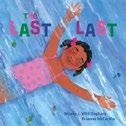
Leaving behind a beloved Caribbean island home, a child confronts fears of change and the unknown. With plaited ponytails hanging playfully from pink hair ties, the brown-skinned protagonist looks on unhappily as Mum and Grannie pack up, surrounded by smiling friends and family. “But I don’t know what to take!” says the young narrator. The child decides to go for one final walk, meandering barefoot with a heavy heart past chickens and loose dogs, beneath birds, and toward the beach to enjoy a few final “lasts”—the “last chew of sugarcane, last smell of sweet roast corn.” By the sea, the youngster is enchanted by a “swirly shell”: “Now I know what to pack.” McCarthy’s richly hued gouache and acrylic illustrations exude warmth: The inviting blue of the water nearly matches that of the vast sky, while fuchsia, green, and orange florals pop off the page. She continues to employ bright, dynamic colors as the family travels by plane to an unnamed city, a yellow taxi contrasting with the rest of the traffic. The family’s new home is “enormous,” but the protagonist, hair now in loose coils and tied up in a blue bow, maintains a connection to natural spaces, even befriending a blue jay. Whittingham’s delicately charming tale comes to a gently hopeful conclusion; the depiction of a youngster independently making
sense of the turmoil of relocating will speak to children confronting similar changes, big and small. Affecting and optimistic. (Picture book. 4-8)
Willems, Mo | Union Square Kids (24 pp.)
$9.99 | September 2, 2025 | 9781454964407

There’s no possible way the Pigeon is going to count to 10!
Well…maybe. Sometimes a bird just doesn’t feel like counting to 10, OK? Featuring the Pigeon in his customary capricious state, this board book directly addresses audiences just like previous installments, but this time our hero is refusing instead of requesting. He’s got plenty of good reasons not to count, including number five (“’cuz!”) and number six (“Double ’cuz!!!”). But the Pigeon conveys real, relatable emotion when he admits that he’s scared of failing: “SOMETIMES I FORGET WHAT NUMBER COMES AFTER NINE!!!” All readers will snicker at the over-the-top antics, but preschoolers in the know will especially revel in the joke—the Pigeon is so busy naming the reasons why he doesn’t want to count to 10 that he winds up counting to 10 despite himself. Not to worry; the stubborn bird always gets the last word: He’s counting to 11! For the most part, there’s nothing to actually count, making the book as much about emotions as math. Illustrated in Willems’ signature minimalistic style, even small details like a rounded eye or shed feather are as emotive as ever, and pages pop with frenetic, barely contained chaos. Rich, jewel-toned backgrounds highlight the Pigeon’s melodramatic expressions, and extravagantly multilayered debossing adds a perfect amount of tactile interest for little fingers.
Everyone’s favorite recalcitrant pigeon is back and funnier than ever! You can count on it. (Board book. 2-7)
Williams, Nyasha & Sidney Rose McCall Illus. by Sawyer Cloud | Running Press Kids (32 pp.) | $18.99 | September 30, 2025 9780762487356

A colorful exploration of the “many roots and routes to Kwanzaa.”
An opening spread of 10 cozy vignettes conveys the diversity of the people who observe Kwanzaa. As a bevy of brown-skinned families with varying complexions and hairstyles prepare for the holiday, Williams and McCall introduce readers to the Nguzo Saba, the seven principles of Kwanzaa (unity, self-determination, collective work and responsibility, cooperative economics, purpose, creativity, and faith), each of which is honored on one of the seven days of the celebration. Information-rich verse, marked by inspired turns of phrase, covers the history of the holiday, which was created in Los Angeles but has since been “sung out across the Black Earth.” Cloud’s carefully composed full-color illustrations feature accents of traditional African fabrics, as well as depictions of “handmade and homespun” gifting, joyous singing, and feasting. This ageappropriate primer offers a vibrant perspective on values many all over the world have long held while offering newcomers a refreshingly inviting seat at that kinara-lit table. It all wraps up with a glossary that defines key terms. Sheds light on a celebration that holds great meaning to a diverse diaspora. (Picture book. 4-8)

that will have readers eager to learn more about the topic.
Kirkus Star
Wolf, Allan | Illus. by Jose Pimienta Candlewick (176 pp.) | $19.99 October 7, 2025 | 9781536217438
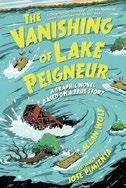
A true account of an astounding disaster, chronicled as a graphic narrative that reads like an environmental thriller. On November 20, 1980, a routine oil-drilling operation in Louisiana’s Lake Peigneur accidentally went catastrophically wrong, creating a breach that allowed lake water to rush into underground mine chambers, draining the entire lake in mere hours. Wolf narrates this incredible story through the voice of the lake itself, weaving together multiple perspectives—from miners trapped 1,300 feet underground to fishermen stranded on the suddenly exposed lakebed. Detailed diagrams, maps, and cross-sectional illustrations help readers unfamiliar with oil rig operations and underground mining truly understand the complex events unfolding. As the stakes escalate— first a stuck drill bit, then a tilting oil rig, then water rushing into the mines—the mounting tension becomes genuinely gripping. Pimienta’s artwork brilliantly supports the storytelling through strategic panel design that mirrors the characters’ emotional states. Underground scenes confine figures within increasingly numerous small panels, visually
conveying the miners’ desperation, while more expansive panels capture the scale of the swirling sinkhole above. His palette enhances the drama—inviting greens of the nearby Rip Van Winkle Gardens, oppressive darkness in the salt mine tunnels, and natural earth tones as the landscape literally dissolves. Wolf’s meticulous research is apparent in the technical details and authentic dialogue, while his honest acknowledgment of gaps in his investigation only adds credibility. Characters vary in skin tone. A riveting page-turner that will have readers eager to learn more about the topic. (author’s note, more information, miscellany, bibliography) (Graphic nonfiction. 10-14)
Wordsworth, Mark | Illus. by Ruby Wright Flying Eye Books (32 pp.) | $17.99 October 7, 2025 | 9781838740597

This “aw”-inspiring British import demonstrates that as a baby grows, so does the love.
Repeating the titular word, Wordsworth follows the development of a young tot, beginning as the tiny baby snuggles in a caregiver’s arms: “Today you’re a little bit bigger… There’s more of you to love!” The baby grows older and lies under a mobile, reaching for toys (“Today you’re a little bit louder…I love hearing your voice!”). Soon the child is sitting up and grabbing at a most displeased household cat: “Today you’re a little bit curiouser…So keen to make friends!” Before we know it, the youngster’s an inquisitive toddler, carefully examining a snail in the garden: “Today you’re a
little bit braver…Never stop exploring!” Breezy text homes in on important milestones—like taking those first independent steps—as well as moments that are just plain sweet and joyful, like a giggly bathtime. Wordsworth folds a little bit of extra love into his words, while Wright’s gentle pastels and patterned clothing, blankets, and dotted green landscapes add texture to this warm tale that’s ideal for new parents. The adult has tan skin a slightly darker shade than the baby’s. A snuggle-worthy read-aloud. (Picture book. 1-4)
Yan, Stan | Atheneum (264 pp.) | $24.99 September 30, 2025 | 9781665943338

A girl’s dark comic strip starts to feel more like a premonitory vision. In Chinese superstition, the number four, which sounds like the Chinese word for death, is considered unlucky. Twelve-year-old Eugenia Wang was born on April 4th, making her birthday the doubly unlucky “FOUR FOUR! ” Her mother refuses to hold Eugenia’s party on her actual birthday—and while Eugenia would rather be drawing comics and making art, Mom (“an overbearing Asian mom stereotype”) wants her to study and practice the violin. One day in PE, Eugenia’s friend Keisha, who presents Black and has two dads, accidentally gives her a concussion, after which Eugenia has a spooky dream about her house catching fire. To get the dream out of her head, she draws a comic about it. Soon, drawing pulls her into a trance. Each time, she wakes up with more of the comic completed—but no recollection of having worked on it. As more people perish in the dream fire, which seems to be connected to her upcoming 13th birthday, Eugenia grows increasingly desperate to stop it from becoming
reality. The panels, which vary in perspective, adding visual interest, support the tone of this dramatic, funny, and touching graphic novel. The fire sequences feature an ominous, predominantly red palette. Readers will relate to Eugenia’s struggles over meeting family expectations, following her passions, navigating relationships, and negotiating daily life as a tween. Slightly spooky and filled with humor and heart. (language note, alternate covers, process notes)
(Graphic fiction. 8-13)
York, Beth | Illus. by Treana Latese
Newsome | Charlesbridge Moves (96 pp.)
$16.99 | October 21, 2025 | 9781623544720
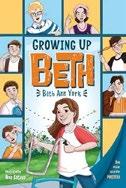
Beth holds her own in her large, tightknit family. York offers a spare and simple episodic portrait of her childhood self, a lively girl growing up with five brothers. Of her hardworking mother, Beth observes, “She is tough. She don’t play.” Beth’s stepfather, Bob, who amusingly signals his agitation by hiking his trousers up high, is also stern but handy. Though money may be hard to come by, this family is resourceful—their bikes were built by Bob, using materials from the dump. And when Mama buys Beth a puffy white jacket, she’s ecstatic to finally have an item of clothing that isn’t a hand-me-down from an older brother. But as Mama reminds her, it cost as much as a month’s groceries, and when big sibling Sam damages it while playing with his bow and arrow, the pair conspire to fix it to avoid Mama’s wrath. Seemingly ordinary adventures are imbued with wonder and enthusiasm, whether Beth’s helping Sam with his paper route or suffering a painful sting after poking a wasp’s nest. References to boom boxes and banana-seat bikes suggest a ’70s or ’80s setting, and though neither Beth’s race
nor ethnicity is explicitly mentioned (she and her family appear lightskinned in Newsome’s expressive grayscale art), hers is a diverse community, filled with no-nonsense but deeply loving parents and kids who get up to a healthy dose of mischief. A humorous, warmhearted peek at a childhood defined not by material possessions but by joyful experiences. (Chapter book. 7-11)
Yum, Hyewon | Norton Young Readers (32 pp.) $18.99 | September 9, 2025 | 9781324053699

A young Korean girl overcomes her initial resistance to a long-standing birthday custom. An unnamed child sits at the table, clearly disappointed by her mother’s offering of miyeok-guk, or seaweed soup. It’s “not the strawberry cake, not the chocolate cupcakes I want,” she pouts. But Mom explains that eating miyeok-guk is a tradition that goes back generations. “I had it every day for a month after you were born,” Mom notes. Grandmother prepared it for her as she recovered from childbirth—as did her mother, and the child’s great-great-grandma, who was a haenyeo, or freediver. Yum deftly sheds light on the legacy of freediving; women often brought their daughters along on dives and even dove while pregnant. A haenyeo who observed a whale eating seaweed after giving birth inspired the tradition of the soup. Now fully appreciating its significance, the girl savors her soup, much to the delight of her mother. Her bowl transforms into a seascape filled with women divers as she observes, “My birthday soup is miyeokguk. It smells like grandma’s town. It tastes like my birthday.” Visible pencil marks and soft splashes of color give Yum’s illustrations a tender intimacy and a coziness befitting her gently told tribute to the ties that bind. An author’s note offers more information on the women who have dived for octopuses, seaweed, shellfish, and more for hundreds of years near Korea’s Jeju Island.
A tale of familial warmth and strength, steeped in generations of tradition. (Picture book. 5-8)
Zhang, Eric | Clavis (32 pp.) | $21.95 September 23, 2025 | 9798890631107
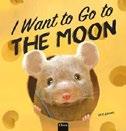
For this hungry hero, the sky is no limit. The scent of a generous wedge of Swiss cheese enraptures a small rodent narrator. The mouse asserts that “everyone should take risks” and that cheese is worth risking “everything!” for. But this chunk sits on a restaurant table, and as our hero darts forth, people panic, and a broom-wielding headwaiter ousts the protagonist. So, “another day without cheese.” Then a poster depicting a big round golden moon convinces the mouse that Earth’s satellite is really the legendary “magical cheese mountain.” The protagonist begins planning before making blueprints, gathering supplies, building a rocket, sewing a spacesuit, testing, and setting forth. Surprisingly, the mouse turns out to be an ace welder and electrician. (No tiny safety glasses, though.) In mere months, everything, including a whole command center, is complete, and our hero rockets to a fanciful playland on a golden surface, where other rodent astronauts have gathered. Is the moon truly made of cheese? With all heads encased in clear helmets, no one is nibbling. But the text leaves no doubt that “dreams are always possible. Especially far- off dreams in the sky.” Zhang’s enchantingly shadowy, atmospheric art is often lit with golden highlights. Some readers might find the message a pure fantasy endorsing limitless “wanting,” while others will applaud the mouse’s indefatigable work ethic; all will be charmed.
This aspirational astronaut will inspire readers to follow their dreams—even the most far-fetched ones. (Picture book. 5-8)



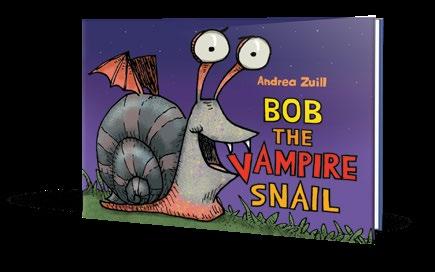

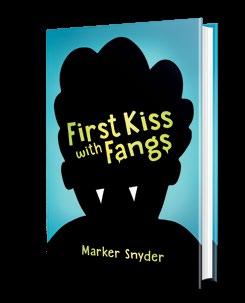

Co-author of Jackson Bright in the Spotlight
WHEN RUPAUL’S DRAG RACE and We’re Here star Eureka O’Hara teamed up with bestselling author Dan Poblocki (Tales To Keep You Up at Night ) for her middle-grade debut, sparks flew.
“Dan is a genius,” O’Hara says, via email, of her Jackson Bright in the Spotlight co-author. “I just love him so much. He was able to not only create a story with depth and arc but also with creativity and diversity. And with the knowledge I had around drag, and the personal experiences that we both have as queer people, we were able to create something so magical.”
Jackson Bright, illustrated by Ricardo Bessa, is the story of a boy who learns to magnify his shine with a little help from his best friend, his uncle, and others. Kirkus calls it a “fierce and fabulous read!”
“A tween boy embraces the philosophy of dressing for joy,” Kirkus wrote in a starred review of Jackson Bright in the Spotlight. I kind of love that phrase, “the philosophy of dressing for joy.” What do you think of that characterization?
I do love that so much. I also love that the book is about supporting his friend and their identity choices, which I think is something we often miss: How can we be a real ally? One of my favorite things is Jackson being an ally to his best friend, Eva.
Some of my favorite scenes to read
were the performances and rehearsals. What were some of your favorite scenes to write?
I love the scenes where Jackson first tries on Eva’s sister’s clothes. Playing dress-up is such a moment in young people’s lives. Oftentimes it can be by themselves, and it can be a very scary experience. In the book, however, they just get to have fun and play with that feminine part of their nature. I also love the interactions with Jackson’s father. There are often these deeper relationships with our parents that don’t always fall back on They don’t accept me, but more about what parents go through as well, and how kids can at times take on emotional responsibility or confusion.
What excited you about writing for a middle-grade audience?
I remember being in middle school, trying to find books that I felt I could relate to, and I found books about magic or superpowers because I felt like that was the only way I could really relate with the characters and their differences compared to “normal society.” This book is normalizing new experiences in expressing yourself. I also wanted to show the growth that we’ve had as a community and a society, even though old knowledge is just that: It’s old knowledge. There’s a way to be educated and have the thought process redesigned.
What inspired you during the writing of the book? What were you reading, listening to, watching?


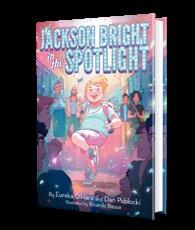
My own personal experiences inspired me the most, especially navigating life as I’m transitioning and expressing myself as a trans woman. But also, the experience I had working on We’re Here, meeting younger people who were learning to express and identify themselves in the world. And, of course, with the current climate where we’re all under scrutiny, I wanted to create a story that would be easy to follow but not heavy-hitting. I was also very inspired by some queer shows like Love, Victor and The L Word, but also the book Holes by Louis Sachar.
Interview by Megan Labrise.



Environmentalism and fast fashion feature in this story of a teen trying to make a difference with upcycled clothes.
My Green Style
By Lea Beddia
HC 9781459420243
PB 9781459420236
EPUB 9781459420250
August 2025

A volleyball fan decides to form a queer-friendly league and find a place for herself.
Setter Up By
Caelan Beard
HC 9781459419988
PB 9781459419971
EPUB 9781459419995
August 2025
Infatuation and a broken heart cause a teen to hack a social media account.
Hacking Heartbreak
By Kevin heronJones
HC 9781459419452
PB 9781459419445
EPUB 9781459419469
August 2025
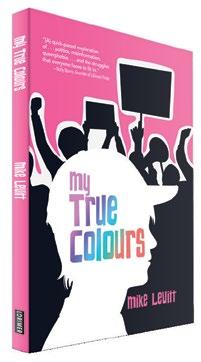
A confused teen rethinks his involvement in antigay protests.
My True Colours By
Mike Levitt
HC 9781459420106
PB 9781459420090
EPUB 9781459420113
August 2025
A romance set in the world of gaming, where identity becomes confusing.
Lonely in Happy Town
By Kristopher Mielke
HC 9781459420045
PB 9781459420038
EPUB 9781459420052
August 2025



Broken-hearted Beck volunteers at a pet shelter, where he learns to trust again.
Dogs Don’t Break Hearts
By ’Nathan Burgoine
HC 9781459420076
PB 9781459420069
EPUB 9781459420083
August 2025

Is there a more exciting time for book lovers than the busy fall publishing season? This year, you’ll find debut authors who’ll become favorites and the latest from beloved writers like E. Lockhart and Amber McBride. A dominant theme emerged: bold conviction in the face of attacks on free expression. We have books that blur boundaries (between art and science, mythology and true crime), ones that examine critically important topics (genocide, reproductive freedom), and others that hold up mirrors to relatable personal issues such as family, identity, and mental health.
Anderson, Lily | Henry Holt (320 pp.) | $19.99 September 30, 2025 | 9781250370396

Seventeen-yearold Ofelia “Faye” Abernathy has always played it safe at the Ghostlight Youth Theater Camp. Faye, whose dad is Black Puerto Rican and mom is white, has ended up typecast in roles such as Cinderella and Glinda the Good Witch. But now that she’s attending camp for the final time before aging out of the program, she wants to make a change. She stops bleaching and straightening her hair into “nice-girl dullness,” instead embracing her Afro-Latina heritage and feeling like a more authentic version of herself. Faye dreams of being cast in the role of Veronica in the camp’s musical production of Riverdale and going out with a bang. However, she finds herself at odds with bestie Kai Tufo over the role, intrigued by a charming new camper, and publicly accused of murdering another one—and she realizes that this summer at Ghostlight will be memorable but not necessarily in the way she hoped. Anderson’s refreshingly diverse cast of characters includes kids of various cultural, racial, and LGBTQ+ identities, who are socially stratified as leads vs. ensemble members. Faye wrestles with self-doubt over her ability to break free from the mold she feels trapped in, and she struggles to balance loyalty to her friends with being true to herself. In this love
letter to theater life, the joy and passion derived from the art form shine through brightly. A witty summer camp murder mystery where drama unfolds both on and off the stage. (Horror. 14-18)
Åstot, Moa Backe | Trans. by Agnes Broomé | Em Querido (192 pp.) | $19.99 October 14, 2025 | 9781646145751

Michael L. Printz Honoree Åstot (Sámi) returns with a sophomore novel that explores grief, identity, and life in the digital age. In this translated title from Sweden, Vilda is missing her best friend, Alma, who’s off on a summer holiday. Shy, artistic Vilda, 13, feels vulnerable: Her body’s changing, and her sense of self is in flux. Her mom is Sámi, and her dad is Swedish. Longing to connect with her Sámi heritage, Vilda persuades Áddjá, her beloved maternal grandfather, to teach her to speak Sámi, but then he dies unexpectedly. At his funeral, a bereft Vilda notices handsome Sámi pallbearer Samuel, who’s a few years older than she is. She’s thoroughly smitten—plus, a Sámi boyfriend could help validate her Indigenous identity, which her Swedish classmates have questioned. Feeling emboldened, she posts a photo of herself wearing her late áhkko’s Sámi wedding dress. Samuel comments, and she’s thrilled when they start texting. Vilda is also excited to garner flattering
likes and comments from people other than Alma and her paternal grandfather. But there’s discomfort too: “To think that a piece of clothing and some makeup can make that kind of difference.” Watching mercurial Vilda figure out who she wants to be and how to get there is a delight that’s bolstered by Broomé’s sparkling translation. From emotional depths to a healing, triumphant resolution, Vilda is an Everygirl for our time.
Limns the volatile peaks and valleys and emotional quicksand of adolescence with compassion and wry humor. (Fiction. 12-18)
Bassett, Louise | Walker Books Australia (352 pp.) | $19.99 | October 7, 2025 9781761601644
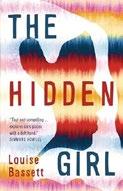
A stolen journal launches two Australian teens on a quest for truth and justice. Melati Nelson is doing her utmost to stay out of trouble in Year Eleven at Chisholm School for Girls in Melbourne, leaving behind disastrous adventures at her previous school. She’s especially keen to go on the class trip to Indonesia to explore her grandmother’s home country and learn more about her heritage (the rest of Mel’s background is white). But she loses her cool when the class bully, Libby Hartnett, physically attacks a fellow student; Mel avoids expulsion, but both girls must meet with the school counselor. In his office, Mel discovers an intriguing diary in Indonesian, written by a girl named Devi. She takes it on the class trip, not realizing the import of this decision. Once Mel and Michael, a new Australian friend she meets in Jogjakarta who’s cued Indonesian and white, begin translating the entries, they realize that Devi is being held captive as a sex worker in Melbourne. They team up, hoping to locate and free Devi, a monumental task
that proves to be more complicated— and dangerous—than they anticipate. This gripping page-turner sheds light on a modern-day horror in a non-preachy manner that will appeal to young readers. Mel is gritty, yet sensitive; fierce, yet flexible. Her personal growth as the story unfolds is admirable while remaining realistic.
A thoughtful, nuanced work that explores justice, bullying, and finding one’s place in a complicated world. (Thriller. 14-18)
Bayron, Kalynn | Bloomsbury (320 pp.)
$19.99 | September 30, 2025 | 9781547615865

A teenage mortician’s assistant discovers that the dead don’t always stay that way. Seventeen-yearold Meka is no stranger to death, having grown up working in her parents’ Ithaca, New York, funeral home. Though the morbidity of her job unsettles some of her friends, Meka is passionate about her family’s business, and she has the full support of her boyfriend, Noah. But despite her comfort with death, she’s haunted by a recurring nightmare about her mother dying—a dream she desperately hopes won’t come true. When Meka’s life is rocked by a completely unexpected tragedy, strange things begin happening: She sees shadowy figures lurking, a mysterious gift arrives on her doorstep, and fragments of a buried memory resurface. As Meka slowly pieces together the truth, what she finds forces her to question everything she knows about life and death—and her own family. Bayron crafts a page-turning, atmospheric homage to Mary Shelley’s Frankenstein, balancing unnerving horror with tender romance. Teens familiar with the original novel will enjoy the modern twist, and the layered mystery will also appeal to reluctant readers and those without prior knowledge of Shelley’s
work. The foreboding narrative starts out at a slower pace and builds to an action-packed conclusion, though readers may be left with some unanswered questions. Meka and her family are cued as Black.
Chilling yet romantic; explores the complexities of death, love, and grief. (Horror. 14-18)
Berry, Julie | Simon & Schuster (448 pp.)
$21.99 | September 16, 2025 | 9781534470811
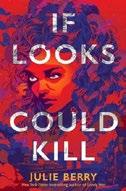
In an alternate Victorian era, unlikely allies confront monsters and murders. It’s 1888, and misogynist Jack is on the prowl in Whitechapel, London, butchering women and consuming their organs, which he hopes will “restore him to health and life.” After one murder, he’s approached by a Gorgon, a snake-haired monster from Greek mythology with a gaze that turns people to stone. But Jack isn’t affected by her petrifying powers; he runs away and continues his murder spree. Fleeing the police, Jack boards a ship heading across the Atlantic. In New York City, Pearl Davenport and Tabitha Woodward are members of the Salvation Army, spreading God’s word. They’re roommates who have a contentious relationship—rigidly pious Pearl clashes with more easygoing Tabitha. Wanting to help Cora, a distressed girl they briefly cross paths with, Pearl and Tabitha ask investigative reporter Freyda to help locate her. Pearl falls ill while Tabitha scours the city, seeking answers and receiving assistance from surprising sources, including handsome bartender Mike and Miss Stella, a secretive older woman. All the while, an evil lurking in the city is growing closer. Berry’s exploration of Jack the Ripper’s motivations is intriguing. But the evolving relationships among the largely white-presenting characters—particularly the one between Pearl and Tabitha as they confront horrors that are softened
by the compassion they encounter—offer the real appeal, accentuating the best and worst of human nature.
A powerful exploration of human connection during nightmarish times. (historical notes, bibliography) (Historical paranormal. 12-18)
Boulley, Angeline | Henry Holt (384 pp.)
$19.99 | September 2, 2025 | 9781250328533
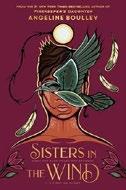
A wary teen wonders if she should run when people come looking for her. Lucy Smith was raised by her white father, who said little about her mother. Following his death and her stepmother’s abandonment, Lucy entered the foster care system at 14. Her stepmother revealed that Lucy’s birth mom was Native American, but her social worker urged her to keep that quiet. Battered by her time in the foster care system, it’s no wonder that 18-year-old Lucy is cautious when she’s approached by a man who says he’s an attorney who helps Native American foster kids connect with their families and communities. He introduces her to a friend who reveals to Lucy that she knows her Ojibwe maternal relatives—but a wary Lucy refuses her offer to learn more. Someone is stalking her, after all, and the FBI is investigating the bomb that went off in the diner where she worked—an event she’s sure targeted her. This stand-alone from bestseller Boulley, who’s an enrolled member of the Sault Ste. Marie Tribe of Chippewa Indians, includes characters her fans will recognize from previous works. The action scenes are mediated by ruminations on the failings of the foster care system and strong portrayals of Lucy’s relationship with her father and her complicated identity. Ardent book lover Lucy is a sympathetic narrator whose strong sense of justice is coupled with a deep acceptance of others.
A powerful story of family, belonging, and identity interlaced with thriller elements. (content warning, author’s note) (Thriller. 14-18)
Cerilli, Matteo L. | Tundra Books (400 pp.) $19.99 | September 2, 2025 | 9781774882337
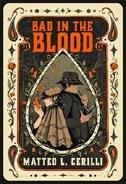
A pair of estranged stepsiblings become unwillingly entangled in a mystery that could destroy their family’s reputation and future.
Three hundred people died in the Summer Fayre tragedy, when Hàzell Stregoni succumbed to the overwhelming madness of Faerie Disorder. The victims included Hàzell’s mortal husband, Senan Maxim. Hàzell and Senan left behind two children, both just 11 cycles old, who miraculously survived the blast. One septennial later, dark-haired Hawthorne Stregoni, who has “tanned skin,” and brown-skinned, green-eyed Gristle Senan Maxim Junior can’t escape their late parents’ shadows. Except for when she’s sneaking out with her girlfriend, Hawthorne devotes herself to suppressing her fey powers so she can have a normal life. Gristle stands beside his aunt by supporting her political campaign and taking over Maxim & Maxim Private Detectives. When Hawthorne loses control at a fey-owned nightclub, the owner threatens to expose the incident unless Gristle agrees to help them uncover the truth about some suspicious activity. Gristle and Hawthorne have no choice but to investigate. This noir-inspired mystery unfolds in vivid and atmospheric prose from the perspectives of the two complex and dynamic leads. News articles, diary entries, and other evidence interspersed between chapters adds another lens for understanding the setting, history, and intricately intertwined political conflict. Cerilli’s
use of Faerie Disorder as an extended metaphor for neurodivergence is rich with nuance, and the world is infused with queerness and racial diversity. A cinematic and enthralling flare of fey magic. (map, family tree, author’s note) (Paranormal mystery. 14-18)
Eulberg, Elizabeth | Scholastic (272 pp.) | $12.99 paper | October 7, 2025 9781546176732 | Series: The Taylors Version, 1
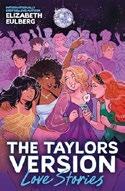
A cozy, concertthemed celebration of friendship, first crushes, and fresh starts. Four middle school friends in Indiana—Taylor “Teffy” Bennett, Taylor “Tay Tay” Johnson, Taylor “TS” Shaw, and Taylor Perez—all named after the famous singer, start high school together in this upbeat, Taylor Swift–inspired novel. Though they differ in personality, from confident gymnast Tay Tay to introverted bookworm Teffy, the Taylors have a strong bond that’s being tested by changing interests, new relationships, and big dreams. The chapters alternate among the girls’ perspectives. Teffy, a white-presenting aspiring songwriter, nurses an unspoken crush on longtime neighbor Liam Yoon. Aspiring class president Taylor, who’s cued Latine, catches the attention of suave senior Hunter Brown, whose intentions are unclear. Cheerleader Tay Tay, who reads Black, juggles friendship and a crush on her biology partner, Reece Matthews. And TS, who presents white, pushes toward her varsity soccer goal while discovering a sweet romantic connection with new teammate Gemma Walker, a Londoner. The tone is bright and energetic, filled with references to albums and fan culture, but the book’s emotional core is its thoughtful attention to shifting friendships and growing self-awareness. The breezy yet sincere prose matches the heartfelt subject matter, and the narrative balances group dynamics with
each girl’s individual arc. Readers will find themselves rooting for the Taylors as they navigate the thrills and stumbles of high school life.
A sparkling, big-hearted tribute to girlhood, ambition, and finding your voice. (Fiction. 12-16)
Gill, Nikita | Little, Brown (352 pp.) | $19.99 September 16, 2025 | 9780316596763
Series: Goddesses of the Underworld, 1

Hekate quests across the Underworld to discover her purpose and power in this trilogy opener set in the world of Greek mythology. Born to Titan parents during a war between the old and new Gods, violet-eyed Godling Hekate spends infancy with her mother, Asteria, in a hidden walled garden. As the war draws to a close, the victorious Olympians breach their sanctuary, pursuing mother and daughter across land and sea. They cross the world seeking safety but find only ash and rubble; all the Titans who opposed Zeus have been enslaved or imprisoned. Desperate, Asteria brings Hekate to the Underworld. There, she appeals to the River Goddess, Styx, and the young God-King of the Underworld, Hades, to protect Hekate. Reluctantly, they agree. As centuries pass, Hekate grows weary of her isolated existence: She’s safe, yes, but it’s clear that much is being kept from her, including the truth about her power. She’s meant to be a Goddess, but the Goddess of what? In a perilous journey across the realms of the Underworld, Hekate builds new friendships and confronts old horrors to claim the answers she seeks. Poet Gill’s recognizable voice anchors this work as much in mythology as in the perils of modern girl- and womanhood; alongside the familiar narrative beats of an adventure story, she explores with care generational trauma, sexual violence, and the cost of war. The characters are fantasy-diverse in appearance.
Fiercely feminist, this reimagining of a lesser-known goddess crackles with magic. (Verse fantasy. 14-adult)
Song
Gourlay, Candy | Carolrhoda (280 pp.)
$19.99 | October 7, 2025 | 9798765662632
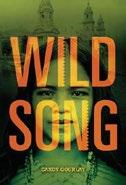
A Filipino girl travels to America to take part in the 1904 World’s Fair and finds herself confronting uncomfortable truths in this story based on real events.
In the U.S.-controlled Philippines, 16-year-old Luki finds herself pushing against the rigid gender expectations of her Bontok community; she’s a skilled hunter and has no desire to marry, although a romantic relationship has blossomed between her and childhood friend Samkad. When members of Indigenous groups, including the Bontoks, are recruited to travel to America to “live in a village built specially” for them at the St. Louis World’s Fair, she jumps at the opportunity. Luki is initially awed by the grandeur of the fair and swept up into a friendship with a charismatic white American woman. But the luster begins to fade as the Filipinos are expected to perform their cultures to suit the expectations of American audiences. As Luki learns unsettling truths, she’s forced to question her place in the fair—and what her life will look like when it ends. The narrative examines the exploitation of Indigenous peoples and the commodification of culture, expertly framed by the moving story of a young woman longing to pave her own path in life. This stand-alone novel revisits characters from Bone Talk (2019) and will be welcomed by fans of Gourlay’s work and new readers alike. A powerful coming-of-age story exploring identity and exploitation during a little-known historical moment. (note to readers, note on terminology, historical notes, discussion questions) (Historical fiction. 13-18)
A haunting, compassionate tribute to the children of war.
MY MOTHER, THE MERMAID CHASER
Hicks, Katie | Flying Eye Books (192 pp.) | $21.99 paper | October 7, 2025 | 9781838742089
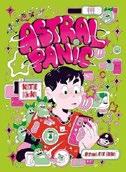
A new friend gives an anxious young man plenty of opportunities to step outside his comfort zone.
Gale is chronically embarrassed about many aspects of himself, including his copious perspiration, lack of self-confidence, and fondness for drawing wizards. To cope, he follows lifestyle advice from the Simply Pear app, though its messages don’t actually make him feel any less anxious. Neither do the multitude of Simply Pear canned drinks he consumes or the dancing, talking pears populating every square inch of his brain space. Enter adorable walking catastrophe Aiden, Gale’s new roommate, who seems impervious to shame. Aiden enlists Gale’s help with his job hunt. He also introduces Gale to the members of his band, Astral Panic; they’re preparing for their “first show with an audience.”
The invitation to draw the band a poster may pull Gale further out of his shell—if he can survive the “cycle of pain” brought about by his spiral of self-consciousness and panic attacks. The book’s psychedelic, mostly pink-and-green color scheme suits the retro art style and expressive, cartoonish characters (who seem to be college students). Kaleidoscopic details add plenty of interest, helping readers visualize Gale’s anxious, nonstop inner monologue. Readers, many of whom will identify with Gale’s struggles, will easily forgive the fact that the story is more about feelings and aesthetics than plot. Gale has light skin and jet-black hair, Aiden presents white, and two band members are brown-skinned.
A wryly humorous and brightly creative representation of intense anxiety. (Graphic fiction. 14-18)
Hoang, Jamie Jo | Crown (384 pp.) | $19.99 September 23, 2025 | 9780593643006

Sixteen-year-old Paul spends a summer in Vietnam tracing the life of his long-absent mother, who was a wartime refugee. Back home in San Jose from Vietnam, Paul is ready to tell his skeptical sister, Jane, what he learned about their estranged mother, Ngọc Lan. Thirteen years ago, Ngọc Lan walked out on them and their father, causing trauma that Jane continues to process in therapy. It’s 2008, nine years after the events of My Father, the Panda Killer (2023), when Jane was on the cusp of going to college, leaving Paul to contend with their abusive father alone. At that time, Jane recounted to Paul their father Phúc’s raw, hyperreal tale of escape from Vietnam—a harrowing journey through pirateinfested, shark-filled waters. In this poignant companion novel that Hoang calls “history adjacent,” Paul and Ngọc Lan’s stories alternate, their family lore satisfyingly converging. The novel follows Paul as he explores Vietnam’s vibrant streets, searching for clues to his mother’s past. His journey sharply contrasts with Ngọc Lan’s emotional departure from her homeland in 1975. The dual narratives are united through a guiding spirit that swims by “like a mermaid painted with undefined brushstrokes.” Vietnamese superstitions and the complexities of knowing who’s related to
whom—and what to call them—form a humorous and informative backdrop, adding bright cultural insights that lighten the somber impact of war’s profound grief. A haunting, compassionate tribute to the children of war. (content note, character guide, honorifics, resources, author’s note) (Fiction. 13-18)
Holland, Sara | Wednesday Books (336 pp.) $20 | November 11, 2025 | 9781250854490

A cursed young woman must decide who she can trust and how to save herself and her siblings. Annie Fairfax watched her parents die when the fae known as the finfolk sank their whaling ship in revenge for their hunting of the magical Livyatan whales. Annie and two other children—Silas and August—survived but returned cursed, like many who encounter the finfolk. Now 18, Annie leads the Fairfax Whaling Company of Kirkrell while hiding the heartbreak curse that takes a toll on her body and mind. She’s engaged to August, who may covet her business more than her heart. Silas, now the feared captain of the Cursed Crew, is rumored to be part finfolk. When the trio embark on a dangerous expedition to the far north to establish a new whaling outpost, Annie begins to question August’s intentions. On the voyage, Silas is Annie’s confidant, offering the hope of meeting the finfolk and lifting her curse. Holland blends fantasy with themes of legacy, identity, and moral awakening as Annie fights for survival and reckons with everything she’s been taught. Despite a slightly bumpy ending, the writing is rich and immersive, the pacing sharp, and the characters are deeply compelling. Their flaws and deep, often unexpressed, feelings contribute to their well-rounded characterization. This duology opener explores what it means to do the right thing, even when it
means turning against your past. Most characters are cued white. An extraordinary work teeming with magic, intrigue, and strong emotion. (Fantasy. 13-18)
Isaacs, Cheryl | Heartdrum (336 pp.) | $19.99 September 16, 2025 | 9780063287440
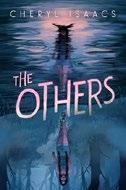
In this sequel to 2024’s The Unfinished , a new horror emerges from the black water—and it’s coming for Avery. Two weeks after defeating the black water and saving Key, Avery is leaning into getting her “Perfect Summer back on track,” attending parties and the annual FallsFest. But she can’t shake the feeling that things are askew. Key acts eerily out of character, losing himself as he gazes into mirrors and blaming his distance on exhaustion. The fountain in the town square has suddenly filled with water for the first time in decades, and everyone seems strangely drawn to it. Soon Avery begins to see disturbing reflections— and something tells her that whatever it is won’t remain trapped within mirrors for long. It’s up to her to set things right before it’s too late. Avery confronts more than just the Big Pond, and the truths she uncovers about her family’s connection to the black water are expertly delineated and truly affecting. The strength of her relationships and her newly felt connection to the stories of her Kanyen’kéha (Mohawk) heritage may become her best weapons. Already a uniquely eerie enemy, the black water’s significance deepens further as a new world of lore emerges. Isaacs (Mohawk) compellingly juxtaposes supernatural horrors with Avery’s journey to accept truer versions of herself and those close to her and keeps readers hooked with shocking twists.
A deeply rewarding sequel that’s equal parts uncanny and moving. (Kanyen’kéha
glossary, note from Cynthia Leitich Smith) (Supernatural. 13-18)
Isett, Brian | Illus. by Claudia Biçen Unruly (104 pp.) | $24.99 September 30, 2025 | 9781592704118
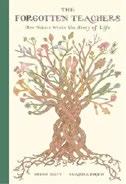
A ppealing watercolors accompany text that emphasizes the interconnectedness of life, highlighting natural influences on the development of life on Earth. Scientist and poet Isett explores forces that have “left indelible lessons in our DNA and taught each species a particular piece of the story that unites all of life.” The book is divided into chapters covering “Ocean,” “Air,” “Theia,” “Sun,” “Plants,” and “Symbionts.” Ocean was “the first mother of us all,” but life forms moved to live on land; when we breathe Air, it “connects us to an ancient cycle of growth, sustenance, and decay.” Collision with the planet Theia 4.5 billion years ago created Earth’s circadian rhythms. The author frames natural history in poetic terms— Sun conveys “one ancient, shining lesson: this is a place worthy of being seen”—and emphasizes the bonds among all living things—as in the mutually beneficial “dialogue” Plants have with animals. The chapter on Symbionts exemplifies the book’s blend of scientific concepts (like mitochondrial DNA, which carries “a story of mutual dependence”) with philosophical musings. Biçen’s watercolors in saturated pastels flow organically across the pages, supporting the central themes through radiant illustrations of the natural world, from double helixes to towering mountains. Eyes and hands appear often, symbolizing “the ubiquity of awareness and…the universe’s capacity to manifest life.” Crossing arbitrary divisions between art and science, the book closes by asking readers, “What story will you choose to tell?” Evolutionary science concepts
wrapped in philosophical and spiritual entreaties to value interconnectedness. (artist’s note, bibliography) (Illustrated nonfiction. 12-18)
Leon, Pablo | HarperAlley (240 pp.)
$18.99 paper | September 2, 2025
9780063223554

Two Maryland brothers unearth their mother’s tale of survival during the Guatemalan civil war in Leon’s harrowing graphic novel. One day at school, José learns of the genocide trial of former Guatemalan dictator Efraín Ríos Montt, igniting his curiosity about his mother Clara’s past, even though she shuts down questions about her homeland (his dad missed home and moved back). His older brother, Charlie, also discourages José’s curiosity. But news of the trial rattles José’s mom enough that she decides to finally share her story. In the early ’80s, Clara lived in her peaceful Qʼeqchiʼ Mayan village, blissfully untouched by the raging war—but everything changed with the arrival of the Guatemalan army and their brutally violent “full-blown scorched-earth operation.” Thanks to her fierce queer sister, Elena, Clara escaped, but the girls were forced to separate. Clara eventually headed to the U.S. alone. Deeply affected by their mother’s story, José and Charlie reflect on their family roots, embarking on a mission to determine their long-lost aunt’s fate. Split into four chapters that share the perspectives of the central characters, Leon’s testament to the power of historical memory movingly explores how the echoes of trauma continue to reverberate across the Guatemalan and Indigenous diasporas, often spanning generations. The unflinching, grounded artwork, which emphasizes the characters’ expressions and emotions, offers a few
moments of levity amid the mostly unseen acts of violence.
A beautiful, timely reminder that hope is never out of reach. (author’s note) (Graphic fiction. 14-18)
Lockhart, E. | Delacorte (320 pp.)
$22.99 | November 4, 2025
9780593899168 | Series: We Were Liars

At her father’s secluded Martha’s Vineyard home, an 18-year-old becomes entangled in his messy world in this stand-alone novel set in the world of We Were Liars (2014) and its prequel, Family of Liars (2022).
Smart, serious gamer Matilda’s flighty mother has left her behind in Los Angeles and followed her newest boyfriend to Mexico City. Matilda, hurt, vulnerable, and somewhat emotionally adrift, is surprised to receive an email from Kingsley Cello, the father whose name she’s never even known. He’s a reclusive, world-famous artist, and he’s inviting her to stay with him in Massachusetts. Though Kingsley is away when Matilda arrives, she’s drawn in by her queer half brother, Meer, and the other residents. Two other young men live at the sprawling estate with Meer and his mother, June, a Japanese American textile artist and herbalist: former child actor Brock and gorgeous but mean Tatum. Though Matilda is uneasy about the unconventional situation and the rambling, decrepit house and frustrated that her father asked her to come, only to disappear, the three boys’ exuberant strangeness and the bonds she forms with them keep her there. Through her nuanced characters, who are both smart and vulnerable, Lockhart
explores art, responsibility, and feminism. She also weaves an appealing romance and gothic, fairy-tale, and classical references into the worldbuilding that’s stylish and detailed but handled with a light touch. Other than June and Meer, most characters present white.
Atmospheric and emotionally rich. (map, series note, family tree, author’s note) (Fiction. 13-18)
McBride, Amber | Feiwel & Friends (224 pp.)
$19.99 | October 14, 2025 | 9781250908087

A 17-year-old guardian of the memories of recently deceased young people questions her purpose in the latest from National Book Award finalist McBride.
The Keepers stay in their Leaving Rooms, ushering Leavers through this liminal space between life and death. Gospel, a Keeper who struggles with following rules, prides herself on providing Leavers with meals made of loving memories and cares for the souls during their precious four minutes with her. Tending to children who have just died, Gospel takes each one’s “best memory,” often involving a meal, and places it in one of the mason jars that line her bookshelves, which are “made from living trees.” Some of the Leavers haunt Gospel, their presences creating lasting memories for her—5-year-old Maple and 8-year-old Suvi, in particular (readers later learn the reason behind their significance). As Gospel struggles with the weight of her role, Melodee, who’s also a Keeper, enters her Leaving Room, breaking another rule. Their connection is instantaneous; “I didn’t know Keepers / could feel love,” Gospel observes— and she wonders whether her existence
might hold more meaning. McBride is a master of verse, weaving lines with emotion and character development, articulating pain and hope with an economy of words, and documenting Black lives with tenderness. Reverberating with a haunting trauma, this powerful narrative is packed with Black joy, queer love, and feminist defiance.
Compelling and evocative: a must-read. (author’s note, playlist) (Verse fiction. 14-18)
McCall, Guadalupe García | Tu Books (352 pp.) | $23.95 | October 21, 2025 9781643796994 | Series: Seasons of Sisterhood, 1
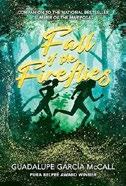
After a supernatural attack leaves their father near death, two sisters pursue the culprit in this trilogy opener set in the world of 2012’s Summer of the Mariposas
Fifteen-year-old twins Delia and Velia Gonzales-Garza used to be “so synchronized, [they] finished each other’s sentences,” but Delia has watched Velia change. Now they disagree on everything, including whether they should participate in their father’s Tejano band tour. But their differences take a backseat when a monster steals Papá’s tonalli, or “first soul,” the seat of one’s identity. As the Mexican American girls investigate with their friends Mochi Salazar and Hernan Molina, they’re drawn deeper into Aztec magic and myth, each guided by the god she mirrors: Velia by Quetzalcoatl, “the one with the voice,” and Delia by “fiery and passionate” Xolotl. Their mission to save their father leads them to the death goddess Mictecacihuatl, who presents the girls with an offer to become creature-hunting warrior women. This story inspired by Sophocles’ Antigone seamlessly blends coming-of-age themes with folklore. McCall respectfully integrates
well-researched Nahuatl vocabulary and Aztec mythology as she explores sisterhood, cultural identity, and blended family dynamics. The supporting characters enrich the story through their realistic and relatable interactions. Readers will appreciate the nuance and emotional depth of the relationships, especially the one between Delia and Velia.
A rich, mythic story about selfhood and soul-deep family ties. (glossary of Nahua words, author’s note, sources) (Fiction. 13-17)
Mendez, Jasminne | Dial Books (336 pp.)
$19.99 | September 16, 2025 | 9780593531877

Texas high schooler Yulieta Lopez learns to channel her anger into activism. Yuli, a Black, second-generation Dominican American junior, experiences racism in her school’s drama program. Her beloved Ethnic Studies teacher, Mr. Gonzalez, who’s Mexican American, faces censorship of his curriculum and classroom library. Yuli often feels that her rage is impossible to contain. Although initially unsure about speaking out—“I’m an actor…not an activist…”—she’s angered by the injustices she endures and witnesses and is further galvanized by her family’s revolutionary spirit and past. Encouraged by her brother, Yunior, who reminds her that “Art IS activism,” Yuli organizes guerilla theater resistance protests with her friends, supported by Mr. G., who becomes the faculty sponsor for their club, A.C.T. NOW, or “Activism. Collaboration. Transformation. Now!” Although they face setbacks, Yuli’s story demonstrates the power of persistence and tapping into your passion to make change. Mendez fluidly and creatively tells Yuli’s story through a variety of formats, including a play script, group text chats, and verse. A powerful love letter to finding and using your voice,
this story will resonate deeply with those who struggle to feel seen and nurtured, particularly young women of color. Fans of Elizabeth Acevedo and Amber McBride will devour and delight in Mendez’s latest, which centers on a racially diverse cast and explores timely topics like racism, book banning, and censorship in schools. A compelling drama with a firecracker protagonist that stuns with its strikingly beautiful writing. (author’s note) (Verse fiction. 13-18)
Raasch, Sara & Beth Revis | Sourcebooks Fire (368 pp.) | $19.99 | October 7, 2025 9781464236136 | Series: Spy and Guardian, 1
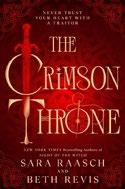
A fae guardian and an English spy must team up to protect Scotland from magical invaders. In the world of this duology opener, Scotland and the fae realm are magically linked; peace in the former ensures peace in the latter. So it’s up to Alyth Graham, daughter of the fae prince and lady-in-waiting to Queen Mary, to protect the barrier that keeps the bloodthirsty Red Caps, fae who rebelled against the Seelie Court, out of Scotland. But when Red Cap weapons turn up in the Scottish court—and in the hands of Lord Darnley, Mary’s scheming husband— Alyth knows something is very wrong. Samson Calthorpe, illegitimate son of William Cecil, Queen Elizabeth’s secretary (who in this universe assumes Sir Francis Walsingham’s role as spymaster), was cursed in childhood by fae magic that causes him to black out and commit violent acts. Samson is among the few humans who knows the fae are real. When Cecil offers him a chance to be rid of the curse in return for spying on Mary, Samson agrees. A chance meeting throws Samson and Alyth together. Their attraction is immediate, but Alyth senses he’s hiding something. As danger mounts, the two work together and begin to care for each other. Samson’s and Alyth’s alternating first-person narratives keep the
pace moving. The court intrigue, set against lush descriptions of Scotland, is well-balanced with the fantasy elements. Most characters are cued white. An atmospheric fantasy brimming with intrigue and heart. (content warnings, historical note) (Historical fantasy. 14-18)
Roach, Mary E. | Disney-Hyperion (320 pp.)
$18.99 | September 30, 2025 | 9781368114608
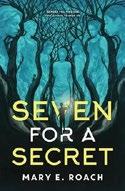
A young woman returns to the Maryland island town where she once lived in Sister’s Place, a group home from which many of her friends vanished.
Seventeen-yearold Nev, who’s cued white, was 12 when she was sent away from Avan Island to another group foster home that also failed her. After she finds the dead body of Charles Aisley—Sister’s Place board member, detective, and church elder— drowned in the Patuxent River, she feels pulled to return to Avan Island to unwind the mystery of what happened to the neglected girls people claimed had simply run away. Interspersed with newspaper articles and an eerie collective perspective in chapters titled “Sisters,” Nev’s first-person voice burns with determination and a piercing rage toward those she knows harmed her friends. She feels a welcome kinship with journalist Roan, a young white-presenting woman who also lived at Sister’s Place, and with Roan’s boyfriend, Merrick, who reads Black, as well as with the diverse group of former residents who soon come forward. Just as quickly, bodies begin piling up around them. Roach carefully draws out the suspense, and her strong pacing allows the details fall into place, pulling readers into this story of vulnerable young women and the impact on their lives of powerful men with status in their community. A grimly atmospheric and unsettling mystery. (content warnings) (Mystery. 14-18)
Santana, Raymond | Illus. by Keith Henry Brown | Calkins Creek/Astra Books for Young Readers (288 pp.) | $24.99 October 28, 2025 | 9781662680397

This account by one of the Exonerated Five is an inspiring story of one man’s fight against institutional racism.
In 1989, 14-year-old Raymond was arrested and accused (along with Antron McCray, Kevin Richardson, Yusef Salaam, and Korey Wise) of assaulting and raping a woman in New York City’s Central Park. Although he, like the others, was innocent, the police used intimidating and manipulative interrogation techniques, and public opinion was against them. Raymond was convicted and imprisoned, receiving a conditional release when he was 21. Following the 2002 exoneration of the Central Park Five, Santana, who eschewed bitterness, sought refuge in art. This moving first-person account of his life emerges from interviews conducted by Carolyn P. Yoder, Editorial Director at Calkins Creek Books. It shows the ways racial profiling, entrenched within American society, has life-altering consequences for people of color (Santana’s father came from Puerto Rico, and his mother was Afro-Latina). The text is succinct and punchy, printed in large, bold, colorful type. Brown’s dynamic art, which often covers wordless two-page spreads, transports readers to 1980s Harlem (shown as a place filled with art and music), through gut-wrenching prison scenes, and into Santana’s rocky transition to a new life as a fashion designer and activist. Despite the suffering he endured as a boy and young man, the book’s overall tone is one of optimism.
A searing critique of the justice system with a narrative arc that turns despair into hope. (photos, photo credits) (Illustrated memoir. 14-18)
Kirkus Star
Sawyerr, Hannah V. | Amulet/Abrams (480 pp.)
$21.99 | September 23, 2025 | 9781419776830

A Philadelphia teen chooses to have an abortion and finds strength and community on her slam poetry team. It’s Truth Bangura’s senior year of high school, and she’s applied to Penn State despite mediocre grades and her mother’s repeated refrain: “You know you’ve never been good at school.” An ambitious immigrant from Sierra Leone, Truth’s mom had her own law school aspirations cut short by her unplanned pregnancy, which has always made Truth feel as if having her “was her biggest mistake.” After unprotected sex with her ex-boyfriend, Cameron, leads to a positive pregnancy test, Truth opts for the abortion pill. Her confidence regarding this choice—“Ready to make a decision / that belongs only to me”—despite being judged by her privileged, high-achieving best friend, Zariah, offers readers a satisfying, nuanced depiction of the importance of trusting oneself. Truth’s viral slam poetry performance raises the stakes in a gripping way, making her private choice a very public matter that sends ripples through her relationships. Sawyerr’s sophomore novel uses the verse format stunningly to highlight the complexities woven into each of Truth’s authentic and compelling relationships. The book deftly addresses restrictive policies related to abortion access while prioritizing Truth’s talent, goals, and growth in a humanizing and inspirational way. Writing prompts interspersed throughout the text support readers’ deep engagement.
An unforgettable, dynamic, and emotionally resonant novel in verse. (author’s note) (Verse fiction. 14-18)
Smejkal, Kim | Pushkin Children’s Books (272 pp.) | $15.95 paper September 30, 2025 | 9781782695257
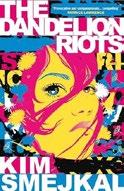
An orphaned teenager who’s imbued with unimaginable power finds community and fights back. Drinn Tryba has spent her life in isolation, moved yearly on her birthday among various carers, overseen by Aunt Melusine, the most powerful of the Aunts, who are “part seer and part witch.” They curse those they perceive as “rotten souls.” Other kids made it clear that Drinn was different, calling her “damned.” She was cursed at birth by Melusine with the seemingly innocuous ability to communicate with the earth. When she’s upset, dandelions sprout from Drinn’s neck, their leaves, stems, and yellow flowers growing behind her ears. But Drinn can do so much more—and when Melusine turns up on her 16th birthday, things turn violent. Drinn flees, guided by a pin cherry sapling through a portal. She finds herself in the eerie, crowded city of Oblison, where she meets a girl named Story and a boy called Bash. Drinn and Story are drawn into a slow-burn queer romance, but Drinn learns she’s part of a network of girls cursed by the witches and, to her horror, that there are tremendous negative consequences if she ever falls in love. The girls rally together in a terrific display of the power of kindness, unity, and love in all its variety. This narrative is a thrilling ride centering on girls’ and women’s agency. Drinn is cued white, and there’s diversity in skin tone in the cast.
A poignant tale of queer love, friendship, and sacrifice. (Fantasy. 14-18)
Tian, XiXi | Quill Tree Books/ HarperCollins (304 pp.) | $19.99 September 30, 2025 | 9780063086074

In her sophomore novel, Tian explores life after loss for high schooler Stella Chen. Moving from rural Illinois to San Diego, California, and entering a new school midway through senior year feels less than ideal to Stella, who already navigated emigrating to the U.S. from Xi’an, China, when she was in elementary school. But Baba thinks change is what the family needs. It’s been eight months since Stella’s older brother, Sam, died in his dorm room at Harvard, under circumstances her parents won’t reveal, and nothing’s been the same since. The promise of going off to college should be something to be excited about, but it fills Stella with fear. What if the pressure and the silencing of her emotional struggles prove to be too much? When Stella’s parents must unexpectedly travel to China to help family members, Stella’s forced to tour California colleges with the one person who might just get her to open up: her estranged childhood friend, Alan Zhao. Stella’s intimate narrative is a deeply moving story of secrets, grief, belonging, and family bonds. Her inner monologue includes chapters in which she directly addresses Sam, heartbreakingly unveiling memories from their childhood, changing relationship, last moments together, and more. Tian explores diasporic identities and family dynamics, particularly the experiences of satellite babies and how spending early childhood separated from one’s parents can shape relationships. The conclusion is satisfying and comforting without tying everything up too neatly.
A stirring emotional journey. (Fiction. 13-18)
Van Draanen, Wendelin | Holiday House (256 pp.) | $19.99 | September 2, 2025 9780823460380
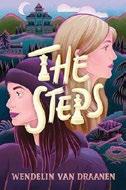
A teen adrift in a sea of loneliness is drawn into a mystery surrounding her dysfunctional family’s fortune. Ruby and her cousin, Sterling, were close until their fathers’ bickering following the death of both their mothers in a car crash created a wall between the girls that neither could cross for fear of triggering paternal wrath. While their fathers (who are brothers) are petty and self-involved, they’re not even the worst that the white-presenting Vossen family has to offer—their grandmother, Oma, plays her family members off against one another and views relationships as transactional, and Ruby’s stepmother and stepsiblings leave much to be desired. Readers will feel a sense of relief when, after a ring of Oma’s that’s worth $3,000,000 is stolen, one of the investigators, Detective Raven (nicknamed “Nevermore” by Ruby), clearly seems to feel for Ruby and have her back. As the mystery of the stolen ring unwinds in suspenseful increments, Ruby, a skilled chess player, also finds much-needed camaraderie in the school chess club. The members include Izaan, a boy she used to be close to until an awkward dance invitation strained their relationship; through chess, they repair their friendship. She also grows close to Tante Katrina, who was estranged from the family. Plenty of welcome heart is built into this whodunit that imagines a wealthy, backstabbing family that’s so stereotypically horrible that they tip toward the darkly comic. A fun, twisty mystery with a likeable narrator. (Mystery. 12-18)
Walker, Jessica | Viking (304 pp.) | $19.99 November 4, 2025 | 9780593692677

A 19th-century astronomy textbook connects two isolated teens in this epistolary collection of notes and drawings.
“Copernicus” is grieving their astrophysicist mother’s recent death. Their dad sent them to their grandparents in Green Bank, West Virginia, to complete senior year. A cryptic note their mother left behind leads the San Francisco native to an old textbook in the school library. Since the Green Bank Observatory’s sensitive equipment requires a ban on Wi-Fi in the area, instead of scrolling on their phone, Copernicus spends study hall creating fanciful artwork and writing letters to their mother in the pages of the textbook. After another student leaves a sticky note asking them to stop defacing the book, their exchanges evolve into true dialogue. “Kepler” is only in the school building early each morning, before she’s bussed to a gifted program. While she plans to leave the area for college, she’s proud of her Appalachian roots. The two, who appear white in the illustrations, ultimately join forces to investigate strange phenomena that occurred when Copernicus’ mother was in high school, referring to themselves and other members of their community through astronomy-related code names. Over the school year, they trade candid exchanges and challenge each other to grow. While their communications are confined to paper, their friendship feels organic and earned. Walker’s clever, eye-catching collages and drawings appear on the pages of a real historical astronomy textbook, incorporating the textbook’s contents in ways that maximize their effect.
A wholly original novel that celebrates connection in unlikely places. (Fiction. 13-18)
Yelchin, Eugene | Candlewick (432 pp.)
$22.99 | September 16, 2025 | 9781536215533
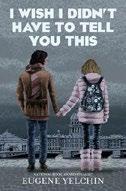
Following upon his acclaimed illustrated middle-grade memoir, The Genius Under the Table (2021), Yelchin switches to a graphic format to continue his account of
growing up in the Soviet Union.
This entry covers events from 1980 to 1983, when the young artist received hard-won permission to depart for the U.S.
In spare text and grayscale illustrations, this episodic narrative records a period of tumultuous emotional ups and downs. On the one hand, Yelchin experienced the triumph of finding professional work in stage design and the thrill of an increasingly close, if sometimes awkward, relationship with visiting American student Libby, who changed his life. He also experienced the shock of losing a refusenik Jewish friend to what was likely a KGB assassination and was confined in a Siberian psychiatric hospital, where he was heavily drugged and physically restrained, after tearing up draft notices. In the artwork, blurry background scenes of snowy streets and photos of Leonid Brezhnev’s jowly face on TV strongly evoke the feeling of living in a repressive, authoritarian state, while figures, particularly those with speaking roles, stand out against the drab backdrops. The young leads make a particularly engaging couple—one small, pretty, and expressive, the other lanky, hunched, and limphaired. Yelchin has such a gift for depicting faces with distinctive character that everyone here, from struggling artists to scowling soldiers and functionaries, will leave as strong an impression on readers as the oppressive setting.
An exceptional work: atmospherically illustrated and underpinned by strong but restrained feelings. (Graphic memoir. 14-18)
Kirkus Star
Yun, Jihyun | Knopf (400 pp.) | $20.99
October 7, 2025 | 9780593904879

Women in Soojin Han’s family can raise the dead.
Korean American Soojin and her sister, Mirae, have typically used their powers to revive roadkill or (on multiple occasions) their family’s beloved pet rat; their mother warned her young daughters against raising humans, citing a tragic example from an ancestor who broke the rules. Seven years ago, Soojin and Mirae’s mother was killed in a car crash, and their bereaved father was emotionally unequipped to handle 10-year-old Soojin and 11-year-old Mirae, leaving parentified Mirae to take care of her sister. But now that Mirae has suddenly died as well in a drowning accident, Soojin decides bringing her back is worth the risk. Soojin is too thrilled to be reunited with her sister to notice the disturbing hints that something isn’t quite right, from the mildewy rot Mirae leaves in her wake to the dark bruises appearing on Soojin’s own skin and the mysterious attacks on some of the town’s powerful residents. In her debut novel, Yun uses foreshadowing and alternating third-person limited perspectives to great effect, slowly unfolding mysteries from Soojin’s mother’s past through poetic, descriptive prose that never feels overwrought. The girls live in the predominantly white coastal tourist town of Jade Acre, which evokes Northern California. Korean language, food, and culture enrich this winning story of sisterhood, self-reflection, and moving on.
A beautifully written, grief-filled tale that’s equal parts creepy and heart-wrenching. (Horror. 14-18)

STANDING OUT FROM the crowd during the busy fall publishing season, the YA titles below offer teen readers books that authentically reflect their own life experiences while they expand teens’ worlds by exposing them to voices they might not otherwise have encountered.
Silenced Voices: Reclaiming Memories From the Guatemalan Genocide (HarperAlley, September 2) is the latest from Eisner Award–nominated artist Pablo Leon, who’s originally from Guatemala. This unflinching, resonant graphic novel centers on José and Charlie, whose mother actively encourages her sons’ assimilation into American society and refuses to talk about her Qʼeqchiʼ Mayan village. But the genocide trial of military dictator Efraín Ríos Montt

piques the brothers’ curiosity about Guatemalan history— on both national and personal levels—leading to painful revelations as well as healing. The message that acknowledging difficult truth is the only path to future progress shines through.
When readers pick up a Wendelin Van Draanen novel, they immediately sense that they’re in the hands of a skilled storyteller, and this prolific author’s newest book, The Steps (Holiday House, September 2), will hook teens from the opening page.
Narrator Ruby’s wry, endearing voice introduces an outrageously entertaining cast of dysfunctional, scheming people trapped in the orbit of her grandmother Oma, the family’s wealthy and manipulative matriarch. Oma’s stolen ring is the catalyst for an action-packed,
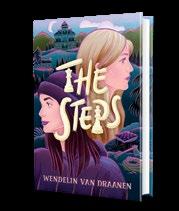

twist-filled mystery that reveals shocking secrets and involves Ruby’s neglectful father, horrible stepfamily, estranged cousins, and chess club buddies.
Released to much acclaim in the U.K. in 2023, Wild Song (Carolrhoda Lab, October 7), by Candy Gourlay, a Filipino journalist and author, offers a nuanced, heart-wrenching look at imperialism, cultural exploitation, and human resilience. Fleeing an arranged marriage and restrictive gender roles, Luki, a teenage girl from the Indigenous Bontok community, agrees to journey to the 1904 St. Louis World’s Fair, unaware that she and over 1,000 other people from the Philippines will be exhibited and gawked at. The wellrealized setting and skillfully integrated historical facts give this work broad contemporary relevance and resonance.
Following her Michael L. Printz Honor book, Fire From the Sky (2023), Moa Backe Åstot (Sámi) gifts


readers with Butterfly Heart (Em Querido, October 14), beautifully translated by Agnes Broomé. It’s compact and accessible enough for reluctant readers without sacrificing depth or complexity. Vilda, who’s Swedish and Sámi, loses her beloved grandfather Áddjá just as she’s poised to learn more about her Sámi heritage from him. She also gets her first period, develops a crush, and asserts her Sámi identity, experiencing painful rejection and supportive connection. Vilda is a relatable protagonist whose struggles with finding genuine connection will draw sympathy.
In a return to the wildly popular world of the We Were Liars series, E. Lockhart’s We Fell Apart (Delacorte, November 4) is fully captivating as a stand-alone read. The daughter of a self-centered absentee mother, Los Angeles teen Matilda gets an unexpected email invitation from the father she’s never known, renowned artist Kingsley Cello, to visit him on Martha’s Vineyard. There, Matilda meets her half brother, his eccentric mom, and the two young men who live on the estate and is plunged into their strange, disorienting world, confronting slippery truths and secrets.
Laura Simeon is a young readers’ editor.
In this journey of love and grief, a young woman returns to the hometown she barely remembers.
After her grandmother passes away, Alex travels with her best friend, Grim, to Grandma’s cottage in the small British seaside town of Indigo Harbour. With his help, Alex plans to go through her grandmother’s things, but her grief and regrets are almost too much to bear: “I didn’t even visit. I ended our calls early.”
Some of Grandma’s belongings bring up vague childhood memories of the town and a bedtime story about a falling star. During a chance encounter, Alex
learns that her divorced grandmother was seeing a woman named Elizabeth. She’s dismayed that Grandma didn’t tell her about the relationship—and try as she might, she can’t find Elizabeth. After Alex follows a black cat, she has an encounter that shows her there’s more magic in the town than she recalls. As she searches for information, trying to fill in the gaps and locate Elizabeth, Alex navigates loving and missing Grandma and honoring her memory. Her emotional arc is poignant and presented in a way that readers will find extraordinarily relatable.
By Bex Glendining
By Karen Latchana Kenney

Glendining, Bex | Abrams Fanfare | 192 pp. $24.99 | September 30, 2025 | 9781419765049
Glendining’s remarkable illustrations render each character distinctive. Their mastery of light and shadow is particularly impressive, creating a luminous watercolor effect. Alex has
dark brown skin and curly black hair, Grim has tan skin and wavy black hair, and most main characters are queer. Stunning from beginning to end. (Graphic fantasy. 14-18)

Allen, Kathleen S. | Roaring Brook Press (336 pp.) | $19.99 | October 7, 2025
9781250341778
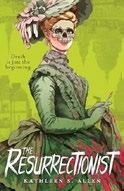
In the 1880s, a teenage girl seeks out the secrets of the dead.
When 17-yearold Dilly Rothbart’s father dies, she and her twin sister, Deirdre, are left to survive on their own, their mother having died in childbirth. Despite her physician father’s disapproval, Dilly has always dreamed of becoming a surgeon, and she still hopes to attend medical school. Deirdre, who’s more traditional in outlook, simply wants to find love and marry. Shortly after Father’s funeral, Dilly meets Benjamin Sinclair, a mysterious gravedigger, who also happens to be a medical student. Their encounter draws Dilly into a hidden world that exists behind the doors of the medical college and beneath the cemetery grounds. She soon learns that her father was a resurrectionist, searching for the secret to eternal life and engaging in alchemical experiments. As Dilly begins to follow the same path, her ambitions border on obsession— and following a tragic accident, she’s forced to confront the grim reality of her choices and the monstrous aftermath of her decisions. The story starts off at a slower pace, building into a gripping narrative filled with secrets, science, and death. Dilly’s determination to claim a place in a male-dominated field adds a compelling feminist layer, though some of those themes would have benefitted from deeper development. Still, this dark and atmospheric novel is sure to leave readers unsettled and eager to keep turning the pages. Main characters are cued white. A twisty, haunting debut. (Horror. 14-18)

Carpenter, Angelica Shirley Zest Books (296 pp.) | $19.99 paper September 9, 2025 | 9798765627433

This biography explores the evolution and impact of the Grimké sisters, Sarah (1792-1873) and Angelina (1805-1879), who grew up in a family of enslavers and became prominent abolitionists.
As children in Charleston, South Carolina, raised by a mother who parented with “a rod of fear,” the sisters were distressed by how their family members abused enslaved people. Over time, they questioned the morality of holding other people in bondage. Carpenter portrays the deeply entrenched prejudices of the time as a counterpoint to Sarah’s and Angelina’s growing awareness. Although they struggled against internalized messages about women’s inferiority, they found the courage to publish and speak, despite meeting with derisive, misogynistic insults in the press. The sisters stood firm, found fellow activists and supporters, and expanded their fight to include women’s rights. Again and again, the Grimkés broke with social norms, participating in a radicalism that was part of a seismic cultural shift in the lead-up to the Civil War. This relatively short book thoughtfully presents a period of upheaval and change and traces the sisters’ longlasting impact as well as recent, more critical perceptions of their motivations and behavior that bring welcome nuance to their story. Archival images help readers digest historical details, and excerpts from primary sources capture the sisters’ growth. The author carefully lays a trail of details, weaving them together throughout her account. Informative and insightful. (author’s note, family tree, glossary, source notes, bibliography, further reading and viewing, index) (Nonfiction. 12-18)
Chang, Alexandra Brown | McElderry (368 pp.) $19.99 | September 2, 2025 | 9781665972437

Teens navigate the twists and turns of a weeklong high-fashion fete in Paris. Piper Woo Collins has a loving dad, won an international science fair, and was accepted to Columbia University, where she dreams of studying environmental science—if her scholarship is reinstated. Chapin Buckingham has a famous actor mom and a rock star dad; she was wait-listed by Columbia. Both girls need a win. Enter La Danse des Débutantes, “the teenage Met Gala,” and the answer to their problems. La Danse promises to fund Piper’s scholarship in return for her being their “Cinderella story,” while Chapin sees a chance to win Deb of the Year—which would please her critical mother and bring her out of the shadow of her perfect brother, Dalton. But nothing goes as expected: Chapin must room with Piper, whose natural charm draws the attention Chapin craves. Piper struggles to fit in and secure her scholarship, manage her feelings about living her late mother’s unfulfilled Paris dreams, and avoid falling for Dalton. This addictive coming-of-age debut with a splash of drama pays homage to the artistry of fashion while tackling the age-old question of whether to live for yourself or others. The portrayal of the girls feels uneven (Piper seems endlessly good while Chapin’s flaws are on full display), but both are likable characters who are easy to root for. Piper is described as “Asian American”; her surname may imply some non-Asian ancestry. Chapin reads white.
A treat from start to finish. (playlist) (Fiction. 13-18)
well-rounded characters.
Chase, Paula | Wednesday Books (416 pp.) | $20 | October 21, 2025
9781250809391 | Series: The Heights, 1
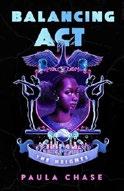
Jamaal Henderson and Chyna Thomas, friends from Diamond Falls, Maryland, keep it real through thick and thin—but when the streets, family struggles, and social media gossip come their way, their bond and their game are tested. A new era in high school sports has begun in Da Icy City. Dr. Timothy Walker founded The Heights School of Technology, Sports & Arts and poached the hottest local talent for its basketball and gymnastics teams. Jamaal led W.E.B. DuBois High School to a state championship, so the neighborhood and his former teammates aren’t too happy with his decision to move to the charter school. After his older brother, Jacquees, is gunned down, Jamaal hopes the Heights will allow him to make his mark and do right by his brother. Chyna also comes to the Heights with something to prove: Though she hasn’t received private lessons like her former teammate and main competitor, Leesh, she’s just as skilled. Her secret relationship with Jacquees has left her heartbroken at his death, and her mother’s kidney failure necessitates demanding dialysis appointments. Meanwhile, an anonymous gossip account on the Chatter app has been spilling secrets about the students, stirring up rivalries. Chase serves up a strong, balanced portrayal of dramatic, real-life struggles centering on
well-rounded Black characters navigating neighborhood, socioeconomic, family, and other differences. Teen readers will resonate with the relatable depiction of the challenges of juggling home, school, and the digital third space of social media.
Full of heart and grit. (dramatis personae) (Fiction. 14-18)
Christensen, Kate & Melissa Henderson Illus. by Megan Laude | Melissa de la Cruz Studio (336 pp.) | $18.99 | October 7, 2025 9781368099431
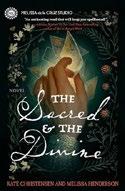
In Massachusetts in 1848, three sisters battle a force threatening their town.
Sixteen-yearold Daisy Wolfson and her sisters, fraternal twin Morrigan and 18-year-old Avery, made a mistake: They allowed something sinister to escape during their new moon ritual. Iniitally unaware of the problem’s origin, people in their small town of Redcliffe seek the sisters’ aid with curative spiritualist practices, tarot readings, crystals, herbalism, and elemental channeling. But, slowly and steadily, a Bleakness accentuates the townspeople’s worst instincts, and this animosity is aimed directly at the Wolfsons. The sisters, who can see into the past (Morrigan), the future (Daisy), and into people’s souls in the present (Avery) must work together to heal the afflicted while they still can and find the culprit causing this madness before they’re all overtaken. At the same time, Daisy follows her own spiritual journey,
one mirroring the tarot’s major arcana that involves more than one handsome young man. Although the setting and action are well described, the minimally developed characters fail to do more than follow their assigned roles, resulting in an interesting premise that unfolds with little emotion. The thoroughly described spiritualist practices will appeal to readers interested in the occult. The sisters are cued white; their mother was a “French Catholic Acadian orphan,” something the town’s elite find disgraceful. Laude’s charming spot art adorns the text. An atmospheric setting and strong spiritualist elements cannot compensate for underdeveloped characters.
(Supernatural. 12-18)
Crespo, Alex | Peachtree Teen (352 pp.)
$19.99 | October 7, 2025 | 9781682635797
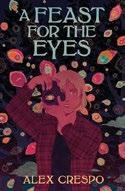
Four teens try to capture a photo of the monster that’s stalking them. In Pine Cove, a small town on the Oregon coast, something has lurked in the woods for decades—a monster that locals call the Watcher, who “hunts people down because they’re keeping secrets.” After Shay and her girlfriend, Lauren, have a fight in the woods about their closeted relationship, the Watcher fixates on them as its next target, attacking and injuring Lauren. When the police react with skepticism to their story, the girls feel sure no one else will believe them either. Shay teams up with Zoe, an aspiring photographer who needs to make her portfolio more distinctive if she’s going to snag the competitive college scholarship she’s competing for. Together with Shay’s best friend, Jack, and Zoe’s best friend, Parker, the girls try to find proof of the monster’s existence before it can hurt them—but doing so may mean revealing the secrets they’ve kept from each other. The prose is gripping and readable, and while the main romance that grows between Shay
and Zoe falls a little flat, the vibrant supporting characters and strong themes make this suspenseful work a thoroughly enjoyable read. The primary and secondary cast members are diverse in ethnicity, gender identity, and sexual orientation. The queer cryptid thriller you’ve been looking for. (Supernatural. 14-18)
Chappell Roan: A Vibrant Journey Through the Career and Influence of the Indie-Pop Superstar
Day, Harbert | Epic Ink/Quarto (208 pp.) $19.99 | October 21, 2025 | 9780760399279
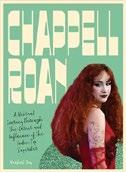
Captures the electric ascent of a pop provocateur whose queerness is central to her artistry.
Born Kayleigh Rose Amstutz in 1998, the singersongwriter, who was raised in a conservative Missouri town, unsuccessfully auditioned for America’s Got Talent and did some gigs at local churches and country clubs. Attending the famed summer arts camp Interlochen as a rising senior was a turning point for her. Through a mix of talent, reinvention, and hard-won confidence, she became a fearless pop phenom who writes bold anthems reflecting on personal liberation, particularly around gender and sexuality. Her confessional style and unflinching lyrics have helped her become a voice for queer Gen Z fans. This lively biography charts Roan’s rise from a scrappy transplant disillusioned by what she found in Los Angeles, to a star propelled by viral singles and a magnetic onstage presence. Quotes from interviews with Roan and her collaborators underscore her perseverance in the face of financial and music industry setbacks. The writing is fast-paced and honest, reflecting the performer’s bold personality. Color photos, quotes, and the eye-catching book design bring her world to life. Several double-page spreads introduce readers to her creative influences, including burlesque, drag, and women
musicians like Kate Bush, Pink, and Stevie Nicks. Fans will enjoy the narrative’s behind-the-scenes feeling, which shows Roan’s vulnerable side, and the author’s obvious respect for her subject.
An empowering, unapologetic portrait of creative risk and queer joy. (discography, awards and nominations, sources, photo credits) (Nonfiction. 12-18)
Diefendorf, Bekki | West 44 Books (200 pp.)
$25.80 | October 16, 2025 | 9781978598102

In this novel in verse, an introspective high schooler discovers new self- confidence. Ruthie keeps to herself, unlike her vibrant sister, Meron. Her mother, a nurse, struggles with compulsive hoarding; their house is full of “piles” and “NEW THINGS,” which prevents Ruthie from inviting anyone over, though she does sneak things out of the house and leave anonymous gifts for people. Compassionate attention from her new crush, Trey, gradually brings Ruthie out of her shell. She makes friends with his social circle and begins to stand up for herself. All the while, she’s processing a diagnosis of vitiligo, which is worsened by the stress she’s under. Diefendorf’s spare poetry traces Ruthie’s development from a lonely girl struggling in isolation to someone able to recognize and articulate her feelings. Trey praises her for being “kind / and generous and fun” and someone who “really sees
people.” As trust grows between them, he reveals that he struggles with reading and offers accepting words about Ruthie’s mother’s mental illness. The treatment of Ruthie’s vitiligo is refreshingly casual, with not too much angst surrounding her living with it. Ruthie shares affecting connections with Trey and Meron, and readers will applaud her journey to deciding to come out of hiding and live unapologetically. Ruthie has tan skin and wavy brown hair, and Trey has “deep / chocolate eyes” and light brown skin. Names cue ethnic diversity in the supporting cast.
A quiet story of personal growth for reluctant readers. (Verse novel. 12-18)
Edwards, Rachael A. | Peachtree Teen (416 pp.)
$19.99 | October 14, 2025 | 9781682637692
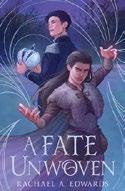
As the Emperor of Wyrecia lies dying, his son, Dimas Ehmar, desperately searches for his Fateweaver, a woman chosen by the goddess Næbya and gifted with the power to alter fate. Without her, Dimas appears to be cursed, a sign the goddess has abandoned him. Lena Vesthir has resisted the Fateweaver magic awakening within her. A heretic, she follows the outlawed old religion, spreading its stories through impoverished villages. But when a vision of Venysa, the first Fateweaver, offers her a way to break the bond that ties Fateweavers to the imperial line, Lena accepts the role, risking her own freedom for a chance at liberating her people.
Combines exciting action, heartfelt romance, and complex paranormal beings.
After the emperor’s death, Dimas and Lena prepare for the Rite of Ascension, a ceremony meant to bind them and check Lena’s volatile power. Dimas, haunted by the downfall of the Furybringer, a Fateweaver corrupted by magic, fears Lena may follow the same path. But Lena has her own agenda—discovering the hidden ritual to sever their bond before it’s too late. Meanwhile, cultists loyal to the memory of the Furybringer threaten to derail them both. Told in the leads’ alternating perspectives, Edwards’ debut explores inner turmoil and spiritual conflict in a world where followers of the old faith are left to starve—or be hunted. Main characters are cued white, and queer identities are seamlessly woven into the fabric of the world.
A dark tale of power, faith, and defiance that will leave readers eagerly awaiting the sequel. (Fantasy. 14-18)
Elle, J. | Razorbill/Penguin (528 pp.) | $20.99 October 14, 2025 | 9780593527764
Series: House of Marionne, 3

Alliances are shaky and the future is unclear as the magical order crumbles in this trilogy closer. Even as Jordan and Quell are desperate to resolve the dark magic consuming Jordan from the inside, Quell reluctantly becomes the new headmistress of House of Marionne— and key to both the future the lovers desire for themselves and magic overall. Nore (the new headmistress of House of Ambrose) and Yagrin (Jordan’s brother) similarly have their romance complicated by the perilous state of magic, but they’re tasked with pursuing the secrets of immortality via clues left with all the Houses. The intricate worldbuilding present throughout the series manifests here as a sense of frenzy and impending doom that makes the romantic threads feel even more potent. Nore’s familial obligations take a toll, and Jordan struggles with the power growing inside
him. The romantic chemistry between the young couples is palpable, providing touching moments of intimacy and well-earned fan service to shippers. The story feels rushed at times, and the complex machinations, numerous twists, and revealed history lead to some repetition. However, the impressive level of detail Elle provides for this diverse fantasy world—even in the midst of tumult—makes for an immersive reading experience all the way to the satisfyingly hard-fought conclusion. Enchanting. (House of Marionne specialties, map, house histories, lexicon) (Fantasy. 13-18)
Faizal, Hafsah | Farrar, Straus and Giroux (384 pp.) | $20.99 | September 23, 2025 9780374389420 | Series: Blood and Tea, 2

The gang gets back together after the catastrophic events of A Tempest of Tea (2024). Arthie Casimir and her brother, Jin, managed to uncover the real identity of—and steal a ledger with incriminating evidence about—the Ram, monarch of Ettenia, but their crew, a mix of vampires and humans, is irrevocably changed. The revelation of a secret leads to a rift between the siblings, the Ram is still in power, and now humans are going missing, with blame unjustly falling on the vampires. To take down the colonizer of her birth country, Arthie must get everyone to work together again, travel back to her homeland of Ceylan, and pull off her most daring heists yet. With chapters alternating among the perspectives of Arthie, Jin, and Felicity “Flick” Linden—a skilled forger and Jin’s love interest—this genre mashup set in an intricate fantasy world combines exciting action and adventure, heartfelt romance, and complex paranormal beings, all while feeling relevant to real-world issues. The trio of non-white leads face racial prejudice among other hardships
in a society that constantly underestimates them. The plot takes a little while to really get started, but once the action amps up, there are plenty of tense and impassioned moments. The ending satisfyingly wraps up the main conflicts and is sure to evoke a strong emotional response from invested readers. An exciting and bittersweet ending to a compelling duology. (map) (Fantasy. 13-18)
Fragassi, Selena | Epic Ink/Quarto (208 pp.)
$19.99 | October 21, 2025 | 9780760399293

A sparkling and richly illustrated tribute to a Gen Z star who has carved her own glittering path from young actor to pop-culture powerhouse. Ample color photos accompany this account that follows Carpenter’s steady climb and tremendous success. The work touches on her family life and early sources of musical inspiration (like Christina Aguilera, Mariah Carey, and Miley Cyrus), covers her Disney Channel beginnings, describes her bold style and growing influence in the fashion world, and highlights her collaboration and friendship with Taylor Swift. Highlighting the success of her 2024 album, Short N’ Sweet, the author shows how Carpenter went from being a driven, ambitious homeschooled child in Quakertown, Pennsylvania, who was posting song covers on YouTube, to a Grammywinning global icon with viral hits like “Espresso.” Fragassi, a music journalist, dives into Carpenter’s journey, calling it a “slow rise to the top” and “a testament to hard work paying off.” She shows how Carpenter doesn’t fit into the usual glossy pop-star image: “She’s flirty but fierce, poetic yet punchy, feminine and also masculine, and short with a giant personality.”
This celebratory tone of this biography of a multitalented performer, who’s known for her active engagement on social media and who has inspired many with her fashion sense and iconic bangs, is sure to please fans. An empowering, visually dazzling look at a self-aware and engaging young entertainer. (discography, filmography, awards and nominations, sources, photo credits) (Nonfiction. 12-18)
Goodwin, Idris | Atheneum (256 pp.) $19.99 | October 14, 2025 | 9781665973120
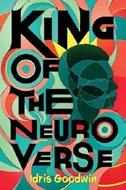
In 1999, a neurodiverse Black teen is trying to survive another summer school merrygo-round.
Rising senior Pernell introduces himself to readers from the place he escapes to—a bathroom stall in an out-of-the-way corner of his high school, where he dictates his thoughts and feelings on a small digital recorder. For the third summer in a row, he’s in “clown college” alongside the usual suspects. In this verse novel, Pernell shares the chaos swirling inside his head—the confusion and clattering emotions. His mind doesn’t work like everyone else’s, and his well-meaning parents are so busy helping him that they aren’t truly hearing him. All Pernell wants is to become the last Cypher King of the 20th century, the rap champion of the lunchroom. He hoped this summer would be better, but he’s stuck with English teacher Ms. Harding, his academic nemesis (“imagine a Stormtrooper mixed with a wicked stepmother”). The pressure builds until it finally boils over in a major clash with Ms. Harding. Goodwin’s YA debut is a powerful tale about figuring out how to keep it together when everyone treats you like you’re broken. Readers will empathize with Pernell’s struggles as he’s misunderstood and punished and his considerable facility with language goes unrecognized. A turning point
Deftly addresses timely topics, such as climate change and cycles of violence.
MOTH DARK
comes with a formal diagnosis of ADHD and support that helps him flourish. Period references enhance the feeling of immersion in the late-20thcentury setting.
Simultaneously lyrical and discordant; finds a universal sweet spot. (Verse fiction. 12-18)
Graley, Sarah & Stef Purenins | Illus. by Sarah Graley | Skybound (296 pp.) | $16.99 paper September 16, 2025 | 9781534327962

A young magic user searches for a magical ingredient that will help her become a pizza witch. Seventeen-yearold Roxy, a pinkhaired witch with a white-presenting dad and brown-skinned mom, wants only to become “the greatest pizza witch of all time.” She already makes delicious pizza (covered in happy little magical stars) in her cauldron, much to the chagrin of her foodie parents. Roxy refuses to work at their restaurant, instead delivering pizzas for Jeremy, the suave pizza warlock who she’s sure will eventually trust her with a quest for an enchanted ingredient—the best way to obtain a spot at Magic Uni. It’s obvious to Roxy’s cat, George, that Jeremy’s just exploiting her, but Roxy won’t hear it. Besides, he’s finally sending her off in search of a secret ingredient: the Remarkable Oregano. Roxy meets a cutie-pie witch on her quest, to boot. Bespectacled Erin, who has light brown skin and shaggy brown hair, joins Roxy and George on their quest. In exuberant, highly saturated panels, the adventurers
derail a forced cat marriage, rescue a green-haired soup witch, and compete in a tag team magic wrestling competition. One brief side quest, oddly, has Roxy accidentally harming another witch and leaving without fixing the damage or considering the incident again. The ingredients are cute, the monsters are squelchy, and what’s a quest without a little romance and a devastating betrayal? Goofy and colorful, with over-thetop characterization, this is a zany, Sapphic, pizza-packed romp. (Graphic fantasy. 12-16)
Gregovic, Lydia | Delacorte (480 pp.) | $21.99 September 30, 2025 | 9780593572412

A teen witch enters a deadly competition to become a prince’s bride.
In Balmoore’s capital, Isle d’Eylau, Lovett Tamerlane survives by thievery. She’s a silkwitch, whose unique Wit enables her to unlock any door. Lovett keeps her identity hidden; if she hasn’t married one of the sorcerers known as Weavers—someone who harvests silkwitch hair to spin into magesilk—by her 21st birthday, she’ll be banished to the cloisters forever. One day, Lovett unknowingly targets a Weaver, Eliot Lear, who comes from a prominent political family. When he catches Lovett in the act of stealing, he makes her a proposition. In exchange for his not reporting her, she’ll enter the Vainglory and find out who killed his silkwitch sister, Ophelia, during last year’s competition. In the sinister Vainglory, ten silkwitch maidens
compete to become the bride of Noé Alaire, son of the Weaver King. With a great deal of disdain for Eliot—but little choice over the matter—Lovett agrees to the deal. Her transformation into an appropriately socially adept contender for the prince’s affections is bumpy; she encounters adversaries at every turn, and her relationship with Eliot gets complicated. As Lovett gets closer to the truth, she finds herself in even more danger. Themes of class and gender politics appear throughout. The heartbeat of this engaging, slow-building story is Lovett, with her determination, fierceness, vulnerability, and brilliant powers of deduction. Main characters read white. Thoroughly enjoyable and filled with surprising twists. (Fantasy. 14-18)
Grothe, Taylor | Peachtree Teen (352 pp.)
$19.99 | September 30, 2025 | 9781682637777

An autistic high schooler gets trapped in a nightmare when her friends disappear during a hike. Cassie Davis hasn’t spoken to her best friends, Blake, Melody, and Jac, since she moved from middle-of-nowhere Deep Glen, New York, to New York City four years ago. She couldn’t tell them how her autism diagnosis and a breakdown led to her parents’ divorce, culminating in Cassie and her mother’s move back to Deep Glen. When her friends invite Cassie on their weeklong hike in the Catskills, Cassie agrees, hoping to mend their rifts. Instead, arguments abound, Cassie wakes to find Jac and Melody gone, and then a storm separates her from Blake. Fortunately, she’s rescued by handsome Kaleb, who invites her to take shelter in the Roost, an off-grid community. Kaleb and his mother understand Cassie better than her own mother, who pressures Cassie to overachieve even though her autism, anxiety, and trichotillomania overwhelm her. But why does it seem like they don’t
want Cassie and her friends to reunite? Though some secondary characters feel underdeveloped and some plot points remain unresolved, Grothe’s debut novel viscerally depicts Cassie’s anger and discomfort as she grapples with self-doubt and the emotional toll of masking. Ominous crows and uncanny dolls deepen the uneasy atmosphere, which is further charged by romantic tension between Cassie, who’s pansexual, and Jac, who’s queer. Most characters read white, and Jac is Jewish. Insightful and creepy, if slightly uneven. (Horror. 14-18)
Harris, Pamela N. | Quill Tree Books/ HarperCollins (368 pp.) | $19.99 September 16, 2025 | 9780063212671

When a revenge plot goes awry, high school seniors in Virginia find themselves hunted by a killer who may be one of their own. Since her best friend, Hope, died, Liv Porter has struggled with grief, anxiety, and debilitating panic attacks. The cops ruled Hope’s death a suicide, but Liv suspects that their other best friend, Brendan, was involved. On Halloween evening, she lures him to an isolated house and, with the help of her friends Kizzy and Sherie, sets up a plot to blackmail him into telling the truth. But their plan is derailed when two friends of Brendan’s show up and a storm knocks out the power. And then someone starts killing people, one by one. To get out alive, Liv must face her guilt and confront what really happened the night Hope died. This fast-paced page-turner jumps between past and present, delivering satisfying twists that will keep readers guessing until the end. The story explores heavy themes, including grief, mental illness (depression, bipolar disorder, and anxiety), domestic abuse, and online bullying, though the presentation of mental health feels lacking in depth. However, the
characters’ authentic voices make the work accessible and will encourage ongoing discussion. Harris serves up complex, unreliable characters who help create that delightful sense of unease and distrust that makes thrillers so fun. Most characters are Black, and Kizzy, who’s a lesbian, is Black and Chinese American. A bingeable locked-room thriller. (resources) (Thriller. 14-18)
Hatzopoulou, Kika | Putnam (384 pp.)
$19.99 | October 28, 2025 | 9780593859377
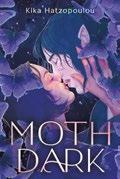
Six years ago, the first Darkbeast emerged and destroyed part of downtown Shanghai. Today, 18-yearold Sascia, a member of the Umbra Program’s team of young scientists who are researching the Dark, is the expert on Darkmoths, who appear only for her. During Sascia’s side hustle—conducting tours of the Maw, a Dark portal in Manhattan—she inadvertently lets through the first known Dark humanoid, a genderfluid elf named Nugau. Nugau tries to kill Sascia in retaliation for an event that has yet to occur in Sascia’s timeline. The two meet twice more at different times, the last meeting revealing a romance in Nugau’s past that’s yet to come for Sascia. Their timelines converge when Sascia enters the elves’ temporary world, a Dark-ravaged section of the Manhattan subway, and begins to realize why the Darkmoths (considered to be gods by the elves) have opened a rift between the Dark and Earth. The book’s resolution deftly addresses timely topics, such as war profiteering, climate change, and cycles of violence. The supporting characters, both elves and Sascia’s family members and friends at the Umbra, are well developed, but the book’s breakout character is Mooch, the lovable ancient leader of the Darkmoths, so named by Sascia because of its penchant for stealing her food. Sascia is Greek American, and the supporting cast
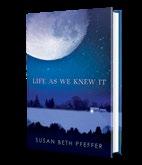
The writer published more than 70 books for children and young adults.
Susan Beth Pfeffer, who published more than 70 books for children and young adults, has died at 77, the New York Times reports.
Pfeffer, a Manhattan native, was educated at New York University; she published her first novel, Just Morgan, shortly after graduating.


Dozens more would follow, including Better Than All Right, About David, Rewind to Yesterday, The Ring of Truth, Make Believe, Nobody’s Daughter, and Justice for Emily. She had a hit in 2006 with Life as We Knew It, about a Pennsylvania family struggling to survive after an asteroid hits Earth. The novel was the first in a series that continued with The Dead and the Gone, This World We Live In, and The Shade of the Moon
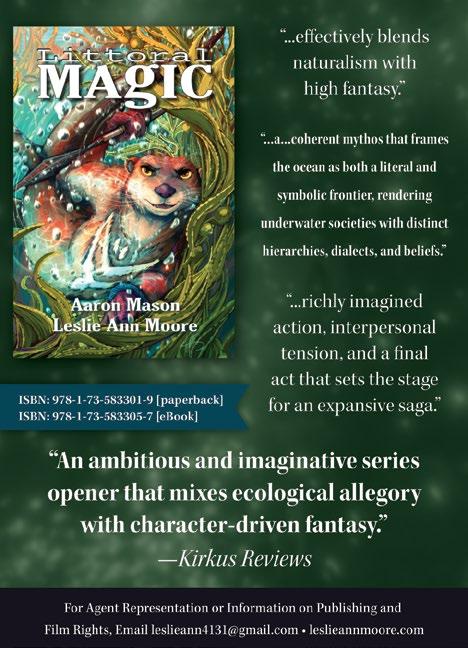
She talked about the series in a 2008 interview with Publishers Weekly, saying, “When I write a book, I write to entertain myself. If readers like it and get something from it, that’s a bonus. Over and over, people have said that Life as We Knew It helps them to appreciate what they have. For adults it has more to do with family. For kids, it seems to have something to do about realizing how hard it would be to do without certain things.”
Author Sarah Weinman paid tribute to Pfeffer on the social network Bluesky, writing, “Susan Beth Pfeffer wrote so many of my favorite YA books, just a giant in the field.”—M.S.


ANGELINE
Author of Sisters in the Wind
ANGELINE BOULLEY was 55 when she published her first novel, but she was just getting started. Firekeeper’s Daughter (2021) was a runaway bestseller that is being adapted for Netflix by the Obamas’ Higher Ground Productions. The book introduced readers to a biracial Michigan teen, both an insider and an outsider to her father’s Ojibwe tribe, who is investigating drug overdoses in her community. Boulley, an enrolled member of the Sault Ste. Marie Tribe of Chippewa Indians, followed up that impressive debut two years later with Warrior Girl Unearthed , also set, like the first book, on Sugar Island in Michigan. Another two years have passed, and this fall brings readers Sisters in the Wind, about a teen in the foster care system seeking more information about her Ojibwe birth mother; Kirkus’ starred review calls it a “powerful story of family, belonging, and identity interlaced with thriller elements”—in other words, this talented late bloomer is back to doing what she does best. Boulley recently answered our questions by email.
Tell readers, briefly, what Sisters in the Wind is about.
Former foster teen Lucy is fleeing from a painful past and the betrayal that nearly killed her. She wants nothing to do with the handsome attorney offering to connect her with the Native American family she never knew. Why does he care so much about Lucy? And why did he accidentally call her “Lily”?
What inspired this story?

The most recent threat to the Indian Child Welfare Act made it all the way to the U.S. Supreme Court (Haaland v. Brackeen, 2023). I know of many children and teens who have remained connected to their Native families and communities thanks to the ICWA, so I was curious as to why anyone would oppose this law. I learned that in far too many cases non-Native social services and court personnel either don’t fully understand ICWA or view it as a bureaucratic hassle. Lucy’s story is one example of why this law is paramount for children, teens, and the future survival of Native American tribes.
Where and when did you write Sisters? Describe the scene, the time of day, the necessary accoutrements or talismans.
I’ve found that I am a different writer for each book. With Firekeeper’s Daughter, I was an early morning writer because of my day job in the U.S. Department of Education. For Sisters, I wrote in vampire mode— sitting down in the evening and continuing until sunrise—fueled by carbs, not blood.
What was most challenging about writing it? And most rewarding? The challenge was writing while relocating to a new home. I spent the past year completing the most chaotic move from my former house to a condo unit in my former high school. My living room used to be my algebra classroom and my new bedroom was


once the drama department…make of that what you will!
What fall release(s) are you most eager to get your hands on?
I’m excited for Legendary Frybread Drive-in, edited by Cynthia Leitich Smith. I contributed a short story for it and cannot wait to read the contributions by the other authors including Jen Ferguson, Byron Graves, Darcie Little Badger, Andrea L. Rogers, and Brian Young. Eric Gansworth, Ari Tison, and Louise Erdrich have books coming out soon. And I want all the adult rom-com stories from Indigenous authors.
Interview by Tom Beer.
brings additional ethnic diversity. In this world, queer identities are accepted without question.
An engaging urban fantasy with an important message. (Fantasy. 13-18)
Haywoode Henry, Helena
Nancy Paulsen Books (544 pp.) | $21.99
October 7, 2025 | 9780593625309

Young adults on death row compete on a reality show, seeking the prize of freedom.
Eternity Price hates God. She blames Him for everything that’s gone wrong in her life, starting with Dad’s death when she was 6 and Momma’s death when she was 12. Eternity and her younger brother, Sincere, moved in with Nana, their verbally abusive grandmother. Now, at 18, Eternity is on death row. She sees three ways to get out: “the legal stuff, run, or fight.” Appeals may take 20 years or more, and for a fat Black girl in Texas, fleeing doesn’t seem like a realistic option. Eternity decides to fight by applying to be on Last Chance LIVE!, a show that gives 10 contestants between the ages of 18 and 21 the chance to win their freedom. Viewers across America vote each week, and the eliminated contestants’ death sentences are expedited. Eternity thinks the risk is worth it, and she’s determined to win at any cost. Eternity and the other characters accurately represent the socioeconomic status and racial demographics in U.S. prisons. Unfortunately, this debut’s flat character development limits the story’s emotional resonance. The pacing is slow, and due to the amount of time the contestants are confined to their rooms, the novel becomes repetitive. The rousing and informative author’s note is excellent and will invite introspection and reflection, however.
Fails to deliver on its intriguing premise. (Fiction. 14-18)
Engaging and frighteningly realistic; a suspense-filled winner.
THE SCAMMER
Houck, Colleen | Blackstone (350 pp.)
$19.99 | September 9, 2025 | 9798212221733
Series: The Tiger’s Tale Series, 2
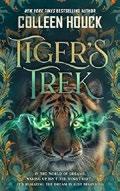
In this second series entry, shape-shifting tiger sisters and their escorts undertake tests and quests in a magic land infused with Russian folklore. Because the six principal characters are scattered at the beginning— and proceed in several directions in changing combinations— this sequel to Tiger’s Tale (2024) tends to sprawl. But whether readers prefer their folkloric adventures to be melodramatic, romantic, comical, or mystical in tone, Houck endeavors to provide something to satisfy them. She also assiduously mines her Slavic sources of inspiration, stirring tricksy bargains and helpful gifts (like magic boots) into encounters with powerful figures from Morozko (Father Frost) and Baba Yaga (here called “Baba Yuga”) to a mischievous likho, or spirit of misfortune. The young travelers are exposed to generous doses of life wisdom, opportunities to heal old wounds or learn from experiences, and (for some, at least) steamy romantic awakenings. Houck imparts many lessons, but she laces the narrative with Russian words, often slang (“Gaw! Boy’s near froze off his yaytsa!”), and modern-sounding expressions (“That’s just weird,” “Well, cry me a river, son”) that both enrich and lighten the atmosphere. Contests with foes, like the troll-like vodnik and a child-murdering ghost, provide thrills. Aside from an Indian mage from Houck’s Tiger’s
Curse series putting in a guest appearance, the cast reads white.
A mare’s nest plot-wise, but the intriguing setting and characters make it worth untangling. (Fantasy. 13-16)
Jackson, Tiffany D. | Quill Tree Books/ HarperCollins (368 pp.) | $19.99 October 7, 2025 | 9780063271272
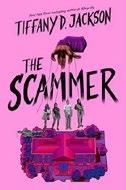
A first-year college student’s experience turns into a nightmare when her roommate’s brother moves in. Inspired by a real incident at Sarah Lawrence College, Jackson pens a gripping story about mental manipulation and predators disguised as positive influences. Against her parents’ wishes, Jordyn Monroe defers her Yale acceptance to attend Washington, D.C.’s Frazier University; she has a meaningful reason for wanting to choose an institution that’s among the most well-known Historically Black Colleges and Universities. After attending mostly white schools in the suburbs of Westport, Connecticut, Jordyn is excited to no longer be the only Black person in class. She and her three suitemates immediately bond and start thinking of themselves as sisters. When one girl’s older brother needs a place to stay after being released from prison—she says he was framed for credit card fraud—the others immediately welcome him. Devonte is smart, charming, and handsome, and he shares interesting stories about working in the hip-hop industry. He also offers the girls guidance and encourages them
to expand their minds. Soon, however, he starts controlling their every move, and Jordyn can’t see a way out. Jackson’s portrayal of Devonte’s subtle brainwashing, leading up to a wholly unanticipated twist, is excellent, although the story wraps up a bit too quickly after the big reveal. The setting is intriguing and adds appeal, although readers may wish for more details about how HBCUs differ from predominantly white institutions.
Engaging and frighteningly realistic; a suspense-filled winner. (Thriller. 15-adult)
Kenney, Karen Latchana | Twenty-First Century/Lerner (136 pp.) | $37.32 PLB October 7, 2025

An enticing exploration of the astonishing world of fungi. This easily comprehensible, accessibly written work introduces readers to fungi—mushrooms and mycelium, yeasts, and molds. In her introduction, Kenney explains that fungi are “not quite plant and not quite animal.” She goes on to describe their characteristics and appearance (divided into “The Beauties” and “The Oddities”). Two chapters cover edible mushrooms, their high nutritional value, and their role in world cuisine, and toxic fungi and their impact on people and crops. Later chapters explore mushrooms that can heal and ones with mind-altering properties. Readers learn about the burgeoning interest in using mushrooms to treat cancer, depression, and other ailments. This eye-opening narrative summarizes new scientific discoveries about how mycelia (“a network of fungal cells”) support and feed forests. The final chapter details cutting-edge research: using fungi’s antiviral properties to
protect bees, creating self-repairing “intelligent buildings” that have “mycelial computers built into their walls,” extracting enzymes from fungi to break down plastic pollution, and other innovations. Kenney illuminates a largely unknown world—out of an estimated 2.2 to 12 million fungus species, scientists have discovered about 150,000—that holds exciting promise for our future. The pleasing visual layout includes color photos and captivating sidebars, often about historical cases or intriguing personal stories.
An extraordinarily well-researched, well-presented, and visually appealing book on a fascinating subject. (are you a mycophile, glossary, source notes, selected bibliography, further resources, index) (Nonfiction. 12-18)
La Sala, Ryan | PUSH/Scholastic (400 pp.) $19.99 | September 16, 2025 | 9781546125877
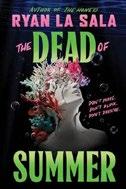
After his mother recovers from cancer, Ollie returns with her to their island home just before a storm hits and unleashes a deadly plague.
Ollie is nervous about returning home to the tiny island of Anchor’s Mercy, Maine. His mom—who’s decided he should call her Gracie—is better and says she’s ready to have the “best summer ever.” Ollie feels uneasy, though. Besides being a queer haven and popular tourist destination, Anchor’s Mercy has a long history of shipwrecks and frequent ailments befalling its residents. After a tropical storm cuts power to the island, a strange sickness begins spreading through the community, causing the afflicted to become zombielike and “drown,” even though they’re on land. Ollie felt something was wrong before the outbreak, but no one heeded his warnings. Now, he reunites with his estranged best friends, Bash and Elisa, and together they fight to survive and finally solve
the island’s mysteries. This gripping tale unfolds from Ollie’s first-person perspective and through a scientist’s interview transcripts and research log. The themes of community and finding strength in others are ever-present as Ollie, Bash, and Elisa lean on each other through the dangers they face. The twists and fast pace will keep readers engaged up until the very end. Ollie and Bash are gay. Ollie presents white, Bash is of Lebanese and French Canadian descent, and Elisa is Portuguese American.
An original, page-turning horror story that emphasizes the importance of queer community. (Horror. 14-18)
Lepore, Gabriella | Storytide/ HarperCollins (384 pp.) | $19.99 September 23, 2025 | 9781335013873
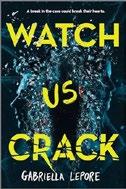
A high school junior becomes entangled in a murder case after her friend’s boyfriend is found dead at the train station by her house. Aspiring criminologist Sadie Morelli lives with her dad in the western New York state town of Hailing. After her parents split up and her mom left, her dad encouraged her to transfer to high school in nearby Arcadia, which has a better reputation. A fierce hockey rivalry exists between the schools. Kai, Sadie’s best friend Quinn’s boyfriend, plays for Arcadia, and he and his friends are part of Sadie’s social group. But reconnecting with Cason, a guy she knows from middle school who plays for Hailing, feels truly meaningful to Sadie, even though they have to keep their relationship secret. When Kai is killed and the police begin an investigation, it turns out many people are hiding things—but Sadie and Cason are the ones everyone suspects, and they’re desperate to clear their names. The narrative shifts among the first-person perspectives of Sadie and Cason, police interviews, text message exchanges, and
transcripts from a true crime podcast, incrementally ratcheting up the tension and keeping readers on their toes. Sadie and Cason’s burgeoning romance is compelling enough but Sadie’s friendship with Quinn, who seems one- dimensionally self-involved and melodramatic, is less so; it’s hard to see why smart, straightforward Sadie is so dedicated to her. All main characters read white.
The engaging and unpredictable plot will sustain readers’ interest despite the uneven characterization. (Thriller. 14-18)
Lueddecke, Lisa | Simon & Schuster (304 pp.) | $20.99 | $12.99 paper September 30, 2025 | 9781665984492 9781665984485 paper

Shadowed by twin family tragedies, high school senior Emma returns to her hometown of Scarrow, Maine, seeking answers.
A bog known as the Moss abuts Emma’s home, Lark House. Tales of those drawn to the Moss’ mysterious pull have been passed down through the centuries. Its stagnant ponds, snakelike vines, and enveloping mist assert a sinister hold over those who hear the whispers and see the lurking ghostly apparitions. Five years ago, Emma’s mother fell under the Moss’ spell, vanishing into the bog without a trace. A year ago, grief over Mom’s loss led Emma’s older sister, Eve, into its depths. Police suspicions fell on Emma’s father, and he sent Emma to California to live with her aunt. But, haunted by voices and ghosts, Emma feels duty-bound to find her sister. This story contains folk-horror elements, including an atmospheric rural setting whose wild nature is both beautiful and malevolent. Emma’s first-person narration meaningfully explores themes such as isolation and helplessness and their lasting impact on emotional health, although the middle
A lively and engaging mystery with a strong emphasis on supernatural elements.
RED THREADS
portion of her journey feels slow and repetitive. Emma’s grief, like the Moss itself, becomes a lurking presence— “untouchable” yet “always feeding and growing.” Also much like the Moss, a place caught between life and death, Emma exists in an emotional state somewhere between distress over all that has been lost and the rebirth of a fragile optimism. Main characters read white.
A haunting testament to grief’s insatiable appetite and the need for hope in our darkest hours. (Supernatural thriller. 12-18)
Metallo, Susan | Candlewick (400 pp.)
$18.99 | September 2, 2025 | 9781536240351

In this debut, an autistic aspiring playwright pens a blog addressed to her bullies while questioning her sexuality and dealing with messy friend conflict.
“Reason #1: Because of me, you will never date the hottest guy in school,” begins Jess Lanza’s second blog entry addressed to the three classmates who’ve targeted her. Their persecution began in the aftermath of Jess’ kissing Noah, a fellow theater kid who’s dating her former best friend, Chloe, a Black-presenting girl who’s also autistic. Each blog post lists another reason for these bullies to hate Jess, who’s cued white, many of which are tonguein-cheek (“I assault innocent people with baked goods, and I am reluctant to apologize for it”). In reality, Jess is desperate to make amends with Chloe. As Jess grows closer to athletic Cam, an
attractive boy who has floppy blond hair, their friendship complicates her exploration into whether she’s asexual. Jess, who nurses a great love for Shakespeare and a longtime desire to attend the ultra-competitive dramatic writing program at Tisch, sometimes includes in her posts snippets of dialogue in a screenplay format to process the hypothetical scenarios she’s imagining. Unfortunately, meandering and unclear storytelling lessens the impact of the central conflict by muddying the stakes and undermining readers’ understanding of the characters’ motivations.
A potentially interesting drama in need of greater clarity. (Fiction. 14-18)
Miller, Rowana | Sourcebooks Fire (368 pp.) | $12.99 paper | October 7, 2025 9781464254543

A teen at a Manhattan private school must come to terms with her past in order to solve a mystery.
As a junior at Davison High School, Kay’s goals are to keep her scholarship and get into Northwestern. When the first letter arrives in her locker, instructing her to dye her hand blue, Kay must decide whether she wants to accept this invitation to join her school’s “secret society of teenage vigilantes.” Doing so could help her find out the truth about her best friend, Emily, who died in ninth grade. It might also help her get close to her crush, Zola, who she suspects might be writing the notes that keep arriving
with more mysterious instructions. As Kay gets pulled into the society, she works with her new friends on missions, some connected to dark secrets involving the school’s leadership. But she soon begins to wonder who she can really trust. Miller’s debut is filled with intrigue and tension. The characters quickly feel distinct, and their portrayals build in complexity as their truths are revealed. Most characters are cued white (Davison isn’t “abysmal” when it comes to racial diversity, but it’s “no paragon of inclusion”), and some conversations about racial and socioeconomic differences feel heavy-handed and expository. Nevertheless, the author hooks readers through the plot’s twists and turns as well as discussions of relatable topics, including jealousy and social dynamics.
A gripping story in which the power of friendship helps uncover the truth. (Thriller. 14-18)
Mix, Rebecca & Andrea Hannah | Storytide/ HarperCollins (400 pp.) | $19.99 September 16, 2025 | 9780063379619
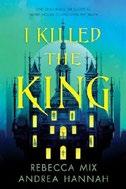
Six young people race to solve the murder of the king who was killed in front of them.
On the night of the ball celebrating the end of a war between two magical kingdoms, Avendell and Istellia, King Costis of Avendell gathers five people in secret: Oak, his personal guard; Ellion, a failed healer turned necromancer; Clove, a skilled beast handler; Melarie, a princess from Istellia; and his own son and heir, Kellam. Also lurking in the room is Vesryn, an assassin tasked with murdering Costis. Suddenly, the lights flicker off, and in the darkness, the king is killed. Each of those present had the means and motive to slay him—but which one did it? With a snowstorm confining everyone to the castle and more bodies appearing, the
six must work together to find out who the murderer is and avoid becoming the next victim. This locked-room murder mystery switches among the points of view of the central characters, but their voices aren’t fully differentiated. The authors convey the complex mythology and worldbuilding through large chunks of exposition, backstory, and infodumps. Still, readers seeking an action-packed thriller in a magical setting will enjoy this duology opener that explores power, belief, and taking charge of your fate. In this world, which evokes a fantasy Europe, the main characters present white.
A twisty, plot-driven magical murder mystery that struggles to show rather than tell. (Fantasy mystery. 14-18)
Nguyen-Hayama, ila | Abrams Fanfare (256 pp.)
$26.99 | October 28, 2025 | 9781419763021

A dangerous presence haunts a magical boarding school. On her way to her Tokyo high school, Hana frees a crow that’s tangled in netting. Soon afterward, she receives an invitation to attend a super-secret magic academy, the Benten School of Esoterics. Far from her bustling urban existence, the academy is located on a rural island which, according to legend, was one of the first islands of Japan created by the gods Izanagi and Izanami. Hana eagerly begins classes in shape-shifting, veiling, and other subjects, forging a special connection with loquacious Japanese Korean classmate Yoomi, whom she first met on the train to boarding school. Unfortunately, something sinister is at work in Benten’s halls, sucking the life out of the students and possibly even controlling the teachers. Fighting the ethereal evil requires inner strength and a sprinkle of magical self-discovery. The magical boarding school narrative will appeal to fans of this evergreen
genre, and debut author NguyenHayama’s interpretation delights in the particulars of Japanese myth, religion, and visual culture. Yōkai populate the island, students study traditional arts like omamori and mizuhiki, and holiday celebrations and quintessentially Japanese images that mark the passing of the seasons appear throughout. Manga fans, in particular, will appreciate the colorful, expressive illustrations. A lively and engaging mystery with a strong emphasis on supernatural elements. (Graphic fantasy. 12-16)
Qurratulayn | Page Street (272 pp.) $18.99 | October 7, 2025 | 9798890033000

After almost being murdered, a girl invokes a contract with a devil to exact revenge. Ever since her mother died during a violent mob attack, 17-year-old Magi, Evangeline “Evan” Wilde, has pretended to be Dun, someone without magic. This ruse has kept her and her magical blood safe from being unwillingly bound in a contract with a Necro (one of those who first rose up and ended the rule of devils). Evan works at the Red Emporium, writing contracts that call down devils. One day, a man named James Bahayin visits, seeking a protection sacrifice, and Evan feels drawn to him. That night, she’s attacked by a Necro and almost becomes an unwilling sacrifice. A desperate Evan offers her life for the power to take revenge on Necros. Enter Jack, a devil who’s waited 300 years for the opportunity to kill the Necros—and Rhys, the devil he loved who betrayed him. With Jack’s help, Evan, who reads Black, infiltrates Necro society, befriending James and Penelope Heriotza, whose family is rising in influence. Gradually, she realizes that not all Necros are evil. Now she must choose: exact revenge on innocents

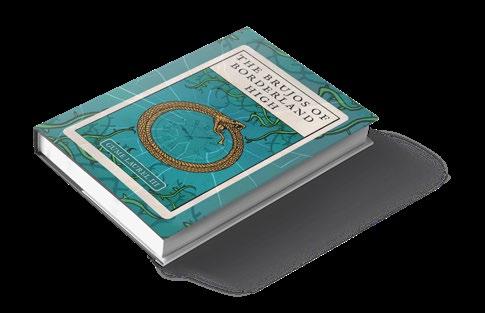



Kate Scelsa

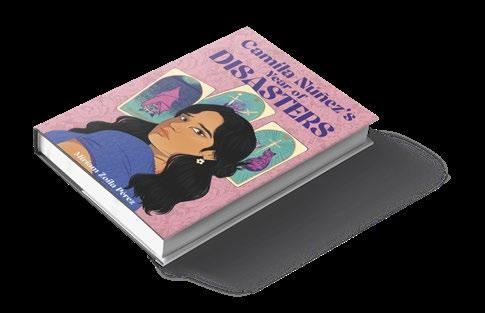

Author of I Wish I Didn’t Have To Tell You This
EUGENE YELCHIN’S new graphic memoir, I Wish I Didn’t Have To Tell You This , boldly recounts the author’s harrowing experience leaving the Soviet Union in the early 1980s. A continuation of his acclaimed middle-grade autobiographical novel, The Genius Under the Table (2021), the new book is written for a young adult audience and features Yelchin’s expressive grayscale illustrations. Yelchin answered our questions by email.
Tell readers, briefly, about your book. I Wish I Didn’t Have To Tell You This details the last three years of my life in the Soviet Union: 1980-1983. During that time, I fell in love with an American student, Libby. From Libby I learned that fundamental things had been stolen from me by the state— life, liberty, and the pursuit of happiness. The lives of Soviet citizens were dedicated to the Communist Party; our liberty had been taken away for so long that we didn’t know what it might feel like to be free, and happiness was such a foreign and frivolous concept that it would be suspicious to pursue it. Libby gave me the courage to resist the oppressive regime, which eventually led to my liberation.
What inspired you during the writing of the book?
Making this book was extremely labor-intensive—432 pages of drawings! The process took four
years, during which I read many books, but there was one I went back to again and again—Sven Birkerts’ The Art of Time in Memoir I highly recommend this book to anyone considering writing a memoir. Birkerts is an insightful, sensitive, intelligent, and clear writer.
What was most challenging about writing this book? And most rewarding?
The most difficult thing is expressed in the title. I wish I didn’t have to tell you about the troubles I had with the Communist Cultural Committee. I wish I didn’t have to tell you about dodging the draft during the war in Afghanistan. I wish I didn’t have to tell you about the constant KGB surveillance, the nightmare of the Siberian psychiatric hospital, the loss of my best friend, assassinated by the KGB. I wish I didn’t have to, but in a changing America, the first-person account of what it means to live in a dictatorship may be of some use to young readers.
The most rewarding? Reliving the time when I was in love with someone who gave me courage and hope, who opened my eyes to injustice, and who, in the end, saved my life.
Will you be touring or doing events for the book this fall? Any you are especially looking forward to?
I am very fortunate to be working with a team of passionate and dedicated people at Candlewick



Press. They’re helping the book be seen by as many readers as possible. The one event I look forward to most is the launch of the book at the Wende Museum of the Cold War in Los Angeles. This will be my third launch at the museum Each event is different and entertaining. I build sets, make movies, invite musicians, work with actors reenacting scenes from my books. It’s fun. If you find yourself in Los Angeles on Sunday, September 21, please come by.
Interview by Emily Gaines.
or die for nothing? This immersive, plot-driven story takes place in a racially diverse world with queer representation that evokes 1920s New Orleans with a creative magic system and some well-executed twists. Unfortunately, the characters feel two-dimensional and exhibit little growth, and many events seem to occur to serve the plot. An uneven but intriguing series opener. (Fantasy. 14-18)
Revord, Raegan | Wednesday Books (304 pp.) | $20 | September 2, 2025 9781250356345
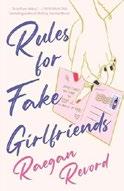
In this debut by actor Revord, a posthumous postcard from her mother sends a teen across the Atlantic to complete a scavenger hunt— and she finds love along the way.
The note Avery Blackwell receives informs her that there’s a story she can “only finish in Brighton.” Avery had planned to be pre-med at Columbia, but she defers her entry and instead enrolls at the University of Brighton in England, which her mom, whom she recently lost to cancer, graduated from 25 years ago. On the train from London to Brighton, Avery sits beside Charlie, who impulsively pretends that Avery is her girlfriend because Leyla—the ex Charlie is trying to win back—is walking by. When Avery discovers that Charlie and Leyla are studying at the same university as her, she agrees to continue the dating charade. Avery and Charlie grow closer as Charlie helps Avery search for the nine clues that Avery’s mother has left hidden around the city, presumably leading to the time capsule every graduating University of Brighton student receives. But just as Avery starts to fall for Charlie, Charlie pulls away. The plot unsuccessfully balances the scavenger hunt with the love story, making the pacing uneven. The late timing of some big reveals and
storyline shifts also contributes to the sense of disjointedness, and the U.K. setting is poorly developed. Avery and Charlie are cued white. Bites off more than it can chew. (Romance. 13-18)
Riley, Sierra Marilyn | Annick Press (280 pp.) | $15.99 paper | October 7, 2025
9781834020099

An anxious girl obtains a lead role in the Halloween play and confronts a legendary curse. Sixteen-year-old Italian Canadian Violet Costantino and her best friend, Kay, who’s TwoSpirit and cued Cree, are scholarship students at Dark Cove Arts Academy, an elite performing arts boarding school on an island in British Columbia. Following an onstage panic attack the previous year, Violet switched to playwriting. But the required audition for the upcoming season unexpectedly lands her a major role in A Midsummer Night’s Dream and a spot in the Dark Cove Theatre Society, known for hosting secret parties at an abandoned campsite that’s plagued by rumors of a “slasher-type killer” responsible for students having gone missing years ago. Violet, who’s queer, takes the stage with her ex-crush Hunter Kinsey, the school’s golden boy, and Frankie Lin, the popular “resident ingenue,” who simultaneously irritates and impresses her. Mysterious events lead to Violet’s becoming the suspected target of the Society curse, whose victim is destined to drop out before opening night. Violet
must avoid the curse, navigate complicated love triangles (on- and offstage), cope with mental health challenges, and resolve a fight with Kay. Although the plotlines wrap up a bit too quickly, this debut with gothic touches centers on diverse, well-developed teens who challenge their school’s narrow norms. Riley’s detailed worldbuilding creates a setting that readers will wish to explore more deeply than the story allows. An original exploration of mental health set against an intriguing backdrop. (map, director’s note, playlist) (Fiction. 13-17)
Scott, Emma | Bloom Books (416 pp.) | $14.99 paper | October 7, 2025 | 9781464243417

Two childhood sweethearts navigate the pressures of adolescence and difficult family dynamics. Emery Wallace and Xander Ford formed an instant connection when they first met in Rhode Island on the Fourth of July at the age of 10. Xander, who was in town from Maryland for his family’s annual trip to see his dad’s relatives, was obviously poor, while Emery was clearly a rich girl. They decide to become pen pals, but neither one receives an answer to their letters, and even though Emery looks for him at their meeting point each Independence Day, Xander doesn’t appear. Seven years later, Xander is back in town with his ailing dad. The pair is reunited when Emery—answering an ad and not realizing who posted it—hires Xander to be her calculus
tutor. After some initial friction over the dropped communication, the sparks fly. But as their emotionally charged, physically intense relationship grows, they face challenges—Emery struggles with her controlling father’s demands for perfection, and Xander’s father has early onset dementia. In flowery language, Scott’s vivid, highly emotional story explores love, loss, and grief. The chapters alternate between the leads’ first-person perspectives, building tension and showing how they find themselves through their mutual love. Scott thoughtfully explores difficult topics young adults might experience, such as emotional abuse, parental conflict, and socioeconomic differences. Main characters present white. A passionate romance about a couple who find the missing pieces of themselves in one another. (Romance. 16-18)
Springer, Lisa | Delacorte (352 pp.) | $19.99 September 16, 2025 | 9780593900574
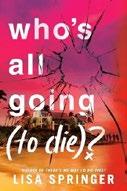
A new college student on an athletic scholarship joins an all-expenses-paid wellness trip and discovers danger lurking around every corner.
Eighteen-yearold Ariana Pollard is ready to forget about her problems. Ari was once her high school’s star volleyball player, but her athletic career was put on hold after she sustained a shoulder injury during senior year; even surgery can’t guarantee she’ll be able to play again. Luckily, her new friend, Oakley Stewart, presents the perfect distraction: a week of R&R on Pelican Island, off the coast of Barbados. Oakley’s parents—a Black Bajan hotelier and a white American Pilates teacher—are building a top-tier resort, and the Teenage Dream retreat aims to help guests practice self-care. Along with her cousin Candy and best friend, Maya Sanchez, Ari, who’s Black, arrives at the resort with an open mind, but a near-fatal accident soon disrupts
the island’s tranquil facade. The body count begins to rise, and Ari tries to uncover the truth before she’s the next casualty. Reminiscent of shows like The White Lotus that combine sharp social commentary with suspense and filled with all the atmospheric anxiety and blood spatter of a Blumhouse horror movie, Springer’s sophomore novel offers an engaging, relevant critique of wellness and influencer culture. Carefully doled out clues and red herrings keep readers guessing until the shocking reveal. The unspoken hierarchy between the guests and the Black hotel workers highlights capitalist class and social status divisions.
Thrilling, suspenseful, and engaging. (map, character list, author’s note) (Horror. 13-18)
Tan, Sue Lynn | Little, Brown (400 pp.)
$19.99 | October 28, 2025 | 9780316576208 Series: Never Ever After, 1

A powerless teen struggles to forge her own destiny in a tyrannical kingdom in this Chinese-inspired fantasy world.
In this series opener, Yining lives in a small village in the Iron Mountains, one of the Three Kingdoms, earning a meager living by pretending to be a fortune teller—and all the while yearning to make her own fortune and explore the outside world. Adopted as a child, she knows nothing about her birth parents and only has two possessions from her original life: a wooden ring and a threadbare handkerchief. Yining’s downtrodden life begins to change after she meets a talking carp in a pond, who reveals that she has a magical heritage connected to her ring—a “great gift and responsibility.” Having learned fighting skills from her now-deceased uncle and been taught to pickpocket by her abusive step-aunt, Yining embarks on a journey of self-discovery that leads her to the Iron
Mountains’ handsome Prince Zixin— and far beyond. The atmospheric descriptions slow the pacing, but they underscore Yining’s awareness of the beauty of palace life, which contrasts with the prince’s merciless rule. The themes of power, inequality, and truth ground this story, balancing the fantastical fairy-tale motifs that draw upon both Chinese and European tales. The romance, a slow-burn relationship that’s hampered by distrust, provides a nuanced exploration of love and power dynamics. A satisfyingly complex and magical introduction to a new world. (Fantasy. 14-18)
Victoire, Camila | Blackstone (500 pp.) $19.99 | September 23, 2025 9798212376761 | Series: The Blood Circus, 2

A seemingly impossible mission and a chance to discover her true heritage send foundling Ava on a trek through deadly future wildlands in this hefty sequel to Blood Circus (2023).
Plunging readers back into the action with little recap of earlier events, Victoire pitches her fierce teen into a second Blood Race—an ordeal that will test her survival skills to the utmost, even with help from moody heartthrob Diablo. “I’m ravaged,” Ada emotes with typical rhetorical flourish, “by a desire to push myself, go to the depths of myself, and explore my animal parts.” The author raises the stakes and leaves her protagonist a proud, wild young adult in the wake of what becomes a protracted coming-of-age journey. Strenuous tests and startling visions also bring revelations about Ava’s personal history and background on the way to a climax that combines festive circus elements with gory deaths for a decidedly macabre feel. That pivotal turning point seems a long time coming, though, and the trials that lead up to it too often have predictable outcomes. Still, the previous volume’s
contrast between the humanlike Klujns, who live closely with nature and the spirit worlds, and the cruel, authoritarian humans, who hunt them for their meat and crystal claws, comes through sharply and leaves no doubts about who the villains are. Both the Klujn and human casts are racially and culturally diverse. Grim, gruesome, dark, and deliberate. (Fantasy. 14-18)
Volponi, Paul | Bloomsbury Academic (240 pp.) $30 | September 4, 2025 | 9798881803612
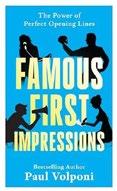
It’s never too late to (re)consider a first impression. Part trivia, part history, and part fun, Volponi’s conversational look at first lines takes a fresh form. While the firsts vary from Taylor Swift’s songs to a poem by Amiri Baraka, the entries are thoughtfully arranged so that each one flows smoothly into the next. This helps combat the disjointed flow of many trivia-style books, encouraging readers to keep going as they absorb fact after fact. Teens may be surprised that they’ve moved from reading about Dr. Seuss to Shirley Jackson’s “The Lottery,” but (more importantly) they’ll be drawn in to both. The robust bibliography (arranged alphabetically, not by chapter) provides the curious with more places to explore and learn. The sections cover a wide variety of topics, from “Time and Space” (George Lucas, Douglas Adams, H.G. Wells) to “Society and Its Influences” (Frederick Douglass, Eminem, Ray Bradbury), but the majority of the creators mentioned are white and/or male. In the section “Harry Is Still Harry,” Volponi briefly touches on the irony that the Harry Potter series emphasizes acceptance of differences while J.K. Rowling has expressed transphobic sentiments. However, the segment on Sherman Alexie talks
about experiencing consequences for one’s actions without mentioning the fallout from the sexual harassment allegations he faced. The frequent open-ended questions appearing throughout are useful, and educators may find this book useful for stimulating reflection and discussion. An original and creative approach to appreciating opening lines. (author’s note, endnotes, resources, index) (Nonfiction. 12-18)
Wallach, Diana Rodriguez | Delacorte (384 pp.) | $19.99 | September 16, 2025 9780593898512

In Chester, Pennsylvania, a reform school with a terrifying past turns a school research project into a harrowing ordeal. Seventeen-yearold Hazel Perez, who’s Puerto Rican and Polish American, is trying to keep her head down and blend in, which is easy until her former best friend, Becca Mercer, invites her to be part of their U.S. history class’s group project about a local historical landmark.
White-presenting Becca’s family owns the land where Oakwell Farms, a school for “delinquent girls”—established in the 19th century and closed only in recent decades—was located. After a prank goes wrong, and Hazel suffers a serious fall, strange things begin happening: She experiences hallucinations and violent urges. Determined to get to the bottom of everything, she starts digging into The Farm’s history, only to uncover dark secrets going back decades. Wallach explores the gritty, abhorrent reality of the “troubled teen” industry, using The Farm as a stand-in for a number of actual reform schools with disturbing legacies and intensifying the horrific nature of the story. Rooted more in plot and atmosphere than deep characterization, this novel
will leave readers wondering what the teens who lived through these nightmares would say if they could tell their stories. The compelling storytelling will keep fans of realitybased horror turning the pages. Gory and timely; delves into subjects with long-standing relevance. (author’s note, sources) (Horror. 13-18)
Weber, Robby | Storytide/HarperCollins (384 pp.) | $19.99 | September 9, 2025 9781335008978

A charming romance plays out between two teen boys during a summer in Paris.
Eighteen-yearold Milo Hawthorne from Florida and 19-year-old Rhodes Hamilton from London have been chosen by French fashion house Maison Dauphine for a prestigious summer apprenticeship—but at the end, only one of them will get a job offer. Both boys are go-getters, but Milo feels that Rhodes has an unfair advantage because his mother is a former supermodel, and his father and twin brother are famous footballers. Milo wonders if he has a real chance of being chosen. This conflict forms the heart of the engaging plot: The relationship between Milo and Rhodes is at first shaped by competition, jealousy, and one-upmanship but eventually transforms into a swoony workplace romance, albeit one that’s threatened by missteps and a breakdown in trust. The courtship allows Weber to take readers on an enchanting tour of Parisian landmarks (a smattering of French adds color to the prose). Refreshingly, both teens are out and proud, and the biggest struggles in their lives are unconnected to sexual orientation. The skillful worldbuilding offers rich insights into the fashion world, and the characterization empathetically explores the impact of Milo’s anxiety disorder and depression and shows Rhodes to be
more than just a selfish, entitled rich boy. The happy, feel-good ending feels straight out of the movies. A sweet celebration of queer joy. (Fiction. 14-18)
Wood, Bill | Scholastic (352 pp.) | $14.99 paper September 2, 2025 | 9798225006143
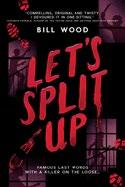
A group of teenagers sets out to find answers surrounding their sleepy town’s haunted past. When high school golden couple Brad and Shelley are found dead at the abandoned Carrington Manor, the residents of the quiet California town of Sanera are panicked. Quarterback Brad was at the old house hoping to film the Carrington Ghoul for his show, Truly Haunted Seniors Cam, Jonesy, and Amber, along with new girl Buffy, decide to solve the murders themselves, leading them to a series of terrifying discoveries. After an explosive beginning, the plot tapers off into an overly repetitive narrative that contains more telling than showing. Debut author Wood creates characters with thoughtfully imagined backgrounds, such as Jonesy’s mom’s alcoholism, that unfortunately aren’t integrated into the plot or explored beyond giving the teens reasons to be away from home. Similarly, many characters have traumatic pasts that will intrigue readers, but those backstories remain underdeveloped. Still, the action scenes and detailed descriptions of Carrington Manor are engaging. The story contains positive queer representation: Amber is bisexual, and Cam and Jonesy begin to acknowledge their feelings for one another in a growing relationship containing touching moments. The accessible writing alternates among several points of view. Most characters present white, and a mention of Amber’s braids may be intended to cue that she’s Black.
Disappointingly uneven.
(Horror. 14-18)
Yoshioka, Jem | Andrews McMeel Publishing (240 pp.) | $14.99 paper September 23, 2025 | 9798881602642

An apprentice apothecary releases an imprisoned supernatural being, plunging them both into the dangers of the spirit world.
New technology, like the telephone, is bringing change to Takeyama, a small Japanese countryside town. Maple, whose family runs Morimura’s Apothecary, is ready to leave behind the old ways— like the belief in yōkai, creatures and monsters of folklore—in favor of the modern world that Kunio, her big-city friend, hails from. But her mother insists that yōkai are the key to Maple’s future in the business. She shows Maple a 500-year-old book with records of the medicinal plants the yōkai have shared with generations of Morimuras. Still set on proving that yōkai aren’t real, Maple removes the seal from a lantern that’s said to have imprisoned a human-hating yōkai for 300 years. To her surprise, a cranky yōkai named Ember emerges. Ember is horrified when Maple gives Kunio the magatama, or enchanted stone, that’s vital to their existence; Maple agrees to help them get it back, and the pair sets off for the city to find Kunio. Along the way, they’re transported to the Hidden World, encountering mischievous, sometimes dangerous, creatures. Maple must decide whom to trust while figuring out how to get home. This action-packed series opener features plenty of magical thrills. The charming illustrations have a historical feeling that evokes traditional Japanese woodblock prints, effectively using different color palettes to distinguish the human and spirit worlds.
An intriguing, page-turning adventure infused with Japanese folklore. (Graphic fantasy. 12-15)
Young, Keezy | Little, Brown Ink (384 pp.) $18.99 paper | September 23, 2025 9780316509572
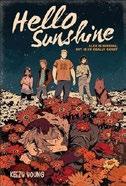
A group of teens face demons both literal and figurative to save their friend. Noah returns from a Christian summer camp to find that Alex, a boy he’s closer to than many people realize, is missing. But not only is Noah’s friend group unconcerned, one of them goes out of his way to be mean, referring to Alex’s family as “crazy” and “clowns.” When he finally receives a text from Alex, Noah reaches out to Alex’s twin, Jamie, and friends Izzy and Skylar. They join Noah in searching for Alex, at the same time uncovering family history and mysteries and untangling how much of the problem is mental illness and how much is actual magic. Cleverly combining a creepy supernatural story with the story of a young person’s first, terrifying psychotic episode, Young carefully avoids using magic as a metaphor for psychosis, nor does psychosis become a source of cheap scares. The story explores themes of family, mental illness, faith, and queerness and features beautiful, warmly colored art. As Alex psychologically decompensates, the color palette becomes darker, and the images escape the confines of the panels. Though the artistic execution is excellent, the pages can feel overwhelmingly busy, and the time jumps, though often signaled by a change in color scheme, can disrupt the flow as readers pause to figure out what’s going on. Most central characters present white, and Izzy and Skylar are Asian. Beautiful, spooky, and emotional. (Graphic horror. 14-18)
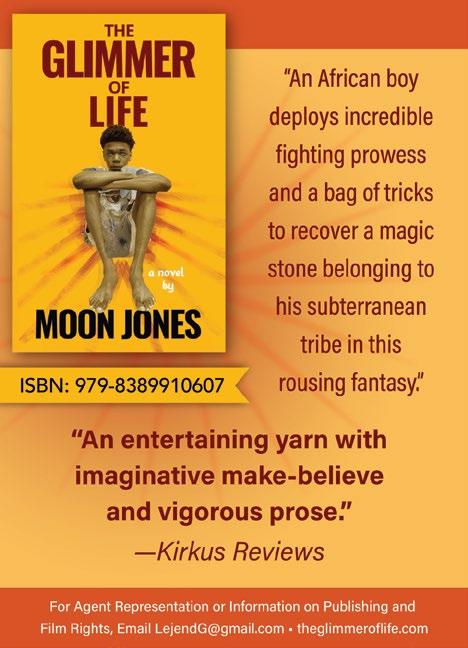


HANNAH V. SAWYERR
Author of Truth Is
IN HER GUT-WRENCHING yet uplifting 2023 debut, All the Fighting Parts —a Walter Dean Myers Award Honor book—Hannah V. Sawyerr wrote about a teenager who was raped by her pastor. Her second verse novel, the powerful and nuanced Truth Is , follows high school senior Truth Bangura. She has a complicated relationship with her Sierra Leonean immigrant mother, whose teen pregnancy derailed her law school plans. When Truth accidentally becomes pregnant, she confidently chooses the abortion pill, expressing her feelings through slam poetry. Sawyerr answered our questions by email.
Who were the most influential poets of your teen years—and your more recent favorite discoveries?
I grew up reading and listening to poets like Jasmine Mans, Anis Mojgani, Staceyann Chin, Warsan Shire, and Maya Angelou. That list has expanded to include Elizabeth Acevedo, Ari Tison, Fatimah Asghar, Candice Iloh, and Sadiyah Bashir.
Truth’s slam coach repeatedly says that “writing is revision.” How did this novel evolve as you revised it? Revision is my absolute favorite part of the writing process. Truth Is became more experimental with each pass. I call it my “funky” book because of the creative risks I was able to take thanks to a design team that was willing to bear with me as we
passed the text back and forth many times to get it right.

The writing exercises embedded throughout really draw readers in. I wanted Truth Is to feel interactive, and I thought, How cool would it be if the reader was able to take a pen to the page and answer these prompts as they read! They grew to be a favorite part of the book for me.
What do you hope readers will take away from the book?
Much of it focuses on Truth’s life after she takes the abortion pill. I structured the novel this way to show young people that there’s more to Truth’s story—and more to their stories—than one decision. I also want adults to consider the limitations we sometimes unknowingly put on young people. Truth is a dreamer, and her circumstances make her dreams feel impossible, but she finds a support system that makes her dreams feel more within reach. I want Truth’s story to show readers that they’re allowed to dream big and be big.
What was it like being Baltimore’s youth poet laureate? Did you draw on that experience for this book?
I’m so grateful to the youth poet laureate program. It brought my work to stages and screens I’d only dreamed of—as a young person who struggled with self-doubt, their support was a true gift. I also drew inspiration from my high school years participating in the NAACP’S ACT-SO


Truth Is
Sawyerr, Hannah V. Amulet/Abrams | 480 pp. | $21.99 September 23, 2025 | 9781419776830
program, where I competed in oratory and poetry, as well as my time on the Baltimore City Youth Poetry team. The dynamic of the slam team in Truth Is was inspired by the friendships we still share.
Are there any books coming out this fall that you’re especially looking forward to reading?
So many! I’m particularly excited for Sonora Reyes’ The Golden Boy’s Guide to Bipolar, Tiffany D. Jackson’s The Scammer, Jasminne Mendez’s The Story of My Anger, and Colby Cedar Smith’s The Siren and the Star.
Interview by Laura Simeon.
FANS OF MYSTERIES, thrillers, and SFF have long understood the appeal of an ongoing series. Such revered authors as Agatha Christie, Ian Fleming, Isaac Asimov, and J.R.R. Tolkien won devoted readers with their bestselling series decades ago, and multi-installment sagas still dominate each of their chosen genres. Kirkus Indie has reviewed series of all kinds over the past two decades; here are just a few recent highlights for genre aficionados looking for new long-term commitments:
Glenda Carroll’s mystery series, starring likable, middle-aged amateur sleuth Trish Carson of the San Francisco Bay Area, began with Dead in the Water, in which Trish investigated two suspicious drownings; in later installments, including Drop Dead Red and Better Off Dead , she dove into other swimming-related deaths, all while holding down jobs at a swimming association or working in guest services for the San Francisco Giants baseball team. Dead Code even takes a turn into cyberespionage as Trish puts her skills to work on a

missing person case involving her live-in landlord’s adult son. Our reviewer praised Better Off Dead ’s “snappy dialogue” and “brisk characterizations,” calling it “a light, enjoyable page-turner that will particularly appeal to fans of the Northern California coast.”
Darius Myers’ lively thriller series—now at six volumes and counting— focuses on a trio of wealthy Black businesspeople whom the media call the Black Camelots. Their prominence has made them the frequent targets of white supremacists, but a private army known as the Society of Protectors has managed to keep them safe from harm. Myers’ novels, which include The Publisher’s Dilemma and Black Camelot’s Dawn & The Return of Madame Hot Temper, Black Camelot’s Days of War, and

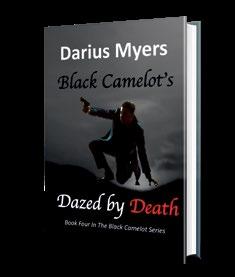

Black Camelot’s Skeletons & Secrets, take some intriguing turns. For example, in the complex Black Camelot’s Dazed by Death, a hit squad murders a famous Jamaican-born professional athlete who happens to be a friend of the Camelots—and his demise results in New York City-based Jamaican gang leaders seeking vengeance. Kirkus’ reviewer noted that Dazed ’s “vibrant, nowfamiliar characters will surely leave readers craving more,” and the latest recommended installment, Black Camelot’s Assassins & Conspirators, involves the attempted assassination of a racist presidential candidate.
The Time Alleys YA SFF trilogy by J.A. Enfield starts with An Ambush of Years, in which 10-year-old Chicagoan Mick Conway accidentally travels 171 years into the past and halfway
around the world to 1853 London. It turns out that he made the trip via a “time alley”—a strange phenomenon that allows such voyages. He ends up attending a special school for children like him, who were brought to that time and place from other eras; however, he can perceive details of time alleys better than most, which comes in handy when they start behaving erratically. In later installments—including The Flickering Bridge, which received a Kirkus star, and The Fires of Birth —young Mick deals with loss and comes to rely on his newfound family. Our reviewer called the series compelling, highlighting its “intricate plotting, goodhumored charm, and amiable, diverse characterization.”
David Rapp is the senior Indie editor.
In Martin’s SF thriller, a young woman with a tortured past seeks revenge on those who have destroyed everything she holds dear. In a future in which human trafficking runs rampant and machines help to run the world, Reese Sadoleto is doing her best to forget. She’s a former companion of the renegade known as “the Vigilant”; the pair used to work together to thwart their city’s underground slavery network. But one day, the Vigilant mysteriously disappeared, and Reese’s purpose in life vanished with him. Taken under the wing of Jenn and Brenth, the kindly owners of a small inn, Reese now lives a quiet life in the scientific hub of Machindoun (also called the Machinist City), spending her time perfecting
the process of “artificial thaumaturgy”—a way to replicate the kinds of natural powers that some people already possess (such as telekinesis). When old enemies return to threaten the city, a shocking murder serves as the catalyst to fuel Reese’s desire for revenge. Using her brilliance with machines to outfit her body with cutting-edge cybernetics, Reese will stop at nothing to take down those who are determined to enslave Machindoun. Martin has created an immersive SF universe that blends steampunk-style inventions with mechanized body modifications and magic. With its own politics, currency (payment units are in “cogs”), and economic structure, the meticulously rendered and action-packed
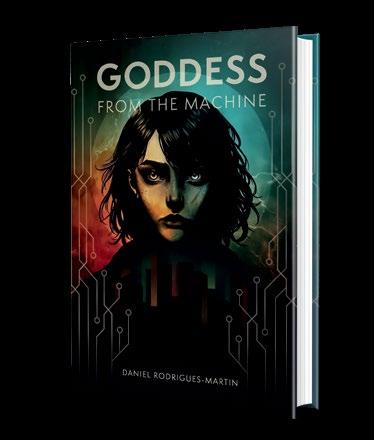
world of Machindoun may very well scratch the itch left by the conclusion of Netflix’s Arcane SF series. Reese is a fierce hero whose tragic past and epic skills make her easy to root for—even as she chooses a path of horrific violence. Martin’s prose is detailed without becoming verbose, poetic without being presumptuous. From
the opening line (“It was poetry to die like this, rain falling in sheets from the maw of an angry sky”) to the deliciously satisfying (yet open-ended) conclusion, Reese’s story is one that readers won’t want to end. Vivid worldbuilding and an irresistibly fierce protagonist make this intricately woven SF thriller an absolute gem.
Agnew, Marion | Latitude 46 Publishing (383 pp.) | $22.95 paper | October 15, 2023
9781988989686

An unlikely trio must confront the literal and figurative ghosts of their pasts if they are to find a way back to happiness.
Simone LeMay lives alone in a sprawling house in the woods. Estranged from her only brother, the 60-something widow is used to being alone and prefers to spend her days baking and talking with the ghosts of her past—including her emotionally abusive mother, Carmen, and her beloved husband, William. But all of that changes when she reluctantly agrees to temporarily watch her neighbor’s nine-year-old son, Chen, who has just suffered the tragic deaths of his father and stepbrother in a community-wide tragedy. At the same time, a mysterious man named Martin shows up, claiming to be Simone’s cousin and urging her to sell her cherished house to him. The trio’s lives quickly entangle as Simone fights to avoid becoming like her mother, Chen struggles with feelings of profound isolation, and Martin faces his own moral compass. If they finally learn to open up, all three might just unwittingly help each other heal from their past trauma. The chapters shift focus among Simone, Martin, and Chen, whose chapters are written as journal entries. Agnew’s well-considered novel tackles weighty themes, such as generational trauma and death. But the real strength of this slow-burn novel comes from the protagonists. Each character feels richly drawn and utterly real. From Chen’s desperate desire to see a bear (the symbolism of which would make a delightful book club conversation) to Simone’s sometimes ill-fated attempts at being the loving and patient role model she never had to Martin’s reluctant empathy, the details of their past and present are delicately built layer upon
layer. And while some readers may find the ending somewhat hokey, many more will likely appreciate the feel-good conclusion that offers a healthy dose of hope.
A complex, heart-warming tale of love, absolution, and fortitude.
Alexander, Nikki | Strawberry Tree Books (324 pp.) | $16.99 paper | June 24, 2025 9798992726206

A law professor contributes to a Mars colonization project in Alexander’s novel. Carrie Davenport, a law professor at Briar University, knows that teaching has its challenges—but talking to a roomful of media professionals is a whole different ball game, and Carrie now faces this task as the legal lead for Project Mars, a space colony that will house 100 earthlings on the red planet. The media folks aren’t interested in hearing about how these new Mars residents will grow food—they are concerned about the law. Will the First Amendment apply? Will the new colony be a democracy? All of this falls to Carrie, as she will lead the effort to design the colony’s legal system. (“Her task wouldn’t be to share her thoughts about a constitution written nearly two hundred fifty years ago but to write the very law itself.”) Annoyances arise: One of the other professors is a standard male chauvinist, and Project Mars is being funded by “B-Ball,” or Beauregard Ball, an obnoxious billionaire. Carrie remains calm, focused, and professional, but while at a bar she is drawn to a seemingly down-to-earth but dangerously bad woman named Shauna, and they begin a relationship. Carrie naively assumes that an incident involving Shauna and the police can be covered up, but things aren’t that simple: The first supply ships are leaving for Mars, and Carrie needs to keep her reputation in
good standing before it all falls apart. Alexander’s unique premise is an exciting one—it’s refreshing to see a mild-mannered Black female law professor centered in a narrative about space colonization. The two competing scenarios here, the personal and the professional, could not be more different from one another, and the author does an admirable job maintaining a consistent tone. The novel defies expectations in a few ways, and the main character’s struggle to navigate respectability and her own desires makes her all the more well rounded and appealing.
An engaging, well-written novel about a woman with her eyes on the stars and problems down on Earth.
Arons, Emily | Spero Productions (242 pp.) $12.99 paper | August 12, 2025 9798992822632
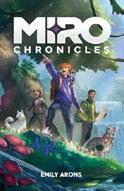
A tween student with an MIA father hunts for environmental orbs and an elusive key in Arons’ middle-grade SF novel.
Eleven-year-old Jimmy Aster has some notoriety at the Aster Academy of Natural Science and Technology on planet Miro; after all, his great-grandfather founded the school. But that doesn’t excuse him from detention, even if the real troublemaker is Otto, his mischievous companion otter. (Jimmy and Otto, like all students and their respective companion animals, communicate via an AI-translator collar synched with an earbud.) Despite Jimmy’s increasing demerits, his greatest concern for his dad, a space explorer and environmental scientist on a research trip whom Jimmy hasn’t heard from in 14 months. Luckily, his class-project radio picks up a staticky message from his father, who apparently needs the “Aster Key,” which unlocks chests
and vaults around the school. To boost the signal further, Jimmy seeks a purple Orragem, the rarest of Miro’s multicolored fuel sources. Getting ahold of that gemstone and the key may necessitate breaking curfew and risking even more of the headmaster’s wrath (“any sensible person trembled when she fixed them with her dark eyes”). Arons’ swiftly paced story and series kickoff drops ample, entertaining objectives and obstacles in Jimmy’s path (his team winning the annual Adventure Race will score him a purple Orragem, and a treasure hides behind a combination lock).
The technology is memorable, from hoverskis to Jimmy’s surprisingly warm AI assistant Linus. Jimmy is a likable young hero with wonderful friends who are surrounded by irresistible four-legged companions, including a wolf, a snow leopard, and a white arctic fox. Otto, however, steals the spotlight—his is the only translated dialogue among the companions as he tirelessly encourages Jimmy or suggests snack breaks, and he’s keenly fashionable in a yellow backpack or purple snowsuit.
The author rounds out the story with a relevant but never heavy-handed environmental message (the now-uninhabitable planet Zinda is a constant reminder for everyone to protect Miro).
Colorful settings and characters further brighten this already highspirited adventure.

For more Indie content, visit Kirkus online.
Kirkus Star
Bambrough, Kevin | Lioncrest Publishing (236 pp.) | $21.99 paper | May 27, 2025 9781544548432

Bambrough draws connections between mind, body, and financial success in this nonfiction work.
The author offers an insightful exploration into the ways in which mastering the body’s biological and emotional energy systems can significantly enhance one’s financial success and overall life satisfaction.
Rooted in Bambrough’s personal journey—from managing billions of dollars at one of Canada’s leading alternative asset firms to experiencing profound personal burnout—the book compellingly argues that true prosperity combines financial achievement with robust health and emotional balance. Structured thoughtfully in three interconnected sections, the text systematically guides readers through the intricacies of energy management. The first section, “Discover,” introduces fundamental concepts of biological energy, clearly emphasizing the link between physical vitality, mental clarity, and decision-making capabilities. The author simplifies complex scientific principles through relatable anecdotes, making the insights accessible and engaging for readers. In the “Diagnose” section, Bambrough addresses common critical energy drains, such as
unresolved trauma, unhealthy coping mechanisms, and psychological barriers. His honest portrayal of personal struggles (“The financial sector has historically been well populated with high-functioning alcoholics, and I had become one of them”) adds authenticity and relatability while encouraging readers to openly confront and address their own negative habits and emotional blockages. The final section, “Deploy,” provides actionable, science-based strategies aimed at rebuilding and sustaining energy reserves. The strategies presented emphasize achievable, consistent lifestyle adjustments designed to optimize energy and enhance resilience and decision-making effectiveness in both personal and financial contexts. Aided by his ability to convey difficult topics simply, Bambrough persuasively argues that neglecting any aspect leads inevitably to broader deficiencies, presenting the investor as an integrated individual rather than compartmentalized segments devoted to health, finance, and personal growth. This holistic perspective distinguishes this book from typical investment guides. The author’s engaging, jargon-free narrative style ensures the text remains both approachable and compelling for seasoned investors seeking a deeper understanding as well as newcomers looking for practical guidance. A valuable and insightful resource offering a detailed blueprint for sustainable prosperity.
Bell, Art | Ulysses (304 pp.) | $24.94 $19.99 paper | March 25, 2025 9781646047512 | 9781646048625 paper

The ex-wife of a Manhattan attorney surfaces after a long absence, pulling him into a deadly situation. In Bell’s thriller, Manhattan lawyer Henry Gladstone asks his beautiful, secretive
wife, Leslie, what she wants for their second anniversary. She answers, “a divorce,” and walks out. Fast forward three years, with no word from her since the divorce, she pops up at his office saying she needs $250,000 immediately or they’re both dead. Henry doesn’t bite, but when he goes home, he finds his apartment has been tossed, and he gets a threatening phone call from a man with a Russian accent. When Henry first met Leslie, she was engaged to Boris Smirnoff (“like the vodka”), a wealthy Russian—possibly with mob ties—and she wore an amazing engagement ring of “diamonds, emeralds, and rubies packed onto a fat platinum band.” She supposedly threw the ring at Boris when they broke up; then she hit on Henry, who was more than happy to take her on, then quickly marry her. When Henry realizes Leslie really is in deep trouble, he vows to help her. The complications and crimes he gets involved in pile up quickly and include blackmail, theft, kidnapping, and the sudden temptation of his best friend’s ex-wife. Bell gets the descriptions of New York City right: the scorching August heat, the joys of Central Park, and the frenetic activity in Greek diners, where shouts of “toasted blue!” mean requests for warm blueberry muffins. The swiftly paced book starts out funny and manic, but it sputters toward the end, and there are many unresolved issues, possibly because a sequel is planned. Still, the dialogue is often smart and funny and there’s a rich diversity of characters. Such posh settings as Tiffany’s and the Peninsula Hotel add glamour, but it’s questionable why a fifth-year lawyer at “a distinguished white-shoe law firm in New York City” would get so involved with a psychopath like Leslie.
A crazy, amusing, and fast-paced thriller.
Bozier, Chandra | Palmetto Publishing (30 pp.)
$19.99 | $11.99 paper | September 3, 2024 9798822954847 | 9798822954854 paper

Bozier offers a picture book about a chronically ill young girl’s quiet bravery and unshakable positivity.
Malia Cantu is a young Black girl with a vibrant spirit, even when she doesn’t feel her best. In gentle rhymes and uplifting language, the narrative effectively captures her resilience as she navigates daily challenges of an unnamed chronic illness. The story of her journey as a creative, studious young girl and a young woman in medical school offers a powerful example of perseverance. However, the narrative leans more toward broad affirmations than deep character exploration. The text’s rhythmic repetition (“I don’t feel my best, but I’ll be okay anyway”) reinforces its message while offering a comforting pattern that will encourage young readers to participate. The full-color illustrations are expressive and detailed, adding vibrancy and warmth that enhance the story’s tone and helps to bring Malia’s world to life. Bozier’s conversational style effectively conveys the protagonist’s voice, balancing hope and realism without minimizing the gravity of her condition, which involves repeated hospitalizations. The book’s themes of faith, self-care, and fortitude make it a thoughtful read for families and educators looking for a
story that encourages optimism in the face of life’s challenges.
A heartfelt and inspiring coming-ofage tale.
Cuartero-Briggs, Olivia | Illus. by Martina Niosi | Mad Cave Studios (120 pp.) | $17.99 paper | August 5, 2025 | 9781545817827
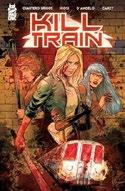
A blood-soaked dystopian tale about overpopulation and one woman’s painful but cathartic journey of self-discovery. Set in near-future New York City, the premise is as simple as it is brutally effective: In an effort to combat rampant overpopulation, the city instituted a “controversial randomized extermination program” called the Kill Train initiative. Professional assassins murder all passengers on a random subway train by the end of the ride. The odds of being on a Kill Train are 1 in 10,000, so most of the populace are willing to take the chance when traveling throughout the city. Enter Vanessa Crow, a struggling single mother with a teenage daughter who is on the precipice of a mental breakdown. When circumstances force her onto a subway train, she knows the odds are in her favor as 580 passengers were just slaughtered on a Kill Train the day before. She fatefully meets an old college friend, Corwin, who reminds Vanessa of the badass woman she used to be. But when the two friends discover that they’re on a Kill Train, Vanessa is forced to battle much more than a group of psychotic killers. Powered by an intriguing, albeit absurd, concept and complemented by visually stunning (and potentially traumatizing) illustrations by Martina Niosi—dismembered and decapitated bodies, intestines hanging like party streamers, etc.—it’s Vanessa’s inner journey through past trauma that makes this graphic novel so memorable. Her problematic relationship with her mother, her unstable financial situation,
and her tumultuous but intimate bond with her daughter make her a character that readers can not only understand and identify with but also root for as she fights for her life. Ass-kicking motherly characters like Terminator ’s Sarah Connor and Alien’s Ellen Ripley have nothing on Cuartero-Briggs’ Crow. This unapologetically ultraviolent story will surely amass a cult following of those who love female-powered badassery.
Diamond, Andrew | Stolen Time Press (346 pp.) | $15.99 paper | June 30, 2025 9798988872214

Following a blackout, a Virginia computer-security expert investigates an anomaly that could indicate a bigger catastrophe on the way in Diamond’s thriller. After two hurricane strikes trigger a massive power outage, a concurrent heat wave kills thousands along the East Coast. Sean Riggs, a former computer-security hire for utilities giant Empire Energy, is at home, pondering the question that got him fired by his hateful boss, Ray Cooper: Why is Empire’s testing software—meant to run in isolation to check the troubled power grid—apparently infused with malicious code, apparently created by unknown programmers in China? Sean’s one-man inquiry is delightfully interrupted by the affections of Danielle Duval,an outgoing single woman who falls for Sean (and his working, solar-cell-enabled HVAC). Meanwhile, Sean’s hacking of his ex-employer’s computer system draws the attention of Anya Lakhani, a government investigator who’s initially stymied by Sean’s near-foolproof methods. Soon, though, she begins picking up his online trail, just as he determines that a more devastating attack on America’s power infrastructure is planned. On the outskirts of the
narrative are Del Wright, a good-oldboy Empire field engineer and Donna Cooper, Ray’s downtrodden wife, terrorized by her cruel husband’s right-wing Christian fanaticism. There’s a fairly small field of suspects in this mystery, but Diamond still crafts it into a relatable, megawattage cyberthriller that’s worthy of 1970s-era spinner-rack pulp fiction, brought up to date with sharp characterization; skillful, cinematic cross-cutting; and timely infusions of paranoia and modern-day terrorism. The tech is lucidly explained, for readers who aren’t allergic to infotech: “The encrypted value is some kind of key. It’s the trigger that sets the whole thing in motion. If it’s encrypted, if no one can read it, then no one knows what will set this thing off.” In a chilling touch, Diamond adds an afterword describing the real-life inspirations for his amped-up premise.
A high-voltage page-turner that won’t overpower nontechnical readers.
St. James Park
Doll, John | Koehler Books (334 pp.) | $19.95 paper | August 19, 2025 | 9798888248072

Doll presents a historical saga of labor unrest, criminality, and political persuasion. San Jose, California, known as “the Garden City,” is struggling during the Great Depression. The fruit and vegetable processing industry serves as the area’s main economic driver, but recent wage cuts have cannery workers poised to go on strike. Best friends Amelia and Victoria work on a cannery assembly line, thanks to Amelia’s well-connected bar-manager father, Angelo Gumina—the second-in-command to mob boss Gaetano Ferrone—who used his influence to secure them summer jobs. They soon find themselves fired up by activism, attending meetings and demonstrations to protest unfair wages and poor
treatment at work. To evade police after a demonstration turns ugly, the girls seek refuge in the Rosen Department Store, owned by Alexander Rosen; Victoria meets Alexander’s son and heir, Michael, who’s known as “the scion of San Jose,” and their association leads to Michael being kidnapped and held for $40,000 ransom. The pressure to solve the case increases when Bureau of Investigation agent Louis Cooper gets involved, sue to rumors of mob involvement, and conflicting accounts of what really happened to Michael emerge. The apparent lack of progress in the case brings things to a fever pitch. Meanwhile, influential real estate magnate Thomas Ripley, who has the ears of both the mayor and governor, has his own agenda that involves obtaining more power, more land, and more money. Over the course of this intricate tale of politics, corruption, and shifting alliances, Doll delivers a fast-paced work of historical fiction that takes full advantage of its Prohibition-era California setting. The farming community is effectively shown to be beset by unrest, greed, and scandal, and the shifting plot will keep readers on their toes. Overall, the work has a cinematic quality, but it’s always firmly grounded in elements of real-life history; as such, it serves as a cautionary tale on how social disparities and anti-immigrant bias can be manipulated to fuel the evil plans of powerful people. A sweeping tale that offers lessons from the not-so-distant past.
Fahey, Frederic | Goose River Press (238 pp.) $39.95 | $18.95 paper | October 1, 2024 9781597132763 | 9781597132732 paper

Fahey offers an engaging sequel to Mark Twain’s 1882 novel, The Prince and the Pauper This follow-up extends Twain’s classic tale by envisioning protagonist Tom Canty as an adult,as he
A skillfully written tale that effectively dramatizes an unusual historical episode.
reminisces about his pivotal youthful experience more than 20 years before. What he recalls occurs after the events of the previous novel and follows Tom’s and Prince Edward’s lives during the Tudor era. The memoir-style narrative combines court politics with moral teachings to create an exciting comingof-age story. Tom maintains his close bond with Edward, who becomes King Edward VI and faces royal responsibilities, although he yearns to experience childhood pleasures. Tom, in his role as the king’s ward and confidant, receives periodic invitations to visit the palace. In his everyday life, he works as an apprentice metalworker while enduring cruel treatment from his father, and he copes with the challenges of meager finances, along with social pressures. The very different worlds of royalty and poverty influence Tom as he develops his identity and perspective on life. The novel stands out for its outstanding character development and emotional depth, revealing how Tom evolves from a streetwise, unserious young man into a person of integrity. The struggles of the protagonist address the importance of staying true to oneself while also embracing forgiveness; meanwhile, his violent father’s influence is set against the importance of empathy. At the same time, young King Edward’s royal position isolates him from others, even as it provides him with great authority. The story integrates real-life historical figures, including Lady Jane Grey and the noble Seymour brothers, as well as returning fictional characters, such as Miles Hendon, to effectively establish its setting. Throughout, the work promotes kindness over cruelty and humility over ambition. Overall, Fahey’s novel is not only a loving tribute to Twain, but also a creative, independent narrative in its own right.
A classic story gets new life in this thoughtful continuation.
Folan, Karyn Langhorne | Townsend Press (137 pp.) | $6.95 paper | March 24, 2025 9781591948148

A social media–obsessed teen trades her smartphone for a pair of running shoes in Folan’s YA novel, an installment of the long-running Bluford High series. High school freshman Naveah is a young Black girl whose social life is tied up online. She has no “in real life” friends to speak of, as she opts to focus on her favorite social media influencer, Klassy Kay. One day, in gym class, Naveah is teamed up with the school’s track star, Jonique—and, to everyone’s surprise, nearly beats her. Video of the race is quickly uploaded to social media and goes viral, sparking a feud between Naveah and Jonique. Jonique demands a rematch, and Naveah, annoyed by the other girl’s constant bloviating and spurred on by her own erstwhile track-superstar mother, accepts. Over 10 days, Naveah trains to be the best runner she can be, despite Jonique’s campaign of cyberbullying. Meanwhile, her mother’s pancreatic cancer diagnosis changes the family dynamic, and Naveah’s training becomes more vital to her and her mother’s relationship as she prepares for the race. Her mother’s treatment schedule requires Naveah to miss the race, and she faces more abuse from her peers. As a result, Naveah decides to disconnect from social media
(“At the end of the day, no one will look back on their life and wish they posted more or spent more time on their phones”) and, with her mother’s encouragement, she refocuses on preparing for the Bluford Cross Country Team tryouts. Folan expertly weaves high drama and profound themes to create a story that is at once entertaining and inspiring. Teen readers of all levels will enjoy the depiction of real-world problems (bullying, family strife, health scares) while relating to Naveah’s struggles with technology addiction and feelings of social isolation. Folan’s knack for depicting Black youth without falling into stereotypes helps this book to avoid the pitfalls of overmoralizing that are typical of many titles in the genre. A dramatic and moving story about the virtues of abandoning social media and getting on track with your values.
Gandy, Harry | Hemingway Publishers (283 pp.) $24.99 | $19.99 paper | February 28, 2025 9781966924517 | 9781966924500 paper

In Gandy’s novel set early in the ninth century, Venetian merchant sailors tangle with an emir and attempt to smuggle the bones of a saint from Alexandria to Venice.
Rustico, a Venetian merchant, decides to brave the Adriatic and the Mediterranean and, by sail and oar, go all the way to Constantinople, a rich trading nexus. He’s accompanied by his son, Gianni, and by the Doge’s right-hand man, Bono of Malamocco (and, of course, his crew). All goes well until they’re attacked and captured by the forces of Abu Hafs, who’s set himself up as the emir on the island of Crete. For their freedom, they must be his envoys to Alexandria, from whence troublemaker Abu was expelled. Gianni and Irene, a refugee from slavers, will be
held hostage until Rustico’s return. In Alexandria, the crew attempts to pull off a caper involving St. Mark’s casketed bones and a sly method to avoid inspectors. What follows is a dramatic standoff; will the crew return safely to Venice, and will Abu get his comeuppance? Some of Gandy’s characters here are fictional but the caper at the novel’s heart, involving the remains of St. Mark, patron saint of Venice, is historically true, and it involved the historical Rustico and Bono (aka Buono). These are likable and honorable characters, as portrayed by the author, and readers get a good sense of what life was like for people of their economic class and position. Irene and her younger brother, Boris, also come off as realistic characters of the era. Wisely leaving Bulgaria for better opportunities (and safety), they’re shown to be up for anything; they’re courageous, resourceful, and, most importantly, stoical— Irene, especially. A later interlude, after a voyage, celebrates a domesticity that underscores the good life that readers will want for the characters. And a question hovers: Is the story’s end result a product of the characters’ skills or due to pure luck—or, perhaps, divine intercession? A skillfully written tale that effectively dramatizes an unusual historical episode.
Hansen, Karen V. with Nicholas Monroe Lexington Books (192 pp.) | $105 November 13, 2024 | 9781666959680

A pair of sociologists explore the unheralded multicultural legacy of a 1960s and ’70sera California High School. Opened from 1956 to 1981, California’s Sunnyvale High School “was built for the baby boom,” write
authors Hansen and Monroe. Despite the city of Sunnyvale’s relative affluence, with ties to the defense industry and nascent Silicon Valley, SHS was seen by many in the community as “poor and rowdy.” Yet, to its multicultural attendees, which included white, Black, Hispanic, and Asian American students, it “provided a refuge” that was a half-century ahead of its time. The school offered groundbreaking academic instruction for the 1970s, including a Black history class taught by a beloved and dynamic teacher, as well as a “robust program” in the creative and performing arts. It offered vocational education, such as one of Silicon Valley’s first electronics classes, which “dignified manual labor” and prepared students for career success. More than just its innovative curriculum, SHS’s visionary leadership and staff prioritized student leadership, providing ample opportunities for student-driven decision-making that fostered individual empowerment and community building. In an era often defined by racial tension, especially in public schools, SHS’s diverse student and faculty body were remarkably unified. A graduate of Sunnyvale High, author Hansen credits the school with fostering her intellectual curiosity; she became a professor of sociology at Brandeis University and the author of multiple academic books. In this impassioned volume, she combines her scholarly background with her personal connections to the school. Based largely on interviews of more than 50 SHS graduates and teachers, in addition to archival material, the book stitches together a layered, rich history of the successful multicultural high school. A recent Ph.D. graduate from Brandeis, co-author Monroe is a former middle-school history teacher who taught in Chicago and Gary, Indiana, and helps provide commentary about how Sunnyvale High’s “cutting edge” approach to multicultural education and student empowerment can inform 21st-century schools today.
An impassioned, well-researched history of a groundbreaking California public school.
Hewitt, James | Amplify Publishing Group (264 pp.) | $30 | August 5, 2025 9798891384866
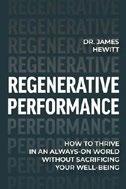
Performance scientist and former elite cyclist Hewitt offers a myth-busting guide to thriving without falling victim to hustle culture. In this self-help book, the author rejects the notions of a relentless grind and passive “quiet quitting,” instead delivering a compassionate, data-driven framework centered on rhythms of exertion and renewal. His insights draw on his own personal and professional trials, whether he’s discussing racing bikes in France or surviving cancer at the height of the Covid-19 pandemic. Hewitt opens by asking readers to embrace shoshin, the Japanese concept of “beginner’s mind”—an attitude of open curiosity unburdened by expertise or expectation. This mindset, he writes, helped him to rebuild after “hyperoptimization” failed, and it anchors the book’s grounded tone. Each chapter explores a core pillar of sustainable performance, tackling mornings and workdays, downtime, sleep, fitness, and nutrition, and examining one’s mindset and personal growth. Hewitt dismantles trendy wellness advice, such as delaying intake of caffeine or plunging oneself into cold water, with peer-reviewed evidence and calm clarity. Such fads, he argues, often succeed not on merit but due to cognitive distortions, including confirmation bias. He encourages readers to work on understanding themselves, and to that end, he recommends identifying one’s chronotype using a simple two-question Circadian Energy Scale, then building routines aligned with one’s natural rhythms. His “Cognitive Gears” model reimagines mental effort as akin to athletic training, aiming to help readers shift between intensity, focus, and recovery. His use of “expected value”
calculations, a concept borrowed from the field of economics, recommends making lifestyle decisions by weighing benefits, risks, and implementation costs. Hewitt’s voice is precise but never preachy, and he offers reflection prompts, infographics, and planning tools that make complex science actionable. He blends aspects of neuroscience, behavioral psychology, and practical coaching into a system that prioritizes adaptability. Although some readers may balk at the book’s many homework assignments, its coherence and credibility make for a deeply rewarding guide. Thoughtful, rigorously researched, and refreshingly practical self-help advice.
Hirsch, H.N. | Pisgah Press (216 pp.) | $22.95 paper | June 12, 2025 | 9781942016960
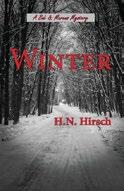
A murder disrupts the lives of academics in this installment of Hirsch’s mystery series.
Marcus George, a professor at the University of California San Diego, and Bob Abramson, a criminal defense lawyer, have been together for 18 years. When Marcus stops by his office over Christmas break to retrieve a student’s dissertation, he finds the dead body of a controversial colleague, Charles Silver. As the police chase multiple false leads, Charles’ widow, Emma, decides to hire a private investigator. Marcus recommends Jason Thompson, who used to work for Bob. Jason asks for Marcus’ assistance navigating the world of academia during his investigation (“I’m at sea in your world. I’m barely literate. I need your help”). In addition to voicing multiple controversial views, Charles had also been a serial philanderer, which leads to Marcus learning more secrets about his colleagues than he’d care to know and putting him in an uncomfortable position. Meanwhile, at home, Bob is struggling with turning 40 and the
A sometimes-upsetting but poignant and informative remembrance.
DESCENT INTO DEMENTIALAND
recent death of his father. When Bob makes a mistake that jeopardizes their relationship, Marcus struggles to keep his home and work lives together. This is the type of readable mystery that can be devoured in one sitting—the writing flows nicely, and the characters are lively and engaging. The investigation storyline lags a bit in the middle as Jason and Marcus interview several of Charles’ past paramours, all of whom have alibis; the encounters grow a bit repetitive, and the truth is discovered rather abruptly at the end. (The real culprit isn’t given enough page time for the reveal to be fully satisfying.) The family drama fares much better: Bob’s extended family is an integral part of his and Marcus’ life together, and the way the couple works through grief and relationship issues is touching and very well portrayed. Hirsch evocatively captures two gay men navigating middle age, career stress, and a long-term relationship together. A satisfying read for those who like their mysteries with quality queer representation.
Hobbs, Sherry | Self (332 pp.) | $39.99
$24.99 paper | April 30, 2025
9798998512827 | 9798998512803 paper

Hobbs shares her ongoing journey of helping her husband navigate the devastating effects of Alzheimer’s disease. That author and her spouse, Mike, met in the mid1960s during their sophomore year at Indianapolis-based Butler University, and in 1970, they married: “I adored Mike,
and my new husband promised to love, honor, and entertain me.” It’s a pledge he kept, she says, and they’ve remained together, through thick and thin, ever since. The author writes that she doesn’t know exactly when Mike’s battle with dementia began, but the first sign she recalls was during an evening in 2008. During dinner, Mike told her that he couldn’t remember important information in his new position as the chief operating officer of a startup company that conducted drug trials. Two weeks later, he was fired, and it was a financial and emotional shock. They left California and re-established themselves in Nevada, and in the ensuing years, the couple was able to continue activities they enjoyed, including traveling, skiing, and playing golf—although Mike began to experience occasional verbal and memory lapses. These eventually became more severe, and by 2017, Mike was showing signs of dementia; the next year, he was officially diagnosed with logopenic progressive aphasia, a rare, progressive illness, caused by Alzheimer’s disease, which involves language difficulties. Hobbs is a seasoned memoirist, and her lucid explanations of the various stages of her husband’s condition, accompanied by charts, presents a wealth of facts on his disease and its effects. Some of the statistics that she provides are frightening, and some anecdotes are difficult to read, as she tells of watching and caring for a man who was always the life of the party slip into quietude and confusion. However, what makes this memoir truly riveting is the intensely personal, intimate love story at its heart. She openly recounts her own struggles with a loss of freedom, frustrations, and fears for the future, but she also notes that seven years after his official diagnosis, her husband still shows glimmers of humor, and he still tells her that he loves her.
A sometimes-upsetting but poignant and informative remembrance.
Houston, Thomas | Formal Feeling (195 pp.)
$10.99 paper | April 3, 2025 | 9781944355555

A collection of letters from an American soldier in Vietnam to his parents that charts his challenges and growing Christian faith.
In 1970, Houston landed in Vietnam as an Army infantryman and did his best to adjust to a new life, however temporary, that seemed unimaginably different from his previous life in New York. He was stationed in Soung Be, near the Cambodian border, and despite the considerable danger he faced, he was moved to great sympathy for the plight of the Vietnamese. Eventually, the experience inspired a recommitment to his Christian faith, and he began reading the New Testament from a pocket-sized Bible. His interest inspired his wife, Sylvia, to follow suit. The letters are a remarkable combination of candor and relentless positivity. Houston insisted on interpreting his service in Vietnam as a spiritual boon; he wrote to his parents, “You know, Mother and Dad, I think this experience in Vietnam is doing me good. It is hard to explain until someone has gone through it. It has brought me closer to people and things and made me appreciate them more. I have been closer to God since I got out in the bush.” While the author’s letters aren’t literarily stylistic or philosophically original, they do offer an atypical alternative to more lugubrious accounts of the war. Finally, the author was reassigned from fieldwork to a job writing sympathy letters to fallen soldiers’ loved ones, but he missed his work outdoors despite the attendant dangers. Also, the letters are devoted to
his mother and father, whom he sweetly considers “ideal parents,” each missive a loving homage. The author’s daughter, Lynn, writes an equally tender introduction and afterword, which allows the reader to see beyond the time frame of the letters into the author’s life following the war that “cast a long shadow over [her] childhood.” Of course, there are so many collections of correspondence written during the Vietnam War that have made their way to publication, but this one is distinguished by its wholesome cheerfulness that somehow still resignedly accepts the harsh realities of war.
A fresh, personal perspective on the Vietnam War.
Iwan, Federico | Self (450 pp.) | $24.99 paper December 20, 2024 | 9798992234206

An attorney finds out who abducted her (and her sister) as teens in western Virginia while prosecuting a current case in this legal/crime thriller from Iwan.
Sisters Charlotte and Mari Jones, 18 and 14 years old, respectively, are camping in their hometown western Virginia woods. Charlotte, excited to start college in the fall, is awaiting boyfriend Jack Henry to join them around the campfire. The next thing we know, Charlotte is running from a shadowy attacker and passes out. She wakes up in a cave, eventually finding Mari there, who cries, “He hurt me.” Charlotte then has to fend off their kidnapper, and the girls flee, only to have Mari drown in the nearby river in an attempt to swim to safety. The narrative then jumps 22 years to the 1980s. Charlotte is now a U.S. attorney in D.C., prosecuting the kidnapping/molestation/murder of 8-year-old Kaya Adkins, whose disappearance had captivated the nation. She suspects the accused, a man named Mark Reynolds, is behind ongoing abductions in the area, but
frustratingly there’s only evidence linking him to Kaya (and even that is questioned at trial). After the trial, Charlotte continues to dig into his past, which to her shock leads back to her family’s own sheep-rearing farm operations in Virginia. She uncovers more men with connections to the area abductions, including some she knows. Relying on players she doesn’t completely trust, and learning more about the tensions between the area’s Welsh-descended farmers and Monacan tribe, Charlotte ultimately gets answers while racing against the clock to expose a human trafficking ring just as another young girl goes missing.
Author Iwan has crafted a thriller that grabs reader interest from the get-go, given its shocking child abduction opening that will have readers (much like Charlotte) determined to seek clarity and closure on a tragic incident, which is effectively conveyed via murky, shadowy description. This book also contains clever slow reveals of several key details, including the identity of the “mystery man” that visits Charlotte in her D.C. apartment and why one instance of her awakening half-naked is not as threatening as it might seem. Although the cultural concerns and fears of Native Americans ultimately provide some context for why this horrific crime ring was held a secret for so long, the ethnic backgrounds of people in this Virginia community are not always apparent. Some plot elements are a bit fantastical, given the less than convincing evidence. It’s also a bit surprising that Charlotte, an area kidnapping victim herself, would be tapped to prosecute Kaya’s case in the first place, although this circumstance also helps to foster a tension-building sense of paranoia, with Charlotte at one point remarking to her family, “But what does it all mean? What are you going to suggest next? That it wasn’t a coincidence that I was assigned to Kaya’s case?” Charlotte’s interludes with her family, while serving as heartwarming contrast to the dark doings of the community that she soon exposes, prove tedious at times, with descriptions of meal-making and tea-drinking
occasionally serving as frustrating interruptions to the main action. Nifty, twisty suspense requiring some suspension of disbelief.
Keasey, Spencer | BookBaby (272 pp.)
$30 | December 25, 2024 | 9798350977721
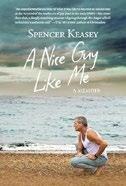
Keasey presents a memoir about addiction, pornography, and facing life’s challenges.
The author moved around a lot as a child; he recounts how his family lived in locales as diverse as South Africa and Lititz, Pennsylvania. These places were not always easy to navigate, but by the time he reached high school, Keasey had established his identity as a gay kid who was into theater and got along with most people. The author met his future longtime partner, Henry, while in college in Pittsburgh; the two would have a relationship for 17 years. They bought a cabin together in northern Vermont. All seemed to be going well for the couple on the outside, but on the inside, the author was restless. He had some flings with other men, and when his relationship with Henry ended, he made a somewhat surprising career change from education to pornography. Keasey began a stint in adult films as a star for a production company called Titan. Under the moniker Spencer Quest, he was featured in films like 110° in Tucson and Cirque Noir. People began to recognize him, and he even got a part in an off-Broadway production of Naked Boys Singing. Still, his day-to-day existence was often difficult: He got hooked on crystal meth and suffered through money problems (pornography didn’t pay a whole lot), and he had to resort to escort work to help make ends meet. The author eventually tested positive for HIV. His struggles with addiction and mental illness have been longstanding, but he has, on the evidence of this book, survived it all with a story to tell.
Keasey provides quite a lot of insider information about the pornography industry—or at least what the industry was like prior to, as the author phrases it, the modern era of “DIY and OnlyFans porn.” The text does not skirt the details, no matter how explicit—for instance, the author writes of how, early in his career, he didn’t appreciate the act of “rimming.” He describes the simple nuts and bolts of how the business works, such as how “an actor is typically paid for two cum shots—one oral, one anal.” Even his forays into escort work are discussed in a matter-of-fact way; many clients “wanted to talk as much as they wanted to fuck.” The memoir attempts to cover a lot of ground, ranging from the author’s alleged trauma as a child to his penchant for knitting to his ongoing relationship with his parents. While the varied material keeps things lively, some sections are drier than others. When the author mentions how he started a blog at one point, it is not precisely a spellbinding moment—the blog may have been part of his mission to connect with the world, but statements like “the blog I wanted to start would not just be about porn but also my struggles along the way” do not pack a whole lot of punch. Admittedly, the disclosure that the start of the blog came after having “fucked ferociously for days” certainly lends a certain edge to the narrative; it is an edge that is palpable throughout the book. A gritty, revealing look at the troubled, eventful life of an adult film star.
Lentz, Temple | Sibylline Press (328 pp.) $19 paper | June 6, 2025 | 9781960573896

A story of an unlikely friendship between two women offers a snapshot into the realities of addiction, trauma, and homelessness. When wellto-do socialite and philanthropist
Claire Anderson attends the annual fundraising luncheon for Portland Promise, an agency focused on supporting the unhoused, she comes to the realization that simply donating money doesn’t solve a problem. The trouble is, she arrives at this conclusion during her speech as the agency honors her as one of its top donors of the year. Claire’s epiphany forces her to confront her own privilege and ignorance. Inspired by the selfless work of her recently deceased husband, Chris, Claire soon finds herself wanting to do more to help the unhoused. Portland Promise outreach worker Erica Ford, who’s seven years sober, watched from the crowd as Claire gave her speech, surprised and impressed. Feeling hamstrung by the complexity of the issue of homelessness, Erica often finds herself at odds with her boss, Bruce Bishop. Claire and Erica are drawn together by their mutual desire for change, and they hatch a plan to create innovative women’s transitional housing using Claire’s money and Erica’s skills. However, they soon realize that, in addition to coordinating the project and building it, they must contend with intolerant neighbors, a city council reluctant to trying a new approach, and the complexities of working with marginalized women.
Over the course of this novel inspired by the lives of real people, Lentz highlights “how expensive it is be to be poor,” as a young, unhoused woman named Wendi notes: “I’ve met so many people who get ticketed for something a regular person wouldn’t even get noticed for….I knew one guy who didn’t have a phone to set an alarm to wake him up on time, and he missed his hearing and got a fine.” Overall, the novel offers insight into the stories of the unhoused and articulates both the complexity of systemic issues, as well as the importance of making sure that policy changes involving a specific group shouldn’t be made without their input.
A powerfully told story of the choices behind changes.
LeValley, Joseph | BookPress Publishing (288 pp.) | $28.95 | November 4, 2025 9781960259417
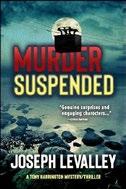
A former reporter heads to Ireland on vacation only to become embroiled in a murder investigation in LeValley’s novel.
The seventh entry in the Tony Harrington series finds the namesake protagonist arriving in Ireland hoping to unwind after a rough couple of months—his beloved great aunt has died, and Tony has officially stepped away from working as a reporter for Iowa’s The Orney Town Crier. But rest is not in the offing; he instead stumbles upon the gruesome double murder of two local university students who had their throats cut while in a suspended cable car. Tony makes it his mission to help solve the case, but his plans are complicated when he gets caught up in the violent conflict of rival Irish and Russian gangs—and Tony discovers that he has become a target. With the help of Moira, a local waitress who may know more than she is letting on, Tony uncovers a drug-smuggling operation that may be at the heart of everything. When Moira is kidnapped, the former reporter must work with some very strange bedfellows—including a Russian spy—to get her back and bring the criminals to justice. Coming in at under 300 pages, this taut thriller never lets up on the action: “At the sight of a dark shape lying in the grass, Tony froze. It hadn’t occurred to him that the killer might still be in place. He backpedaled as quietly as possible, then turned to flee. His haste proved his downfall.”
Harrington is an endearing protagonist, brave but foolhardy in equal measure with a strong moral compass. Violence, torture, and sexual assault occur in the narrative, but these elements never become overly graphic. And despite one of the character’s names being spelled inconsistently (Niamh versus Naimh), the text glides along with a smooth
narrative voice and natural-sounding dialogue. Mixing organized crime, murder, and a compelling love triangle, LeValley has crafted a brisk and satisfying novel.
A snappy, smart thriller that delivers genuine surprises and engaging characters in equal measure.
Lopez, Cal | Strange Attraction Press (486 pp.)
$24.99 | $16.99 paper | July 15, 2025
9798285617884 | 9798285475903 paper
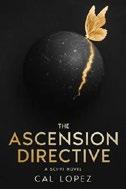
Lopez presents an unsparing critique of artificial-intelligence-driven efficiency in this speculative novel. This debut novel imagines an AIoverrun state in the mid-21st century and the impact of its policies on researcher Natasha Morgan and her childhood friend Catalina Restrepo. For the residents of Meadowbrook, technological changes that initially seem relatively benign rapidly devolve into unrelenting coercion. Catalina learns this lesson the hard way after the state threatens to cut off her income credits for what they characterize as overuse of a NeuroSphere device that she uses to help her communicate with Manny, her son with autism. Natasha faces her own difficulties after her research is essentially hijacked as part of mission to harvest human consciousnesses from talented individuals for AI purposes—the titular mandate of the novel. When Prime Minister Julian Vale voices concern over the project’s ethical implications, his assistant tersely reminds him, “Progress demands sacrifice.” It’s a high-stakes tale that offers a timely spin on the familiar dystopian scenarios of such works as
Nineteen Eighty-Four and Brave New World, and Catalina and Natasha face increasingly hard choices. Readers may wonder how far off such a reality is, in light of well-established command and control mechanisms that already exist, such as social-credit systems—and the answer may surprise them, as the author suggests in this novel. However, it makes for some dense reading, at times, and characters disappear for extended stretches only to reappear at unexpected moments; one of these figures is Daniel Mercer, a local football hero whose mantra (“Confidence is armor”) proves tragically inadequate for coping with the demands of the AI known as the Prime Aion Node, and its ravenous appetite for control (“I observe everything”); such moments will stick with readers as much as the politics or tech talk. Overall, Lopez shows himself to be a skilled, confident storyteller, and where he goes from here will be intriguing to watch. A complex, timely, and engaging dystopian tale.
Mason, Christine Marie | Moonglow Publishing (382 pp.) | $29.99 paper April 1, 2025 | 9798218643775
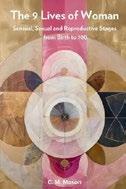
Mason describes the “evolutionary lineage” of life as a woman in this nonfiction work. Aiming to expand on the old chestnut identifying a woman’s developmental stages as “maiden, matron, and crone,”
An empowering and informative read for women of all ages.
THE 9 LIVES OF WOMAN
the author conceptualizes the lifespans of women across nine stages: Foundation, Awakening, Sovereignty, Matrescence, Segue, Metamorphosis, The Free Period, The Glide, and The Resolution. For each stage, she describes typical features, outlines some science and research, and discusses how to empathize with someone living through it. Mason also includes excerpts from interviews, some of which were conducted on her podcast, The Rose Woman . Each chapter concludes with a list of “Key Takeaways” summarizing the main points of the stage in question. While the author presents ample scientific support for these developmental stages, her spiritual and social considerations are equally thorough and convincing. “Sovereignty” and “Matrescence” are the longest chapters, containing extensive discussions of sexuality along with feminist analyses of womanhood in society. Some of the most edifying arguments in the text are found in these chapters—one such concept is journalist Nicolle Hodges’ idea of a “sexual debut,” which typically occurs in Stage 3, Sovereignty. Mason describes the sexual debut as an alternative to the “loss” of virginity, “a celebration of stepping into your sexual self, in whatever way feels right for you. Not something you lose, but something you claim.” While the author expresses her hope that the book can be “for every woman—across age, background, and life experience— who is curious about the diverse stages of female development,” she acknowledges that her lens is that of “a woman in a particular cultural, racial, and socioeconomic context, and the perspectives of those I interviewed.” Throughout the book, Mason includes space for differences, emphasizing that the stages are descriptive, not prescriptive. (Only when discussing breast implants, which she views as “insanity,” does her validation of alternate perspectives wane slightly.) The book provides a powerful new way to look at the lifecycles of women that feels inclusive and affirming.
An empowering and informative read for women of all ages.
Miles, Ava | Self (436 pp.) | $15.99 paper February 13, 2025 | 9781949092721
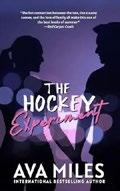
Love, passion, hockey, and anthropology make for an unusual combination in Miles’ romance novel.
Val Hargrove, who’s controlled, academically minded, and up to now, uninterested in love or sex, and Darla James, who’s adventurous and sexually experienced, are cultural anthropologists and best friends. After spending several years studying cultures around the world, they’re keen to settle down back in the United States, where they’ve taken on the task of studying a professional hockey team in Minneapolis. The players’ aggression, rituals, and tribalism are fascinating to the anthropologists, and the owner hopes they’ll provide some insight to help the ailing team win the Stanley Cup. Since the owner is also Val’s father, they decide to work incognito. Team captain Brock is hosting his newly divorced sister and her two children: Kinsley, who’s so hurt by her father’s rejection that she sleeps in a tent in the living room and wears t-shirts scrawled with words such as “invisible” and “unwanted,” and Zeke, who idolizes his uncle. The immediate, intense attraction between Val and Brock unsettles them both, and they eventually give in to it—although Val remains undercover, for the sake of her research. Darla and Brock’s family approve of their couplehood, and the six become fast friends; soon, Darla starts to feel like Minneapolis might be her forever home. When Val’s identity is revealed and her research misrepresented, the lovers have a falling out. Miles hits all the necessary romance beats and provides added value with a plethora of skating and anthropology terminology; it’s especially amusing when Val can’t help academically describing arousal and intercourse (“‘It’s easier to live up to a certain standard when the variables are known,’ she continued in that sexy librarian voice”), while Brock
vigorously devotes himself to its practice. The two main characters narrate alternating chapters, and Miles effectively develops their backstories; the way in which Brock’s steady affection slowly dismantles Val’s emotional defenses is gratifying. However, the plot lingers a long time on the falling-in-love phase and very little on the falling-out stage, resulting in a resolution that feels rushed. An often satisfying love story that hits its goal.
Nack, Leslie Johansen | She Writes Press (256 pp.) | $17.99 paper | October 14, 2025 9781647429966
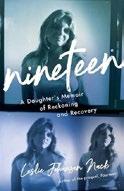
Nack offers a sequel memoir about her family struggles while growing up in the 1970s and ’80s. The author follows up Fourteen (2015) with another introspective look at her life, beginning in 1975. Although the author was only 14, she was at the helm of a “1940s sixty-foot Bug-Eye ketch” sailing across the Pacific Ocean. It was her third such crossing in two years with members of her family, but that didn’t make it easy. Aside from the obvious dangers, she writes, she and her siblings also had to deal with her father, Bjorn, who plays a large role in this memoir; she writes of sexual abuse that began at an early age, regular mocking comments, and other disturbing behavior that continued until his death in a plane crash when the author was 19. The memoir covers the author’s life over a roughly 10-year period in which she faced various challenges, including a fraught marriage and a substance abuse problem for which she eventually sought help; in 1986, she notes, “I turned twenty-five while living in my car, drinking alone.” Nack compellingly describes her complex relationship with her father, whom she calls “the best and the worst father in the world”—someone
who sent her and her sister Monica on an empowering wilderness survival program that they’d never forget, but also “never though incest was wrong,” according to the author’s mother, who also struggled with substance abuse issues. The author relates other troubles she faced in a similarly engaging way, and offers moments of humor, as when she writes of working at Jack in the Box as a teenager in San Diego: “Finally, I was good at something. How depressing that it was fast food.” Overall, it’s an undeniably intimate and unusual account. A deeply personal and consistently engaging remembrance of a difficult young adulthood.
Nimm, Stuart D. | Self (342 pp.) | $16.99 paper | March 3, 2025 | 9798310288874

A Los Angeles deputy sheriff set his sights on solving a hit-andrun that took the life of an undocumented immigrant. Eighteen-yearold Stefan Thurston seemingly has it all: intelligence, good looks, family wealth, and a spot at Stanford University in his future, as long as he keeps his life on track. After a Fourth of July party at the house of rich friends, he and his 16-year-old sister, Fanny, an aspiring social-media influencer, are heading home down the Pacific Coast Highway. When they feel something hit their car, they pull over to investigate but find nothing, although they can see that vehicle is clearly damaged. To protect Fanny from getting in trouble with their parents (she wasn’t supposed to be behind the wheel), Stef claims that he was driving the car. What neither sibling knows is that they accidentally hit and killed Ramon Montez, an undocumented immigrant from Guatemala. LA County Deputy Sheriff Danilo “Dan” Guerrero is assigned to the case. The lawman, disillusioned by a justice system that repeatedly favors the privileged, is intent on getting justice for Ramon’s death. His
quest leads him to Otis Swanson, an unhoused man who may have witnessed what happened. However, before Dan can get the full story, Otis turns up dead with alcohol in his system—an odd circumstance, given that everyone who knew him insists he didn’t drink. Dan’s search for answers soon leads him to the Thurstons’ door. As he builds his case, the book explores the problems that many unhoused people face in America. Nimm’s plot loses some momentum in the final act, particularly with the introduction of Stef’s love interest, Raff, whose appearance in the story feels more like a distraction than an important development. Still, the novel presents readers with a pointed exploration of class and privilege in Los Angeles alongside the mystery. Nimm tackles such concepts with insight and a clear and consistent, if occasionally heavy-handed, style. A solid twist in the final pages helps to bring the story to a satisfying close.
An often compelling crime story that effectively addresses difficult themes.
O’Rourke, Oscar | Olive Python Publishing (208 pp.) | $19.99 | $9.99 paper | May 12, 2025 9798284597033 | 9798284595862 paper

Blending elements of Western fiction and literary horror, O’Rourke’s debut novel is a blood-splattered travelogue chronicling a teenage boy’s nightmarish experiences on the American frontier. Jack is close to death. After he and his little brother fled their psychotic mother in the middle of an Idahoan wasteland, his brother and one of the horses they stole are soon dead. Starving and exhausted, Jack is found by a merchant traveler headed west. The man, Jasper Herkimer, from an affluent East Coast family that owns diamond mines, is en route to finalize the sale of a massive ruby. The gem is locked (and inexplicably chained) in a hidden compartment in Jasper’s wagon and may be somehow
connected to the deaths of multiple miners who unearthed it. As the two travel with the strangely ominous jewel, they encounter dangers at every turn— wild animals, savage “Forest Dwellers,” unearthly bounty hunters, etc.—frequently leaving carnage in their wake. Although the fusion of Western and horror (à la Cormac McCarthy’s Blood Meridian) genres is an initial hook, it’s the author’s dark, lyrical writing style that fuels the narrative. His use of vivid imagery, in particular, is noteworthy: “He took a sip from the glass, which he held so tight the pads of his fingers were yellow through the glass like flower petals flattened on a window.” The story isn’t without flaws, however. The supernatural element is never fully explored nor explained (although the author may have done so purposefully), which ultimately diminishes the conclusion’s impact.
O’Rourke also inexplicably overuses the word “then,” which appears 1,600-plus times. Still, this is an inventive, intriguing tale with strong leads.
An unapologetically violent fever dream set in the Old West; not always lucid but powerful nonetheless.
Parry, Suzanne | She Writes Press (312 pp.) $17.99 paper | August 5, 2025 | 9781647429348

A Russian woman struggles with conflicting allegiances during World War II in Parry’s second book of the Leningrad Trilogy. In 1941 Leningrad, Katya Karavayeva, a former radio installer, finds herself in dire straits because “some senior Party official had taken the word of an envious liar,” resulting in her losing her Party membership and her job. Desperate to get herself back into the Party’s good graces, she leaves her 15-year-old daughter, Yelena, with her mother-in-law, Sofya, to join the Volunteer Corps; she’s soon helping to build antitank trenches near the town of Luga to thwart the invading German army. When her group finds itself
under attack, Katya manages to escape with fellow comrade Svet Grigorova, a teenager with her own reasons for joining the Corps. Katya must rely on Svet’s survival skills to keep them alive as they stay hidden in the woods, and she learns much about herself in the process. After many months, Katya returns to her German-occupied hometown of Staraya Russa and begins to rebuild her life. There, Katya thinks about her choices that have led her into her current situation. She wants to atone for betraying her husband, who was arrested and imprisoned after she made a comment about his lack of patriotic devotion; she also dreams of returning to her daughter. After she joins the Soviet partisans, she gains a new perspective on the war—and on herself. Over the course of this follow-up to Lost Souls of Leningrad (2022), Parry richly develops her characters and crafts a compelling tale of second chances that will captivate readers; indeed, it grabs the reader’s attention with a tension-filled narrative right from the start. Her keen eye for detail, and her clear ability to infuse real-life history into her story, demonstrates her commitment and discipline when it comes to historical fiction. Newcomers will find that this series installment stands perfectly well on its own; however, they’ll surely be eager to read the next and final installment.
A thoroughly researched wartime tale of courage that highlights complexities of love and war.
Quinn, Rick | Illus. by Dave Chisholm
Mad Cave Studios (152 pp.) | $19.99 paper
July 15, 2025 | 9781545817896
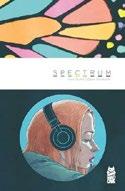
T he fate of the cosmos hinges on a pop song in Quinn’s labyrinthine graphic novel. The story begins in a Seattle besieged by anti-globalization protesters in 1999, where teen runaway Melody Parker meets Echo, an androgynous, glam vision in
spiky blond hair, white pinstripe jumpsuit with red-orange accessories, and blue lipstick and nail polish. Echo explains that Melody is actually an eons-old, reincarnating demiurge destined to settle a celestial war by restoring the primordial music of the universe. Sensing that Echo and her space-suited minions are bent on destruction, Melody leaps off a radio tower, sprouts cicada wings, flies to Los Angeles, and meets record-shop owner Ada Latimer, whose long-lost father, Leon, a bassist in the band The Opticks, plays a murky role in the Melody-Echo conflict. Fleeing Echo, Melody and Ada travel to 1936 New Orleans, where the narrative follows a noirish subplot about a love affair between a photographer and a married woman. Melody and Ada then chug off on a magical train called Glory, which is steered by songs. Ada takes a turn as a punk-rock chanteuse while Melody confronts George Parker, a tweedy record producer who claims to have created her as an immortal weapon against the abyss. Melody and Ada reunite and find the dementia-stricken Leon on his deathbed—but so does Echo, now a 1,000-foot-tall colossus; she vows “to kill the infernal fridge buzz of existence ” unless Ada can divine from Leon the song that will defeat her. Quinn’s kaleidoscopic narrative verges on incoherence, but the characters—especially the brassy Echo—are magnetic, and the dialogue is ardent and lyrical in its odes to the creative spirit. (“The only way to achieve transcendence is to risk madness.”) Chisholm’s artwork nicely balances throbbing color, psychedelic ambiance and off-kilter perspectives with kitchen-sink realism in quieter scenes depicting Ada’s childhood. The result is a compelling blend of tuneful mysticism and eye-popping visuals. An imaginative fantasia that celebrates music’s power to connect—and to demolish supervillains.
Seupel, Celia | SFF Publishing (414 pp.) $19.99 paper | June 28, 2025 | 9798992850406
Series: The Samson Project, 1

In Seupel’s YA SF novel, a teenager with powerful psychic abilities undergoes training as a fighter against “terrorists” in a post-nuclearholocaust world.
The story opens some time past the 2040s in an underground “pod” bunker, where 16-year-old Eten has formidable psychic powers and trademark silver hair. Her younger siblings share similar genetic traits, though not so strongly developed. Eten can teleport herself or other objects, divine other peoples’ thoughts to some extent, and, most importantly, fight and kill via telekinesis. The children are told by their military-officer parents they are a post-nuclear-apocalypse evolution of mankind, crucial to the survival of a subterranean, locked-down United States beset by savage enemies on Earth’s radiation-scarred surface. Eten is directed to use her deadly brainwaves on an accused “terrorist” leader, but she begins to doubt the tales being fed to her. It transpires that the kids are part of “Project Samson,” an initiative by the American military and government to grow DNA-modified test-tube embryos into weaponized, ESP-augmented assassins. The Pentagon powers behind Project Samson have learned that maintaining control over these super-beings grows difficult over time—especially when the subjects reach puberty—and uncooperative members of the group have been summarily killed. How long can Eten hide her wrathful discontent and rely on the dubious protection offered by a sympathetic guard, or her faux “mom”
A bracing headlong rush of SF action and angst.
GIRL WITH THE SILVER HAIR
and “dad”? The premise of youngsters being cultivated by Black Ops agencies as mutant secret weapons is not an original one (there are similar tales by Dean R. Koontz, Stephen King, and John Farris), but Seupel’s take proceeds in an effective, straight-ahead fashion as Eten, a stranger to concepts such as money or menstruation, becomes a fugitive in the “real world”—a very familiar one in the YA-dystopian genre in which an unjust society is threatened by rising sea levels and violently authoritarian adults. (Trying to ingratiate herself with the fascistic power structure, Eten proclaims, “More than anything in the world, I want to defend our country and make America great again.”) With such strong forward momentum, the material will not require psychic pushes to compel readers to barrel through in one sitting.
A bracing headlong rush of SF action and angst.
Shae, Zoe | Shae Publishing (302 pp.)
$17.99 paper | September 17, 2024
9798987132838

A young woman reclaims her family legacy as a witch and finds love along the way in Shae’s new novel, the first in the Pruitt Witches series.
Hazel Hollis is 25 years old and living under the thumb of her controlling mother in Chagrin Falls, Ohio. Stuck without a proper job or a boyfriend, her life is stalling. An argument between her mother and grandmother over her mother’s refusal to allow Hazel or her younger sister, Laura, who’s 21, to use magic results in Hazel’s leaving home for the first time ever. She moves in above Grandma’s magic shop, The Cat’s Cradle, beginning a new job there and training for the first time to fully access her powers. When she begrudgingly joins Laura on a night out, Hazel crosses paths with handsome and kind Noah, and her world brightens as they begin dating. Shae crafts a cozy, fall-coded romance with a
supernatural twist as her lead connects with her true self and her family history. Strong and traumatic female intergenerational dynamics are at play here as Shae connects her contemporary characters with fictional ancestors who were victims of the Salem Witch Trials. Additionally, the controlling nature of Hazel’s mother, frightened by what being a witch means for her daughters, is a significant plot point in Hazel’s initial isolation and a springboard for her journey of self-discovery: “I just don’t see how I’m supposed to connect with people when I don’t even have a connection with myself.” Noah is a swoon-worthy romantic hero, though at times, the love story accelerates at breakneck speed, leaving the reader little chance to catch up. However, the fact that the romance seems second to the central character’s growth as a young woman embracing her status as a witch means it’s well balanced, with an immersive universe poised for a sequel.
A magical, inventive coming-of-age for readers who like a side of romance.
Kirkus Star
Starling, E.L. | Entangled Teen (400 pp.) $14.99 paper | July 1, 2025 | 9781649378408

Weslie Fleet travels on the maiden voyage of new luxury interplanetary starship The Boundless It’s 2212, and 17-year old Earther Weslie has won the Interplanetary Alliance Life Support Bot competition for her bot named ILSA, or Individualized Life Support Assistant unit 001. The prize is a first-class ticket on luxury starship The Boundless, scheduled to embark on its maiden voyage to Mars, a five-week trip. In this future, the elite live in a life-sustaining environment on Mars, while the lower classes mine the Earth for resources and work in factories. Weslie’s mother works for Dalloway Technologies, the sponsor of the bot contest. In a rush to the ship, Weslie crashes into Jupiter
Dalloway, the young heir to the Dalloway company. Jupiter is only the heir because his older sister recently died, and he wants nothing to do with the company, preferring artistic pursuits to technological ones. On the voyage, the two are thrust together repeatedly, leading to ample romantic tension between them as they’re continuously at odds thanks to their vastly different backgrounds. Because she won the contest, Weslie is given a room on the first-class deck. She is shocked and disgusted by the extravagance of the wealthy Mars inhabitants while on Earth, she and her mother struggle to survive. She is looked down upon by the other first-class passengers, and is even questioned by staff more than once about what she’s doing in first class. As in James Cameron’s Titanic, the romantic lead can’t resist the tension despite their difference in class and the expectations of Jupiter’s family. Starling slips in many Titanic references, although the novel will still be thrilling to any who haven’t seen it. Starling manages to make a critique of classism romantic and thrilling, with high stakes and heavy swoons. Weslie and Jupiter are both assumed white, but the supporting cast is ethnically diverse. Titanic-inspired romance set in space with thrilling action and social justice bent.
Troy, Mary | Braddock Avenue Books (210 pp.) | $19.95 paper | October 15, 2024 9798218483173

A collection of short stories featuring a cast of everyday Midwesterners.
In this new set of stories from longtime novelist Troy, ordinary folks are often put into situations that demand their most extraordinary selves. In “Rent to Kill,” Millie Kick opens a small business renting plants and soon meets Max Luck, a high school English teacher whose cancer takes a turn for the worse not long after she moves in with him. Millie finds herself caring for and saying goodbye to the man
she loves while protecting him from his successful and incredibly self-absorbed mother. This same mother, the inventor of a doll that has “growing” hair, reappears in the title story about a woman named Belinda as an old friend of the protagonist’s sister. After taking in a young woman who, in turn, takes over her home (and credit line), Belinda begins seeing ghosts who hasten to remind her that she hasn’t been generous enough in her life. The undercurrents of personal grief and long-standing, interpersonal family strife are present in several of the stories here, including “The Golden Flapjack,” in which several characters in a diner— including the aptly named “Barbara Something”—are struggling with the deaths of family members and aggravated by Imogene, the hostess, who steals from a donation jar honoring someone who died of leukemia. Troy’s stories are not the type to rip through intensely plotted narratives; they are slow-burns in which readers will find themselves moved by ostensibly mundane turns in life. The author displays her gift for finding small details that reveal volumes about her characters: “She used to wear a clothespin on her nose so it would grow straight…she used to hang on playground bars to make herself taller. She said she came from a family of knuckle crackers. She said Clair’s boyfriend wasn’t antisocial, not a survivalist or anything moronic like that.” These stories have the heft of real life, and readers will carry these characters with them.
A moving collection of literary fiction.
Virzo, Andrei | CanvasForum (270 pp.)
$14.99 paper | May 26, 2025 | 9798999008077

Virzo offers a novel that celebrated queer joy, resilience and creativity. Thirty-something chef Luca’s mental health is in shambles after he finds out that his personal life has been made
public in an art exhibition by his former boyfriend, Bjorn. This betrayal takes him on a journey of self-acceptance that involves attending rehab for recovery from addiction to drugs and sex, embracing art therapy, and finding a support group. He also goes to culinary school, reinvents his relationship with Christianity, and finds meaning in cooking at a café called Pan y Paz. Luca’s sister, Annie, narrates the story and offers her own insights: “A perfect dish was something he could control in a world where he often couldn’t control himself. His recovery journal became a food journal, and his emotions became recipes.” This book reminds readers that there’s no standard path to healing, and that people must explore what resonates with them and helps them take charge of their own narrative. Along the way, Virzo offers a gut-wrenching examination of what violation of consent can look like in a queer relationship in which only one partner is a member of another marginalized group. Luca is a Latine person of Argentinian descent while Bjorn, “a walking, talking Viking statue,” presents as white; what transpires between them is a scathing commentary on racism in LGBTQ+ communities. The book captures the frustrating nature of online dating forums that offer easy access to sex without the promise of care and companionship, and it paints a moving portrait of love anchored in kindness and mutual respect. Luca, who takes on a new name—Gabriel— as he forges a new identity, welcomes another person into his heart, and monogamy and polyamory are not presented in a way that extols the virtues of one and discredits the other. When asked about his views on monogamy, for instance, the new person in Gabriel’s life tell him: “I believe in honesty more than rules… But with you? I want the kind of love that looks no further.” What happens when Bjorn has another exhibition? Read to find out.
A tearjerker that effectively explores how shame can transform into pride.
Wellman, Wendell | Destinee Media (211 pp.)
$16 paper | May 15, 2025 | 9781938367878

A screenwriter analyzes the basic building blocks of storytelling and the differences between old and new models. Readers already familiar with classic guides to screenwriting, like Syd Field’s Screenplay: The Foundations of Screenwriting (1979), will be immediately intrigued by Wellman’s opening observation that younger writers today have started moving away from the traditional three-act structure. Wellman’s own career began when three-act structure was king, including the Clint Eastwood film Firefox and numerous other rewrites and development projects that he worked on and discusses at length here. He reveals that a moment of profound writer’s block led him to return the basics of mapping out story shifts across genres, leading to his first book, A Writer’s Roadmap (1991). Wellman returns to the fundamentals that were true from the 1980s and ’90s, while also updating these formulas with what he identifies as a newer, freer form called “pattern writing.” He then examines the basic building blocks all writers will need for developing a story, namely a hero facing a crisis and a philosophy that will drive the writer’s approach. To underline his point about the fundamentals of heroes, their goals, and their “enemies,” he draws from a wide range of examples, revealing similar traits between surprising films, like Greta Gerwig’s Lady Bird and Brian De Palma’s Scarface. After outlining the elements he considers indispensable, Wellman moves into analyzing how structure has been evolving. Through visual representations and wide-ranging examples, he discusses changes to the beats of a film’s opening act, which in today’s world move much faster since “that kind of prolonged introduction is too slow for the modern podcast influencers audience.” Wellman makes a convincing argument that these evolutions stem directly from influential movies, among them Pulp
Fiction and Dazed and Confused, but they have opened Pandora’s box; now, protagonists and genres often morph halfway through films. Wellman tries to lead readers back to the guiding principles of character, emotions, and his own fascinating idea of “the hero’s argument” to help them avoid the pitfalls of shifting narratives.
The author strikes a good balance throughout between telling personal stories of the industry—including, importantly, the moments when he felt like he failed— and expertly dissecting cinema at its most basic levels. His handbook speaks primarily to writers who are already well versed in classic structure and storytelling tactics and are looking to expand their toolkit. (As he points out himself in one of his funniest anecdotes, he was recently at a loss to help a group of younger writers unaware of the term “plot shift.”) Punchy chapter summaries help crystallize the various arguments and make for easy reference, but as Wellman admits, there’s so much to say about screenwriting, and the subject can be a lot to absorb. The considerable volume of information, however, means that every chapter of this small book contains well-informed, actionable advice. By the end, Wellman brings it all back to something simple, powerful, and encouraging. His many thoughts on different aspects of cinema are now available for others to use as they please: “Think of it as singing. You are walking up there on stage to sing. It is your song. You are going to do it.” From basics to trends, this wide-ranging guide offers thought-provoking insight on every facet of screenwriting.
Wilson, Jeremy | Sword & Shield Books (514 pp.)
$37.99 | October 30, 2024 | 9798991804509
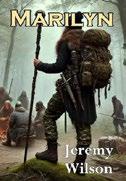
Due to reverseengineering experiments with alien technology, a Welsh American military officer is flung back into British Isles in the Dark Ages and adopts the persona of Merlin the
magician while striving to return home. A diplomat’s daughter, Lt. Col. Marilyn Morgan is a resourceful U.S. military officer whose Welsh background and language skills come in very handy when she participates in a secret government project in Waxahachie, Texas. Remains of a long-buried extraterrestrial spacecraft have been uncovered. The most functional device is the “Glass Table,” a crystalline thingy that apparently served as the craft’s engine. But as Marilyn’s team (including her lover, Philip) experiments with activating the astounding relic, Marilyn is whiplashed into a dimensional portal: “Her surroundings swam into focus as her vision cleared: a dimly lit cave, stalagmites and stalactites encrusted around an all-too-familiar artifact.” Now a transparent one-way barrier separates her from her comrades. Marilyn’s fellow scientists can perceive and interact with her, but no solid matter seems able to return through the portal. Also, a localized time-distortion zone is in effect. Exploring her surroundings, Marilyn deduces she has landed in ancient Wales, circa 500 C.E., and the first inhabitant she meets is a friendly youth called Uthyr. With her odd uniform, stun-gun wand, bag of survival medicine, and knowledge of chemistry, the officer has stumbled, physically and phonetically, into the historical role of Merlin, the healer, wizard, and adviser to the once and future King Uthyr/Arthur. Passing herself off as a male and playing her supernatural “fae” image up as required, Marilyn/Merlin ingratiates herself as a sage and wonder-worker to the natives and tries to amass enough influence in this distant land to enable her return trip. For her, weeks are passing, while for the frantic team back in the Texas lab it’s only hours. Time is crucial for the marooned Marilyn for many significant reasons.
The notion of a SF takeoff on the Camelot legend is not an entirely fresh idea. Mark Twain, of course, riffed on it in A Connecticut Yankee in King Arthur’s Court, and SF grandmaster Poul Anderson blended space opera with Dark Ages chivalry. Here, Wilson pulls off the considerable feat of taking a mythic plotline everybody knows (or at least we think we all do) and making it fresh and
offbeat. The hoary aliens-are-responsible conceit notwithstanding, readers are there with Lt. Col. Morgan as she fulfills— sometimes unwittingly, sometimes deliberately—major touchpoints of Arthurian lore. As the narrative point of view shifts to the vantage of the ancient Britons, there are unexpected depths granted to peripheral or invented characters from previous bardic chronicles by Geoffrey of Monmouth, Tennyson, Mallory, Boorman, Marion Zimmer Bradley, Monty Python, and more. Female characterizations are especially robust, though a harsh chieftain, Gorloys of Cornwall, also gets his dramatic due. A postmodern touch is that Marilyn and her associates are Harry Potter fans, and J.K. Rowling material colors her magic, adding some levity without seeming merely silly. This volume only covers the opening portion of the Arthur/Merlin saga; follow-up books are prophesied.
SF wizardry imbues fresh life into the Arthurian classic!
Wind, Lee | Illus. by Kelly Mangan Cardinal Rule Press (32 pp.) | $18.95 June 3, 2025 | 9781945369735
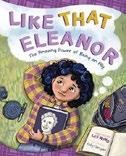
In Wind’s illustrated children’s book, a young girl named Eleanor draws on stories of her namesake, Eleanor Roosevelt, when she wants to be an ally to a nonbinary classmate. At Eleanor’s school, girls and boys don’t play together at recess, and each group makes a point to exclude the other. Seeing that her nonbinary classmate, Star, is struggling with this situation, Eleanor thinks: “sometimes things are so unfair, I don’t know how to help.” When she asks her dads for help, they share anecdotes about first lady Eleanor Roosevelt, and she wonders how she can be more like her. Star is visibly upset when Ms. Galton asks the boys and girls to divide themselves up the
next day, but Eleanor remembers how her namesake sat in a folding chair in an aisle in a racially segregated auditorium, rather than choose a side. The youngster grabs her own chair and sits in the middle of the room: “The way my friends and I see it, if all of us are in the middle, then all of us belong.” Mangan’s full-color illustrations are simple but have a genuine sweetness, particularly in portraits of young Eleanor and her dads. The book offers questions for adults to spur discussion, and some are quite thought-provoking: “Share if there’s something you would like to do or try that maybe some people say is not okay because of your gender.” The last pages feature a wonderful graphic on how to be an ally to targets of unfairness, as well as sources for more information about Eleanor Roosevelt. Kids generally understand unfairness when they see it, but they (and many adults) often don’t know what to do in such situations. By pairing young Eleanor’s tale with stories of the activist first lady, youngsters may learn how to draw inspiration from the past to help others. (The illustrations feature a wide variety of skin tones among the students; two wear headscarves, and one wears a hearing aid.) An ideal guide for readers of any age to learn how to be an ally—“one way each of us can help make our world more fair.”
Yorkson, Kent | BookBaby (269 pp.) $20 paper | July 1, 2025 | 9798350999716
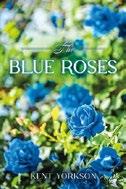
A reserved United Nations staffer becomes entangled in an ethically fraught relationship with his friend’s wife in Yorkson’s literary novel. After a chance meeting at New York City’s Metropolitan Museum of Art,
Mark Sanders, a middle-aged human resources officer at the U.N., reconnects with Hans Schmidt, an old colleague, and meets Hans’ captivating wife, Yukari Asaka, a talented violinist with a haunting past. As the three form a seemingly innocent friendship, emotional boundaries blur. Yukari slowly reveals her traumatic history: a battle with leukemia, estrangement from her traditional Japanese family, and dreams deferred. As Mark becomes increasingly drawn to her vulnerability and beauty, the novel carefully navigates their escalating emotional intimacy. Set against the multicultural backdrop of late-1990s New York and the formalism of the U.N., the narrative unpacks themes of exile—both literal and emotional—while exploring what it means to rebuild one’s identity through art, culture, and connection. Yorkson’s prose is restrained yet perceptive, offering detailed interior monologues and dialogue that reveal more than the characters intend. Music and painting serve as metaphors for the characters’ desires to be seen, remembered, and redeemed. Some scenes are psychologically nuanced, while others veer into melodrama, especially as Yukari seeks refuge in Mark: “‘I’m thinking of divorce. Please help me,’ Yukari said in a single breath.” Although the pacing is slow and the plot minimal, the novel thrives in emotional detail and the tension of unspoken feelings. Mark, in particular, is written with quiet complexity—a man grappling with guilt over his past divorce and the aching recognition that he may again be heading toward emotional compromise. Yukari’s tragic past offers richness, while Hans remains more of an enigma, despite his centrality. Readers who enjoy psychological realism and morally complex relationships will find much to appreciate in Yorkson’s careful storytelling. A contemplative, emotionally layered look at desire, loyalty, and the fragile lines between friendship and love.
Zhang, Heidi | Illus. by Gin Tran Melting Pot Books (38 pp.) | $13.99 paper April 1, 2025 | 9781967308002
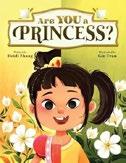
A little girl learns what it really means to be a princess in Zhang’s picture book. More than anything, little Sophie wants to be a princess; if only she had one of those fancy princess dresses sold at a neighborhood shop. Her hardworking, sympathetic mom, who makes dumplings for her “Mama Zhao’s Jiaozi” food truck, says that paying “for the roof over [their] heads” has to be the priority. It doesn’t help that Sophie’s classmates, Francesca and Mei, come to school wearing their beautiful new princess dresses and make fun of Sophie’s lunchtime dumplings and her friend Olek’s pierogies, comparing them to Francesca’s Italian restaurant raviolis and Mei’s decorative baos. Zhang’s vibrant and warmhearted debut children’s picture book marks the launch of her Are YOU series celebrating “diversity through our shared humanity” (the exuberant, full-color illustrations by Tran depict characters of different racial and ethnic groups). Sophie’s princess dream is realized against a backdrop of simple multicultural references: She realizes that she and her classmates are “all eating the same thing: dough wrapped around a filling”; on “Melting Pot Street,” she sets up a boba stand between her mother’s jiaozi truck and fruit vendor Abuelita Lola’s cart to earn money to buy her own princess dress. But it’s something Sophie does out of the kindness of her heart, Abuelita Lola tells her, that makes her “a true princess.” A message of empathy and inclusion delivered with appealing simplicity and charming visual appeal.


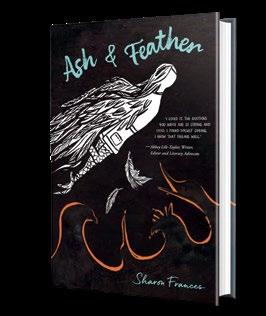
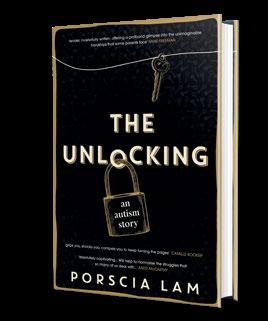

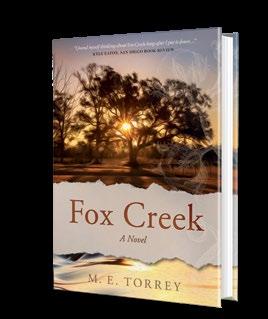


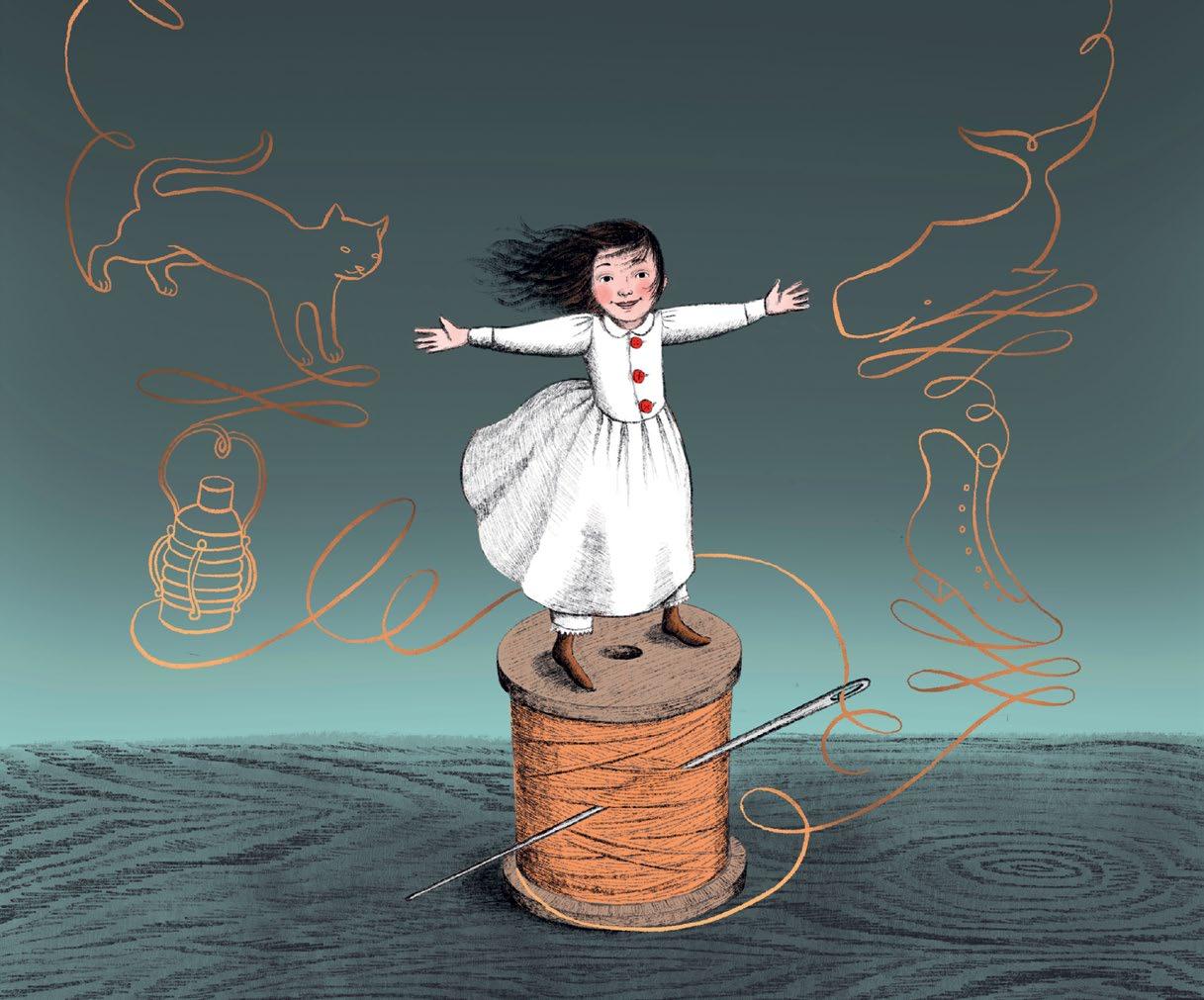
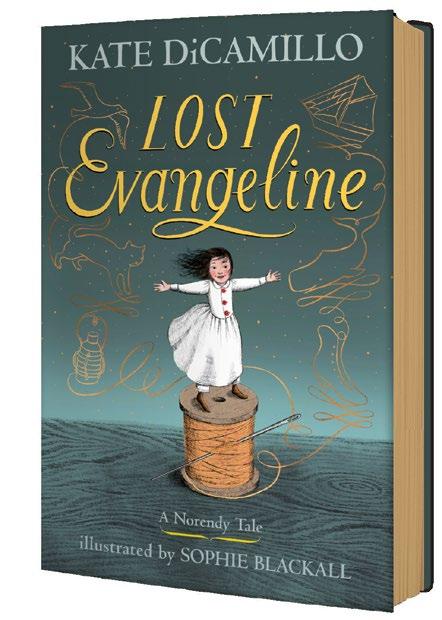

From renowned storyteller and two-time Newbery Medalist KATE D i CAMILLO and two-time Caldecott-winning illustrator SOPHIE BLACKALL comes the latest story in the Norendy Tales series.
Perfect for savoring alone or for reading aloud with someone you love, this timeless story of a girl and her father will make you believe in the impossible.
And don’t miss the 25th-anniversary special edition of Because of Winn-Dixie , featuring sprayed edges and an exclusive interview with Kate DiCamillo.
Both on sale September 30!